Administrator's Guide Excel / Meridian Data Computer Drive 1 Open Text Right Fax 10.0 Administrators
User Manual: Excel / Meridian Data Computer Drive 1
Open the PDF directly: View PDF ![]() .
.
Page Count: 344 [warning: Documents this large are best viewed by clicking the View PDF Link!]
- Contents
- Introduction
- Understanding the RightFax Servers
- Configuring the RightFax Server Module
- Configuring the General Settings
- Configuring the Advanced Settings
- Configuring Feature Activation
- Configuring Custom Messages
- Configuring User Messages
- Configuring Admin Messages
- Configuring Data Sharing
- Configuring eTransport
- Starting and Stopping the RightFax Server
- Understanding the Fax Server Internal Event Queue
- Configuring the WorkServer Modules
- Configuring the DocTransport Modules
- Adding transport methods
- Configuring Global DocTransport Settings
- Brooktrout Fax Board Configuration
- Configuring Docs-on-Demand
- Eicon Fax Board Configuration
- Configuring T.37 Fax over IP
- Configuring Fax over IP Failover
- Configuring SMS via the Push-Proxy Gateway
- Configuring Automated Billing Codes
- Running DocTransport on Remote Computers
- Requirements
- Configuring Server-Side Application Conversion
- Enabling and Using the Captaris Sync Module
- Managing Fax Servers with Enterprise Fax Manager
- Creating RightFax Users
- Creating Groups of Users
- Creating Signatures
- Creating Overlay Forms
- Connecting Printers and Scanners
- Creating Billing Codes
- Creating Library Documents
- Text Messaging Using the Push Proxy Gateway
- Adding SMS and Pager Services
- Using the Alerting and Monitoring Service
- Using SNMP Alerting
- Creating Dialing Rules and Least-Cost Routing Plans
- Creating Fax Cover Sheets
- Routing Inbound Faxes
- Using Optical Character Recognition
- Responding to Inbound Faxes with AutoReply
- Creating, Sending, and Managing Faxes
- Activating and Using the PDF Module
- Creating Phonebooks and Broadcasting Faxes
- Using RightFax Email Gateways
- Inbound Faxing with Microsoft Exchange 2010 Unified Messaging
- Using TeleConnect to Access Faxes by Phone
- Backing Up and Maintaining the RightFax Software and Database
- RightFax Embedded Codes
- File Formats that Convert to Fax Format
- Error and Status Messages
- Alerting and Monitoring Statistics
- Registry Keywords
- Index

OpenText RightFax 10.0
Administrator’s Guide
Edition
OpenText RightFax 10.0. This document was last updated May 24, 2011.
Trademarks
OpenText is a registered trademark of OpenText Corporation. All other company names, brand names, and product names are the property and/or trademarks of their respective companies.
Copyright Notice
©2011 OpenText, Inc. All rights reserved.
OpenText Corporation
275 Frank Tompa Drive
Waterloo, Ontario, Canada
N2L 0A1
(519) 888-7111
http://www.opentext.com
Portions of this product Copyright © 2002-2006 Glyph & Cog, LLC. Portions Copyright © 2001 artofcode LLC. This software is based in part on the work of the Independent JPEG Group. This software is based in part on the
work of the Freetype Team. Portions Copyright © 1998 Soft Horizons. Portions Copyright © 2001 URW++. All Rights Reserved. Includes Adobe® PDF Library technology. Adobe, Acrobat and the Acrobat logo are trademarks
of Adobe Systems Incorporated. Portions Copyright © TMS, Inc. 1994-2001. All rights reserved.
OpenText RightFax 10.0 Administrator’s Guide ii
iii
Chapter 1 Introduction............................................................................ 13
About the RightFax System ......................................................... 13
Using This Guide............................................................................ 13
Getting Help Online ...................................................................... 13
Fax Server Training Services ....................................................... 14
Open Text Professional Services................................................ 14
Customer Support ......................................................................... 14
Chapter 2 Understanding the RightFax Servers.............................. 17
RightFax Business Server ............................................................ 17
RightFax Enterprise Server and Enterprise Suite ................... 17
RightFax Server with the Integration Module........................... 17
RightFax Branch Office Server ................................................... 17
How RightFax Works .................................................................... 18
Installing the RightFax Server...................................................... 20
Chapter 3 Configuring the RightFax Server Module ......................21
Configuring the General Settings...............................................21
Configuring the Advanced Settings ...........................................24
Configuring Feature Activation ....................................................25
Configuring Custom Messages...................................................26
Configuring User Messages .......................................................28
Configuring Admin Messages .....................................................29
Configuring Data Sharing.............................................................31
Configuring eTransport..................................................................32
Starting and Stopping the RightFax Server..............................33
Understanding the Fax Server Internal Event Queue .............35
Chapter 4 Configuring the WorkServer Modules ............................37
Selecting a Service Account........................................................42
Adding and Deleting WorkServers............................................ 44
Printing a Time Strip on Faxes.................................................... 44
Configuring Kofax NetScan..........................................................45
Configuring PeopleSoft................................................................ 46
Installing WorkServers on Remote Computers .......................47
Requirements...................................................................................47
Contents
Open Text Fax Server, RightFax Edition Version 10.0 Administrator’s Guide iv
Chapter 5 Configuring the DocTransport Modules......................... 49
Adding transport methods........................................................... 50
Configuring Global DocTransport Settings..............................51
Brooktrout Fax Board Configuration ..........................................52
Configuring Docs-on-Demand.....................................................63
Eicon Fax Board Configuration .................................................. 66
Configuring T.37 Fax over IP....................................................... 68
Configuring Fax over IP Failover................................................. 69
Configuring SMS via the Push-Proxy Gateway.......................70
Configuring Automated Billing Codes.......................................71
Running DocTransport on Remote Computers .......................72
Requirements...................................................................................73
Chapter 6 Configuring Server-Side Application Conversion ....... 75
Understanding Server-Side Application Conversion..............75
About the Captaris Conversion Engine.....................................76
Configuring the Service Account............................................... 80
To Configure Timeout on a Failed Conversion........................ 80
Controlling Server-Side Application Conversion.................... 80
Word-wrap for Text Attachments ................................................81
Troubleshooting the Conversion Engine ...................................81
Chapter 7 Enabling and Using the Captaris Sync Module ........... 83
Description of the Captaris Sync Module.................................83
Defining a Data Source................................................................ 84
Defining a Destination Database................................................ 88
Creating Mappings........................................................................ 89
Deleting a Data Source or Destination..................................... 90
Verifying User Synchronization ....................................................91
Chapter 8 Managing Fax Servers with Enterprise Fax Manager 93
Starting Enterprise Fax Manager.................................................93
Setting Preferences ...................................................................... 94
Viewing RightFax Server Information......................................... 96
Working with Objects....................................................................97
Monitoring the Status of RightFax Servers and Services..... 98
Synchronizing the RightFax Server with External Systems 101
Running Enterprise Fax Manager Web Edition.....................101
Chapter 9 Creating RightFax Users...................................................103
Managing RightFax Users.......................................................... 103
Creating a User Profile............................................................... 105
Using Windows NT Security Authentication......................... 116
Importing Users............................................................................ 117
Chapter 10 Creating Groups of Users.................................................119
Managing Groups........................................................................ 119
Editing Group Properties........................................................... 120
Chapter 11 Creating Signatures ...........................................................127
Managing Signature Files .......................................................... 127
Editing Signature File Properties ............................................. 128
Creating a New Signature File ................................................. 128
Adding a Signature to a Fax...................................................... 128
Chapter 12 Creating Overlay Forms ....................................................131
Managing Overlay Form Files ................................................... 131
Editing Form File Properties...................................................... 132
Creating a New Overlay Form .................................................. 132
Using Two Overlay Forms in One Fax..................................... 133
Adding an Overlay Form to a Fax............................................. 134
Chapter 13 Connecting Printers and Scanners ................................135
Managing Printers........................................................................ 135
Editing Printer Properties........................................................... 136
Importing Printers into RightFax............................................... 137
Configuring RightFax to Automatically Print Faxes.............. 137
Using Scanners with RightFax.................................................. 137
The Standalone Fax Connector................................................ 138
Chapter 14 Creating Billing Codes ......................................................141
Customizing the Names of Billing Code Fields.................... 141
Managing Billing Codes............................................................. 141
Editing Billing Code Properties................................................ 142
Importing Billing Codes.............................................................. 142
Requiring and Validating Billing Codes.................................. 143
Accessing ODBC Billing Codes ............................................. 143
Contents v
Chapter 15 Creating Library Documents............................................ 147
Managing Library Documents................................................... 147
Editing Library Document Properties......................................148
Creating a New Library Document ..........................................149
Faxing a Library Document........................................................149
Chapter 16 Text Messaging Using the Push Proxy Gateway........ 151
Understanding Message Types................................................ 152
Understanding Connectors.......................................................153
Understanding Two-Way SMS Support.................................153
Understanding Log Files............................................................153
Configuring the Push Proxy Gateway .....................................154
Chapter 17 Adding SMS and Pager Services................................... 161
Managing SMS and Pager Services.......................................162
Editing SMS and Pager Service Properties .......................... 162
Logging SMS and Pager Alerts ...............................................165
Chapter 18 Using the Alerting and Monitoring Service................. 167
Installing the Alerting and Monitoring Service ...................... 167
Configuring the RightFax Alerting Service............................. 167
Defining the Statistics to Monitor and
their Alert Thresholds............................................................... 170
Editing Alert Properties .............................................................. 171
Chapter 19 Using SNMP Alerting ........................................................ 175
Configuring the SNMP Service
on the RightFax Server............................................................ 175
Configuring the Network Monitor Application....................... 176
Receiving RightFax Alerts in Your Network Monitor ............ 176
Querying RightFax Status Variables........................................ 177
Controlling RightFax Services From Your Network Monitor ......
183
Troubleshooting the RightFax Alerts .......................................183
Chapter 20 Creating Dialing Rules and
Least-Cost Routing Plans.................................................187
Managing Dialing Rules ............................................................. 187
Editing Dialing Rules................................................................... 188
Load Balancing ............................................................................196
Managing Destination Tables.................................................... 196
Testing Dialing Rules and Fax Routes.....................................199
Call Blocking................................................................................. 201
Least-Cost Routing Examples .................................................. 202
Chapter 21 Creating Fax Cover Sheets ..............................................205
Creating an HTML Cover Sheet .............................................. 205
Creating a Microsoft Word Cover Sheet ............................... 207
Creating a PCL Cover Sheet.................................................... 209
Selecting a Cover Sheet File ................................................... 211
Chapter 22 Routing Inbound Faxes.....................................................213
Configuring DID/DNIS Routing ............................................... 213
Configuring DTMF Routing ....................................................... 214
Configuring Channel Routing ................................................... 214
Configuring ANI Routing............................................................ 215
Configuring CSID Routing ........................................................ 216
Configuring Delivery Methods for Users ................................ 216
Distributing Faxes to a Group of Users .................................. 218
Assigning Unique ID Numbers to Fax File Names
and Routing to a Network Folder.......................................... 218
Chapter 23 Using Optical Character Recognition............................221
Enabling OCR Processing on the WorkServers.................. 221
Configuring RightFax Users for OCR Conversion............... 222
Using OCR to Route Received Faxes .................................... 223
Creating and Managing OCR Text Files ................................ 225
Open Text Fax Server, RightFax Edition Version 10.0 Administrator’s Guide vi
Chapter 24 Responding to Inbound Faxes with AutoReply ......... 227
Requirements................................................................................ 227
Installing and Configuring AutoReply .................................... 227
Managing AutoReply from a Remote Computer ..................229
Customizing the Reply Fax ........................................................230
Troubleshooting the AutoReply Service .................................231
Chapter 25 Creating, Sending, and Managing Faxes.....................233
Creating and Sending a Fax...................................................... 233
Using Embedded Codes ...........................................................240
Managing Faxes ...........................................................................241
Chapter 26 Activating and Using the PDF Module ......................... 243
Activating the PDF Module on the RightFax Server............243
Enabling PostScript Processing on a WorkServer ..............243
Additional PDF Processing Options .......................................244
Chapter 27 Creating Phonebooks and Broadcasting Faxes ........ 245
Using the RightFax Phonebook ................................................ 245
Importing Entries Into the RightFax Phonebook ...................246
Using MAPI Phonebooks...........................................................248
Using ODBC Phonebooks........................................................249
LDAP Phonebooks ...................................................................... 251
Fax Broadcasting ......................................................................... 252
Chapter 28 Using RightFax Email Gateways .................................... 257
Installing the Email Gateway Software................................... 257
Adding and Configuring Email Gateways..............................259
Sending a Fax via SMTP/POP3...............................................263
Receiving Faxes via Email..........................................................266
Email Notification of Faxes......................................................... 267
Embedded Codes in Mail Messages...................................... 267
Running the Email Gateway Remotely....................................268
Troubleshooting the Email Gateways......................................269
Chapter 29 Inbound Faxing with Microsoft Exchange 2010 Unified
Messaging ............................................................................271
Overview........................................................................................ 271
Requirements................................................................................ 271
Configuring Exchange 2010 UM for Faxing.......................... 271
Configuring OpenText RightFax for Exchange 2010 UM... 273
Chapter 30 Using TeleConnect to Access Faxes by Phone...........275
Configuring TeleConnect........................................................... 275
Retrieving Faxes Via TeleConnect............................................ 282
Chapter 31 Backing Up and Maintaining
the RightFax Software and Database...........................285
Changing the Connection to the SQL Server ...................... 285
Backing Up and Restoring
the RightFax Server and Database....................................... 287
Purging Deleted Fax Records from the Database ...............289
Purging Fax Records using DBPurge.....................................289
Purging Faxes from Users’ Fax Mailboxes ............................. 290
Removing Orphaned Faxes....................................................... 290
Supported Database Collation.................................................290
Appendix A RightFax Embedded Codes291
Appendix B File Formats that Convert to Fax Format303
Appendix C Error and Status Messages305
Appendix D Alerting and Monitoring Statistics311
Fax Server Statistics ................................................................... 311
Database Statistics..................................................................... 312
Workserver Statistics.................................................................. 314
Gateway Statistics ...................................................................... 315
Local BoardServer Statistics .................................................... 316
All BoardServers Statistics ....................................................... 319
RPC Server Statistics ................................................................ 320
Paging Server Statistics............................................................. 321
Local Document Transport Server Statistics ........................ 322
Contents vii
Chapter 32 Registry Keywords ............................................................. 325
DocTransport Registry Entries..................................................326
FaxServer Registry Entries.........................................................329
Gateway Registry Entries ..........................................................332
RightFax Registry Entries........................................................... 332
WorkServer Registry Entries.....................................................334
Index ................................................................................................................... 337
Open Text Fax Server, RightFax Edition Version 10.0 Administrator’s Guide viii
13
Chapter 1
Introduction
About the RightFax System
The RightFax system is a comprehensive network fax solution for
creating, sending, receiving, and managing faxes directly from a
user’s desktop computer. RightFax features and intuitive design
make faxing as easy as printing to a network printer.
A user can enhance the fax by adding a cover page, overlaying a
form, attaching documents, and inserting graphics.
FaxUtil is the RightFax mailbox where users create, view, print, and
manage faxes. With FaxUtil, users can forward, route, and delete
faxes. They can view other users’ fax mailboxes and delegate views
into their personal fax mailboxes.
The RightFax fax server manages network print queues assigned to
faxing, converts outgoing faxes, schedules outgoing faxes, and
routes incoming faxes. Routing can be optimized with Intelligent
Least-cost Routing™ rules. The server consists of several services
that run on one server computer or several networked computers
to distribute heavy workloads.
Similarly, RightFax fax board services can be installed on remote
servers to distribute the workload across several computers and to
provide expanded channel capacity and system redundancy.
A RightFax email gateway acts as a communication link between
the RightFax server and an email server. With an email gateway, the
user’s customary email client software can serve as the fax client.
RightFax includes email gateway for SMTP/POP3. Advanced
gateways for Microsoft Exchange and Lotus Notes are available as
separate modules.
Using This Guide
The OpenText RightFax Administrator’s Guide is designed for
RightFax administrators who will be installing and configuring the
RightFax software on both client and server computers. This guide
assumes you have knowledge of the Windows operating systems
as well as knowledge of networking systems and your own
organization’s network.
Getting Help Online
The OpenText web site offers the latest product information.
Updated documentation, a searchable customer support
knowledgebase, software downloads, are available on the
OpenText Knowledge Center at knowledge.opentext.com.
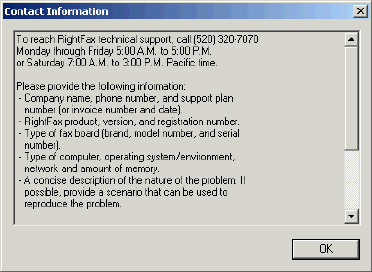
OpenText RightFax 10.0 Administrator’s Guide 14
Editing Contact Information in FaxUtil
In the FaxUtil Help menu, users can select Contact Information,
and a dialog box opens that lists Open Text Customer Support
contact information.
Figure 1.1 The Contact Information Dialog Box
This contact information appears in English with Open Text contact
information, but you can edit the text to provide customized
information. To do so, edit the text file Contact.txt located in the
\RightFax\Bin folder on the RightFax server. You can enter 24 lines
of text and up to 59 characters per line.
Fax Server Training Services
Fax Server training from Open Text facilitates successful
deployment and saves time installing, configuring and maintaining
Fax Servers. Regularly scheduled courses are delivered virtually,
and in classrooms in Tucson, Arizona and Hooppdorf in the
Netherlands. Onsite and custom training are also available. Please
visit our Web site to get more information and register for Fax
Server training: http://www.opentext.com/2/global/services-home/
ls-learning-services-home/ls-offering-captaris.htm. Or email us at
captaris.learning@opentext.com and let us help you develop a
customized training plan for your organization.
Open Text Professional Services
Experienced OpenText implementation engineers can help you
quickly and efficiently deploy the OpenText Fax Server, RightFax
Edition in your production environment.
OpenText Professional Services engineers and consultants are
experts in the implementation, deployment and integration of
OpenText Fax Server solutions. Services include basic installation
and configuration, upgrades and migrations, configuration review,
systems assessment and health check, and other advanced
integration services. Services can be performed remotely, on-site,
or a combination of both.
OpenText Professional Services provides a cost effective
alternative for organizations in need of getting their enterprise fax
infrastructure up and running quickly, particularly with limited
resources or expertise. Please contact
captaris.sales@opentext.com for more information.
Customer Support
Open Text Customer Support maximizes the value of your Open
Text Fax Server, RightFax Edition by providing access to a wide
variety of resources and support tools. Through the Open Text
Knowledge Center (http://knowledge.opentext.com), customers
have access to
Open Text’s team of Technical Support Engineers and Product
Specialists
System upgrades and maintenance
An extensive product knowledgebase
Product documentation
Product discussion groups
Chapter 1 Introduction 15
More information on Open Text’s complete line of Customer
Support offerings can be found at
http://www.opentext.com/2/global/services-home/
services-support.htm.
Contacting Open Text Customer Support:
For complete Open Text Customer Support
contact information, visit
www.opentext.com/2/global/services-home/
services-support-contact.htm
OpenText RightFax 10.0 Administrator’s Guide 16
17
Chapter 2
Understanding the RightFax Servers
RightFax offers the following versions of its fax server software:
RightFax Business Server
RightFax Enterprise Server and Enterprise Suite
RightFax Enterprise or Business Server with the Integration
Module
RightFax Branch Office Server
RightFax Business Server
The RightFax Business Server supports unlimited user accounts. It
includes one fax channel, but is expandable to up to 30 fax
channels.
RightFax Enterprise Server and Enterprise Suite
The RightFax Enterprise Server supports unlimited user accounts.
It includes three WorkServers and one fax channel, expandable to
support unlimited fax channels. This server includes the RightFax
Web Client™ and the OCR Router™, OCR Converter™,
Docs-on-Demand™, and TeleConnect™ modules.
The Enterprise server is also available as a product suite that
includes the RightFax Enterprise server, plus the Gateway for
Microsoft® Exchange, the Gateway for Lotus Notes®, the Document
Management Connector™, and the SNMP Alerting™, and PDF
modules.
RightFax Server with the Integration Module
The RightFax server and the RightFax Integration Module enable
applications for information exchange. The Integration Module
integrates RightFax with applications on mainframe, mid-range, and
local area network host systems.
The RightFax Small Business Integration Module can be installed
on the RightFax Business and Enterprise servers.
The RightFax Enterprise Integration Module can be installed on
the Enterprise server.
RightFax Branch Office Server
This RightFax Branch Office server supports up to 100 user
accounts. It includes three WorkServers and two fax channels, and
can be updated for a total of four fax channels.

OpenText RightFax 10.0 Administrator’s Guide 18
How RightFax Works
RightFax is comprised of these basic components:
Fax image files
Fax database (SQL)
Fax server services
Fax client programs
Before configuring RightFax for your particular network installation,
you should understand the function of each component.
Fax image files
All sent and received faxes are stored as compressed graphic
image files (CCITT Group III format) in the RightFax\Image folder.
Fax image files are assigned file names by the RightFax server and
these file names are directly referenced by the RightFax SQL
database.
Each individual page of a fax is saved as a separate file. All files
associated with a single fax will have the same file name, but
different file extensions will indicate the page number. File
extensions for RightFax image files are numeric, starting with
number 301, indicating the first page of the fax. The file extension
increments by 1 for each subsequent page of the fax.
Warning If you re-name RightFax image files, they will not be
recognized by the RightFax server.
A typical fax consumes 35 Kb, though some can be as large as
150 Kb or as small as 5 Kb per page. Because fax images can
consume a large amount of disk space, you should dedicate at
least 500 Mb of storage to your RightFax server. More space may
be required depending on the number of faxes sent and received,
and how frequently old faxes are deleted.
Note RightFax monitors the amount of free disk space on the server and
will shut down certain processing elements when available disk space
falls below 50 Mb. When sufficient disk space is restored, fax processing
continues automatically.
Fax database
RightFax uses a SQL database to manage RightFax system
objects (such as users, groups, and printers) and to organize, track,
and route faxes. RightFax provides some database management
and diagnostic utilities. Third-party and custom SQL utilities can
also be applied to the RightFax database. For more information on
the RightFax database and applicable SQL database management
tools, see Chapter 31, “Backing Up and Maintaining the RightFax
Software and Database”.
Fax server services
The RightFax fax server consists of several services: the RightFax
Server module, RightFax WorkServer modules, RightFax RPC
Server module, RightFax Database module, RightFax Queue
Handler, RightFax DocTransport module and, optionally, the email
gateway and integration modules. In most cases, all the services
run on the same machine so that the Server module can
automatically start and stop the programs as necessary. However,
the RightFax WorkServer and BoardServer modules can run on
different computers to redistribute heavy workloads.
The RightFax Server Module
The RightFax Server Module anages the network print queues
assigned to faxing, controls the conversion of outgoing faxes, and
works with the BoardServer module to schedule outgoing faxes
and route incoming faxes.
19
The RightFax WorkServer Module
The RightFax WorkServer module performs one or more functions
on behalf of the RightFax Server module. It periodically asks the
RightFax database if its services have been requested, executes
requested tasks, and notifies the database when tasks are
complete. You can configure multiple WorkServer modules to
handle processor-intensive tasks such as print-to-fax file
conversions. For example, one WorkServer can convert PCL-5
print files into fax images, while another WorkServer separately
handles automatic printing of incoming faxes.
The RightFax DocTransport Module
The RightFax DocTransport module lets you configure the methods
by which RightFax will be able to transmit documents. This module
lets you configure fax boards for conventional fax transmission, as
well as set up RightFax for SMS messaging, Fax-over-IP, DOCplus,
and Eicon fax boards.
The RightFax BoardServer Module
The RightFax BoardServer module acts as an interpreter between
the fax boards and the Server module. It handles requests to
schedule outgoing faxes for transmission and informs the Server
module when a new fax has been received and needs to be
processed. Multiple BoardServer modules can be installed on
remote servers to distribute the workload across several machines
and provide expanded channel capacity and system redundancy.
The RightFax Database Module
The RightFax Database module accesses the SQL fax database to
provide client programs with the information used in fax
transactions including deleting, forwarding, creating, viewing, and
printing faxes.
The RightFax RPC Module
The RightFax RPC module acts as an interpreter between the
RightFax client programs and the fax database on the server.
The RightFax Queue Handler
The RightFax Queue Handler monitors the HPFAX print queue for
inbound jobs and directs them to RightFax for processing.
RightFax Client Programs
FaxUtil
FaxUtil is RightFax’s Windows-based client application. With
FaxUtil, users can view, print, and manage their faxes. Version 9.3
servers support versions 8.7 or higher of the FaxUtil client.
RightFax Web Access
RightFax Web Access is RightFax’s browser-based client
application. It includes all the functionality of FaxUtil, but can be
accessed by users from any compatible Web browser.
Enterprise Fax Manager
Enterprise Fax Manager is the primary RightFax administrator
application. With Enterprise Fax Manager, the RightFax
administrator can manage users, groups, printers, least-cost
routing, and the general functions of the fax system.
Enterprise Fax Manager Web Edition
Enterprise Fax Manager Web Edition is a browser-based RightFax
management tool. It includes all the functionality of Enterprise Fax
manager, but can be accessed from any compatible Web browser.
OpenText RightFax 10.0 Administrator’s Guide 20
Installing the RightFax Server
For information and instructions on installing the RightFax server
software, refer to the Open Text Fax Server, RightFax Edition
Installation Guide.
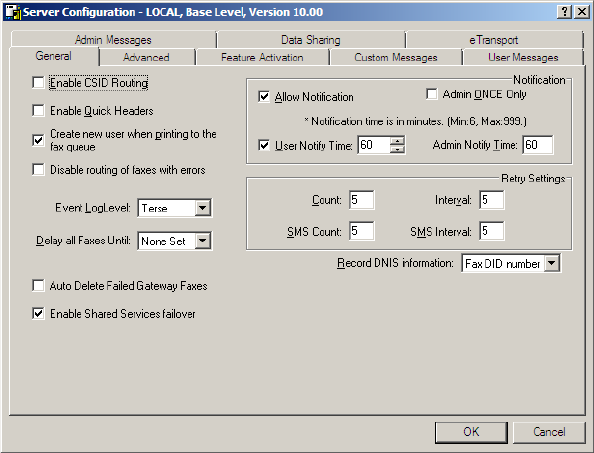
21
Chapter 3
Configuring the RightFax Server Module
The RightFax Server module manages the network print queues
assigned to faxing, controls the conversion of outgoing faxes, and
works with the RightFax BoardServer module to schedule outgoing
faxes and route inbound faxes. You can configure the RightFax
Server module to customize global fax settings, inbound fax routing,
and notifications about document processing and server status.
To configure the RightFax Server module
1. On the RightFax server, select Start > Programs > Enterprise
Fax Manager. This runs Enterprise Fax Manager, the RightFax
server administration tool. For more information on Enterprise
Fax Manager, see Chapter 8, “Managing Fax Servers with
Enterprise Fax Manager”.
2. Click the name of the RightFax server to configure in the tree in
the left pane of the Enterprise Fax Manager window. A list of
services appears at the lower-right pane of the window.
3. In the Service Name list, double-click RightFax Server
Module. The Server Configuration dialog box opens.
The rest of this chapter explains each of the options in this dialog
box.
Configuring the General Settings
Figure 3.1 The Server Configuration Dialog Box General Tab

OpenText RightFax 10.0 Administrator’s Guide 22
Enable CSID Routing Enables automatic inbound routing
using CSID (caller subscriber identification). CSID data is
information about the calling party sent to the fax board by the
phone company. The CSID is different for each caller, and can be
anything from a phone number to a company name.
For CSID routing to work, you must select this check box AND
create a CSID routing table that lists RightFax routing codes and
the CSIDs to be routed to them. For more information on CSID
routing and creating a CSID routing table see “Configuring CSID
Routing” on page 216.
Enable Quick Headers Allows a second line to be added
below the TTI line (the line listing the date, time, page number, total
pages, and fax ID at the very top of each fax page). After the quick
header is enabled, you can customize the text in the BoardServer
module (see “Quick Header Format” on page 56). If this check box
is selected, quick headers will be applied to all outgoing faxes.
Create New User when Printing to the Fax Queue
Assigns a new RightFax user ID to network users who print to the
fax queue but don’t have a RightFax user ID. RightFax uses the
“Default” user ID as a template when creating new users.
Disable Routing of Faxes with Errors When enabled, this
option will prevent routing of incomplete faxes through an email
gateway or network directory. Faxes are still available through
FaxUtil and will have a status of ‘Incompletely Received’.
Event LogLevel Specify the level of information logged in the
Application Event Log under the service name “RightFax Server
Module.” You can select the following options:
None. No information is saved.
Terse. Records critical errors only.
Normal. Records errors and major events only.
Verbose. Records all significant events and is most useful for
tracking and resolving problems.
Caution If you leave this value set to “Verbose” for long periods of time,
the Event Log can become full which may prevent new events from being
logged.
Delay All Faxes Until Specify the time of day after which all
faxes sent by users without RightFax administrative access will be
sent. To send faxes without delay, select “None set.”
Forced delays can also be set for groups of RightFax users. For
more information on groups, see Chapter 10, “Creating Groups of
Users”.
Auto Delete Failed Gateway Faxes When enabled, this
option removes faxes that fail gateway routing.
Enable Shared Services Failover Select this option to
automatically connect a client to a different server in a Shared
Services system when the primary connection is lost. If this option
is not selected, and the primary connection is lost, the client will be
unable to continue processing faxes.
Notification settings
Notification settings can be changed without stopping and
re-starting the RightFax services.
Allow Notification Enables fax notifications to be sent to
RightFax users. When this check box is selected, users receive
notification messages based on the notification options specified in
FaxUtil.

23
Admin Once Only Notifies the group administrator and
alternate administrator of their users’ unviewed faxes one time only.
User Notify Time Specify the total length of time in minutes that
the server will attempt to notify a user of an unviewed fax before it
notifies the user’s group administrator.
Admin Notify Time Specify the length of time in minutes that
the server will notify a user’s group administrator of unviewed faxes.
Note By default, the RightFax server sends periodic notifications to
users every five minutes. To re-define this interval, modify the Notify_Freq
keyword in the Windows Registry. See “Notify_Freq” on page 330.
Retry settings
Count Specify the number of times (including the first attempt) an
outgoing fax transmission will be attempted if it encounters a
non-fatal error (for example, a busy signal).
Interval Specify the minimum delay in minutes before a failed fax
transmission is rescheduled to send.
SMS Count Specify the number of times (including the first
attempt) an outgoing notification will be attempted if the system
encounters a non-fatal error (for example, a busy signal).
SMS Interval Specify the minimum delay in minutes before a
failed notification is rescheduled to send.
While a fax is being retried, it will appear with a yellow status icon
in the sender’s FaxUtil mailbox. If the fax has not been successfully
sent after the specified number of attempts, it will be abandoned
and saved in the sender’s FaxUtil mailbox with a red status icon.
The sender can force RightFax to manually retry sending the fax by
selecting the fax and pressing CTRL+K.
Record DNIS Information Specify where to store DNIS
(dialed number identification service) information for each incoming
fax. DNIS is specially encoded data that may be included with your
incoming calls as a service provided by your phone company.
RightFax fax records do not include a field dedicated to storing
DNIS information, so you must use one of three existing fields:
Select “Fax DID number” to save DNIS information where the
originating phone number is saved.
Select “Billing code 1” to save DNIS information in the fax Billing
Code 1 field.
Select “Billing code 2” to save DNIS information in the fax Billing
Code 2 field.
Select “Don’t record” to discard DNIS information.
Note Because it overwrites any data in the location you specify, DNIS
information should be saved to a field that is not used by your RightFax
system.
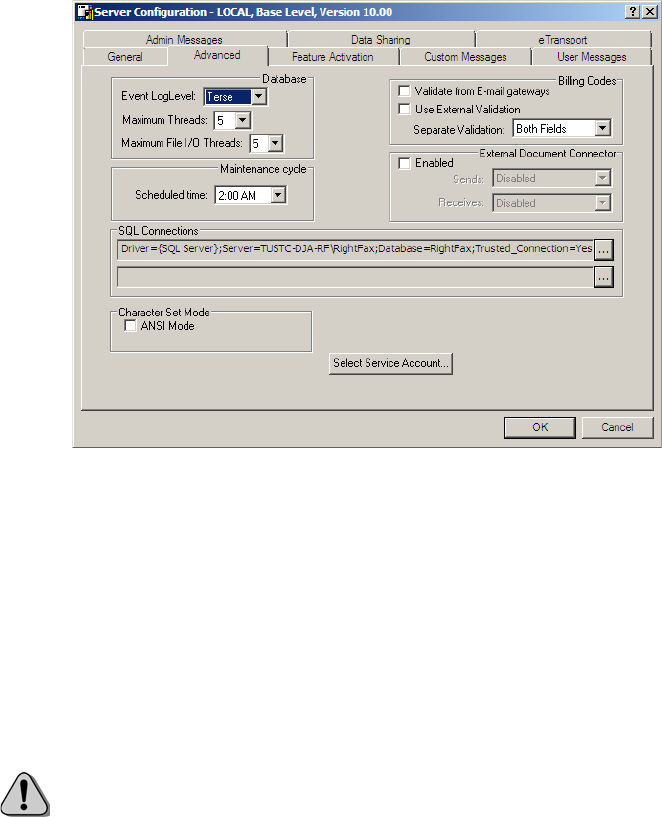
OpenText RightFax 10.0 Administrator’s Guide 24
Configuring the Advanced Settings
Figure 3.2 The Server Configuration Dialog Box Advanced Tab
Database settings
Event LogLevel Specify the level of information logged in the
Application Event Log under the name “RightFax Database
Module.” You can select the following options:
None. No information is saved.
Terse. Records critical errors only.
Normal. Records errors and major events only.
Verbose. Records all significant events and is most useful for
tracking and resolving problems.
Caution If you leave this value set to “Verbose” for long periods of time,
the Event Log can become full which may prevent new events from being
logged.
Maximum Threads Sets the number of database I/O threads
reserved to service client requests.
The RightFax Database module can respond to database requests
from multiple clients and multiple protocols at the same time. The
efficiency of this process depends on the number of database I/O
threads available. Because each thread uses resources (file
handles, CPU time, and memory), you should never increase the
number of threads to more than 10. If a database request occurs
when all the threads are busy, the request will wait in line to be
serviced.
Maximum File I/O Threads Sets the number of file I/O
threads reserved to service client requests.
The RightFax Database module can respond to file I/O requests
from multiple clients and multiple protocols at the same time. The
efficiency of this process depends on the number of file I/O
threads available. Because each thread uses resources (file
handles, CPU time, and memory), setting this value too high will
deplete the server's resources for other tasks. If a file I/O request
occurs when all the threads are busy, the request will wait in line to
be serviced.
Maintenance Cycle
This field sets the time of day when the server will perform its daily
maintenance (such as automatic file backup, fax aging, and
purging). This should be set to a time when your fax server will be
least busy.
Billing code settings
Billing code settings can be changed without stopping and
restarting the RightFax services.
Validate from Email Gateways Validates all billing codes
added to fax-bound email messages. If a billing code cannot be
validated, the fax will not send and the user will receive notification
that the fax did not send due to an invalid billing code. If this check
25
box is not selected, billing codes may be added to fax-bound email
messages but will not be validated prior to sending (in other words,
any billing code will be accepted).
Use External Validation Tells RightFax to use an external
program to verify billing codes on outbound faxes. This gives the
user the ability to validate faxes based on several different criteria,
not just billing codes. To work, a program must be written with the
RightFax API to perform the verification of billing codes. For
information on downloading and using the RightFax API, visit the
Open Text Knowledge Center at knowledge.opentext.com.
Separate Validation Customizes the way in which required
billing codes are validated against the RightFax database.
Selecting “Both Fields” requires both Billing Code 1 and Billing
Code 2 fields contain valid codes. “Field 1 or Field 2” requires
either of the billing code fields to contain a valid code, but not
necessarily both. “Field 1 Only” requires only the Billing Code 1
field contain a valid code. “Field 2 Only” requires only the Billing
Code 2 field contain a valid code.
External document connector
The external document connector settings are used for integrations
between RightFax and third-party systems such as FileNet and
XML Generator. If you are not using these integrations, do not
select this check box.
SQL Connection
These fields display the connection strings that define the RightFax
server’s connection to the SQL database. You can make changes
to either SQL connection by clicking the [...] button on the right.
For more information on changing and editing the connections to
the RightFax database on the SQL server, see “Changing the
Connection to the SQL Server” on page 285.
Character Set Mode
Select this check box to use the ANSI code page for the character
sets used in faxed documents. Deselect it to use the default OEM
code page and character sets.
RightFax installed on non-English language operating systems
such as German or Turkish may not display special characters
(such as umlauts) correctly. Selecting the ANSI code page can
resolve this.
Select Service Account
Click this button to select a service account for the RightFax Server
and RightFax Database services. Specifying an account for these
services is only required if you want to connect to the SQL
database using Windows authentication.
Configuring Feature Activation
The Feature Activation tab allows you to launch the Product
Licensing Utility (or PLU). The PLU is required when changing or
adding to your feature set.
For more information on upgrading your server license, add
additional fax channels, and add new RightFax components, refer
to the RightFax Installation Guide.
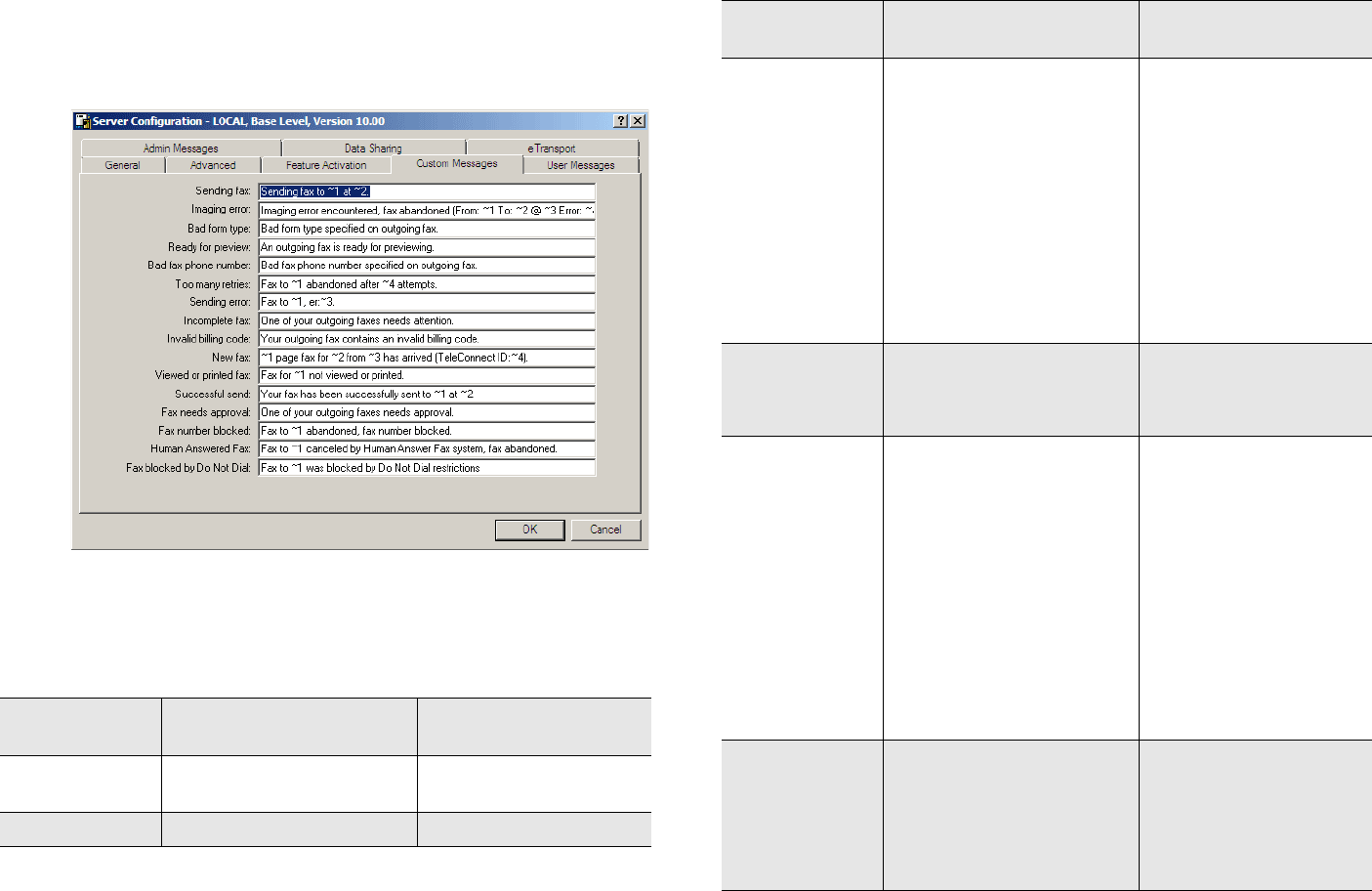
OpenText RightFax 10.0 Administrator’s Guide 26
Configuring Custom Messages
These options let you customize the text of messages that are sent
for fax status notifications for users (described on page 115).
Figure 3.3 The Server Configuration Dialog Box Custom Messages Tab
Notification messages can contain a combination of text and
variable data. Each message has variable options, described in the
following table.
Table 3a Notification Message Options
Notification
message Variable options When used
Bad fax phone
number
~1 = User ID
~2 = Fax phone number
The fax number contains
invalid characters.
Bad form type ~1 = User ID A bad form was specified.
Fax blocked by
Do Not Dial
~1 = Recipient’s name
~2 = Recipient’s fax number
~3 = Fax error code
~4 = Sender’s user ID
~5 = Billing code 1
~6 = Billing code 2
~7 = Recipient’s company
~8 = An HTML link to the fax
on the WebUtil client (if
applicable)
A fax was not sent
because the destination
fax number was blocked
by the Do Not Dial feature.
(described on page 198.)
Fax needs
approval
~1 = User ID
~2 = Recipient’s name
~3 = Recipient’s fax number
One of the sender’s
outgoing faxes needs
approval.
Fax number
blocked
~1 = Recipient’s name
~2 = Recipient’s fax number
~3 = Fax error code
~4 = Number of retries
~5 = Billing code 1
~6 = Billing code 2
~7 = URL link to the fax on
the RightFax server
(this option can only be
used with RightFax
email gateway
The recipient’s fax number
is blocked by the RightFax
BoardServer. Fax
numbers can be blocked
using the following
options:
Dialing rules.
The call blocking
Windows Registry entry
on the BoardServer.
Human
Answered Fax
~1 = Recipient’s name
~2 = Recipient’s fax number
~3 = Fax error code
~4 = Number of retries
~5 = User ID
The fax was canceled (not
accepted) by the recipient
when the recipient
responded to the RightFax
voice prompt.
Table 3a Notification Message Options (Continued)
Notification
message Variable options When used

27
Imaging error ~1 = User ID
~2 = Recipient’s name
~3 = Recipient’s fax number
~4 = Error encountered
The server cannot
generate a fax image.
Incomplete fax ~1 = User ID
~2 = Unique ID of the fax
The sender did not
complete all of the
required fax information
fields.
Invalid billing
code
~1 = User ID
~2 = Billing code 1
~3 = Billing code 2
The sender did not
provide a valid billing
code.
New fax ~1 = Number of pages
received
~2 = User ID
~3 = Received remote ID
~4 = TeleConnect ID
~5 = Unique ID of fax
~6 = URL link to the fax on
the RightFax server
(this option can only be
used with a RightFax
email gateway)
A new fax was received.
Ready for
preview
~1 = User ID
~2 = Recipient’s name
~3 = Recipient’s fax number
~4 = Billing code 1
~5 = Billing code 2
The fax was held for
preview and is now ready.
Table 3a Notification Message Options (Continued)
Notification
message Variable options When used
Sending error ~1 = Recipient’s name
~2 = Recipient’s fax number
~3 = Fax error code
~4 = Number of retries
~5 = User ID
~6 = Billing code 1
~7 = Billing code 2
~8 = Recipient’s company
The fax could not be sent.
Sending fax ~1 = Recipient’s name
~2 = Recipient’s fax number
~3 = User ID
~4 = Recipient’s company
The fax starts to send or is
still sending after a few
minutes.
Successful send ~1 = Recipient’s name
~2 = Recipient’s fax number
~3 = Recipient’s company
~4 = URL link to the fax on
the RightFax server
(this option can only be
used with a RightFax
email gateway)
The fax transmission was
successful.
Table 3a Notification Message Options (Continued)
Notification
message Variable options When used
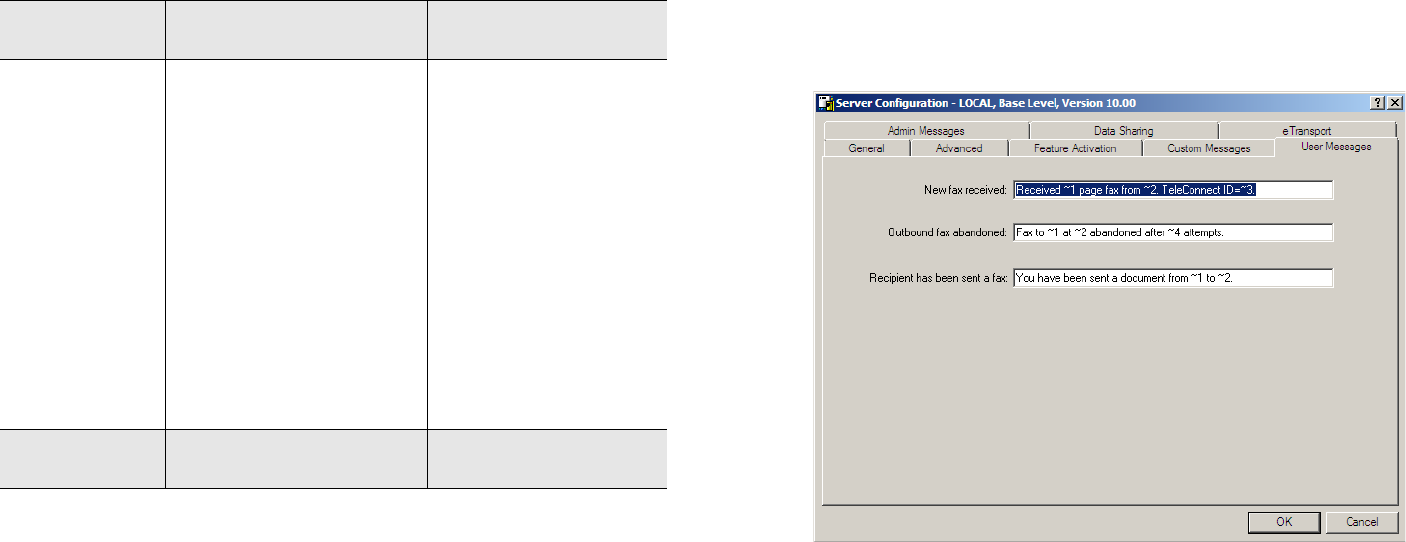
OpenText RightFax 10.0 Administrator’s Guide 28
To return a notification message to the default setting, select the
text, delete it, and then click OK. The next time you open the dialog
box, the default message will be listed.
Configuring User Messages
You can replace the default pager/SMS fax notification messages
for users with customized messages. Users will receive
pager/SMS notifications only if they have been configured to do so
in the Pager Notification tab of their user configuration in
Enterprise Fax Manager (described on page 111). For more
information on configuring SMS and pager notifications, see
Chapter 17, “Adding SMS and Pager Services”.
Figure 3.4 The Server Configuration Dialog Box User Messages Tab
Too many retries ~1 = Recipient’s name
~2 = Recipient’s fax number
~3 = Fax error code
~4 = Number of retries
~5 = User ID
~6 = Billing code 1
~7 = Billing code 2
~8 = Recipient’s company
~9 = URL link to the fax on
the RightFax server
(this option can only be
used with RightFax
email gateway)
The fax was abandoned
after the maximum number
of send attempts.
Viewed or printed
fax
~1 = User ID A received fax has not
been viewed or printed.
Table 3a Notification Message Options (Continued)
Notification
message Variable options When used
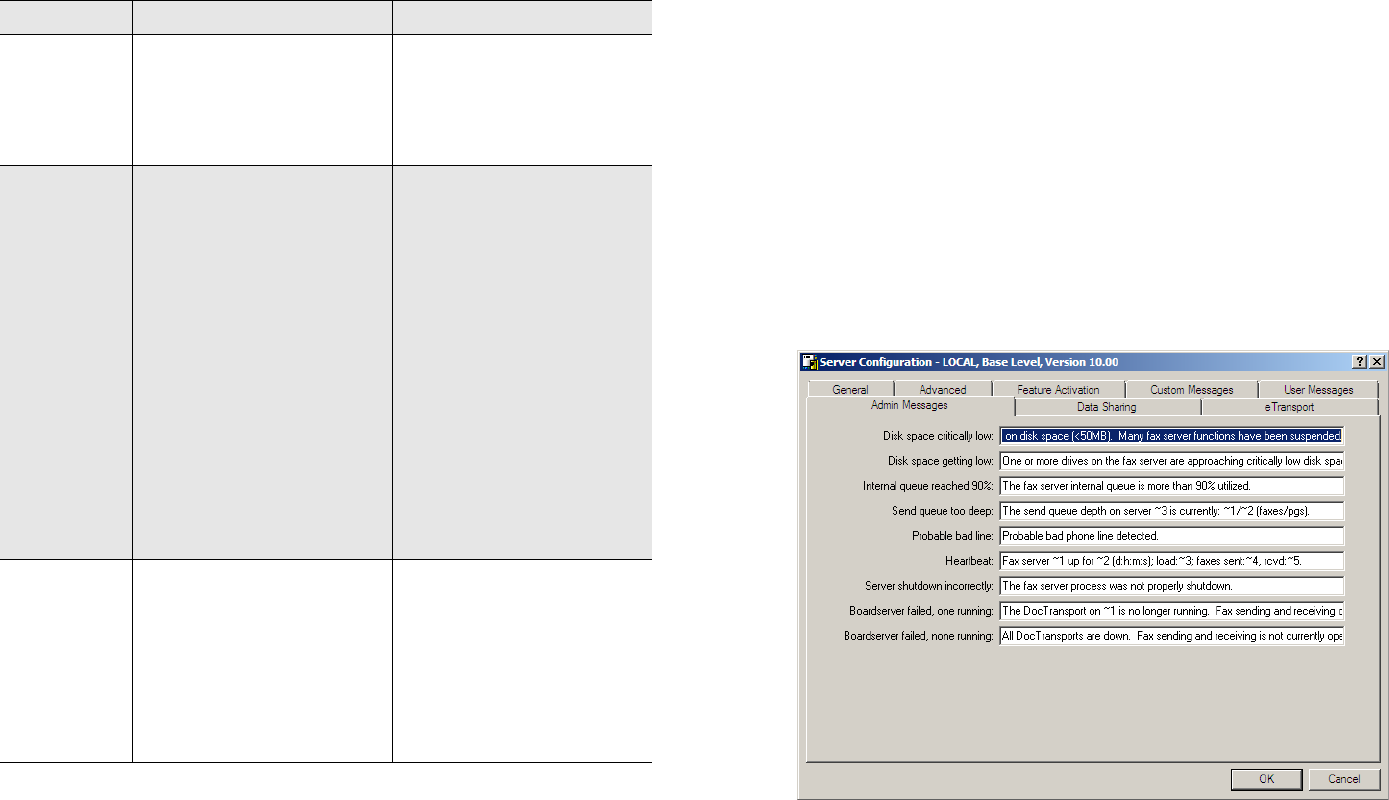
29
For each message type, enter the custom message text you want.
Each message type has its own set of variables, described in the
following table.
To return a notification message to the default setting, select the
text, delete it, and then click OK. The next time you open the dialog
box, the default message will be listed.
Configuring Admin Messages
These options let you customize the text of SMS or pager
administrative alerts (described on page 112). For more
information on configuring SMS and pager notifications in
RightFax, see Chapter 17, “Adding SMS and Pager Services”.
RightFax Enterprise versions 8.7 and higher include a more
comprehensive Alerting and Monitoring service that lets you select
from hundreds of server statistics to monitor and define the event
thresholds, alert types, and alert messages to send. For more
information on the RightFax Alerting and Monitoring service, see
Chapter 18, “Using the Alerting and Monitoring Service”.
Figure 3.5 The Server Configuration Dialog Box Admin Messages Tab
Table 3b User Message variables
Alert Variables When used
New fax
received
~1 = Page count
~2 = CSID or ANI of sender
~3 = TeleConnect ID
~4 = CSID
~5 = ANI
Sent to a RightFax user
when a new fax is received.
Outgoing fax
abandoned
~1 = Recipient’s name
~2 = Recipient’s fax number
~3 = Short error description
(last attempt)
~4 = Send attempts
~5 = Owner ID
~6 = Billing code 1
~7 = Billing code 2
~8 = Recipient’s company
~6 = URL link to the fax on
the RightFax server
(requires the Gateway
for Microsoft
Exchange)
Sent to a RightFax user
whose outbound fax has
failed to send for any reason.
Recipient has
been sent a
fax
~1 = From name
~2 = To name
Sent to the fax recipient to
notify that a fax has been
sent from the RightFax
server. The fax recipient
notification address is
entered by the RightFax
client user when creating a
new outbound fax.
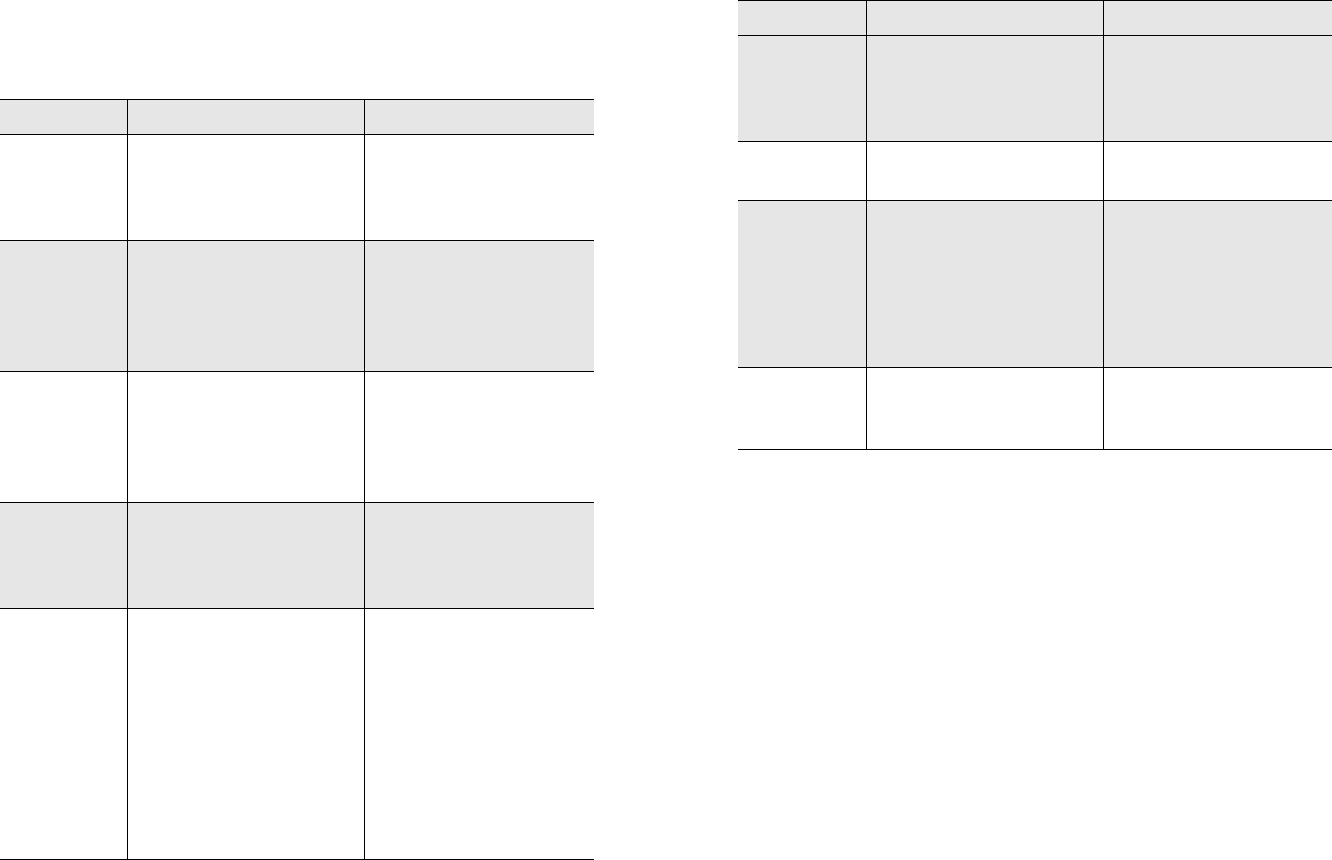
OpenText RightFax 10.0 Administrator’s Guide 30
For each message type, enter the custom message text you want.
Each message type has its own set of available variables,
described in the following table.
To return a notification message to the default setting, select the
text, delete it, and then click OK. The next time you open the dialog
box, the default message will be listed.
Table 3c Admin Message Settings
Alert Default message Variables
BoardServer
failed, none
running
All BoardServers are
down. Fax sending and
receiving is not currently
operating.
None
BoardServer
failed, one
running
The BoardServer on ~1 is
no longer running. Fax
sending and receiving
operations are functioning
on other BoardServers.
~1 = BoardServer
machine
Disk space
critically low
One or more drives on the
fax server are critically low
on disk space (<50MB).
Many fax server functions
have been suspended.
None
Disk space
getting low
One or more drives on the
fax server are
approaching critically low
disk space (<150MB).
None
Heartbeat
(periodic
status
including
statistics on
fax activity).
Fax server ~1 up for ~2
(d:h:m:s); load:~3; faxes
sent:~4, rcvd:~5.
~1 = Fax server name
~2 = Up time
(dd:hh:mm:ss)
~3 = Fax server internal
queue usage
~4 = Total faxes sent
since install date
~5 = Total faxes received
since install date
Internal
queue
reached
90%
The fax server internal
queue is more than 90%
utilized.
None
Probable
bad line
Probable bad phone line
detected.
None
Send queue
too deep
The send queue depth on
server ~3 is currently:
~1/~2 (faxes/pgs).
~1 = Queue depth
(faxes)
~2 = Queue depth
(pages)
~3 = BoardServer
machine
Server
shutdown
incorrectly
The fax server process
was not properly shut
down.
~1 = Fax server name
Table 3c Admin Message Settings (Continued)
Alert Default message Variables
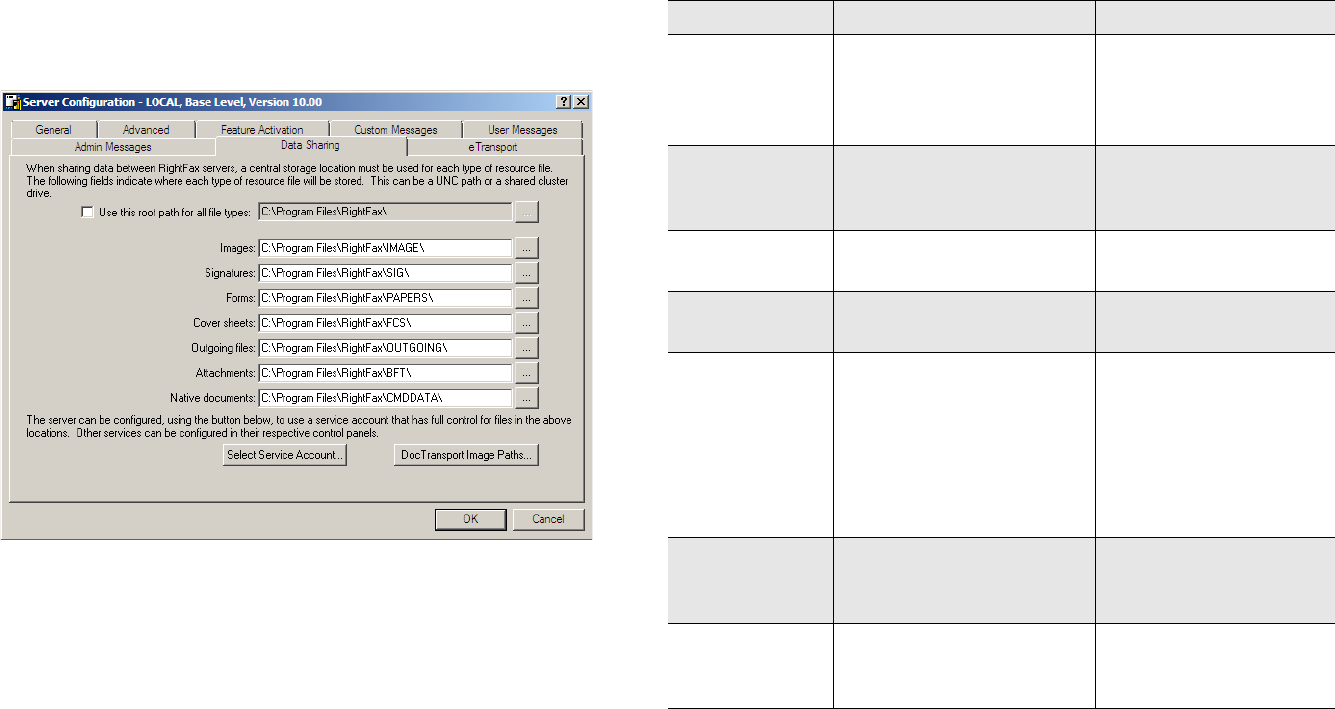
31
Configuring Data Sharing
The capacity of RightFax servers can be multiplied by combining
two or more servers that share a common SQL database. This is
accomplished by installing and configuring multiple RightFax
servers to share a RightFax database and corresponding resource
folders. See the RightFax Installation Guide for installation
instructions.
Figure 3.6 The Server Configuration Dialog Box Data SharingTab
The fields within the Data Sharing tab represent folders that must
be shared among all the RightFax servers shared environment. A
complete list and description of the shared data folders is provided
below.I
Table 3d Shared Folder Names
Field Folder Name Description
Images IMAGE Contains sent and
received faxes stored as
compressed graphic
image files.
Signatures SIG Contains graphic images
of user signatures for
placement on faxes.
Forms PAPERS Contains the names of
overlay form files.
Cover Sheets FDS Contains fax cover
sheets.
Outgoing Files OUTGOING Contains outbound files
from all submission
methods that are held
while being processed
into fax images, such as
temporary fax queue
spool files.
Attachments BFT Contains text files
created by the OCR
process.
Native
Documents
CMDDATA Contains transaction
files for each fax sent via
email or via SecureDocs.
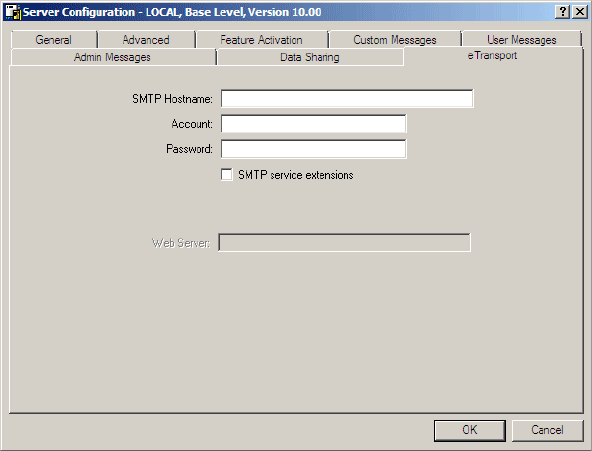
OpenText RightFax 10.0 Administrator’s Guide 32
Each of these folders can be located in common disk storage, such
as a storage area network (SAN), network share on file server, or
network access to a local drive on one of the RightFax servers. The
folders must be accessible to all the servers in the shared
configuration.
Share permissions must be given to the account used to run both
the Server module and DocTransport module. This account must
have full control of these folders. To specify this account, click the
Select Service Account button.
The Remote Service Paths button allows you to specify paths to
the \RightFax\Image directory on Remote DocTransport servers.
For Example:
\\<Shared Storage>\RightFax\Image
\\<Shared Storage>\D$\RightFax\Image
\\<ip address>\RightFax\Image
\\<Shared Storage>|RightFax\Image
Configuring eTransport
The eTransport options configure the server to send outbound fax
documents to email addresses in addition to fax numbers.
Figure 3.7 The Server Configuration Dialog Box eTransport Tab
SMTP Hostname Enter the name of the SMTP mail server to
which outbound documents sent to email addresses via the
RightFax client applications will be sent. If no SMTP mail server is
specified here, RightFax users using the FaxUtil client will not have
the option to address fax documents to an email address.
Account and Password If the specified server uses
anonymous access, leave the Account and Password fields blank.
If the specified server uses basic or Windows Integrated Security,

33
enter the user name (in the format Domain\Username) in the
Account field and the password for that account in the Password
field. Do not use TLS security on the SMTP server.
Note Anonymous authentication requires relay to be enabled on the
SMTP server.
SMTP service extensions (ESMTP) If the SMTP mail server
uses SMTP service extensions, select this check box. SMTP
service extensions start an SMTP session by issuing the EHLO
command instead of the HELO command.
Web Server Enter the Internet host name of the machine running
the IIS server that the RightFax SecureDocs module is installed on.
This field is required if you have installed the RightFax SecureDocs
Module. For more information on this option and configuring
RightFax for certified document delivery, refer to the RightFax
SecureDocs Module Guide.
To verify that eTransport is configured correctly, follow these steps:
1. From EFM, stop the RighFax eTransport service.
2. Right-click the eTransport service, then select debug to display
a command prompt window. Leave this window open.
3. From FaxUtil, submit an email.
4. Check the open debug window for potential error messages.
Starting and Stopping the RightFax Server
The RightFax server is comprised of several services, called
“modules.” These are:
Server module
BoardServer module
Database module
DocTransport module
Queue Handler
RPC Server module
WorkServer module
Integration module (optional)
Email Gateway module (optional)
These services are configured and started during installation. You
should only need to stop and start RightFax services during server
or network maintenance.
Starting or stopping the RightFax server requires starting or
stopping the separate processes. There are two ways to start or
stop the processes.
Starting the Server Using the Services Program
In Windows Control Panel, start the Services program. In the list of
services, you will see several RightFax modules. To start the
RightFax server, click the RightFax BoardServer module and click
Start. Next, click the RightFax Server module and click Start. This
will start the RightFax Database module, RightFax Server module,
and the RightFax WorkServer modules.
Note To view the Fax Server control panel icons on x64 systems, be
sure to select View 32-bit Control Panel Items in Control Panel.

OpenText RightFax 10.0 Administrator’s Guide 34
Starting the Server at a Command Prompt
In a command prompt window at any prompt, enter the following
command:
net start serviceshortname
(for example, net start rfserver)
Note You should never start the RightFax Database module,
WorkServer modules, or Email Gateway modules directly. They must be
started by the RightFax Server module.
Stopping the RightFax Server
To stop the RightFax server from Windows Control Panel, click
Stop on the RightFax Server module and the RightFax
BoardServer module services.
To stop the RightFax server from a command prompt, type the
following:
net stop serviceshortname
(for example, net stop rfboard)
Understanding the Services
The following table describes each RightFax service and tells
whether the service is started automatically or manually by
Windows on startup. Note that if the startup is automatic, it can be
stopped and started as needed.
Table 3e RightFax Services
Service name
Short
name Startup Description
Captaris
Conversion
Engine
RFIsoConv Auto Configurable server that
controls conversion of Office,
HTML, and OCR documents.
Captaris Sync
Module
CapaSync Auto Configurable server that
controls one-way
synchronization from Active
Directory or LDAP data sources
RightFax
BoardServer
module
RFBOARD Auto The communication link between
RightFax and the fax hardware.
RightFax
Database module
RFDB Manual A multi-threaded module that
handles communication
between the database files
(located in the
RightFax\Database folder) and
the fax clients.
RightFax
DocTransport
module
RFDOC
TRANS
Auto Allows configuration of the
methods by which RightFax
will transmit documents.
RightFax Email
Gateway module
RFEMAIL Manual The communication bridge to an
optional email gateway.
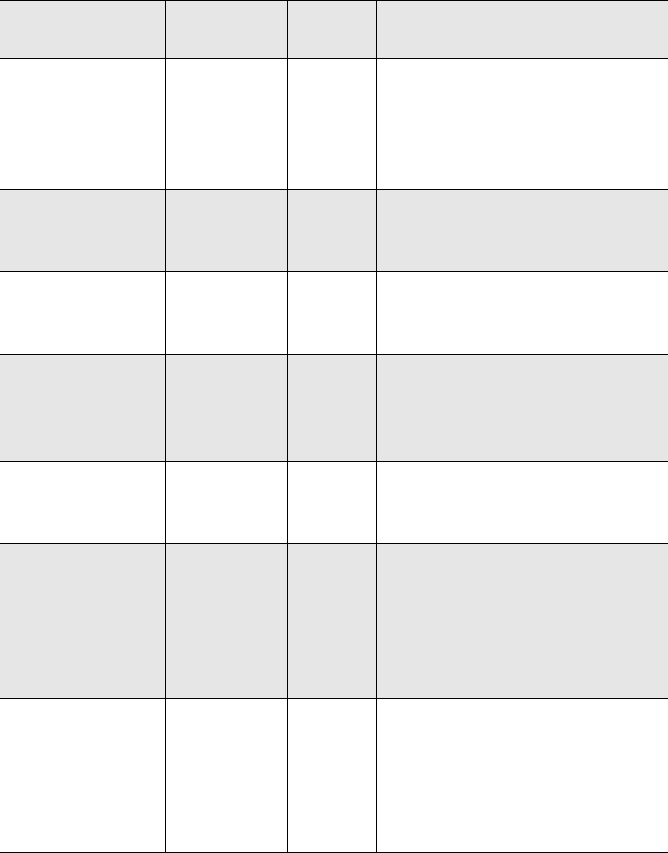
35
Understanding the Fax Server Internal Event
Queue
The Fax Server module is responsible for queueing and monitoring
each of the fax server internal processes, which are collectively
called the “Event Queue.” The status of the Event Queue is
measured as a percentage of server resources that are occupied
with Fax Server module functions (such as sending and routing
faxes).
The Event Queue is represented as the ratio of fax traffic volume to
server resources. The higher the traffic volume, the higher this
number will be. The Event Queue status is displayed in Enterprise
Fax Manager when you open and select a RightFax server.
When the Event Queue of a RightFax server reaches 90 percent,
the server will suspend certain functions. At 90 percent, all new
outbound and inbound faxes will be held (temporarily set aside)
while the server processes the existing workload. After the Event
Queue falls to 75 percent, these held faxes will be scheduled for
processing along with all new fax traffic.
This internal workload regulation is handled by the Fax Server
module and cannot be overridden. If the fax server is consistently
reaching the 90 percent capacity level, you should consider
upgrading the fax server’s system resources and/or fax channels.
RightFax Paging
module
RFPAGE Auto Monitors RightFax for pager
notification events and handles
communication between
RightFax and the SMS or pager
services.
RightFax
Integration
module
RFPROD Auto Allows applications on a
mainframe to send custom faxes
through the fax server.
RightFax Queue
Handler
RFQUEUE Auto Monitors the RightFax print
queue for jobs to be forwarded
to the server for fax conversion.
RightFax RPC
Server module
RFRPC Auto The communication bridge to fax
clients that use IPX, SPX or
TCP/IP via remote procedure
calls.
RightFax
Remoting
RFRemote Auto Handles communication with
remote RightFax services and
applications.
RightFax Server
module
RFSERVER Auto The bridge between all other
RightFax services. Also
responsible for stopping and
starting the WorkServer,
Database, and email gateway
modules.
RightFax
WorkServer
modules
RFWORK#Manual One or more modules
responsible for RightFax’s most
processor-intensive functions
such as cover sheet generation,
PCL5-to-fax conversion, and
optical character recognition.
Table 3e RightFax Services (Continued)
Service name
Short
name Startup Description
OpenText RightFax 10.0 Administrator’s Guide 36
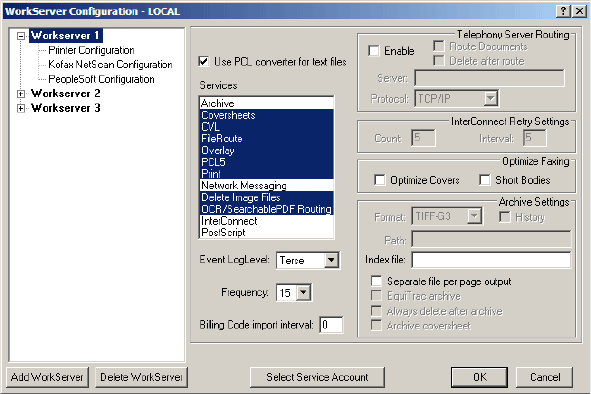
37
Chapter 4
Configuring the WorkServer Modules
Each RightFax WorkServer module performs one or more
processor-intensive functions on behalf of the RightFax Server
module. They regularly query the Database module for jobs to be
performed, execute those jobs, and notify the database when
finished.
The default configuration of the RightFax WorkServer modules
allows you to send and receive fax documents. You can customize
the WorkServer modules to meet the needs of your enterprise.
You can also enable product integrations with Kofax and
Peoplesoft through the RightFax WorkServer modules.
To configure the RightFax WorkServer modules
1. On the RightFax server, select Start > Programs > Enterprise
Fax Manager. This runs Enterprise Fax Manager, the RightFax
server administration tool. For more information on Enterprise
Fax Manager, see Chapter 8, “Managing Fax Servers with
Enterprise Fax Manager”.
2. Click the name of the RightFax server to configure in the tree in
the left pane of the Enterprise Fax Manager window. A list of
services appears at the lower-right pane of the window.
3. In the Service Name list, double-click RightFax WorkServer1
Module. The WorkServer Configuration dialog box opens.
The rest of this chapter explains each of the options in this dialog
box.
Figure 4.1 The WorkServer Configuration Dialog Box
Each WorkServer is configured separately. To configure a
WorkServer, click the WorkServer number or one of its
configuration options in the left pane.
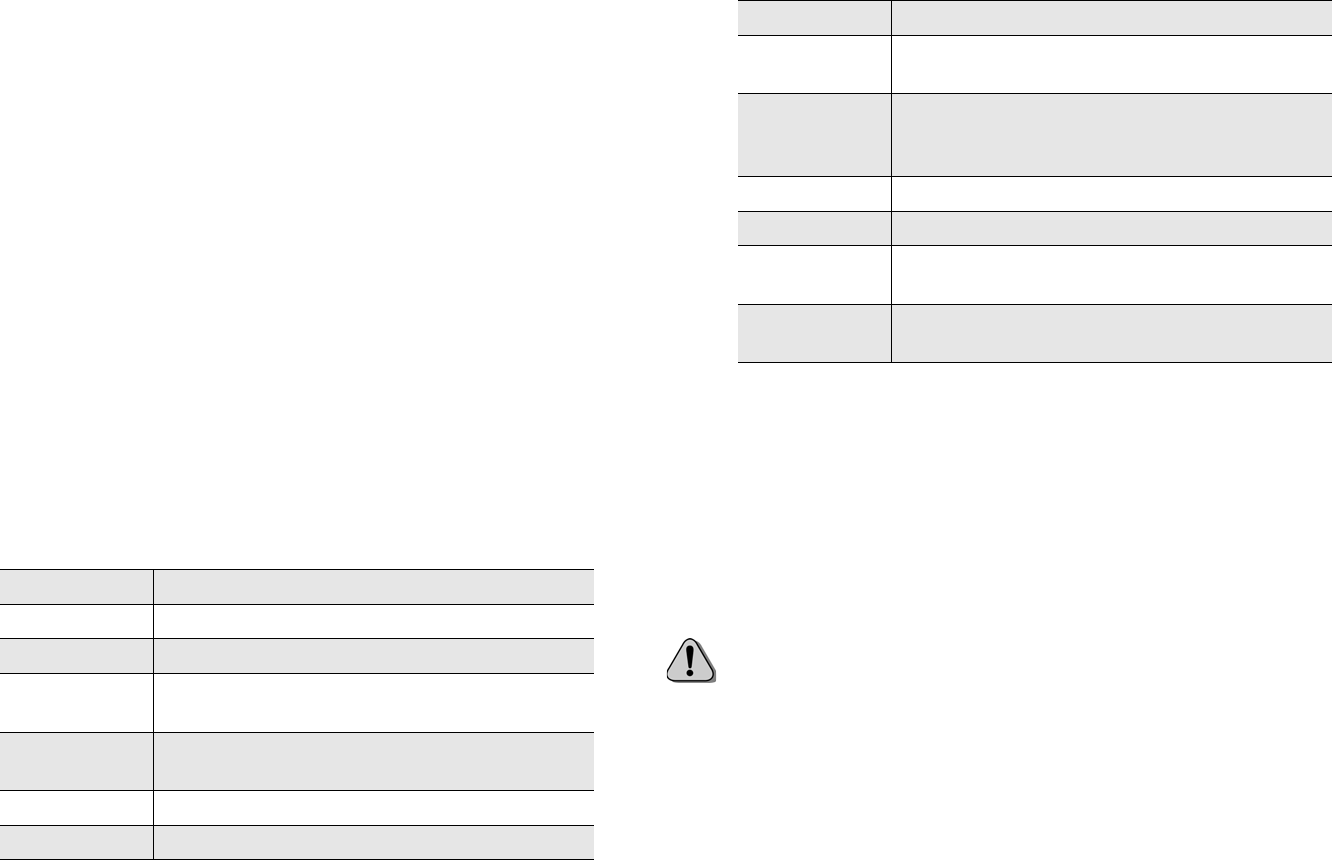
OpenText RightFax 10.0 Administrator’s Guide 38
Remote WorkServer Service Tells RightFax that this
WorkServer will execute on a separate Windows machine on the
network. If this check box is selected, the WorkServer service will
not be started automatically by the RightFax Server service. For
more information on running WorkServers remotely, see “Installing
WorkServers on Remote Computers” on page 47.
Use PCL Converters for Text Files Uses the RightFax Printer
Control Language (PCL) conversion engine when converting PCL
and ASCII text files to fax format. This conversion usually produces
more accurate fax images of PCL and ASCII text files than the
RightFax native document conversion engine. If you notice that
PCL or ASCII text files are not converting to fax format as
accurately as you expect, click to clear this check box to return to
using the RightFax native document conversion engine.
Services Click the services you want to assign to the current
WorkServer, or shift-click to select multiple services. You can
assign a single service to multiple WorkServers or dedicate a
WorkServer to one service only. How you configure your
WorkServers depends on your organization's needs and fax server
workload. The following table lists the available WorkServer
services and their functions.
Event LogLevel Specify the level of information logged in the
Application Event Log under the service name “RightFax
WorkServer Module.” You can select the following options:
None. No information is saved.
Terse. Records critical errors only.
Normal. Records errors and major events only.
Verbose. Records all significant events and is most useful for
tracking and resolving problems.
Caution If you leave this value set to “Verbose” for long periods of
time, the Event Log can become full which may prevent new events
from being logged.
Frequency Specify how often, in seconds, the WorkServer will
query the Database module for new requests. If you only have one
WorkServer module, 5 to 10 seconds is an appropriate setting.
However, if you run multiple WorkServers, a lower frequency (for
example, 15) will prevent requests from overloading the Database
module.
Table 4a WorkServer Services
Service Function
Archive Archive sent faxes.
Cover sheets Create cover sheets.
CVL Handle faxes with multiple LIBDOC or LIBDOC2
and ADDDOC embedded codes.
Delete Image
Files
Delete fax image files.
FileRoute Route received faxes to network folders.
InterConnect Route received faxes to another RightFax server.
Network
Messaging
This service no longer functions with any of the
supported Windows operating systems.
OCR Optical Character Recognition (requires the
RightFax OCR Converter or OCR Router
module).
Overlay Overlay faxes with forms.
PCL5 PCL5-to-fax conversion.
PostScript PostScript-to-fax conversion (requires the
RightFax PDF or SecureDocs module).
Print Handle requests for both on-demand and
automatic fax printing.
Table 4a WorkServer Services (Continued)
Service Function

39
Billing Code Import Interval Specify how often, in minutes,
the WorkServer will check for a new billing code delta file
Codechg.csv. This file is used to used to query billing codes from
external billing code source. If the file exists, the WorkServer
imports the additions, changes, and deletions specified in the file.
For more information on using billing codes from an external
source, “Importing Billing Codes”on page 142.
Telephony server routing
Enable Select Enable to integrate the RightFax system with your
enterprise telephony server system. For information on custom
integrations with your fax server, refer to your telephony server
documentation.
Caution Any WorkServer that has telephony server routing enabled
must be dedicated to telephony routing only. Any other assigned services
will be ignored by this WorkServer.
Server Specify the name of the telephony server on your network
to integrate with the RightFax server.
Protocol Select the network protocol to use for communicating
between the RightFax and telephony servers.
InterConnect retry settings
RightFax InterConnect allows faxes received on one RightFax
Enterprise server to be automatically routed to a fax mailbox of the
same name on a different RightFax Enterprise server on the same
network. With InterConnect, interoffice faxes can be sent via the
network that links the RightFax Enterprise servers, rather than via
the phone lines, saving time and potential long distance phone
charges. For information on enabling and configuring InterConnect,
see “RightFax InterConnect” on page 218).
These settings will only be available if you have selected
“InterConnect” under Services.
Count Specify the number of times the originating fax server will
attempt to forward the fax to the destination fax server when it
encounters a non-fatal error (e.g., server temporarily down).
Interval Specify the time delay, in minutes, between retries.
Optimize faxing
Short Covers Makes fax cover sheets only as long as the cover
sheet text requires (ignoring any blank space at the end of the
cover sheet), potentially reducing transmission times. This may
produce a partial page on some destination fax machines.
If this check box is not selected, cover sheets will be padded to fill
an entire page.
Short Bodies Makes each page in the body of the fax only as
long as the text requires (ignoring any blank space at the end of
pages), potentially reducing transmission times. This may produce
partial pages on some destination fax machines.
If this check box is not selected, each fax page will be padded to fill
an entire page.
Archive settings
RightFax can save a copy of each user’s outbound faxes. This fax
“archive” feature is useful for tracking and storing all of your
organization's outbound faxes or for integrating RightFax with
image tracking software systems.
Archived faxes are saved in a network folder that you specify and
can include an optional fax history file and archive log entry.
Archived faxes are saved using unique file names generated by
RightFax with a file extension corresponding to the file format used
for the archive.
Each fax is archived individually upon completion, whether or not
the fax was successfully sent. A fax will be archived one time for
each recipient, so one fax sent to a group of ten recipients will be
archived as ten separate faxes.
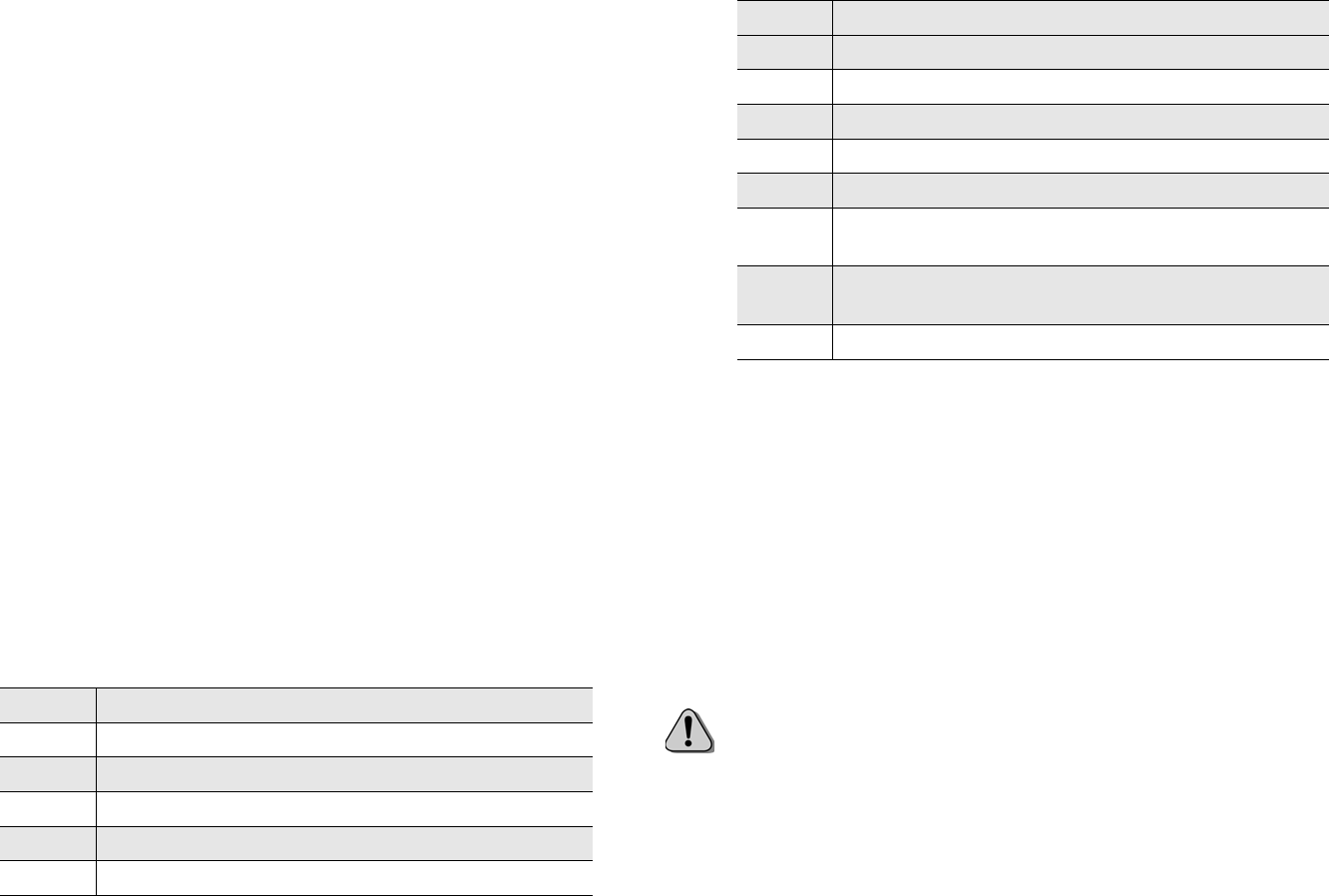
OpenText RightFax 10.0 Administrator’s Guide 40
Each RightFax user is individually configured for fax archiving. To
enable fax archiving for a user, select the Archive Sent Faxes
check box in the User Permissions tab of the User Edit dialog box
in Enterprise Fax Manager (see “Archive Sent Faxes”on page 107.)
Also, in order to archive sent faxes, at least one of the WorkServers
must have “Archive” selected under Services. For each
WorkServer that will manage archiving, you must also complete the
archive settings here.
Format Specify the file format used when archiving faxes. The file
format you should choose depends on how you plan to use the
archived faxes. By default, files are archived in a multi-page
TIFF-G3 format with Group III data compression.
History Includes each fax's transmission history with the archived
fax image. The fax history is a separate ASCII file saved in the
archive folder using the same file name as the fax but with the
extension.trx.
Path Specify the folder, in UNC (universal naming convention)
format, where archived faxes will be stored. The WorkServer will
create the specified path if it doesn’t already exist.
The path can be customized using special variables that are
replaced in the path name each time a fax is archived. Using
variables in the path name lets you archive faxes to separate folders
based on the sender, the date, the fax destination, or any
combination of these. The following table lists each of the archive
path variables and their definitions.
ExampleFor example, this path:
\\Faxserver\Archive\~C\~7\~3~4
might look like this after variable replacement:
\\Faxserver\Archive\DEVELOPM.ENT\JDOE\JAN1999
In this example, all of the faxes sent by user ID “JDoe” in the
“Development” group will be stored in a unique archive folder,
organized into separate subfolders each month.
The total path length, after variable replacement, cannot exceed
128 characters. If you do not enter a path, no faxes will be
archived.
Caution Because “~1” is interpreted as a macro in the path name, you
cannot use short path names (i.e. \Progra~1\RightFax\Archive) in this
field. You must use enter the full path names.
Table 4b Archive Path Macros
Variable Definition
~1 Date (YYYYMMDD)
~2 Day of the week (SUN-SAT)
~3 Month (JAN-DEC)
~4 Year (YYYY)
~5 Day of the month (DD)
~6 Month as decimal (01–12)
~7 User ID (up to 11 characters in 8.3 FAT format)
~8 Week as decimal (00–51)
~9 Billing Code #1 (up to 11 characters in 8.3 FAT format)
~0 Billing Code #2 (up to 11 characters in 8.3 FAT format)
~A Remote ID (left to right, up to 11 characters in 8.3 FAT
format)
~B Remote ID (right to left, up to 11 characters in 8.3 FAT
format)
~C Group ID (up to 11 characters in 8.3 FAT format)
Table 4b Archive Path Macros (Continued)
Variable Definition
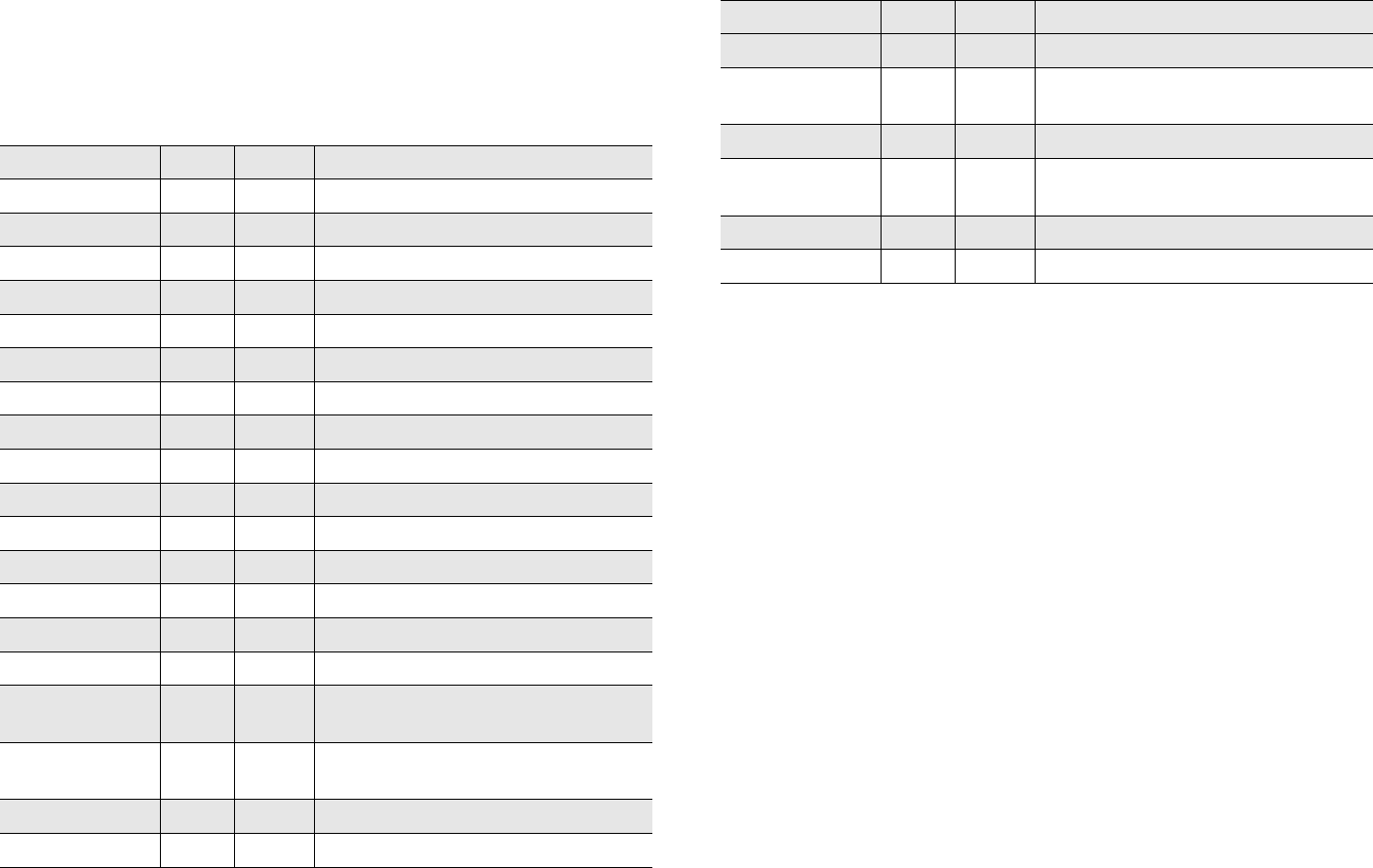
41
Index file Specify the UNC path and file name of the file where
all archive events will be logged. The index is a comma-delimited
ASCII file. Each index entry appears on a separate line and
includes 24 data fields. The following table lists all of the fields for
each index entry in the order the fields appear.
Because this log file is dynamic, if you plan to use a third-party
application to access the log information you must make sure the
file is opened in shared mode. Also, no third-party application
should be granted write access, and should not be configured so
as to keep the log file open for more than 10 to 20 seconds. The
optimal method for third-party access is to make a copy of the log
file, and then access data from the copy.
If no log file name is specified, RightFax will not log archive events.
Separate file per page output Archives each page of each
fax as a separate TIFF file (i.e., a five-page fax will be archived as
five separate files). This check box will only be available if you have
selected “TIFF-G3” or “TIFF-G4” in the Format box (see
“Format”on page 40.)
Table 4c Index File Fields
Field Type Length Definition
Owner_ID String 21 User ID of the fax “owner”
To_FaxNum String 31 Recipient’s fax number
To_ContactNum String 31 Recipient’s phone number
To_Name String 59 Recipient’s name
To_Company String 59 Recipient’s company name
To_CityState String 59 Recipient’s city and state
From_Name String 59 Sender’s name
From_PhoneNum String 31 Sender’s phone number
Billinfo1 String 15 Billing code 1
Billinfo2 String 15 Billing code 2
FaxDIDNum String 31 DID routing number
OperatorNum String 31 Organization’s general phone number
GeneralFaxNum String 31 Organization’s general fax number
RemoteID String 21 Received remote ID
Send_Time Integer N/A Total time on fax board, in seconds
Fax_Status Integer N/A A number corresponding to the fax’s
last reported status.
Fax_Termstat Integer N/A A number corresponding to the fax’s
last reported transmission status.
NumPages Integer N/A Includes optional cover sheet, if any
FineMode Integer N/A 0=normal, 1=fine
Received Integer N/A 0=sent, 1=received
FaxDate String 10 Date the fax record was last modified
(mm/dd/yyyy)
FaxTime String 5Time fax record last modified (hh:mm)
UniqueID String 15 Unique ID for the fax assigned by
RightFax server
Archived_Name String 256 File name used for the image archive
NewLine N/A N/A CR–LF combination record separator
Table 4c Index File Fields (Continued)
Field Type Length Definition
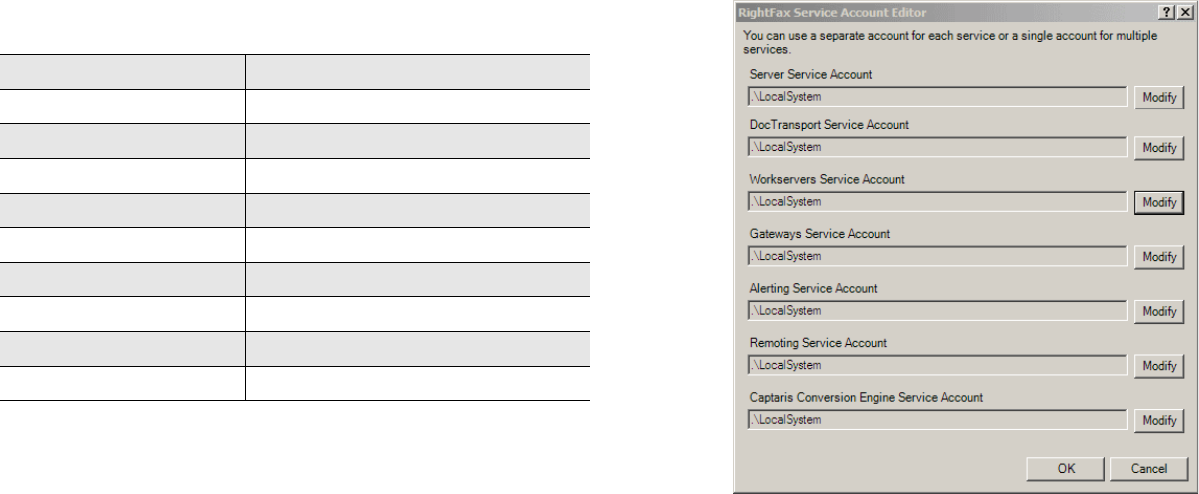
OpenText RightFax 10.0 Administrator’s Guide 42
EquiTrac Archive Logs all successfully sent faxes to a file called
RightFax.txt in the WorkServer folder. The EquiTrac Archive log is a
comma-delimited ASCII file. Each log entry appears on a separate
line and includes nine data fields. The following table lists all of the
fields for each log entry in the order the fields appear.
Always Delete After Archive Removes all archived faxes from
the user’s FaxUtil mailbox.
Selecting a Service Account
All RightFax WorkServers log on to the network as services using a
Windows user account that you specify. This user account must
have access to all the network resources required by the tasks
(services) managed by your WorkServer modules. This account is
initially selected during the RightFax installation. To change the
WorkServer module service account, click Select Service
Account. The Service Account Editor dialog box opens.
Figure 4.2 The Service Account Editor Dialog Box
The account currently defined for each service appears in the
Service Account Editor dialog box. The default is for all services to
use one of the pre-defined accounts. To change a service account,
Table 4d EquiTrac Archive Log Fields
Field Maximum length or format
RightFax user ID 21 characters
Phone number dialed 31 characters
BillInfo1 15 characters
BillInfo2 15 characters
Fax transmission duration hh:mm:ss
Number of pages in fax ###
Fax error code Always 32, indicating success
Fax date mm/dd/yy
Fax time hh:mm
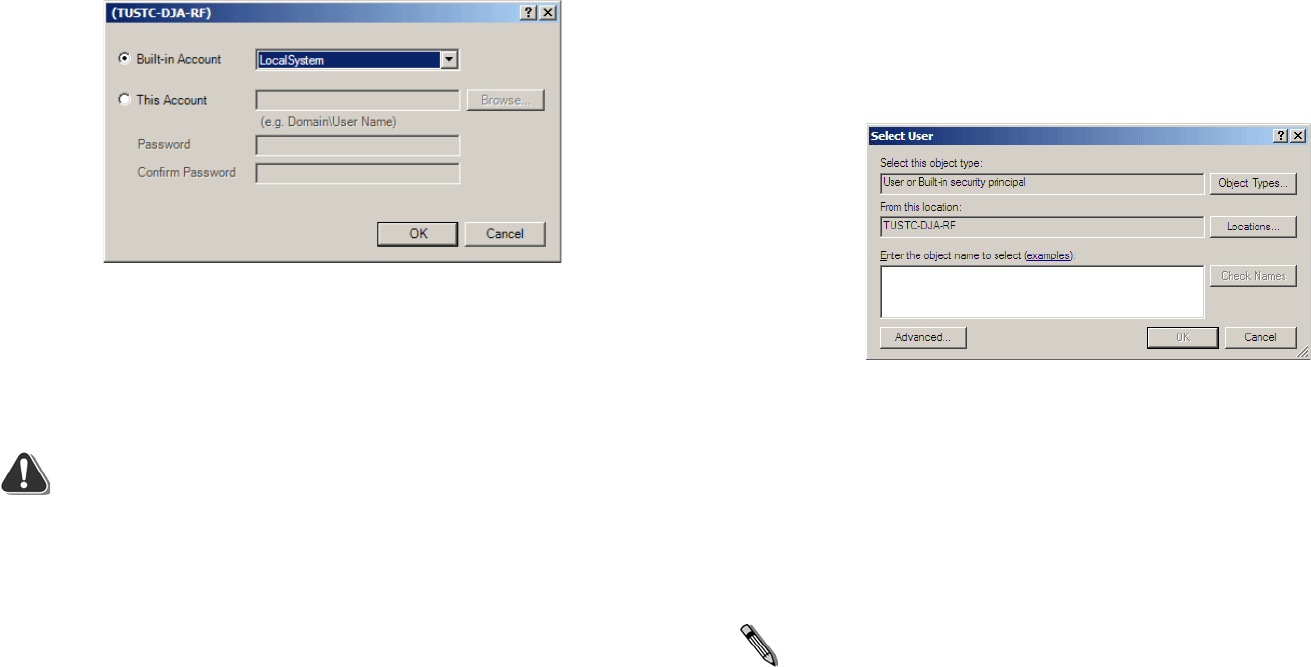
43
1. From the open Service Account Editor dialog box, click Modify
next to the account you want to change.
Figure 4.3 The Modify Service Account Dialog Box
2. Specify an account in either of the following ways:
Select the Built-in Account check box, then choose one of
the accounts from the drop-down box.
Select the This Account check box, then type a new service
account name.
Warning If you manually type a name that is longer than 15
characters, you may encounter errors in services performed by the
WorkServer. To avoid this, you should select the user by clicking the
Browse button when the desired user account resides on a domain
whose name is longer than 15 characters.
Select the This Account check box, and then click Browse
to scan for and list all user accounts on a specified network.
Choose the Object Type (Built-in, User, or both) for which to
search, and then the root Location from which to begin the
search. Enter a name or partial name in the text box, then
click Check Names to display a list of account names from
which to choose.
Figure 4.4 The Select User Dialog Box
3. Click OK to close the Select User dialog box and display the
selected account in the Modify Service Account box.
4. In the Modify Service Account dialog box, enter the
case-sensitive password for the selected user account in both
the Password and Confirm Password boxes. Click OK to
display the new service account in the Service Account Editor.
5. Click OK to apply the selected service account and close the
Service Account Editor.
Note If you will be storing or accessing files on a NetWare volume, you
must make sure the WorkServers’ service accounts also exist as
accounts within Novell.
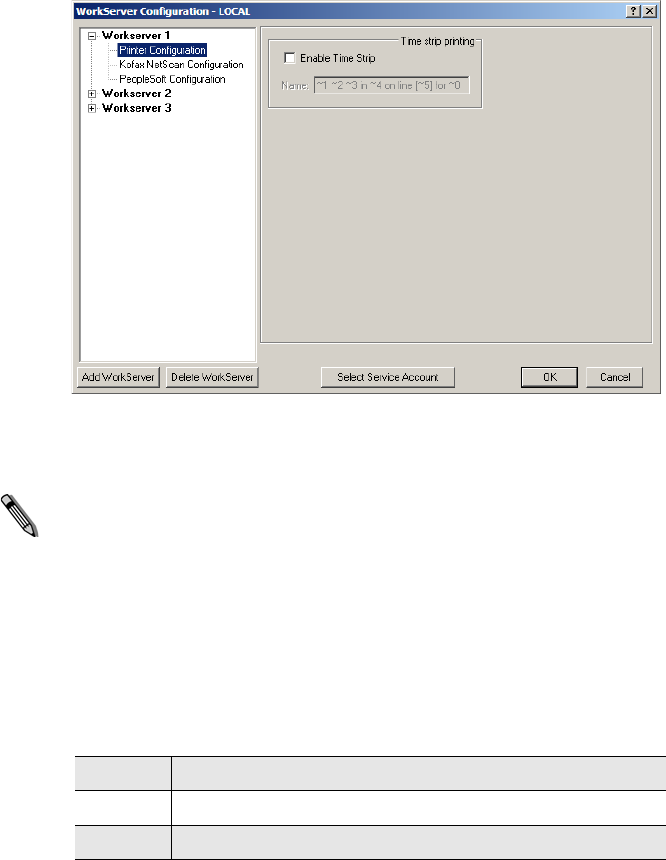
OpenText RightFax 10.0 Administrator’s Guide 44
Adding and Deleting WorkServers
By default, three WorkServer modules are installed on the RightFax
server. Two WorkServer modules are devoted to the most frequent
tasks, and one is dedicated to deleting image files only. This default
setup is optimal for most RightFax configurations. However,
changing the default configuration may be necessary, depending
on your fax server usage. For example, if the server is used primarily
for broadcast faxing, WorkServer #3 can be configured to perform
the greater than average load of PCL5 conversions, instead of
other lower-priority functions.
Here are some additional reasons for adding more WorkServers:
If running OCR (Optical Character Recognition), either for
routing or conversion purposes, you may want to dedicate a
separate WorkServer to performing this processor intensive task.
If the majority of your conversions are PostScript, you may want
to dedicate a separate WorkServer to this task.
If you do a great deal of fax printing, you may want to dedicate a
separate WorkServer to performing this task as well.
To add a new WorkServer, click Add WorkServer. To delete an
existing WorkServer, click the WorkServer to remove and click
Delete WorkServer. When you delete a WorkServer, the other
WorkServers will arrange themselves so they remain sequential.
For example, if you delete WorkServer #1, WorkServer #2 will
move to the WorkServer #1 position and WorkServer #3 will move
to the WorkServer #2 position.
Printing a Time Strip on Faxes
The WorkServer module can print a time strip at the top of every fax
that is printed to a network printer. The time strip can include the
time of arrival of received faxes, elapsed transmission time, time
printed, and the fax image file name.
Click Printer Configuration under the selected WorkServer.
Figure 4.5 The WorkServer Printer Configuration Dialog Box
Enable Time Strip Enables printing a time strip at the top of
every fax that is printed to a network printer.
Note The time strip is printed as black text by default. To change the
time strip to print in white text on a black background, edit the Windows
registry to change the PrintTimeReverse value to 1. See
“PrintTimeReverse” on page 335.
SeeName Specify what information to print in the Time Strip. The
Time Strip can contain any combination of text and variables. The
following table lists each of the variable options that can be used in
this box.
Table 4e Time Strip Macros
Macro Definition
~1 The word “Sent” or “Received”
~2 Last transmission/receive date (MM/DD/YYYY)
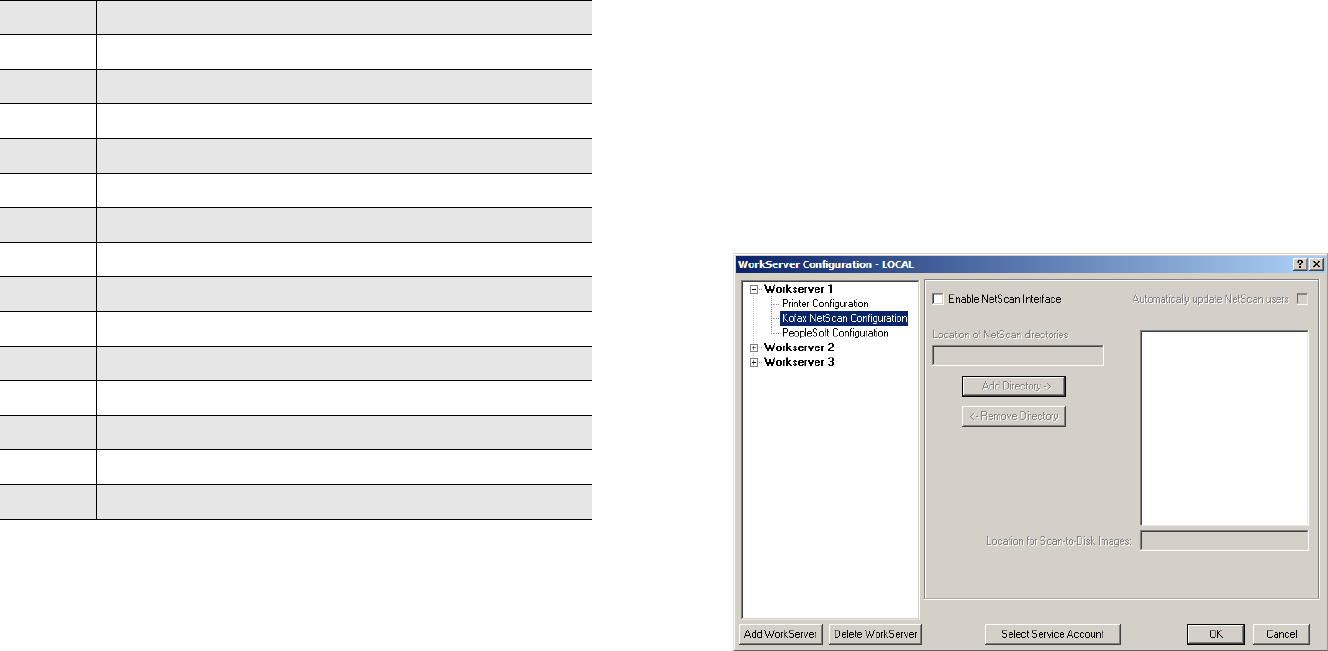
45
Example The entry Fax ~1: ~2 ~3 might produce this text at the
top of a printed fax: Fax received: 01/05/99 10:42.
Configuring Kofax NetScan
RightFax can be configured to work in conjunction with the Kofax
NetScan network integration tool for scanners. Using the Kofax
NetScan, you can scan documents directly into the FaxUtil mailbox
of any RightFax user on your network. This makes it convenient to
fax printed pages when no electronic version is available.
Scanned images appear in the selected FaxUtil mailbox with the
message “Info not complete.” Images can then be faxed by
double-clicking the image in FaxUtil and completing the required
boxes in the Fax Information dialog box (see “Specifying
Addressing Information” on page 235).
In order to integrate RightFax with the Kofax NetScan, at least one
WorkServer must have the Kofax integration enabled. Each
WorkServer is separately configured for Kofax NetScan integration.
Click Kofax NetScan Configuration under the selected WorkServer.
Figure 4.6 The WorkServer Kofax NetScan Configuration Dialog Box
Enable NetScan Interface Enables RightFax integration with a
Kofax NetScan. Communication and integration with the Kofax
NetScan will only be handled by the WorkServers with this check
box selected.
Automatically Update NetScan Users Updates NetScan
users with the latest list of RightFax users every six hours or every
time the RightFax Server module is restarted. If this check box is
not selected, the NetScan can only be updated by selecting
~3 Last transmission/receive time (HH:MM)
~4 Last connection duration
~5 Last channel used
~6 WorkServer number
~7 Image file name
~8 Date and time printed (MM/DD/YYYY HH:MM)
~9 Unique ID
~0 RightFax user ID
~A Remote ID
~B Name of the fax recipient
~C Fax number of the fax recipient
~D Company name of the fax recipient
~E Last transmission/receive date (YYYY/MM/DD)
~F Date and time printed (YYYY/MM/DD HH:MM)
Table 4e Time Strip Macros (Continued)
Macro Definition
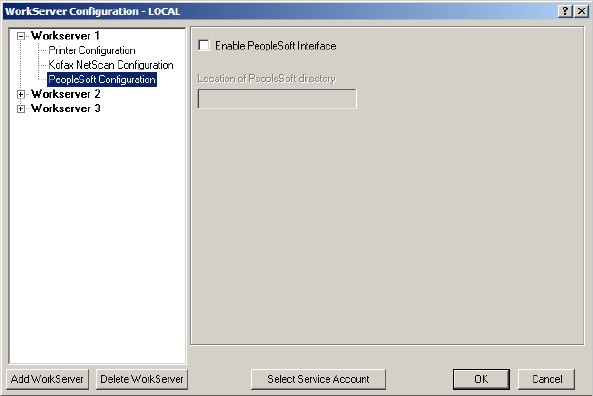
OpenText RightFax 10.0 Administrator’s Guide 46
Synchronize External Systems from the Utility menu in
Enterprise Fax Manager (see “Synchronizing the RightFax Server
with External Systems” on page 101).
Location of NetScan Directories Specify the UNC path to
the folders that RightFax will monitor for new NetScan images. To
add a directory, type the UNC path in the Location of NetScan
Directories box and click Add Directory. To remove a directory,
click the directory and click Remove Directory.
Location for Scan-to-Disk Images Specify the UNC path to
the folder where images that are scanned to disk from the Kofax
NetScan will be saved.
For more information about configuring the Kofax NetScan for
RightFax integration, refer to your NetScan documentation.
Configuring PeopleSoft
PeopleSoft is an application for enterprise resource planning that
lets companies manage multiple resources from one integrated
platform. To use PeopleSoft with the RightFax server, you must
purchase a separate license. PeopleSoft must be used with the
RightFax Enterprise or Business Integration Module.
RightFax queries PeopleSoft for outgoing faxes, overriding the
PeopleSoft built-in ObjectFax server. This lets you combine the
benefits of RightFax least-cost routing and load balancing features
with your PeopleSoft platform.
To configure RightFax to work with PeopleSoft, at least one
WorkServer must have the PeopleSoft integration enabled. Each
WorkServer is separately configured for PeopleSoft integration.
Click PeopleSoft Configuration under the selected WorkServer.
Figure 4.7 The WorkServer PeopleSoft Configuration Dialog Box
Enable PeopleSoft Interface Enables RightFax integration
with PeopleSoft. Communication and integration with the
PeopleSoft system will be handled by the WorkServers with this
check box selected.
Location of PeopleSoft directory Specify the UNC path to
the folder where PeopleSoft stores its outgoing fax jobs. The
service account for this WorkServer (see “Selecting a Service
Account” on page 42) must have read and write access to this
folder.

47
Installing WorkServers on Remote Computers
The RightFax server lets you install and operate remote
WorkServers (WorkServers running on computers other than the
RightFax server). This lets you transfer selected
processor-intensive functions to other machines, freeing up
resources on your RightFax server. Running remote WorkServers is
helpful in systems with 24 or more fax channels in high volume fax
broadcast situations. Three or four properly configured
WorkServers installed locally on the RightFax server are sufficient
to handle the fax load in most other installations.
Remote WorkServers can also be used to provide Server-Side
Application conversion support for Windows Server 2008 and
Windows Server 2008 R2 systems. See “About the Captaris
Conversion Engine” on page 76 for more information.
Warning After you install a remote WorkServer, you cannot delete any
WorkServers from your RightFax configuration. This will disrupt the order
of the services and the remaining WorkServers may fail to function as
expected.
Requirements
Supported Microsoft Windows Operating Systems
RightFax server software is supported on the following server
operating systems.
Windows Server 2008 R2 Standard x64
Windows Server 2008 R2 Enterprise x64
Windows Server 2008 Standard x86 and x64
Windows Server 2008 Enterprise x86 and x64
Windows Server 2003 Standard x86 SP2 or later
Windows Server 2003 R2 Standard x86 SP2 or later
Windows Server 2003 Enterprise x86 SP2 or later
Local server requirements
Microsoft .NET Framework 3.5*
Microsoft Data Access Components 2.8*
Microsoft Messaging Queuing*
Microsoft Visual C++ 2005 runtime components*
A Windows account to run RightFax services. The account
you choose must be a domain user that member of the local
administrators group and must have the right to logon as
service on the local computer.
* installed during setup
RightFax Server Requirements
Before installing remote WorkServers, you must share the
\RightFax folder on the RightFax server. If your Fax Server
installation is not in the default \RightFax folder, share the
installation folder using “RightFax” as the share name.
Grant the WorkServer service account full control of the shared
folder. This account must also have write access to the Windows
registry on the RightFax server.
To install the WorkServer on a Remote Computer
1. and run Setup.exe. The RightFax Product Suite Setup wizard
opens.
2. RightFax WorkServers require Microsoft .NET Framework 3.5. If
this software is not installed on your system, Setup will prompt
you to install it. To install, click OK. To cancel Setup and install
.NET Framework 3.5 yourself, click Cancel.
3. Review the welcome screen and click Next.
4. Carefully read and accept the license agreement and click Next.

OpenText RightFax 10.0 Administrator’s Guide 48
5. Setup can check for RightFax updates and other late-breaking
information. To check for updates, verify you have an active
HTTP connection and click Check for Updates. If updates are
found, follow the instructions in the Result section. To skip the
update check and continue with Setup, check the box next to
Do not check for updates and click Next.
6. Click Custom followed by Next.
7. In the list of setup components, under RightFax Server
Modules, select the Workserver Module check box. Ensure
that it is the only selected check box in the list. Click Next.
8. The Preview Requirements page lists third-party software
required by your chosen features and also lists the status of
setup operations. Software that must be installed will have a
status of Must Install. To continue, click Next.
9. If your server does not already have Microsoft Message
Queuing installed, Setup will prompt you to install it. Select your
option and click Next.
10.To apply your settings and install required third-party software,
click Apply. This will take several minutes. When finished, click
Next.
11.Choose your installation folder and click Next.
Caution On x64 systems, the default folder is Program Files (x86).
The Program Files folder is reserved for x64 programs. Do not install the
Fax Server software in the Program Files folder on x64 systems.
12.To begin installing RightFax software, click Apply. This may take
several minutes. When finished, click Next.
13.Enter a Windows account to run RightFax services. This must
account be a domain user that member of the local
administrators group and must have the right to logon as
service on the local computer. In addition, this account must
also have full-control over the \RightFax folder on the RightFax
server and have write access to the Windows registry on the
RightFax server. Click Browse to load and select a user
account. Use the Test Account button verify account
credentials. When finished, click Next.
14.Enter the main RightFax server name and click Check
Access. A report will appear in the Results box that indicates
whether or not the connection to the Fax Server was
successful.
15.If the connection was successful, click Next.
16.To apply your settings and complete Setup, click Apply and
then click Close.
Changing the remote WorkServer’s service account
When it is installed, the remote WorkServer uses the same service
account information as the WorkServers on the RightFax server. If
this is a local administrative account on the RightFax server, the
remote WorkServer service may not be able to log on to the
network. If so, you must change the service account used by the
remote WorkServer so that it has administrative permissions to the
computer on which it is installed. To change the WorkServer’s
service account on the remote computer, open Windows Control
Panel and select Administrative Tools > Services. The
WorkServer is listed in the services as RightFax WorkServer
Module. Double-click the service name to open its configuration
dialog. You can specify a new service account name on the Log On
tab. You must repeat this procedure locally at the WorkServer
before the changes will take effect.

49
Chapter 5
Configuring the DocTransport Modules
The RightFax DocTransport module lets you configure the methods
by which RightFax will be able to transmit documents. This module
lets you configure fax boards for conventional fax transmission, as
well as set up RightFax for SMS messaging, Fax-over-IP and Eicon
fax boards.
The RightFax BoardServer module acts as an interpreter between
some fax board drivers and the RightFax Server module for
conventional fax transmission. It handles requests to schedule
outgoing faxes for transmission and informs the Server module
when a new fax has been received and needs to be processed. The
BoardServer module can only be configured from within the
DocTransport module which oversees its functions. The
DocTransport module is also responsible for starting and stopping
the BoardServer module.
The DocTransport module must be properly configured to allow the
RightFax server to send and receive documents. RightFax supports
a maximum of 120 fax channels per DocTransport service which
includes all channels in the BoardServer module as well.
Caution Manually stopping or starting the BoardServer module will
cease the scheduling of all faxes. To stop the BoardServer module you
must stop the DocTransport module to initiate a proper BoardServer
shutdown. To restart the BoardServer, simply start DocTransport as it is
designed to automatically start the BoardServer module. This also
applies when running the BoardServer in debug mode.
1. On the RightFax server, select Start > Programs > Enterprise
Fax Manager.
2. In the Enterprise Fax Manager application, click the name of the
RightFax server to configure in the tree in the left pane. A list of
services appears at the lower-right pane of the window.
3. In the Service Name list, double-click RightFax DocTransport
Module. The DocTransport Configuration dialog box opens.
Figure 5.1 The DocTransport Configuration dialog box
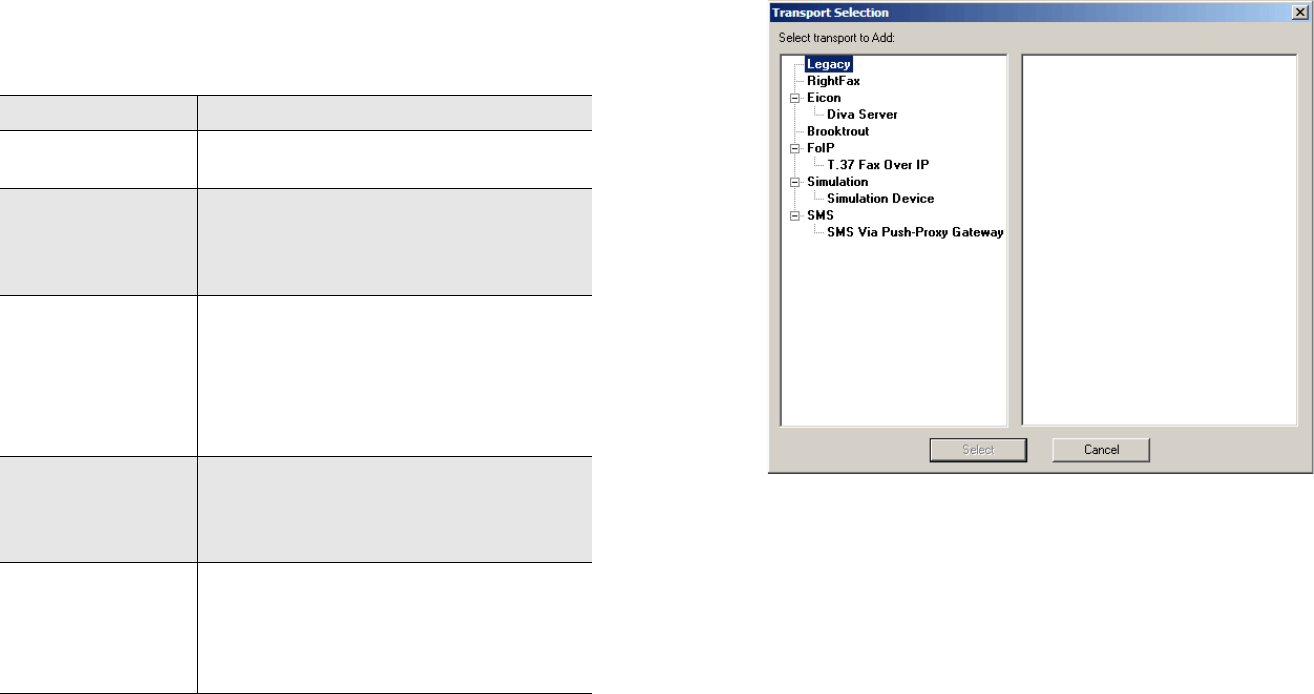
OpenText RightFax 10.0 Administrator’s Guide 50
Adding transport methods
By default, the DocTransport module includes the RightFax
BoardServer module set up as a transport method for legacy
boards. For most current installations, you’ll need to add the
specific transport method for your fax board type.
1. Click the Add Transport button. This opens the Transport
Selection dialog box.
Figure 5.2 The Transport Selection dialog box
2. Expand the tree in the left pane and select the transport method
to add.
3. If you select either Eicon Diva Server or Brooktrout,, you must
select also a specific fax board in the right pane.
4. Click Select to add the new transport method.
5. Repeat these steps for each optional transport method you
want to add.
6. After you have added all of the transport methods you will be
using, each must be properly configured for your system. The
rest of this chapter describes how to configure each of the
transport options in the DocTransport module.
Table 5a Transport methods
Transport method Description
Eicon Diva Server Required if you will be installing any of the
Eicon fax boards.
Brooktrout TR1034
Series, SR140
Required if you will be installing any
Brooktrout TR1034-series fax boards or the
Brooktrout SR140 software platform of Fax
over IP.
T.37 Fax over IP Required if you will be creating
administrative dialing rules that route faxes to
T.37-compatible fax machines.
Note You must configure the gateway if you
plan to send faxes directly to IP addresses
and wish to collect route codes.
Simulation Device Allows simulated fax sending for testing or
demonstration purposes. Outgoing faxes will
appear to send but will not. Simulation mode
can be used with no fax boards installed.
SMS Via Push Proxy
Gateway
Required if you install and plan to use the
Push Proxy Gateway. The RightFax Push
Proxy Gateway Guide provides
configuration information for this transport
type.
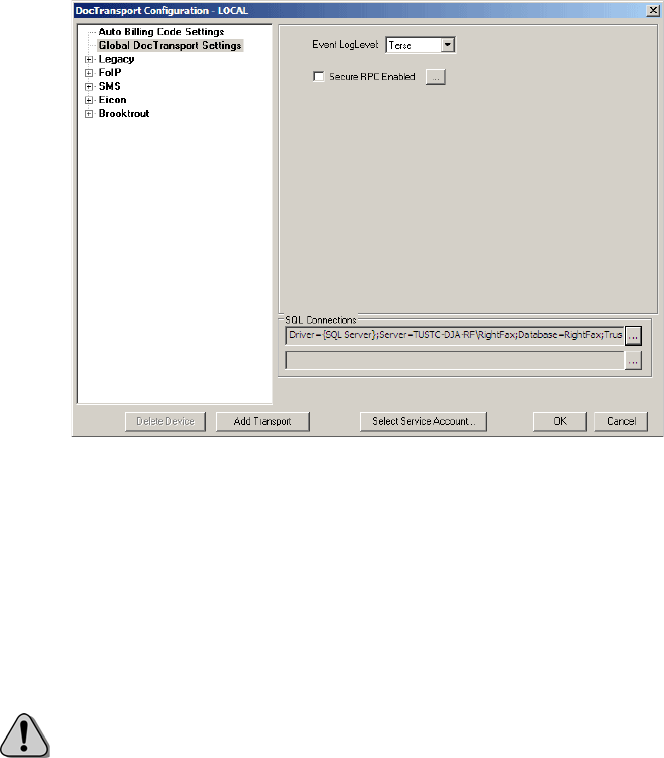
51
Configuring Global DocTransport Settings
Global board settings in the DocTransport module are global
settings that apply only to the transport methods enabled in
DocTransport. RightFax will use these settings regardless of the
transport method, fax board, or channel in use. To configure Global
DocTransport Settings, select Global DocTransport Settings in
the left pane. The rest of this section describes the options on this
screen.
Figure 5.3 The DocTransport Global DocTransport Settings configuration
Event LogLevel Specify the level of information logged in the
Application Event Log under the service name “RightFax
DocTransport Module.” You can select the following options:
None. No information is saved.
Terse. Records critical errors only.
Normal. Records errors and major events only.
Verbose. Records all significant events and is most useful for
tracking and resolving problems.
Caution If you leave this value set to “Verbose” for long periods of time,
the Event Log can become full which may prevent new events from being
logged.
Secure RPC Enabled Encrypts the data exchanged between
multiple RightFax DocTransports (e.g., Remote BoardServers) or
between a RightFax DocTransport module and the FaxStat
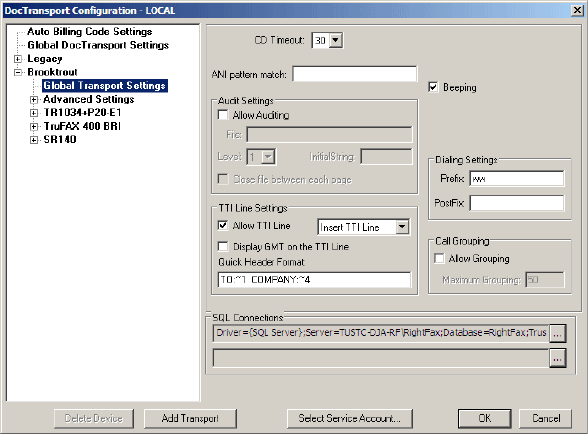
OpenText RightFax 10.0 Administrator’s Guide 52
program. Any DocTransport service on any other RightFax server
communicating with this server must be started using a valid
account and password rather than a local system account.
If you select this option, you must specify a user account that the
DocTransport service can use for authentication to and from other
DocTransport modules on the network. To specify a user account,
click the [...] button to the right of this option and enter a login
name and password.The quick header line can be customized
using special macros that are replaced in the quick header of each
fax.
Brooktrout Fax Board Configuration
After you’ve added a Brooktrout transport method to the
DocTransport service, you must configure it for use with RightFax.
The configuration steps apply to all Brooktrout boards, including
including TR1034-series, Trufax-series, and the SR140 boardless
Fax-Over-IP, though some fields may apply only to some boards.
Each board must be configured separately, and each channel must
be configured separately for each board. There are three major
steps:
1. Configure the Brooktrout Global Transport Settings
2. Configure the Advanced settings (optional) for all Brooktrout
boards
3. Configure the following elements for each board:
Configure the default settings for the board
Use the Brooktrout Configuration Tool to license channels
and set additional parameters(see the Brooktrout
documentation).
Configure each of the RightFax channels
Configuring Brooktrout Global Transport Settings
Brooktrout Global Transport Settings in the DocTransport module
are global settings that apply to all of the Brooktrout fax boards and
channels configured in the DocTransport module. RightFax will use
these settings regardless of the fax board or fax channel in use. To
configure global transport settings, select Global Transport
Settings in the left pane. The rest of this section describes the
options on this screen.
Figure 5.4 The Brooktrout Global Transport Settings configuration
CD Timeout Specify the length of time, in seconds, that the
RightFax server will wait for a fax answer tone (CED tone) from a
remote fax machine when sending a fax.
ANI Pattern Match Specify the pattern of the dialing party
information string that will be received during incoming calls.
RightFax collects information about the dialing party’s phone
number for display in FaxUtil and for CSID routing (if used).
However, some organizations receive additional information (such
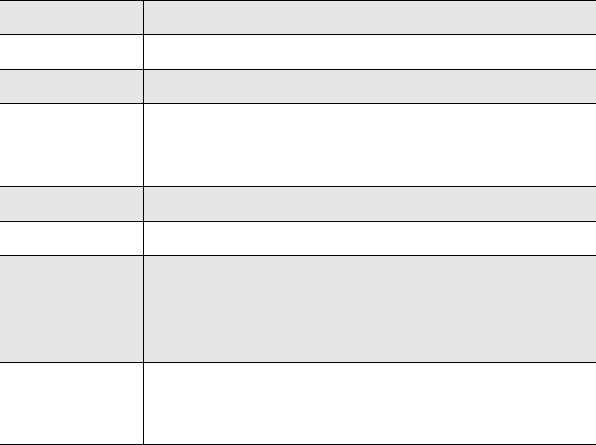
53
as ANI or DNIS) along with the caller’s phone number. This box
specifies the pattern of the extra data so that it can be removed
prior to display or routing.
Enter the pattern of ANI data you receive using the symbols in the
following table.
Example A sample string of 10 ANI digits, such as:
5207134762
Matches both of the following pattern strings:
XXXXXXXXXX
X10
Example A sample string that begins with the digits “01” and
contains a combination of ANI digits, asterisks, and
pound characters, such as:
015207134672#1234**
Matches both of the following strings:
01XXXXXXXXXX#ZZZZ**
01X10#Z4*2
Audit Settings
Allow Auditing Tells the DocTransport module to record a log of
all incoming and outgoing faxes.
File Specify the path and file name of the log file to use. If the file
does not exist, RightFax will create it when it logs the first entry. To
output the log file directly to a network printer, enter the printer port
instead of a file name. If you output to a network printer, you must
also select the Close File Between Each Page check box.
Level Specify the level of information to include in the log. There
are five levels of detail. Level 1 prints a single line summary of each
fax event, Level 2 prints a detailed description of each fax event,
Level 3 outputs a comma-delimited file, and Level 4 outputs a
tab-delimited file. Level 5 is primarily for troubleshooting purposes,
and outputs Brooktrout debugging information.
Table 5b ANI Pattern Symbols
Symbol Represents
*An asterisk character.
#A pound character.
XA digit in an ANI number. (This is the only number
sequence that will be used for ANI routing, all other
information is ignored.)
YA digit in the DNIS number.
ZAn extraneous digit. This will be ignored.
Max. Modifier
(1–9)
The maximum number of each of the prior
characters. For example, “x2*y” represents up to 2
ANI digits followed by an asterisk and a single
DNIS digit.
Literal Digits
(0–9 and
A–D)
Valid phone digits. Separate literal digits from Max.
Modifiers with a space.
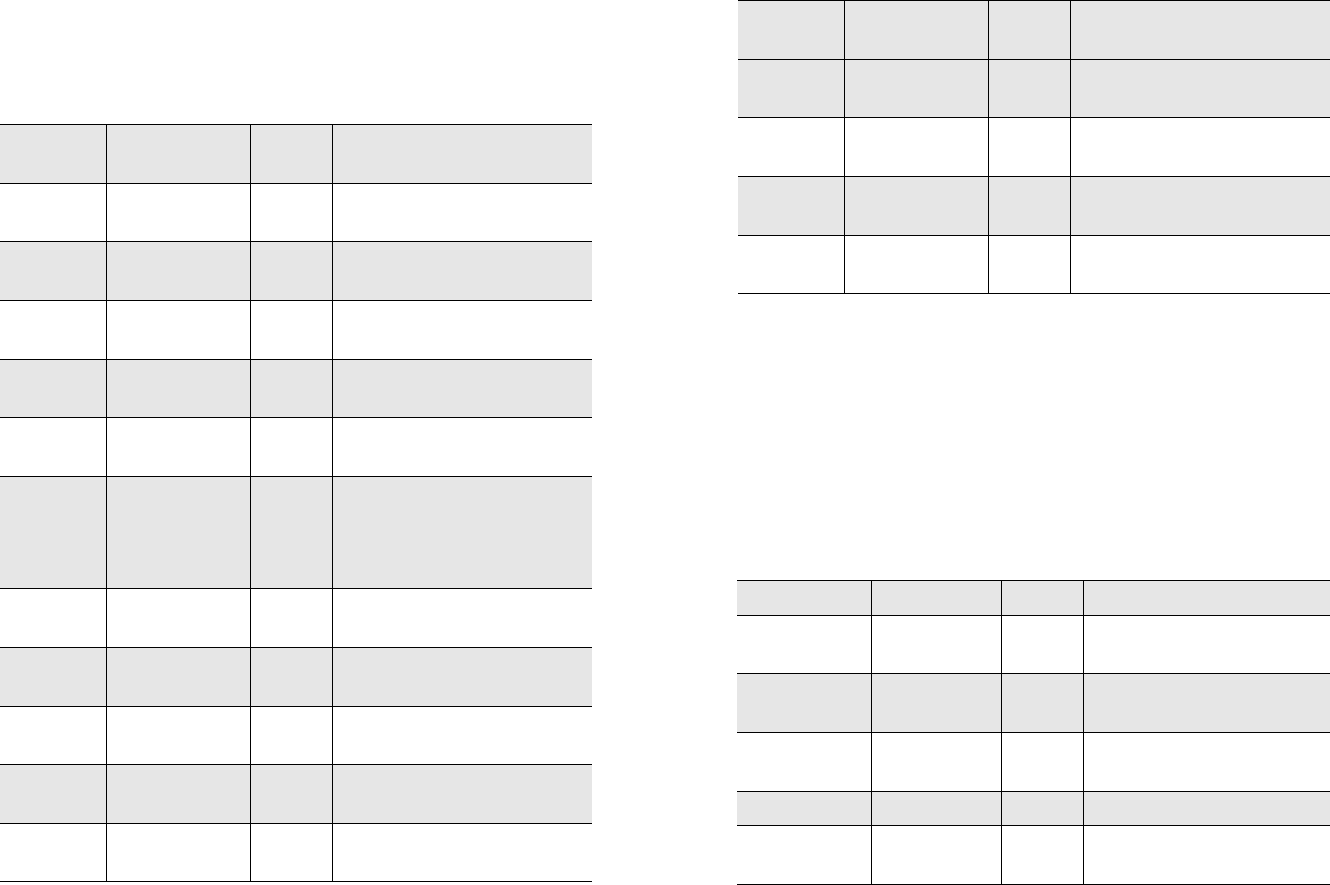
OpenText RightFax 10.0 Administrator’s Guide 54
If you set Level to “3,” each fax event will be saved to a
comma-delimited file. Each log entry appears on a separate line
and includes 15 data fields. The following table lists all of the fields
for each log entry in the order the fields appear.
If you set Level to “4,” a new file is created each hour containing
that hour’s fax events. Because a separate file is created for each
hour’s fax events, do not specify a file name in the File box. You can
optionally specify a path to a folder where the log files, which are
given default names, will be saved.
Each log entry appears on a separate line and includes 28 data
fields. The following table lists all of the fields for each log entry in
the order the fields appear.
Table 5c Audit Log Level 3 Field Descriptions
Field
name Type/format Length Description
Direction String 1Sent/received flag (“S” or
“R”)
Date sent MM/DD/YYYY 10 Date that the call was
initiated
Time sent HH:MM 5Time that the call was
initiated
Channel Numeric 2Channel used by RightFax
(0–32)
Duration Numeric 5Total transmission time in
seconds
Phone
number
Alphanumeric 31 Sent faxes: Fax number
dialed
Received faxes: Routing
code (DID or DTMF) used
Remote
ID
String 49 Remote fax machine ID
Result String 59 Result of the fax
transmission
Page
count
String 79 Number of pages
transmitted
Contact
number
String 31 Sent faxes only: The
recipient’s voice number
Contact
name
String 59 Sent faxes only: The
recipient’s name.
Company
name
String 59 Sent faxes only: The
recipient’s company name
User ID String 21 Sent faxes only: RightFax
user ID of the sender
Billing
code 1
String 15 Sent faxes only: Billing code
1
Billing
code 2
String 15 Sent faxes only: Billing code
2
Table 5d Audit Log Level 4 Field Descriptions
Field name Type Length Description
Direction String 1Sent/received flag (“S” or
“R”).
Date sent YYYYMMDD 8Date that the call was
initiated.
Time sent HHMM 4Time that the call was
initiated.
Channel Numeric 5Channel used by RightFax.
Duration Numeric 5Total transmission time (in
seconds).
Table 5c Audit Log Level 3 Field Descriptions (Continued)
Field
name Type/format Length Description
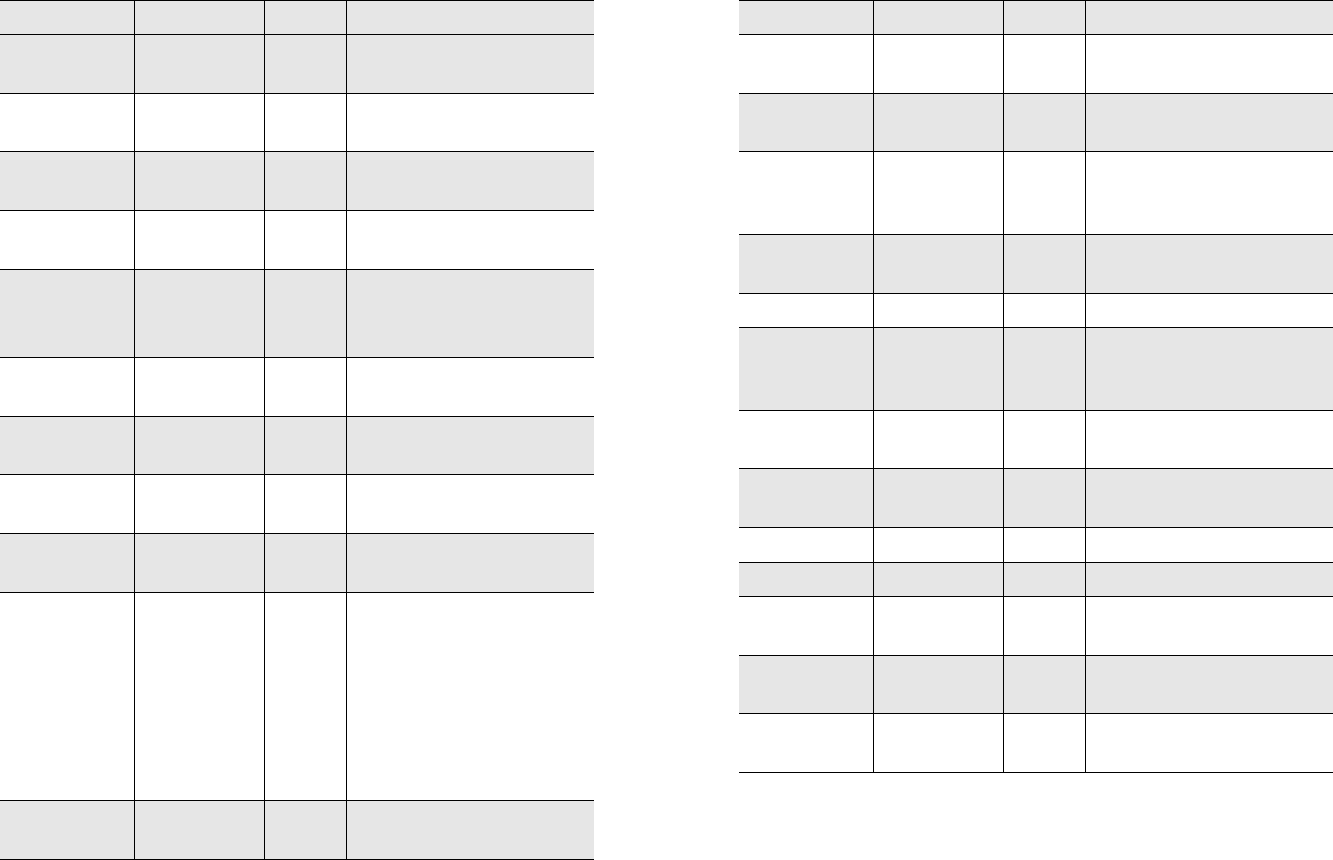
55
InitialString This is a text message that will be included in the
audit file at the beginning of every page.
Phone
number
String 127 Fax number dialed.
Remote ID String 47 CSID of recipient fax
machine.
Good pages Numeric 5Number of pages
transmitted successfully.
Page count Numeric 5Total number of pages in
the fax.
Board type Numeric 1Type of fax board used to
send the fax
0 = Brooktrout
BT call status Numeric 5Brooktrout call result
status value.
BT call line
status
Numeric 5Brooktrout call result line
status value.
BT fax status Numeric 5Brooktrout fax result status
value.
BT fax line
status
Numeric 5Brooktrout fax result line
status value.
CDR flags Numeric 4Hex value of CDR flags
0x0001 = PartialRetry
0x0002 = SchedRemote
0x0004 = SendForRemote
0x0008 = Has_ANI
0x0010 = Had_AOC
0x0020 =
Had_ISDNCauseVal
AOC value 1 Numeric 9AOC data value #1 (only
valid if indicated by flags).
Table 5d Audit Log Level 4 Field Descriptions (Continued)
Field name Type Length Description
AOC value 2 Numeric 9AOC data value #2 (only
valid if indicated by flags).
AOC value 3 Numeric 9AOC data value #3 (only
valid if indicated by flags).
ISDN cause
value
String 5ISDN call setup cause
value (only valid if indicated
by flags).
Sender ID String 21 RightFax user ID of the
sender.
To name String 59 The recipient’s name.
From name String 59 Name of sender
(descriptive name, not the
ID).
Contact
number
String 31 The recipient’s voice
number.
Company
name
String 59 The recipient’s company
name.
Billing code 1 String 15 Billing code 1.
Billing code 2 String 15 Billing code 2.
Secure CSID String 21 CSID match code for
secure send operation.
Unique ID String 15 Assigned unique ID for fax
job.
Source
server
String 47 Source server IP address
or name.
Table 5d Audit Log Level 4 Field Descriptions (Continued)
Field name Type Length Description
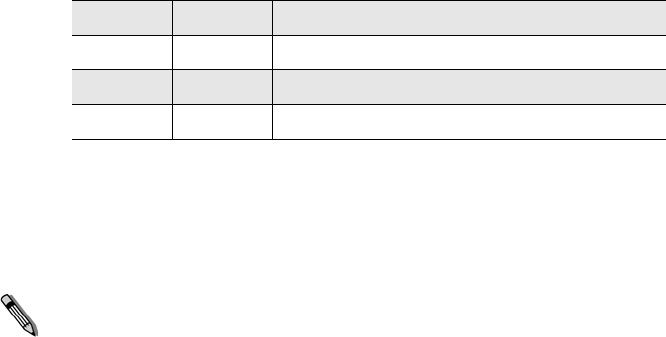
OpenText RightFax 10.0 Administrator’s Guide 56
This line can contain control codes that can be used to convey
page formatting or other information to the application reading the
file. To add control codes to this string, use the following notation.
Close File Between Each Page Closes the log file after each
entry. This allows you to output the log to a network printer.
TTI Line Settings
Note Brooktrout Trufax fax boards do not support the TTI line feature.
Allow TTI Line Select this check box to place a TTI line at the
top of every page of a fax. The transmit terminal information (TTI)
line is a line of text that prints at the top of each received fax page.
The TTI line includes the transmitting fax machine, the date and
time of the transmission, the fax page number, and the total page
count. The date format in your TTI line is a function of the Windows
international or regional settings as installed on the fax server.
If this check box is selected, you must also specify how the TTI line
should be placed on the fax page.
Select Overlay TTI Line to add the TTI line text to add any
existing text or image on the first line of the fax. Note that this can
obscure the TTI information. With Brooktrout fax boards, this
option functions the same as inserting the TTI line.
Select Replace TTI Line to replace any existing text or image on
the first line of the fax with the TTI line. This erases existing fax
data from the first line but ensures that the overall length of the
fax stays the same.
Select Insert TTI Line to add a new line to the top of the fax
page for the TTI information. This retains any fax data on the first
line but increases the length of the fax by one line.
Follow these steps to optionally add your organization’s name to
the TTI line:
1. Open Windows Control Panel and run the RightFax
DocTransport application.
2. Click on each fax channel for each fax board listed in the left
pane.
3. Type the desired company name in the Fax ID box.
4. Repeat these steps on all RightFax servers and Remote
BoardServer computers.
Display GMT on the TTI Line Displays the local time relative
to Greenwich Mean Time (GMT). If this option is not selected, the
TTI line will display the local time at the fax’s place of origin.
Quick Header Format Specify heading text to include under
the TTI line on outbound faxes. Though defined here, quick headers
must be enabled in the General tab of the RightFax Server module
Configuration dialog box (see “Enable Quick Headers” on
page 22).
Table 5e InitialString Control Codes
Notation Example Represents
\x## \x1b Hexadecimal character values
\### \027 Decimal character values
^x ^[ ASCII representation of a control character
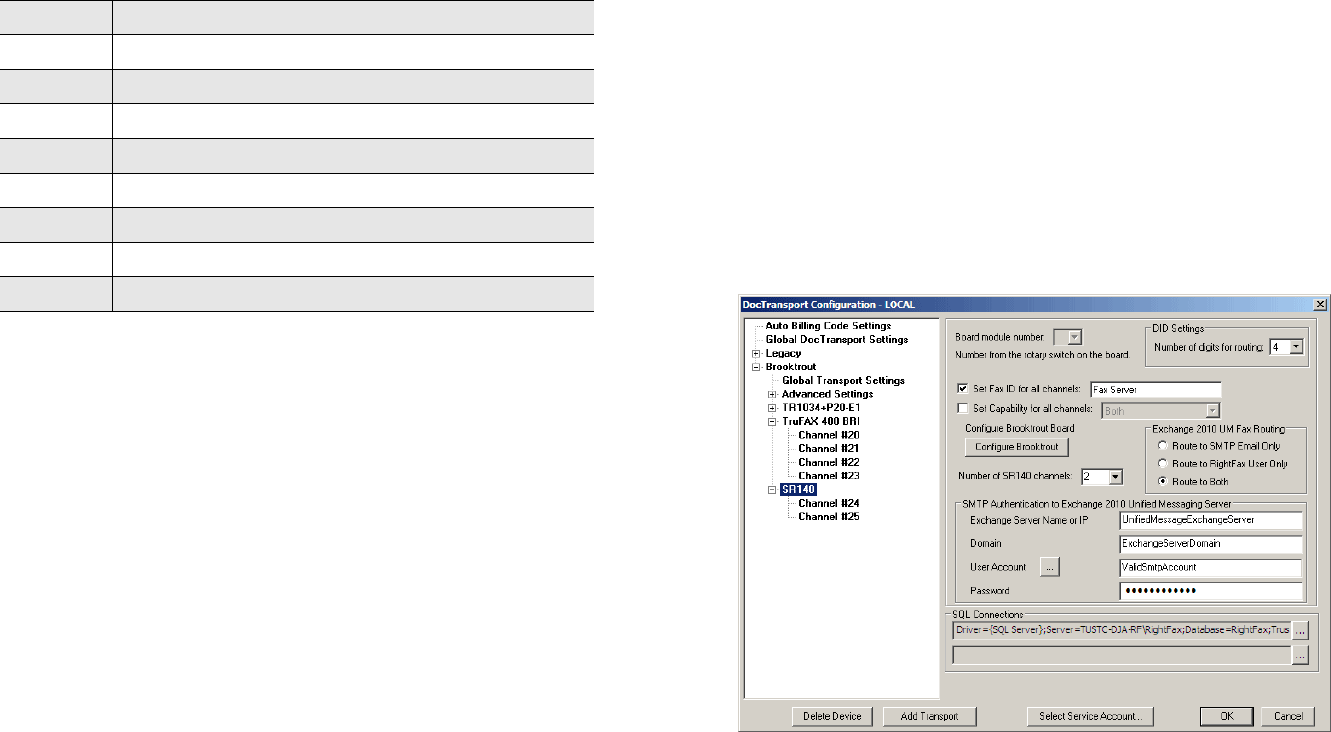
57
The quick header line can be customized using special macros that
are replaced in the quick header of each fax.
Example For example, the setting Please deliver to: ~2 at ~5
might appear in a fax Quick Header as Please deliver to:
Jane Doe at Acme, Inc.
Beeping Tells the computer in which the fax boards are installed
to beep each time a call is placed or received.
Dialing Settings Prefix This field specifies one or more dialing
characters to add at the beginning of every outbound fax number
dialed by the server. The default setting (WW) instructs the fax
boards to automatically detect a dial tone before dialing. For a list
of valid dialing characters, see “Dialing Characters Supported by
Dialing Rules” on page 191.
Dialing Settings Postfix This field specifies one or more
dialing characters to add at the end of every outbound fax number
dialed by the fax server. For a list of valid dialing characters, see
“Dialing Characters Supported by Dialing Rules” on page 191.
Call Grouping Whenever a fax is placed in the fax queue, Call
Grouping checks the queue for another fax going to the same
number. If another fax to the same number is scheduled, it keeps
the line open and transmits the second fax, saving the time and
money of redialing and reconnecting a second time.
Maximum Grouping This field specifies the maximum number
of pages (1-256) that the fax server will send to one phone number
before hanging up and sending another set of fax pages.
Configuring a Brooktrout Board
After you have added a new Brooktrout fax board, it must be
configured to work with RightFax. To configure the board, click the
board name in the Board/Channel list in the left pane. Note that all
Brooktrout board types use the same configuration screen, though
some fields may be unavailable (greyed out) depending on
functionality of each board.
Figure 5.5 Brooktrout Board Configuration
Board module number Select the number in the list that
matches the number on the rotary switch on the fax board.
Table 5f Quick header macros
Macro Definition
~1 To-name field (59 characters maximum)
~2 Shortened to-name (23 characters maximum)
~3 To-contact number field (31 characters maximum)
~4 To-company field (59 characters maximum)
~5 Shortened to-company field (23 characters maximum)
~6 BillInfo1 field (15 characters maximum)
~7 BillInfo2 field (15 characters maximum)
~8 Unique ID (15 characters maximum)

OpenText RightFax 10.0 Administrator’s Guide 58
DID Settings In the list, select the number of digits used for
routing fax calls. This should match the number of digits in Fax
Server user routing codes.
Set Fax ID for All Channels You can specify a fax ID for all
the channels on this fax board. The fax ID is transmitted by each
channel on this fax board to remote fax machines. Usually, this is
set to your company name or general fax number. To specify a
unique fax ID for each channel, see “Configuring Brooktrout
Channels” on page 59.
Set Capability for All Channels Sets the same capability
(dial-only, answer-only, or both) for all the channels on the fax
board. To specify the capability of each channel separately, see
“Configuring Brooktrout Channels” on page 59.
Configure Brooktrout Opens the Brooktrout Configuration
Tool for configuring Brooktrout-related board settings. For more
information about the settings within the Brooktrout Configuration
Tool, see Brooktrout documentation.
Note The Brooktrout Configuration Tool can also be opened from the
Windows Programs list (Start > Programs > Brooktrout Configuration
Tool.
Number of SR140 Channels (SR140 boards only) After
activating your SR140 channel licenses using the Brooktrout
Configuration Tool, select the number of licensed channels from
the list.
Exchange 2010 UM Fax Routing (SR140 boards only)
Specify the routing method by selecting one of the following:
Route to SMTP Email Only Return the fax as an email to
Exchange 2010 for delivery to the FAX search folder in the
recipient's email inbox. The fax will not be stored on the Fax Server
for tracking, billing, or accounting purposes.
Route to RightFax User Only Place the fax into the recipient's
fax mailbox on the Fax Server. The fax will not appear in the user’s
FAX search folder in Outlook.
Route to Both (this is the default) Return the fax to Exchange for
delivery as an email and place a copy in the recipient's fax
mailbox on the Fax Server. With the Connector for Microsoft
Exchange, duplicate faxes may appear in the user’s mailbox.
Important The Open Text Fax Server Connector for Microsoft
Exchange is an optional module that adds inbound and outbound faxing
through Microsoft Exchange. If the Connector for Microsoft Exchange is
installed and properly configured, and the user is configured for routing
inbound faxes to Exchange, the connector will route a copy of a received
fax to the user’s Outlook inbox in addition to any faxes delivered by UM
based on the routing specified under Exchange SIP Referrals.
For more information about the Connector for Microsoft Exchange, see
the Open Text Fax Server Connector for Microsoft Exchange
Administrator Guide.
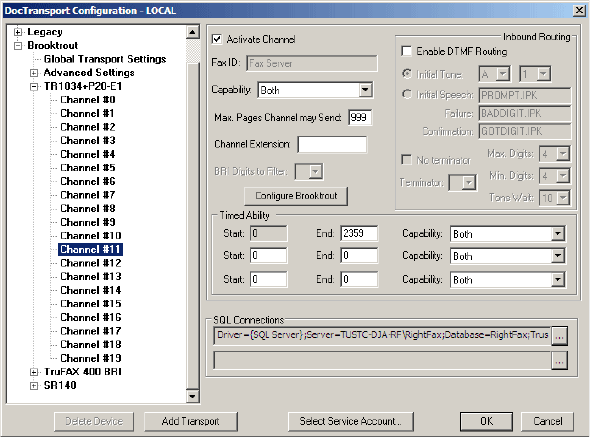
59
Exchange 2010/SIP Authentication (SR140 boards only) Enter
the account information for the SMTP communication with the
Exchange server by entering the following:
Exchange Server Name or IP address of the Exchange 2010
Server that has been configured for Unified Messaging and
inbound faxing.
Domain of the Exchange Server.
User Account that will be used by the Fax Server to
communicate with the Exchange Server. This account will be
used to authenticate all traffic from the Fax Server to the
Exchange server. You can also click the button next to User
Account to select a user from Active Directory.
Password for the User Account entered above.
Configuring Brooktrout Channels
Each fax channel on a Brooktrout fax board can be individually
configured. To configure a channel, click the channel number in the
Board/Channel list.
Figure 5.6 Brooktrout Channel Configuration Dialog Box
Activate Channel Activates this channel for use by RightFax. To
deactivate the channel, click to clear this check box.
Fax ID Specify the fax ID for this channel only. The fax ID is
transmitted to remote fax machines to identify the sender. Usually,
this is set to your company name or general fax number. This box
will not be available if you selected the Set Fax ID for all Channels
check box when configuring the Brooktrout board.
Capability Sets the capability (dial-only, answer-only, or both) for
this channel.
OpenText RightFax 10.0 Administrator’s Guide 60
Max. Pages This Channel May Send Sets the maximum
number of pages per fax that can be sent by this channel, from 0 to
999 (up to 1000 pages per fax). This lets you reserve channels for
smaller faxes.
Channel Extension Assigns a routing code to all incoming
faxes on this channel if no routing information is specified. Because
DID, T1 with DNIS, and ISDN telephone lines require routing
codes, this setting only applies to loop-start lines and T1 lines
without DNIS. The Channel Extension is also used when DTMF
routing is enabled on the line but the caller does not enter a routing
code.
Configure Brooktrout Opens the Brooktrout Configuration
Tool for configuring Brooktrout-related board settings. For more
information about the settings within the Brooktrout Configuration
Tool, see Brooktrout documentation.
Timed ability This feature changes the capability (send-only,
answer-only, or both) of the fax channel at defined times. For
example, you can set a channel to answer-only during business
hours, and then switch it to both dial and answer after hours so it
can be used for broadcast faxing in the evening.
You can define up to three time periods. Times are indicated in 24
hour military time (“0000” represents midnight, “1200” represents
noon, and “1730” represents 5:30 p.m.).
Start Specify the beginning of the time period. The first time
period always has its Start time set to “0000” (midnight).
End Specify the end of the time period. You must always
specify the end time of the last time period as “2359”.
Capability Sets the capability (dial-only, answer-only, or
both) for this time period.
Inbound routing
These settings all apply if you will be using DTMF routing. DTMF
routing is a method for routing faxes directly to an individual based
on the routing code entered manually by the caller.
Enable DTMF Routing Enables DTMF inbound routing for this
channel.
Initial Tone Prompts callers to enter a routing code for the fax by
playing a tone. When this option is selected, you must also select
the tone to play and the duration of the tone in seconds. For
information on the available tones, refer to your Brooktrout
documentation.
Initial Speech Prompts callers to enter a routing code for the
fax by playing a voice prompt. This requires a special voice module
license for your Brooktrout board.
When this option is selected, you must also specify the file of the
voice prompt. The default file, Prompt.ipk is located in the
RightFax\DocTransport\Brooktrout folder. This prompt file can be
played or re-recorded via telephone.
To play the voice prompt for review, go to a command prompt on
the server and enter this command:
RightFax\DocTransport\Brooktrout -p -cPhoneNum prompt.ipk
where PhoneNum is the phone number the Brooktrout board will
dial to play back the prompt.
The board will dial the phone number you specified. When you
answer the phone, it will play the message. Hang up when the
playback is complete.
To record a new voice prompt
1. Save a backup copy of the old Prompt.ipk file.
2. From a command prompt on the server, enter this command:
RightFax\DocTransport\Brooktrout -r -cphonenum -u0
prompt.ipk
where phonenum is the phone number the Brooktrout board
will dial to initiate the recording.
61
3. The board will dial the phone number you specified. When you
answer the phone, it will begin recording your message. Press
the [#] key (pound key) when you are done.
Failure Specify the file to play when a caller does not enter
enough DTMF digits to route the fax. The default file, Baddigit.ipk is
located in the RightFax\DocTransport\Brooktrout folder. This
prompt file can be played or re-recorded via telephone.
Confirmation Specify the file to play when a caller has correctly
entered DTMF digits for routing. The default file, Gotdigit.ipk is
located in the RightFax\DocTransport\Brooktrout folder. This
prompt file can be played or re-recorded via telephone.
No Terminator Tells RightFax to accept the DTMF code entered
by the caller as soon as the correct number of digits have been
entered. No additional terminator key needs to be pressed.
Terminator Specify the key (on the phone) that the caller must
press when finished entering DTMF digits. This is necessary when
the Max. Digits and Min. Digits are not set to the same value.
Because in this case the routing code can be a variable number of
digits, the caller must provide some indication of when he has
finished entering DTMF digits.
Max. Digits Specify the maximum number of DTMF digits that
can be entered by the caller.
Min. Digits Specify the minimum number of DTMF digits that
can be entered by the caller.
Tone Wait Specify the length of time in seconds to wait after the
prompt is played for the caller to enter a routing code. If you have
specified a terminator key (described previously), the caller must
enter the code and the terminator in this length of time.
Advanced Settings
Use the Advanced Settings options for Brooktrout boards to
enable the Human Answered Fax feature, the TeleConnect module,
and the optional Docs-on-Demand module.
Refer to Chapter 30, “Using TeleConnect to Access Faxes by
Phone” for more information about configuring and using the
TeleConnect module.
Refer to the RightFax Docs-on-Demand Guide for installation and
configuration instructions for that product.
Configuring the Human Answered Fax feature
The Human Answered Fax feature detects when an outbound fax
call is answered by a person, rather than a fax machine, and then
provides an automated voice message informing the recipient that
a fax is being sent. The recipient is then offered one or more
options for receiving the fax.
Because it uses digital voice prompts, the Human Answered Fax
feature requires that you have installed at least one Brooktrout fax
board with licensed voice capability. For information on
voice-compatible Brooktrout fax boards, refer to your fax board
documentation or contact your Brooktrout fax board distributor.
The Human Answered Fax feature uses Dialogic .vox voice files
located on the RightFax server. These files can be played or
modified using any sound editor that supports the .vox file format.
Voice files for TR114 fax boards (ADPCM format, 4 bit, 8 kHz,
uncompressed) are in the RFBoard\Voices folder. Voice files for
TR1034 fax boards and SR140 transports (PCM format, 8 bit, 8
kHz, 64 kbps, µ-law compression) are in the DocTransport\Voices
folder.
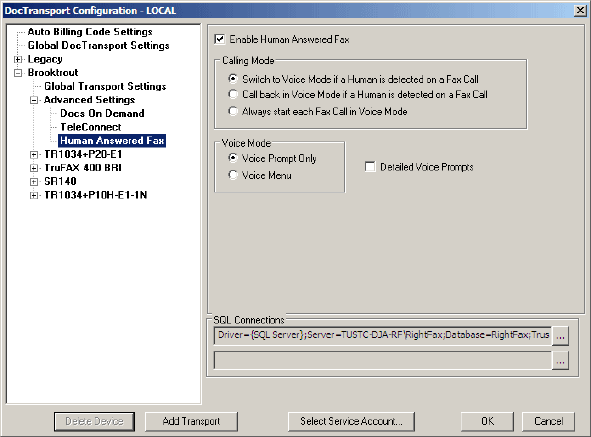
OpenText RightFax 10.0 Administrator’s Guide 62
To enable and configure the Human Answered Fax feature, expand
Advanced Settings, and then click Human Answered Fax in the
list in the left pane.
Figure 5.7 The Human Answered Fax Configuration dialog box
Enable Human Answered Fax Enables the Human Answered
Fax feature.
Calling Mode Select one of the following options:
Switch to Voice Mode if a Human is detected on a Fax Call.
This option causes the RightFax server to switch from fax
transmission mode to voice mode as soon as a human voice is
detected. If a fax machine is detected, the fax will be sent.
Call back in Voice Mode if a Human is detected on a Fax Call.
This option causes the RightFax server to hang up when a human
voice is detected and immediately call back in voice mode. If a fax
machine is detected on either call, the fax will be sent.
Always start each Fax Call in Voice Mode. This option causes
the RightFax server to initiate all outbound fax calls in voice
mode. If you select this option, you should also select Voice
Prompt Only under Voice Mode. This is because if a fax
machine picks up the call, RightFax will always send the fax after
a short delay, whereas if you select the Voice Menu option,
RightFax will wait indefinitely for a response from the call
recipient, and the fax will never be sent.
Voice Mode Select one of the following options:
Voice Prompt Only. This option plays a voice prompt to the call
recipient and then waits for a fax tone before transmitting. The
voice prompt is a message informing the call recipient that this is
an incoming fax. The voice prompt used by the RightFax server
can be either simple or detailed.
Voice Menu. This option plays a voice prompt followed by a
menu of options for the call recipient. The voice prompt used by
the RightFax server can be either simple or detailed.

63
If the voice menu is enabled, the call recipient will first hear either
the simple or detailed voice prompt (depending on which you have
enabled). The prompt will be followed by the file
HAF_MainMenu.vox, which says “To receive this fax press 1 or stay
on the line. To cancel this fax press 9.”
If the call recipient presses 1, the file HAF_PressStart.vox plays
saying “Please press start on your fax machine to receive your
documents” and the fax server will attempt to send the fax.
If the call recipient presses 9, the file HAF_Cancelled.vox plays
saying “This fax has been cancelled. We apologize for any
inconvenience” and the fax will not be sent.
If the caller does not press 1 or 9 within 10 seconds, the menu
will automatically play the file HAF_PressStart.vox prompting the
call recipient to start the fax machine, then the fax server will
attempt to send the fax.
Detailed Voice Prompts The Human Answered Fax feature
provides two types of voice prompt: a simple voice prompt and a
detailed voice prompt.
The simple voice prompt plays the file HAF_ThisisaFax.vox which
says “This is a fax,” followed by HAF_PressStart.vox which says
“Please press start on your fax machine to receive your
documents.”
The detailed voice prompt combines several separate voice files to
create a unique message that says “This is a n page fax.”
The detailed voice prompt always includes the number of pages in
the fax and uses the appropriate a/an article to match the number
of pages. The detailed voice prompt can include “...from [company
name]” at the end of the prompt if a file called HAF_Source.vox is
located in the \Voices folder. This file is not provided with the
RightFax server software, so you must create this file if you want
your organization name identified as the source of the fax. The
detailed voice prompt then plays HAF_PressStart.vox which says
“Please press start on your fax machine to receive your
documents.”
Translating the voice files If you will be using the Human
Answered Fax feature with a language other than English, follow
these guidelines when configuring Human Answered Fax
(described on page 62):
Record a new translated version of the file HAF_ThisisaFax.vox
that will inform the call recipient that a fax transmission is being
attempted.
Select Voice Prompt Only under Voice Mode.
Do not select the option Detailed Voice Prompts.
Note when translating the Human Answered Fax voice files to
languages other than English, use the simple voice prompt without the
menu. Because both the menu and the detailed voice prompt are
generated by playing several separate voice files in sequence, simply
translating the individual files may result in improper syntax. For
descriptions of all of the voice files on the RightFax server, refer to the
TeleConnect User’s Guide.
Cancelling a Human Answered Fax To cancel a fax call that
has been answered by a human:
Set the Human Answered Fax > Voice Mode option to Voice
Menu.
Edit the Windows Registry to set the HAF_CancelIfNoResponse
value to 1. See “HAF_CancelIfNoResponse” on page 328.
Configuring Docs-on-Demand
The Docs-on-Demand component allows anyone to call into your
fax server to request faxes. These can be marketing or sales
material, informational material, or any kind of fax document your
organization wants to make available via touch-tone phone. For
more details on how to use Docs-on-Demand, see the Open Text
Docs-on-Demand Guide.
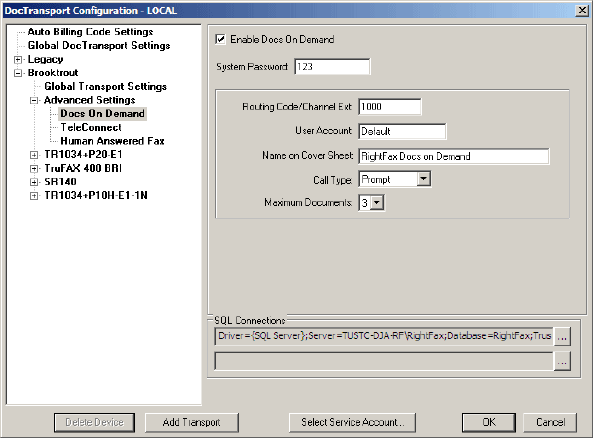
OpenText RightFax 10.0 Administrator’s Guide 64
To use the Docs-on-Demand module with all defined Brooktrout fax
boards, you must enable the feature in the DocTransport service.
Under the Brooktrout heading, click Advanced Settings in the
component tree in the left pane and then click Docs on Demand.
Figure 5.8 The Docs-on-Demand Configuration Dialog Box
Enable Docs on Demand Enables the two Docs-on-Demand
applications, Fax-on-Demand and Web Fax Tools. If this check box
is not selected, neither feature will function.
System Password This is the password the Fax-on-Demand
administrator will use to access the Fax-on-Demand Sysop
(System Operator) menu. Because you must be able to enter the
password from a touch-tone phone, this password must consist of
numeric digits only.
Routing Code/Channel Ext Specifies the routing code (such
as DTMF extension or DID number) that will be assigned to
Fax-on-Demand. When calls arrive on this extension they will
automatically enter the Fax-on-Demand system, rather than being
received as an incoming fax.
If you have a bank of numbers dedicated to your fax server, you
must assign one of the numbers to Fax-on-Demand by entering the
extension here. If you have channel routing configured on POTS
(plain-old-telephone system) lines, then you must dedicate one of
your fax channels to Fax-on-Demand. To do this, enter a unique
four-digit number in this box, and then click the channel you want to
dedicate under Global Board Settings in the left pane, and enter
the same four-digit value in the Channel Extension box. Users
must be able to dial into this channel directly. The channel should
not be part of a hunt group unless all the channels in that hunt
group are dedicated to Fax-on-Demand. Otherwise, dialing the
number may cause users to hear a fax tone instead of accessing
Fax-on-Demand.
You can also turn on DTMF routing for a particular analog channel.
When users dial this number they will hear a tone or voice prompt
to enter an extension. Enter a unique four-digit extension in this box.
If you tell your users to enter this number when they hear the
prompt, they will connect to the Fax-on-Demand system. If this
number is not entered after a few seconds (depending on the
DTMF timeout value), the channel will provide a fax tone and
attempt to receive a fax.
User Account This is the RightFax user ID that Fax-on-Demand
will use when sending faxes. All cover sheet information and
attributes of the selected user ID will apply to faxes sent by
Fax-on-Demand. This setting is also used by Web Fax Tools for
assigning a RightFax user ID to outgoing faxes.
Name on Cover Sheet Specifies the name or text that will
appear in the “To:” field on fax cover sheets sent by
Fax-on-Demand.
65
Call Type Specifies how Fax-on-Demand will connect to the user
when faxes are requested. “One Call” requires the user to be
calling from a fax machine. Fax-on-Demand uses the same
connection to send faxes back to the caller without initiating a
second call. In this way, the Fax-on-Demand system incurs no
phone charges. “Two Call” causes Fax-on-Demand to request the
recipient’s fax number and then initiates a separate call to send
faxes. “Prompt” asks each user to specify a one- or two-call
session.
Maximum Documents Specifies the maximum number of fax
documents that a Fax-on-Demand user can request per call.
BrookTrout Registry Settings
In addition to setting the configuration options through the
RightFax user interface, you can set some options through the
registry editor.
Adding data to the ISDN string You can add a field of data
to the calling party number field of the ISDN string for each fax sent
from the RightFax server. This data can be captured by some PBX
systems for billing purposes. Before implementing this feature,
verify that the PBX system can accept the data. If it does not, the
PBX will reject the call. For more detail on editing the registry to
indicate which data to include, see “UseISDNCallingParty” on
page 328.
Defining an RTI line The RTI (Receipt Terminal Information)
line is a line of text that can be printed at the bottom of each
received fax page. The RTI line includes information about the fax
that supplements the TTI line such as the total number of pages
received, the name of the fax server that received the fax, and the
sender’s caller ID. You can enable or disable the RTI line, specify
the information you want it to include, specify the font size, and
specify where on the fax page to print the line. For more details on
editing the registry to enable or modify the RTI line, see
“StampReceivedPages”to turn the RTI on or off
“ReceiveStamp Format” to specify which data displays
“ReceiveStamp Location” to specify where the RTI displays
“ReceiveStamp FontSize” to specify how large to print the RTI
Troubleshooting the BoardServer module
To help track errors, all RightFax server modules can be configured
to record a detailed log of program information in the Application
EventLog. When a problem occurs, this should be your first source
of information. Each entry will be attributed to the RightFax Server
module, RightFax Database module, RightFax BoardServer
module, or RightFax WorkServer module.

OpenText RightFax 10.0 Administrator’s Guide 66
Error 2140 when starting the BoardServer service with
Brooktrout fax boards
1. Confirm that the base I/O address and the interrupt in the
Board section of the BoardServer configuration program match
the physical settings on the board.
2. If the address and interrupt are configured correctly, confirm
that there are no other system conflicts with those addresses.
Note The RightFax BoardServer module must be stopped for this
test to work.
From a command line on the RightFax server, change to the
RightFax\RFBoard folder and enter this command:
type faxinit.cfg
A line appears for each fax channel listing the channel’s
address. If the addresses do not match the ones you have
entered in the BoardServer configuration program, edit the text
file and fix them. After this is done, enter this command at the
RightFax\RFBoard prompt:
faxinit faxinit.cfg
If the addresses are not successfully found, then they are
probably conflicting with something else on your system.
3. If all of the addresses are found and you are still getting a 2140
error when starting the BoardServer module, there is probably
an interrupt conflict. Confirm that the interrupt on the board
matches the interrupt setting in the BoardServer configuration
program. If it does, try another interrupt setting. To do this, first
change the interrupt in the BoardServer configuration, and then
shut down the Windows server, turn off the computer, and
change the interrupt jumper on the fax board to match the
BoardServer configuration. Restart the system and try to restart
the service. Repeat this procedure trying different settings until
the service starts successfully.
The BoardServer service is set to manual
The BoardServer module is normally configured as an automatic
service. If it encounters problems starting (such as configuration
errors), the BoardServer service sets itself to manual. To reset the
BoardServer service to automatic, fix the cause of the problem, and
then restart the BoardServer module manually. On successful
startup, the BoardServer module will reset itself to automatic.
Eicon Fax Board Configuration
Eicon fax boards must be added in the DocTransport module and
then configured using the board configuration tool provided by
Eicon. Eicon Diva Server version 7.5 or later must be installed on
the RightFax server or remote BoardServer computer where the
Eicon boards are installed.
Each board must be configured separately, and each channel must
be configured separately for each board. There are two major
steps:
1. Configure the Eicon Global Transport Settings
2. Configure the following elements for each board:
Configure the default settings for the board
Use the Eicon Configuration Tool to set additional
parameters(see the Eicon documentation).
Configure each of the RightFax channels
Important DTMF routing with Eicon fax boards is not supported.
After you have specified the installed Eicon fax boards in
DocTransport (described in “Adding transport methods” on
page 50), expand the Eicon option in the list in the left pane and
select an Eicon board in the list. This displays a set of Eicon
configuration options.
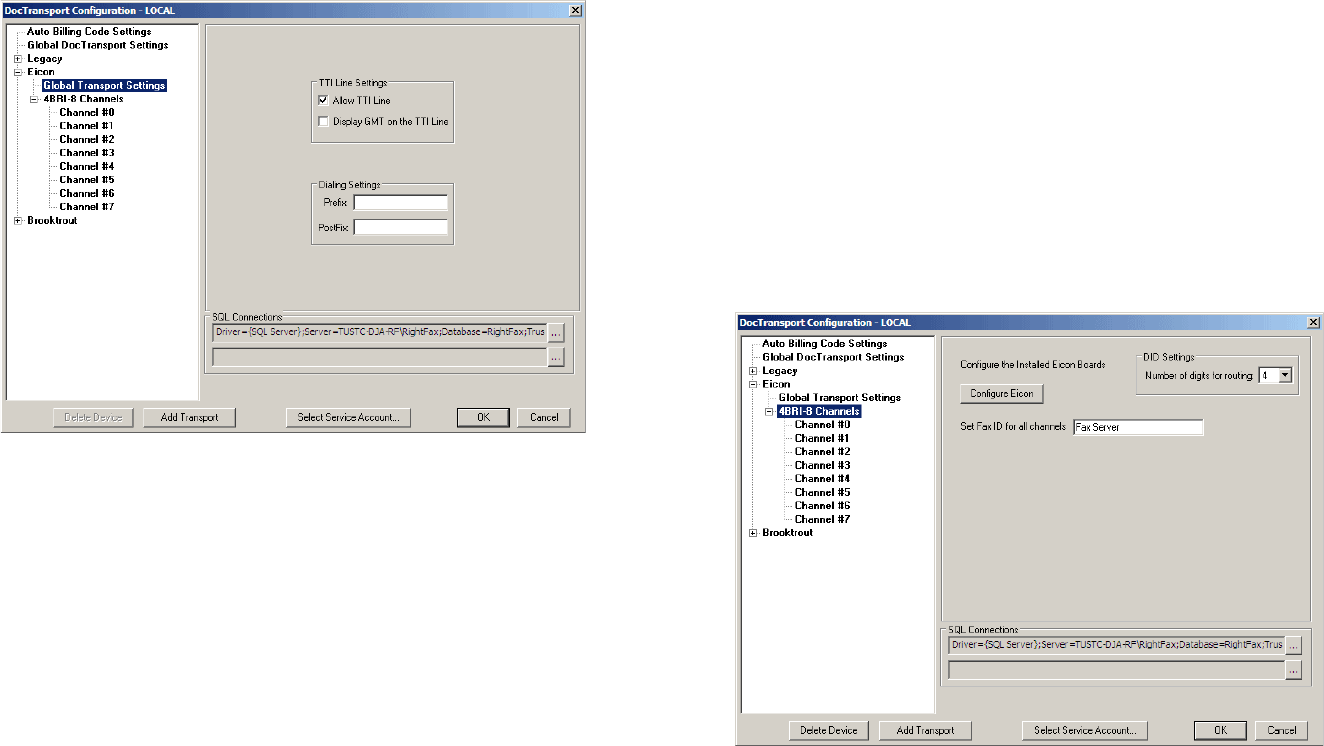
67
Figure 5.9 The Eicon Diva Server Configuration options
Configuring Eicon Global Transport Settings
Eicon Global Transport Settings are global settings that apply only
to the Eicon transport methods. To configure Eicon Global
Transport settings, select Global Transport Settings in the left
pane. The rest of this section describes the options on this screen.
Allow TTI Line The transmit terminal information (TTI) line is a
line of text that prints at the top of each received fax page. The TTI
line includes the transmitting fax machine, the date and time of the
transmission, the fax page number, and the total page count.
Display GMT on the TTI Line Displays the local time relative
to Greenwich Mean Time (GMT). If this option is not selected, the
TTI line will display the local time at the fax’s place of origin.
Dialing Settings Prefix This field specifies one or more dialing
characters to add at the beginning of every outbound fax number
dialed by the server. The default setting (WW) instructs the fax
boards to automatically detect a dial tone before dialing. For a list
of valid dialing characters, see “Dialing Characters Supported by
Dialing Rules” on page 191.
Configuring an Eicon Board
After you have added a new Eicon fax board, it must be configured
to work with RightFax. To configure the board, click the board name
in the Board/Channel list in the left pane. Note that all Eicon board
types use the same configuration screen, though some fields may
be unavailable (greyed out) depending on functionality of each
board.
Figure 5.10 The Eicon Board Configuration options
Configure Eicon Click this button to run the Eicon SoftIP
configuration program if necessary. However, this configuration
should have been completed before enabling the SoftIP channels
in RightFax.
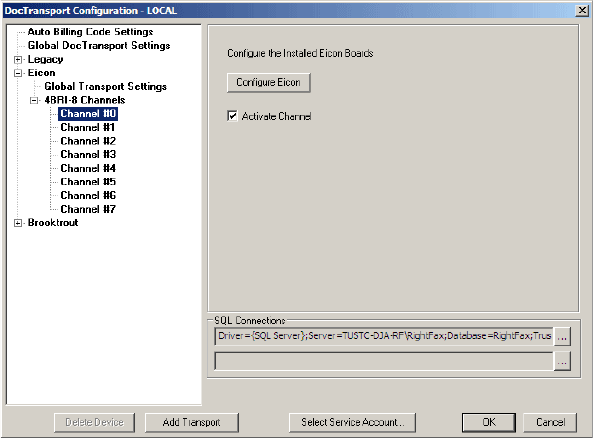
OpenText RightFax 10.0 Administrator’s Guide 68
DID settings Direct Inward Dial (DID) is a phone line service
that allows inbound fax routing based on the phone number that
was used to dial in to your fax server. The fax board reads a set
number of digits from the phone line and compares these digits to
each RightFax user's routing code. If a match is made, the fax can
be successfully routed.
These settings will only affect DID-capable fax boards.
Number of Digits for Routing Specify the number of
received digits to use for DID routing. This is the number of digits in
each RightFax user’s routing code.
Set Fax ID for all Channels You can specify a fax ID for all the
SoftIP channels you add. The fax ID is transmitted by each channel
to the receiving fax device. Usually, this is set to your company
name or a general fax number.
Configuring an Eicon Channel
Each fax channel on an Eicon fax board can be individually
configured and activated. To configure a channel, click the channel
number in the Board/Channel list.
Figure 5.11 The Eicon Channel Configuration options
Activate Channel Select this check box to activate the channel,
or deselect it to disable the channel.
Configure Eicon Click this button to run the Eicon SoftIP
configuration program if necessary. However, this configuration
should have been completed before enabling the SoftIP channels
in RightFax.
For more information about Eicon fax boards, see Chapter 7 of the
RightFax Fax Board Guide located on the RightFax server in the
\RightFax\Doc folder.
Configuring T.37 Fax over IP
T.37 fax over IP is a fax transmission protocol that allows faxes to
be transmitted to T.37-compatible devices over IP, rather than
dedicated fax channels. The fax is packaged as an email message
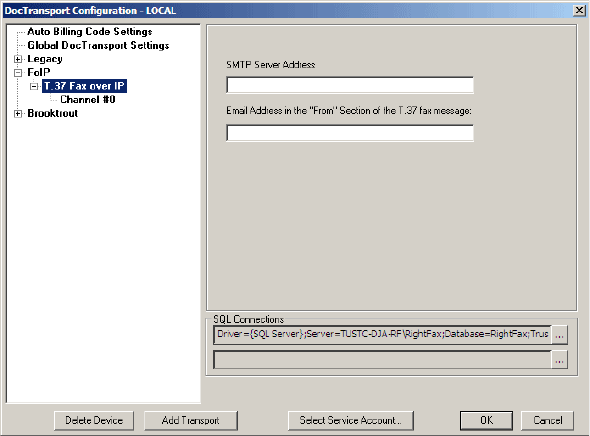
69
with a TIFF attachment and then sent over IP via an SMTP server.
This message is automatically interpreted as a fax by the receiving
device, which then prints it.
To send documents using fax over IP, you must create dialing rules
that route the documents based on the fax numbers or email
addresses entered by your RightFax client for outbound faxes. For
information on how to configure a dialing rule to route to a fax over
IP destination, see page 194.
After you have added the T.37 Fax over IP transport method in
DocTransport (described in “Adding transport methods” on
page 50), expand the FoIP option in the list in the left pane and
select T.37 Fax over IP. This displays the fax over IP configuration
options.
Figure 5.12 The T.37 Fax over IP Configuration options
SMTP Server Address By default, fax over IP messages will be
sent via the SMTP server that you specified during the RightFax
server installation. If you did not specify an SMTP server name
during installation, enter the name of the SMTP server on your
network that will transmit fax-over-IP messages.
Email Address in the “From” Section of the T.37 fax
message Enter the email address that will be transmitted to the
receiving T.37-compatible device.
Configuring Fax over IP Failover
Fax over IP environments with a multi-router topology may
configure RightFax (via dialing rules) for real-time FoIP fail-over.
When the primary FoIP router or gateway is unavailable or times
out, faxes are automatically routed to a secondary router or
gateway. FoIP fail-over is compatible with both SR140 and T.37
board-based architecture.
To enable FoIP failover, create two dialing rules that routes faxes
based on the outgoing router number. Set the rule that points to
the primary router with a higher weight than the rule that points to
the secondary router. You must also enable FoIP by editing the
registry keyword value DisableDialingRuleOnTimeout (see
“DisableDialingRuleOnTimeout” on page 327) to have a value of 1.
To enable FoI P fail-over
1. Log on to Enterprise Fax Manager and click the Dialing Rules
view.
2. Right-click Dialing Rules and click New. The Rule Edit window
opens.
3. In the Pattern field, enter a number that, when dialed, will be
sent via FoIP.
4. Click the Number Adjustments tab. Type the @ symbol and
the IP address of your network’s primary FoIP router.
For example, @192.168.0.1

OpenText RightFax 10.0 Administrator’s Guide 70
5. When finished, click OK.
6. Repeat steps 2 through 5, but use the secondary router in the
Number Adjustments tab.
7. Click the Other tab.
8. Find the Extra Rule Weight box and click the up arrow for the
first rule (the router you want to use the most) until the value is
greater than 0. When finished, click OK.
9. Open the Enterprise Fax Manager File menu and click Save
Dialing Plan.
Important When using FoIP you must remove the wait for wink (or
WW) setting in the dialing settings, prefix box located in the
DocTransport, Global Transport Settings.
Configuring SMS via the Push-Proxy Gateway
Short message service (SMS) is a communication protocol that
lets you send and receive short text messages to and from
SMS-compatible devices such as a cell phone. The RightFax
server can be configured to send fax notifications and alerts to
SMS numbers. RightFax clients can also send and receive SMS
messages. Because SMS is a text-only protocol, sent SMS
messages include only the notes added to the fax cover sheet. You
can also create dialing rules that automatically route outbound
faxes to SMS numbers. SMS functionality requires that you have
installed the RightFax Push-Proxy Gateway on the server running
the DocTransport service.
After you have added the SMS transport method in DocTransport
(described in “Adding transport methods” on page 50), expand the
SMS option in the list in the left pane and select Mobility
Push-Proxy Gateway. This displays the SMS configuration
options.
Figure 5.13 The SMS Configuration options
Configure PPG Runs the Push-Proxy Gateway configuration
program. For information on completing these configuration
options, refer to the “Text Messaging Using the Push Proxy
Gateway” on page 151.
Number of Digits for Routing When the RightFax server
receives an incoming SMS message, it can route the message to
one or more mailboxes. Each RightFax mailbox (user ID) has a
unique routing code. SMS mailboxes should be configured to use
routing codes based on the phone number that the message was
sent to, typically the last three or four digits of the number. Enter
the number of digits that will be read from the end of the receiving
phone number that will be used for routing SMS messages.
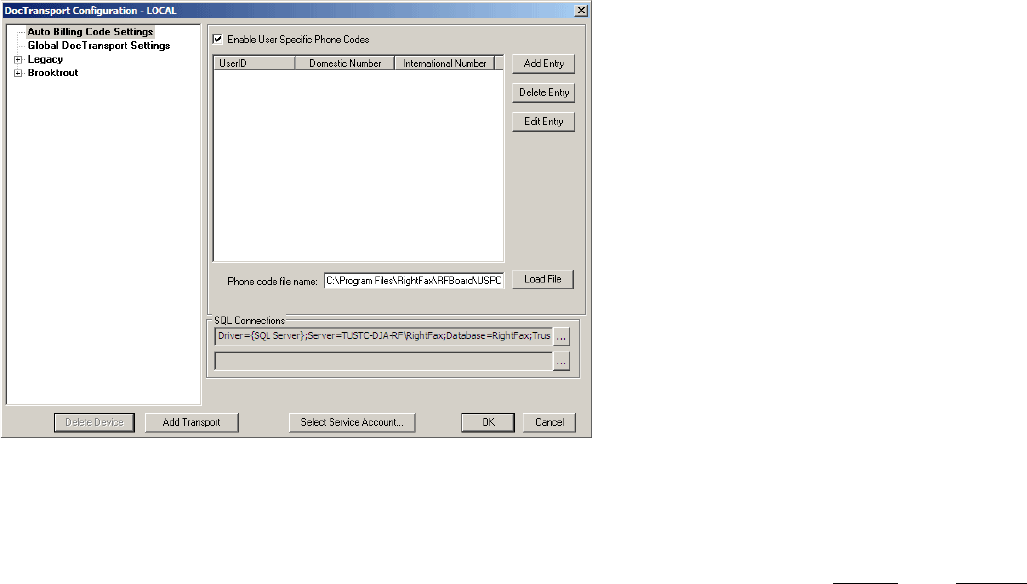
71
Configuring Automated Billing Codes
This feature automatically applies billing codes to outbound faxes
based on the user ID of the sender. To configure automatic billing
codes, click Auto Billing Code Settings in the left pane.
Figure 5.14 DocTransport Configuration Auto Billing Code Settings.
Enable User Specific Phone Codes Enables the Automatic
Billing Codes feature.
To assign domestic and international phone codes to specific
RightFax users, you must create a list of RightFax users and their
phone codes.
Click Add Entry to add a new entry to the list. This opens a dialog
box asking you to enter a RightFax user ID and that user’s domestic
and international long distance phone codes. When you click OK
to close the dialog box, the new entry is immediately displayed in
the DocTransport Configuration dialog box.
To edit an entry, click the entry in the list and click Edit Entry. To
delete an entry, click the entry and click Delete Entry.
To load a list of RightFax user IDs and phone codes from a file, type
the path and file name in the Phone Codes File Name box and
click Load File. The file name you specify must be a tab-delimited
ASCII file. Each entry in this file must include the RightFax user ID,
domestic phone code, and international phone code. Individual
entries are separated by a carriage return
Example JDoe 1345 0345
JSmith 1678 0678
BJones 1111 0111
After you load the file, any additions, deletions, and editing changes
you make in the DocTransport Configuration dialog box will be
saved.
To distinguish international and domestic long distance
calls
After you have created a list of RightFax users and their phone
codes, you must specify dialing rules that tell RightFax when to dial
those codes.
When creating dialing rules, the character “F” added to the dial
string will be replaced with the user’s domestic phone code. The
character “G” added to the dial string will be replaced with the
user’s international phone code.
Example For example, for international calls, you might create a
dialing rule like this:
Pattern Append
011+ wGii
This tells RightFax that if the first three digits of an
outgoing fax number are “011” (the international dialing
prefix) then wait for a dial tone (w), look up the user’s
international billing code and dial it (G), and then wait 10
seconds before dialing the number (ii).

OpenText RightFax 10.0 Administrator’s Guide 72
For more information on creating dialing rules in RightFax, see “Adding
dialing rules” on page 187.
Running DocTransport on Remote Computers
Note One RightFax Enterprise server can support a total maximum of
16 separate DocTransport modules.
With the RightFax Enterprise server, you can install and run multiple
DocTransport modules simultaneously on the local and one or
more remote computers. This distributes the workload of the
RightFax server across several computers and provides expanded
channel capacity and system redundancy.
Caution While running DocTransport modules over a WAN is a
supported configuration, it is important that sufficient bandwidth is
available across the network to allow the DocTransport and RightFax
server to communicate efficiently. Insufficient bandwidth when running
remote DocTransport modules across a WAN may result in timeout errors
causing both inbound and outbound documents to fail.
When the RightFax server is configured to run one or more
DocTransport modules remotely, the workload of faxing is divided
between multiple computers. The RightFax server computer can
remain dedicated to database management and WorkServer
operations, while the remote DocTransport computers handle all
the work relating to sending and receiving faxes.
Because the fax boards can be distributed between several
computers, your ability to expand your system’s fax channel
capacity is virtually unlimited using remote DocTransport modules.
Also, running remote DocTransport modules allows for system
redundancy. If a hardware or phone line failure occurs, fax traffic
can be automatically routed to other available DocTransport
modules quickly and with no interruption of service. In addition,
remote DocTransport modules let you make the most out of
redundant hardware in clustered server configurations, as in the
following diagram.
Figure 5.15 Remote DocTransport Modules
in a Clustered Environment
The ability to install multiple DocTransport modules is available in
RightFax Enterprise servers only.

73
Requirements
Supported Microsoft Windows Operating Systems
RightFax server software is supported on the following server
operating systems.
Windows Server 2008 R2 Standard x64
Windows Server 2008 R2 Enterprise x64
Windows Server 2008 Standard x86 and x64
Windows Server 2008 Enterprise x86 and x64
Windows Server 2003 Standard x86 SP2 or later
Windows Server 2003 R2 Standard x86 SP2 or later
Windows Server 2003 Enterprise x86 SP2 or later
Local server requirements
Microsoft .NET Framework 3.5*
Microsoft Data Access Components 2.8*
Microsoft Messaging Queuing*
Microsoft Visual C++ 2005 runtime components*
A Windows account to run RightFax services. The account
you choose must be a domain user that member of the local
administrators group and must have the right to logon as
service on the local computer.
* installed during setup
RightFax server requirements
Before installing remote WorkServers, you must share the
\RightFax folder on the RightFax server and grant the WorkServer
service account full control. This account must also have write
access to the Windows registry on the RightFax server.
To install the DocTransport on a Remote Computer
Important Because they are not located on your RightFax server
computer, remote DocTransport modules cannot prevent you from
exceeding your RightFax channel licenses. You must manage the number
of activated channels across all the DocTransport modules, and do not
attempt to activate more channels than your organization has licensed.
The RightFax Server module service will shut down if the total number of
channels on all DocTransport modules exceeds your total number of
channel licenses.
Caution If you have changed the default DSN for the SQL connection
on the main RightFax server, you must manually change the DSN on the
remote DocTransport computer to match the DSN on the server.
To ensure that your installation goes smoothly and to avoid
unnecessary delays, it is important to perform each step in the
installation completely and correctly before proceeding to the next
step.
1. If you haven’t already done so, download the Open Text Fax
Server, RightFax Edition Installation from the Open Text
Knowledge Center to a network location. Browse to that
location and then run Setup.exe. The RightFax Product Suite
Setup wizard opens.
2. RightFax DocTransports require Microsoft .NET Framework 3.5
or later. If this software is not installed on your system, Setup
will prompt you to install it. To install, click OK. To cancel Setup
and install .NET Framework 3.5 yourself, click Cancel.
3. Review the welcome screen and click Next.
4. Carefully read and accept the license agreement and click Next.
5. Setup can check for RightFax updates and other late-breaking
information. To check for updates, verify you have an active
HTTP connection and click Check for Updates. If updates are
found, follow the instructions in the Result section. To skip the
update check and continue with Setup, check the box next to
Do not check for updates and click Next.
OpenText RightFax 10.0 Administrator’s Guide 74
6. Click Custom followed by Next.
7. Select the DocTransport Module Setup component and click
Next. No other Setup components should be chosen.
8. The Preview Requirements step lists third-party software
required by your chosen features and also lists the status of
setup operations. Software that must be installed will have a
status of Must Install. To continue, click Next.
9. To apply your settings and install required third-party software,
click Apply. This may take several minutes. When finished, click
Next.
10.If your server does not already have Microsoft Message
Queuing installed, Setup will prompt you to install it. Select your
option and click Next.
11.RightFax requires TCP ports 10520, 10521, 10062, 34987,
and 34988. Setup can reserve these ports for exclusive use by
RightFax. To allow setup to reserve these ports, enable the
Reserve Ports option and click Next. If you do not reserve
these ports, some RightFax services may not start.
12.To apply your settings and install required third-party software,
click Apply. This will take several minutes. When finished, click
Next.
13.Choose your installation folder and click Next.
14.To begin installing RightFax software, click Apply. This may take
several minutes. When finished, click Next.
15.Enter a Windows account to run RightFax services. This must
account be a domain user that member of the local
administrators group and must have the right to logon as
service on the local computer. In addition, this account must
also have full-control over the \RightFax folder on the RightFax
server and have write access to the Windows registry on the
RightFax server. Click Browse to load and select a user
account. Use the Test Account button verify account
credentials. When finished, click Next.
16.Enter your RightFax server name. To verify remote access to the
RightFax server, click Check Access. When finished, click Next.
17. To apply your settings and complete Setup, click Apply
followed by Close.

75
Chapter 6
Configuring Server-Side Application Conversion
By default, the RightFax server uses its built-in conversion engine
to generate fax images from document file attachments. These are
files passed to the RightFax server in their original format (such as
Word, Excel, or PowerPoint) instead of first being converted to
printer output. Document attachments are typically delivered to the
RightFax server from one of the email gateway modules (as mail
message attachments) or from RightFax Web Access.
While the standard RightFax conversion engine has some
advantages (such as being very fast and efficient), there are
occasionally variances between the fax image it generates and the
original document. In most cases these variances are minor and
acceptable. However, if the conversion quality of faxed file
attachments is unacceptably low, your RightFax servers can be
configured so that the applications associated with certain file
formats are launched to allow for direct (and therefore more
accurate) conversion by attachments’ native applications. This is
known as server-side application conversion or SSA.
Note Server-side application conversion is not used for documents that
are printed directly from the native applications to the RightFax
print-to-fax driver. The print-to-fax conversion is handled by the native
application on the client computer before it is sent to the RightFax server.
Understanding Server-Side Application
Conversion
Where possible, server-side application conversion supports
multiple concurrent document conversions to save processing time
and server resources. Also, blank pages are removed from the fax
image to save on fax costs and channel resources.
Server-side application conversion is available when faxing from:
Files attached using FaxUtil.
Files attached using WebUtil.
Files attached using print-to-fax.
The Send To shortcut menu.
File attachments sent through the Microsoft Exchange, SMTP, or
Lotus Notes email gateways.
Files attached by using the <ADDDOC> embedded code.
The RightFax API and COM API.
Launching an application at the RightFax server each time a file
attachment fax image is generated has some potential drawbacks.
You should weigh these drawbacks against the benefits before
configuring your RightFax server to perform server-side application
conversion.

OpenText RightFax 10.0 Administrator’s Guide 76
Full applications are much larger and more processor-intensive
than the standard RightFax conversion engine. You may need to
upgrade the RightFax server memory or processing capacity to
support server-side application conversion, especially if your
organization generates a lot of faxes with attached files.
Most applications are not designed to be run completely without
user intervention. Situations may arise in which an application
stops while it waits for user input (such as waiting for a password).
RightFax makes every attempt to prevent or bypass such
occurrences but cannot guarantee it will prevent all such
occurrences. If one or more faxes being processed through
server-side application conversion fail to send, you should check
that the application on the server is not stalled and waiting for
attention.
Documents containing objects that the server does not have
access to (such as special fonts, links to files on other computers,
macros, or templates) may generate unpredictable results, such as
incorrect fax image output or conversion failure. To minimize this,
install all of the TrueType fonts, document templates, macros, and
other components used by your organization to the computer or
computers that provides server-side application conversion.
If server-side application conversion does not succeed in creating
a fax image, RightFax will use its built-in conversion engine to
create the fax.
About the Captaris Conversion Engine
The Captaris Conversion Engine is a stand-alone, fault tolerant
service that is used to invoke applications used in server-side
application conversion. It detects when an SSA supported
attachment is passed to the RightFax server and launches the
appropriate application to convert the file.
The Conversion Engine also supports and can be configured to
use Optical Character Recognition (OCR) technology. OCR
related settings are located under the RecoStar tab. For
information about OCR setup and configuration, see “Using
Optical Character Recognition” on page 213.
SSA supported applications used by the Captaris Conversion
Engine are:
Microsoft Word, versions 2000, 2003, 2007, and 2010.
Microsoft Excel, versions 2000, 2003, 2007, and 2010.
Microsoft PowerPoint, versions 2000, 2003, 2007, and 2010.
Microsoft Internet Explorer 6, 7 or 8.
Note: Microsoft does not support Office 2010 on XP 64x systems.
To enable the RightFax server to perform Server-Side Application
conversion, install the applications on the RightFax server and any
computers running remote WorkServers you want to use for SSA.
The version of Microsoft Office installed on the Fax Server or
WorkServers must be able to open the document versions that are
submitted by client computers.
In order to convert Office 2007 and 2010 documents, you must
install Office 2003 with the Microsoft Office Compatibility Pack for
Word, Excel, and PowerPoint 2007 File Formats, available from
Microsoft.
Installing Office Applications
On each of your RightFax servers and any other computers where
RightFax WorkServers will be executed, follow these guidelines to
install the Microsoft Office Word, Excel, PowerPoint, and Visio
applications (versions 2000 through 2003), for server-side
application conversion.
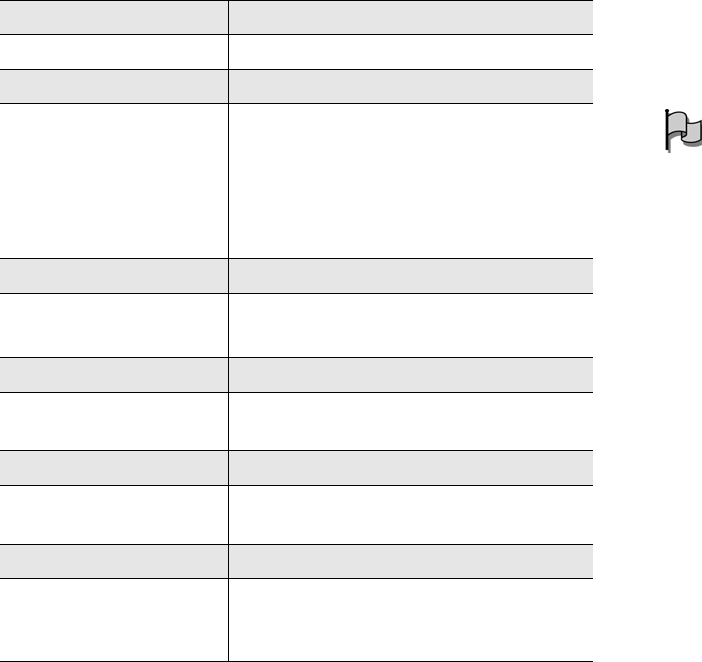
77
1. On the RightFax server, run Setup.exe. During the installation,
select the following options.
2. When the installation is complete, restart Windows.
3. After you have installed Microsoft Office 2003, you must
activate the software either through the Internet or by calling
Microsoft.
4. Install Microsoft Office 2003 Service Pack 3 and any additional
updates.
5. Set the security for macros in Office to the lowest setting.
6. To enable conversion of Office 2007 and 2010 documents,
install the Microsoft Office Compatibility Pack for Word, Excel,
and PowerPoint File Formats, available from Microsoft.
Important: You must also install any available updates to the
Compatibility Pack.
7. Create a folder called Desktop in the system directory on each
server where SSA conversions will occur
(C:\Windows\System32\config\systemprofile\Desktop). For
64-bit versions Windows 2008, you must also create a new
folder called Desktop in the 64-bit system folder
(C:\Windows\SysWOW64\config\systemprofile\Desktop).
8. Each Office 2003 application that you have installed must be
launched on the server and then closed so that any additional
setup requirements at the user profile level can be completed.
9. Reboot the Fax Server.
Microsoft Office applications may require some configuration to
ensure that server-side application conversion works properly.
Refer to the following section for additional information about
configuration and limitations for Microsoft Word, Excel, and
PowerPoint.
Configuring Office Applications
Server-side application conversion through Microsoft Office
2000–2003 converts these file types:
Microsoft Office versions 2000–2003
Office 2007 and 2010 documents (converted using Office 2003
with the Office Compatibility Pack)
RTF (rich text format)
Table 6a Installing Office
Installation option Select this
Destination folder Default destination
Installation type Custom installation
Components to install Excel
Word
PowerPoint
Office Tools
Converters and Filters
Office Tools Microsoft TrueType fonts
Converters and Filters
Text Converters
Select all of the options except
converters for use with Lotus Notes
Graphics Filters Select all
Microsoft Excel Select the Microsoft Excel program files,
spreadsheet converters, and Help
Spreadsheet Converters Select all
Microsoft Word Select the Microsoft Word program files,
text converters, and Help
Text Converters Select all
Microsoft PowerPoint Select the Microsoft PowerPoint
program files, presentation translators,
and Help

OpenText RightFax 10.0 Administrator’s Guide 78
Password-protected files will not be converted with the exception
of Outlook or Lotus Notes file attachments where the Outlook or
Notes client has had the correct password provided in the
Document Conversion options (described in the Open Text Fax
Server Connector for Microsoft Exchange Administrator Guide
and RightFax Lotus Notes Module Guide.)
Note: Running the Exchange Events service on the RightFax server will
cause server-side application conversion through Word to fail. If you
must run Exchange Server on the same computer as your RightFax
server, you must disable the Exchange Events service.
Note: RightFax cover sheets must be Word 97-2003 format (with
extension .doc), not the Word 2010 format (extension .docx). See
“Creating Fax Cover Sheets” on page 205 for more information about
cover sheets.
Note: Excel 2010 can create two types of XML output, both with the
extension .xml. RightFax can convert spreadsheets that have been saved
in XML Spreadsheet 2003 format, but not Excel 2010 XML Data format.
Office 2007 Excel documents using the column feature (a new feature in
Office 2007) have problems converting.
Note: Some of the features new to Excel 2007 (such as conditional
formatting icon sets and data bars) may prevent conversion. To remedy
this, copy the data from the worksheet, then use Paste Special to store
only the values to a new file. These features will convert correctly from
Excel 2010.
To configure these applications,
1. On the RightFax server, select Start > Programs > Enterprise
Fax Manager.
2. In the Enterprise Fax Manager application, click the name of the
RightFax server to configure in the tree in the left pane. A list of
services appears at the lower-right pane of the window.
3. In the Service Name list, double-click Captaris Conversion
Engine. The Conversion Engine Configuration dialog box
opens.
4. For each application, you can specify memory, time out, and
retry settings by completing the following fields.
Application Monitoring Use the Application Monitoring
setting to allocate memory (in megabytes) as needed. The
default value of 25 MB is usually adequate for all but the largest
documents. Local testing will ultimately determine the optimal
setting for your environment.
Document Monitoring Adjust this setting based on the
size of the largest document (page and word count) sent for
conversion by Excel. The default value of 1 minute is usually
adequate for all but the largest documents.
Maximum number of retries The maximum number of
conversion attempts per document is controlled by the
Maximum number of retries setting. Documents that fail
conversion are marked as Problem Converting Fax Body or
Coversheet.
Configuring Internet Explorer
The conversion engine can invoke Internet Explorer 6 or later to
assist in the conversion of HTML documents. The Internet Explorer
tab allows RightFax administrators to control settings associated
with Internet Explorer (HTM and HTML) conversions.
1. On the RightFax server, select Start > Programs > Enterprise
Fax Manager.
2. In the Enterprise Fax Manager application, click the name of the
RightFax server to configure in the tree in the left pane. A list of
services appears at the lower-right pane of the window.
3. In the Service Name list, double-click Captaris Conversion
Engine. The Conversion Engine Configuration dialog box
opens.
4. Complete the following fields.
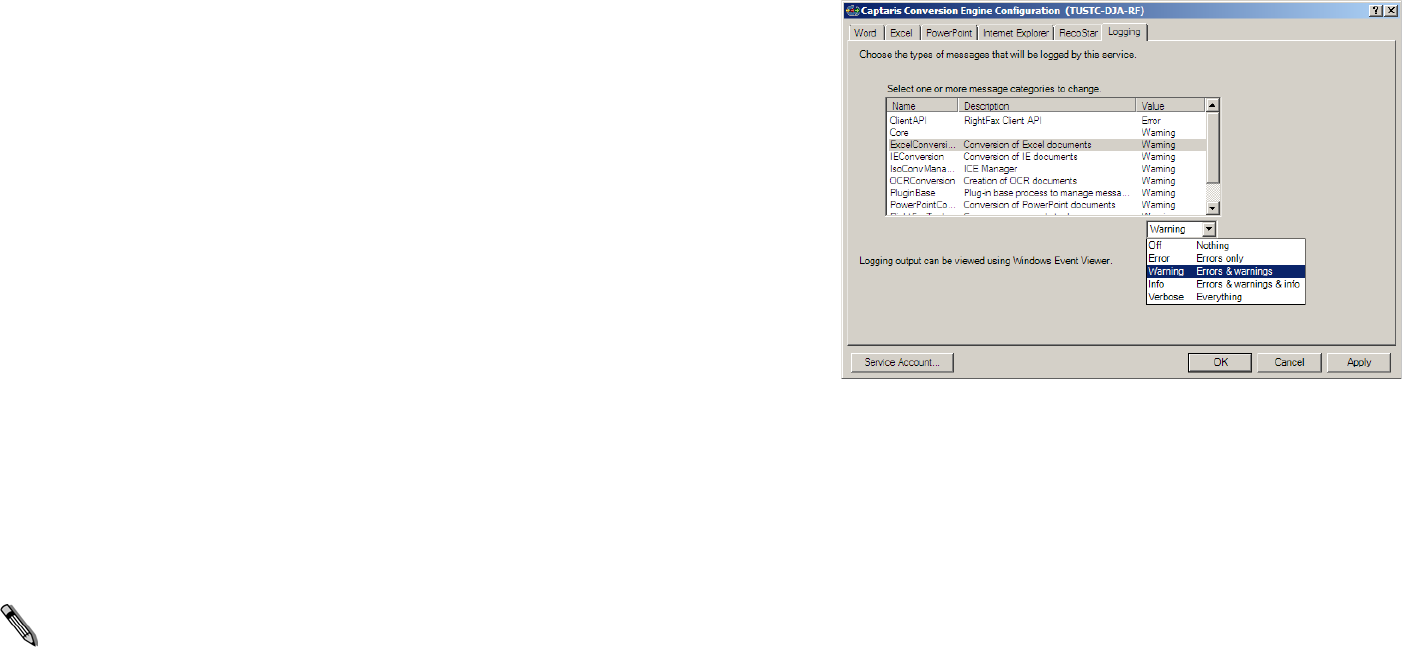
79
Application Monitoring Use the Application Monitoring
setting to allocate memory (in megabytes) as needed. The
default value of 25 MB is usually adequate for all but the
largest documents. Local testing will ultimately determine the
optimal setting for your environment..
Document Monitoring Adjust this setting based on the
size of the largest document (page and word count) sent for
conversion by Internet Explorer. The default value of 1 minute is
usually adequate for all but the largest documents. Local
testing will ultimately determine the optimal setting for your
environment.
Maximum number of retries The maximum number of
conversion attempts per document is controlled by the
Maximum number of retries setting. Documents that fail
conversion are marked as Problem Converting Fax Body or
Coversheet.
Page Headers and Footers If your conversions require
Internet Explorer header and footer print codes, you must add
them to the Header and Footer fields. For information about
Internet Explorer print code macros, see Microsoft
documentation.
Page Margins Use the up and down arrows to configure
page margins. All values are in inches.
Configuring Conversion Logging
The Logging tab provides RightFax administrators with control
over the types of messages logged by the Conversion Engine.
Each of these messages can be customized using categories and
logging levels. By default, all output is written to the Windows
Event Logs, except when the service is running in debug mode, in
which case all messages are shown in real-time via the diagnostics
window.
Note The Captaris Conversion Engine configuration program cannot be
opened from a remote computer.
1. On the RightFax server, select Start > Programs > Enterprise
Fax Manager.
2. In the Enterprise Fax Manager application, click the name of the
RightFax server to configure in the tree in the left pane. A list of
services appears at the lower-right pane of the window.
3. In the Service Name list, double-click Captaris Conversion
Engine. The Conversion Engine Configuration dialog box
opens.
Figure 6.1 The Conversion Engine Configuration Logging tab

OpenText RightFax 10.0 Administrator’s Guide 80
4. Click the name or description of a message category, then
choose the level of logging for that category from the
drop-down menu.
Off. No information is saved.
Error. Records critical errors only.
Warning. Records errors and major events only.
Info. Records errors, major events, and informational
messages.
Verbose. Records all significant events and is most useful
for tracking and resolving problems.
Caution If you leave this value set to “Verbose” for long periods of time,
the Event Log can become full which may prevent new events from being
logged.
For more information about debug mode, see “Troubleshooting the
Conversion Engine” on page 81.
Configuring the Service Account
The Conversion Engine must be run under an account that
permission to open the conversion applications and permission to
create a printer. The Local System account does not have these
permissions, and cannot be used as the service acount. To set the
service account:
1. On the RightFax server, select Start > Programs > Enterprise
Fax Manager.
2. In the Enterprise Fax Manager application, click the name of the
RightFax server to configure in the tree in the left pane. A list of
services appears at the lower-right pane of the window.
3. In the Service Name list, double-click Captaris Conversion
Engine.
4. On the Conversion Engine Configuration dialog box, click the
Service Account button.
5. Enter the information for an account that has permission to:
open the Microsoft Office programs and Internet Explorer
create a printer
print
6. Click OK to close the Service Account window.
7. Click OK to close the Conversion Engine Configuration
dialog box.
To Configure Timeout on a Failed Conversion
In case server-side application conversion fails, you can configure
RightFax to automatically time out, stop the conversion, and set the
fax status to “conversion failed.”
1. On the RightFax server, stop all WorkServer services.
2. Edit the Windows Registry length of time indicated by the
KillServiceTimeout value on the RightFax server for each
workserver. See “KillServiceTimeout” on page 334.
3. Restart the services.
To have the WorkServers recover after being stopped by this new
feature, open the Windows Control Panel and select
Administrative Tools > Services > RightFax WorkServer and go
to the Recovery tab to select the service's response to the
shutdown.
Controlling Server-Side Application Conversion
To control how and when server-side application conversion is
used for specific document types, edit the Windows registry value
“NativeDocControl” (as described on page 335. The setting for
this value is one or more lines each controlling a specific document
type in the format:
DocType,Action
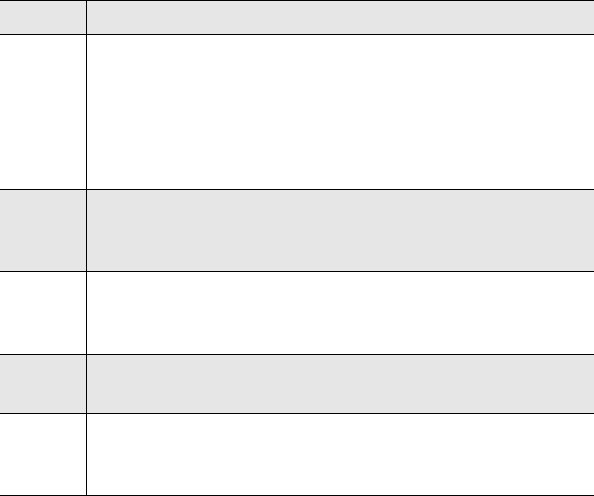
81
Where DocType is the type of document to control, and Action
specifies how the document type should be handled. DocType can
be Word, Excel, PowerPoint, VSD, RTF, HTML, or PDF. The
following table lists the actions you can specify.
Example NativeDocControl value setting:
VSD,2
Word-wrap for Text Attachments
Text attachments that contain long lines of text can potentially be
truncated. To configure RightFax to word-wrap text attachments,
eidt the WordWrapTextLength value in the .
1. Edit the Windows Registry value for WordWrapTextLength for
each Workserver. See“WordWrapTextLength” on page 336 for
more detail.
2. Open the RightFax WorkServer Module.
3. Configure all RightFax WorkServers to use the option ‘Use PCL
Converter for Text Files’.
4. Click OK to restart the WorkServer Modules.
Troubleshooting the Conversion Engine
Like all RightFax services, the Conversion Engine can be run in
'debug' mode. Debug mode provides RightFax administrators with
robust real-time monitoring, logging, and troubleshooting via a
separate diagnostics window. From this window it is possible to
customize the trace (logging) level, group by processes, and save
the output to an RTF or TXT file. Errors and warnings are also
displayed in different colors, making it easier to isolate problems.
The diagnostics window also allows the service to be started,
stopped, paused and resumed.
To run the Conversion Engine in debug mode
1. Open Enterprise Fax Manager, click your fax server name, and
browse to the services view in the lower-right corner.
2. Right-click the Captaris Conversion Engine and choose Stop.
3. When the service has stopped, right-click the service and select
Debug. The Diagnostics window opens.
Changes made to the Conversion Engine while running in debug
mode are not reflected in the diagnostics window until re-launched.
Also note that when running the Conversion Engine in debug
mode, it is possible to restart the service by clicking OK in the
Conversion Engine configuration. Setting the service that runs the
Table 6b NativeDocControl Actions
Value Action
1Attempt to convert the document using the native
application on the server. If this fails because the
application is not installed, because the application
cannot be started, or because the application returns an
error, then attempt to convert the document using the
built-in RightFax conversion engine.
2Only attempt to convert the document using the native
application on the server. If this fails for any reason, abort
the fax.
3Attempt to convert the document using the built-in
RightFax conversion engine. If this fails for any reason,
abort the fax.
4Do not attempt to convert this type document. Conversion
will fail.
5Attempt to convert the document using the built-in
RightFax conversion engine. If this fails, attempt
conversion with the native application.
OpenText RightFax 10.0 Administrator’s Guide 82
Conversion Engine (RfIsoConv.exe) to manual startup will prevent
this problem, however, this is only recommended when performing
complex debug associated troubleshooting.
83
Chapter 7
Enabling and Using the Captaris Sync Module
RightFax maintains a database of users. This database defines
each user’s RightFax-specific contact information, logon
information, preferences, and permissions. With the Captaris Sync
Module, you can import this information in real-time or at definable
intervals from other data sources, such as Microsoft Active
Directory or any LDAP (Lightweight Directory Access Protocol)
compliant data source.
When you use the Captaris Sync module, only the RightFax
database will be updated. The original data source will not be
changed.
Description of the Captaris Sync Module
The Captaris Sync Module is an XML/XSLT based tool that allows
RightFax administrators to create and update users from Active
Directory (domains, groups, and organizational units) and LDAP
compliant data sources.
Features
Synchronization data is not stored in Active Directory.
Support for multiple domain environments.
LDAP support.
Robust real-time logging and diagnostics.
Nested groups are not automatically included when
synchronizing from parent groups.
Synchronization is managed as a standalone service.
Configuration Overview
To configure the Captaris Sync Module, you must:
1. Define one or more data sources. Data sources may be either
Active Directory or LDAP compliant. See “Defining a Data
Source” on page 84.
2. Define one or more RightFax databases you want to update.
See “Defining a Destination Database” on page 88.
3. Define which sources update each RightFax database by using
the Mapping function. With mapping, you can also define how
often the RightFax database will be updated from each source.
See “Creating Mappings”on page 89.
The rest of this chapter describes these steps in more detail.
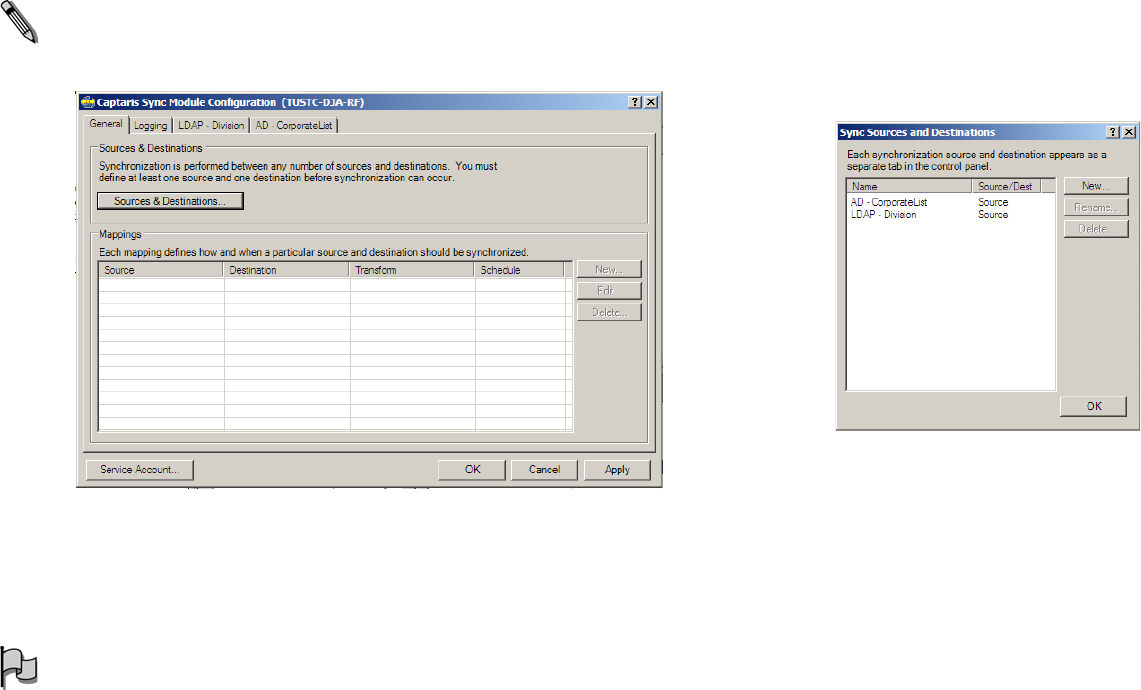
OpenText RightFax 10.0 Administrator’s Guide 84
Defining a Data Source
Open the Windows Control Panel and double-click Captaris Sync
Module. The Captaris Sync Module Configuration opens.
Note The Captaris Sync Module cannot be configured from a remote
computer.
Figure 7.1 Captaris Sync Module Configuration Dialog Box
Service Account The Service Account button is used to select
a Windows account from which to run the Captaris Sync module. If
synchronizing with Active Directory, this account must be a
member of the Active Directory Domain Users group.
Important The service account password is only retained until the
control panel closes. It is not cached.
Adding or Editing a Data Source
Each source and destination you define is represented by a tab on
the Configuration dialog box. There is no limit to the number of
sources and destinations you can define. For each source you want
to define, follow these steps:
1. Click Sources & Destinations. The Sync Sources and
Destinations window opens.
Figure 7.2 The Sync Sources and Destinations Dialog Box
2. Click New to configure a new data source, or highlight a
displayed data source and click Edit to make changes.
3. Using the drop-down arrow, select your source type, either
Active Directory (Source) or LDAP (Source).
4. Enter a unique name for the source. The source name will be
displayed on the tab in the Captaris Sync Module Configuration
dialog box, preceded by a code for the type. Active Directory
sources will get the prefix AD- and LDAP sources will get the
prefix LDAP-. )
5. When finished, click OK. The source name displays as a new
tab.
You must configure each source to specify information about how
the data will be brought into the RightFax database.
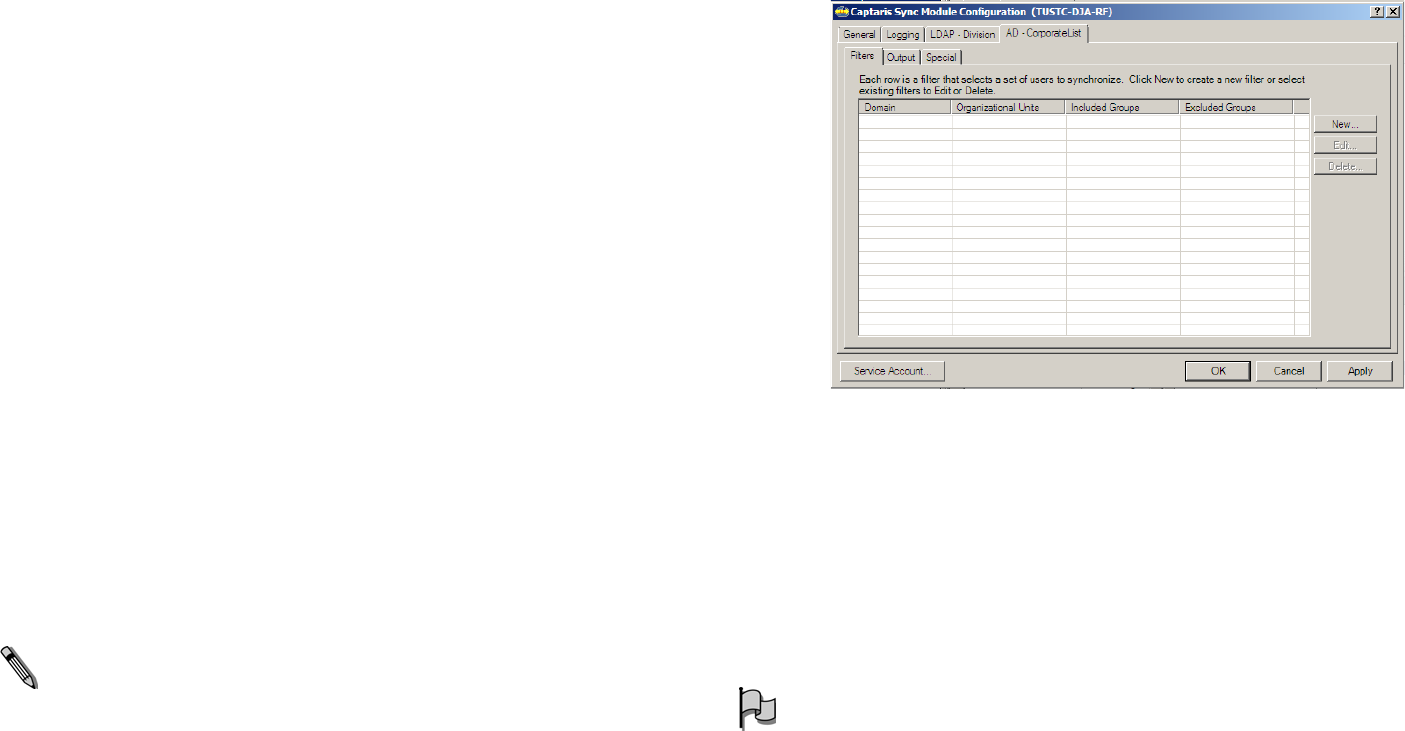
85
Configuring a Data Source
Once you’ve defined a source, you must configure it. To configure a
source, follow these steps:
1. From the Sync Module Configuration window, click the tab for
the source you want to configure. Active Directory sources will
always have the prefix AD- and LDAP sources will always have
the prefix LDAP-.
2. For LDAP sources only, you can choose an existing
configuration. Click the General tab, and then choose a
configuration from the drop-down list. You can also use the
General tab to create a new LDAP configuration file (see
“Creating a New LDAP Schema” on page 87).
3. For Active Directory sources only, you can choose an existing
Active Directory Sync (AD Sync) profile. Click the Special tab
and click Import. When you import a profile, an new property
collection and a new transform will be created.
4. Click the Filter tab to define which data the Sync module will
import to the RightFax database. Filters are a set of parameters
used by the Captaris Sync Module to determine which users
are synchronized into RightFax. For each set of users you must
choose a domain and at least one Organizational Unit (OU) or
group. You may also choose to exclude users that are in certain
groups. If you do not assign a filter, synchronization will not
occur.
Note: If you need to change the filter type for the data source from
OU to group or group to OU, you must first delete the source tab (see
“Deleting a Data Source or Destination” on page 90) and then
recreate it for the new filter type.
Figure 7.3 The Data Source Filter Tab
5. Select New. The Define Filter window opens.
6. In the Define Filter window, browse to your Domain and click
OK.
7. If necessary, browse and select OU’s by checking the box next
to each OU. If necessary, add an include group and an exclude
group.
8. When finished, click OK to close the Filter window and return to
the Data Source display. The Filter you’ve defined appears in
the list.
Important When synchronizing with Active Directory, nested
groups and OU's are NOT automatically included. This allows for finer
control of which groups and OU's are and are not included. Also note
that when browsing for a group that resides in a child domain, you
must change the Windows browser to point to the child domain you
are attempting to browse to. By default, the Windows browser will
select the parent domain for directory searches. Use the Locations
button to browse to and select the correct domain.
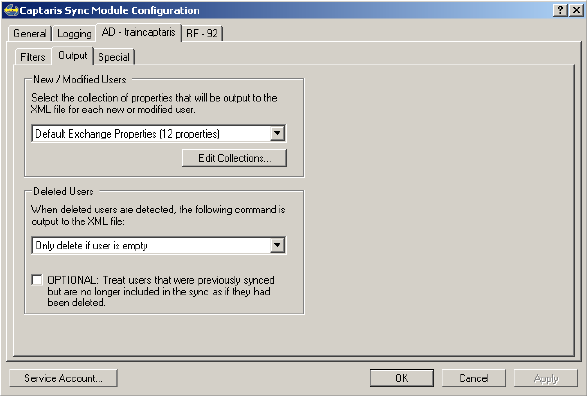
OpenText RightFax 10.0 Administrator’s Guide 86
9. From the Data Source window, click the Output tab to specify
the output data for each new, modified, or deleted user found
during a synchronization event. This data is transformed into a
format suitable for the RightFax database.
Figure 7.4 The Output Tab
10.For New/Modified Users, you can select any number of Active
Directory text-based properties that will be used to update the
RightFax database. Two predefined property collections are
available - Default Windows Properties and Default
Exchange Properties. These contain typical properties for use
with Windows and Exchange users, respectively, and cannot be
edited. To make new Property Collections or to edit existing
ones, click Edit Collections to display the list of Property
Collections.
To make an editable copy of an existing collection, click Copy
and then enter a unique name in the Name field of the
Property Collection dialog box.
To edit a property collection, highlight a collection in the list
and click Edit to display the Property Collection dialog box.
To create a new property collection, click New, enter a
unique name in the Name field of the Property Collection
dialog box.
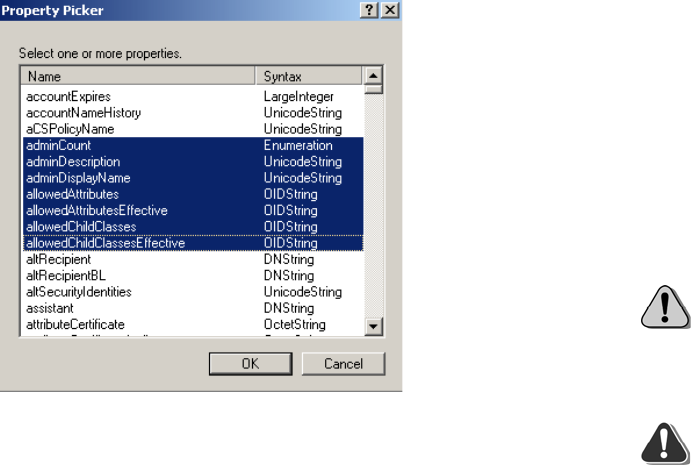
87
Figure 7.5 The Property Collection Dialog Box
From a displayed Property Collection dialog box, you can
remove properties from the displayed collection by clicking
Delete.
From a displayed Property Collection dialog box, you can add
a property to the displayed collection by clicking Add to
display the Property Picker. Highlight the properties you
want to update each time the Sync program runs, You can
use the Ctrl key to select multiple properties. Click OK to
close the Property Picker.
Click OK to close the Property Collection dialog box. Click OK
to close the list of Property Collections and return to the
OutputTab.
11.The Deleted Users section on the Output Tab allows you to
control how RightFax will treat users deleted from Active
Directory. By default, the user is only deleted if it is empty (i.e.,
without documents or phonebook entries). The other options
are Always delete users or Never delete users.
If a user that was created on the Fax Server through an Active
Directory synchnronization does not appear in Active Directory
subsequently, you can treat it as a deleted user by selecting the
OPTIONAL: Treat users that were previously synced but are
no longer included in the sync as if they had been deleted
check box. This option applies only to the current source.
Caution In syncs with multiple sources, users created by a
preceding source will be detected as “no longer included” in the
current source within the same sync. If the check box is selected, the
specified deletion action will be performed. This is also true when
using filters to sync subsets of previously-synced users.
Warning Avoid combining OPTIONAL: Treat users that were
previously synced but are no longer included in the sync as if they had
been deleted with “Always delete user” because this can result in a
large-scale deletion of users and their faxes.
12.When you’ve completed all the configuration for the specified
source, click Apply to save the changes and close the
configuration window.
Creating a New LDAP Schema
1. Under the General tab, click the ellipsis button next to the
pick-list. The LDAP Configuration window opens.
2. In the LDAP Configuration window, choose New. The Select
Default Configuration window opens.
3. Select one of the bundled configuration options (Default LDAP
or Default Notes LDAP) and click OK.
4. Under the General tab, enter a unique name for your LDAP
configuration.
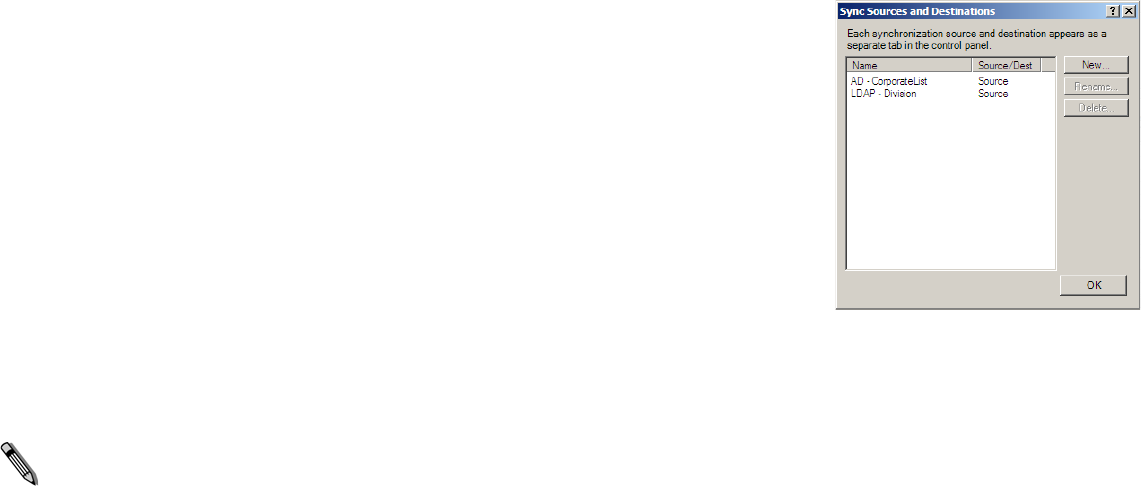
OpenText RightFax 10.0 Administrator’s Guide 88
5. Click the Connection tab. In the Server section, enter a host
and base DN (i.e., name/organization) followed by a port
number used by your LDAP server. In the security section, enter
the authentication method employed by your LDAP server. Click
Validate to confirm your information. If correct, you will receive
the message Validation Successful. When finished, click OK.
6. Click the Schema tab. Here you may change the default and
standard LDAP values.
7. Use Deleted Objects tab to configure deleted object tracking
(users, groups, and OU’s). Specify a deleted objects storage
container, and if necessary, create search a filter to provide
results associated only with deleted objects. This feature can
only be used in LDAP environments that support object
tracking.
Defining a Destination Database
Open the Windows Control Panel and double-click Captaris Sync
Module. The Captaris Sync Module Configuration opens.
Note The Captaris Sync Module cannot be configured from a remote
computer.
1. Click Sources & Destinations. The Sync Sources and
Destinations window opens.
Figure 7.6 The Sync Sources and Destinations Dialog Box
2. Click New to configure a new destination database, or highlight
a displayed destination database and click Edit if you need to
make changes.
3. Using the drop-down arrow, select Captaris RightFax
(Destination).
4. Enter a unique name for the destination database. The name will
be displayed on the tab in the Captaris Sync Module
Configuration dialog box, preceded by the destination prefix
RF-.
5. When finished, click OK. The destination database name
displays as a new tab.
You must configure each destination to specify information about
how the data will be brought into the RightFax database.

89
Configuring a Destination Database
Once you’ve defined a destination database, you must configure it.
Tollow these steps:
1. From the Sync Module Configuration window, click the tab for
the destination you want to configure.
2. Click the Server tab, and then enter the RightFax server name
in the Server Name field.
3. Click the RightFax Account button to select a RightFax
account with Administrative Access. This account is used by
Sync Module to create and delete users on the RightFax server.
This account should be dedicated solely to the Sync module.
Important The RightFax account password is saved as an encrypted
registry item on the RightFax server. To avoid this, use NT authentication.
4. Click the Users Tab to enter a RightFax user account to use as
a template or model for creation of new (i.e., synchronized)
users. New users will inherit all settings associated with the
specified user. You can set up multiple RightFax/Destination
profiles, each with a different model user. This allows for all
manner of customization, such as having different users
synchronized into different RightFax groups, or with different
RightFax permissions.
Figure 7.7 The User Tab Configuration Dialog Box
5. Click Attempt to map onto existing RightFax users if you
want the Sync module to check for potential user matches
before creating new users.
Creating Mappings
After you complete the source and destination configuration, you
must specify which sources will be used to update each
destination database. Mappings define how and when sources and
destinations are synchronized. You can define as many mappings
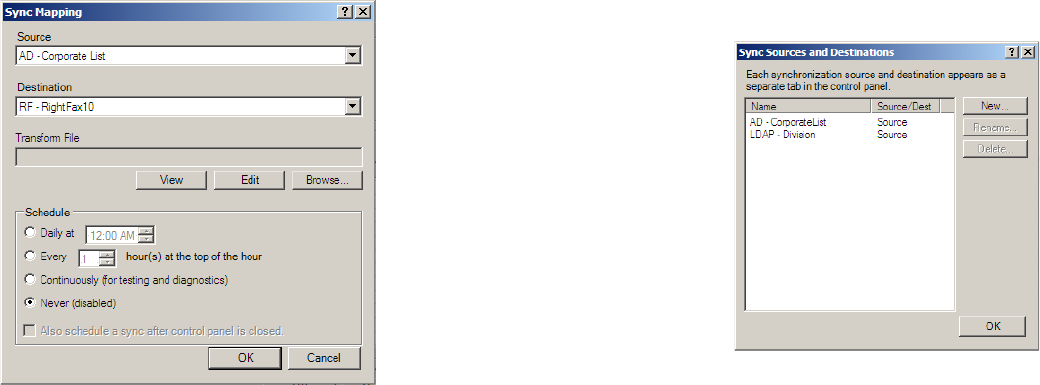
OpenText RightFax 10.0 Administrator’s Guide 90
as you need and previously defined sources and destinations can
be used in more than one mapping. This allows, for example, a
single Active Directory source to be synchronized into two different
RightFax servers, or two different sources to be synchronized to a
single RightFax server.
To Create a New Mapping
1. Under the General tab, click New. The Sync Mapping window
opens.
Figure 7.8 The Sync Mapping Window
2. Using the drop-down arrows, choose your Source and
Destination.
3. In the Sync Mapping window, browse to the \RightFax\Shared
Files\Sync\Config folder and select the Transform File
relevant to your environment. The Transform File is responsible
for transforming data generated by the source into an XML file
translated by the destination. This file together with the RightFax
User Template can be edited to create a custom
synchronization template.
4. Select a synchronization schedule.
5. When finished, click OK.
Deleting a Data Source or Destination
Each source and destination you define is represented by a tab on
the Configuration dialog box. If you need to remove a source or
destination tab, follow these steps:
1. Click Sources & Destinations. The Sync Sources and
Destinations window opens.
Figure 7.9 The Sync Sources and Destinations Dialog Box
2. Highlight a displayed data source and click Delete.
3. When finished, click OK. The source or destination is removed
from the dialog box.

91
Verifying User Synchronization
Users created via the Sync Module are denoted in Enterprise Fax
Manager by a green dot next to their user icon. Users who do not
display this marker have not been updated or created via the Sync
Module.
Figure 7.10 Users created via the Captaris Sync Module as displayed in
Enterprise Fax Manager
Troubleshooting
The Captaris Sync Module provides administrators with convenient
and customizable real-time logging and troubleshooting tools.
Logging The Logging tab provides RightFax administrators with
control over the types of messages logged by the Sync Module.
Each of these messages can be customized using categories and
logging levels. By default, all output is written to the Windows
Event Logs, except when the service is running in diagnostics
(debug) mode, in which case all messages are shown in real-time
via the diagnostics window.
Figure 7.11 The Logging Tab Configuration Dialog Box
Diagnostics
Like all RightFax services, the sync Module can be run in 'debug'
mode. Debug mode provides RightFax administrators with robust
real-time monitoring, logging, and troubleshooting via a separate
diagnostics window. From this window it is possible to customize
the trace (logging) level, group by processes, and save the output
to an RTF or TXT file. Errors and warnings are also displayed in
different colors, making it easier to isolate problems. The
diagnostics window also allows the service to be started, stopped,
paused and resumed.
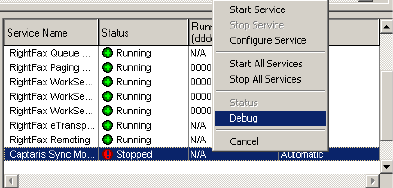
OpenText RightFax 10.0 Administrator’s Guide 92
To run the Sync Module in debug mode
1. Open Enterprise Fax Manager, click your fax server name, and
browse to the services view in the lower-right corner.
2. Right-click the Captaris Sync Module and choose Stop.
3. When the service has stopped, right-click the service and select
Debug. The Diagnostics window opens.
Figure 7.12 The Debug option, available when right-clicking the Captaris
Sync Module from Enterprise Fax Manager
Changes made to the Sync Module while running in debug mode
are not reflected in the diagnostics window until re-launched. Also
note that when running the Sync Module in debug mode, it is
possible to restart the service by clicking OK in the Sync Module
configuration. Setting the service that runs the Sync Module
(CapaSync.exe) to manual startup will prevent this problem,
however, this is only recommended when performing complex
debug associated troubleshooting.
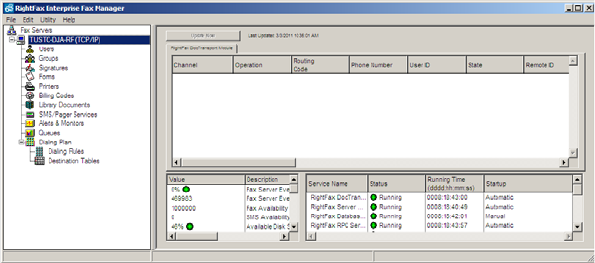
93
Chapter 8
Managing Fax Servers with Enterprise Fax Manager
You can use the Enterprise Fax Manager application to administer
multiple RightFax servers. With Enterprise Fax Manager, you can
manage users, groups, signatures, forms, printers, billing codes,
library documents, and more, for all RightFax servers from one
application.
Enterprise Fax Manager (EFM) is a client application that can be
run on any Windows XP Professional, Windows Vista, or Windows
7 computer. It is installed as an optional component during the
client installation (described in the RightFax Installation Guide.)
Starting Enterprise Fax Manager
After it has been installed, you can start EFM from the Start >
Programs menu, or click Enterprise Fax Manager in the RightFax
tray icon shortcut menu.
When you start EFM for the first time, it will attempt to log on under
your network user ID. If you did not log on to the network as
“Administrator,” the Login dialog box opens. Enter a user ID and
password with RightFax administrative access.
Quitting Enterprise Fax Manager
To quit EFM, on the File menu, click Exit. When you quit the
program, all of your changes and additions are saved.
The Enterprise Fax Manager window
When you start EFM, the Enterprise Fax Manager window opens.
The left pane of the window, called the Fax Server Tree, contains
the open RightFax servers and their administrative components
(users, forms, printers, etc.). The right pane displays details of the
selected component. Items listed on the right, such as individual
users or library documents, are referred to as “objects.” Objects
can be added, deleted, and modified according your needs. If you
don’t have a mouse, press F6 to switch the cursor between the left
and right panes.
Figure 8.1 The Enterprise Fax Manager window
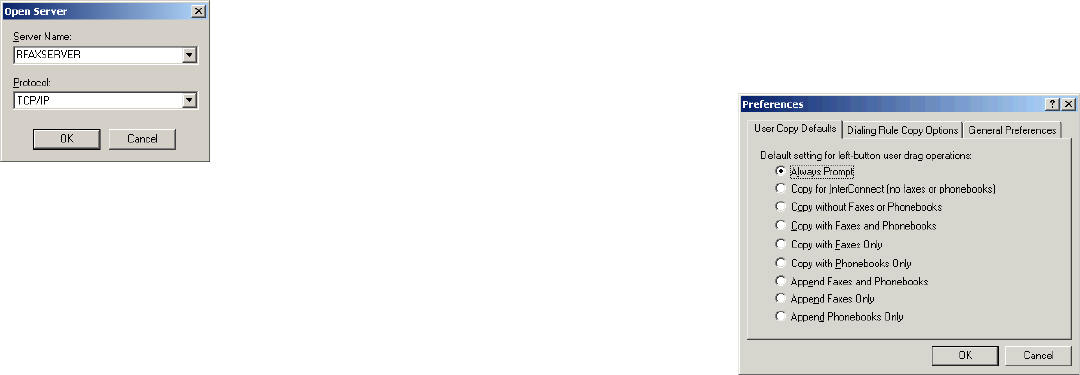
OpenText RightFax 10.0 Administrator’s Guide 94
Opening RightFax servers
To display a fax server in the Fax Server Tree, press CTRL+O, or in
the File menu, click Open Server. The Open Server dialog box
appears.
Figure 8.2 The Open Server Dialog Box
In the Server Name box, type the name of the RightFax server to
open. In the Protocol box, enter the network protocol used by that
server.
After one or more RightFax servers have been opened in EFM, the
servers will, by default, open each time you run the program. This
default setting can be changed in Preferences, described later in
this chapter.
To close a RightFax server, click the server name and on the File
menu, click Close Server.
Refreshing data in the window
Users can create new library documents, forms, and signatures in
their FaxUtil mailboxes while EFM is open. These new files will not
appear in EFM until the view is refreshed. To refresh all objects,
including objects added or modified since the last check, press F5
or on the Edit menu, click Refresh.
Setting Preferences
EFM has several customizable preferences. To view your
preferences, on the Edit menu, click Preferences. The
Preferences dialog box opens. The rest of this section describes
the options in this dialog box.
The User Copy Defaults tab
Figure 8.3 User Copy Defaults
You can copy one or more users from one RightFax server to
another by dragging and dropping selected users to another server
in the Fax Server Tree. The options on the User Copy Defaults tab
set the behavior of EFM when copying RightFax users from one
server to another.
Always Prompt Display this list of options each time users are
copied from one server to another. You must select a copy option
before the users will be copied.
Copy for InterConnect (no faxes or phonebooks) Copies
all user information, excluding faxes and phonebook entries, and
then sets the user’s Routing Type to InterConnect, pointing back
to the server that the user was copied from.
Copy without Faxes or Phonebooks Copies all user
information excluding faxes and phonebook entries.
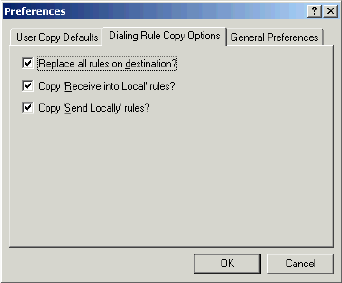
95
Copy with Faxes and Phonebooks Copies all user
information including faxes and phonebook entries. Duplicate users
will receive all faxes in the source account, even if the same faxes
already exist on the destination server, creating multiple copies of
the same fax.
Copy with Faxes Only Copies all user information including
faxes but not phonebook entries. Duplicate users will receive all
faxes in the source account, even if the same faxes already exist on
the destination server, creating multiple copies of the same fax.
Copy with Phonebooks Only Copies all user information
including phonebook entries but not faxes.
Append Faxes and Phonebooks Copies only information for
duplicate user accounts. All faxes and phonebook entries from the
source user account will be added to the destination user account.
No other user information will be changed. Users on the destination
server will receive all faxes in the source account, even if the same
faxes already exist on the destination server, creating multiple
copies of the same fax.
Append Faxes Only Copies only information for duplicate user
accounts. All faxes from the source user account will be added to
the destination user account. No other user information will be
changed. Users on the destination server will receive all faxes in the
source account, even if the same faxes already exist on the
destination server, creating multiple copies of the same fax.
Append Phonebooks Only Copies only information for
duplicate user accounts. All phonebook entries from the source
user account will be added to the destination user account. No
other user information will be changed.
The Dialing Rule Copy Options tab
Figure 8.4 Dialing Rule Copy Options
You can copy one or more dialing rules from one RightFax server to
another by dragging and dropping rules to another server in the list.
The options on the Dialing Rule Copy Options tab set the behavior
of EFM when copying RightFax dialing rules from one server to
another.
Replace all rules on destination Copies all dialing rules
from the source server to the destination server, deleting any
existing dialing rules.
Copy ‘Receive into Local’ rules Includes all dialing rules with
the “Receive into local server” action when copying. If this check
box is not selected, “Receive into local” rules will be ignored during
the copy.
Copy ‘Send Locally’ rules Includes all dialing rules with the
“Send locally” action when copying. If this check box is not
selected, “Send locally” rules will be ignored during the copy.
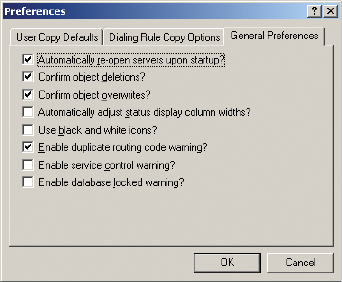
OpenText RightFax 10.0 Administrator’s Guide 96
The General Preferences tab
Figure 8.5 General Preferences
The options on the General Preferences tab set some general
preferences for views and actions in Enterprise Fax Manager.
Automatically re-open servers upon startup Recalls
which servers were open when the program was last quit and
opens those servers again on startup. If this check box is not
selected, you must reopen each RightFax server upon starting
EFM.
Confirm object deletions Displays a confirmation dialog box
each time you delete an object, such as a user or library document.
If this check box is not selected, there will not be any confirmation
prior to deleting objects. This is convenient if you are deleting many
objects but makes it more likely that you will accidentally delete an
object that you want to keep.
Confirm object overwrites Displays a confirmation dialog box
each time you overwrite an object, such as by copying an object
with the same name into the system. If this check box is not
selected, there will not be any confirmation prior to overwriting
objects.
Automatically adjust status display column width
Adjusts the widths of the columns in the Server Status and
Services pane (see “Monitoring the Status of RightFax Servers and
Services” on page 98)to fit the column’s contents. This option will
not affect the column widths in any other EFM view. When this
check box is selected, you can still manually adjust the column
widths in the Server Status and Services pane, but they will resize
each time the screen image is refreshed.
Use black and white icons Select this option if your monitor
is set to high contrast black and white. This changes the EFM
server status icons to colors that are can be read in this color
mode.
Enable duplicate routing code warning Displays a warning
message when a user is created that has a routing code that is the
same as another existing user.
Enable service control warning Displays a warning
message when you make any changes to the state of any of the
RightFax services.
Enable database locked warning Displays a warning
message when you attempt to access the database when it has
been locked by certain database management tools.
Viewing RightFax Server Information
To view the status of all open RightFax servers, click Fax Servers
at the top of the Fax Server Tree. A list of all open servers and the
status of each server appears in the right pane of the window. This
section describes each column in the right pane.
Server name
The Server Name column displays the name of each open RightFax
server and network protocol. An icon to the left of the name
indicates the status of the RightFax service. A green ‘+’ indicates
that all services are running normally. A yellow ‘!’ indicates that one
97
or more services are not running but that normal fax operations are
available. A red ‘–’ indicates that one or more services are not
running and normal fax operations are not available.
Version
The Version column displays the RightFax server software version.
Serial number
The Serial Number column displays the serial number that was
entered when the RightFax server was installed. You must provide
this number when you contact Open Text Customer Support.
Time running
The Time Running column displays the length of time that has
elapsed since the RightFax Server service was last started. Display
is in the format DDDD:HH:MM:SS.
Queue usage
The Queue Usage column displays the percentage of the fax
server’s internal Event Queue that is currently in use. For more
information on the RightFax Event Queue, see “Understanding the
Fax Server Internal Event Queue” on page 35.
Fax board availability index
The Fax Board Availability Index column displays a number that
indicates the relative availability of the server’s fax boards. The
higher the number, the more available the server for sending faxes.
RightFax uses this value when an outgoing fax number has two
equally weighted dialing rules that send it to two different servers.
In such a case, RightFax sends the fax via the server with the
highest availability index.
Character set mode
This column displays the OEM or ANSI code page being used by
the server. The code page determines the language character sets
that are supported for fax conversion.
Working with Objects
Sorting objects
To sort the objects listed in Enterprise Fax Manager by column,
double-click the column heading. The objects will sort in ascending
order and an indicator will appear in the column heading. You can
also click a column heading to alternately sort in ascending and
descending order. Enterprise Fax Manager recalls how objects are
sorted when you quit and restart the program.
Sorting columns
To move a column left or right, click the column heading and drag it
left or right to its new position.
Selecting objects
To edit, delete, or otherwise work with an existing object, you must
first select it in the list of objects displayed. Selected objects are
highlighted.
To select an object, click it or use the UP ARROW and DOWN
ARROW keys to move to the object and press the SPACEBAR to
highlight it. To un-select an object, click it or press the SPACEBAR
again. To select multiple objects, drag the mouse pointer down the
objects while holding the left mouse button. If the desired objects
are not all in a continuous group, click each object while holding
down CTRL.
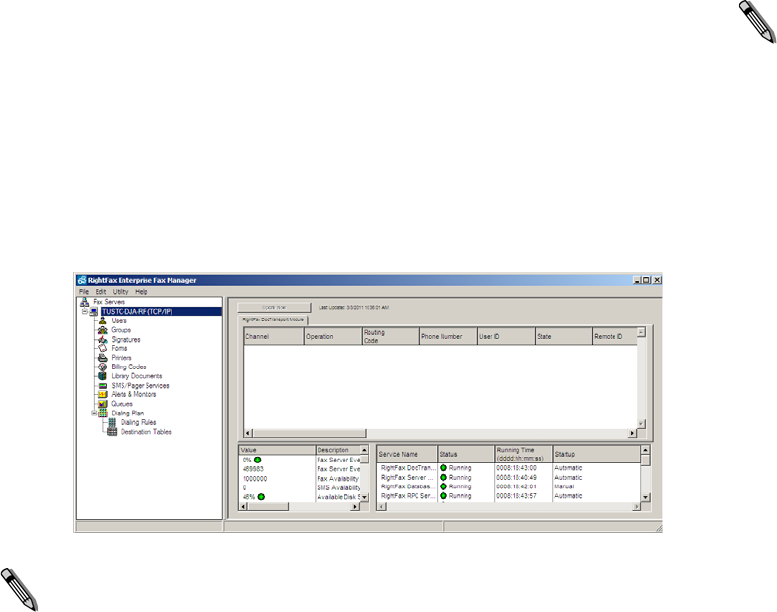
OpenText RightFax 10.0 Administrator’s Guide 98
Before adding objects
Before you begin adding objects to the RightFax system, it is
important that you plan the structure and anticipate the needs of
your network users. Consider whether you will divide your
organization into groups, whether you would like each group or
department to have its own cover sheet, and who will act as
administrator or alternate administrator for the group. Determine a
block of routing codes sufficient for the entire system and decide
upon any custom notification types desired. You should create new
objects in RightFax only after you have carefully considered these
issues.
Monitoring the Status of RightFax Servers and
Services
EFM displays statistics and fax channel information and manages
services on each RightFax server. To view and manage the status
and services of each RightFax server, click the name of the server
in the Fax Server Tree in the left pane.
Figure 8.6 Server Status and Statistics
Note If you are running remote DocTransports, they can be displayed in
Enterprise Fax Manager but will not include fax server data.
If you’re viewing the EFM from the server, the top line of this
window displays the most recent update time for the data display. If
you’ve logged on to EFM as administrator from a client machine,
you’ll need to click Update Now to recompile and update the
server statistics. The Update Now button only active from the
client software.
Understanding the server statistics
Statistics about the server are displayed in the lower-left corner in
the right pane of the window.
Note: The former alert for SQL server free space has been removed
from RightFax. Use the Microsoft SQL tools to monitor the health and
performance of the SQL Server for your RightFax Server. See your SQL
documentation or the Microsoft site at
http://technet.microsoft.com/en-us/sqlserver/default.
Fax Server Event Queue Usage The percentage of the fax
server’s internal Event Queue currently in use. For more information
on the RightFax Event Queue see “Understanding the Fax Server
Internal Event Queue” on page 35.
Fax Server Events Processed The total number of events
processed by the fax server since the Server module was started.
BoardServer Availability Index The relative availability of the
fax boards on the server. The higher the number, the more available
the server for sending faxes. RightFax uses this value when an
outgoing fax number has two equally weighted dialing rules that
send it to two different servers. In such a case, RightFax sends the
fax via the server with the highest Availability Index.
Current Faxes Queued for Sending The current number of
outgoing faxes waiting to be sent.
Current Pages Queued for Sending The current number of
outgoing fax pages waiting to be sent.
Available Disk Space for Fax Images The percentage of
disk space on your RightFax server available for storing fax images.

99
All-Time Send Attempts The total number of faxes sent from
this server since the All-Time Counter Starting Date (described
later).
All-Time Pages Sent The total number of fax pages sent from
this server since the All-Time Counter Starting Date (described
later).
All-Time Faxes Received The total number of faxes received
on this server since the All-Time Counter Starting Date
(described later).
All-Time Pages Received The total number of fax pages
received on this server since the All-Time Counter Starting Date
(described later).
All-Time Counter Starting Date The starting date from which
the “All-Time” statistics (described earlier) are calculated.
Tip All of the All-Time statistics will report an error message if you are
running fax boards in simulation mode.
Monitoring fax channel information
Information about the fax channels on the server is displayed in the
upper-right corner in the right pane of the window
Channel Each fax channel that is available on this RightFax
server.
Operation The current operational status of each channel.
Routing Code The inbound routing code of this fax channel for
incoming faxes.
User ID The destination user ID of this fax channel for incoming
faxes.
Monitoring services
The lower-right pane of the window lists each RightFax service, its
status (running or stopped), the length of time it has been running,
and its startup method (manual or automatic). To monitor services
on remote servers, you must have network administrative access to
the server as well as RightFax administrative access.
Starting and stopping services
To start or stop a service, right-click the service to open a shortcut
menu.
Click Start Service to start the selected service.
Click Start all Services to start all services in the appropriate
sequence.
Click Stop Service to stop the selected service.
Click Stop all Services to stop all services.
Configuring services
To configure a service, double-click the service. Or, right-click the
service to open a shortcut menu, and then click Configure
Service.
For information on configuring a RightFax Server, DocTransport,
or WorkServer, refer to the appropriate chapter in this guide.
For information on configuring the AutoReply service, see
Chapter 24, “Responding to Inbound Faxes with AutoReply”.
For information on configuring the RightFax email gateway, see
Chapter 28, “Using RightFax Email Gateways” or refer to the
RightFax Gateway for Microsoft Exchange Guide or RightFax
Gateway for Lotus Notes Guide.
For information on configuring the RightFax Integration Module,
refer to the RightFax Integration Module Guide.
OpenText RightFax 10.0 Administrator’s Guide 100
Monitoring Queues
In addition to monitoring the information in the statistics window,
you can display a list of RightFax Queues that show actions that
are in process at that moment. To display the queues, click on
Queues in the menu tree on the left side of the EFM window.

101
For each queue, the number of items in the queue is shown in both
numeric (in the Value column) and graphic (in the Scale column)
formats. Displayed queues include:
Pending conversion results Number of results from WorkServer
conversions not yet processed by a Server module.
Total server events Total number of events currently scheduled on
a Server module.
Documents in queue on FaxServ(s) Total number of
document-related events currently scheduled on a Server
module.
Documents in queue on DocTransport(s) (on DocTransport, not
yet sent) Number of documents on DocTransport scheduled to
be sent.
Documents sent by DocTransports(s) (send completed but not
yet discovered by a FaxServ) Number of documents sent by
DocTransport, but not yet processed by a Server module.
Total documents All documents in the system.
Deleted documents All documents flagged in the database as
deleted. Associated value fluctuates based on the days to keep
deleted fax records setting of each user group.
Transmission check events Number of "Scheduled to be sent"
and "Sending" documents that are pending Server module
action.
Conversion events Number of events in the queue that are
preparing an outbound fax to be scheduled for transmission.
System messages in the database Messages from a Database
module to a Server module that have deferred fax processing.
Quick kicks from Database module to Server module Messages
kicked by a Database Module and passed to a Server module.
PCL5 conversion requests Number of requests to convert PCL
documents.
Postscript conversion requests Number of requests to convert
Postscript documents.
General purpose conversion requests Number of requests to
convert documents from any format, including compound
requests for multiple types of conversion.
Coversheet creation requests Number of requests to create
coversheets.
Gateway route requests Number of requests from a Server
module to gateways to pick up documents.
Synchronizing the RightFax Server with External
Systems
The RightFax WorkServer modules synchronize with external
systems such as the Kofax NetScan user tables, library document
catalogs, and import files for billing codes on a periodic, scheduled
basis. You can force the server to synchronize immediately without
changing the defined schedule.
On the Utility menu, click Synchronize External Systems.
Running Enterprise Fax Manager Web Edition
EFM Web Edition is a Web-based version of Enterprise Fax
Manager that allows remote management of your RightFax servers
from any Web browser. EFM Web Edition is included with all
RightFax servers but must be installed separately on an IIS server
on your network. For information on installing EFM Web Edition,
refer to the RightFax Installation Guide.
To run Enterprise Fax Manager Web Edition
Note EFM Web Edition was developed and tested for use with
Microsoft Internet Explorer version 6.0. Although it will run in other
browsers, RightFax recommends using Internet Explorer version 6.0 or
later for best results.
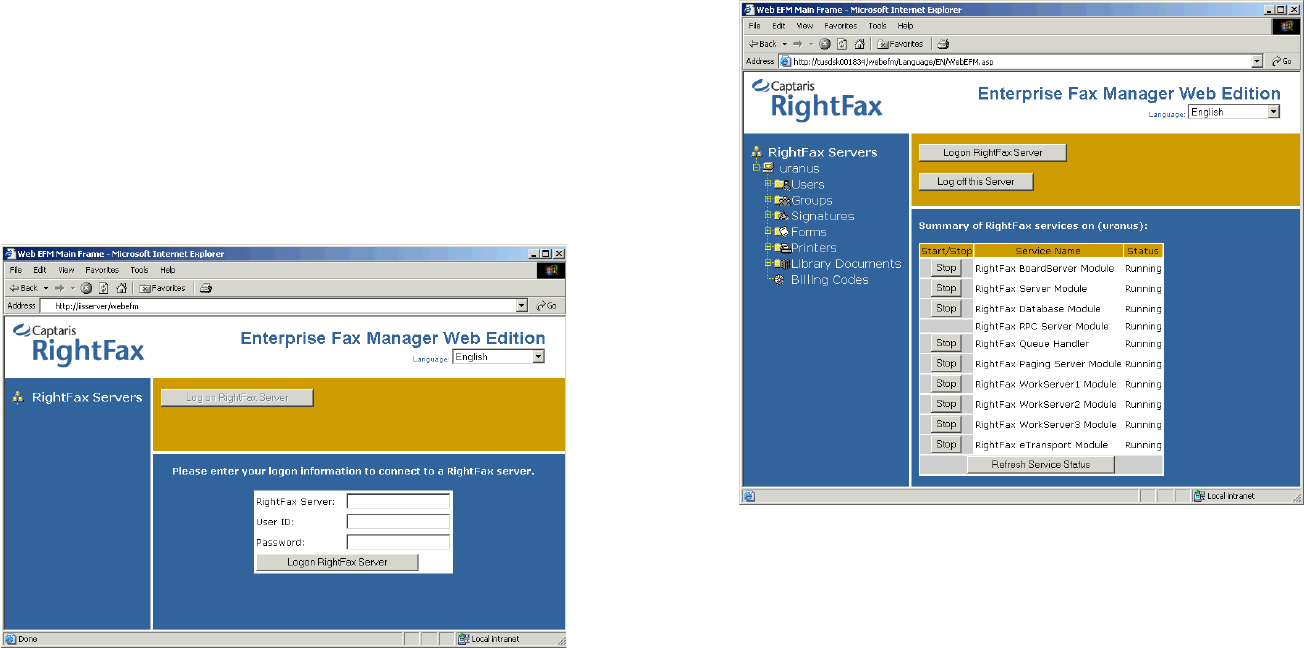
OpenText RightFax 10.0 Administrator’s Guide 102
1. Open a Web browser and point the URL to the /webefm folder
on the IIS server. For example:
http://server.domain.com/webefm
2. Unless your IIS server is configured to allow anonymous
access, a dialog box will appear that prompts you to log on to
the IIS server. Enter your logon information and click OK. The
browser will prompt you for information to open a RightFax
server.
Figure 8.7 Opening a RightFax Server in EFM Web Edition
3. Enter the name of the RightFax server to open and a RightFax
user ID and password that has administrative access to the
RightFax server. Click Logon RightFax Server.
4. The RightFax server you specified opens in the frame in the left
side of the page.
Figure 8.8 Server Options in Enterprise Fax Manager Web Edition
Managing RightFax servers in EFM Web Edition is similar to
managing RightFax servers in EFM for Windows.
Throughout this guide, references to EFM will describe the
Windows version of EFM and not the Web edition. However, in
almost all cases, the instructions will apply to both versions.
Selecting a language
EFM Web Edition is available in several different languages.
To change the language, select the language you want in the
Language menu in the upper-right corner of the page.
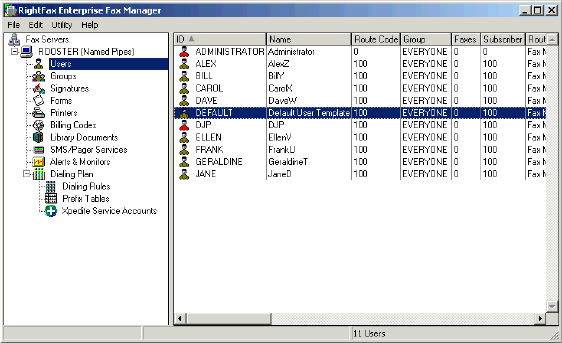
103
Chapter 9
Creating RightFax Users
Each fax user must be assigned a user ID on their local RightFax
server. The RightFax server uses the user ID to assign ownership to
sent faxes and route received faxes to their intended recipients. You
can customize each user’s access to and usage of the system in
the user profile.
Managing RightFax Users
Every RightFax user in your organization has a unique user ID and
profile on a RightFax server. To add, edit, or delete RightFax user
profiles, run EFM (see “Starting Enterprise Fax Manager” on
page 93) and click Users under the RightFax server in the Fax
Server Tree. The list of users appears in the right pane of the
window.
Figure 9.1 The RightFax Users List
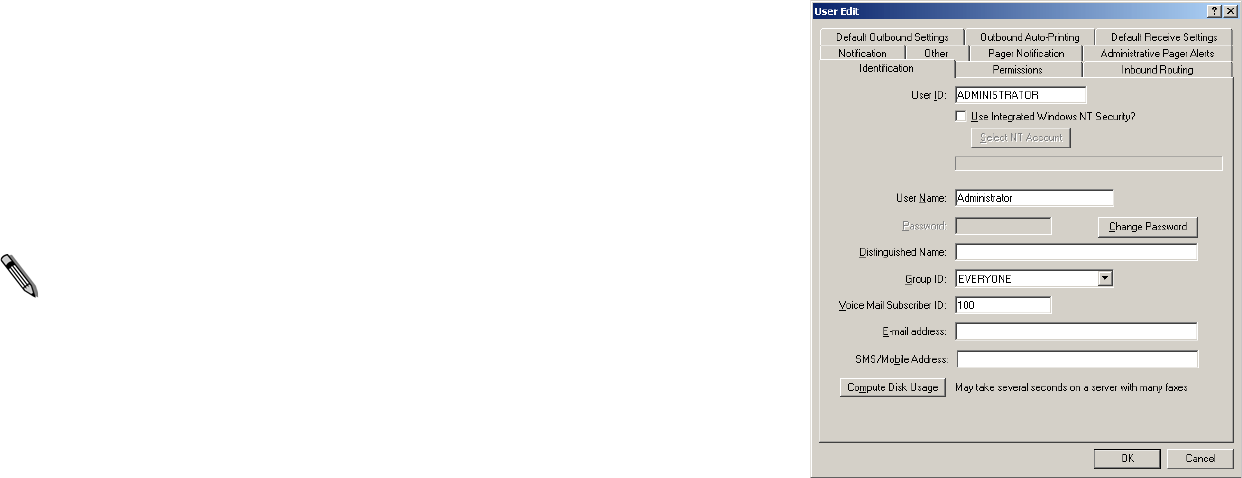
OpenText RightFax 10.0 Administrator’s Guide 104
Each user ID is preceded by an icon.
If the icon is red, the user has administrative access.
If the icon is yellow, the user does not have administrative
access.
A dot indicates that the user is synchronized with another
application, and editing changes should be made in that
application only.
Understanding the default RightFax user
The “Default” user ID is included in the list of users on each
RightFax server. The Default user ID is used as a template for
creating new users. When you are configuring your RightFax users,
edit the Default user to have the same attributes as the majority of
your fax users. Never delete the Default user.
Note If you are using Active Directory synchronization to create new
users (described in Chapter 7, “Enabling and Using the Captaris Sync
Module”), the Active Directory synchronization profile settings will
override settings in the Default user ID.
Adding a user
To add a new RightFax user, press INSERT or in the Edit menu,
click New. The User Edit dialog box opens. To configure the user
profile, see “Creating a User Profile” on page 105.
Figure 9.2 The User Edit dialog box
The new user will have the same attributes as the Default user ID,
except for the User ID, User Name, Password, and
Distinguished Name boxes. Because each RightFax user must
have a unique user ID, you must enter a value in the User ID box to
create the new user. All other boxes are optional. For information on
completing each of the options in each tab see “Editing user
properties” on page 105.
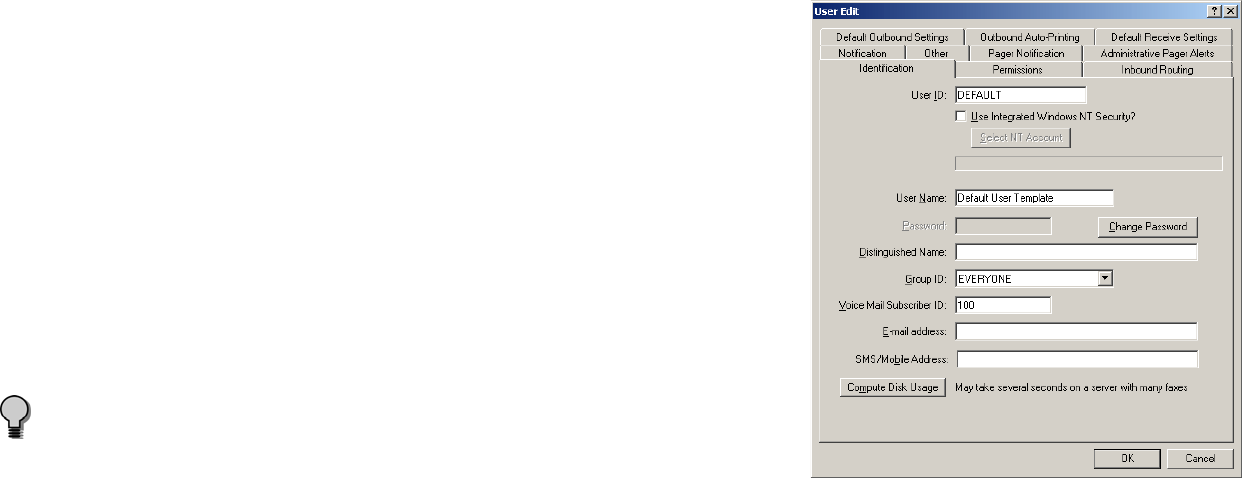
105
Deleting a user
To delete a user, select the user to delete and press DELETE or in
the Edit menu, click Delete. By default, you will be prompted for
confirmation that you want to delete the user.
Copying a user from one server to another
Using Enterprise Fax Manager you can copy one or more users
from one RightFax server to another. Select the users you want to
copy, and then drag the selection to another server. The amount of
information copied is configured in the Enterprise Fax Manager
Preferences dialog box (see “Setting Preferences” on page 94).
If you copy users from a new RightFax server version to an earlier
server version, you will lose configuration data that is not supported
by the older server (for example, features on version 8.7 servers will
not be available on version 8.5 servers).
Editing user properties
To edit the properties of an existing user, run Enterprise Fax
Manager, select the user to edit, and press ENTER or in the Edit
menu, click Edit. You can also double-click the user. The User Edit
dialog box opens.
Tip: To make global changes to selected groups of users, you can use
Moduser.exe. See the Administrative Utilities Guide for more information.
Creating a User Profile
The user’s profile is defined in the User Edit dialog box. This
section describes all the options in this dialog box.
The Identification tab
Figure 9.3 The User Edit Identification Tab
User ID The unique identifier used throughout the RightFax
system to identify a user. In most cases, this ID should be the same
as the user’s network login name. The ID can be 21 characters
long.
Use Integrated Windows NT Security Each RightFax user
ID can be linked to a Windows user account to take advantage of
your network’s established Windows NT based security system
(see “Using Windows NT Security Authentication” on page 116).
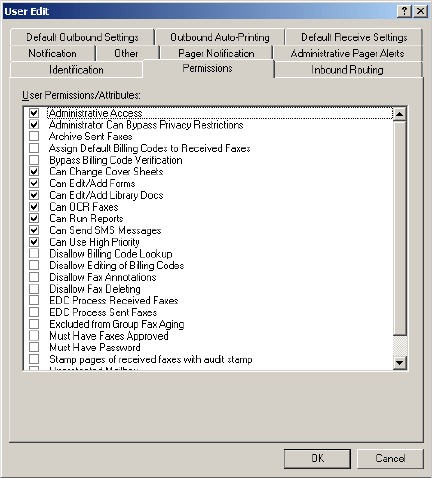
OpenText RightFax 10.0 Administrator’s Guide 106
Click Select NT Account to enter a domain and account name to
link to the user. You can also select from a list of all user accounts
in each domain.
If you want this fax user to link to a Windows NT based user
account, select the Use Integrated Windows NT Security check
box to allow the user account to be accessed only via Windows NT
authentication. If a user’s current Windows NT account is not
linked to any RightFax user IDs, that user cannot manually enter the
user ID and password for anyone with this check box selected
when accessing client applications.
With this option, RightFax will authenticate the user based solely
on his Windows network account name and password, so the
RightFax Password field will be disabled.
User Name This is a descriptive name to help the administrator
identify users. If you will be adding user names with diacritical or
other characters refer to the RightFax Installation Guide for
information about character sets and code pages on your RightFax
server.
Password The password required by each user to access his
personal FaxUtil mailbox and to gain access to the fax server
settings in Enterprise Fax Manager. If you are creating a new user,
you can enter a password.
To change a user’s password, click Change Password and enter a
new password. If you click Change Password and do not enter a
new password, the password will be erased and the user will not
be required to enter a password when accessing RightFax client
applications
Distinguished Name The Microsoft Exchange distinguished
name, used to confirm accurate RightFax and Exchange user
synchronization.
Group ID The name of the RightFax group to which the user
belongs. All users must belong to a group. For information on
creating new groups, see “Adding new groups” on page 120.
Voice Mail Subscriber ID Specify the mailbox number to use
when routing faxes to a telephony server. This box is also used to
assign TeleConnect mailbox numbers to RightFax accounts
(requires the TeleConnect module, purchased separately).
Email address Enter the user’s email address. This is required if
the user will be sending documents to email addresses in addition
to fax addresses via the RightFax client applications.
SMS/Mobile Address Enter the user’s SMS-capable cell
phone number. This is the number to which SMS notifications
about the user’s sent and received faxes will be sent.
Compute Disk Usage Click to calculate the space on the
server that is taken by this user’s faxes.
The Permissions tab
Figure 9.4 The User Edit Permissions Tab

107
Administrative Access Gives users access to the
administrative functions of RightFax. Without this permission, a
user cannot open Enterprise Fax Manager or switch to another
user’s mailbox without the correct password. All administrators can
run Enterprise Fax Manager and can switch to the mailboxes of
users belonging to their administered groups. Administrators with
this permission can not view any faxes other than their own without
also having the Administrator Can Bypass Privacy Restrictions
option also selected.
Administrator Can Bypass Privacy Restrictions Gives
users that have the Administrative Access option selected the
additional ability to view faxes in other users’ mailboxes. Only an
administrator that has this permission enabled can grant this
permission to other users.
Archive Sent Faxes Archives outbound faxes according to the
Archive options defined in the WorkServer configuration program
(see “Archive settings” on page 39).
Assign Default Billing Codes to Received Faxes Assigns
the user’s default billing code settings (see “Default Billing Codes”
on page 111) to all received faxes. This is most useful if you have
set RightFax to require billing codes on received faxes (see
“Requiring billing codes on received faxes” on page 143).
Bypass Billing Code Verification Allows the user to send
faxes without supplying correct billing codes. This attribute will not
exclude the user from having to supply other required fields in order
to send faxes. This attribute is only effective if billing code
verification is required system-wide.
Can Change Cover Sheets Lets the user change cover
sheets. If this check box is not selected, the user will be restricted
to using the cover sheet specified in the Default Outbound
Settings tab (page 110).
Can Edit/Add Forms Lets the user use the Store as Form
feature of FaxUtil to add new overlay forms to the RightFax system.
Can Edit/Add Library Docs Lets the user use the Store in
Library feature of FaxUtil to add new library documents to the
RightFax system.
Can OCR Faxes Allows the user to OCR faxes, either manually
or automatically, as defined in FaxUtil. This attribute does not affect
OCR routing and does not have to be enabled if OCR routing is
being used. You must have licensed the RightFax OCR Conversion
module for any OCR functions to be available.
Can Run Reports Lets the user create reports using the
RightFax Fax Reporter utility. For more information about Fax
Reporter, see the Administrative Utilities Guide.
Can Send SMS Messages Lets the user send documents to
SMS addresses from within the RightFax client applications.
Can Use High Priority Lets the user send faxes using “high”
priority. If disabled, the user is restricted to “normal” and “low”
priorities.
Disallow Billing Code Lookup Prevents the user from
viewing the list of valid billing codes. This requires the user to know
at least one valid billing code.
Note You must check both Disallow Billing Code Lookup and Disallow
Editing of Billing Codes to ensure that users will not be able to modify
their default billing code settings.
Disallow Editing of Billing Codes Prevents the user from
changing the default billing code settings for outgoing faxes. In
addition, any billing codes specified in phonebook entries are
ignored as are any <BILLINFO> embedded codes.
Disallow Fax Annotations Prevents the user from adding
notes to faxes.
Disallow Fax Deleting Prevents the user from deleting faxes.
This setting can be useful for persons doing manual fax routing. The
restriction applies to the user and not the mailbox, so if the user
switches mailboxes, he still cannot delete faxes.
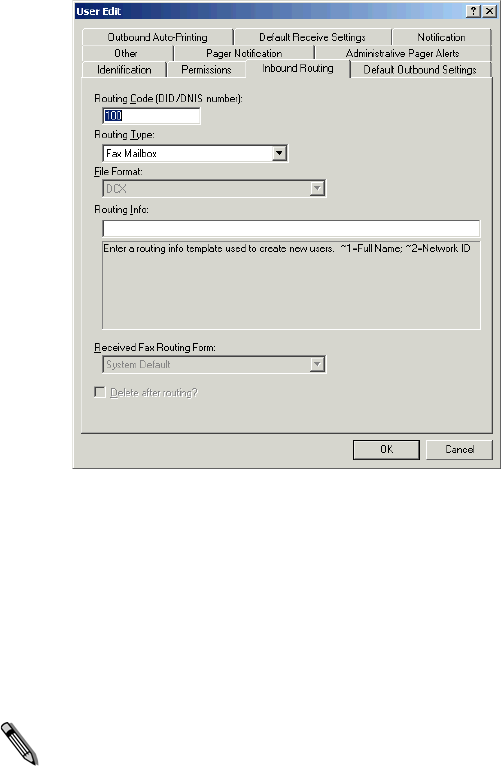
OpenText RightFax 10.0 Administrator’s Guide 108
EDC Process Received Faxes This setting is used with
RightFax connectors that are purchased separately.
EDC Process Sent Faxes This setting is used with RightFax
connectors that are purchased separately.
Excluded from Group Fax Aging Excludes the user from the
automatic fax aging (image deletion) attributes of the group to
which he belongs.
Must Have Faxes Approved Requires every fax sent by the
user to be approved by a full, group, or alternate group
administrator.
Must Have Password Requires the user to have a password.
This does not restrict the user from changing his password.
Stamp Pages of Received Faxes with Audit Stamp
Enabled printing of the RTI line and adds one line of text to the
bottom of each received fax page listing total pages, date and time
received, fax server used, inbound routing code used, CSID of
sender, and transmission duration.
Unprotected Mailbox Allows all other RightFax users to view,
manipulate and delete documents in this user’s mailbox. This does
not affect the security of phonebook entries belonging to the user.
View First Page Only Restricts the user from viewing or
printing anything but the first page of a received fax. This is useful
when manual routing is employed. The restriction applies to the
mailbox regardless of the permissions of the user viewing the
mailbox. Faxes must be routed out of the restricted mailbox before
subsequent pages can be viewed or printed.
The Inbound Routing tab
Figure 9.5 The User Edit Inbound Routing Tab
Routing Code (DID/DNIS Number) The routing code is a
unique number that RightFax uses to route received faxes to the
correct user. Enter the DTMF extension, DID phone number, or
channel number you have assigned to this user. When a fax is
received by the server, any routing information included is
compared to each user’s Routing Code. If a match is made, the fax
is routed to the user’s mailbox. For more information on routing
faxes, see Chapter 22, “Routing Inbound Faxes”.
Note You must ensure that no routing code is used more than once. If
you do use the same routing code more than once, only one of the
persons to whom it is assigned will receive incoming faxes.
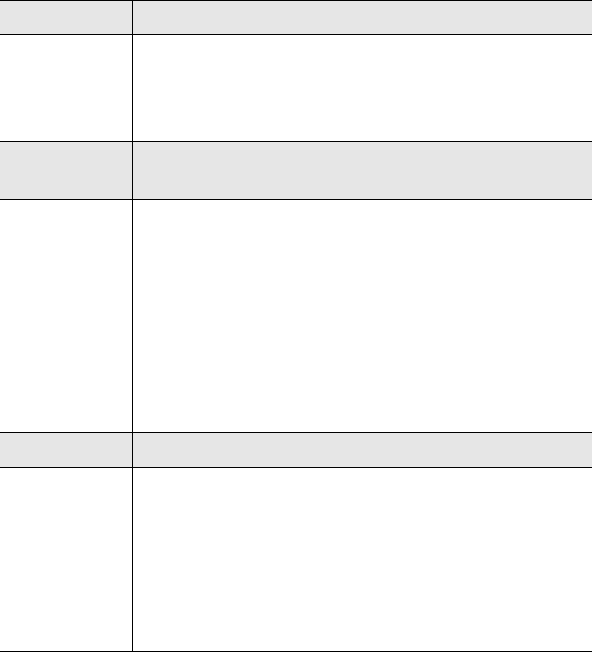
109
Routing Type Specify where incoming faxes will be routed after
they arrive in the user’s fax mailbox. For more information on each of
the routing types, see Chapter 22, “Routing Inbound Faxes”.
File Format Choose the file format in which faxes will be
delivered when routed.
Routing Info Specify how to route the fax to the correct
destination for the Routing Type specified. If you route faxes to an
email mailbox, you must enter the email address here. For
information on the required Routing Info for each Routing Type
see Chapter 22, “Routing Inbound Faxes”.
Received Fax Routing Form Specify the Outlook form you
want to route incoming faxes to. Click “Default” to use the form set
in the Email Gateway configuration program (described in the
RightFax Gateway for Microsoft Exchange Guide). This list is only
available if you have selected “Exchange Mailbox” as your Routing
Type.
Delete After Routing Deletes received faxes from the user’s
FaxUtil mailbox after the fax has been successfully routed to the
application specified in the Routing Type list.
If this check box is selected, notification of received faxes
(page 116) will not work.
Table 9a File Formats for Routed Faxes
Format Description
DCX DCX combines multiple PCX pages into a single file.
It solves the multiple attachment problem of PCX
files but maintains the large file size (average of 135
Kb per page).
GIF GIF is graphics interchange format. This format is
available for routing in Microsoft Exchange.
PCX PCX produces a single page per file with an average
fax page size of 135 Kb. It is useful for routing
received faxes to DOS and Macintosh users
because DOS and Macintosh have built-in
capabilities to view PCX-formatted fax pages.
This format is not recommended for Windows client
applications, because PCX is a large format and
users have to sift through multiple attachments when
viewing multiple page faxes.
PDF PDF is portable document format.
TIFF-G3/
TIFF-G4
TIFF-G3 is a structured file type that is best for
monochromatic images like fax pages (average of 35
Kb per page). Most email systems have the ability to
read TIFF-G3 files, and you can associate the
RightFax Fax Viewer with TIFF-G3 files to view these
faxes in any application.
TIFF-G4 is a more compressed file format.
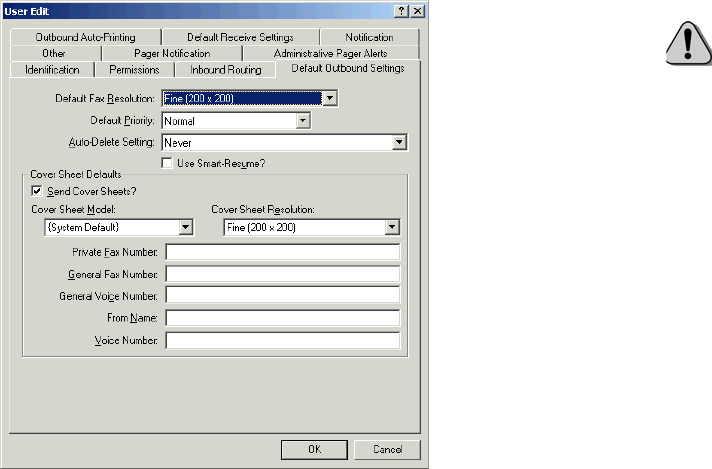
OpenText RightFax 10.0 Administrator’s Guide 110
The Default Outbound Settings tab
Figure 9.6 The User Edit Default Outbound Settings Tab
Default Fax Resolution Specify the resolution of the users
outbound faxes. Normal resolution (200×100 DPI) creates draft
quality images and allows shorter transmission times. Fine
resolution (200×200 DPI) is recommended for high quality printed
documents and Optical Character Recognition (OCR). This setting
affects the body of a fax, but not the cover sheet.
Default Priority Sets the priority at which all the user’s faxes are
responded to by the fax server unless specified otherwise in the
Fax Information dialog box when the fax is created.
Auto-Delete Setting For most users, select Never. If this
account is used to send large broadcast faxes, you can select Only
If Successfully Sent or All Faxes to prevent large numbers of
faxes from accumulating in the user’s fax box and to save disk
space. Fax image files, not original documents created in other
applications, will be deleted.
Caution Auto-deleting sent faxes prevents users from reviewing or
forwarding their sent faxes, and notifications of sent faxes (page 116) will
not work.
If the user has the Archive Sent Faxes permission selected
(page 107), or if they have enabled autoprinting of sent faxes in the
FaxUtil client application, sent faxes will not be automatically
deleted, even if this option is enabled.
Use Smart-Resume Allows the fax server to intelligently resend
only the portion of a fax which failed to send. For example, if the
connection is broken after 40 pages of a 50 page fax, normally all
50 pages have to be resent. By enabling Smart-Resume, the server
will only resend the last 10 pages.
This option can also be set by fax users on a per-fax basis from the
Fax Information dialog box (see “Specifying Addressing
Information” on page 235).
Send Cover Sheets Allows the user to send cover sheets with
faxes.
Cover Sheet Model Specify the default fax cover sheet file to
use. The list displays the fax cover sheet files in the RightFax\FCS
folder. Select Default to use the fax cover sheet specified for the
user’s group.
Cover Sheet Resolution Specify the resolution of the user’s
cover sheets. Normal resolution (200×100 DPI) creates draft
quality cover sheets and allows shorter transmission times. Fine
resolution (200×200 DPI) is recommended for high quality cover
sheets and Optical Character Recognition (OCR). This setting
affects the cover sheet only.
Sender Information Fields Specify the user’s name, fax
number, and phone number information as it will appear on fax
cover sheets.
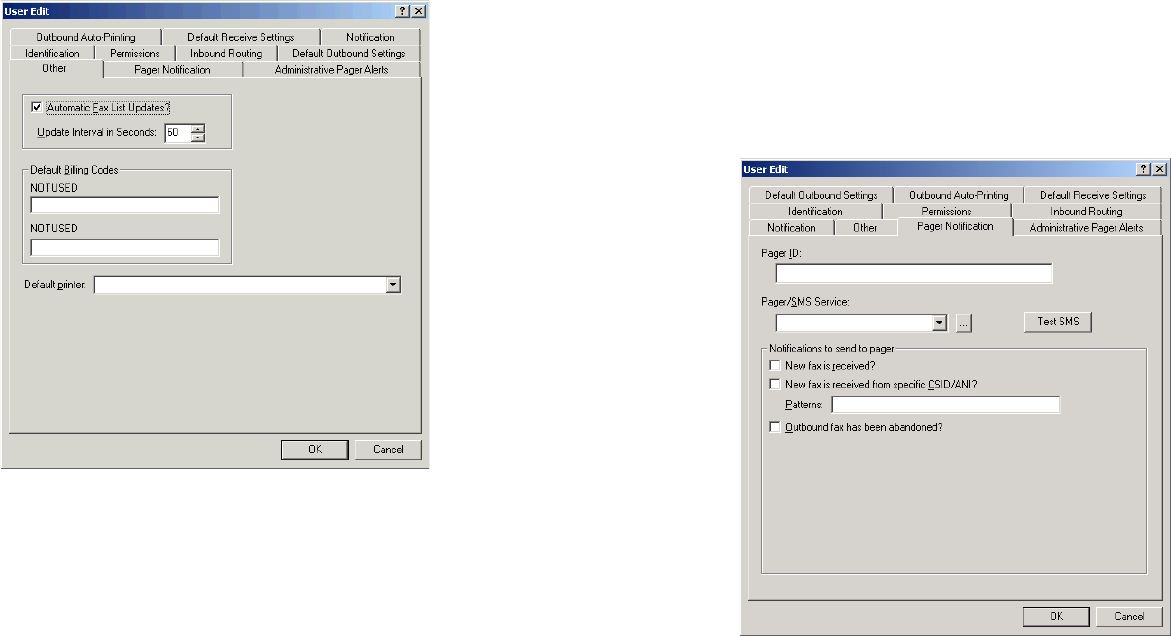
111
The Other tab
Figure 9.7 The User Edit Other Tab
Automatic Fax List Updates Configures the user’s FaxUtil
mailbox to automatically refresh (scan for new faxes).
Update Interval in Seconds Specify the interval at which
automatic fax list updates will occur.
Default Billing Codes Specify the Billing Code #1 and Billing
Code #2 settings that will appear in the Fax Information dialog
box each time the user sends a fax.
The Pager Notification tab
These settings let the fax server send SMS messages or pages to
RightFax users to notify them about the status of sent and received
faxes. This dialog box specifies the fax status messages to send to
the user. The text of the status messages that will be sent can be
customized in the User Messages tab of the RightFax Server
configuration program in Windows Control Panel (described on
page 28).
Before completing this dialog box, you must configure a list of SMS
and pager service types and providers. For information on
configuring pager or SMS services, see Chapter 17, “Adding SMS
and Pager Services”
Figure 9.8 The User Edit Pager Notification Tab
Pager ID Specify the user’s pager ID. This is usually a numeric
ID and is often the phone number for the pager.
Pager/SMS Service Select the pager or SMS service to use
for delivering the notification. If you have not added and properly
configured paging/SMS services for this user, you must do so
before completing this dialog box (described in Chapter 17,
“Adding SMS and Pager Services”).
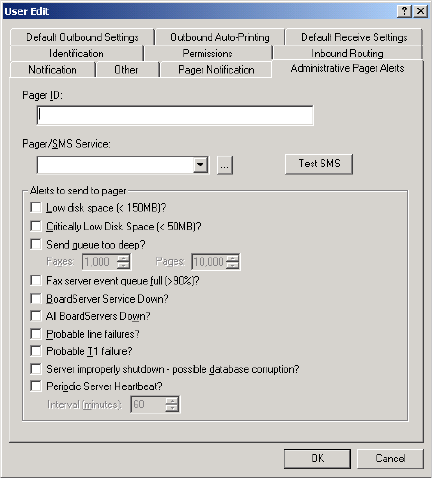
OpenText RightFax 10.0 Administrator’s Guide 112
Test S M S This button lets you send a test message to an
SMS-capable device. To send a test SMS message, select an
SMS service in the Pager/SMS Service box, type a phone number
in the Pager ID box, and then click this button.
New Fax is Received Pages the user each time a new fax is
received. If the TeleConnect module is installed, the RightFax
server will include the TeleConnect ID with all notifications of
incoming faxes. This lets users retrieve faxes without first
requesting a fax list.
New Fax is Received from Specific CSID/ANI Pages the
user each time a new fax is received from one or more specific
senders that are specified in the Patterns box.
Patterns Lists the CSID or ANI numbers that, when received,
will send a page alert to the user. Separate multiple numbers with
semicolons.
Outbound Fax has been Abandoned Pages the user each
time one of his outbound faxes fails to send for any reason.
The Administrative Pager Alerts tab
These settings let the fax server send SMS messages or pages to
RightFax administrators to alert them of specific RightFax events.
This dialog box specifies the RightFax server status messages to
send to the user. The text of the alert messages that will be sent
can be customized in the Admin Messages tab of the RightFax
Server configuration program in Windows Control Panel
(described on page 29).
RightFax Enterprise versions 8.7 and higher include a more
comprehensive Alerting and Monitoring service that lets you select
from hundreds of server statistics to monitor and define the event
thresholds, alert types, and alert messages to send. For more
information on the RightFax Alerting and Monitoring service, see
Chapter 18, “Using the Alerting and Monitoring Service”.
Before completing this dialog box, you must configure a list of SMS
and pager service types and providers. For information on
configuring pager or SMS services, see Chapter 17, “Adding SMS
and Pager Services”.
Figure 9.9 The User Edit Administrative Pager Alerts Tab
Pager ID Specify the user’s pager ID. This is usually a numeric
ID and is often the phone number for the pager.
Pager/SMS Service Select the pager or SMS service to use
for delivering the alert message. If you have not added and properly
configured paging/SMS services for this user, you must do so
before completing this dialog box (described in Chapter 17,
“Adding SMS and Pager Services”).
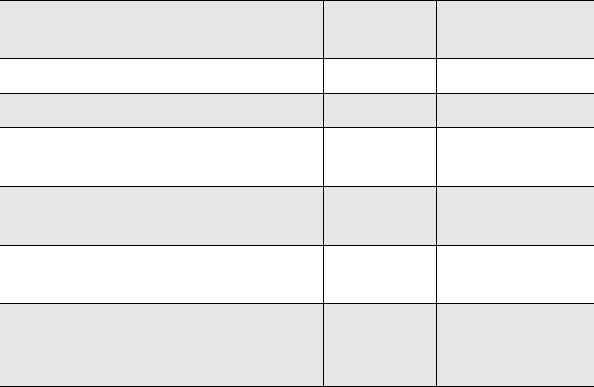
113
Test S M S This button lets you send a test message to an
SMS-capable device. To send a test SMS message, select an
SMS service in the Pager/SMS Service box, type a phone number
in the Pager ID box, and then click this button.
Low Disk Space Free hard drive space on the RightFax server
has fallen below 150 MB.
Critically Low Disk Space Free hard drive space on the
RightFax server has fallen below 50 MB.
Send Queue too Deep The number of faxes or fax pages
queued to send exceeds a fixed number. Enter the number of faxes
to exceed in the Faxes box. Enter the number of fax pages to
exceed in the Pages box.
Fax Server Event Queue Full The percentage of the fax
server’s internal Event Queue has reached 90%. For more
information on the RightFax Event Queue see “Understanding the
Fax Server Internal Event Queue” on page 35.
BoardServer Service Down One of the BoardServers has
become unable to send or receive faxes.
All BoardServers Down All of the BoardServers have become
unable to send or receive faxes.
Probable Line Failures An error or series of errors has
indicated to the BoardServer that a phone line is not operating
correctly.
Probable T1 Failure Multiple phone lines have failed in such a
way that the BoardServer suspects a T1 line is not operating
correctly.
Server improperly shut down The RightFax Server module
was shut down unexpectedly. This may indicate that the operating
system has failed or the server has lost power.
Periodic Server Heartbeat Sends a brief notification of the
RightFax server’s status, including statistics on fax activity. When
you select this check box, you must also specify the Heartbeat
Interval, in minutes.
Understanding the Alert Frequencies
After an alert is triggered, the problem causing the alert must be
remedied within a set length of time before a fault of the same type
will cause another alert. For example, this prevents free disk space
fluctuating around 50 Mb from causing repeated alerts. If an alert
condition persists, the alert will be repeated periodically. Different
types of alerts have different delays and repeat intervals as listed in
the following table.
Alerts that are not listed here are sent only once, when the alert
condition occurs.
Table 9b Pager Alert Frequencies
Alert Delay
Repeat
interval
All BoardServers are down. 10 minutes 60 minutes
BoardServer send queue too deep. 30 minutes 90 minutes
Disk space is critically low
(<50MB).
10 minutes 30 minutes
Disk space is getting low
(<150MB).
20 minutes 60 minutes
Fax server internal queue has
reached 90% utilization.
30 minutes 90 minutes
One or more BoardServers are
down but one or others are still in
service.
10 minutes 60 minutes
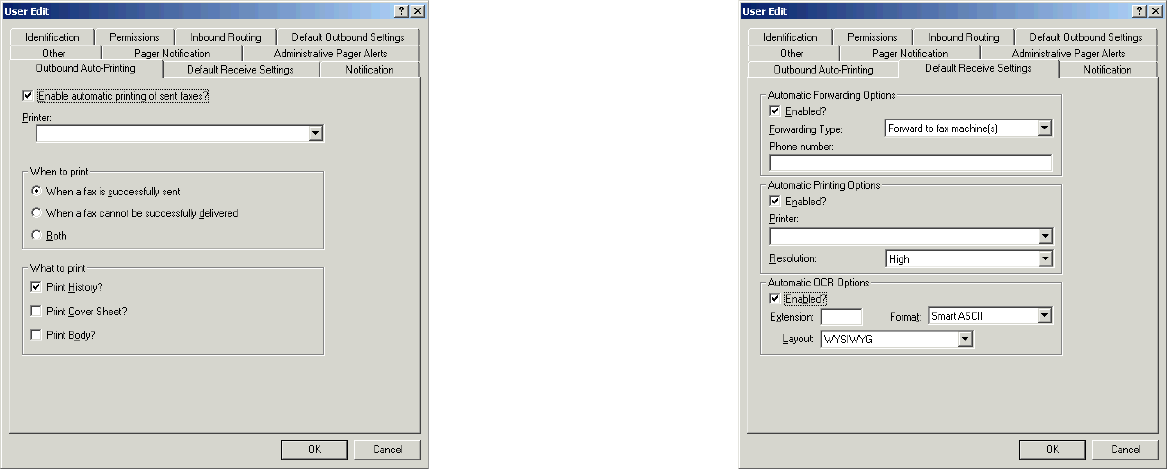
OpenText RightFax 10.0 Administrator’s Guide 114
The Outbound Auto-Printing tab
Figure 9.10 The User Edit Outbound Auto-Printing Tab
Enable Automatic Printing of Sent Faxes Prints a copy of
all sent faxes. If this check box is selected, you must also select a
printer from the list of available printers. These are the printers that
you have set up under Printers in Enterprise Fax Manager (see
“Adding a printer” on page 135).
When to Print Specify whether to print successfully sent faxes,
faxes that were not successfully sent, or both.
What to Print Specify whether to print the fax history, the fax
cover sheet, and/or the fax body.
The Default Receive Settings tab
Figure 9.11 The User Edit Default Receive Settings Tab
Automatic Forwarding Options Forward the user’s faxes to
either a fax machine or another network user as soon as they are
received. Specify the fax number or RightFax user ID to forward to.
Automatic Printing Options Automatically print received
faxes. Select a printer from the list of available printers. These are
the printers that you have set up under Printers in Enterprise Fax
Manager (see “Adding a printer” on page 135). Click a print
resolution in the Resolution list.
Automatic OCR Options Convert all received faxes to text
using OCR (optical character recognition). This option requires the
RightFax OCR Converter module. Enter a three-letter file extension
for the output file in the Extension box.
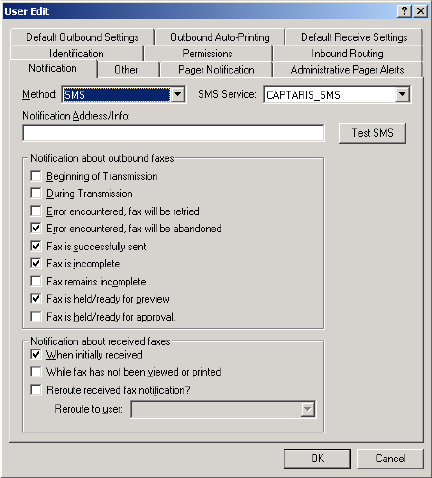
115
In the Format list, click the text format used to interpret your fax
pages. “ASCII” produces a plain text file. “Smart ASCII”
approximates the original format. “RTF” (rich text format) preserves
fonts and formatting but is only available for Windows clients.
In the Layout list, specify how you want the text to be formatted on
the page. “WYSIWYG” (What You See Is What You Get) will try to
read the fax in the layout it sees. If, for instance, RightFax sees that
the fax has three columns, it will try to read the document in column
style. “Left Justified” displays the text starting from the left margin of
the fax.
The Notification tab
These settings let you configure the fax server to notify RightFax
users about the status of sent and received faxes via email or SMS
text messaging. The text of the status messages that will be sent
can be customized in the Custom Messages tab of the RightFax
Server configuration program in Windows Control Panel
(described on page 26).
If you want to send notifications via SMS text messaging, you must
configure a list of SMS service types and providers before
completing this dialog box. For information on configuring SMS
services, see Chapter 17, “Adding SMS and Pager Services”.
Figure 9.12 The User Edit Notification Tab

OpenText RightFax 10.0 Administrator’s Guide 116
Method Select the notification method for the user.
Use Group’s Method. Uses the notification method defined for
the group to which the user belongs (described on page 120).
SMS. Sends the notification to an SMS capable device. If you
select this option, you must select an SMS service in the SMS
Service box.
Email Systems. Sends the notification to the user’s email box.
(Notes and Exchange notifications require you to purchase and
license a separate module.) You must specify the email address
of the user in the Notification Address/Info box.
Custom notification methods. These can be created using the
RightFax API. Information on the RightFax API can be found at
the Open Text Knowledge Center at knowledge.opentext.com.
Note If you are routing inbound faxes to an email gateway or other
destination on your network and you have select the Delete After Routing
check box (page 109), no notifications for received faxes will be sent.
SMS Service Select the SMS service to use for delivering the
notification. If you have not added and properly configured an SMS
service, you must do so before completing this dialog box
(described in Chapter 17, “Adding SMS and Pager Services”).
Test S M S This button lets you send a test message to an
SMS-capable device. To send a test SMS message, select an
SMS service in the SMS Service box, type a phone number in the
Notification Address/Info box, and then click this button.
Notification Address/Info Specify the user’s email address
for email notification, or other information necessary for sending fax
notifications of the type selected in the Notification Method list.
Notification About Outbound Faxes Specify the events for
outbound faxes for which the user will receive notification.
Notification About Received Faxes Specify the events for
received faxes for which the user will receive notification. If you
select the check box Reroute Received Fax Notification, you
must also select a RightFax user ID to route to from the list.
Using Windows NT Security Authentication
RightFax Enterprise servers can take advantage of your network’s
established Windows security system by linking each RightFax
user ID to a Windows user account. When logging on to client
applications that require authentication (such as Enterprise Fax
Manager and FaxUtil), RightFax attempts the Windows account
name and password with which you are currently logged on. If the
current Windows account name and password have been linked to
a RightFax user ID, that RightFax ID is used to log on. If no
RightFax user account is linked, a dialog box opens prompting you
to manually enter your RightFax user name and password.
Each user’s link status is displayed under the NT Account Link
Status column in the user list in Enterprise Fax Manager. The
status “N/A” means that the user is not required to log on via
Windows NT authentication. “No NT Account Assigned” means
that the user is required to log on via Windows NT authentication
but is not linked to a Windows account. (This user will be allowed
to log on manually.) “NT Account Assigned” means that the user is
required to log on via Windows NT authentication and is linked to a
Windows NT based account. This RightFax ID can only be
accessed when the user is logged on to Windows NT based
network with the linked account.
Linking RightFax user IDs to Windows NT based accounts
RightFax Enterprise server provides several methods for linking one
or more RightFax user IDs to existing Windows NT based
accounts.
To link a RightFax user ID
1. Edit the user properties in Enterprise Fax Manager.
2. Click the Identification tab.
3. Select the Use Integrated Windows NT Security option.
4. Click Select NT Account.
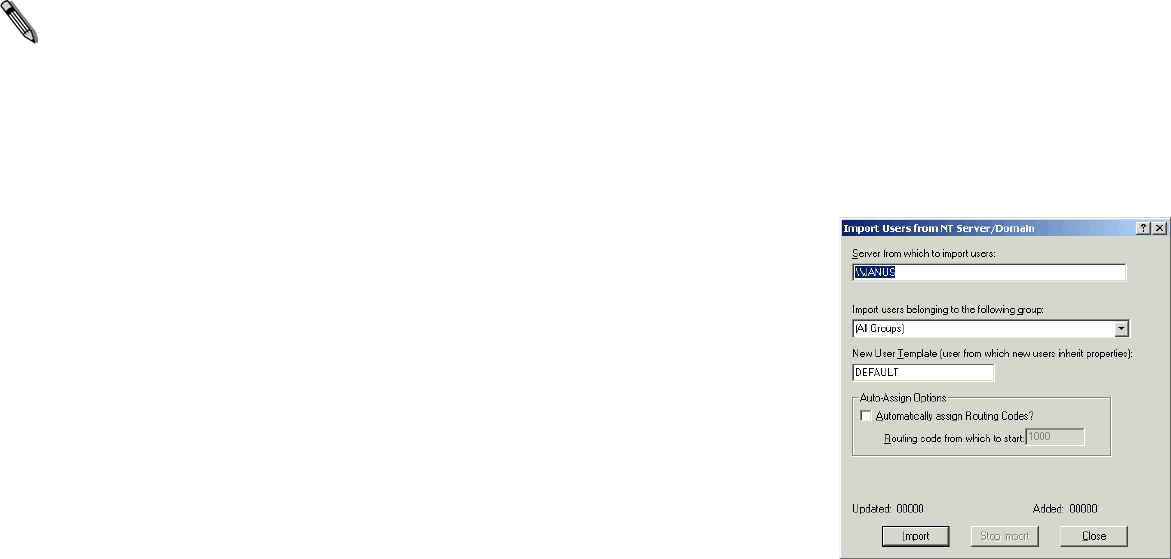
117
5. Type or select the Windows domain and account names to link
and click OK. The linked domain and account name will be
listed under the RightFax user ID in the Identification tab.
Note You can only use the Windows NT account lookup feature
when you are running Enterprise Fax Manager on the RightFax server
or a Windows workstation.
To automatically link one or multiple existing RightFax
User IDs
1. In the Enterprise Fax Manager user list, select one or more
RightFax users.
2. Right-click any selected user to open a shortcut menu, and
select Enable NT Authentication and Link from the pop-up
menu.
RightFax links each selected user ID to the matching Windows
account in the domain to which you are currently logged on. If
there is no matching Windows account name in the current
domain, no link is created.
To automatically link all new user IDs
Because all new RightFax user IDs created in Enterprise Fax
Manager use the default user ID as a template, you can configure
the default user ID so that all new user IDs automatically link to
Windows accounts.
1. In Enterprise Fax Manager, edit the default user ID.
2. Click the Identification tab and select the Use Integrated
Windows NT Security option. Click OK.
For each new user ID you create in Enterprise Fax Manager,
RightFax will link the user ID to the matching Windows account
in the domain you are currently logged on to. If there is no
matching Windows account name in the current domain, no link
is created.
Importing Users
To simplify the process of setting up all your network users in the
RightFax server, you can import users into the fax server from your
network or from an ASCII file.
To import users from a Windows NT based network
1. In Enterprise Fax Manager, on the Utility menu, click Import
Users from NT Domain. The Import Users from NT
Server/Domain dialog box opens.
Figure 9.13 The Import Users from NT Server/Domain Dialog Box
2. Enter the computer name of the Primary Domain Controller
(PDC) or Backup Domain Controller (BDC) from which the
users will be imported.
3. Select the group to import.
4. Specify the RightFax user ID to use as a template (usually
Default).
OpenText RightFax 10.0 Administrator’s Guide 118
5. If you want to automatically assign a routing code to each user,
select the Automatically Assign Routing Codes check box,
and then enter the starting code. The first imported user will
receive the starting routing code and each additional user’s
routing code will increment by one. If the system increments to
a routing code that already exists, it will be skipped.
6. When you have completed the dialog box, click Import to begin.
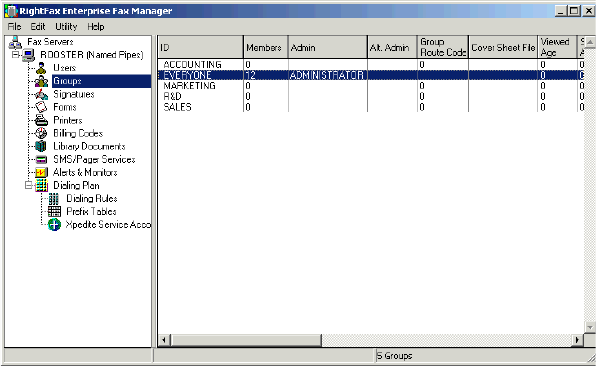
119
Chapter 10
Creating Groups of Users
You can create groups of users to which you can assign a common
administrator, alternate administrator, fax options, and fax cover
sheet. You can use groups to subdivide your organization and
manage the fax server system more efficiently. For example, you
can create separate Marketing and Sales groups on the fax server.
Instead of having one administrator responsible for all fax users in
your organization, you can assign fax administrators to the
Marketing and Sales departments.
Groups can also play an important role in when notifying users of
new faxes. If a user does not respond to his notification by viewing
or printing a new fax within a specified time, the group
administrator will be alerted to the fax and can then print the fax or
forward it to someone else.
Managing Groups
To add, edit, or delete groups of RightFax users, run Enterprise Fax
Manager (see “Starting Enterprise Fax Manager” on page 93) and
click Groups under the appropriate RightFax server in the left pane
of the window. If groups have been defined, the list of groups
appears in the right pane.
Figure 10.1 The Server Groups List
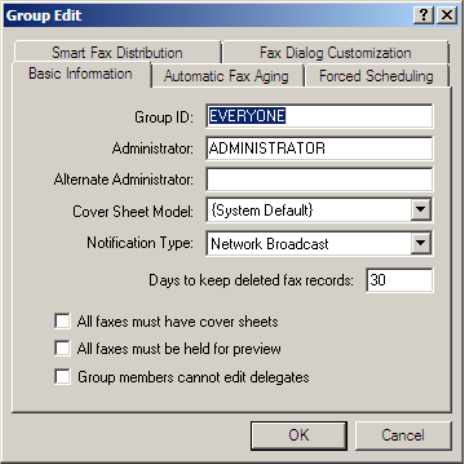
OpenText RightFax 10.0 Administrator’s Guide 120
Adding new groups
To create a new group, press INSERT or select New from the Edit
menu. The Group Edit dialog box opens. Because each RightFax
group must have a unique group ID, you must enter a value in the
group ID box. All other boxes are optional. For information on
completing each of the options on each tab see “Editing Group
Properties” on page 120.
Deleting groups
To delete a group, select the group to delete and press DELETE or
select Delete from the Edit menu. By default, you will be prompted
for confirmation that you want to delete the group.
Copying groups from one server to another
In Enterprise Fax Manager, you can copy one or more groups from
one RightFax server to another. Select the groups you want to
copy, and then drag the selection to another server.
If you copy groups from a new RightFax server version to an earlier
server version, you will lose configuration data that is not supported
on the older server (for example, features on version 8.5 servers will
not be available on version 8.0 servers).
Editing Group Properties
To edit the properties of an existing group, run Enterprise Fax
Manager, select the group to edit and press ENTER, or select Edit
from the Edit menu. You can also double-click the group. The
Group Edit dialog box opens.
The Basic Information tab
Figure 10.2 The Group Edit Basic Information Tab
Group ID The unique ID for this group.
Administrator Specify the user ID of the person who will be the
administrator of this group. The administrator has access to all the
mailboxes in the group and receives alerts when a user has not
printed or viewed a fax before the time specified in User Notify
Time in the RightFax Server configuration program expires (see
“User Notify Time” on page 23).
Alternate Administrator Specify the user ID of the person
who will be the alternate administrator of this group. The alternate
administrator will have access to all the mailboxes in this group and
will receive messages about faxes belonging to group members if
the user and the administrator have not printed or viewed a fax in
the designated interval.
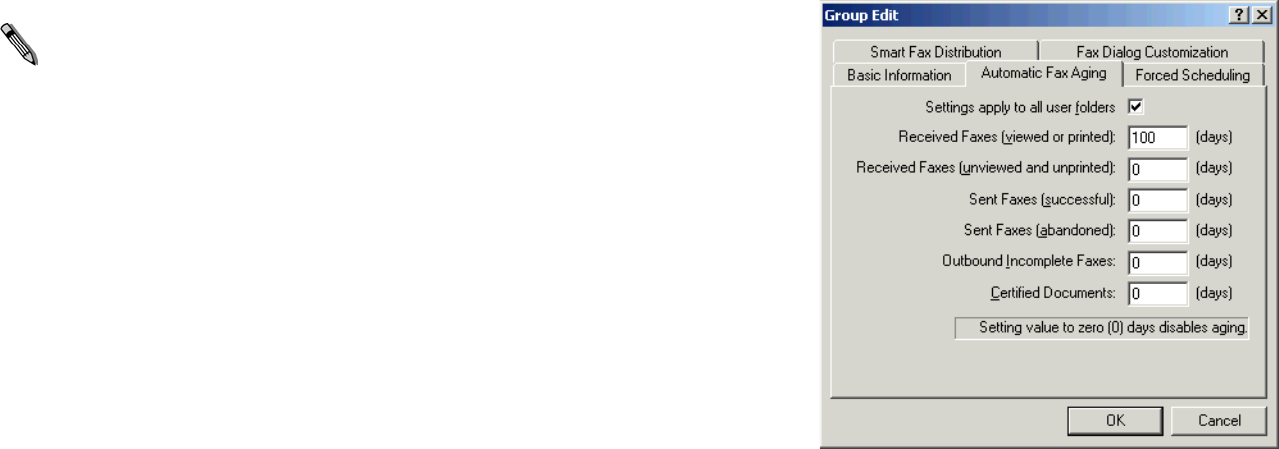
121
Cover Sheet Model Specify the default fax cover sheet for the
group. The list displays the fax cover sheet files in the
RightFax\FCS folder. Selecting “Default” uses the cover sheet file
FCS.pcl.
Note Coversheet names must be 1-13 characters long and conform to
the 8.3 naming standard.
Notification Type Specify the default notification method for
the group.
Days to keep deleted fax records The days keep deleted fax
records setting is based on the date the fax was recieved, not the
deleted date. Specify the number of days to keep records of
deleted faxes in the RightFax database. If set to 0 (zero), deleted
fax records will never be automatically purged by the fax server.
All faxes must have cover sheets Requires all users in the
group to use a cover sheet on outbound faxes.
All faxes must be held for preview All the faxes for users in
the group will be held for preview before they are sent. Users must
view the faxes and verify that they should be sent.
Group members cannot edit delegates Members of the
group can view delegate information, but can not change it.
The Automatic Fax Aging tab
With automatic fax aging, you can specify the number of days after
the date a fax is sent or received that it will be deleted from a user’s
FaxUtil mailbox. Automatic fax aging is only available if you have a
RightFax Enterprise or Satellite server.
Automatic fax aging does not remove the fax records from the
RightFax database, so you can still run reports about the faxes.
You can also perform manual fax aging with the Faxage.exe utility
program (see the RightFax Administrative Utilities Guide).
Figure 10.3 The Group Edit Automatic Fax Aging Tab
For each type of fax, enter the number of days the fax will remain
before it is deleted. To specify that faxes should not be deleted,
enter 0 (zero).
To apply these settings to all the users’ folders, select the check
box Settings apply to all user folders. To disable fax aging, click
to clear the check box.
The Forced Scheduling tab
Forced scheduling controls fax traffic volume on the basis of user
groups. You can restrict the total number of pages or total number
of faxes that are sent simultaneously by all users in the group and
limit these restrictions to a specific time period.
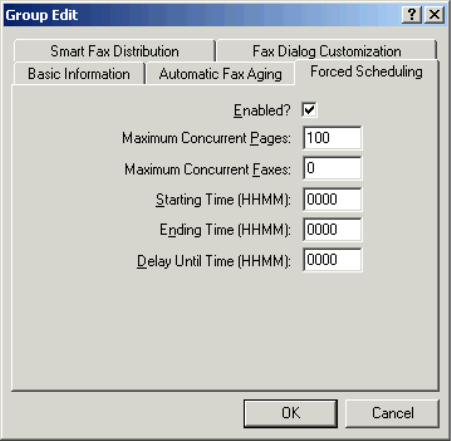
OpenText RightFax 10.0 Administrator’s Guide 122
For example, if you have 50 sales representatives, each sending
100 faxes every hour, all of your fax channels may be continuously
busy processing their faxes. This could delay more important faxes
from other departments, as well as block incoming faxes. With
Forced Scheduling, you can restrict the members of the Sales
group to sending no more than 20 pages at a time between the
hours of 8 A.M. and 5 P.M. and delay any faxes over that limit until
6 P.M.
This feature restricts only simultaneously scheduled faxes. It does
not restrict the total number of faxes or fax pages that can be sent
during the specified time period. If a fax exceeds the maximum limit
and is delayed until a later time, it can be rescheduled at any time
by selecting Fax > Forward to New Number in FaxUtil.
Figure 10.4 The Group Edit Forced Scheduling Tab
Enabled Enables the Forced Scheduling feature.
Maximum Concurrent Pages Specify the maximum number
of fax pages that can be scheduled at one time by all the users in
the group.
Maximum Concurrent Faxes Specify the maximum number of
faxes that can be scheduled at one time by all the users in the
group.
Starting/Ending Time The starting and ending times for the
period that the restriction applies. This is written in 24-hour HHMM
format. For example, to set the restriction from 8:00 A.M. to 5:30
P.M., set the Starting Time to 0800, and set the Ending Time to
1730.
If during this time period any faxes exceed the limits you specify,
those faxes will be delayed until the time you specify in the Delay
Until Time box.
Delay Until Time The time at which delayed faxes will be sent.
This is written in 24-hour HHMM format. For example, to send
delayed faxes at 6:00 P.M., enter 1800.
If the Delay Until Time falls between the Starting and Ending
times, automatically delayed faxes will never be sent. This is
because delayed faxes, by definition, cannot be sent between your
Starting and Ending times. In such a case, delayed faxes will be
continuously bumped to the next day at that same time.
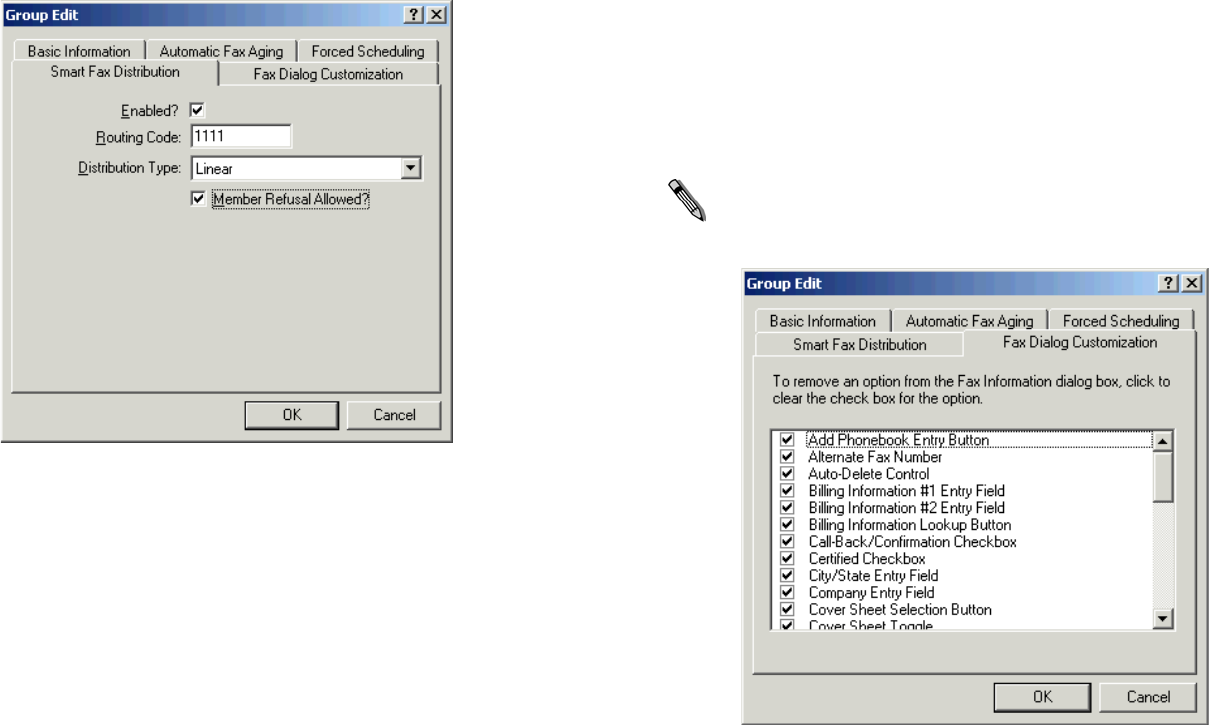
123
The Smart Fax Distribution tab
With smart fax distribution, a group routing code is created and all
faxes received by the group are distributed systematically between
all the users in that group.
Figure 10.5 The Group Edit Smart Fax Distribution Tab
Enabled Enables smart fax distribution for this group.
Routing Code Assigns a routing code to the group.
Distribution Type Specify either linear or balanced distribution.
With linear distribution, faxes are distributed to each group member
in succession. With balanced distribution, faxes distribution is
determined by each user’s processing rate. If one user is faster at
processing faxes than another, the faster user is distributed faxes at
a faster pace.
Member Refusal Allowed Lets users take themselves
temporarily out of the distribution loop. When this check box is
selected, users can refuse faxes by running FaxUtil and selecting
Tools > Refuse Distributions. This option is enabled by default
and must be disabled to allow per user customization
The Fax Dialog Customization Tab
This group of check boxes lets you customize the appearance of
the Fax Information dialog box (the dialog box used to create and
address outgoing faxes) for the users in this group. This is useful
for removing options that do not apply to or should not be changed
by these users.
Note The Fax Dialog Customization tab is available with Enterprise
editions of RightFax only.
Figure 10.6 The Group Edit Fax Dialog Customization Tab
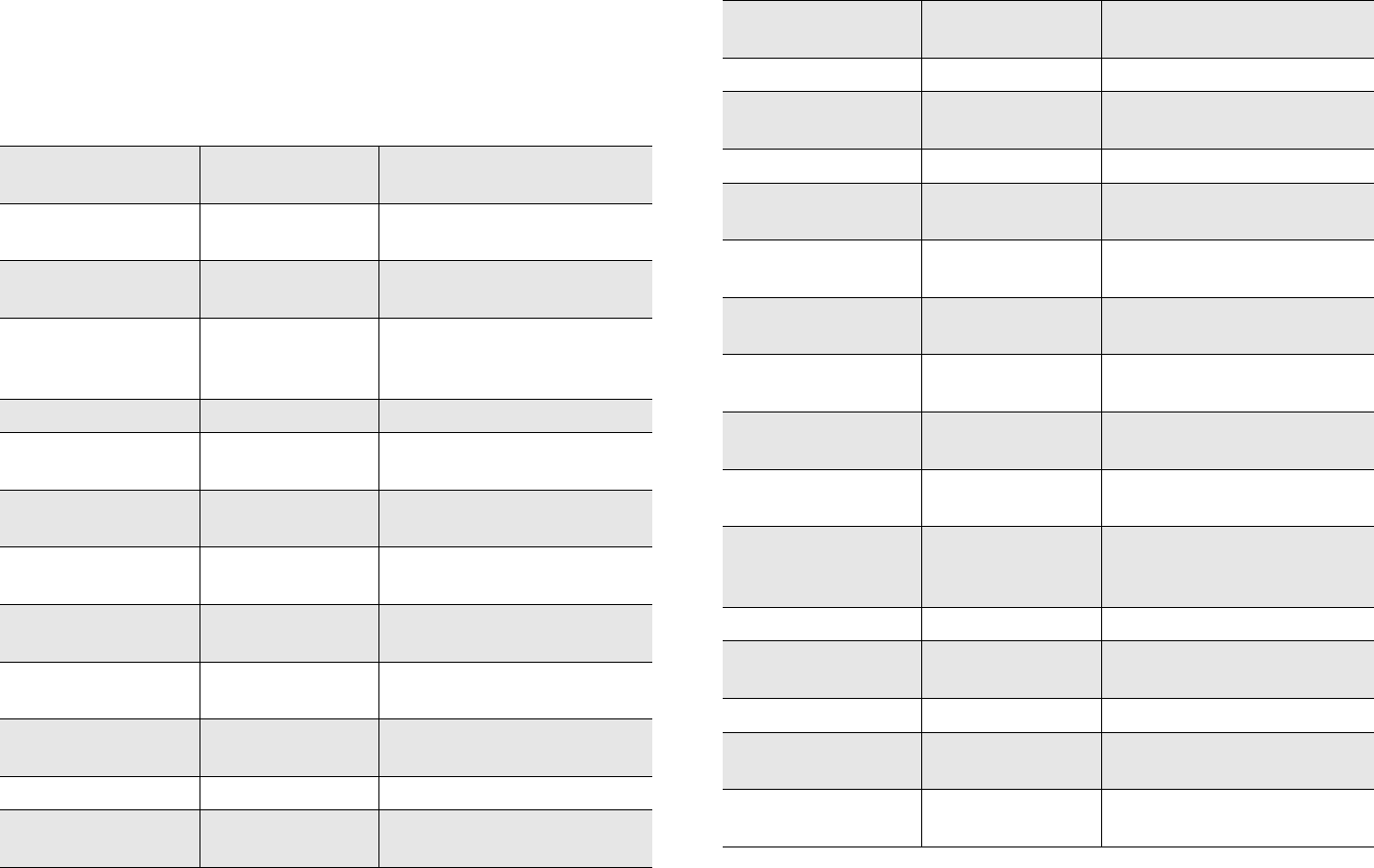
OpenText RightFax 10.0 Administrator’s Guide 124
The following table lists each of the checkboxes on this dialog box,
and the tab and option on the Fax Information dialog box that
each checkbox represents. For more information on the options in
the Fax Information dialog box, see Chapter 25, “Creating,
Sending, and Managing Faxes”.
Table 10a Fax Dialog Customization Checkboxes
Checkbox
Fax Information
dialog box tab Option
Acquire Attachments
from Scanner
Attachments Scanner button (scanner icon)
Add Phonebook Entry
Button
Main Add Entry button
Alternate Body
Attachment Checkbox
Attachments Ability to display Alt. Body
column in Selected
Attachments list
Alternate Fax Number Main Alt. Fax Number text box
Auto-Delete Control More Options Automatic Deletion selection
box
Billing Information #1
Entry Field
Main Billing Code 1 text box (title
may vary)
Billing Information #2
Entry Field
Main Billing Code 2 text box (title
may vary)
Billing Information
Lookup Button
Main Lookup button
Browse for File
Attachment
Attachments Browse button (folder icon)
Certified Checkbox Main Use certified delivery
checkbox
City/State Entry Field Main City/State text box
Comments Text Cover Sheet Notes Comments for your Records
text box
Company Entry Field Main Company text box
Cover Sheet
Selection Button
More Options Cover Sheet File selection
box
Cover Sheet Toggle Main Use cover sheet text box
Delay Send Controls Main Delay send checkbox and
time/date fields
Form Type Selection More Options Use form checkbox and
selection list
From Name Entry
Field
More Options Name text box
From Phone Number
Entry Field
More Options Voice Number text box
General Fax Number
Entry Field
More Options Company Fax Number text
box
General Voice
Number Entry Field
More Options Company Voice Number text
box
Library Document/
Attachments
Selection
Attachments Available Attachments library
document list and File Attach
button (paper clip icon)
‘More Options’ Tab More Options All tab contents
Native Attach
Document Checkbox
Attachments Native column in Selected
Attachments list
‘Notes’ Button/Tab Cover Sheet Notes All tab contents
Notes Text Cover Sheet Notes Notes to be Placed on the
Cover Sheet text box
PDF Options Main PDF Options button (next to
Create PDF image checkbox)
Table 10a Fax Dialog Customization Checkboxes (Continued)
Checkbox
Fax Information
dialog box tab Option
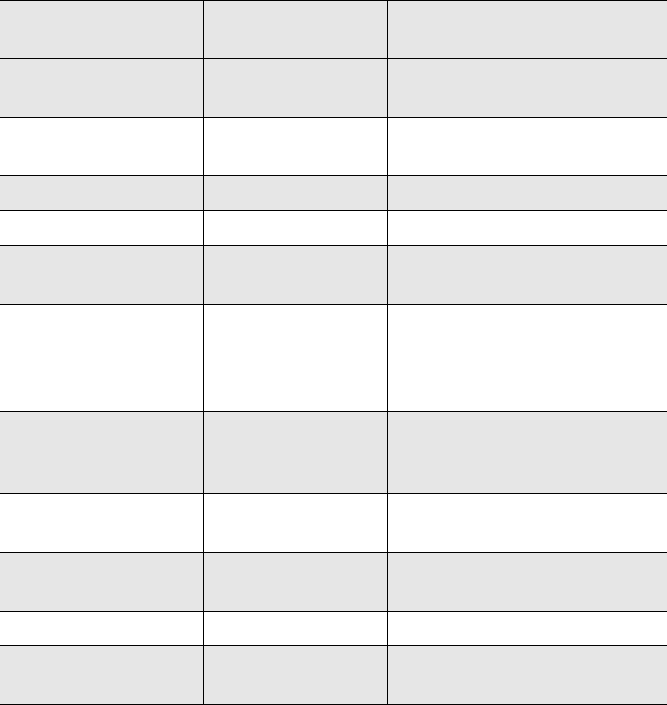
125
Phonebook Import
Main Menu Option
Main Phonebook button
Phonebook Selection
Button
Main Phonebook button
Preview Checkbox Main Hold for preview checkbox
Priority Checkbox More Options Priority selection box
Private Fax Number
Entry Field
N/A Phonebook Import option on
the Tools menu in FaxUtil.
Recipient Type Field Main Down arrow button next to the
Fax number text box that lets
users select the Email
address option
Secure
Send/Recipient Fax
ID Control
More Options Recipient Fax ID text box
Smart-Resume
Checkbox
Main Use smart-resume checkbox
Transmission Quality
Control
Main Fine mode checkbox
Use PDF Checkbox Main Create PDF image checkbox
Voice Number Entry
Field
Main Voice Number text box
Table 10a Fax Dialog Customization Checkboxes (Continued)
Checkbox
Fax Information
dialog box tab Option
OpenText RightFax 10.0 Administrator’s Guide 126

127
Chapter 11
Creating Signatures
RightFax can personalize users’ outbound faxes with graphic
images of their signatures. Signature images are created in FaxUtil
and stored in the RightFax\SIG folder on the server. Enterprise Fax
Manager catalogs all the signatures and maintains the file names,
descriptions, and authorized user information.
Note Signature files are currently not supported in outbound PDF
documents.
Managing Signature Files
To edit or delete signature files, run Enterprise Fax Manager (see
“Starting Enterprise Fax Manager” on page 93) and click
Signatures under the desired RightFax server in the Fax Server
Tree.
You must create a new signature file in order for it to appear as an
object in Enterprise Fax Manager. New signature files are created
from the FaxUtil mailbox (see “Creating a New Signature File” on
page 128).
Deleting signatures
To delete a signature, select the signature to delete and press
DELETE or select Delete from the Edit menu. By default, you will
be prompted for confirmation that you want to delete the signature.
Deleting the signature’s reference in Enterprise Fax Manager does
not delete the signature file itself. A second confirmation dialog box
will ask you if you want to delete the file as well.
Copying signatures from one server to another
Enterprise Fax Manager can easily copy one or more signatures
from one RightFax server to another. Select the signatures you
want to copy, and then drag the selection onto another server.
If you copy signature files from a new RightFax server version to an
earlier server version, you will lose configuration data that is not
supported by the older server (in other words, features on version
8.0 servers will not be available on version 7.0 servers).
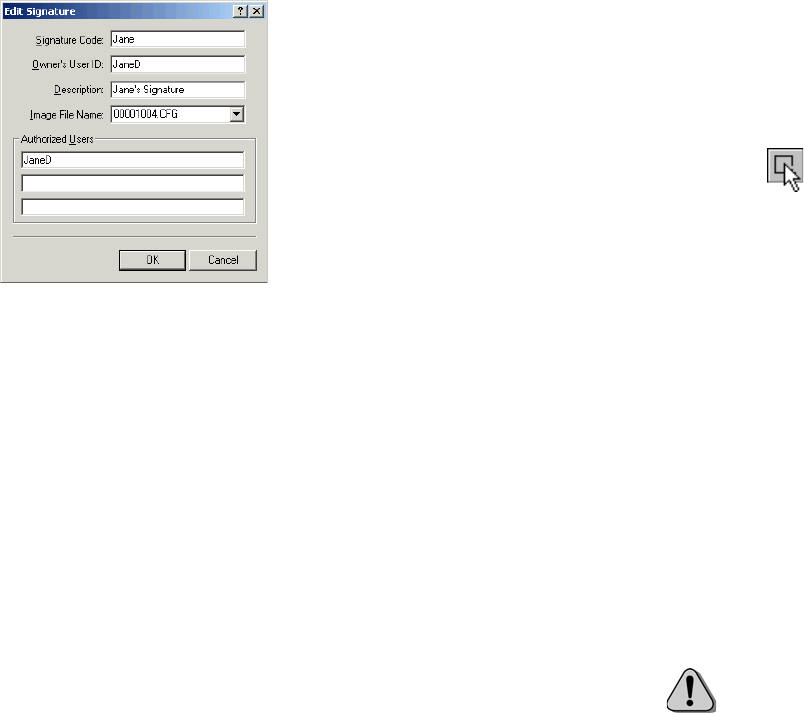
OpenText RightFax 10.0 Administrator’s Guide 128
Editing Signature File Properties
To edit the properties of an existing signature, run Enterprise Fax
Manager, select the signature to edit and press ENTER or select
Edit from the Edit menu. You can also double-click the signature.
The Edit Signature dialog box opens.
Figure 11.1 The Edit Signatures Dialog Box
Signature Code The name the signature that will be displayed
in Enterprise Fax Manager.
Owner’s User ID The user ID of the owner of the signature file.
Description A description of the signature file for easy reference
in Enterprise Fax Manager.
Image File Name The name of the signature image file. This file
name is automatically generated and stored in the RightFax\SIG
folder on the RightFax server when the signature file is created. If
this box contains an invalid file name, RightFax will not be able to
use the signature image.
Authorized Users Up to three RightFax user IDs or group IDs
who are authorized to use this signature in addition to the owner of
the signature.
Creating a New Signature File
Only users with RightFax administrative access can create
signature files. Signature files are created from a fax in a your
FaxUtil mailbox. You can scan a signature into your mailbox or fax a
signed document to yourself. After the document arrives in your
FaxUtil mailbox, follow these steps to create a signature file:
1. In FaxUtil, double-click the fax to view it using the RightFax Fax
Viewer.
2. Using the Select tool in the Fax Viewer toolbar, click the
signature.
Figure 11.2 The Select tool
3. Select Store from the Fax menu, and then select Make
Signature. The Edit Signature dialog box opens.
Enter an ID for the signature in the Signature Code box. This
must be unique, as it will be the identifying code Enterprise Fax
Manager displays in the ID column when viewing the list of
signatures. Enter the owner’s user ID and a description of the
signature. In the Authorized Users boxes, list up to three
RightFax user IDs or group IDs who are authorized to use this
signature in addition to the owner of the signature.
Adding a Signature to a Fax
Signature files are inserted into fax-bound documents using the
<SIGNATURE> embedded code. For information on using this
and other embedded codes see Appendix A, “RightFax Embedded
Codes”.
Caution Signature files will not display properly in documents that have
been converted to PostScript.
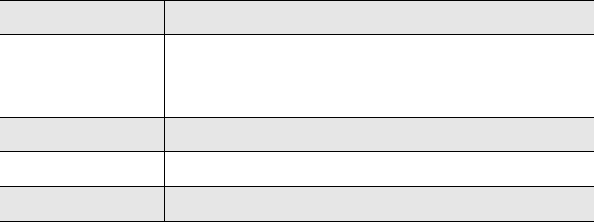
129
Controlling signature placement
Signature images are positioned so that the left-middle point of the
signature aligns with the left-middle point of the <SIGNATURE>
embedded code in the document. RightFax supports a Windows
registry entry that modifies the vertical alignment of new signatures
created on the client workstation where the registry value is
present.
Increasing the data for this value causes all newly created
signatures to be shifted upwards by a percentage of the height of
the signature image (the actual distance depends on the height of
the signature). Decreasing the data causes signatures to shift
down an equal distance.
This registry value only affects signatures when they are initially
created. If you change the data for this value, you will need to
recreate each signature that you want the new setting applied to.
Table 11a Windows Registry Entry for Vertical Placement of Signature
Category Value
Key 32-bit or 64-bit client operating systems:
HKEY_CURRENT_USER\Software\
RightFax Client\VWR32
Value SignaturePositionPercent
Type DWORD
Data 0–100 (default 35)
OpenText RightFax 10.0 Administrator’s Guide 130
131
Chapter 12
Creating Overlay Forms
Overlay forms are fax image files that RightFax can superimpose
over outgoing faxes. These “forms” are typically replicas of
documents that your organization uses (for example, company
letterhead) and give your faxes the appearance of being printed on
the form prior to faxing.
Managing Overlay Form Files
To edit or delete forms, run Enterprise Fax Manager (see “Starting
Enterprise Fax Manager” on page 93) and click Forms under the
RightFax server in the Fax Server Tree.
You must create a new form file in order for it to appear as an
object in Enterprise Fax Manager. New form files are created from
the FaxUtil mailbox (see “Creating a New Overlay Form” on
page 132).
Deleting a form
To delete a form, select the form to delete and press DELETE, or
select Delete from the Edit menu. You will be prompted for
confirmation that you want to delete the form. Deleting the form’s
reference in Enterprise Fax Manager does not delete the form file
itself. A second confirmation dialog box will ask you if you want to
delete the file as well.
Copying forms from one server to another
In Enterprise Fax Manager, you can copy one or more forms from
one RightFax server to another. Select the forms you want to copy,
and then drag the selection to another server.
If you copy overlay forms from a new RightFax server version to an
earlier server version, you will lose configuration data that is not
supported by the older server (for example, features on version 8.5
servers will not be available on version 8.0 servers).
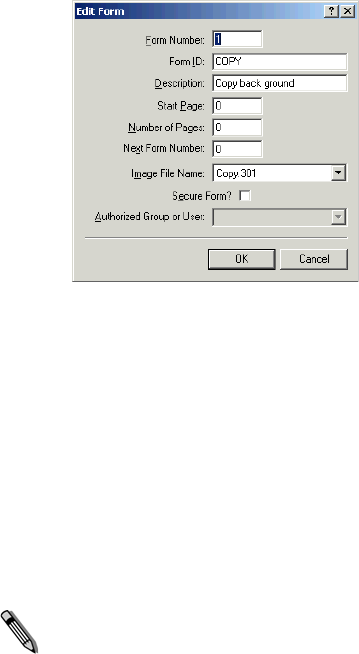
OpenText RightFax 10.0 Administrator’s Guide 132
Editing Form File Properties
To edit the properties of an existing form, run Enterprise Fax
Manager, select the form to edit and press ENTER, or select Edit in
the Edit menu. You can also double-click the form. The Edit Form
dialog box opens.
Figure 12.1 The Edit Form Dialog Box
Form Number The number that identifies the form. This is
assigned by RightFax when the form is created.
Form ID This is a unique name that identifies the form.
Description This is a description of the form file for easy
reference in Enterprise Fax Manager.
Start Page Specifies the first page of the body of the fax
document onto which the form will be placed. The page numbers
you specify are absolute, so if the start page for a form is set to 3
and you apply it to a document that only has two pages, none of
the document pages will include the form.
Note Overlay forms are never placed on fax cover sheets. If you enter 1
in the Start Page box, the form will appear on the first page of the body of
the fax following the cover sheet.
Number of Pages The number of fax pages that will be overlaid
with the form. To overlay each page of the fax with the form, enter 0
(zero).
Next Form Number Specifies the second form to use, if you
want to use two overlay forms in one fax (i.e., different forms for the
first page and all subsequent pages of your company letterhead).
Specify the form number of the next form file. For more information
on using two overlay forms in a single fax, see “Using Two Overlay
Forms in One Fax” on page 133.
Image File Name The name of the form image file. This is
automatically generated and stored in the RightFax\Papers folder
on the RightFax server when the form file is created. If this box
contains an invalid file name, RightFax will not be able to use the
form image.
Secure Form Restricts the form to specific groups or users. To
secure a form, select the Secure Form check box. In the
Authorized Group or User list, click the users or groups
authorized to use the form.
Creating a New Overlay Form
To create new overlay forms in FaxUtil, you must be assigned
permission in your user profile (see “The Permissions tab” on
page 106).
Form files are created from faxes in your FaxUtil mailbox. You
should always create forms using fine resolution. To set fine
resolution as the default in FaxUtil, select Tools > Options, and the
Options dialog box opens. On the Sending tab, select the Use
Fine Mode check box.
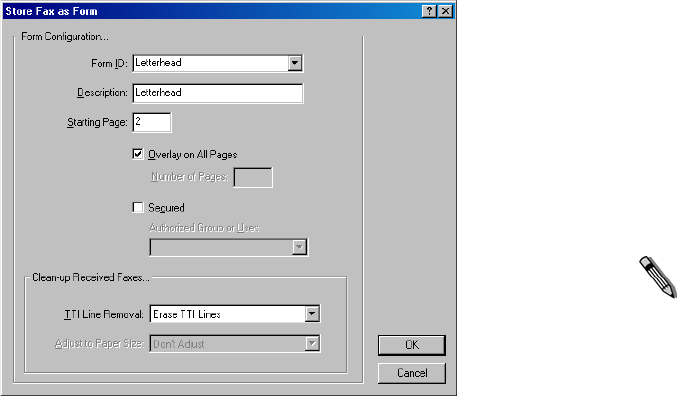
133
To create a new overlay form
1. Create the form image in a word processor or any other
application that lets you print to the RightFax fax printer. Send
the fax image to your FaxUtil mailbox.
2. Run FaxUtil and click the form in the list of received faxes.
3. Select Fax > Store as Form, and the Store Fax as Form
dialog box opens.
Figure 12.2 The Store Fax as Form Dialog Box
4. In the Form ID box, enter a unique ID for the form. The
remaining boxes are the same as those in the Edit Form dialog
box (see “Editing Form File Properties” on page 132).
5. When you have completed the dialog box, click OK. The new
form will now appear in the Forms list in Enterprise Fax
Manager.
Using Two Overlay Forms in One Fax
You can configure two overlay forms to appear in a fax. For
example, page 1 of the fax may include company letterhead, and
pages 2, 3, 4, and 5 may include an invoice form.
After the two forms have been configured following these
instructions, then each time you add the first form to an outgoing
fax, it will automatically be followed by the second form because
they are linked.
To configure two forms for use in a single fax document
1. Create two forms according the instructions in “Creating a New
Overlay Form” on page 132.
2. Run Enterprise Fax Manager and edit the properties of the first
of the two forms (described on page 132).
3. In the Edit Form dialog box, in the Start Page box, enter the
page number that you want the first form to initially appear on. In
most cases, this value will be set to 1.
Note Overlay forms are never placed on fax cover sheets. If you
enter 1 in the Start Page box, the form will appear on the first page of
the body of the fax, following the cover sheet.
4. In the Number of Pages box, enter the number of pages on
which you want the first form to appear. If the first form will only
be used on the first page, enter 1.
5. In the Next Form Number box, enter the form number of the
second form to use. Click OK to close the Edit Form dialog
box.
6. Edit the properties of the second of the two forms.
7. In the Edit Form dialog box, in the Start Page box, enter the
page number that you want the second form to appear on. In
most cases, this value will be set to 2.
OpenText RightFax 10.0 Administrator’s Guide 134
8. In the Number of Pages box, enter the number of pages on
which you want the second form to appear. If you want the
second form to appear on all subsequent pages, enter 0 (zero).
9. Click OK to close the Edit Form dialog box.
Adding an Overlay Form to a Fax
Overlay forms are inserted into fax-bound documents using the
<FORMTYPE> embedded code or by specifying the form to use in
the Fax Information dialog box. For information on the Fax
Information dialog box, see “Specifying Addressing Information”
on page 235.
135
Chapter 13
Connecting Printers and Scanners
You can define an unlimited number of network printers in RightFax
and make them available for automatic printing of faxes and other
automated network print functions. Printers can be added
individually or imported in groups from your network. The printers
you configure here are not the printers and print-to-fax devices that
allow RightFax users to fax documents from native applications.
Rather, these are the printers available to RightFax for automatically
printing sent and received faxes.
Managing Printers
To add, edit, or delete printers on the RightFax server, run
Enterprise Fax Manager (see “Starting Enterprise Fax Manager” on
page 93) and click Printers under the desired RightFax server in
the Fax Server Tree.
Adding a printer
To add a new printer to RightFax, press INSERT or select New
from the Edit menu. The Edit Network Printer dialog box opens.
For information on completing each of the options in this dialog box
see “Editing Printer Properties” on page 136.
Deleting a printer
To delete a printer, select the printer to delete and press DELETE
or select Delete from the Edit menu. By default, you will be
prompted for confirmation that you want to delete the printer.
Copying printers from one server to another
Using Enterprise Fax Manager you can easily copy one or more
printers from one RightFax server to another. Select the printers
you want to copy, and then drag the selection to another server.
If you copy printers from a new RightFax server version to an earlier
server version, you will lose configuration data that is not supported
by the older server (for example, features on version 8.5 servers will
not be available on version 8.0 servers).
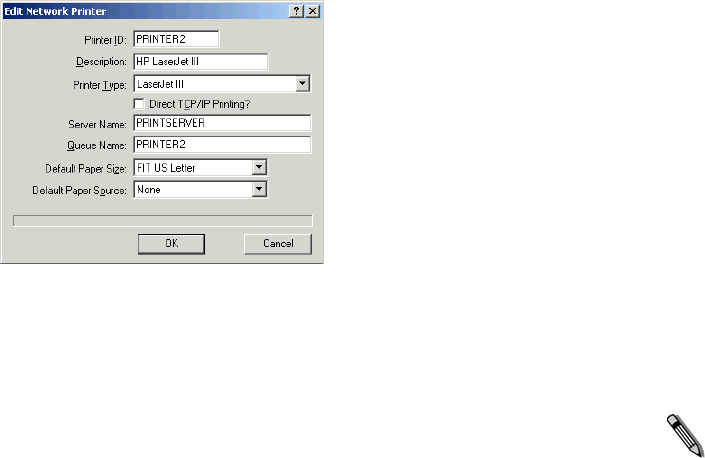
OpenText RightFax 10.0 Administrator’s Guide 136
Editing Printer Properties
To edit the properties of an existing printer, run Enterprise Fax
Manager, select the printer to edit and press ENTER, or select Edit
from the Edit menu. You can also double-click the printer. The Edit
Network Printer dialog box opens.
Figure 13.1 The Edit Network Printer Dialog Box
Printer ID The identifier RightFax will use for this printer. This ID
should match the printer’s network ID to avoid confusion.
Description This is a description of the form file for easy
reference in Enterprise Fax Manager. If this box is completed, users
will see both the Printer ID and Description in the Print dialog
box. If this box is not completed, only the Printer ID will be
displayed.
Printer Type Sets the printer driver used by the fax server to
format faxes printed to this printer. Choose the one that most
closely corresponds to your printer. If your laser printer supports
both PostScript and PCL5, choose one of the HP LaserJet types
rather than PostScript for faster printing.
Direct TCP/IP Printing Allows faxes to be printed directly to
an IP port on a printer using the LPR, a TCP/IP utility.
Server Name Indicates on which file server the queue exists. If
the queue is in NDS, this should be the value at the top of the tree.
Queue Name Differs depending on your network operating
system. On NetWare 3.x, the Queue Name should contain the
Bindery name of the queue, i.e. “LASER1.” On LAN Server and
Windows NT based networks, Queue Name should contain the
share name of the queue. On NetWare 4.x servers that are using
NDS, Queue Name should contain the Distinguished Name of the
queue object, i.e. “LASER1.SALES.ACME.”
Default Paper Size Sets how the fax server will scale a fax
page to fit onto the printable area of a laser printer. This also sets
what size paper to select. “None” will not scale the image at all
which can result in some portion of the page being truncated. “Fit
Letter” causes the fax page to be scaled to fit onto the printable
area of U.S. letter size paper (8.5 × 11 in.). “Fit Legal” scales the
page to fit onto the printable area of U.S. legal size paper (8.5 × 14
in.). “Fit Letter/Legal” scales the fax to fit on letter size paper if it is
12.5 inches or less, otherwise it will be scaled to fit legal size
paper. This last option is useful for firms receiving faxes in a mix of
letter and legal sizes and where dual-bin laser printers are used. In
such cases, the laser printer will select the appropriate size paper,
letter or legal, to correspond to the size of the fax page. “Fit A4”
scales the fax to fit onto the printable area of A4 size paper (210 ×
297 mm). “Fit A4/Legal” is identical to Fit Letter/Legal, except that
the printer will choose between A4 and Legal paper trays.
Note All laser printers have an unprintable margin area. RightFax takes
this into account when scaling and fits the full fax page within the
printable region. The result is a small (5%) reduction in the page image
when printed on a laser printer. Because fax pages have no unprintable
regions, this scaling is necessary to prevent portions of the fax from being
lost during printing.
Default Paper Source Determines which paper tray selection
command RightFax will send to the printer. If the Default Paper
Size is set to “Fit Letter/Legal” or “Fit A4/Legal,” it is
recommended that this value be set to “None.” Otherwise the
automatic selection of paper trays will not work.
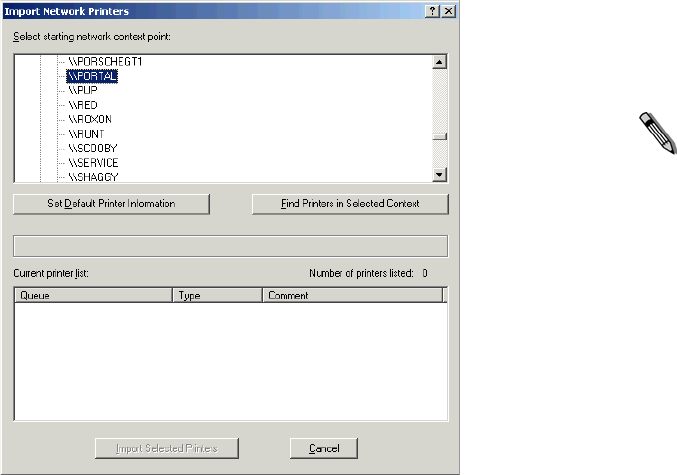
137
Importing Printers into RightFax
You can import printers from your network into RightFax in groups
or you can import all printers.
To import printers
1. In Enterprise Fax Manager, in the Utility menu, select Import
Printers from Network. The Import Network Printers dialog
box opens.
Figure 13.2 The Import Network Printers Dialog Box
2. Select the network context to import from.
3. Before importing printers, you can specify the characteristics of
printers for which to search. You can set the printer driver, paper
size, paper type, and whether the printer is set to print to an IP
port. Click Set Default Printer Information.
4. To search for printers, click Find Printers in Selected Context.
Depending on the size of the network, this scan can take
several minutes. To cancel the search, click Stop Loading.
5. The list of available printers appears in the Current printer list.
Click to select the printers to import, and then click Import
Selected Printers.
Configuring RightFax to Automatically Print Faxes
Each RightFax user profile can be configured to automatically print
sent or received faxes. Before you can configure automatic printing
for users, you must set up at least one network printer in Enterprise
Fax Manager. For information on adding and configuring network
printers see “Adding a printer” on page 135.
Note The ability to automatically print sent and received faxes can also
be configured by individual users in the FaxUtil client application.
To configure a user to automatically print sent and received faxes,
select Users in Enterprise Fax Manager and double-click the user
ID to edit. Automatically printing sent faxes is configured in the
Outbound Auto-Printing tab (page 114) and automatically
printing received faxes is configured in the Default Receive
Settings tab (page 114).
Using Scanners with RightFax
If you need to fax a document that has already been printed, you
can use either a local or network scanner to scan the document
directly into RightFax for fax transmission.
Using a desktop scanner
RightFax can scan documents for fax transmission from any
TWAIN32-compliant scanner connected to your computer. To
make your local scanner available in RightFax, install the scanner,
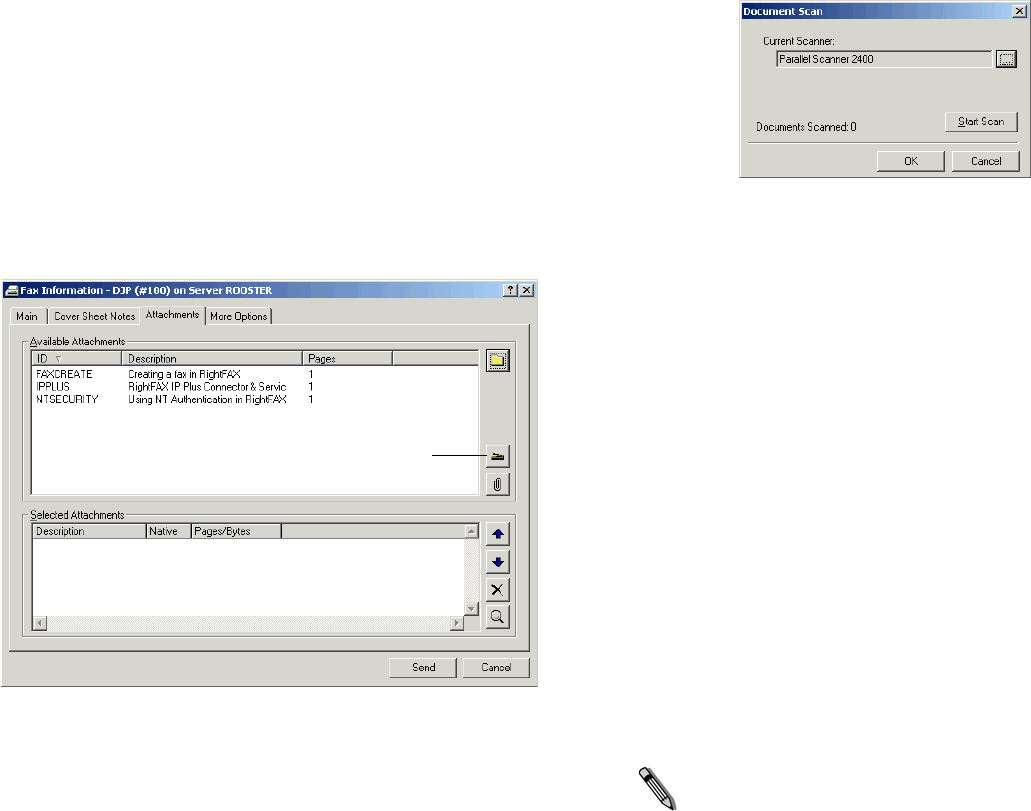
OpenText RightFax 10.0 Administrator’s Guide 138
its drivers, and the TWAIN32 drivers according to the installation
instructions provided with the scanner. RightFax automatically
detects the TWAIN32 drivers and makes the scanner available
when creating a fax document.
To scan a document for fax transmission
1. Open the Fax Information dialog box using any of the methods
provided by your RightFax client installation. For information on
opening the Fax Information dialog box for creating,
addressing, and sending fax documents, see Chapter 25,
“Creating, Sending, and Managing Faxes”.
2. In the Fax Information dialog box, click the Attachments tab.
Figure 13.3 The Scanner Button
3. Click the scanner button on the right side of the Available
Attachments list. The Document Scan dialog box opens.
Figure 13.4 The Document Scan Dialog Box
4. Select the scanner to use in the Current Scanner box and click
Start Scan. RightFax opens the scanner’s control dialogs.
Place the document(s) to scan on the scanner bed and
complete the dialog(s) that appear according to the instructions
for scanning documents provided with your scanner.
When the document has been scanned, it will appear in the
Selected Attachments list in the Fax Information dialog box.
Using the Kofax NetScan
RightFax integrates with the Kofax NetScan network scanner
(“Configuring Kofax NetScan” on page 45). For more information
about configuring these two products to work together, refer to
your NetScan documentation.
The Standalone Fax Connector
The Standalone Fax Connector uses a stand-alone fax machine to
send faxes through the RightFax server. This makes least-cost
routing, automatic retries, and other RightFax features available to
conventional fax machines throughout your organization.
Note The Standalone Fax Connector can be used with Brooktrout
TR1034 fax boards. TruFax 100 and 200 fax boards do not support this
feature.
The scanner button
139
Each fax machine connects to the RightFax server on a specific
channel or DID extension via a phone line or PBX. When a fax is
sent, it is redirected to the RightFax server for processing and
transmission. The user is prompted with voice or tones to enter the
destination fax number and other required fax recipient information.
Connecting a stand-alone fax machine to the RightFax
server
There are several ways to connect a stand-alone fax machine to
your RightFax server. In each case, a RightFax user ID is created to
host the Standalone Fax Connector and is assigned a unique
Routing Code value (called the “extension”). The user then dials
into this extension from the fax machine (exactly how this is
accomplished depends on your phone system) in order to access
the RightFax server.
To enable stand-alone fax machine support
1. On the RightFax server, run Enterprise Fax Manager and create
a new user. In the Routing Code box, enter an extension that
will be dedicated to the Standalone Fax Connector. For
information on creating a new user, see “Adding a user” on
page 104.
2. Edit the Windows Registry Extensions value (in the SFC key) to
include the Routing Code for each stand-alone fax user. See
“Extensions (in SFC Key)” on page 328.
3. Change the Windows Registry Change value (in the SFC key)
to “1” hex. Once RightFax reads the new values, it will reset the
Change value to “0” hex. See “Change (in SFC Key)” on
page 327.
After the Standalone Fax Connector has been enabled, users can
access it from any fax machine that can dial in to the extension you
have dedicated. Users have the option of dialing their intended
recipients directly or entering the ID of a phonebook entry that then
dials the recipient(s) listed in that entry. Add individual or group
phonebook entries under the user ID that you have designated for
the Standalone Fax Connector and assign each entry a numeric ID.
To send a fax using the Standalone Fax Connector
1. Dial the Standalone Fax Connector extension. This number must
be listed in the Extensions value in the SFC key in the Windows
registry on the fax server. Depending on your Brooktrout fax
board configuration, either a tone or voice message will prompt
you for the destination fax number.
2. To manually enter a destination fax number, enter the fax number
and billing codes using this format:
FaxNumber*billInfo1*billInfo2#
Separate the fax number and billing codes using the asterisk [*]
key and press the pound [#] key when you are done. If billing
codes are not required, they can be left out of the dial string, but
you must include a fax number and end by pressing the pound
[#] key.
To use a phonebook entry, enter the numeric ID of the
phonebook entry and press the pound [#] key.
3. Another tone or voice prompt will instruct you to begin
transmitting the fax. Press the Start button on the fax machine.
The fax machine will proceed to scan the pages and send the
fax to the specified phone number or to the destination(s) in the
phonebook entry.
OpenText RightFax 10.0 Administrator’s Guide 140
141
Chapter 14
Creating Billing Codes
RightFax tracks and reports fax activity using billing codes. Users
can be required to enter one or two codes for every fax before it
can be sent or deleted. These codes can be validated internally
against a master table or externally using a separate application (for
example, an accounting program). To validate billing codes
internally, you must create a list of valid billing codes in RightFax.
RightFax supports the use of two billing codes for each faxed
document. These are referred to as “Billing Code 1” and “Billing
Code 2.” Your organization can require both billing codes on faxes
(such as one code for account number and one for a matter
number), one billing code (to track the individual or department
sending the fax, for example), or no billing codes.
Customizing the Names of Billing Code Fields
For users, the RightFax billing code fields appear in the Fax
Information dialog box. By default, the names of the billing code
fields are “Account” and “Matter.” To change these names to meet
the needs of your organization, run Enterprise Fax Manager (see
“Starting Enterprise Fax Manager” on page 93), select Customize
Cover Sheet Fields from the Utility menu, and click the Billing
Codes tab. Enter new descriptions for the Billing Code 1 and 2
fields in the description boxes. The new names will appear
throughout your RightFax client applications.
Managing Billing Codes
You can create a list of billing codes that is used to validate the
codes entered by fax users when sending faxes. To add, edit, or
delete billing codes, run Enterprise Fax Manager and click Billing
Codes under the desired RightFax server.
Adding a billing code
To add a new billing code to RightFax, press INSERT, or select
New from the Edit menu. The Edit Billing Code dialog box opens.
For information on completing each of the options in this dialog
box, see “Editing Billing Code Properties” on page 142.
Deleting a billing code
To delete a billing code, select the billing code to delete and press
DELETE, or select Delete from the Edit menu.
Copying billing codes from one server to another
In Enterprise Fax Manager, you can copy one or more billing codes
from one RightFax server to another. Select the billing codes you
want to copy, and then drag the selection to another server.
If you copy billing codes from a new RightFax server version to an
earlier server version, you will lose configuration data that is not
supported by the older server (for example, features on version 8.5
servers will not be available on version 8.0 servers).
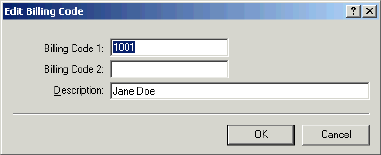
Open Text Fax Server, RightFax Edition Version 10.0 Administrator’s Guide 142
Editing Billing Code Properties
To edit the properties of an existing billing code, run Enterprise Fax
Manager, select the billing code to edit and press ENTER, or select
Edit from the Edit menu. You can also double-click the billing code.
The Edit Billing Code dialog box opens.
Figure 14.1 The Edit Billing Code Dialog Box
Billing Code 1 and 2 Enter one or two billing codes.
Description Enter a descriptive name for the billing code.
Importing Billing Codes
You can import billing code records from an ASCII text file. This is
most useful when systems such as EquiTrac or central databases
are used to store a master set of billing codes. Such systems can
be programmed to periodically generate a formatted ASCII file that
the RightFax server will recognize and process. After such a system
is configured, billing code maintenance can be fully automated.
Creating the billing code file
The ASCII billing codes file must be named Codechg.csv and must
be located in the RightFax\Worksrv folder.
The file Codechg.csv must be formatted with one complete billing
code record per line. The codes themselves cannot contain
spaces, but descriptions can. For each record, the codes and
description must be separated by commas. You can import new
billing codes as well as specify deletions and changes to billing
codes. Each billing code record must include a leading field that
indicates the desired operation. The leading field (a single
character followed by a comma in all cases) can be ‘A’ indicating an
addition, ‘C’ indicating a change to an existing code, or ‘D’
indicating that a code should be deleted.
Format Operation,BillInfo1,BillInfo2,Description
Example A,Smith,9054,Harry Smith Inc.
C,Jones,5687,Bob Jones Corp.
D,Smith,2390
(A “delete” line need not contain a description, and any included
description will be ignored.)
Configuring RightFax to import billing codes
To configure RightFax to import the ASCII billing code file, run the
WorkServer configuration program, select the WorkServer in
whose folder you saved the Codechg.csv file, and set a value in the
Billing Code Import Interval field. This parameter determines the
interval in minutes that the WorkServer should check for a new
billing code file. At every interval, the WorkServer checks for the file
Codechg.csv, in its own folder. If the file exists, the WorkServer
imports the additions, changes, and deletions specified in the file.
After the entire file is processed, the WorkServer erases
Codechg.csv so that it will not be picked up again at the next
check.
The WorkServer also produces a log file, Codechg.log, that can be
examined to see what codes were imported from the most recent
Codechg.csv. The log file is overwritten each time an import is
executed, so it will not grow indefinitely.
When writing the input file it is recommended that it not be initially
named Codechg.csv. If it is, the WorkServer may attempt to open
and process the file before you have finished building it. It is best to

Chapter 14 Creating Billing Codes 143
use a temporary name (such as Codechg.$$$) to build the file.
After all lines have been written to the file, close it and re-name it to
Codechg.csv.
Example A batch file can be created that automates this process,
for example:
j:
cd \rfax\worksrv
getcodes codechg.$$$
ren codechg.$$$ codechg.csv
In this example, GETCODES is a program supplied by
the user that creates an ASCII file of billing code
changes in the required format.
Requiring and Validating Billing Codes
Requiring billing codes on sent faxes
After you have created a list of billing codes, you can require all
users to enter one or both billing codes with each fax sent. To
require the billing code fields be completed before a fax can be
sent, run Enterprise Fax Manager, select Customize Cover Sheet
Fields from the Utility menu, and click the Sending Required
Fields tab. Select either or both of the First Billing Info or Second
Billing Info check boxes.
Fields that you have marked as required will appear bold in the Fax
Information dialog box.
Requiring billing codes on received faxes
You can also use billing codes to track information about your
received faxes. When you require billing codes on received faxes,
the recipient will not be able to delete the fax until the required
billing codes have been assigned. To require billing codes on
received faxes, run Enterprise Fax Manager, select Customize
Cover Sheet Fields from the Utility menu, and click the Receive
Required Fields tab. Check either or both the First Billing Info or
Second Billing Info fields.
Users can manually assign billing codes to their received faxes by
double-clicking the fax in FaxUtil to open the RightFax viewer and
selecting Assign From Information in the Fax menu. A dialog box
appears with fields for entering the necessary billing code
information.
Configuring billing code validation
You can configure the RightFax server to validate billing codes
against the billing code list in the RightFax server. If a supplied
billing code does not match one in your list, it will be rejected and
the fax will not send. To configure RightFax to validate billing codes,
run Enterprise Fax Manager, select Customize Cover Sheet
Fields from the Utility menu, and click the Billing Codes tab.
Check the Verify Billing Codes for Sent and Received Faxes
option.
Note Validating billing codes against an external application requires
you to create a custom utility using the RightFax API. For information on
customizing your RightFax system with the RightFax API, visit the Open
Text Knowledge Center at knowledge.opentext.com or contact Open Text
for implementation services.
Accessing ODBC Billing Codes
You can integrate billing codes from an external ODBC source for
use in all of your users’ outbound faxes. The ODBC source can be
created and configured using the ODBC configuration program.
Each client workstation must be configured individually to access
these billing codes.
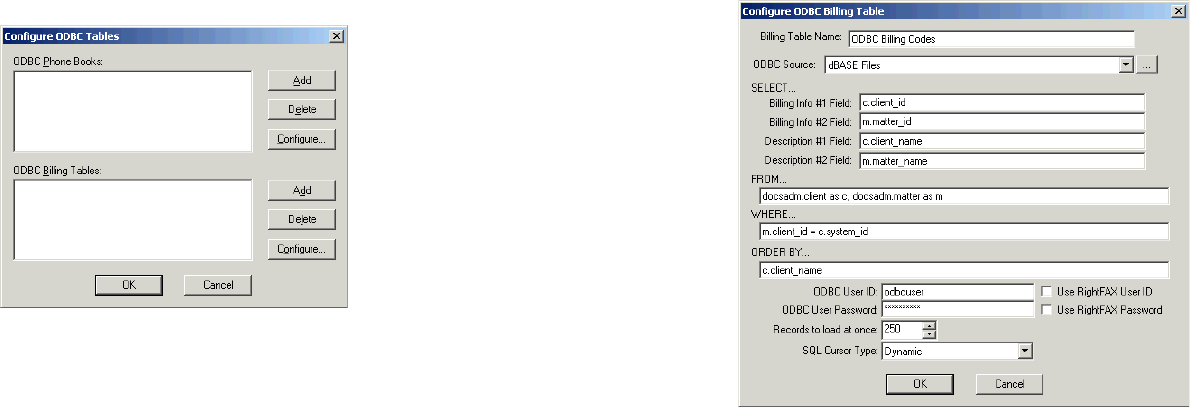
Open Text Fax Server, RightFax Edition Version 10.0 Administrator’s Guide 144
Click the RightFax tray icon in the Windows taskbar. In the shortcut
menu, select ODBC Configuration. The Configure ODBC Tables
dialog box opens.
Figure 14.2 The Configure ODBC Tables Dialog Box
Under ODBC Billing Tables, click Add. The Configure ODBC
Billing Table dialog box opens.
Figure 14.3 The Configure ODBC Billing Table Dialog Box
Complete each of the boxes according to your ODBC database
specifications.
Billing Table Name This is a descriptive name for this billing
codes table.
ODBC Source The name of your ODBC billing codes data
source.
ODBC Field Names Relates the fields of the ODBC database
to the standard RightFax billing code fields. This is done with
simple SQL query statements.
ODBC User ID and Password These are the ID and
password to access the ODBC database. If the ID and password
match those used to log into RightFax, you can check those boxes
instead.
Chapter 14 Creating Billing Codes 145
Records to Load at Once Limits the number of records
displayed at one time during billing code lookup by entering the
limit in this box.
SQL Cursor Type Selects an SQL cursor type. In most cases,
this option should be set to “Dynamic.”
Querying an ODBC billing code list
After you have configured the necessary ODBC information on a
user’s workstation, that user can access ODBC billing codes when
sending faxes.
To look up ODBC billing codes
1. In the Fax Information dialog box, click Lookup to select
RightFax billing codes or a specific ODBC billing code table.
2. Select the ODBC billing code table you created. This opens a
list of the ODBC billing codes.
3. If you limited the number of records displayed at one time in the
Records to Load at Once box in the Configure ODBC Billing
Table dialog box, you will see only the specified number of
records (or fewer). To view the previous or next batch of codes,
click the arrows on the right side of the list.
4. Click the billing code information you want, and click OK to
enter it in the Fax Information dialog box.
Open Text Fax Server, RightFax Edition Version 10.0 Administrator’s Guide 146
147
Chapter 15
Creating Library Documents
You can store frequently faxed documents (such as company
literature, credit applications, or employment forms) in a fax
document library for easy retrieval. Library documents are stored in
the RightFax\Image folder on the RightFax server formatted for fax
transmission. This allows your most frequently faxed documents to
be sent as quickly with a minimum of system resources.
Managing Library Documents
To edit or delete library documents, run Enterprise Fax Manager
(see “Starting Enterprise Fax Manager” on page 93)and click
Library Documents under the desired RightFax server in the Fax
Server Tree.
You must create a new library document in order for it to appear as
an object in Enterprise Fax Manager. New library documents are
created from the FaxUtil mailbox (see “Creating a New Library
Document” on page 149).
Deleting a library document
To delete a library document, select the document to delete and
press DELETE, or select Delete from the Edit menu. By default,
you will be prompted for confirmation that you want to delete the
library document.
Deleting the library document’s reference in Enterprise Fax
Manager does not delete the document file itself. A second
confirmation dialog box will ask you if you want to delete the file as
well.
Copying library documents from one server to another
In Enterprise Fax Manager you can copy one or more library
documents from one RightFax server to another. Select the library
documents you want to copy, and then drag the selection to
another server.
If you copy library documents from a new RightFax server version to
an earlier server version, you will lose configuration data that is not
supported by the older server (in other words, features on version
8.5 servers will not be available on version 8.0 servers).
Library document usage statistics
Enterprise Fax Manager keeps a record of each time a library
document is sent via Fax-on-Demand, the Web, or local area
network, and displays the totals in the right pane of the Enterprise
Fax Manager window. To reset these counters back to zero, click
the library documents to reset and select Reset Usage Counts in
the Edit menu.
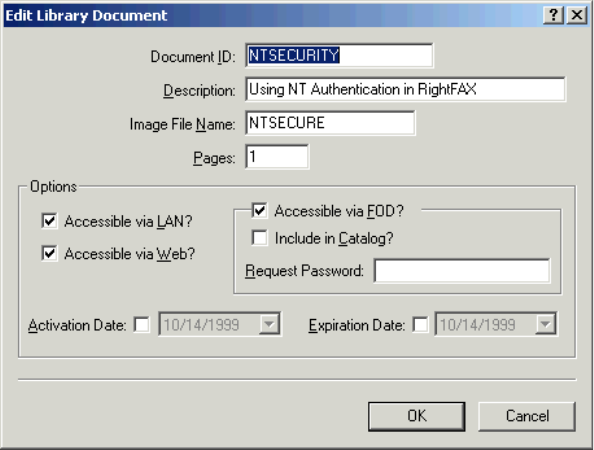
OpenText RightFax 10.0 Administrator’s Guide 148
Editing Library Document Properties
To edit the properties of an existing library document, run
Enterprise Fax Manager, select the document to edit and press
ENTER, or select Edit in the Edit menu. You can also double-click
the library document. The Edit Library Document dialog box
opens.
Figure 15.1 The Edit Library Document Dialog Box
Document ID This is a unique code that identifies the library
document. If you want the library document to be available via the
Web or Fax-on-Demand (described in the RightFax
Docs-on-Demand Guide), you must assign a numeric document
ID.
Description This is a descriptive name for the library document.
Image File Name The name of the library document file. This is
generated automatically when the library document is created and
should typically never need to be changed. All library document
files are saved in the RightFax\Image folder on the RightFax server.
Pages The number of pages in the document.
Accessible via LAN Makes the library document available on
the local area network for faxing from client workstations.
Accessible via Web Makes the library document available to
users via your Web site using Web Fax Tools.
Accessible via FOD Makes the library document available to
users via touch tone phone using Fax on Demand.
Include in Catalog Includes this document in the Fax on
Demand catalog of available faxes.
Request Password The numeric password that is required by
Fax on Demand when users request this document.
Activation Date The date that the library document becomes
available for use. Click to select the check box and select the
activation date. To make the library document available immediately,
do not select this option.
Expiration Date The date that you want the library document to
become unavailable for use. Click to select the check box and
select the expiration date. If you do not select this option, the library
document will available indefinitely.
149
Creating a New Library Document
To add new library documents in FaxUtil, you must be assigned
permission in your user profile (see “The Permissions tab” on
page 106).
Library documents are created from a fax in your FaxUtil mailbox.
You should always create library documents using Fine resolution.
To set fine resolution as the default in FaxUtil, select Tools >
Options, and the Options dialog box opens. On the Sending tab,
select the Use Fine Mode check box.
To create a new library document
1. Create the document in a word processor or other application
that lets you print to the RightFax fax printer. Send the fax image
to your FaxUtil mailbox.
2. Run FaxUtil and click the document in the list of received faxes.
3. In the Fax menu, click Store in Library. The Store Fax in
Document Library dialog box opens.
4. Specify a Document ID and Description for the new library
document. These fields and the remaining options are the same
as the Edit Library Document dialog box (page 148).
5. When you have completed the dialog box, click OK. The new
document will now appear in the Library Documents list in
Enterprise Fax Manager.
Automating the creation of new library documents
You can also automate the creation of new library documents using
the <NEWLIB> and <NEWLIB2> embedded codes. For
information on using these and other embedded codes see
Appendix A, “RightFax Embedded Codes”.
Faxing a Library Document
Library documents are sent as attachments to faxes. To attach a
library document, you have the following options:
When creating a new fax in FaxUtil, in the Fax Information dialog
box, click the Attachments tab and select the library documents
to include.
When creating a new fax using the Quick Fax/Broadcast
command from the tray icon, click the Attachments tab and
select the library documents to include.
You can also add library documents to fax-bound documents
using the <LIBDOC> and <LIBDOC2> embedded codes. For
information on using these and other embedded codes see
Appendix A, “RightFax Embedded Codes”.
OpenText RightFax 10.0 Administrator’s Guide 150
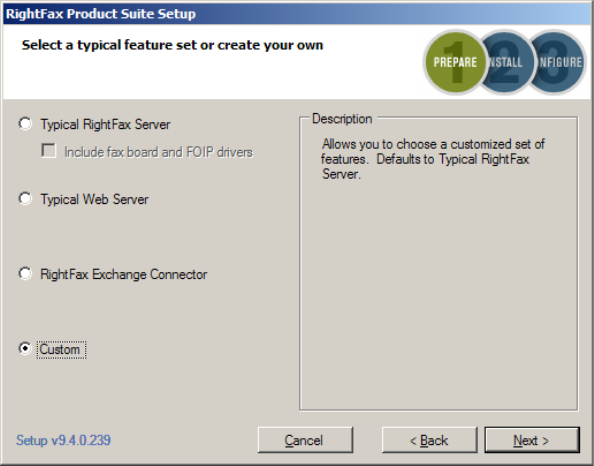
151
Chapter 16
Text Messaging Using the Push Proxy Gateway
The Push Proxy Gateway (PPG) quickly and easily enables
applications to deliver information to mobile users via Short
Message Service (SMS) text messaging. It uses a Global System
for Mobile Communications (GSM) modem or direct connection to
a Short Message Service Center (SMSC) to deliver them via the
mobile network to the target device. It can also be a natural
extension of the RightFax enterprise fax and e-document delivery
solution channels. PPG functionality can be accessed locally
and/or remotely.
To install Push Proxy Gateway
Use the following steps to install PPG during the RightFax server
installation.
1. During the setup phase of the RightFax installation, choose
Custom.
Figure 16.1 Choose Custom install during setup.
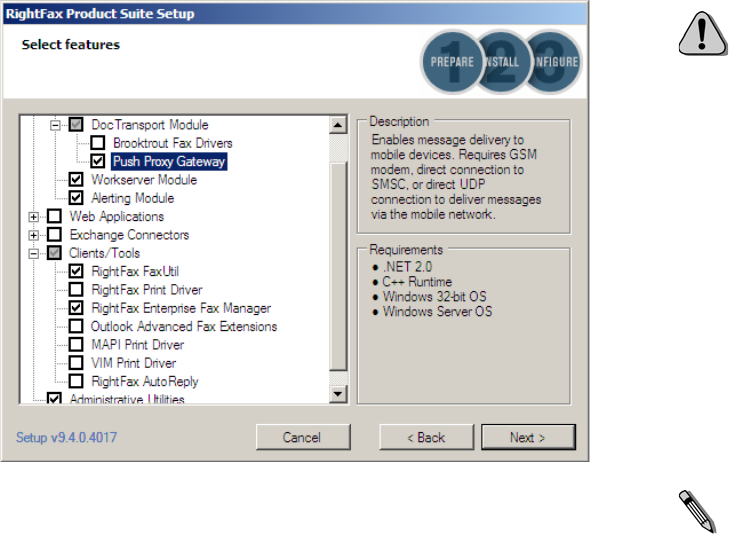
OpenText RightFax 10.0 Administrator’s Guide 152
2. On the Select features screen, expand Server Modules and
check the box for DocTransport Module. Expand
DocTransport Module, and check the box for Push Proxy
Gateway.
Figure 16.2 Choose DocTransport Module and Push Proxy Gateway
3. Proceed with the installation as you normally would, selecting
the options you require.
How to add PPG to RightFax after the initial install
To install PPG after RightFax has already been installed, do the
following:
1. Go to Add or Remove Programs in your Control Panel.
2. Choose your version of RightFax, and click Change.
3. In the wizard, choose Modify.
4. Expand Server Modules and check the box for DocTransport
Module. Expand DocTransport Module, and check the box for
Push Proxy Gateway.
5. Proceed with the installation, making any other changes you
require.
Caution The PPG's public port (default TCP 8980) should be
accessible to any computers that will send messages to the PPG. The
other ports, especially the internal port (default 5001) and the
administration port (8901) should not be accessible from the Internet. As
with all servers, take care to keep the server up to date with any
necessary patches. If the PPG accepts connections from the Internet, it is
especially important to keep Microsoft IIS up to date with security
patches.
Understanding Message Types
The PPG supports the delivery of plain text SMS messages
Plain text messages are sent by the PPG as text-only Short
Message Service (SMS) messages. All GSM handsets on the
market today can receive these SMS messages.
PPG is capable of two-way SMS messaging and can receive SMS
messages in reply to the outgoing SMS messages that it sends.
Note Plain text messages should only be used with a Modem or SMPP
connector.
153
Understanding Connectors
PPG uses connectors (sometimes called channels) to support
different methods of delivering SMS messages. Modem and
SMPP connectors are supported.
Understanding the Modem Connector
Modem connectors allow messages to be submitted to the
carrier's Short Message Service Center (SMSC) through a GSM
modem that is attached to the PPG server. You can use any GSM
modem that provides a serial-port (COM) interface and supports
the GSM 07.07 and 07.05 AT commands. The GSM modem can be
a card connected to your server, or a mobile phone (with a GSM
modem) connected to your server via a data cable. PPG supports
two serial port modems on a single server.
Modem Connector Throughput
The PPG throughput via a modem connector, using API, is as
follows:
Single Modem:
Sending Outbound only: 14 per minute
Receiving Inbound only: 14 per minute
Two-way (In and out simultaneously): 10 per minute
Two Modems:
Outbound only: 14 per minute
Inbound only: 30 per minute
Two-way (In and out simultaneously): 10 per minute
Understanding SMPP Connectors
SMPP connectors allow a high volume of messages to be sent via
an SMSC. The supported protocol is SMPP version 3.4.
SMPP Connector Throughput
The PPG throughput via an SMPP connector, using API, is as
follows:
Two-way (simultaneously): 120 per minute
Understanding Two-Way SMS Support
PPG supports two-way SMS messaging via SMPP or Modem
connectors.
Two-Way SMS and SMPP Connectors
PPG can use SMPP connectors to assist RightFax in associating
incoming SMS messages with RightFax user mailboxes for routing
purposes.
The wireless carrier allocates a phone number or short code to the
PPG Administrator. This number is referred to as a reply number.
The reply number is used by mobile devices to reply to the SMS
messages sent to them via the PPG. It is also used by the SMSC
to receive the incoming SMS messages, that are then sent to PPG.
When PPG sends an SMS message, it specifies one of these
available numbers in the From field. The recipient device sends an
SMS message back to one of the reply numbers, all of which are
intercepted by the SMSC and routed to PPG. Then, PPG can
send the reply number, message contents, and the replying
device’s address to RightFax.
Understanding Log Files
PPG maintains log files in its program directory. The three log file
types are transaction, error, and debug logs. The log files are
rotated, or rolled, every 24 hours by default, where each roll occurs
at zero-hundred hours. When this occurs, new log files are created
with filenames based on the current time.
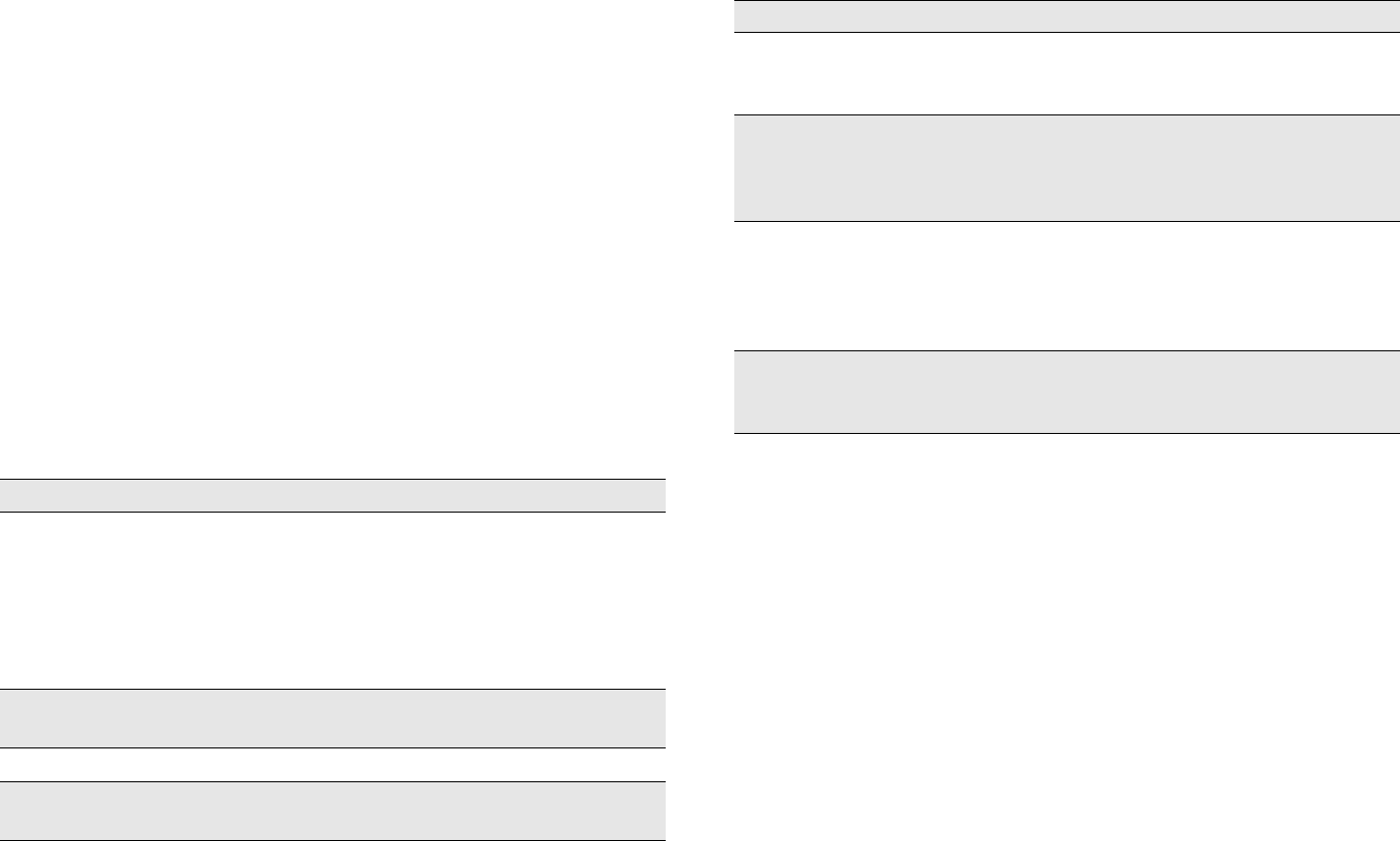
OpenText RightFax 10.0 Administrator’s Guide 154
The interval setting for transaction logs can be changed so that the
roll occurs anytime between 10 minutes and 24 hours. A directory
to which the transaction log files are saved can be specified.
Transaction log files are generated in a standard format that can be
parsed or saved by external applications, as shown in Table 3a.
Error log files display error and warning messages that are also
viewable in the debug log file. Debug log files do not need to be
enabled in order to generate and view the error log files.
The rolled logs and the current logging file have file names with the
following format:
prefix-GYYYYMMDDHHMM.LOG
In the above format, prefix is cppg for transaction log files, dbgp for
debug log files, and errp for error log files.
Understanding Transaction Logs
The following table lists the formats used in a PPG transaction log.
The transaction logs use this format:
Type: [value]; PI: [value]; MessageID: [value];
FromAddress: [value]; ToAddress: [value]; NotifyTo:
[value]; Status: [value]
Transaction log example:
12/03/2003 13:50:36:923 - Type: Outbound; PI:
1.2.3.4; MessageID: PI/64; FromAddress:
14255551234; ToAddress: +14255551212; NotifyTo: ;
Status: Delivered
Configuring the Push Proxy Gateway
You can configure PPG using the RightFax interface. This section
describes the PPG configuration options, and provides information
Table 16a Transaction log formats
Col Value Description Example
1Type The type of message:
Outbound, Inbound,
Notification, and
Service. Service is
used for PPG Service
Startup/Shutdown
messages.
Type: Outbound
2Date and time Date and time of
request
12/03/2003 13:50:36:923
3 - Static - separator -
4Push Initiator
address
IP address of the Push
Initiator
PI: 1.2.3.4;
5Push ID Push ID extracted
from the PAP
message
PushID: PI/64;
6Device
address
(destination)
Subscriber number or
address of destination
extracted from PAP
message
Device: +14255551212;
7Notification
URL
Address to be notified
when the message
has been sent. Does
not apply to Modem
connector.
NotifyTo: ;
8Status Status of the
message, either
Delivered or Failed.
Status: delivered
Table 16a Transaction log formats
Col Value Description Example
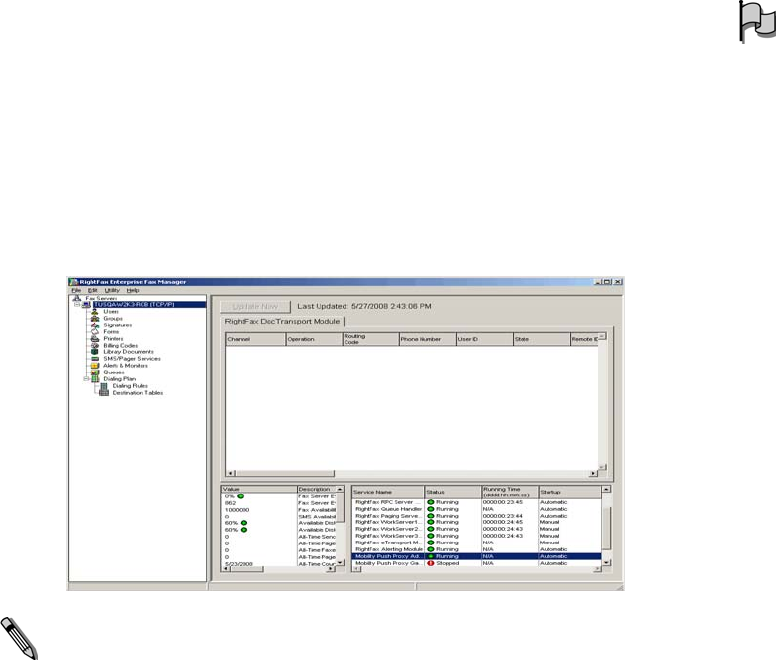
155
to help you get up and running.
Stopping and Starting the PPG Services
The PPG and the PPG Administration run as Windows services
and can be started and stopped via RightFax Enterprise Fax
Manager.
1. Choose Start > Programs > RightFax Enterprise Fax
Manager.
2. In the left pane, select the server on which PPG is installed.
3. Right-click the PPG service that you wish to start or stop,
located in the Service Name column.
Click Start Service to start the selected service.
Click Stop Service to stop the selected service.
Figure 16.3 Starting or stopping the PPG service.
Note You should not use the remote feature of the Windows Service
Control Manager. To control the service from a remote computer, use
Terminal Services to log on to the server and use the Windows Service
Control Manager.
Accessing and Configuring the PPG
After you make changes in the PPG interface via RightFax,
(described in the following sections), you must stop and restart the
PPG service before the changes will take effect. For more
information, see the previous section.
Important You must add PPG as a Transport in the Doc Transport
Module before you can configure and use the PPG. Refer to the
DocTransport Module chapter in this guide for more information.
Accessing PPG via RightFax
You can access PPG configuration options via the Enterprise Fax
Manager.
To access PPG via RightFax
1. Choose Start > Programs > RightFax Enterprise Fax Manager.
2. In the left pane, select the server on which PPG is installed.
3. Double-click Mobility Push Proxy Administration, located in the
Service Name column.
The PPG Administration dialog box displays.
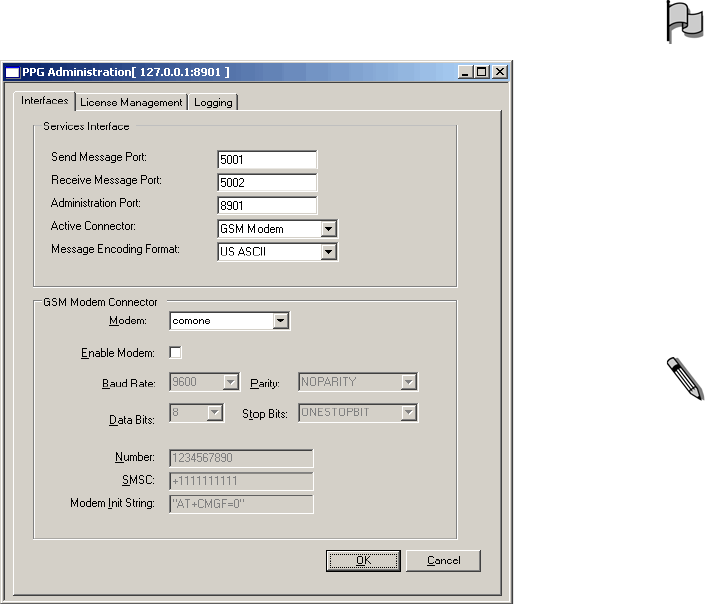
OpenText RightFax 10.0 Administrator’s Guide 156
Using the Interfaces tab
The Interfaces tab establishes connection details for the PPG. The
Connector section of the tab displays different fields when you
change the Active Connector.
Figure 16.4 The Interfaces tab —Modem
Send Message Port Enter the port number of the Internal
Interface. This is a port used for communication between the IIS
extension and the PPG service. It should not be accessible by
outside/Internet computers. The port value is 5001 by default.
Receive Message Port The PPG service sends inbound
messages to RightFax via this port. This port uses 5002 by default.
Administration Port The PPG Administration service listens
on this port for configuration requests and uses 8901 by default.
This port must be on the machine where PPG is installed.
Important Some of the ports used by the PPG by default are
registered as service contact ports with the Internet Assigned Numbers
Authority (IANA). If you encounter a port conflict, you can assign a
different port number by modifying the entries on the Interface page or
editing the CPPG.INI file.
Refer to http://www.iana.org/assignments/port-numbers for a list of
registered ports.
Active Connector Choose the connector to be used by the
PPG. GSM Modem and SMPP are supported.
Message Encoding Format Select US ASCII for the standard
US ASCII character set, or select UCS-2 if you need diacritical
characters or most double-byte languages.
Note SMS message size limits When sending messages via the
Modem connector, all messages are carried in a single SMS message. In
the GSM environment, a single SMS message holds 140 bytes of
information.
US ASCII messages can be up to 160 characters in length.
UCS-2 messages can be up to 70 characters in length.
These fields are specific to the GSM Modem connector:
Modem Select an available modem from the drop down box.
Enable Modem Select this checkbox to instruct PPG that the
selected port is active and should use these configuration settings.
Baud Rate, Data Bits, Parity, and Stop Bits Change the
fields for Baud Rate, Data Bits, Parity, and Stop Bits as appropriate
for the modem in use.
Number The phone number of the cell phone or cellular modem
that will connect to the communications port.
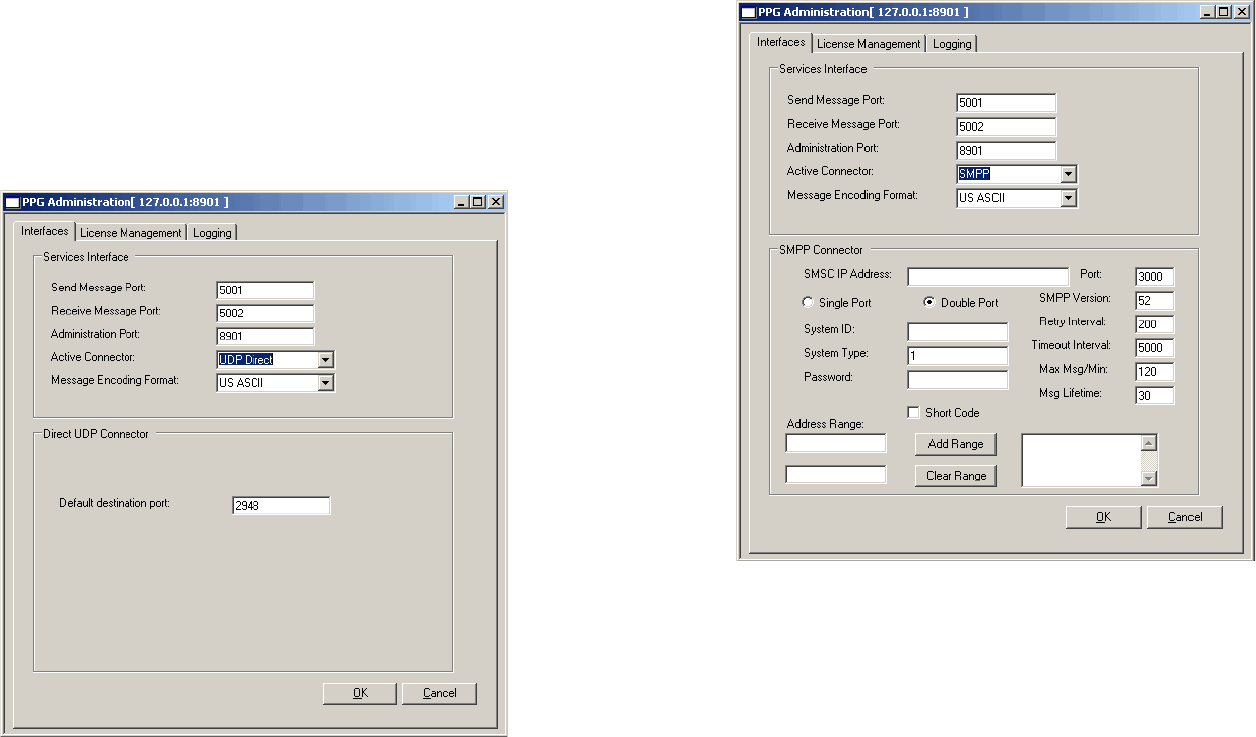
157
SMSC Enter the telephone number of the SMSC used by the
carrier to which your modem is subscribed. Contact your carrier to
get this number.
Modem Init String Enter the initialization string. The default is
“AT+CMGF=0”. The initialization string can be found in the phone’s
manual.
These fields are specific to the UDP connector:
Figure 16.5 The Interfaces tab — UDP
Default Destination Port — The PPG uses port number 2948.
RightFax 9.4 does not use the UDP connector.
These fields are specific to the SMPP connector:
Figure 16.6 The Interfaces tab — SMPP
SMSC IP Address The IP address of the carrier.
Single Port Choose to instruct PPG to communicate with the
SMSC via a single port.
Double Port Choose to instruct PPG to communicate with the
SMSC via a dual port. This is the default.
System ID This is identification on the carrier’s system, such as a
user name. It is provided by the carrier.
System Type This is additional information used to identify the
user and is provided by the carrier.
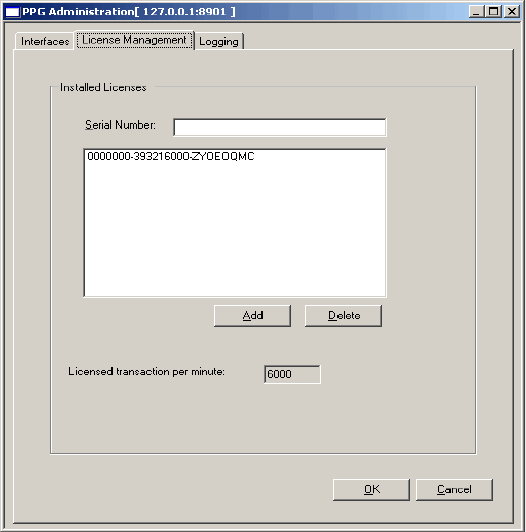
OpenText RightFax 10.0 Administrator’s Guide 158
Password This password is used to connect to the SMSC and
is provided by the carrier.
Port The port used to connect to the SMSC, in the format IP
Address:Port.
SMPP Version The version number is generally 3, depending
on the SMSC implementation.
Retry Interval The number of seconds the PPG waits to retry a
connection, after a connection fails.
Timeout Interval The connection is no longer valid if a
response is not received within this number of milliseconds.
Max Msg/Min The maximum number of messages sent per
minute.
Msg Lifetime The number of hours a message is considered
valid. The message is discarded if it is not delivered within this time
frame.
Short Code Select if using a shortened phone number, if one
was assigned to you.
Address Range Input the range of phone numbers assigned to
your SMPP connection.
Add an individual number by entering it in the upper field, then
clicking Add Range.
Add a range of numbers by entering the beginning of the range in
the upper field and the end of the range in the lower field. Click
Add Range. The assigned numbers in the range are
automatically generated.
Add Range Click to specify the addresses as entered in the
Address Range fields.
Clear Range Click to delete all of the numbers currently
assigned to this connection.
Using the License Management tab
The License Management tab allows you to add or remove PPG
licenses.
A transaction is defined as one message sent to one address. For
example:
One SMS message, sent to one phone, equals one transaction.
One SMS message, including a list of 10 phone numbers, equals
10 transactions.
Figure 16.7 The License Management tab
Serial Number — The full license key.
Add — Click to add the license entered in the Serial Number field
to the list of available PPG licenses.
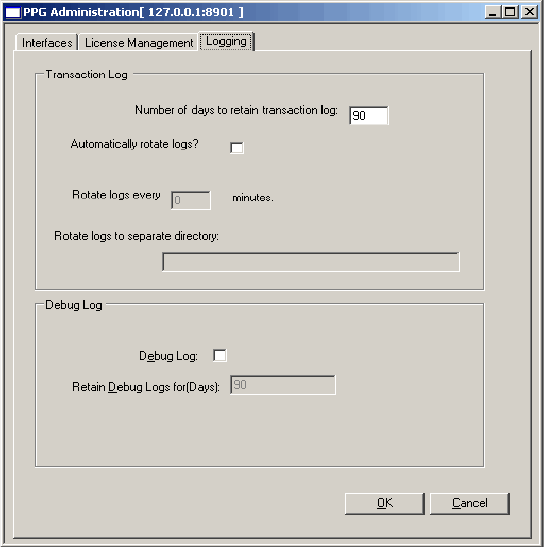
159
Delete — Click to remove a selected license from the list.
Licensed transaction per minute — A license is
automatically installed that allows 6000 transactions per minute.
This high number allows more licensed transactions than the server
could ever possibly process, so there is essentially no need for
additional licenses.
Using the Logging tab
The Logging tab determines how transaction and debug log files
are collected. The transaction log contains the Call Detail Records
(CDR) and will be of the form:
cppg-GYYYYMMDDHHMM.LOG
where G is the gateway ID, and the rest of the string is the date
and time the log file started.
See “Understanding Log Files” on page 153 for more information
about log files.
Figure 16.8 The Logging tab

OpenText RightFax 10.0 Administrator’s Guide 160
Number of days to retain transaction logs - Enter a value
for how many days old log files will remain on the system. By
default, 90 days of previous log activity is saved.
Automatically rotate logs - Select to rotate log files
automatically. By default, the server’s log file is closed and a new
log file is created at midnight each day. This option closes the
current log file and opens a new one more frequently.
Rotate logs every n minutes — Specifies how often log files
should be rotated. Type the value in hours and minutes (00:10 to
24:00).
Rotate logs to separate directory - By default, the rotated
log files are saved in the PPG installation directory. To save the log
files in a different directory, type the complete path of the target
directory in this box.
Note Log files must be saved on a local drive. They cannot be saved to
a mapped network drive.
Debug Log - Select to enable a detailed log file of gateway
activity. Debug logs can be quite large, so this setting should be off
for normal operation. If the debug log is enabled, then the PPG
service must be stopped and restarted before it will take effect.
Important Enable the “Enable Debug Log” setting only if directed to do
so by customer support.
Retain Debug Logs for (Days) — Enter a value for how many
days the debug log files will remain on the system. The default is
90.
161
Chapter 17
Adding SMS and Pager Services
You can configure the RightFax server to send email, pager
messages, or SMS messages to fax users and administrators to
alert or notify them of specific RightFax events. To send these alerts
and notifications from RightFax, you must create a list of available
services and providers.
If you will be configuring SMS notifications, you must first install
and configure the RightFax Push-Proxy Gateway (see Chapter ,
“Text Messaging Using the Push Proxy Gateway”).
To install the RightFax Push-Proxy Gateway
1. Run Add/Remove Programs from Windows Control Panel,
highlight RightFax Product Suite, and then click Change.
2. Click Next at the opening screen. This opens a list of installation
options. Select Modify and click Next.
3. On the Setup Features screen, expand the RightFax Server
category and select Push Proxy Gateway for install. Click
Next.
4. Complete the Installation Wizard according to the instructions
in the RightFax Installation Guide.
5. When you are prompted to reboot the computer, click Yes.
6. After the computer restarts, select Start > Programs >
Enterprise Fax Manager.
7. In the Enterprise Fax Manager application, click the name of the
RightFax server to configure in the tree in the left pane. A list of
services appears at the lower-right pane of the window.
8. In the Service Name list, double-click RightFax DocTransport
Module. The Transport Configuration dialog box opens. (The
DocTransport configuration program is described more
thoroughly in “Configuring the DocTransport Modules” on .
9. Click the Add Transport button. In the Select Transport dialog
box, select the option SMS Via Push-Proxy Gateway in the left
pane and the click Select. This will add SMS functionality to the
RightFax server.
10.Close the DocTransport configuration program and select
Start > Programs > Enterprise Fax Manager.
11.In the Enterprise Fax Manager application, select Dialing Rules
under the local fax server in the left pane.
12.Press INSERT to add a new dialing rule. Click the Destination
tab and select SMS in the Send Via Transport box.
13.Close Enterprise Fax Manager.
After it is installed, the Push-Proxy Gateway must be configured for
your organization’s specific needs. For information on configuring
the RightFax Push Proxy Gateway, refer to the RightFax
Push-Proxy Gateway Guide.
OpenText RightFax 10.0 Administrator’s Guide 162
Managing SMS and Pager Services
You must create a pager service configuration for each type of
services, run Enterprise Fax Manager and click SMS/Pager
Services under the desired RightFax server in the Fax Server Tree.
Adding SMS and pager services
To add a new pager service to RightFax, press INSERT or select
New from the Edit menu. The Edit SMS/Pager Service Definition
dialog box opens. For information on completing the options in this
dialog box, see “Editing SMS and Pager Service Properties” on
page 162.
After you have created a list of SMS and pager services, you can
configure fax user notifications and administrative alerts. Fax status
notifications and how they will be delivered are configured
individually for each RightFax user (described on page 111). A
default notification method can also be configured for groups,
(described on page 121). Fax server status alerts for
administrators can be configured for individual administrative users
(described on page 112), or you can use the RightFax Alerting and
Monitoring service to create and customize a list of server statistics
to monitor and alert on (described in Chapter Chapter 18, “Using
the Alerting and Monitoring Service”).
Users can be paged via SMTP email (requiring Internet
connectivity), via TAP or UCP protocols (requiring any
TAPI-compatible or AT-compatible modem), or send SMS
messages (requiring the Captaris Push-Proxy Gateway).
Deleting SMS or pager services
To delete a pager service, select the service to delete and press
DELETE, or select Delete from the Edit menu.
Copying SMS and pager services from one server to
another
In Enterprise Fax Manager, you can copy one or more pager
services from one RightFax server to another. Select the pager
services to copy, and then drag the selection to another server.
If you copy pager services from a new RightFax server version to an
earlier server version, you will lose configuration data that is not
supported by the older server (in other words, features on version
8.5 servers will not be available on version 8.0 servers).
Editing SMS and Pager Service Properties
To edit the properties of an existing service, select the pager
service to edit and press ENTER, or select Edit from the Edit
menu. You can also double-click the service. Each type of service
you add has different configuration settings. the sections that
follow describe each type of service and the required configuration
options.
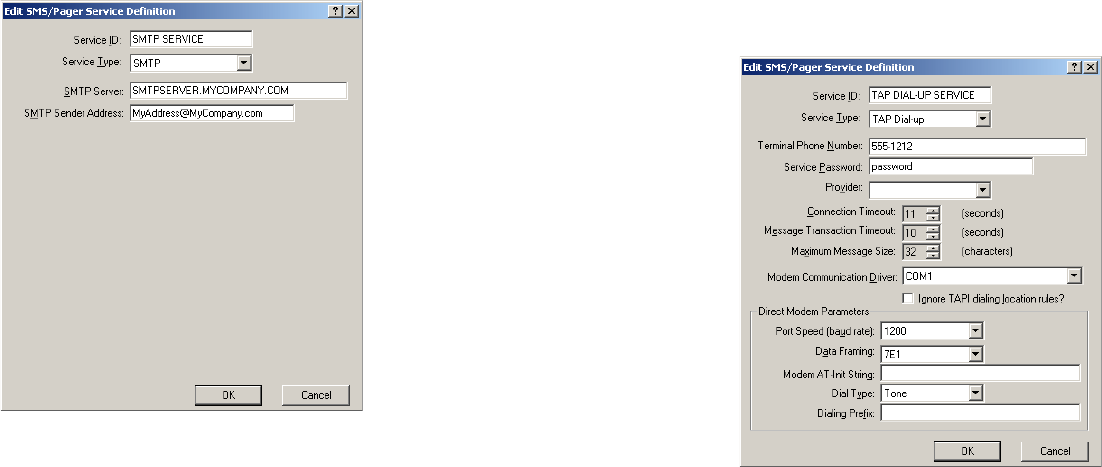
163
Configuring SMTP services
Figure 17.1 SMTP service configuration
Service ID This is a descriptive ID for the service provider or
type of service. When you edit and change the service ID of a listed
pager service, Enterprise Fax Manager creates a copy of the
service with the new name, rather than re-naming the service.
Service Type Select SMTP as the service type.
SMTP Server The name of your service provider’s SMTP server.
SMTP Sender Address This is an SMTP mail address from
which the page will be sent. Some SMTP message servers require
the sender’s SMTP address in order to process transactions.
Configuring TAP and UCP Dial-up services
TAP dial-up and UCP dial-up both have the same configuration
options.
Figure 17.2 TAP and UCP dial-up service configuration
Service ID This is a descriptive ID for the service provider or
type of service. When you edit and change the service ID of a listed
pager service, Enterprise Fax Manager creates a copy of the
service with the new name, rather than re-naming the service.
Service Type Select TAP Dial-up or UCP Dial-up as the service
type.
Terminal Phone Number This is your service provider’s
modem phone number (for TAP and UCP messaging only).
Service Password The password your service provider requires
to access their TAP or UCP messaging systems (if any).
Provider Specify the specific provider for your UCP or TAP
service. If your provider is not listed here, select “None.”
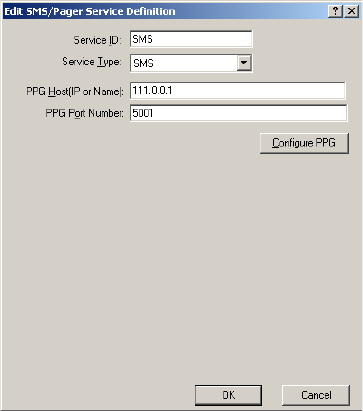
OpenText RightFax 10.0 Administrator’s Guide 164
Connection Timeout The length of time, in seconds, for
RightFax to successfully connect to the TAP or UCP messaging
system. If a timeout occurs, RightFax will abandon the call and no
message will be sent.
Message Transaction Timeout The length of time, in
seconds, for RightFax to successfully send the message to the TAP
or UCP messaging system. If a timeout occurs, RightFax will
abandon the call and no message will be sent.
Maximum Message Size The maximum number of characters
allowed by your service provider for pager or SMS messages.
Modem Communication Driver Specify the COM port for
the modem on the RightFax server. If you have installed one or
more TAPI modems on your RightFax server, you can select from
those modems as well. If you select a TAPI modem, the Direct
Modem Parameters settings (described later) will be unavailable
because those settings will be taken from your TAPI modem
configuration on the RightFax server.
Ignore TAPI Dialing Location Rules Ignores any specified
dialing location rules (such as add 9 to dial out) if you have
specified a TAPI modem in the Modem Communication Driver
box (described earlier).
Direct Modem Parameters These parameters are configured
according to your modem type and phone system dialing
requirements. If your pager or SMS service provider recommends a
baud rate for connecting to their TAP or UCP systems, enter the
baud rate in the Port Speed box.
Configuring SMS services
Figure 17.3 SMS service configuration
Service ID This is a descriptive ID for the service provider or
type of service. When you edit and change the service ID of a listed
pager service, Enterprise Fax Manager creates a copy of the
service with the new name, rather than re-naming the service.
Service Type Select SMS as the service type.
PPG Host (IP or Name) Use the default value for the PPG
Host.
PPG Port Number Use the default value for the PPG Port
Number.
165
Logging SMS and Pager Alerts
SMS and pager alerts are logged in the Windows Event Log with a
special event identifier. The purpose of this identifier is to allow
Windows monitoring systems to identify when an alert has
occurred without monitoring the contents of the event entry. To
filter on these events, filter for Source = “RightFax Server Module”
and Category = “Administrative Alert.”
At least one person must be set up to receive an alert of each type
to cause this logging to occur. If no users are set up to receive
alerts, then none will be logged in the NT Event Log using the
special event identifier.
OpenText RightFax 10.0 Administrator’s Guide 166
167
Chapter 18
Using the Alerting and Monitoring Service
The RightFax Alerting and Monitoring service lets you monitor a set
of server statistics that you define in Enterprise Fax Manager and
receive alerts relating to those statistics. To use the RightFax
Alerting and Monitoring service, you must first install and configure
the service, and then define the statistics to monitor and their alert
thresholds.
Installing the Alerting and Monitoring Service
There are two ways to install the RIghtFax Alerting service:
During initial RightFax setup, select a custom installation and
check the box for Alerting Module under RightFax Server
Modules. If you do not manually check the Alerting Module box,
the service will not be installed.
After RightFax installation, use the Windows Control Panel to
modify the RightFax product suite and select the Alerting Module
under the Server Modules Section.
For more details about RightFax Installation procedures, see the
RightFax Installation Guide.
Because the RightFax Alerting service is designed to provide
information about and send alerts relating to the RightFax server,
you may choose to run the Alerting service on a computer other
than the RightFax server. When the Alerting service is installed on a
remote computer, it will continue to operate and send alerts even if
the RightFax server shuts down or experiences other problems.
When the Alerting service is installed on a remote computer, all of
the configuration for the service and the individual alerts is
managed on the RightFax server that the service will be monitoring.
No additional configuration on the remote computer is required.
Configuring the RightFax Alerting Service
To configure the Alerting and Monitoring service, open Windows
Control Panel and double-click RightFax Alerting Monitoring. The
Alerting & Monitoring Configuration dialog box opens.
The rest of this section describes the options on each of the tabs
on this dialog box.
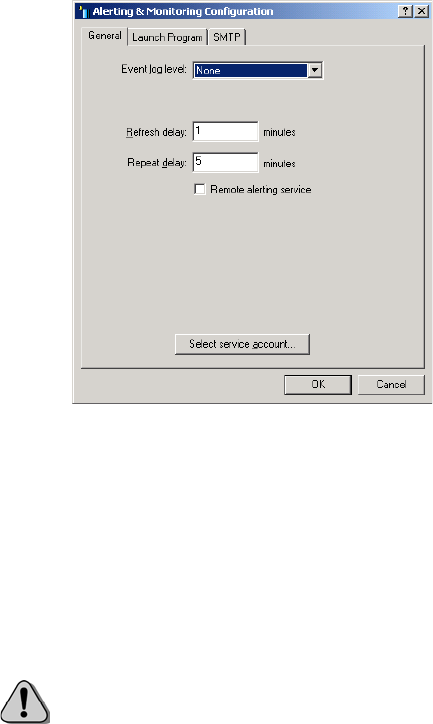
OpenText RightFax 10.0 Administrator’s Guide 168
The Alerting and Monitoring Configuration General Tab
Figure 18.1 The Alerting & Monitoring Configuration General tab
Event log level Specify the level of information logged in the
Application Event Log under the service name “RightFax Alerting
Module.” You can select the following options:
None. No information is saved.
Terse. Records critical errors only.
Normal. Records errors and major events only.
Verbose. Records all significant events and is most useful for
tracking and resolving problems.
Caution If you leave this value set to “Verbose” for long periods of
time, the Event Log can become full which may prevent new events
from being logged.
Refresh delay Specify the frequency, in minutes, that the
Alerting service will poll the RightFax server for statistics.
Repeat delay Specify the frequency, in minutes, that alerts will
be sent when statistic thresholds are met.
Remote alerting service This option indicates that the Alerting
service will operate on a computer separate from the RightFax
server. If you select this option, the Alerting service will not be
started automatically by the Server module.
Select service account The RightFax Alerting service logs on
to the network by default using the local system account. Click this
button to optionally specify a different Windows user account for
the service to use. If you want the Alerting service to authenticate
to the RightFax server using NT authentication, you must select a
Windows user account that has a corresponding RightFax user
with NT authentication enabled.
When you select this option, the Select service account dialog
box opens. For information on how to complete the options on this
dialog box, see “Selecting a Service Account” on page 42.
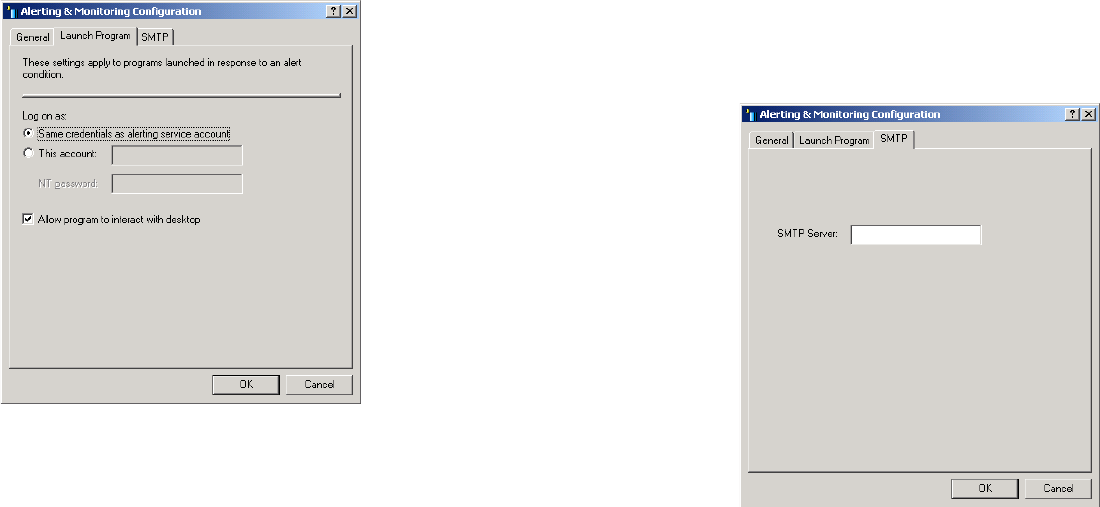
169
The Alerting and Monitoring Configuration Launch
Program Tab
Figure 18.2 The Alerting & Monitoring Configuration Launch Program tab
The RightFax Alerting service lets you optionally run a program
(such as a batch file or other process) when thresholds for
monitored statistics are reached. The options on this tab let you
configure how these programs will be launched by the Alerting
service.
Log on as Programs launched by the Alerting service require a
Windows user account in order to access the network. Select one
of the following options:
Same credentials as alerting service account. Programs
launched by the Alerting service will use the same user account
information as the Alerting service.
This account. Specify a Windows user account other than that
used by the Alerting service. If you select this option, you must
also enter the password for the specified user account in the NT
password box.
Allow program to interact with desktop Specifies whether
the program launched will be accessible from the Windows
desktop and usable by whomever is logged on when the service is
started.
The Alerting and Monitoring Configuration SMTP Tab
Figure 18.3 The Alerting & Monitoring Configuration SMTP tab
The RightFax Alerting service lets you optionally deliver alerts as
email messages via SMTP when thresholds for monitored statistics
are reached. In the SMTP Server box, enter the name of the SMTP
server that will transport these alerts. The email addresses to which
alerts will be sent are configured for each individual alert in
Enterprise Fax Manager (described in the next section).
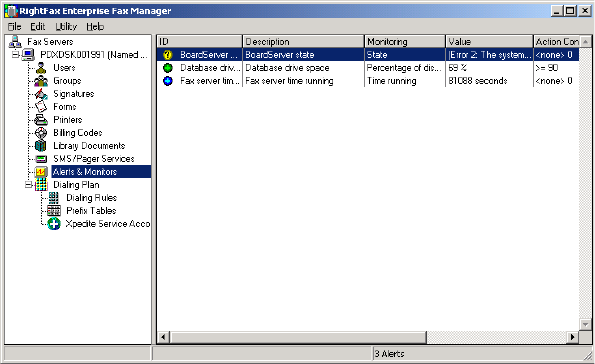
OpenText RightFax 10.0 Administrator’s Guide 170
Defining the Statistics to Monitor and
their Alert Thresholds
To create, edit, or delete individual alerts, run Enterprise Fax
Manager (see “Starting Enterprise Fax Manager” on page 93) and
click Alerts & Monitors under the desired RightFax server in the
Fax Server Tree.
Figure 18.4 The Alerts and Monitors List
The alerts and monitors that you create are displayed when you
click Alerts & Monitors in Enterprise Fax Manager. Each monitor is
preceded by a colored icon to indicate its current status. These
icons are:
Yellow. Indicates an error retrieving the value of the statistic.
Blue. Indicates that the statistic is being monitored but no alert
has been set.
Green. Indicates that the statistic that has an associated alert
condition, but the condition has not been met.
Red. Indicates that the statistic that has an associated alert
condition, and the condition has been met.
The current value for the statistic you are monitoring is displayed in
the Value column. Not all monitored statistics can be configured to
deliver an alert. Monitored statistics that are configured to deliver
alerts are indicated by a green icon in the ID column. Statistics that
cannot be configured to deliver an alert are indicated by a blue
icon. Statistics that cannot be determined due to failure of the
monitored service or other problems are indicated by a yellow icon.
Adding new alerts
To create a new alert, press INSERT or select New from the Edit
menu. The Alert Properties dialog box opens. For information on
completing each of the options on each tab see “Editing Alert
Properties” on page 171.
Deleting alerts
To delete an alert, select the alert to delete and press DELETE or
select Delete from the Edit menu. You will be prompted for
confirmation that you want to delete the alert.
Copying alerts from one server to another
In Enterprise Fax Manager, you can copy one or more alerts from
one RightFax server to another. Select the alerts you want to copy,
and then drag the selection to another server in the Fax Server
Tree.
Note: If you copy alerts from one RightFax server version to a
different server version, you will lose any configuration data that is
not supported by the second server. For example, RightFax 10
generates fax board information with DocTransport, but RightFax
9.3 uses BoardServer for similar information. If you copy a
DocTransport alert to a 9.3 server, it will not trigger because the
older server can’t monitor the newer service. If you copy a 9.3
BoardServer alert to a RightFax 10, it will not
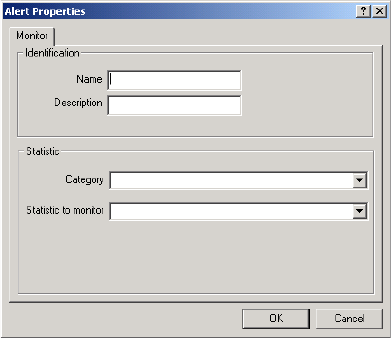
171
Editing Alert Properties
To edit the properties of an existing alert, run Enterprise Fax
Manager, select the alert to edit and press ENTER, or select Edit
from the Edit menu. You can also double-click the alert. The Alert
Properties dialog box opens.
Figure 18.5 The Alert Properties Monitor Tab
Some of the statistics that you configure in this dialog box do not
support alerts. These statistics can be configured entirely on the
Monitor tab. If you select a statistic for which an alert can be
configured, two additional tabs, Actions and Message, will appear
on this dialog box. These tabs are described later in this section.
Name This is the name of the alert that will appear under the ID
column in Enterprise Fax Manager.
Description This is the alert description that will appear under
the Description column in Enterprise Fax Manager.
Category Alerts are divided into several categories. The statistics
that you can monitor (selected in the Statistics to monitor box) will
differ depending on the category you select. Select from the
following options:
Fax Server. Statistics related to activity and events on the
RightFax server.
Database. Statistics related to the RightFax database.
Workserver. Statistics related to WorkServers and the
processes they control.
Gateway. Statistics related to email gateways.
Local BoardServer. Statistics related to the BoardServer service
on the RightFax server.
All BoardServers. Statistics related to the local BoardServer
and any remote BoardServer services.
RPC Server. Statistics related to the RPC server which
coordinates communication between the RightFax server and
other resources on the network.
Paging Server. Statistics related to the paging server used to
send notifications via SMS and pages.
Statistic to monitor Select the statistic you want to monitor.
The statistics that you can monitor will differ depending on the
category you select. For a description of each statistic in this list,
see Appendix D, “Alerting and Monitoring Statistics”. Depending
on the statistic you select, additional options may appear below the
Statistic to monitor box. These additional options must be

OpenText RightFax 10.0 Administrator’s Guide 172
completed in order to correctly define the statistic. For a definition
of these options, click the [?] icon in the title bar and then click on
the option to define.
Caution Alerting statistics that allow you to specify a fax channel
number require that you start numbering from 1. This differs from the
BoardServer configuration which starts numbering channels with 0
(zero). If you want to monitor the first fax channel, you must specify
channel 1, even though it is numbered as channel 0 in the BoardServer.
If you specify channel 0 in the alerting statistics to monitor, it will be
changed automatically to channel 1.
The Actions tab
When you select a statistic on the Monitor tab for which an alert
can be generated, two additional tabs will appear on the Alert
Properties dialog box: Actions and Message. See Appendix D,
“Alerting and Monitoring Statistics” for a list of statistics that
support alerts. You must complete the options on both of these
tabs in order to generate an alert.
The options on the Actions tab let you define the conditions and
thresholds under which an alert will be generated, as well as the
alert action to take when a statistic’s threshold is met.
Figure 18.6 The Alerting Properties Actions tab
Condition Select the operator by which the threshold value will
be evaluated.
Threshold Specify a threshold value. An alert will be generated
only if the condition you select meets this threshold value.
Alert on error If this option is selected, an alert will be
generated if the value for the statistic cannot be generated due to
errors or other problems with the RightFax service being polled.
Actions The options in this group box let you create, edit, and
delete alert actions that will be taken when the statistic threshold is
met. You can configure multiple actions for each alert. Follow these
steps to create a new alert action:
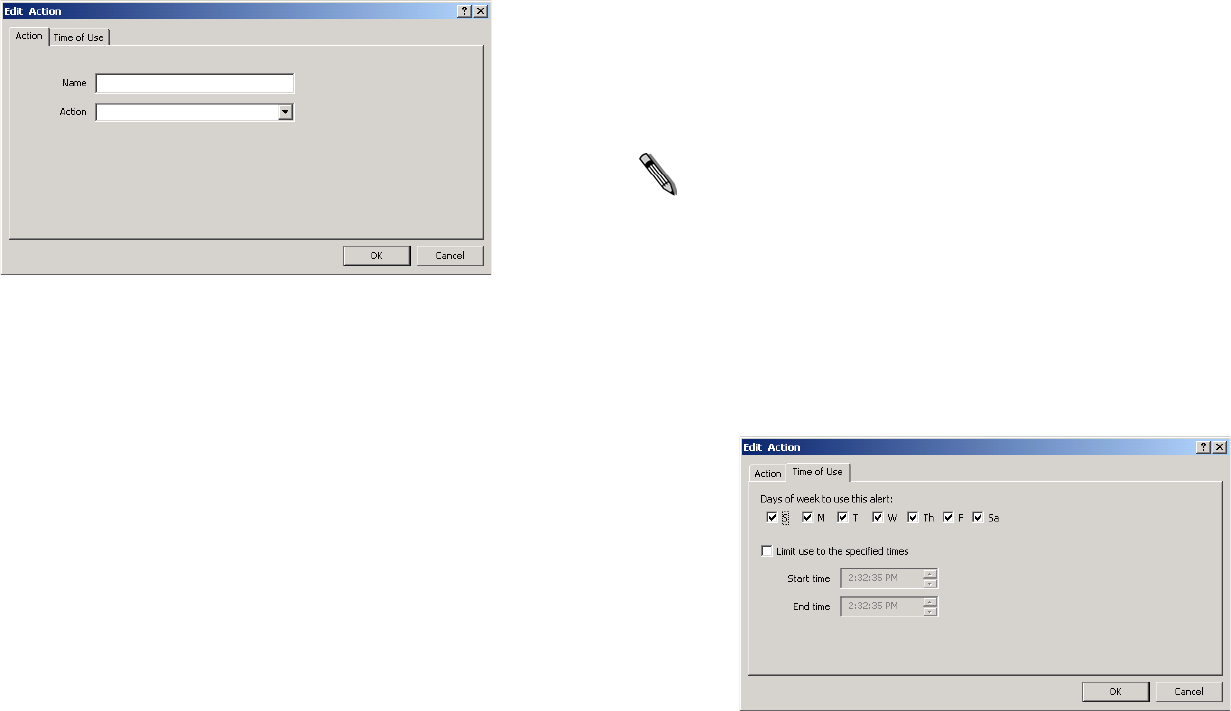
173
To create a new alert action
1. Click the New Action button in the Actions group box. This
opens the Action tab of the Edit Action dialog box.
Figure 18.7 The Edit Action dialog box Action tab
2. In the Name box, type a name for the alert to create.
3. In the Action box, select the type of alert to send. Alerts can be
sent using these methods:
Program. The RightFax Alerting service lets you optionally
run a program (such as a batch file or other process) when
thresholds for monitored statistics are reached. A specified
program will be launched.
SMS. A message will be sent to an SMS-capable device
such as a cell phone or PDA.
SMTP. An email message will be sent to a specified user via
an SMTP server.
Note: The Network Broadcast Action is no longer functional in any
of the currently supported Windows operating systems.
Depending on the type of alert action you select, additional
options will appear below the Action box. These additional
options must be completed for the alert to successfully send.
For a definition of each of these options, click the [?] icon in the
title bar and then click on the option to define.
4. When all of the options on the Action tab have been completed,
click the Time of Use tab.
Figure 18.8 The Edit Action Time of Use tab
5. To limit the alert to occur only on specific days, select the active
days under Days of the week to use this alert.
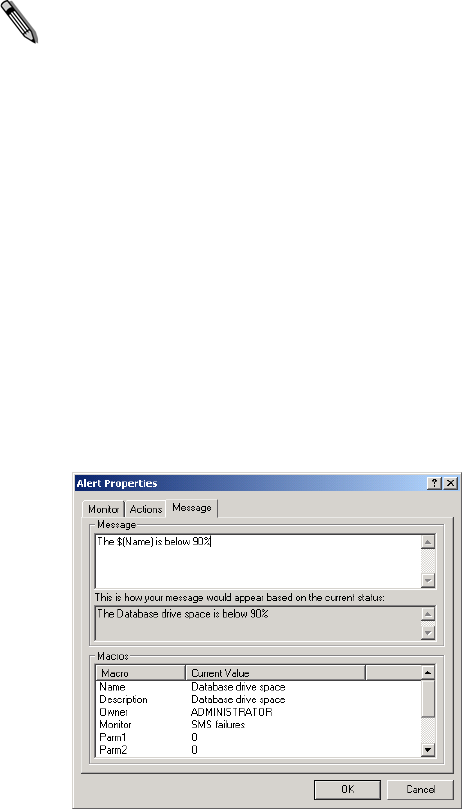
OpenText RightFax 10.0 Administrator’s Guide 174
6. If you want to limit the alert to occur only at specific times,
select the Limit use to the specified time option, and then
select a start and end time.
Note The Start time must be earlier than the End time within a single
day; the Start and End times cannot span days. To create an overnight
alert, create one alert that ends at 11:59 PM and another one that begins
at 12:00 AM.
7. Click OK to save the alert. The new alert will appear in the list of
alerts on the Actions tab of the Alert Properties dialog box.
8. To enable the alert, click the check box next to the alert name in
the list of alerts.
The Message tab
The Message tab on the Alert Properties dialog box only appears
if a statistic you select in the Statistic to monitor box supports
alerts. See Appendix D, “Alerting and Monitoring Statistics” for a
list of statistics that support alerts. The options on this tab let you
define the message text of the alert that will be sent.
Figure 18.9 The Alerting Properties Message tab
Message Enter the message text of the alert. You can use any
combination of text and macros from the Macros list. An example
of the alert message will be displayed in the box below this option.
Macros This is a list of macros that can be included in your
message text. To add a macro to the message, place the cursor in
the Message box where you want the macro text to appear and
then double-click the macro in this list.
175
Chapter 19
Using SNMP Alerting
The RightFax SNMP Alerting feature collects status data from the
RightFax server and returns it to a monitoring application for
processing and reporting. SNMP Alerting also actively sends
status messages and alerts to your network monitor application for
realtime monitoring of RightFax processes. RightFax alerts are
divided into four severities: Critical, Error, Warning, and
Informational, and alerts can be enabled or disabled according to
their severity. The RightFax SNMP Alerting feature also allows
RightFax services to be stopped and restarted directly from your
network monitor application.
To use SNMP Alerting, the Microsoft SNMP service must be
installed on both the RightFax server and on the network server that
will monitor messages.
To install the Microsoft SNMP Service
If the SNMP service has not already been installed on the RightFax
server, follow these steps:
1. On the RightFax server, select the Network program in
Windows Control Panel, and then click the Services tab.
2. If SNMP Service does not appear in the Network Services list,
click Add.
3. Click SNMP Service and click OK. You will be prompted to
insert your Windows CD. Insert the CD, specify the drive letter
of your CD-ROM drive, and click Continue.
4. Once the SNMP service has been installed, close the Network
dialog box.
Configuring the SNMP Service
on the RightFax Server
To configure the SNMP service properties
1. On the RightFax server, select the Network program in Control
Panel, and then click the Services tab.
2. Double-click SNMP Service in the list of network services, and
then click the Traps tab.
3. In the Community Name box, add the community name Public.
4. In the Trap Destination box, enter the IP address of each
machine on your network where you want to send RightFax
SNMP alerts (each machine used for network monitoring).
RightFax alerts can be sent to an unlimited number of network
monitoring stations on your network. Click OK.
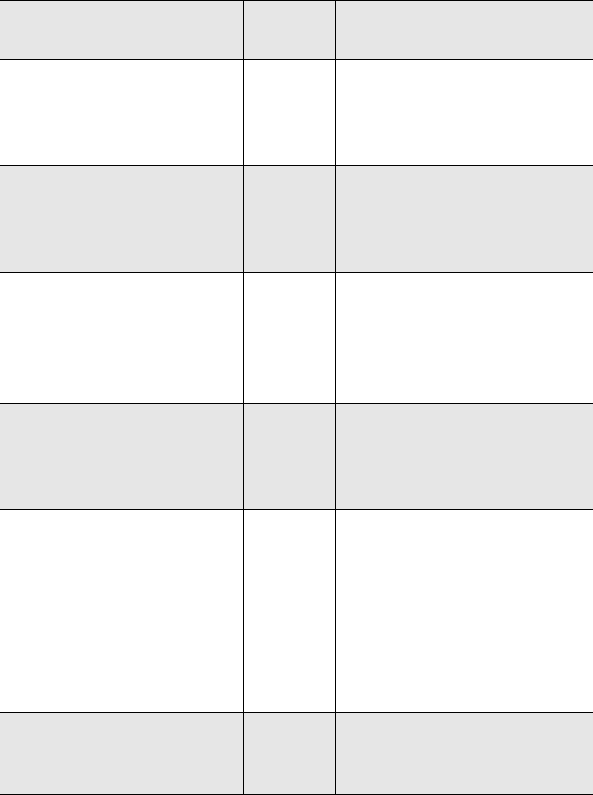
OpenText RightFax 10.0 Administrator’s Guide 176
Configuring the Network Monitor Application
Before it can receive SNMP alerts from the RightFax servers, your
organization’s network monitor application must be configured to
recognize the RightFax SNMP Alerting Management Information
Base (MIB) variables and trap definitions.
In the network monitor, execute the appropriate command(s) to
load new SNMP MIB variables and trap definitions. The MIB
variables for RightFax SNMP Alerting are located in a file called
Avtc.mib and the trap definitions are located in Rftrapd.conf. Both
of these files are installed by default to the RightFax server in the
RightFax\SNMP folder.
RightFax includes a utility that automates this configuration for HP
OpenView Network Node Manager. To automatically load the MIB
variables and trap definitions in Network Node Manager, run the file
Rfhpov.bat from a command line on the Network Node Manager
machine. This file is installed by default to the RightFax server in the
RightFax\SNMP folder.
Receiving RightFax Alerts in Your Network
Monitor
RightFax SNMP Alerting actively pushes RightFax alerts to your
SNMP-capable network monitoring application. This helps you
ensure that problems with the RightFax server are reported and
addressed promptly. SNMP Alerting also lets you query several
variables on the RightFax server so you can view the status of the
fax server in real time.
The fax server can send up to nine alerts to your SNMP network
monitor. The following table defines each RightFax alert. The
default RightFax severity is also listed, however your network
monitor software may be configured to use different terminology. In
RightFax terms, “Critical” is severity level one, “Error” is severity
level two, and “Warning” is severity level three.
Table 19a RightFax SNMP Alerts
Alert message
Default
severity Definition
“All BoardServers are
down. Fax sending and
receiving is not currently
operating.”
Critical All BoardServers attached
to this fax server have gone
down.
“One or more drives on the
fax server are approaching
critically low disk space
(<150 MB).”
Warning One or more drives on the
RightFax server have less
than 150 MB free.
“One or more drives on the
fax server are critically low
on disk space (<50 MB).
Many fax server functions
have been suspended.”
Critical One or more drives on the
RightFax server have less
than 50 Mb free.
“Possible phone line failure
on channel #, three
consecutive no-dial tone
errors within 45 minutes.”
Critical One or more fax channels
have gone down due to line
failure.
“RightFax Email Gateway
Module on
FaxServerName: The
Exchange Connector has
not responded in a timely
fashion. Inbound message
processing temporarily
disabled.“
Warning The RightFax server is
unable to communicate with
the Exchange server.
“The fax server internal
queue is more than 90%
utilized.”
Critical The RightFax internal event
queue is more than 90
percent utilized.
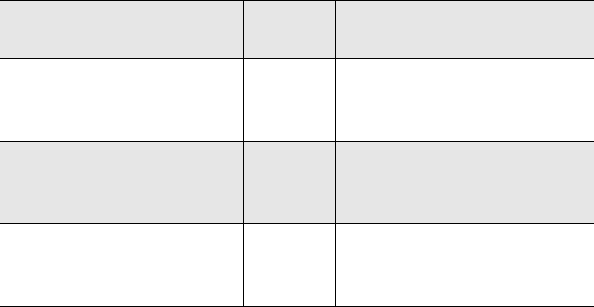
177
Each alert severity indicates how vital the component is to the
operation of the RightFax server. “Critical” and “Error” alerts
indicate a loss of fax functionality. “Warning” and “Informational”
alerts indicate a loss of fax capacity. These severity levels may use
different names in your network monitoring application, but the
hierarchy of severities remains the same. RightFax does not send
specific “clearing” alerts that indicate when the cause of an alert
has been resolved.
Alerts generated by RightFax SNMP Alerting are stored in your
network monitor under the “RightFax Server Alerts” category.
Please refer to your network monitoring application’s
documentation for information on displaying and managing alarm
messages.
Because SNMP alerts are generated from the Windows Event Log
on the RightFax server machine, the event log level of each
individual RightFax service must be set to an appropriate level. The
“Terse” setting records critical errors only. “Verbose” records all
significant events and is most useful for tracking and resolving
problems but can cause the event log to fill up quickly, which may
prevent new events from being logged. For information on
configuring the event log level for each RightFax service, refer to
the RightFax Administrator’s Guide.
Enabling and disabling RightFax alerts
The RightFax SNMP MIB contains four variables that let you
enable or disable the RightFax alerts according to severity. To edit
these variables, expand the MIB tree to:
.iso.org.dod.internet.private.enterprises.AVTC.Right-FAX.
rfFaxServer.rfServerTraps
This object contains four editable (read/write) variables:
rfSvrEnableCriticalTraps
rfSvrEnableErrorTraps
rfSvrEnableWarningTraps
rfSvrEnableInformationalTraps
Each variable can be set to either “objectENABLE” or
“objectDISABLE.” Changes to these variables take effect
immediately. Please refer to your network monitoring application’s
documentation for information on editing variables in the MIB.
Querying RightFax Status Variables
The RightFax SNMP MIB is comprised of 12 objects, each made
up of several variables. These variables provide realtime status
information on the RightFax server. To query the RightFax variables
in your network monitoring application, expand the MIB tree to:
.iso.org.dod.internet.private.enterprises.AVTC.Right-FAX.
rfFaxServer
“The fax server process
was not properly
shutdown.”
Critical A fax server was shut down
unexpectedly.
“The send queue depth on
server ServerName is
currently: #/# (faxes/pgs).”
Critical There are more than 1,000
faxes or 10,000 fax pages in
the fax queue.
“Unable to communicate
with BoardServer
ServerName (error 2)”
Error One BoardServer is down,
but at least one other
BoardServer is still running.
Table 19a RightFax SNMP Alerts (Continued)
Alert message
Default
severity Definition
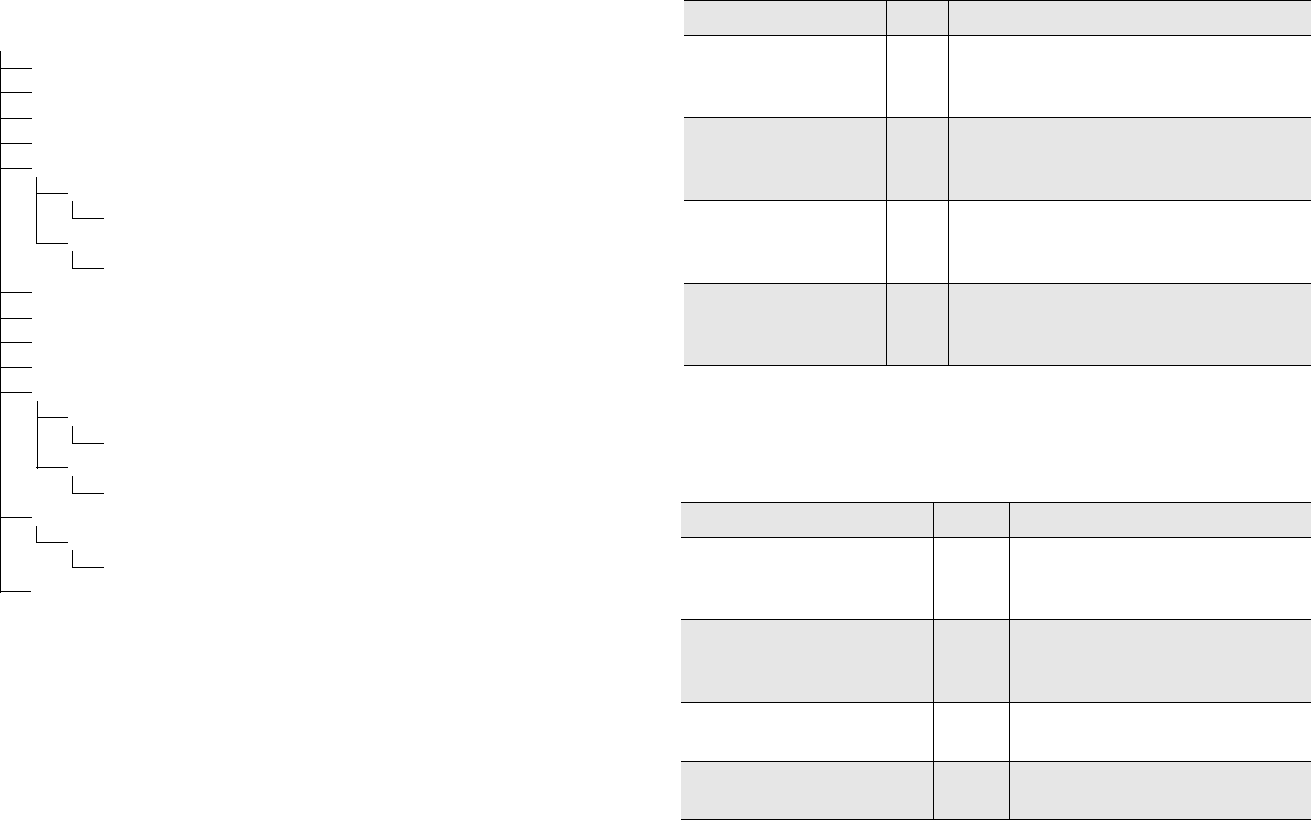
OpenText RightFax 10.0 Administrator’s Guide 178
All addresses below this branch point to a RightFax SNMP object
or variable. The following tree lists each object in the RightFax
SNMP MIB tree. Objects in bold contain variables.
rfFaxServer (.1.3.6.1.4.1.3529.2.1)
rfFaxServer_OV_v1Traps_ (.0)
rfServer (.1)
rfServerModule (.2)
rfBoardServerModule (.3)
rfBoards (.4)
rfBoardInfoTable (.4.1)
rfBoardInfoEntry (.4.1.1)
rfChannelInfoTable (.4.2)
rfChannelInfoEntry (.4.2.1)
rfDatabaseModule (.5)
rfRPCServerModule (.6)
rfQueueHandler (.7)
rfPagingServer (.8)
rfWorkServers (.9)
rfWorkSvrModuleTable (.9.1)
rfWorkSvrModuleEntry (.9.1.1)
rfWorkSvrFunctionTable (.9.2)
rfWorkSvrFunctionEntry (.9.2.1)
rfEMailGateway (.10)
rfGatewayModuleTable (.10.1)
rfGatewayModuleEntry (.10.1.1)
rfServerTraps (.11)
The following tables list each of the RightFax SNMP variables and
their definitions grouped according to the objects they are
contained in. Variables in boldface are editable. For information on
using your network monitoring application to access the MIB tree
and query variables in the MIB, please refer to the documentation
for your particular application.
rfFaxServer_OV_v1traps_
rfServer
Table 19b Variables in the rfFaxServer_OV_v1Traps_ MIB Object
Variable Type Definition
rfSvrCriticalTrap Notif. Text of critical alert reported by the
RightFax server. This is a notification type
variable and cannot be queried or edited.
rfSvrErrorTrap Notif. Text of error alert reported by the
RightFax server. This is a notification type
variable and cannot be queried or edited.
rfSvrWarningTrap Notif. Text of warning alert reported by the
RightFax server. This is a notification type
variable and cannot be queried or edited.
rfSvrInformationalTrap Notif. Text of informational alert reported by the
RightFax server. This is a notification type
variable and cannot be queried or edited.
Table 19c Variables in the rfServer MIB Object
Variable Type Definition
rfSvrQueueUsage Integer Percentage of the fax server’s
internal Event Queue currently in
use.
rfSvrEventsProcessed Integer Total number of events processed
by the fax server since the Server
module was started.
rfSvrBoardSvrAvailIndex Integer Availability of the server’s fax
boards).
rfSvrCurrentFaxesQueued Integer Current number of outgoing faxes
waiting to be sent.
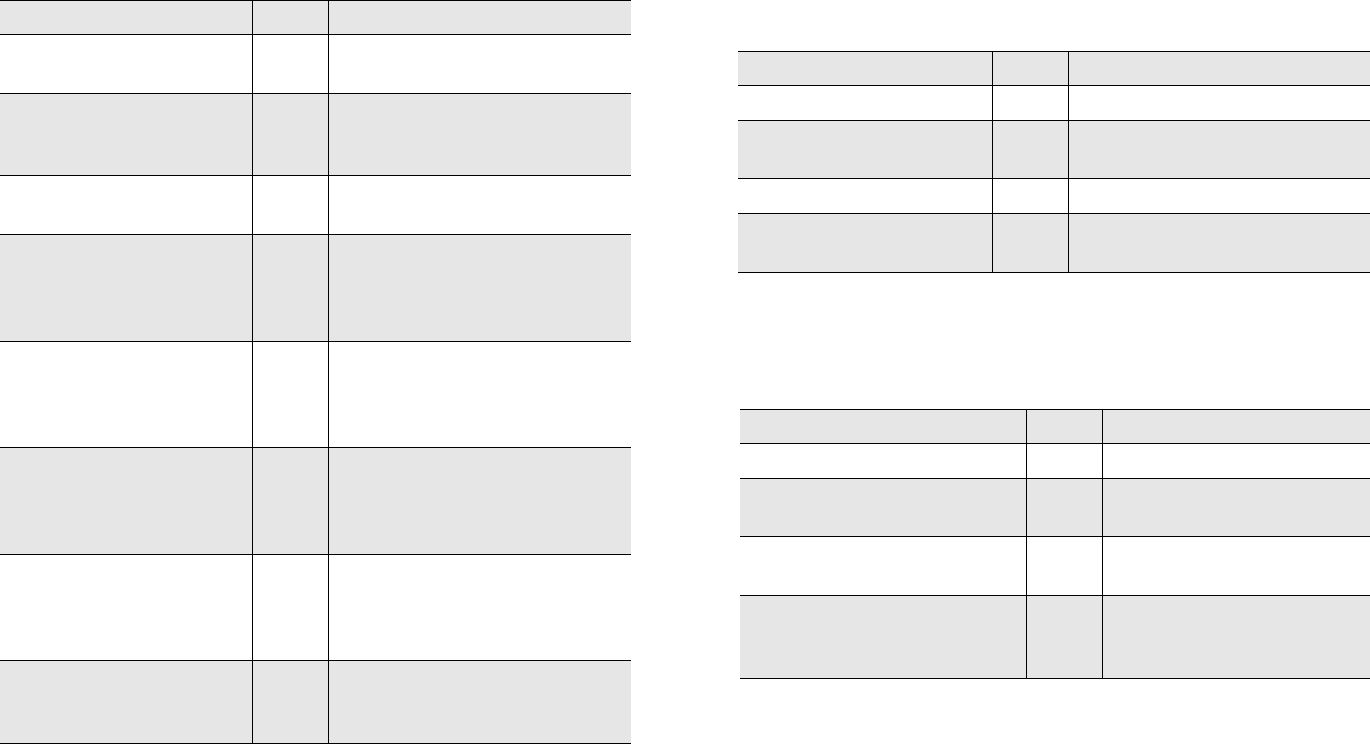
179
rfServerModule
rfBoardServerModule
rfSvrCurrentPagesQueued Integer Current number of outgoing fax
pages waiting to be sent.
rfSvrDiskAvailForfaxImages Integer Percentage of disk space on the
fax server available for storing fax
images.
rfSvrDiskAvailForfaxDB Integer Percentage of space available for
storing fax database information.
rfSvrAllTimeFaxesSent Integer Total number of faxes sent from
this server since the All-Time
Counter starting date
(rfSvrAllTimeCounterStart).
rfSvrAllTimePagesSent Integer Total number of fax pages sent
from this server since the All-Time
Counter starting date
(rfSvrAllTimeCounterStart).
rfSvrAllTimeFaxesReceived Integer Total number of faxes received on
this server since the All-Time
Counter starting date
(rfSvrAllTimeCounterStart).
rfSvrAllTimePagesReceived Integer Total number of fax pages
received on this server since the
All-Time Counter starting date
(rfSvrAllTimeCounterStart).
rfSvrAllTimeCounterStart Integer Starting date from which the
“All-Time” statistics are
calculated.
Table 19c Variables in the rfServer MIB Object (Continued)
Variable Type Definition Table 19d Variables in the rfServerModule MIB Object
Variable Type Definition
rfSvrModuleServiceName String Fax Server module service name.
rfSvrModuleVersionNumber String Fax Server module version
number.
rfSvrModuleServiceStatus Integer Current Fax Server service state.
rfSvrModuleTimeRunning String Length of time the Fax Server
service has been running.
Table 19e Variables in the rfBoardServerModule MIB Object
Variable Type Definition
rfBoardSvrModuleServiceName String BoardServer service name.
rfBoardSvrVersionNumber String BoardServer module version
number.
rfBoardSvrModuleStatus Integer Current BoardServer service
state.
rfBoardSvrModuleTimeRunning String Length of time the
BoardServer has been
running.
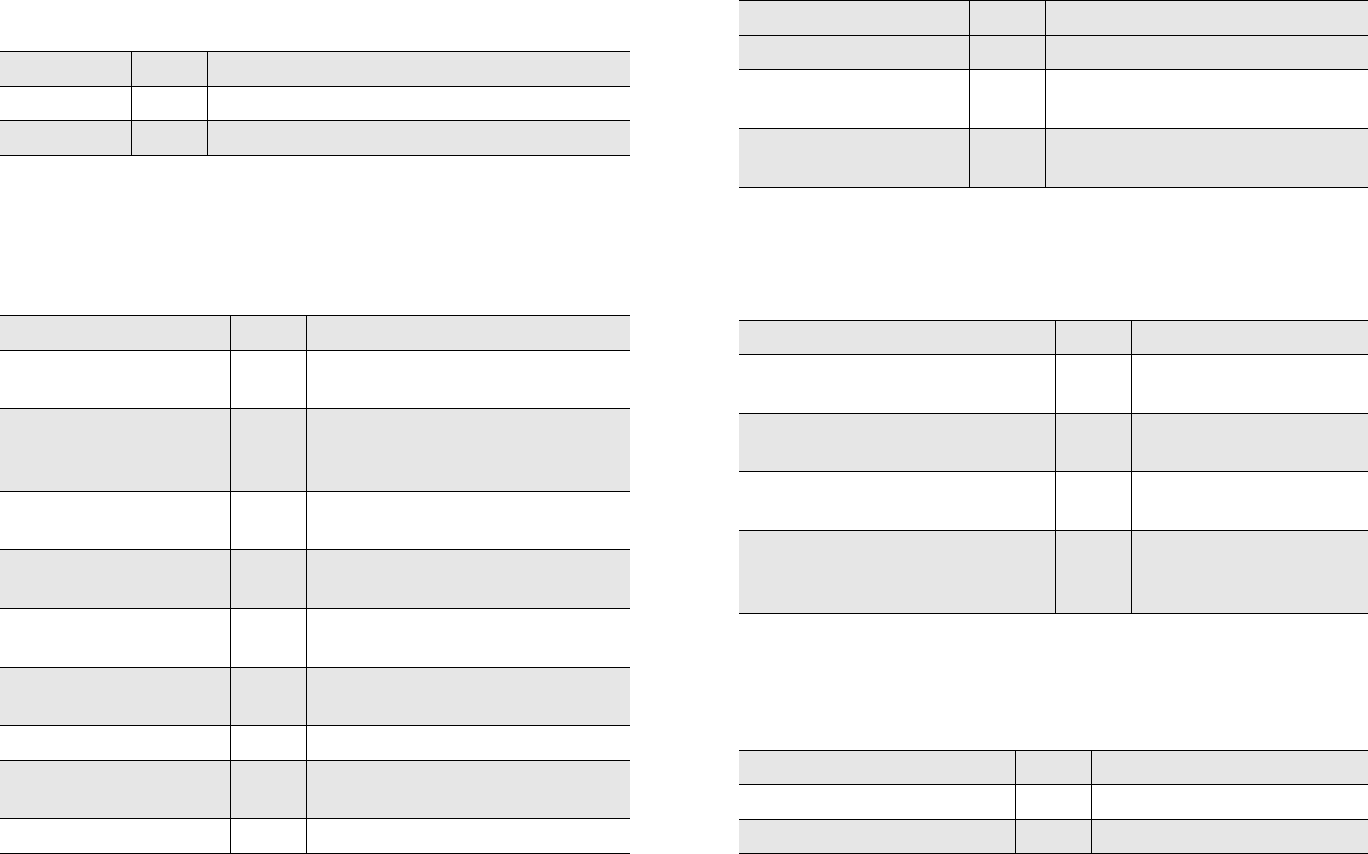
OpenText RightFax 10.0 Administrator’s Guide 180
rfBoards.rfBoardInfoTable.rfBoardInfoEntry
rfBoards.rfChannelInfoTable.rfChannelInfoEntry
rfDatabaseModule
rfRPCServerModule
Table 19f Variables in the rfBoards.rfBoardInfoTable.rfBoardInfoEntry MIB
Object
Variable Type Definition
rfBoardIndex Integer Fax board index.
rfBoardName String Each installed fax board type.
Table 19g Variables in the rfBoards.rfChannelInfoTable.rfChannelInfoEntry
MIB Object
Variable Type Definition
rfChannelIndex Integer Channel table index (lists each
installed fax channel).
rfChannelChannel String Channel numbers and [S] or [R] flag
indicating send or receive
functionality.
rfChannelOperation String Current operational status of all
channels.
rfChannelRoutingCode String Inbound routing code for all
incoming faxes.
rfChannelPhoneNumber String Destination phone number of
outgoing faxes.
rfChannelUserID String Destination User ID for incoming
faxes.
rfChannelState String Channel state.
rfChannelRemoteID String Remote ID of machines sending
incoming faxes.
rfChannelRate String Current rate of transmission.
rfChannelCompression String Data compression method.
rfChannelPagesInCall Integer Number of fax pages being
transmitted during this call.
rfChannelMinutesRemain Integer Estimated number of minutes
remaining until end of transmission.
Table 19h Variables in the rfDatabaseModule MIB Object
Variable Type Definition
rfDatabaseSvrModuleServiceName String Database module service
name.
rfDatabaseSvrVersionNumber String Database module version
number.
rfDatabaseSvrModuleStatus Integer Current Database module
service state.
rfDatabaseSvrModuleTimeRunning String Length of time the
Database service has
been running.
Table 19i Variables in the rfRPCServerModule MIB Object
Variable Type Definition
rfRPCSvrModuleServiceName String RPC module service name.
rfRPCSvrVersionNumber String RPC module version number.
Table 19g Variables in the rfBoards.rfChannelInfoTable.rfChannelInfoEntry
MIB Object (Continued)
Variable Type Definition
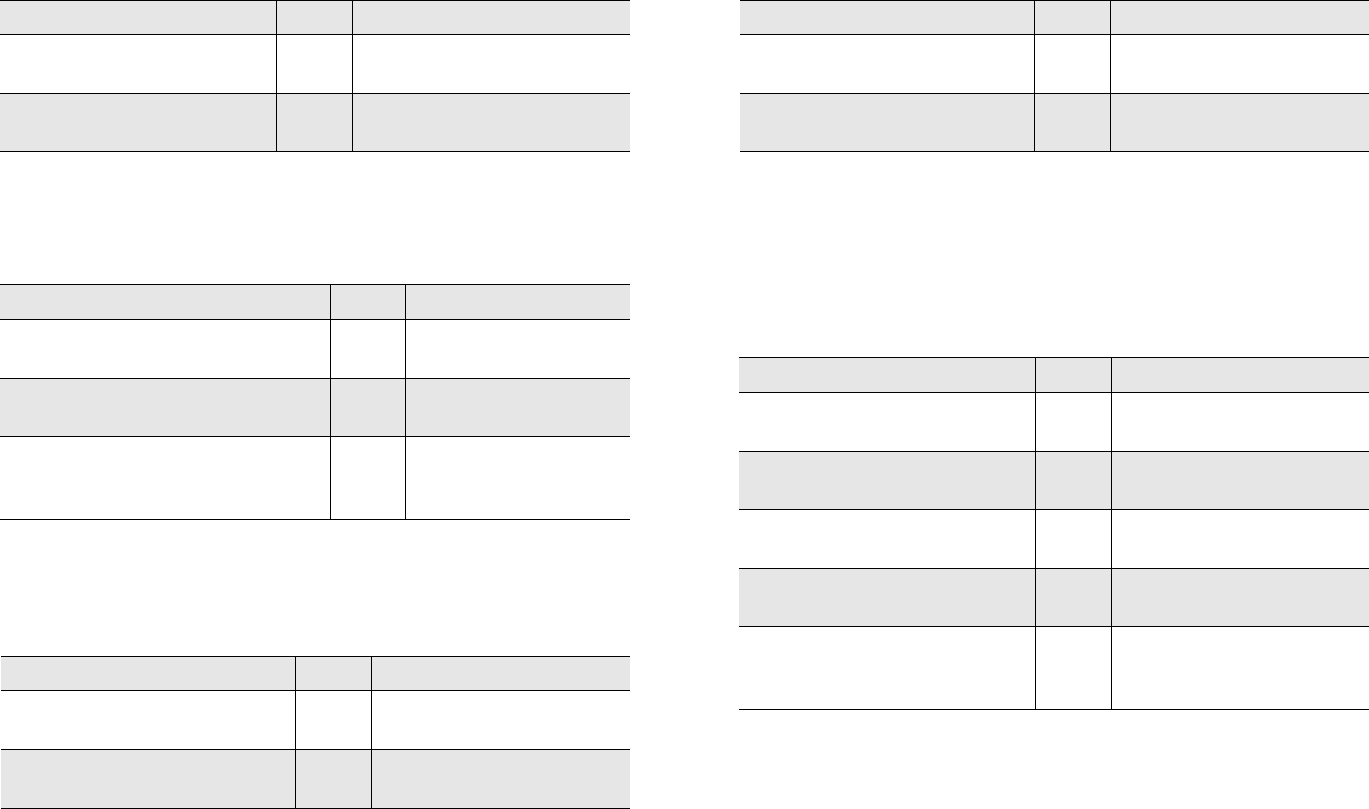
181
rfQueueHandler
rfPagingServer
rfWorkServers.rfWorkSvrModuleTable.rfWorkSvr
ModuleEntry
rfRPCSvrModuleStatus Integer Current RPC module service
state.
rfRPCSvrModuleTimeRunning String Length of time the RPC
service has been running.
Table 19j Variables in the rfQueueHandler MIB Object
Variable Type Definition
rfQueueHandlerModuleServiceName String Queue handler service
name.
rfQueueHandlerModuleStatus Integer Current Queue handler
service state.
rfQueueHandlerModuleTimeRunning String Length of time the
queue handler has been
running.
Table 19k Variables in the rfPagingServer MIB Object
Variable Type Definition
rfPagingSvrModuleServiceName String Paging module service
name.
rfPagingSvrVersionNumber String Paging module version
number.
Table 19i Variables in the rfRPCServerModule MIB Object (Continued)
Variable Type Definition
rfPagingSvrModuleStatus Integer Current Paging module
service state.
rfPagingSvrModuleTimeRunning String Length of time the Paging
module has been running.
Table 19l Variables in the
rfWorkServers.rfWorkSvrModuleTable.rfWorkSvrModuleEntry MIB
Object
Variable Type Definition
rfWorkSvrModuleIndex Integer WorkServer module table
index (lists all WorkServers).
rfWorkSvrModuleServiceName String Each WorkServer module
service name.
rfWorkSvrModuleVersionNumber String Each WorkServer module
version number.
rfWorkSvrModuleStatus Integer Each WorkServer module
service state.
rfWorkSvrModuleTimeRunning String Length of time each
WorkServer has been
running.
Table 19k Variables in the rfPagingServer MIB Object (Continued)
Variable Type Definition
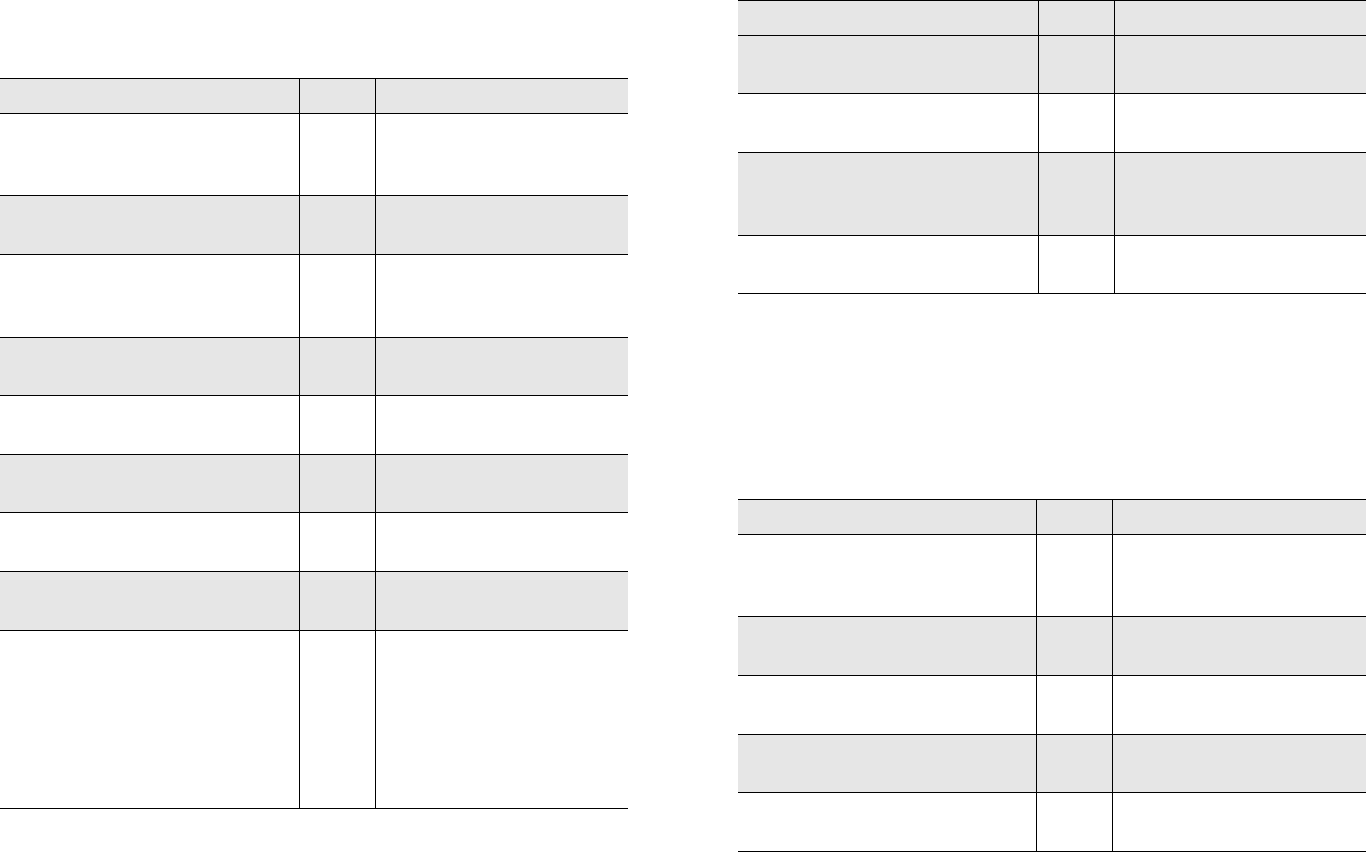
OpenText RightFax 10.0 Administrator’s Guide 182
rfWorkServers.rfWorkSvrFunctionTable.rfWorkSvr
FunctionEntry
rfEMailGateway.rfGatewayModuleTable.rfGateway
ModuleEntry
Table 19m Variables in the
rfWorkServers.rfWorkSvrFunctionTable.rfWorkSvrFunctionEntry MIB
Object
Variable Type Definition
rfWorkSvrFunctionIndex Integer Workserver function table
index (lists all
WorkServers).
rfWorkSvrFunctionArchive Integer Is Archive service
processed? (Yes/No)
rfWorkSvrFunctionCoverSheet Integer Is Cover sheet service
processed?
(Yes/No)
rfWorkSvrFunctionCVL Integer Is CVL service processed?
(Yes/No)
rfWorkSvrFunctionFileRoute Integer Is FileRoute service
processed? (Yes/No)
rfWorkSvrFunctionOverlay Integer Is Overlay service
processed? (Yes/No)
rfWorkSvrFunctionPCL5 Integer Is PCL5 service
processed? (Yes/No)
rfWorkSvrFunctionPrint Integer Is Print service processed?
(Yes/No)
rfWorkSvrFunctionNetMessaging Integer Is Network Messaging
service processed? Should
be No. Network messaging
is no longer functional in
any of the supported
Windows operating
systems.
rfWorkSvrFunctionDelImageFile Integer Is Delete Image File service
processed? (Yes/No)
rfWorkSvrFunctionOCR Integer Is OCR service processed?
(Yes/No)
rfWorkSvrFunctionInterConnect Integer Is InterConnect service
processed?
(Yes/No)
rfWorkSvrFunctionPostscript Integer Is PostScript service
processed? (Yes/No)
Table 19n Variables in the
rfEMailGateway.rfGatewayModuleTable.rfGatewayModuleEntry MIB
Object
Variable Type Definition
rfGatewayModuleIndex Integer Gateway module table entry
index (lists each email
gateway).
rfGatewayModuleServiceName String Each gateway service
name.
rfGatewayModuleVersionNumber String Each gateway module
version number.
rfGatewayModuleStatus Integer Current state of each
gateway service.
rfGatewayModuleTimeRunning String Length of time each
gateway has been running.
Table 19m Variables in the
rfWorkServers.rfWorkSvrFunctionTable.rfWorkSvrFunctionEntry MIB
Object (Continued)
Variable Type Definition
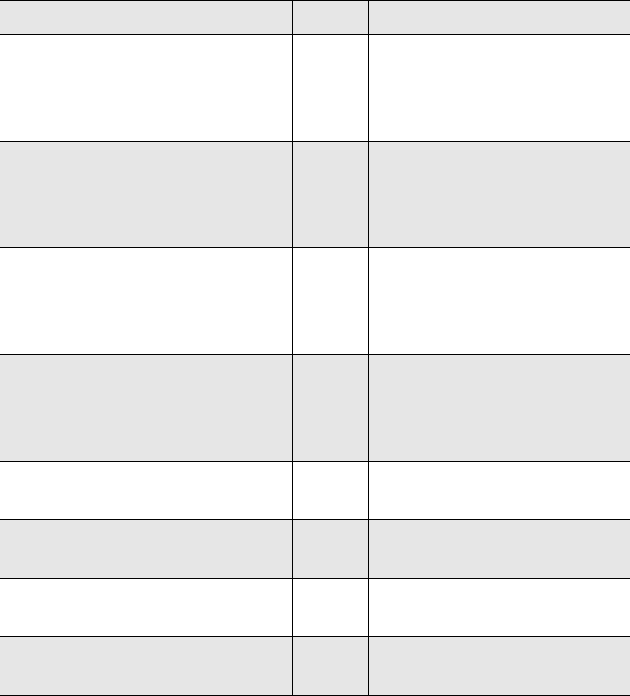
183
rfServerTraps Controlling RightFax Services From Your Network
Monitor
Each RightFax service object in the MIB contains a status variable.
For example, the rfDatabaseModule object contains the variable
rfDatabaseSvrModuleStatus. There are a total of eight service
status variables, each contained in a separate MIB object:
rfSvrModuleServiceStatus
rfBoardSvrModuleStatus
rfDatabaseSvrModuleStatus
rfRPCSvrModuleStatus
rfQueueHandlerModuleStatus
rfPagingSvrModuleStatus
rfWorkSvrModuleStatus
rfGatewayModuleStatus
When queried, these variables list the current state of the service
on the RightFax service (such as stopped, started, or paused).
You can also edit these variables to manually start or stop the
services on the RightFax server. Each variable can be set to either
“statSERVICE_STOPPED” or “statSERVICE_RUNNING.”
Changing any of these variables automatically instructs the
RightFax server to start or stop the appropriate service. Please
refer to your network monitoring application’s documentation for
information on editing variables in the MIB.
Troubleshooting the RightFax Alerts
SNMP alerts are designed to call attention to events or conditions
on the RightFax server that may effect your server’s ability to send
and receive faxes. The actual causes of these events and
conditions are not reported as part of the SNMP alerts. In most
cases, reviewing the Event Log on the server which is reporting the
alert will provide details as to the cause of the alert.
Table 19o Variables in the rfServerTraps MIB Object
Variable Type Definition
rfSvrTrapComputer String Computer that generated the
alert. This variable is used
only for trap notifications and
cannot be queried or edited.
rfSvrTrapSource String Source of the alert. This
variable is used only for trap
notifications and cannot be
queried or edited.
rfSvrTrapSeverity Integer Severity of the alert. This
variable is used only for trap
notifications and cannot be
queried or edited.
rfSvrTrapMessage String Alert notification message.
This variable is used only for
trap notifications and cannot
be queried or edited.
rfSvrEnableCriticalTraps Integer Critical alerts
enabled/disabled.
rfSvrEnableErrorTraps Integer Error alerts
enabled/disabled.
rfSvrEnableWarningTraps Integer Warning alerts
enabled/disabled.
rfSvrEnableInformationalTraps Integer Informational alerts
enabled/disabled.
OpenText RightFax 10.0 Administrator’s Guide 184
The troubleshooting information in this chapter is designed to point
network administrators who have a familiarity with RightFax to the
most common causes and solutions for each of the nine SNMP
RightFax alerts. However, as a client-server application, RightFax
relies on the network for much of its functionality. Because network
related problems can trigger RightFax alerts, the steps included
here may not always resolve the cause of the alert. If RightFax
alerts persist after following these steps, contact your RightFax
administrator and/or network administrator.
All BoardServers down
This alert indicates that all primary and remote BoardServer
services have failed.
Run Enterprise Fax Manager or the Windows Services
application and attempt to restart the BoardServer(s). If the
BoardServer(s) fail to start, check the application log in the
Windows Event Viewer for details.
If the application log does not provide adequate information to
resolve the problem, attempt to run the BoardServer in a window.
On the RightFax server and any machines running remote
BoardServers, change to the RFBoard folder and enter:
boardsrv.exe -d -1
This runs the BoardServer module as a session in a window in
debug mode. As the board initializes, debug information is
displayed and the reason for the BoardServer failure should
appear as the last line of the debug text. (There may be additional
lines of information associated with the BoardServer module
shutting down again after the failure.)
If a RightFax BoardServer module on a remote machine starts
and appears to be running normally but the alert persists, the
failure may be due to problems with network connectivity
between the remote BoardServer machine and the RightFax
server.
Critically low disk space
This alert indicates that one or more drives on the RightFax server
have fallen below 50 MB of available space.
Run Enterprise Fax Manager and check the status of the RightFax
services. If the RightFax Server module has not already stopped,
stop it. RightFax will automatically stop processing additional fax
traffic until both the drive that RightFax is installed on and the
drive that Windows is installed on have more than 50 MB
available. Additional SNMP alerts may be generated as a result
of this action.
Uninstall any unnecessary applications from the RightFax server
using the Add/Remove Software program in Control Panel.
If this does not alleviate the storage problem, check the
RightFax\Image folder. If it is exceptionally large, consider
adjusting the fax aging (see “The Automatic Fax Aging tab” on
page 121) or running the Faxage utility (see the RightFax
Administrative Utilities Guide). This will delete faxes from the
server database based on the age of the fax.
Another option is to move the RightFax\Image folder to a new
drive. To do this:
1. Create a RightFax\Image folder on a new drive with sufficient
free storage space.
2. Stop the RightFax Server module and move all of the images
from the old RightFax\Image folder to the new one.
3. Edit the Windows Registry value Image to point to the new
directory. See “Image” on page 333.
4. Restart the RightFax Server module.
185
Exchange server is not responding
This alert indicates that the RightFax server is unable to
communicate with the Exchange server. This is probably due to a
failure of the RightFax connector for Exchange which is the service
responsible for all communications between the two systems.
1. Attempt to restart the connector on the Exchange server
through Windows Services.
2. If the connector still appears to be running, shut down and
restart the connector.
Fax server event queue full
This alert indicates that the RightFax internal event queue is more
than 90% utilized. This indicates that too many events currently
require the attention of the RightFax Server module.
To get the RightFax server back online,
1. Change the event queue size in the Windows Registry Editor by
changing the QueueSize value to 3000. A modest increase to
the event queue size will not have any adverse effects on the
RightFax server itself. See “QueueSize” on page 330.
2. Run the Services program from Control Panel and stop and
restart the RightFax Server module. The fax server should return
to normal operation.
To determine why the queue reached its limit:
1. During a period of low fax traffic, run the Services program from
Control Panel and stop the RightFax Server module. This will
automatically stop the Database module and the WorkServer
modules.
2. Go to the RightFax\Database folder and check the size of the
Faxdata.D0F file.
If the is between 500 KB and 2 MB, the alert was probably
the result of a large fax broadcast or unusually high fax
volume. Increasing the event queue will prevent this from
happening again.
If the Faxdata.D0F file is 2 MB or larger, too many events are
queued and not being resolved. The most common cause of
this file becoming too large is unresolved work requests
involving fax notifications and/or OCR. If users are set to
receive notifications via Network Broadcast and no
WorkServer is set to perform the “Network Broadcast” task,
all the notification requests for the users will remain in the
Faxdata.D0F file. Similarly, if users have enabled automatic
OCR of received faxes and no WorkServers are set to
perform OCR, the work requests will go unresolved and
stack up. Also, if users have a large number of faxes in their
FaxUtil mailboxes with a status of “Info Not Complete,” the fax
server will constantly monitor the faxes and repeatedly notify
the users that their faxes need attention, occupying event
queue resources.
3. Restart the RightFax Server module.
Low disk space
This alert indicates that one or more drives on the RightFax server
have less than 150 MB free. This condition by itself should not
effect your server’s fax functionality, but is intended to warn you
that resources are getting low. Please see the troubleshooting
steps for “Critically low disk space” on page 184 for information on
resolving this alert.
OpenText RightFax 10.0 Administrator’s Guide 186
Probable line failure
This alert indicates that one or more of the fax channels have gone
down due to line failure. This alert is only generated when the
BoardServer returns certain errors in sequence over a given period
of time and is the direct result of phone line problems as opposed
to a failure on the RightFax server.
1. To prevent additional alerts while diagnosing the problem, run
the BoardServer configuration program and deactivate the
channel that is generating the alerts.
2. Verify that all phone lines are correctly and securely attached to
the fax board(s).
3. Disconnect the phone lines from the server and attach a
standard phone to verify that the line is still active.
4. If using a of PBX, verify that the line is still active through the
PBX.
5. For T1 installations, confirm that the green light on the fax board
that indicates the T1 line is active is lit.
Send queue too deep
This alert indicates that there are more than a predefined number of
faxes or fax pages in the fax queue waiting to send.
Verify that there are no other problems being reported with the
server or phone lines that might prevent all of your outbound fax
channels from being used.
If this alert appears frequently, too few fax channels may be
dedicated to outbound faxing. Run the BoardServer
configuration program and reevaluate each channel’s
send/receive capability.
If your fax traffic exceeds the capability of all of your fax channels,
consider increasing your total number of channels.
Server improperly shut down
This alert indicates that a fax server was shut down unexpectedly.
This indicates a sudden and unexpected loss of power.
Ensure that the server has recovered properly and is stable. The
RightFax services should restart automatically. Monitor services
and the Event Viewer for any problems.
The most common result of an unexpected shutdown is database
corruption, which, if severe, can prevent the RightFax Server
module from starting. For information on diagnosing and
resolving RightFax database problems, please refer to the
RightFax Administrator’s Guide.
Faxes that were in progress during the shutdown may need to be
released or resent by the creator of the fax. To “release” a fax,
highlight the fax in FaxUtil, and then select Fax > Status >
Release.
One BoardServer down
A BoardServer attached to this server has gone down, but at least
one other BoardServer is still running.
This alert is generally not produced as the result of a BoardServer
going down, but rather the loss of network connectivity between
the RightFax server and a remote BoardServer machine. You can
verify this by running the Windows Services application on each
remote BoardServer machine to confirm that they are all operating
correctly. If this is the case, contact your network administrator.
If one or more BoardServer services are down, refer to the
instructions for the “All BoardServers down” alert (page 184).

187
Chapter 20
Creating Dialing Rules and
Least-Cost Routing Plans
Dialing rules allow precise control of outbound faxing by specifying
rules and restrictions about how faxes are sent, according to their
destination fax numbers. For example, a dialing rule might specify
that all faxes to a certain area code are sent via WAN to another
RightFax server , saving long-distance charges. Another dialing rule
might specify that all international faxes can only be sent at times of
day when rates are lowest.
RightFax Intelligent Least-Cost Routing™ (LCR) routes outbound
faxes between servers on a wide-area network (WAN) in order to
minimize long distance and other telephone charges. Intelligent
Least-Cost Routing is composed of several RightFax components:
dialing rules, load balancing, destination tables, InterConnect, and
testing tools.
Managing Dialing Rules
When creating a dialing rule, you specify the fax number (or, using
wildcards, a number pattern) and then attach rules and restrictions
to faxes whose destination fax number matches that pattern. In
cases where one fax number matches multiple dialing rule patterns,
the fax server weighs each rule according to how closely it matches
the fax number, and then sends the fax according to the rule with
the greatest weight.
Because servers can be in different locations or serve groups with
varying needs, dialing rules are server-specific. If you have multiple
RightFax servers, you must create an appropriate list of dialing
rules for each server.
To add, edit, or delete dialing rules in RightFax, run Enterprise Fax
Manager and click Dialing Rules under the desired RightFax server
in the Fax Server Tree.
Important The RightFax 9.0 version of Enterprise Fax Manager cannot
create, edit, or otherwise manage dialing rules created by RightFax 9.4 or
later software.
Adding dialing rules
To add a new dialing rule, press INSERT or select New from the
Edit menu. The Rule Edit dialog box opens. For information on
completing each of the options in this dialog box, see “Editing
Dialing Rules” on page 188.
Deleting dialing rules
To delete a dialing rule, select the rule to delete and press DELETE,
or select Delete from the Edit menu.
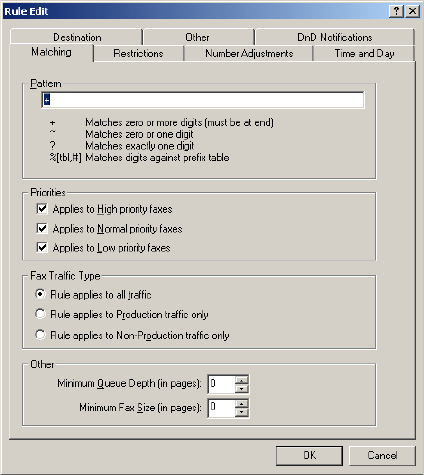
OpenText RightFax 10.0 Administrator’s Guide 188
Copying dialing rules from one server to another
In Enterprise Fax Manager, you can copy one or more dialing rules
from one RightFax server to another. Select the rules you want to
copy, and then drag the selection to another server. The amount of
information copied is configured in the Enterprise Fax Manager
Preferences dialog box (see “Setting Preferences” on page 94).
If you copy dialing rules from a new RightFax server version to an
earlier server version, you will lose configuration data that is not
supported by the older server (for example, features on version 8.5
servers will not be available on version 8.0 servers).
Saving dialing rules
Changes you make to dialing rules are not automatically saved
when you quit Enterprise Fax Manager. If you have unsaved dialing
rules, an asterisk appears next to the Dialing Plan icon in the server
tree. To save changes or additions to your dialing rules, press
CTRL+S or select Save Dialing Plan from the File menu.
Editing Dialing Rules
To edit the properties of an existing dialing rule, run Enterprise Fax
Manager, select the rule to edit and press ENTER, or select Edit
from the Edit menu. You can also double-click the dialing rule. The
Rule Edit dialog box opens.
The Matching tab
Figure 20.1 The Rule Edit Matching Tab
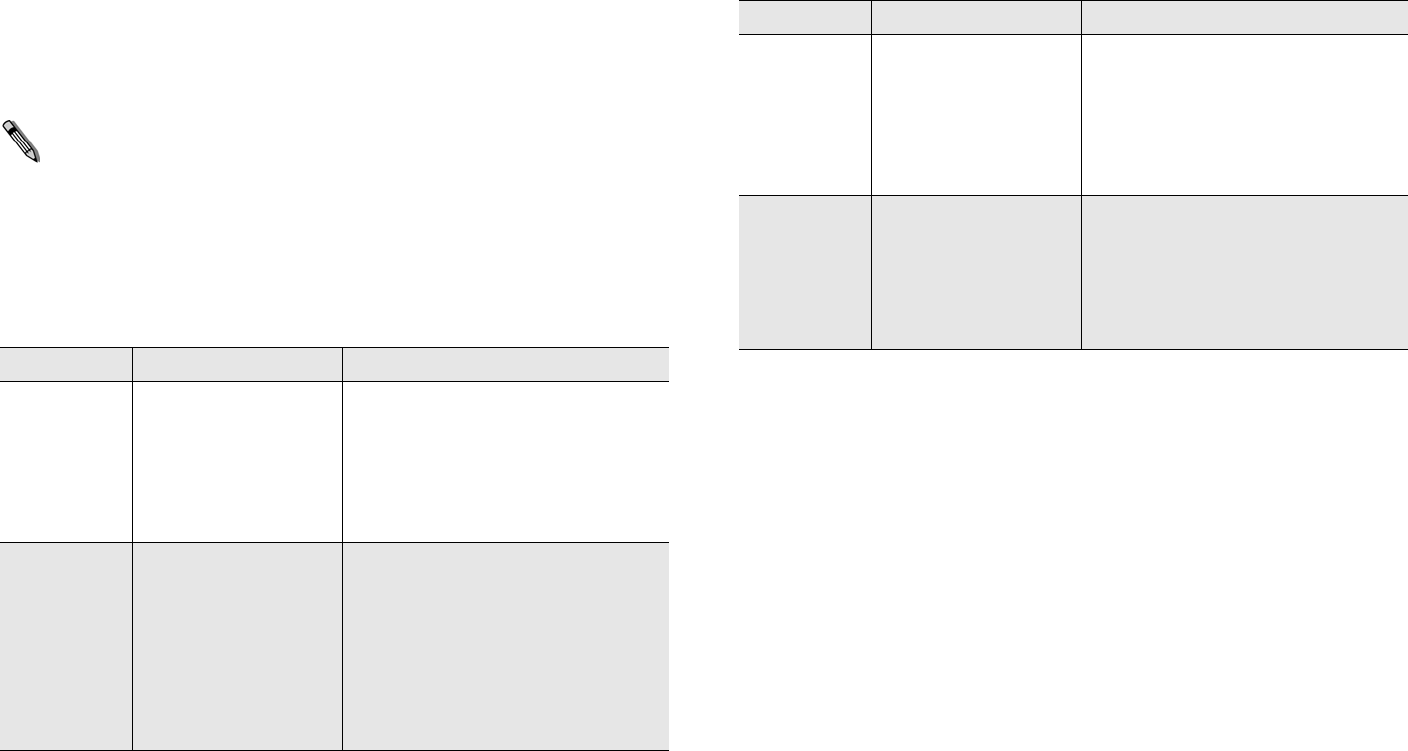
189
Pattern The destination fax number or number pattern that the
dialing rule will apply to. RightFax ignores any hyphens,
parentheses, or spaces in the pattern string. The pattern can
include the digits 0–9, as well as the pound [#] and asterisk [*]
keys.
Note To add other symbols to the list of supported characters, such as a
comma or period, edit the Windows registry to change the
ValidPatternChars value. See “ValidPatternChars” on page 329.
You can use wildcards to define variables in the number pattern
and thereby specify a range of numbers that the rule will apply to.
The following table lists each wildcard that can be used in the
Pattern box and its definition.
Wildcards decrease the weight of a pattern match because they
are always less specific than an exact match. For example, the fax
number 520-320-7000 matches the pattern “520-320-700?” and
“520+”, but will always be matched with the first rule because it is
more specific.
Priorities Restricts rule matching by the priority assigned by the
user to the fax. Only faxes with the priority levels selected here will
be considered for this rule. Matching based on priority can be
useful when doing fax broadcasts or other large volume faxing. It
can also be useful for universal redirection of faxes (e.g., send all
high priority faxes from Server2 instead of Server1).
Fax Traffic Type Apply the dialing rule based on whether the fax
was generated by the RightFax Integration Module. You can restrict
the rule to production faxes only, non-production faxes only, or
apply the rule to all faxes.
Minimum Queue Depth Specify the number of fax pages that
must be waiting in the server’s queue before this rule will be
considered. This lets you define a dialing rule that can offload
outgoing fax traffic to another server when the load on the current
server gets too high.
Table 20a Dialing Rule Pattern Wildcards
Wildcard Definition Examples
+Matches zero or more
digits; must always
appear at the end of
number string.
“+” matches any fax number
entered.
“415+” matches any number that
begins with 415, including
415-320-7000, 415-4455, and
4151.
~Matches zero or one
digit; can be placed
anywhere in the
number string.
“~415+” matches any number
beginning with 415 or [digit]415
including 415-320-7000, 415-3222,
1-415-320-7000, and 2415.
“~~415+” matches
1-415-320-7000,
9-1-415-320-7000, and
415-320-7000.
?Matches exactly one
digit.
“415-320-7???” matches any
number that starts with 415-320
and has its final four digits between
7000 and 7999.
“415-???-????” matches any
number within the area code 415.
%[tableID,#] Matches digits defined
in a destination table
to the number of digits
specified (see
“Managing Destination
Tables” on page 196).
“415-%[EAST,3]+” matches all
numbers that begin with 415 and
have a three-digit prefix defined in
the destination table “EAST.”
Table 20a Dialing Rule Pattern Wildcards (Continued)
Wildcard Definition Examples
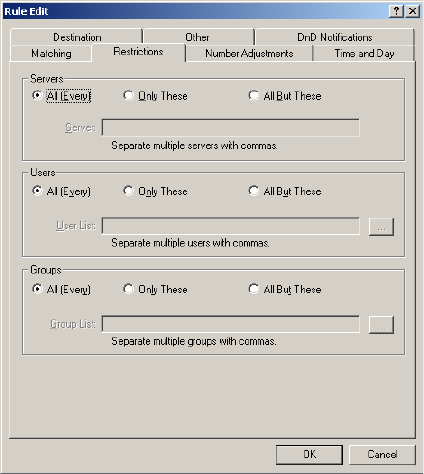
OpenText RightFax 10.0 Administrator’s Guide 190
Minimum Fax Size Specify the minimum number of pages a fax
must be before this rule will be considered. This lets you define a
dialing rule that can offload very large faxes to another server,
leaving the local server free to send only smaller faxes.
The Restrictions tab
Each dialing rule can be restricted to specific servers, users, or
groups in your organization.
Figure 20.2 The Rule Edit Restrictions Tab
You have the following options:
To apply the rule regardless of the origin of the fax, click
All (Every).
To apply the rule to only the IDs you specify, click Only These.
Enter one or more names of the servers, users, or groups to
which the rule applies. Separate multiple entries with commas.
To apply the rule in all cases except the IDs you specify, click All
But These. Enter one or more names of the servers, users, or
groups that are exempt from the rule. Separate multiple entries
with commas.
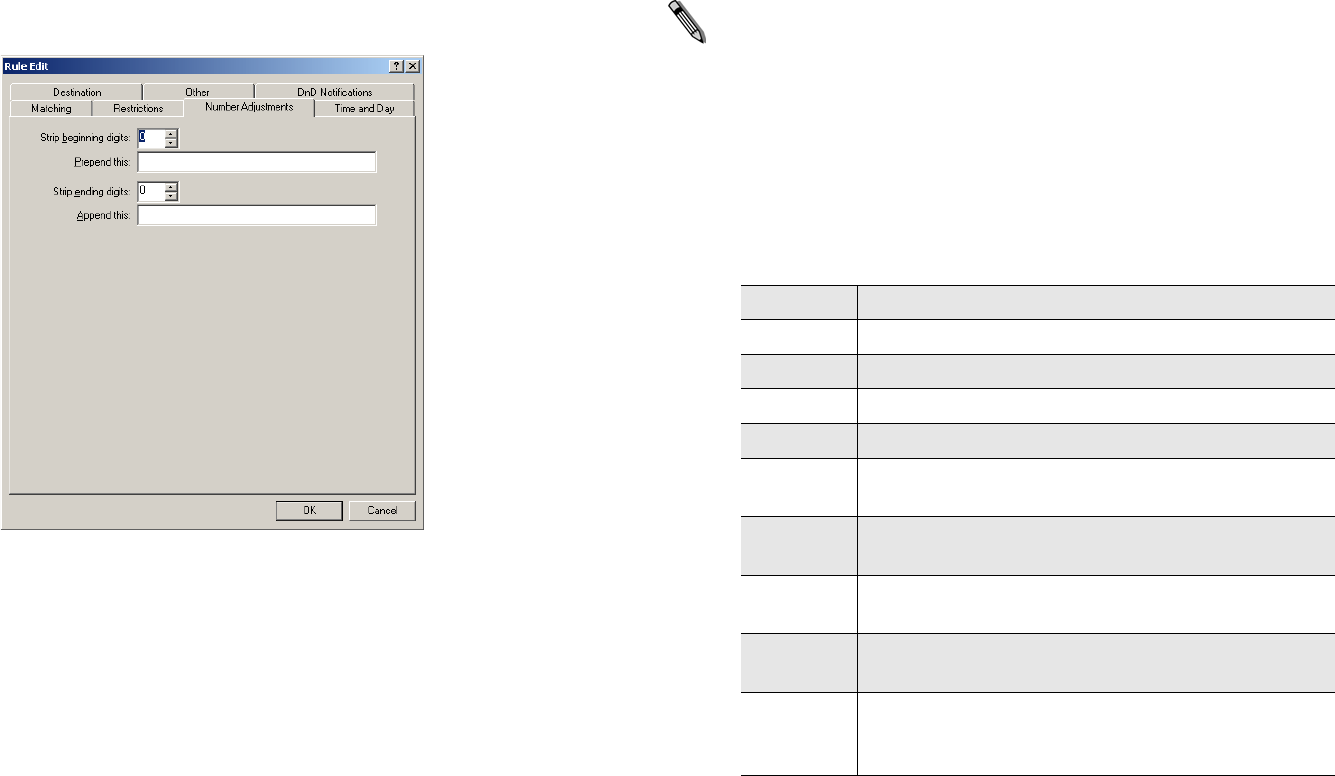
191
The Number Adjustments tab
The Number Adjustments tab specifies how fax numbers that
match the dialing rule should be modified in order to properly send
from the specified destination.
Figure 20.3 The Rule Edit Number Adjustments Tab
These options let you add or remove digits from the beginning or
end of the destination fax number. This can be used to
automatically add a “1” to long distance calls or to add a “9” if
necessary to get an outside line. It can also be used to add a user’s
long distance billing code, or to remove all but the last four digits of
a number for internal routing.
Note RightFax can specify a global dialing prefix for all outbound faxes
in your Global Board Settings (see “Configuring the DocTransport
Modules” on page 49). If your organization requires a dialing prefix for all
outgoing calls, you should specify the prefix there and not here in the
dialing rules.
You can append or prepend any combination of dialable digits. You
can also include special dialing characters that have special
meaning to RightFax. The following table lists the dialable
characters and their definitions (characters are not case-sensitive).
Table 20b Dialing Characters Supported by Dialing Rules
Character Definition
0–9 Dialable phone digits.
!Hook-flash signal.
#Pound button on phone.
*Asterisk button on phone.
, (comma) 1-second pause (you can combine several of these
characters to increase the length of the pause).
AReplaced in the dial string by the fax’s Billing Code 1
value.
BReplaced in the dial string by the fax’s Billing Code 2
value.
CReplaced in the dial string by the fax’s ToContactNum
value (the recipient’s voice number).
DReplaced in the dial string by the fax’s ToName value
(the recipient’s name). Any undialable characters in
this field will be discarded.
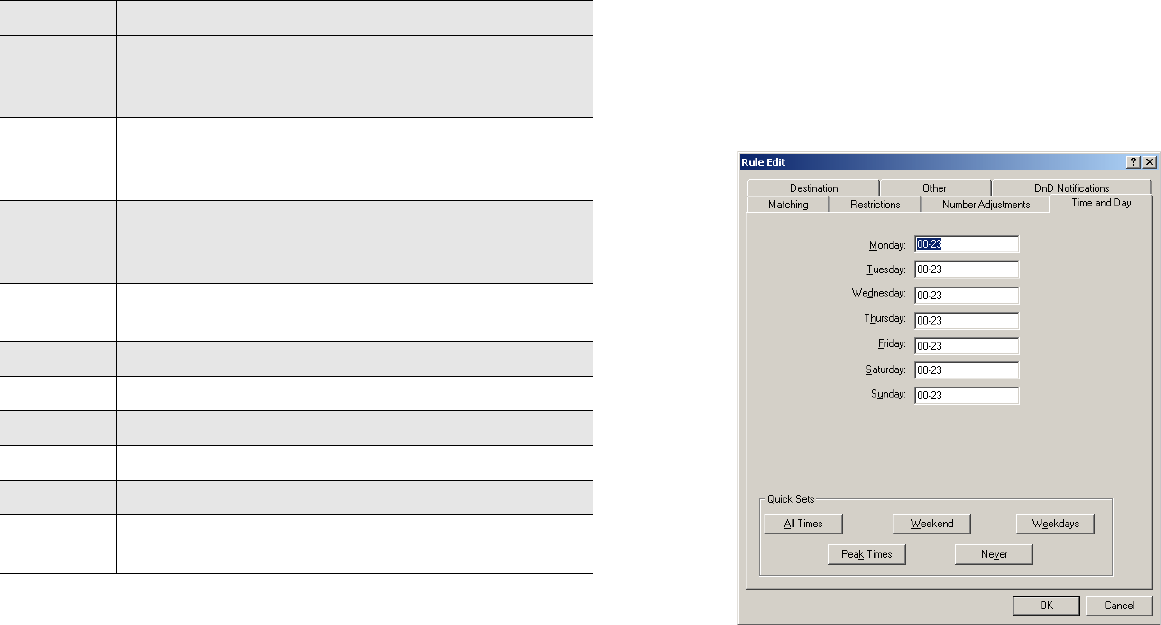
OpenText RightFax 10.0 Administrator’s Guide 192
The Time and Day tab
The Time and Day tab let you specify the time periods for each day
of the week that the rule will be applied. This can be used to take
advantage of special off peak phone rates or to balance fax loads
between servers at the times when your fax traffic is the highest.
Figure 20.4 The Rule Edit Time of Day Tab
For each day of the week, enter the time period when the rule will
apply using 24-hour military notation (i.e., “07” for 7:00 a.m. and
“19”for 7:00 p.m.). Do not specify minutes. The rule will apply
throughout the last hour in the range. For example, when you
specify the time range “06–18,” the rule will apply from 6:00 a.m.
until 6:59:59 p.m.
If you leave a box blank, the rule will not be in effect during that day.
To apply a rule at all times, enter “00–23” next to each day.
EReplaced in the dial string by the fax’s ToCompany
value (the recipient’s company name). Any undialable
characters in this field will be discarded.
FReplaced in the dial string by the user’s domestic long
distance Auto Billing Code (see “Configuring
Automated Billing Codes” on page 71).
GReplaced in the dial string by the user’s international
long distance Auto Billing Code (see “Configuring
Automated Billing Codes” on page 71)..
I5-second pause (you can combine several of these
characters to increase the length of the pause).
PPulse dialing mode.
TTone dialing mode (default).
WWait up to 15 seconds for a dial tone.
{Do not prepend the dialing prefix.
}Do not append the dialing postfix.
@Required for SR140 and T.37 FoIP numbers. Appends
the IP address of the FoIP router.
Table 20b Dialing Characters Supported by Dialing Rules (Continued)
Character Definition
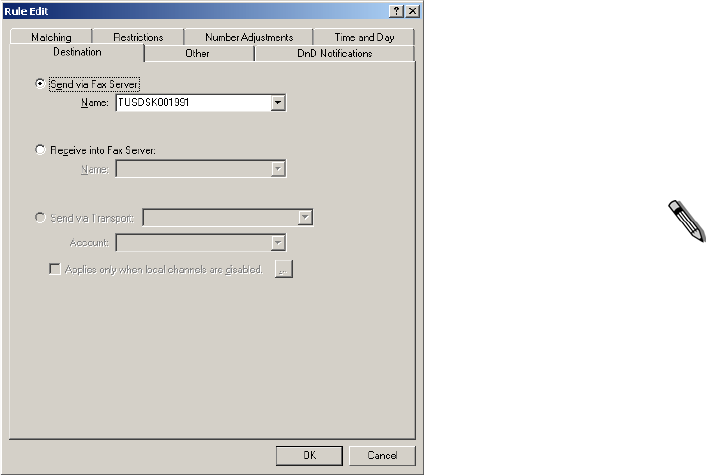
193
Quick Sets These buttons let you quickly apply the most
common time restriction settings.
The Destination tab
The Destination tab specifies where in your organization faxes
matching the dialing rule pattern should be routed prior to dialing
the destination fax number.
Figure 20.5 The Rule Edit Destination Tab
Send via Fax Server Causes the fax to be routed to any
RightFax server (including the local server) on your network for
transmission. When you select this option, you must also specify
the destination server name and network protocol to use for
routing.
When a fax is routed to another RightFax server on the network, the
destination fax number is reevaluated against the dialing rules on
the new server. The new server then transmits or forwards the fax
according to its own rules. Be careful not to create dialing rules on
two or more servers that would result in the servers looping one fax
between them. If this occurs, RightFax will send the fax after ten
loops.
Receive into Fax Server Causes the fax to be routed to a
RightFax server (including the local server) on the network and
delivered as an inbound fax. This allows you to define “intra-office”
routing rules that let RightFax users in your organization send faxes
to each other across different fax servers on the network. When
you select this option, you must also specify the destination server
name and network protocol to use for routing. If the fax number
does not match a routing code on the receiving RightFax server, the
fax will be routed to the Default user ID on that server.
Note The Send via Fax Server and Receive into Fax Server fields are
limited to a total of 15 characters if using a net bios name, or 16
characters if using an IP address.
Send via Transport This option lets you select one of the
transport methods that you added and configured in the RightFax
DocTransport module (described in Chapter 5, “Configuring the
DocTransport Modules”) as the fax destination, rather than a
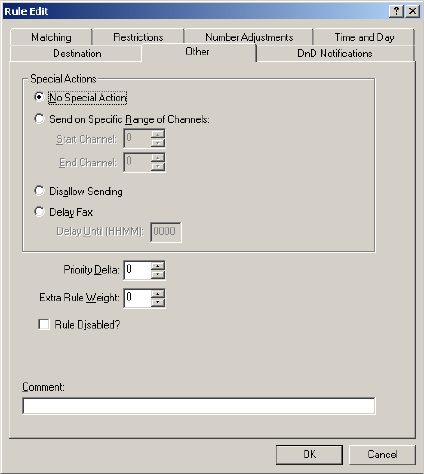
OpenText RightFax 10.0 Administrator’s Guide 194
specific RightFax server. In order to select a transport method in
this box, the transport must have been added in the DocTransport
module. You can select from the following transport methods:
FOIP. The fax will be transmitted via your SMTP server to a
T.37-compatible device. T.37 fax over IP is a fax transmission
protocol that allows faxes to be transmitted to T.37-compatible
devices over IP, rather than dedicated fax channels. The fax is
packaged as an email message with a TIFF attachment and then
sent over IP via an SMTP server. This message is automatically
interpreted as a fax by the receiving device, which then prints it.
To specify the email address of the destination T.37-compatible
device, click the Number Adjustments tab (described on
page 191), strip all of the digits from the destination fax number,
and then prepend the destination email address.
SMS. The fax will be routed to an SMS number. When a fax is
sent to an SMS device, only the cover page notes are
transmitted.
To specify the destination SMS number, click the Number
Adjustments tab (described on page 191), strip all of the digits
from the destination fax number, and then prepend the desired
SMS number.
Applies Only when Local Channels are Disabled Causes
the rule to be in effect only when the fax server has detected that all
fax channels are disabled.
The Other tab
Figure 20.6 The Rule Edit Other Tab
No Special Action Processes the fax without delay on any
available channel.
Send on Specific Range of Channels Sends the fax only on
the channels you specify. The channel range specified here will
override any channel restriction placed on a specific fax using the
<CHANNEL> embedded code. This parameter is not transferred
with the fax if it is routed to another fax server for sending.
Disallow Sending Prevents faxes from sending based on
certain attributes such as the number pattern, time of day, or
sender. The user will get the message “Fax blocked from dialing
phone number.” This is sometimes referred to as the “Do Not Dial”
or DnD feature. You can set notifications for disallowed faxes on
the “The DnD Notifications tab”.
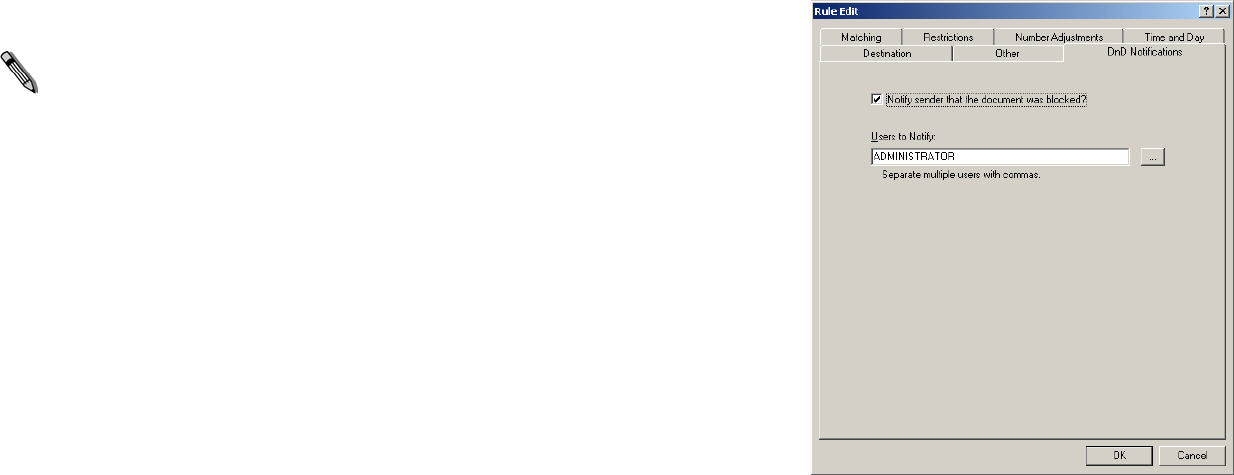
195
Delay Fax Prevents the fax from sending until a specified time of
day. If the specified time is earlier than the time the fax is received,
the fax will send at that time on the next day. Specify the Delay
Until time using military notation (0000–2359).
Note Intelligent Least-Cost Routing rules are evaluated one time. If
transmission is delayed by the Delay Fax setting, then other settings for
the rule will not be evaluated.
Priority Delta Set dialing rules to adjust a fax’s priority setting
(low, normal, or high). Priority is rated on a three-point scale: low
priority <= 1, normal priority = 2, high priority >= 3. Using the
priority delta, you can add or subtract points from all faxes that
match the dialing rule pattern to adjust their priority up or down.
Extra Rule Weight Add additional weight to the dialing rule.
When a fax number matches two or more dialing rules, RightFax
“weighs” each rule according to how closely it matches the dialed
number and uses the rule with the highest weight. This setting adds
extra weight to the rule so it can be selected over another rule that
has a better pattern match.
Dialing rule pattern characters are weighted as follows: digit match
(0–9) = 10 points, + (plus) = 0 points, ? (question mark) = 5
points, ~ (tilde) = 4 points.
Rule Disabled Removes the dialing rule from consideration by
the fax server. To enable the dialing rule, click to clear the check
box.
Comment Optionally enter a descriptive comment for the dialing
rule.
The DnD Notifications tab
Figure 20.7 The Rule Edit DnD Notifications Tab
Notify sender that the document was blocked Select this
option if you want the sender to be notified after attempting to send
a fax to a number that has been blocked by the Disallow Sending
(or Do-Not-Dial) feature on “The Other tab”. If this option is not
selected, the sender will get the “Fax number blocked” custom
message. To configure this message, see “Configuring Custom
Messages” on page 26.
Users to Notify Specify the RightFax user IDs to which
notifications will be sent. If you want to specify multiple user IDs,
separate ID’s with a comma. You can also select user IDs from a
list of all user IDs on the local server by clicking the [...] button. To
select multiple users from this list, press CTRL and click on each
user ID you want.

OpenText RightFax 10.0 Administrator’s Guide 196
Example of dialing rules in use
A company with RightFax servers in New York and Seattle adds the
following dialing rules on the New York server:
206-???-????
Remove first three digits and send via Seattle server
206-820-50??
Remove first six digits and receive into Seattle server
When someone in New York sends a fax to 206-820-7000 (faxing
to a customer in Seattle) the server will route the fax to the Seattle
server which then sends it via a local call. However when someone
in New York sends a fax to a co-worker in Seattle at
206-820-5065, the server will consider the fax a “received fax” and
will route it to the appropriate internal fax mailbox (5065).
Load Balancing
Load balancing is the process of dividing your outgoing fax traffic
across multiple RightFax BoardServers, routing faxes to the
BoardServer with the most available fax channels.
To do this, create multiple dialing rules with the same number
pattern, each routing faxes to a different BoardServer computer.
Because the number patterns are the same, each rule will be
assigned the same “weight.” When multiple rules match a fax
number with equal weight, RightFax directs the fax to the
BoardServer with the most available fax channels. Equal
distribution is not guaranteed. If none of the servers have outbound
fax channels available, faxes will be directed to the BoardServer
that will have a channel available the soonest.
Important Outbound faxes are always sent to the BoardServer with
the most assigned fax channels before the dialing rules that determine
load balancing are processed. For this reason, you should include all
load balancing dialing rules on all fax servers and remote BoardServer
computers. This will ensure that your load balancing rules operate even if
one or more BoardServer computers fail.
The load balancing feature is only available in RightFax Enterprise
servers.
Managing Destination Tables
You can store and organize groups of numbers such as dialing
prefixes and area codes in destination tables. These tables are
used when creating dialing rules to represent a range of numbers,
rather than creating a separate rule for each number pattern.
For example, a destination table can be created that contains all of
the area codes in a major metropolitan area. Using this destination
table, you can create a single dialing rule that addresses all of
these area codes, rather than creating a separate rule for each area
code.
To add or edit destination tables in RightFax:
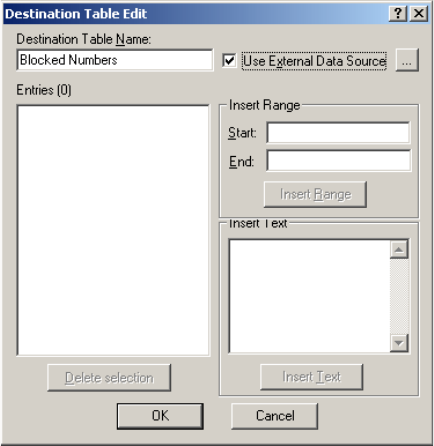
197
1. Run Enterprise Fax Manager and click Dialing Plan, and then
Destination Rule under the desired server in the server list.
2. To create a new table, click New from the Edit menu or
right-click Destination Rule and then choose New. To edit an
existing table, double-click the table name.
Figure 20.8 The Destination Table Edit dialog box
3. Enter or edit the Destination Table Name. Note that the name
may not include spaces.
4. Add new numbers you want to block to the table in any of three
ways:
Enter the numbers in the Insert Text box, separating
numbers with carriage returns so that there’s one number on
each line. All the entries in a destination table must be the
same length. Entries can only include the digits 0–9, pound
[#], and asterisk [*]. Click the Insert Text button to display
the numbers in the Entries box.
If the destination table will contain a range of numbers, enter
the starting and ending numbers in the series under Insert
Range and click the Insert Range button. All the numbers in
the range you specify will appear in the Entries list.
Check the Use External Data Source option, then browse
to a SQL database and specify the column you want to
import. For more information about using this feature refer to
the next section, “Importing Destination Table Entries from an
External Source”.
5. To remove an entry (and allow faxes to be sent to the number),
click the number in the Entries box, then click Delete
Selection.
6. Click OK to close the editing window and display the
destination table in the list of table names.
7. Changes you make to destination tables are not automatically
saved when you quit Enterprise Fax Manager. If you have
unsaved destination tables, an asterisk appears next to the
Dialing Plan icon in the server tree. To save changes or
additions to your destination tables, click on Dialing Plan and
press CTRL+S or select Save Dialing Plan from the File menu.
Deleting destination tables
To delete a destination table, select the table to delete and press
DELETE, or select Delete from the Edit menu.
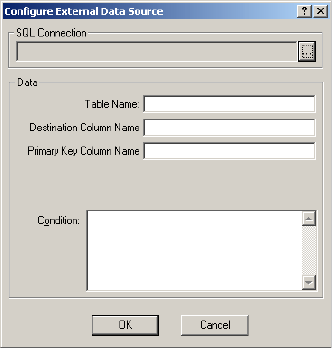
OpenText RightFax 10.0 Administrator’s Guide 198
Copying destination tables from one server to another
In Enterprise Fax Manager, you can copy one or more destination
tables from one RightFax server to another. Select the tables you
want to copy, and then drag the selection to another server. The
amount of information copied is configured in the Enterprise Fax
Manager Preferences dialog box (see “Setting Preferences” on
page 94).
If you copy users from a new RightFax server version to an earlier
server version, you will lose configuration data that is not supported
by the older server (in other words, features on version 9.4 servers
will not be available on earlier server versions).
Importing Destination Table Entries from an External
Source
If your organization maintains a database containing lists of phone
numbers that should not be dialed, you can link the destination
table directly to this database and then set up a dialing rule that will
prevent these numbers from receiving fax transmissions.
Before you can set up a Do not Dial list, you must configure the
database containing the numbers to block as an ODBC data
source. Refer to the documentation for your server’s operating
system for information on configuring a new ODBC data source.
After you have set up the ODBC data source for the database
containing the numbers to block, follow these steps to set up Do
not Dial rules.
1. In Enterprise Fax Manager, create a new destination table.
2. Enter a name for the table, select the option Use External Data
Source, and then click the [...] button. This opens the
Configure External Data Source dialog box.
Figure 20.9 The Configure External Data Source dialog box
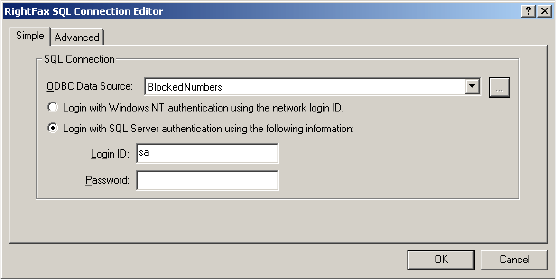
199
3. Click the [...] button next to the SQL Connection box to
configure the ODBC data source. This opens the RightFax
SQL Connection Editor dialog box.
Figure 20.10 The RightFax SQL Connection Editor dialog box
4. Click the [...] button next to the ODBC Data Source box and
select the ODBC data source you created for the Do not Dial
list.
5. Specify the login information required to access the database
and then click OK. This will return you to the Configure
External Data Source dialog box with the connection
information entered in the SQL Connection field.
6. In the Table Name field, enter the name of the table that
contains the phone numbers to block.
7. In the Destination Column Name field, enter the name of the
table column specific to the phone numbers.
8. In the Primary Key Column Name field, enter the name of the
primary key column for the table you specified in the Table
Name field.
9. In the Condition field, enter any SQL script that you might want
to use to limit the range of phone numbers in the database. For
example, you could enter a query for a field called “Block
Number” set to true. This would limit the range of blocked
phone numbers to only those for whom a separate field in the
table called “Block Number” is set to true.
10.Click OK. The Destination Table Edit dialog box reopens with
all of the phone numbers from the database listed in the Entries
box. The entries in the box are dynamic and will be automatically
updated as you make changes to the database that you are
linked to. There is no need to update this list after is has been
set up.
11.Changes you make to destination tables are not automatically
saved when you quit Enterprise Fax Manager. If you have
unsaved destination tables, an asterisk appears next to the
Dialing Plan icon in the server tree. To save changes or
additions to your destination tables, click on Dialing Plan and
press CTRL+S or select Save Dialing Plan from the File menu.
Testing Dialing Rules and Fax Routes
Because Intelligent Least-Cost Routing involves many variables
that could conflict with one another, RightFax includes diagnostic
tools for testing and confirming your fax routing scheme.
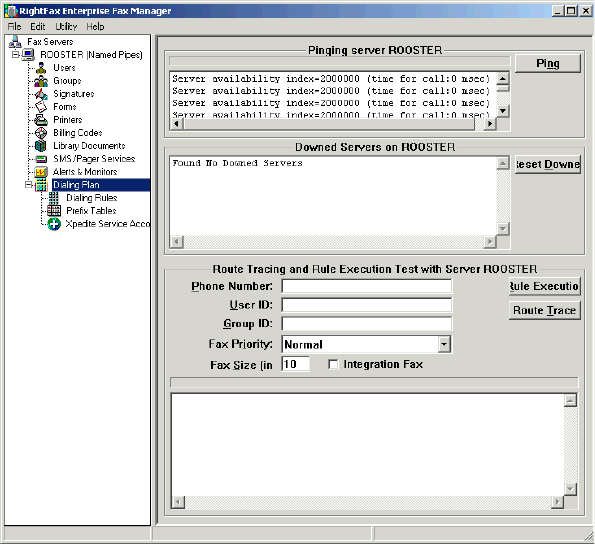
OpenText RightFax 10.0 Administrator’s Guide 200
To run the tests, run Enterprise Fax Manager and click Dialing Plan
under the server you want to test.
Figure 20.11 Diagnostic Tools for Testing Least-Cost Routing Rules
Pinging a server
By pinging a server, you can test communications with a selected
RightFax server using a particular protocol. To run this test, click
Ping.
The amount of time it takes information packets to make a round
trip between machines will display in seconds as “time for call.” The
current sever load will display as “server availability index.” The
higher the index value, the greater the server availability.
Tracing the route of a fax
You can test the dialing rules you have constructed using real fax
numbers without actually sending a fax. This test will show where
the fax will be sent from, such as a specific server or a connector in
your system. This test will not indicate if the fax is delayed or if the
transmission is unsuccessful based on dialing rules. For this level
of detail, use the rule execution test.
To run this test, enter a fax telephone number in the Phone
Number box. You can also enter a specific user ID, group ID, fax
priority, and fax size to test how each effects the fax routing.
If the dialing rule applies to production faxes, click to select
Integration Fax. Production faxing is implemented with the
optional Integration Module.
Click Route Trace to start the test.
As the fax number passes one or more servers, the dialog box will
display which rules are being used, how the fax number is
manipulated along the way, the number of hops, or jumps, from
server to server, and the time it takes to route between servers. The
time between servers does not include the time to transfer image
data. That additional time will depend on the size, resolution, and
density of the fax.
Executing rules
Like tracing the route of a fax, you can test the dialing rules you
have constructed using real fax numbers without actually sending a
fax. Using the rule execution test, you can obtain more detailed
information about dialing rules on a server.
To run this test, enter a fax telephone number in the Phone
Number box. You can also enter a specific user ID, group ID, fax
priority, and fax size to test how each effects the route and
execution of the rule.
If the dialing rule applies to production faxes, click to select
Integration Fax. Production faxing is implemented with the
optional Integration Module.

201
Click Test to start the test.
As the fax is routed, the dialog box displays each dialing rule
against which the fax number is compared and provides information
about the match weights and server availability.
Viewing disabled rules
The Downed Servers list displays any rules that are disabled due
to downed RightFax servers and the error that caused the rule to
be disabled.
To refresh the list of downed servers, click Reset Downed.
Call Blocking
By default, the DocTransport module blocks all outgoing calls to
numbers beginning with 911 (the standard emergency number
throughout the United States). All non-numeric characters are
ignored by DocTransport. For example, if a user sends a fax to
,,911, DocTransport will ignore the two preceding commas and
match 911, thus blocking the number.
You can set up additional numbers to be blocked using the Dialing
Rules in combination with a Destination table.
To add or change blocked numbers:
1. Create a destination table for the numbers you want to block.
2. Create a dialing rule that uses that table for the matching string.
3. On the Other tab of the dialing rule select "Disallow sending"
4. Save the rule.
Note: you can also use the Windows registry keys “BlockedNumbers”
and “BlockingFlags”s to prevent faxes from being sent to specific
numbers, or to turn off the 911 blocking feature.
Spam Handling
It is possible to automatically route unwanted or ‘spam’ faxes to a
dedicated spam user account based on ANI information. You must
first create a RightFax account(s) that will receive the unwanted
faxes (such as SpamAccount). Then create a Windows registry
sub-key ANI that contains the Entries for each blocked number
and the newly created account to which it will be routed. See
“Entries (in ANI Key)” on page 328 for more information.
Approving Blocked Faxes
Faxes that are blocked by dialing rules can be approved for
transmission by RightFax administrators. Group administrators and
alternate group administrators cannot approve faxes.
To approve a fax blocked by a dialing rule
1. Logon to FaxUtil as an administrator.
2. On the List menu, click Administrative Mode. to view the
contents of all fax mailboxes for which you are an administrator.
3. On the List menu, click Needing Approval to display faxes
waiting for approval.
4. To approve or disapprove a fax, right-click the fax and select
Status > Approve Fax or Disapprove Fax. You can add a note
(up to 450 characters) that will be stored with the date and your
user ID in the fax history. You can also delete the fax rather than
approve or disapprove it. If the fax is approved, it is immediately
scheduled to send. If the fax is not approved, it is assigned a
status of “ED: Approval Denied” in the original sender’s FaxUtil
mailbox.
OpenText RightFax 10.0 Administrator’s Guide 202
Least-Cost Routing Examples
Scenario 1: Using LCR (a simple example)
PDQ Company has a RightFax server in New York City
(“NYSERVER”) and one in Tucson (“TSNSERVER”) and wants to
save money using Intelligent Least-Cost Routing. PDQ has
determined that it would be cheaper to send New York faxes bound
for Tucson and Southern Arizona numbers via TSNSERVER. It
adds this rule to NYSERVER:
520+
Send via fax server TSNSERVER. Use TCP/IP protocol.
Scenario 2: Using dialing destination tables
PDQ Company wants to make sure that Southern Arizona calls
outside of Tucson are dialed correctly from TSNSERVER. The 458
prefix requires a ‘1’ be prepended onto the number. Also, the 520
area code should not be used. It adds this rule to TSNSERVER:
458+
Send via local fax server. Prepend 1.
520-458+
Send via local fax server. Strip 3 digits from beginning. Prepend 1.
Actually there are more prefixes that could be dialed in Southern
Arizona, but it would be cumbersome to add rules for each one.
PDQ determines that there are three prefixes (458, 459, 652) in
the 520 area code that function this way. PDQ creates a
destination table named SOUTHAZ and includes these three
prefixes. It can then use these two rules on TSNSERVER to cover
all of Southern Arizona outside Tucson:
%[SOUTHAZ,3]+
Send via local fax server. Prepend 1.
520-%[SOUTHAZ,3]+
Send via local fax server. Strip 3 digits from beginning. Prepend 1.
Scenario 3: Distinguishing ‘+’ wildcard rules from other
local numbers
The system administrator for NYSERVER now finds that faxes
bound for internal four-digit PBX numbers in New York beginning
with “520” are inadvertently being routed out to Tucson. In addition,
New York just added a prefix for the Tri-State area of “520”
(requiring a 1 be dialed first from the PDQ office) and those calls
are going to Tucson, too. To correct this situation, the administrator
adds these two rules to NYSERVER:
520?
Send via local fax server
520-????
Send via local fax server. Prepend 1
These two rules intercept 520 calls that would otherwise match the
“520+” rule in Scenario #2. These rules would match the local
destination numbers more specifically and therefore be weighted
more heavily.
Scenario 4: Stripping unnecessary digits
The PDQ system administrator for NYSERVER has also noticed
that recent transfers from the Tucson site are still used to using the
long distance carrier from there. They are always putting a ‘1’ on
the beginning of ten digit long distance numbers. Because the
PDQ New York long distance carrier does not require it, she adds
this rule to NYSERVER to strip the ‘1’:
1-???-???-????
Send via local fax server. Strip 1 beginning digit.
Scenario 5: Using LCR (an advanced example)
PDQ Company opens a sales office in Los Angeles with a new
RightFax server (“LASERVER”). PDQ has worked a deal with the
local phone companies in L.A. such that all calls in the local
L.A./Orange County area are at a special low rate. A similar deal
was worked for the New York metro area. This means PDQ can
203
save money by routing all LA faxes to the LASERVER and all NY
faxes to the NYSERVER. However, because of charges related to
the TCP/IP connection between L.A. and N.Y., it is still cheaper to
send faxes during off-peak periods to L.A. and N.Y. via direct long
distance dialing.
PDQ would first set up four destination tables: an LA area code
(“LAACODE”) table and an LA area code+destination table
(“LAPREFIX”) on NYSERVER, and a NY area code (“NYACODE”)
table and a NY area code+destination table (“NYPREFIX”) on
LASERVER.
LAACODE and NYACODE each contain a list of area codes that
match the cut-rate phone numbers in their respective regional
areas. LAPREFIX and NYPREFIX match numbers in area codes
where the whole area code was not part of the cut-rate deal and
thus only certain prefixes are eligible.
NYSERVER would then have these two rules:
%[LAACODE,3]+
Time of day set to peak times. Send via fax server LASERVER.
TCP/IP protocol
1%[LAPREFIX,6]+
Time of day set to peak times. Send via fax server LASERVER.
TCP/IP protocol
LASERVER would have a matching set of rules referencing
NYACODE and NYPREFIX and routing to NYSERVER. Peak times
must be specified because it is still cheaper to send in the evening
and at night via long distance.
In addition, a local rule is required on both the NYSERVER and
LASERVER to strip off the unnecessary area code. PDQ adds this
rule on NYSERVER:
212+
Send via local fax server. Strip 3 digits
A similar rule would be necessary for LASERVER as well.
To enable Intelligent Least-Cost Routing for TSNSERVER to NY
and LA, a copy of each of the four destination tables and each of
the dialing rules would be entered on TSNSERVER.
Scenario 6: Boosting priority
PDQ Company is expanding and the load on the RightFax servers
is increasing. PDQ decides to boost the priority of faxes from
certain high priority Groups and Users on LASERVER to ensure
that their faxes are sent quickly. This rule is added to LASERVER:
+
Restricted only to Users: SALESMGR,CFO and to Group:
TOPDOGS. Priority Delta +1.
Scenario 7: International routing
PDQ Company expands into the international market. Their first
overseas site is London which has a RightFax server installed
(“UKSERVER”). All faxes from LA, NY, and Tucson bound for
England need to be routed to UKSERVER. This rule is added to
each of these servers:
011-44+
Send via fax server UKSERVER. Use TCP/IP protocol.
Rules would need to be placed on UKSERVER to “normalize” the
phone numbers for England (such as stripping area codes or
adding digits if necessary).
Scenario 8: Load balancing
PDQ adds another RightFax server to its expanding NY site
(“NYSERVER2”). Also, usage data indicates that during peak
times, faxes on NYSERVER are taking, on average, several minutes
longer to be sent than those on NYSERVER2. Upon analysis, PDQ
finds that the users of NYSERVER are sending many more faxes
than the users on NYSERVER2.
OpenText RightFax 10.0 Administrator’s Guide 204
By entering these two rules on each server, new outgoing faxes on
each server will be routed to the one with the least load:
+
Send via local fax server
+
Send via fax server NYSERVER2 (or NYSERVER). Use TCP/IP
protocol
Because each rule is weighted the same, RightFax load balances
between the two servers.
Scenario 9: Backup servers
PDQ Company’s system administrator for LASERVER hears about
the new NYSERVER2 in New York and decides to make use of the
additional server by replicating all the dialing rules on LASERVER
for NYSERVER but this time referring them to NYSERVER2. This
leads to a guaranteed path of Intelligent Least-Cost Routing should
one or the other of the N.Y. servers fail for any reason.
205
Chapter 21
Creating Fax Cover Sheets
Fax cover sheets are saved as template files on the RightFax server.
As a general rule, fax cover sheet templates include information
information about your organization (such as logo, address, and
phone number). Cover sheet templates also include codes that
represent specific sender and destination information. When
generated for each outgoing fax , the selected cover sheet will
include the text and graphics from the template and data based on
cover sheet codes. You can create multiple cover sheet files, such
as a cover sheet for each department or separate cover sheets for
different types of fax documents.
All RightFax cover sheet files are stored in the RightFax\FCS folder
on the fax server. This folder contains sample fax cover sheets that
you can either modify or refer to as examples in creating your own
custom cover sheet files.
You can create the following types of cover sheets:
HTML (described on page 205)
Microsoft Word (described on page 207)
PCL (described on page 209)
Once you’ve created the cover sheets you need, you can set
default cover sheets for each user or group, or you can allow users
to choose their own cover sheets. See “Selecting a Cover Sheet
File” on page 211.
Creating an HTML Cover Sheet
HTML cover sheets can be created using an HTML or text editor.
RightFax supports both HTML and MHTML (single-file multi-part
MIME HTML) cover sheet files. Both HTML and MHTML files may
include any text and graphics that are supported by these file types.
When creating an HTML cover sheet file, follow these guidelines:
RightFax cover sheet files may not be longer than one page. Any
cover sheet information that appears on subsequent pages will
be ignored.
When referring to other files (such as graphics) in an HTML
cover sheet, use absolute pathes (not relative paths) to ensure
that RightFax processing can find the referenced information.
This does not apply to MHTML files because they embed the
graphics in a single file.
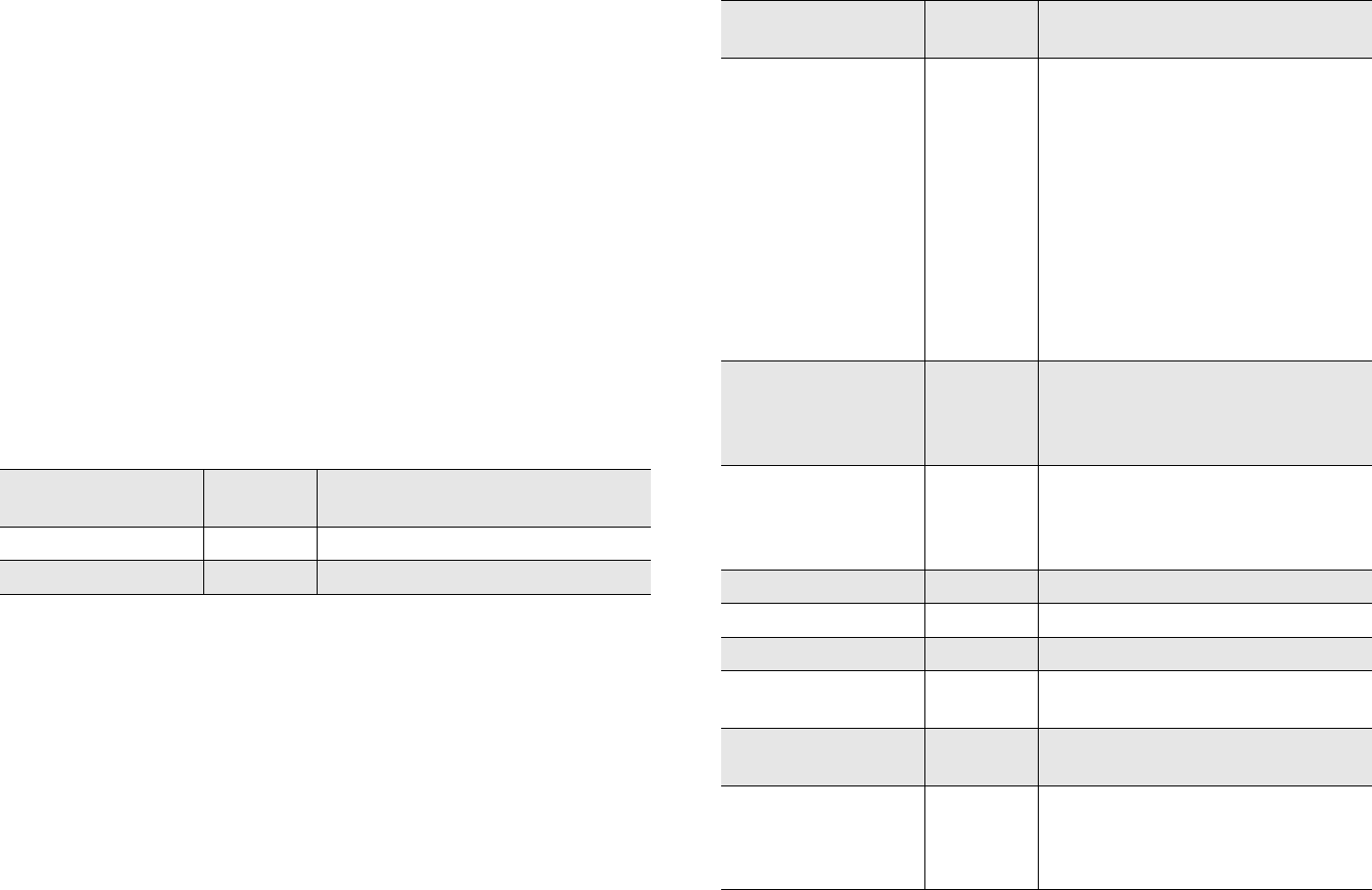
OpenText RightFax 10.0 Administrator’s Guide 206
To specify where the specific sender and destination data will
display for each outgoing fax, use HTML cover sheet codes
described in “Using HTML cover sheet codes”.
Save the cover sheet file with a descriptive name. The file name
will be displayed when the user is selecting a cover sheet.
Use either the extension .htm for HTML files or .mht for MHTML
files. Files with the extension .html will not be recognized by the
RightFax server.
Store completed cover sheet files in the RightFax\FCS folder on
the RightFax server.
Using HTML cover sheet codes
Cover sheet codes specify the types of information that will be
inserted into the cover sheet for each outgoing fax. When a cover
sheet is generated by the RightFax server, the cover sheet codes
are replaced by the data they represent. In HTML cover sheets, all
cover sheet codes are indicated by braces { }.
Table 21a Cover Sheet Codes for HTML Cover Sheets
Code
Maximum
characters Description
{BILLINFO1} 15 Billing code 1 (if any).
{BILLINFO2} 15 Billing code 2 (if any).
{CCTEXT} 69 All the listed recipients of a fax
(including CC and BCC recipients) in
this format:
Name,FaxNum;Name,Faxnum;...
You can include up to 21 {CCTEXT}
codes on a cover sheet, each code
representing one line of recipients up
to 69 characters long. Include one
{CCTEXT} code on each line that
should contain recipients. The cover
sheet will only list the number of
recipients for which space is provided.
{DATEONLY} Variable The date that the fax cover sheet was
generated. The date format is
determined by the default date format
on the RightFax server.
{EMAILADDRESS} Variable The sender’s email address. This is the
email address that is entered in the
RightFax user properties (described
on page 105).
{FAXDIDNUM} 31 The sender’s fax number.
{FROMNAME} 59 The sender’s name.
{FROMPHONENUM} 31 The sender’s phone number.
{GENERALFAXNUM} 31 The general fax number for the
sender’s organization.
{NOTETEXT} Variable The notes added to the fax when it
was addressed.
{NUMPAGES} Variable The number of pages in the fax body,
not including the cover sheet. To
include the cover sheet in the page
count, use the {NUMPAGESC} code.
Table 21a Cover Sheet Codes for HTML Cover Sheets (Continued)
Code
Maximum
characters Description
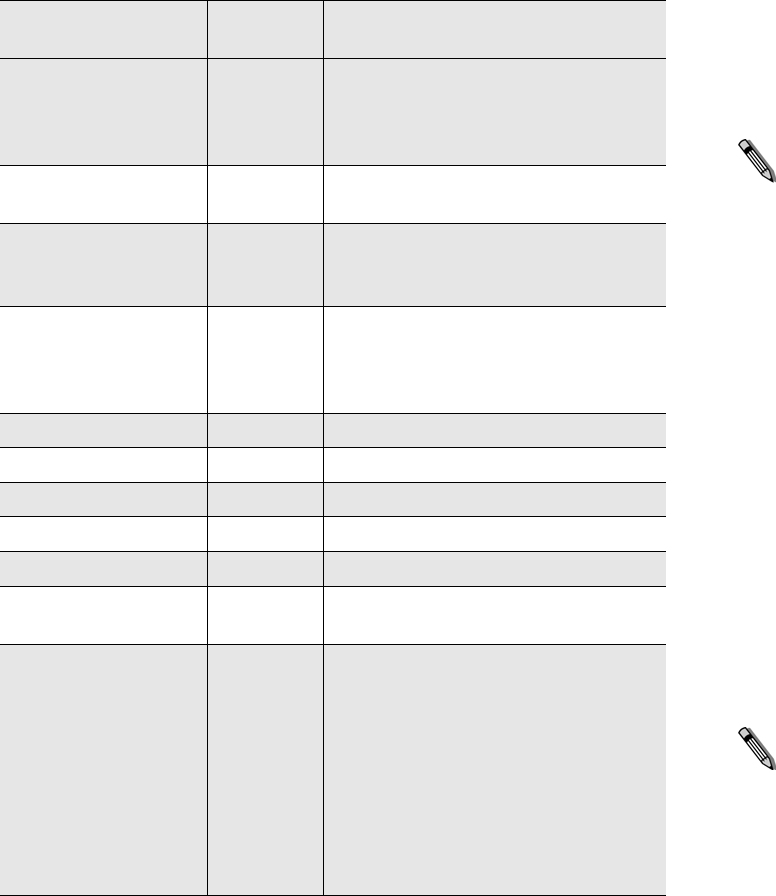
207
Creating a Microsoft Word Cover Sheet
If you have Microsoft Word installed on your RightFax server for
server-side application conversion (described in Chapter 6,
“Configuring Server-Side Application Conversion”), you can create
and use cover sheets in the native Word document format (.DOC).
Note In order to perform native Word document cover sheet generation,
you must have correctly installed and configured Microsoft Word on the
RightFax server (page 77).
When creating a Word cover sheet file, follow these guidelines:
Cover sheets must be stored in .DOC format (not .DOCX). If
you’re using Word 2007 or 2010, you must use the Save As
option to store .DOC files.
Cover sheets stored in the native Word format support all
language character sets supported by Word and Windows,
including Hebrew. Word cover sheet codes can use any
TrueType font in addition to native printer fonts.
RightFax cover sheet files may not be longer than one page. Any
cover sheet information that appears on subsequent pages will
be ignored.
To specify where the specific sender and destination data will
display for each outgoing fax, use Microsoft Word cover sheet
codes described in “Using Microsoft Word cover sheet codes”.
Save the cover sheet file with a descriptive name. The file name
will be displayed when the user is selecting a cover sheet.
Store completed cover sheet files in the RightFax\FCS folder on
the RightFax server.
Note: Native Word cover sheets can take slightly longer to convert to
fax format than PCL files, and this will be exaggerated if the server
running Word has insufficient RAM.
{NUMPAGESC} Variable The number of pages in the fax
including the cover sheet. To exclude
the cover sheet in the page count, use
the {NUMPAGES} code.
{OPERATORNUM} 31 The general phone number for the
sender’s organization.
{ROUTEINFO} Variable The routing information entered in the
user profile of the user creating the fax
(described on page 109).
{TIMEONLY} Variable The time that the fax cover sheet was
generated. The time format is
determined by the default time format
on the RightFax server.
{TOCITYSTATE} 59 The recipient’s city and state.
{TOCOMPANY} 59 The recipient’s organization name.
{TOCONTACTNUM} 31 The recipient’s phone number.
{TOFAXNUM} 31 The recipient’s fax number.
{TONAME} 59 The recipient’s name.
{UNIQUEID} 16 The unique ID assigned to the
outgoing fax.
{WHENFAXED} Variable The date and time the document was
generated by the fax server. This is
different from the time it was actually
faxed to its destination, which is
recorded on the TTI line on each fax
page. The time the fax was processed
by the fax server can be very different
from the time it is actually sent,
especially if you are using the RightFax
Delay Send feature.
Table 21a Cover Sheet Codes for HTML Cover Sheets (Continued)
Code
Maximum
characters Description

OpenText RightFax 10.0 Administrator’s Guide 208
Using Microsoft Word cover sheet codes
Cover sheet codes specify the types of information that will be
inserted into the cover sheet for each outgoing fax. When a cover
sheet is generated by the RightFax server, the cover sheet codes
are replaced by the data they represent.
Cover sheet codes in native Word cover sheets are inserted as
Word DocVariable fields. Word cover sheet codes can be any
TrueType or native printer font.
Note Although double-byte characters added to the text of a Microsoft
Word cover sheet will convert correctly, double-byte characters inserted
into DocVariable fields on Microsoft Word cover sheets will not.
To insert a DocVariable field
1. In your Word cover sheet, position the cursor where you want to
place the cover sheet code and select Field from the Insert
menu. The Field dialog box opens.
2. Click Document Automation, and click DocVariable under
Field Names. This displays DOCVARIABLE in the Field
Codes field.
3. Add the cover sheet code to the variable in the format:
DOCVARIABLE code
Where code is one of the supported cover sheet codes listed in
the following table. For example, the following cover sheet code
displays the destination fax number:
DOCVARIABLE ToFaxNum
Note The DocVariable field will not appear in your document unless
you have selected Field Codes in the View tab of the Word Options
dialog box.
4. Click OK to insert the code.
Table 21b Native Word Document Cover Sheet Codes
Variable name Description
BillInfo1 The first billing code assigned to the fax
BillInfo2 The second billing code assigned to the fax
CCText The carbon copy (cc) recipient list for the fax.
Use one CCText code only to display all of
your cc recipients
EmailAddress The sender’s email address. This is the email
address that is entered in the RightFax user
properties (described on page 105).
FaxDate The date and time the fax was originally
created, as opposed to the time of the send
attempt
FaxDIDNum The sender’s direct fax number
FaxSendDate The date and time the fax was scheduled to
send, (if the fax was time-delayed)
FromName The sender’s name
FromPhone The sender’s personal voice number
GeneralFaxNum The general fax number for the sender’s
organization.
NoteText Cover sheet notes. Use one NoteText code
only to display all of your note text, even if your
cover sheet notes are comprised of multiple
<NOTE> embedded codes (page 299). If
your cover sheet displays only one line of note
text, place a carriage return immediately after
the DOCVARIABLE code.
NumPages Number of pages in the fax, excluding the
cover page
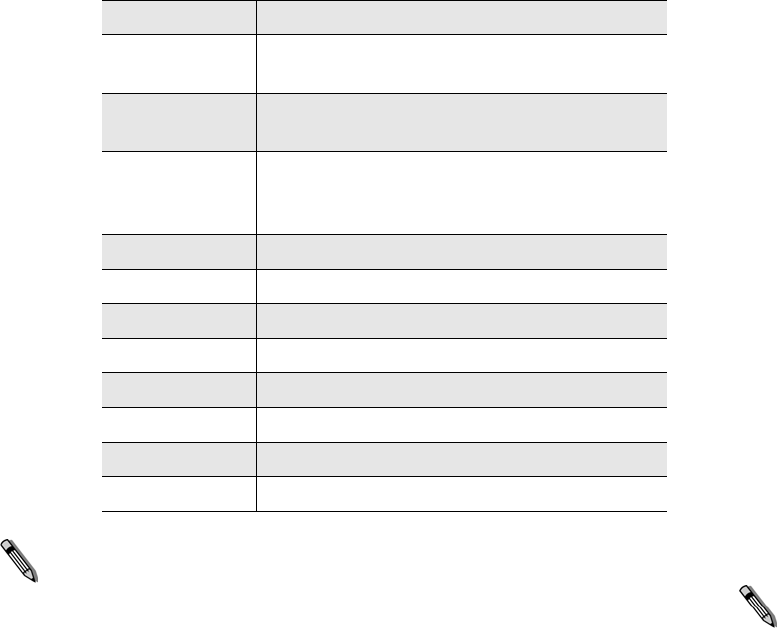
209
Note If you place cover sheet codes in a Word text box, and the text
box is not large enough to fit all of the text that replaces the codes,
any extra text will be truncated on the cover sheet. You can fix this by
increasing the size of the text box.
Creating a PCL Cover Sheet
You can store a cover sheet as a PCL (Printer Control Language)
file using any application that has the ability to print to a PCL5 file.
You can’t directly edit a PCL file, so it is a good idea to store both
the source file (such as a .doc or .txt) and the PCL output on the
RightFax server.
When creating a PCL cover sheet file, follow these guidelines:.
RightFax cover sheet files may not be longer than one page. Any
cover sheet information that appears on subsequent pages will
be ignored.
To specify where the specific sender and destination data will
display for each outgoing fax, use PCL cover sheet codes in your
source file as described in “Using PCL cover sheet codes”.
To save your source as a PCL5 file, select an HP LaserJet 4 or
compatible printer driver and select the “Print to file” option in
your application’s Print dialog box.
Save the cover sheet file with a descriptive name. The file name
will be displayed when the user is selecting a cover sheet. Make
sure you use the extension .PCL to indicate the file type.
Store completed cover sheet source files and the PCL output file
in the RightFax\FCS folder on the RightFax server.
RightFax is shipped with sample cover sheet files and the source
documents they were created from. You can edit these source files
rather than create a new cover sheet. Using Microsoft Word for
Windows 6.0 or later, open the FCS.doc file in the
RightFax\FCS\PCL_Source folder, make any desired changes, and
print the modified cover sheet to a file in the RightFax\FCS folder
with the extension .pcl.
Note If you have trouble modifying the sample cover sheet and are
using Microsoft Word 97 or later, select Options in the Tools menu and
click the Compatibility tab. Select “Microsoft Word 6.0” in the
Recommend Options For field.
Using PCL cover sheet codes
Cover sheet codes specify the types of information that will be
inserted into the cover sheet for each outgoing fax. When a cover
sheet is generated by the RightFax server, the cover sheet codes
are replaced by the data they represent.
NumPagesC Number of pages in the fax, including the cover
page
OperatorNum The general phone number for the sender’s
organization.
RouteInfo The routing information entered in the user
profile of the user creating the fax (described
on page 109).
ToCityState Recipient location
ToCompany Recipient company name
ToContactNum Recipient voice phone number
ToFaxNum Destination fax number
ToName Recipient name
UniqueID The unique ID assigned to the fax
UserID RightFax user ID of fax sender
UserName RightFax User Name of fax sender
Table 21b Native Word Document Cover Sheet Codes (Continued)
Variable name Description
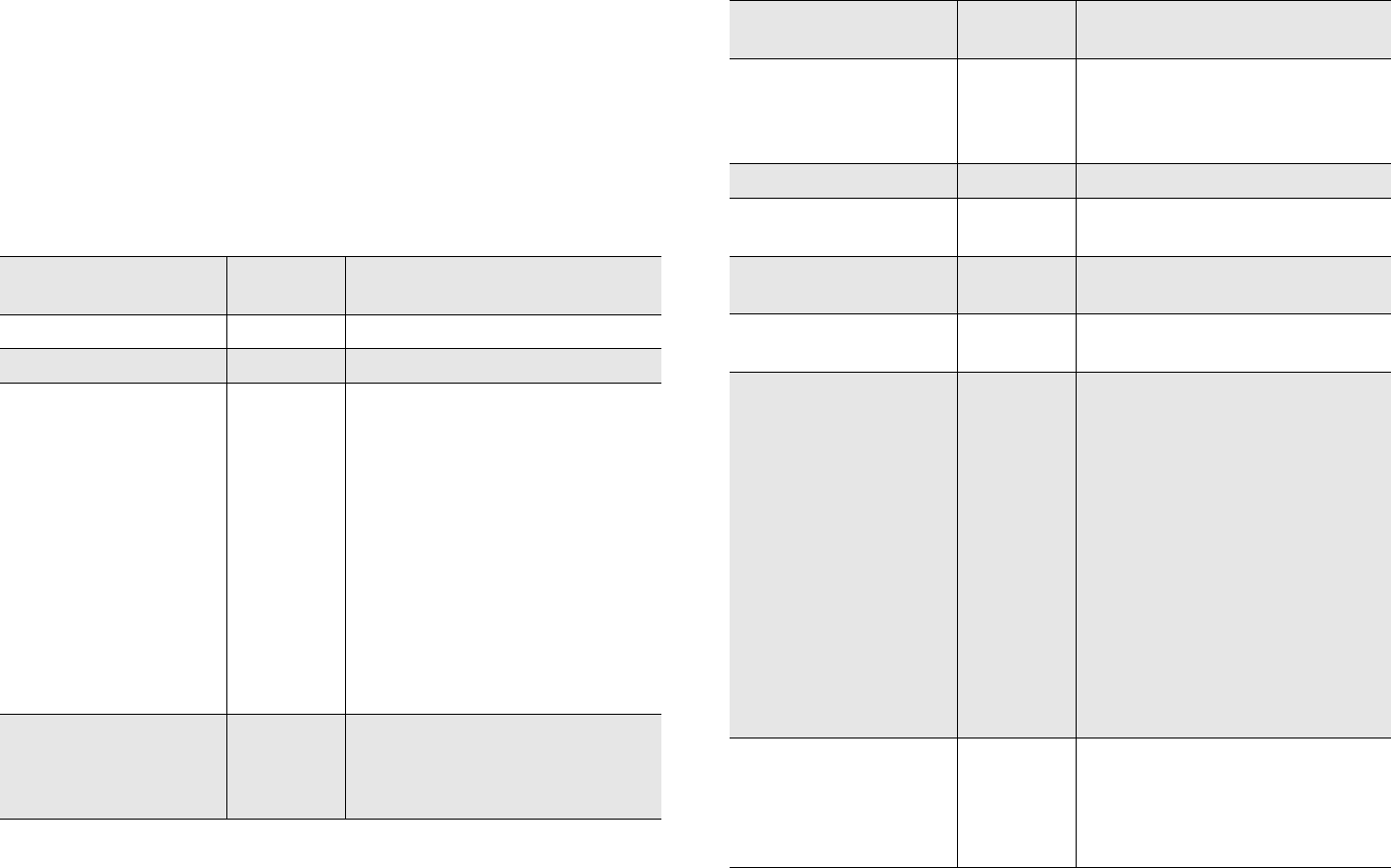
OpenText RightFax 10.0 Administrator’s Guide 210
Although you can use any font in the text of your cover sheets, PCL
cover sheet codes must always use a native printer font. When the
cover sheet document is printed to PCL5 format, only the native
fonts are stored in text format. All other font types are converted to
graphic images. If you enter a non-native font in the cover sheet
code, RightFax will not be able to convert the code to data, and the
code itself will appear on the coversheet.
PCL cover sheet codes are surrounded by angle brackets (< >),
which must also use the same native printer font.
Table 21c Cover Sheet Codes for PCL Cover Sheets
Code
Maximum
Characters Description
<BILLINFO1> 15 Billing code 1 (if any).
<BILLINFO2> 15 Billing code 2 (if any).
<CCTEXT> 69 All the listed recipients of a fax
(including CC and BCC recipients)
in this format:
Name,FaxNum;Name,Faxnum;...
You can include up to 21
{CCTEXT} codes on a cover sheet,
each code representing one line of
recipients up to 69 characters long.
Include one {CCTEXT} code on
each line that should contain
recipients. The cover sheet will only
list the number of recipients for
which space is provided.
<DATEONLY> Variable The date that the fax cover sheet
was generated. The date format is
determined by the default date
format on the RightFax server.
<EMAILADDRESS>
<EMAIL_ADDRESS>
Variable The sender’s email address. This is
the email address that is entered in
the RightFax user properties
(described on page 106).
<FAXDIDNUM> 31 The sender’s fax number.
<FROMNAME>
<FROM_NAME>
59 The sender’s name.
<FROMPHONENUM>
<FROM_PHONENUM>
31 The sender’s phone number.
<GENERALFAXNUM> 31 The general fax number for the
sender’s organization.
<NOTETEXT> 69 The notes added to the fax when it
was addressed. You can include up
to 21 <NOTETEXT> codes on a
cover sheet, each code
representing one line of notes up to
69 characters long. Include one
<NOTETEXT> code on each line
that you want notes to be listed on.
The cover sheet will only include as
much note text as there is space
allotted for. If the notes for a fax are
shorter than the space provided by
<NOTETEXT> codes, the
remaining lines will be filled with
blanks.
<NUMPAGES> Variable The number of pages in the fax
body, not including the cover sheet.
To include the cover sheet in the
page count, use the
<NUMPAGESC> code.
Table 21c Cover Sheet Codes for PCL Cover Sheets (Continued)
Code
Maximum
Characters Description
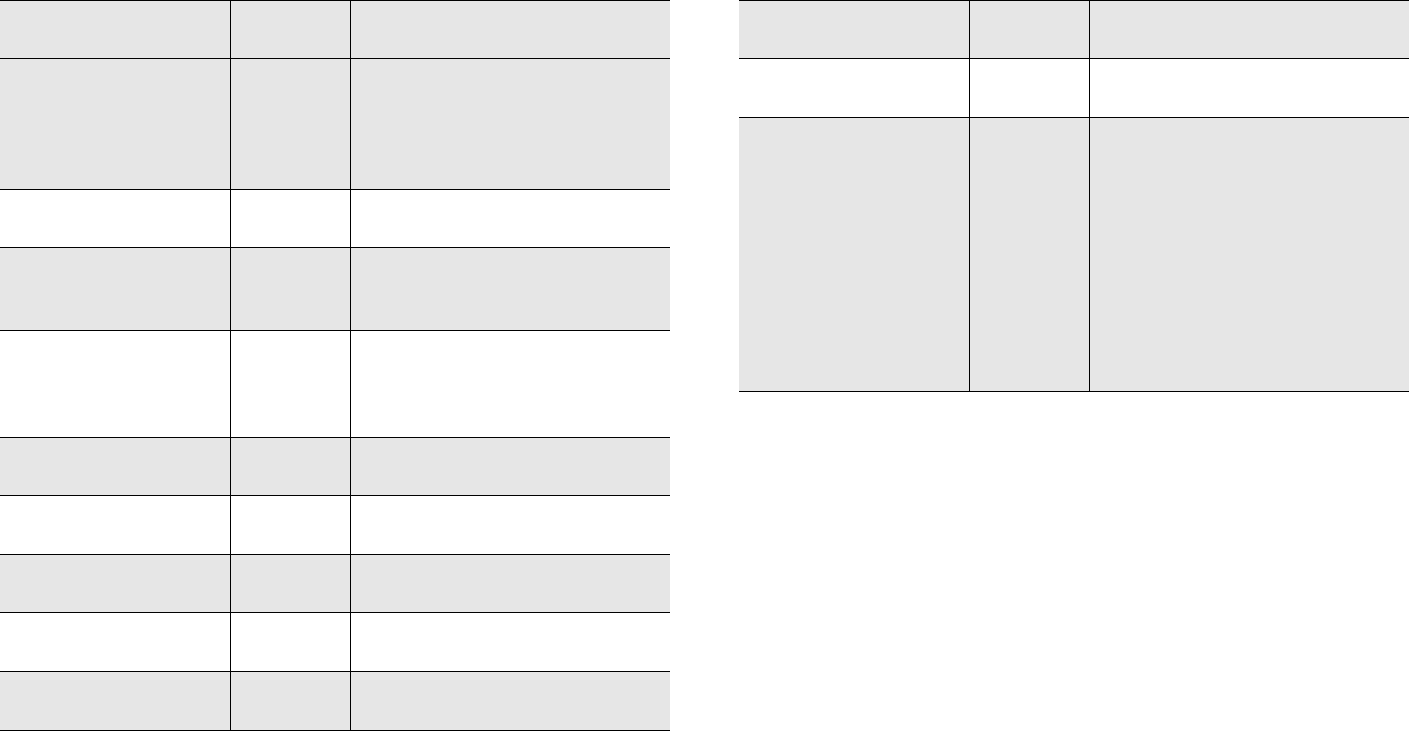
211
Selecting a Cover Sheet File
If your organization has several fax cover sheets for different types
of faxes, users who have been assigned the appropriate
permissions can specify which cover sheet to use for each fax they
send. In addition, you can specify a default cover sheet for each
user or each group of users.
The default cover sheet is the FCS.pcl file in the RightFax\FCS
folder. This is the cover sheet that is used if no other cover sheet
file is specified.
To assign a user permission to change cover sheets
1. Run Enterprise Fax Manager (see “Starting Enterprise Fax
Manager” on page 93).
2. Click Users under the appropriate server and double-click the
user ID to modify.
<NUMPAGESC> Variable The number of pages in the fax
including the cover sheet. To
exclude the cover sheet in the page
count, use the <NUMPAGES>
code.
<OPERATORNUM> 31 The general phone number for the
sender’s organization.
<ROUTEINFO> Variable The routing information entered in
the user profile of the user creating
the fax (described on page 109).
<TIMEONLY> Variable The time that the fax cover sheet
was generated. The time format is
determined by the default time
format on the RightFax server.
<TOCITYSTATE>
<TO_CITYSTATE>
59 The recipient’s city and state.
<TOCOMPANY>
<TO_COMPANY>
59 The recipient’s organization name.
<TOCONTACTNUM>
<TO_CONTACTNUM>
31 The recipient’s phone number.
<TOFAXNUM>
<TO_FAXNUM>
31 The recipient’s fax number.
<TONAME>
<TO_NAME>
59 The recipient’s name.
Table 21c Cover Sheet Codes for PCL Cover Sheets (Continued)
Code
Maximum
Characters Description
<UNIQUEID> 16 The unique ID assigned to the
outgoing fax.
<WHENFAXED>
<WHEN_FAXED>
<DATE>
Variable The date and time the document
was generated by the fax server.
This is different from the time it was
actually faxed to its destination,
which is recorded on the TTI line on
each fax page. The time the fax was
processed by the fax server can be
very different from the time it is
actually sent, especially if you are
using the RightFax Delay Send
feature.
Table 21c Cover Sheet Codes for PCL Cover Sheets (Continued)
Code
Maximum
Characters Description
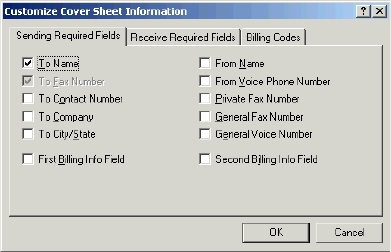
OpenText RightFax 10.0 Administrator’s Guide 212
3. Click the Permissions tab and select the Can Change Cover
Sheets check box.
To specify a cover sheet on a fax
When a user is entering the fax addressing information in the Fax
Information dialog box (page 235), a check box in the lower left
lets the user specify whether or not to include a fax cover sheet.
The cover sheet is included only with the current fax.
Users can include the <FCSFILE> code in documents (see
Appendix A, “RightFax Embedded Codes”) which specifies a cover
sheet file to use for that document.
Changing a user’s default cover sheet
To assign a new default cover sheet to a specific user, run
Enterprise Fax Manager (see “Starting Enterprise Fax Manager” on
page 93), click Users under the appropriate server, double-click
the user ID to modify, and click the Default Outbound Settings
tab. Under Cover Sheet Defaults, select the Send Cover Sheets
check box, and select the cover sheet file to use in the Cover
Sheet Model box.
Changing a group’s default cover sheet
To assign a default cover sheet to a RightFax group, run Enterprise
Fax Manager (see “Starting Enterprise Fax Manager” on page 93),
click Groups under the appropriate server, double-click the group
ID to modify, and click the Basic Information tab. Select the cover
sheet file to use in the Cover Sheet Model box.
Requiring cover sheet fields on outgoing faxes
To transmit an outgoing fax, information about the recipient must be
completed in the Fax Information dialog box. The RightFax
administrator can specify how much information the user must
complete before the fax will send. To set the required fields, run
Enterprise Fax Manager (see “Starting Enterprise Fax Manager” on
page 93) and select Customize Cover Sheet Fields from the
Utility menu. The Customize Cover Sheet Information dialog box
opens.
Figure 21.1 Required Fields for Outbound Faxes
Select the check box next to each field you want to require. The To
Fax Number option is required in order to send the fax, so it
cannot be cleared. If all of the required fields on an outgoing fax are
not completed, the fax will remain in a user’s FaxUtil mailbox with
the status “Info Not Complete.”
Requiring cover sheet fields on received faxes
You can specify required fields for received faxes. This allows you
to require that the fax recipient include billing codes or other fields
for billing records.
In the Customize Cover Sheet Information dialog box, click the
Receive Required Fields tab. Select the check box next to each
field that you want to require.
If a fax arrives that does not include all required fields, the recipient
will not be able to delete the received fax without completing the
specified fields.
213
Chapter 22
Routing Inbound Faxes
The RightFax server provides several methods for routing received
faxes to their intended recipients in your organization. The routing
method you choose will be based primarily on the type of telephone
service you use.
To route faxes to users, assign a unique routing code to each user.
RightFax attempts to match information from the received fax (such
as digits dialed to the routing code) to one of the defined RightFax
users. This user is then determined to be the intended fax recipient.
After RightFax has determined who should receive an incoming fax,
you then have several options for how that fax should be delivered
(for example, to the FaxUtil mailbox or attached to an email
message).
Configuring DID/DNIS Routing
Direct Inward Dial (DID) lines support inbound phone service only,
and Dialed Number Identification Service (DNIS) supports
bi-directional faxing. These two methods are considered the most
accurate for fax routing.
A DID/DNIS interface assigns multiple telephone numbers to a
single pair of wires (a telephone trunk). Often these numbers are
sequential and all contain the same prefix. For example, a single
DID/DNIS line may have 20 numbers associated with it ranging
from 555-1001 to 555-1020. Your phone company will forward
any or all of these dialed numbers to your system along with the
call. RightFax then uses these included numbers to route faxes to
the proper recipients.
Each RightFax user is assigned a personal fax mailbox that is
assigned a DID/DNIS number (routing code). When a call comes
in with a valid DID/DNIS number, the fax is placed in the
corresponding user’s fax mailbox.
1. Configure the RightFax server and fax board(s) for DID/DNIS
routing by running the RightFax BoardServer configuration
program. Each fax board must be configured for DID/DNIS
routing separately. See “Brooktrout Fax Board Configuration”
on page 52 for more detail.
2. Assign routing codes to users in accordance with the number of
DID/DNIS digits for which your services are configured. For
example, if you have a set of DID/DNIS numbers of 555-1001
through 555-1020, and your phone service is configured to
forward the last four digits of the dialed number, then you would
assign the routing codes 1001 through 1020 to your users. If
you have three digit service, then you would assign the routing
codes 001 through 020 to your users.
3. From the Enterprise Fax Manager, click Users and then
double-click a user name to open the User Edit dialog box.
OpenText RightFax 10.0 Administrator’s Guide 214
4. Click the Inbound Routing tab, and enter the user’s DID/DNIS
phone extension code in the Routing Code box.
Note: The number you enter in the user’s Routing Code box must have
the exact number of digits that you specified in the Number of Digits
for Routing box when configuring the fax boards.
Configuring DTMF Routing
Unlike DID/DNIS routing, DTMF uses Plain Old Telephone Service
(POTS) with a single phone number assigned to each phone line.
The person sending the fax dials this number and the call connects
normally. However, before the fax transmission starts, the fax board
prompts the caller with a tone or voice prompt to enter a routing
code for the fax they are sending.
If the caller enters a valid routing code (one that is assigned to a
RightFax user) the fax is placed in that user's mailbox. If the caller
does not enter a code before a certain amount of time has elapsed,
or if the code does not correspond to a valid RightFax mailbox, the
fax is placed in the mailbox that corresponds to the Channel
Extension setting for the channel it arrived on (or to the
administrator of the Everyone group if no channel extension match
is found).
To configure DTMF routing:
1. Configure the RightFax server and fax board(s) for DTMF
routing by running the RightFax BoardServer configuration
program (see “Configuring Brooktrout Channels” on page 59).
Each fax channel must be configured for DTMF routing
separately.
2. From the Enterprise Fax Manager, click Users and then
double-click a user name to open the User Edit dialog box.
3. Click the Inbound Routing tab, and enter the user’s DTMF
code in the Routing Code box. The digits entered here
correspond directly to the digits entered by the caller when
prompted.
Configuring Channel Routing
With channel routing, faxes are routed based on the phone line on
which they are received. For example, if each of your departments
use a unique fax number, all faxes to that number are delivered to a
single fax mailbox. Each of the members of the department can
check the department mailbox for faxes, the faxes can be directed
to a printer located in the department, or each fax can be routed to
the intended recipient.
Configuring RightFax for channel routing
Each fax channel must be configured for channel routing
separately. To configure the RightFax server and fax boards for
channel routing, run the RightFax BoardServer configuration
program.
Click each channel number under the fax board names. For each
channel, set the Channel Extension to a number between 1 and
99. This setting will correspond to the Routing Code of the mailbox
that is to receive all faxes coming in on this channel. You can also
set two or more channels to the same Routing Extension if you
want a single mailbox to receive faxes from multiple channels.
Channel routing with digital fax boards
To implement channel routing with digital fax boards, set the
Windows registry value DoDigitalChanRoute to 1. See
“DoDigitalChanRoute” on page 327.

215
Configuring recipient mailboxes
To assign channel extensions to mailboxes, edit the user profile for
each recipient mailbox in Enterprise Fax Manager. Click the
Inbound Routing tab and enter the Channel Extension setting of
the channel that you want to receive faxes from in the Routing
Code box.
Configuring ANI Routing
ANI (Automatic Number Identification) is a service provided by
telephone service providers. It precedes each incoming phone call
with a series of digits that includes (among other things) the phone
number dialing in.
RightFax can use ANI information to route inbound faxes to a user
mailbox based on the phone number that the fax originated from.
Using ANI routing, all faxes from a certain phone number can be
routed to a specific recipient. Similarly, all faxes originating from a
specific area code or telephone number prefix can be routed to a
specific recipient. This routing method can be useful to sales
departments for routing faxes according to sales territories.
ANI routing is not available with analog fax boards.
Configuring RightFax for ANI routing
To route faxes with ANI routing, the faxes must arrive in one
“central” mailbox. This mailbox is configured so that all incoming
faxes are rerouted using ANI routing.
In most cases, one central mailbox performing ANI routing is
sufficient. If the needs of your organization require you to create
multiple central mailboxes, each mailbox must have a routing code
that corresponds to a channel extension configured in the
BoardServer.
To create a central mailbox for ANI routing,
1. Run Enterprise Fax Manager and add a new RightFax user
called “ANI”.
2. For the new user ANI, edit the user properties. On the Inbound
Routing tab, enter “0” (zero) in the Routing Code box. This will
cause all incoming faxes whose owners cannot be determined
to automatically route to this mailbox.
3. Click ANI in the Routing Type box. This configures the mailbox
to perform ANI routing on each received fax.
Note Only the central mailbox should have its Routing Type set to
ANI. Do not set the routing type of individual RightFax user mailboxes
to ANI or each user’s mailbox will attempt to reroute all received
faxes, potentially creating endless routing loops.
4. If you haven’t already done so, enter the ANI pattern matching
string in the DocTransport module. See “ANI Pattern Match” on
page 52.
5. On the RightFax server, create an ASCII file called Ani.tbl in the
RightFax\Bin folder. This file is the ANI routing table. Each line
must contain a separate entry using this format:
RoutingCode ANIString
Where RoutingCode is the routing code setting of the user to
route to and ANIString is the ANI data represented by ‘X’
characters in the ANI pattern match. The ANI string and routing
code must be separated by a single space. Here is an example
of a short ANI routing table:
1001 15205551212
1002 15205552345
1003 15205550982
1004 15203201000
OpenText RightFax 10.0 Administrator’s Guide 216
Creating alternate routing tables
You can set up multiple central mailboxes for ANI routing. For
example, you could set up a mailbox that receives and routes faxes
to the Sales department. Create a central mailbox for Sales, and
specify a routing table called Sales.tbl.
To specify the routing table for the mailbox, edit the user profile for
the mailbox in Enterprise Fax Manager, click the Inbound Routing
tab, and type the file name in the Routing Info box. The custom
routing table files must be located in the RightFax\Bin folder.
Configuring CSID Routing
CSID (caller subscriber identification) routing routes inbound faxes
to a specific mailbox based on the ID of the sending device. Using
CSID routing, faxes sent from a specific fax number can be routed
to a specific recipient.
This method relies on data from the sending device, which may or
may not include a fax phone number. The CSID may be the
company name or other data, and it may be impossible to match
with data in RightFax. For this reason, CSID routing can be an
unreliable method of routing.
CSID routing precludes some other routing types like DTMF and
channel routing. However, routing types that occur after arriving in
a fax mailbox (like OCR routing) can still be used. If an ID for the
sending device is not transmitted or cannot be determined, the fax
is placed in the mailbox that corresponds to the Channel
Extension setting for the channel it arrived on (or to the
administrator of the Everyone group if no channel extension match
is found).
Configuring RightFax for CSID routing
To configure RightFax for CSID routing, run the RightFax Server
configuration program. Click the General tab and select Enable
CSID Routing.
On the RightFax server, create an ASCII file called CSID.tbl in the
RightFax\Bin folder. The CSID.tbl file is the CSID routing table.
Each line must contain a separate entry using this format:
RoutingCode CSID
where RoutingCode is the routing code setting of the user to route
to, and CSID is the CSID information (either text or a phone
number) that, when sent, will route to that user. The routing code
and CSID must be separated by a single space. The CSID text can
contain spaces and other special characters. Here is an example of
a short CSID routing table:
1001 520*
1002 Acme, Inc.
1003 RIGHTFAX
The asterisk (*) wildcard character can be used to represent any
unspecified characters at the end of the CSID string. This wildcard
can only be used at the end of the CSID string in the CSID.tbl file,
and all characters preceding the wildcard must match the incoming
CSID exactly for routing to be successful. In the preceding
example, all incoming faxes with CSIDs that indicate they
originated from area code 520 will be routed to the RightFax user
with the routing code 1001.
Configuring Delivery Methods for Users
After you have configured a routing method for your organization,
you have several options for the delivery method to the user. The
delivery method is configured individually for each RightFax user.
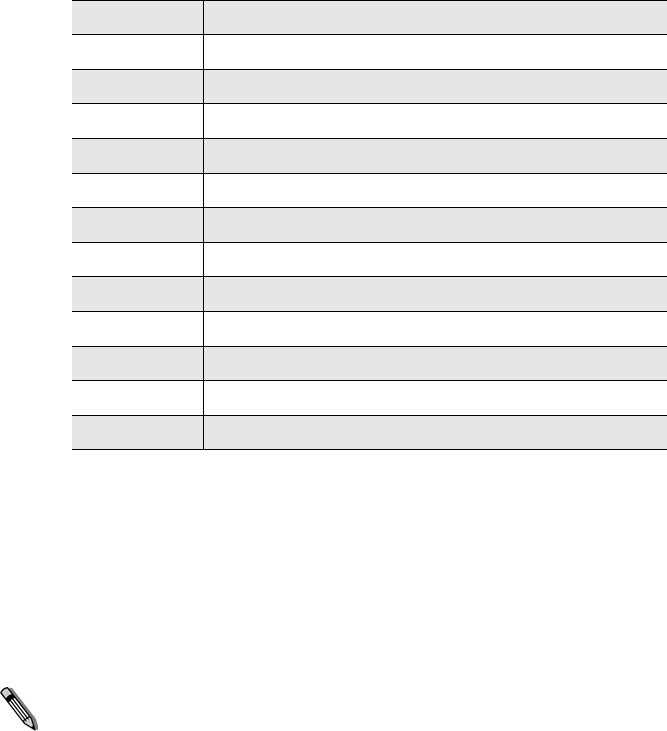
217
To assign a delivery method to a user
1. Run Enterprise Fax Manager (see “Starting Enterprise Fax
Manager” on page 93), and click Users under the RightFax
server in the Fax Server Tree. The list of users appears in the
right pane of the window.
2. Double-click a user to edit the user’s profile. The User Edit dialog
box opens.
3. Click the Inbound Routing tab, and select the delivery method
in the Routing Type box. Delivery options include:
Fax mailbox When you select this routing type, incoming faxes
will be routed to the user’s FaxUtil mailbox.
Email When you select this routing type, incoming faxes are
forwarded to the user as an email message. If you select this
option, you must also provide the necessary routing information in
the Routing Info box so that RightFax can find the correct email
mailbox. For information on routing faxes to an email mailbox see
“Receiving Faxes via Email” on page 266, or refer to the
documentation included with the RightFax email gateway module.
Network directory When you select this routing type, incoming
faxes will be sent to a network folder that you specify. If you select
this option, you must type the path to the folder in the Routing Info
box and/or choose from several macros as to how you would like
the faxes stored (such as by month, day, or billing code).
Example The following entry in the Routing Info box would route
faxes to the RightFax\Faxin folder on the \SYS volume of
the FILESERV file server:
\\fileserv\sys\rightfax\faxin
In this example, the RightFax fax server would have to be
attached to FILESERV with sufficient privileges to write
to the Faxin folder. RightFax will create any specified
folders, assuming it has the necessary network access
privileges.
The destination path can also specify one or more folder macros
that cause unique or descriptive folders to be created dynamically.
The following table lists the available folder macros.
Example Entering \\FILESERV\SYS\RIGHTFAX\~1 will cause
the fax server to create a folder
\\FILESERV\SYS\RIGHTFAX\20020101 when storing
a fax received on January 1, 2002.
The file name stored in this folder is a unique name assigned by the
RightFax server and cannot be changed. The total length of the
path, after macro replacement, cannot exceed 72 characters.
Note Only received faxes will be routed to a network folder using this
method. If a sent fax is forwarded or routed from one RightFax user to
another RightFax user with a network routing destination specified, the
fax will appear in the recipient’s fax mailbox, but will not appear in the
specified network folder.
Table 22a Dynamic Folder Generation Macros
Macro Definition
~1 Date (YYYYMMDD)
~2 Day of the week (SUN–SAT)
~3 Month (JAN–DEC)
~4 Year (YYYY)
~5 Day of the month (DD)
~6 Month as decimal (01–12)
~7 User ID (truncated to 11 characters)
~8 Week of year as decimal (00–51)
~9 Billing Code 1 (truncated to 11 characters)
~0 Billing Code 2 (truncated to 11 characters)
~A Remote ID (left to right, truncated to 11 characters)
~B Remote ID (right to left, truncated to 11 characters)

OpenText RightFax 10.0 Administrator’s Guide 218
OCR When you select this routing type, incoming faxes will be
OCRed for recognizable character strings, compared to a table of
RightFax user IDs and matching strings, and, when a match is
found, routed to the appropriate user. No additional routing
information is necessary if you plan to use the default OCR routing
table Route.txt.
This routing type requires RightFax OCR Routing module,
purchased separately.
RightFax InterConnect When you select this routing type,
incoming faxes will be redirected from one RightFax server to
another. In the Routing Info box, enter the destination RightFax
server name. The InterConnect service must be enabled on at least
one of the receiving RightFax server’s WorkServers, and the
RightFax user account (user ID) of the fax recipient must exist on
both RightFax servers.
Auto-printing, auto-OCR, and auto-forwarding are not available
with this routing type, because they are performed by the
destination fax server only. This routing type requires the RightFax
Enterprise server.
Note By default, faxes routed from one RightFax server to another
RightFax server in a different time zone will have the time and date stamp
from the originating server. To change this so that faxes have the time and
date of the receiving server, set the Windows registry value
InterconnectSetTZ to 1. See “InterconnectSetTZ” on page 334.
Telephony server RightFax can route incoming faxes to a
telephony server mailbox. In the Routing Info box, enter the
telephony server routing information using this format:
(NP: or TCP:)server/source/sourcepassword/destination
Where NP: or TCP: represents the network protocol, either named
pipes or TCP/IP.
Distributing Faxes to a Group of Users
Smart Fax Distribution is a method of distributing received faxes
between all the members of a user group.
With Smart Fax Distribution, the user group that will share the faxes
is assigned a Routing Code. Faxes that are routed to the group ID
are then distributed between the group members (using each
individual’s configured routing method) either round-robin or
according to each user’s ability to process the faxes.
To configure Smart Fax Distribution for user groups, see “The
Smart Fax Distribution tab” on page 123.
Assigning Unique ID Numbers to Fax File Names
and Routing to a Network Folder
Faxes stored in a network folder can be assigned unique ID
numbers, and the ID numbers can be used as the file names. By
default, RightFax generates and assigns unique ID numbers to
each fax it receives. You can specify an alternative ID number
scheme if you want to store faxes on a network folder. For example,
you can specify an ID that consists of the server name, date, and
page count.
This unique ID number is printed on the fax page in the receipt
terminal information (RTI) line.
To assign unique IDs, complete the following tasks:
1. Set the Windows registry value for UseReceiveStampUnique
to 1 on the FaxServer and on each WorkServer. See
“UseReceiveStampUnique” on page 332 and page 336.
2. In Enterprise Fax Manager, select the server.
3. In the Service Name list, double-click RightFax WorkServer#
Module. The WorkServer Configuration dialog box opens.
219
4. Under Services, select FileRoute, and click to clear the
selection of Archive.
5. Under Archive Settings, select the Separate File Per Page
Output check box.
6. Repeat steps 3 through 5 for each WorkServer that you want to
handle file routing.
7. Specify the users whose faxes should be routed to the folder.
8. In Enterprise Fax Manager, edit each user whose received faxes
should be routed. In the User Edit dialog box, click the
Permissions tab. Select the check box Stamp Pages of
Received Faxes with Audit Stamp.
9. Click the Inbound Routing tab. In the Routing Type box, select
Network Directory.
10.In the File Format box, select TIFF (G3-1D) or TIFF (G4).
11.In the Routing Info box, type the name of the folder where the
faxes will be saved.
OpenText RightFax 10.0 Administrator’s Guide 220
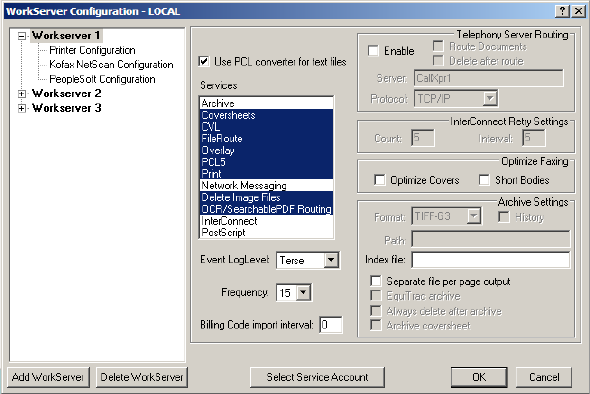
221
Chapter 23
Using Optical Character Recognition
RightFax can be licensed to use Optical Character Recognition
(OCR) to convert images of text in received faxes into standard,
editable text files. The OCR software also converts bar codes on
received faxes into numbers. The resulting text files can then be
viewed, edited, or used to automatically route faxes to their
intended recipients.
To configure OCR conversions, you must enable OCR on the
workservers. grant OCR permission to each user who will be
authorized to use the feature, and enable OCR and the output file
defaults for each user. Users can choose whether to convert select
faxes or automatically convert all received faxes to text.
Once you have OCR enabled, you can also configure the server to
use the OCR results to route each fax to a RightFax user. To use
OCR routing, you must enable OCR on the workserver and create
a routing table that specifies the text strings that identify each user.
Enabling OCR Processing on the WorkServers
To enable OCR functionality on the RightFax server, it must be
added as a process to at least one WorkServer. You can enable
OCR processing on as many WorkServers as you want.
1. Run the WorkServer configuration program from Windows
Control Panel on the RightFax server to display the WorkServer
Configuration dialog box.
2. In the component tree in the left pane, select the WorkServer
that you want to perform OCR processing.
Figure 23.1 The WorkServer Configuration dialog box
3. To enable OCR processing, click OCR/SearchablePDF
Routing in the Services list.
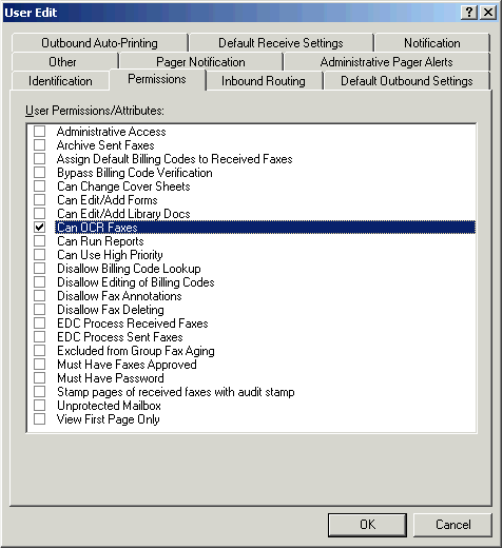
OpenText RightFax 10.0 Administrator’s Guide 222
4. Click OK to save your changes and close the WorkServer
Configuration dialog box.
Configuring RightFax Users for OCR Conversion
Before a user can receive OCR versions of fax images, you must
specifically grant the user permission to access the OCR function,
and the user must specify which faxes that are to be converted.
Granting OCR Permissions
You must grant each individual RightFax user permission to perform
OCR conversion on received faxes. Because OCR conversion is
very processor-intensive, you may choose to restrict OCR rights to
a limited number of users.
To give a RightFax user OCR permission,
1. Run Enterprise Fax Manager, and double-click the user name to
open the User Edit dialog box.
2. Click the Permissions tab and select Can OCR Faxes.
Figure 23.2 Enabling OCR for RightFax Users
3. Click the Default Receive Settings tab.
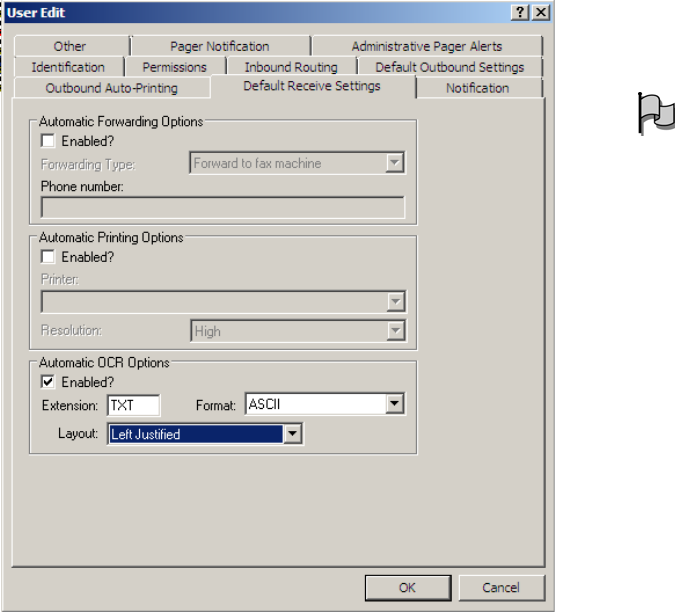
223
4. Under Automatic OCR Options, select the Enabled? check
box to automatically convert all received faxes using OCR. Enter
a default three-letter file extension for the output file in the
Extension box. Valid options are TXT, RTF, or DOC.
5. In the Format box, select the text format used to interpret your
fax pages. “ASCII” produces a plain text file. “RTF” (rich text
format) preserves fonts and formatting but is only available to
Windows users.
6. Click OK to close the User Edit dialog box.
Using OCR to Route Received Faxes
When you route using OCR, the text on the received fax cover
sheet is compared to a customized routing table that contains
names and other text that identifies RightFax users in your
organization. When a match is found, the fax is routed to the
specified RightFax user.
Important Because large organizations can have several members
with the same or very similar names, OCR routing is not recommended
as a primary routing method. For large organizations, OCR routing should
be used only as a backup for other fax routing methods (described in
Chapter 22, “Routing Inbound Faxes”). With other fax routing methods, a
mailbox can be configured that receives all “lost” faxes whose intended
recipient cannot be determined. These “lost” fax mailboxes can then be
configured for OCR routing.
Barcodes are decoded to the equivalent text strings, and will be
treated just like any other OCR text string.
To use OCR routing, you must configure a “central” mailbox from
which the faxes will be routed, and then you must create a custom
routing table that contains RightFax user IDs and their associated
text. When a fax arrives in the central mailbox, the cover sheet text
is checked against the routing table for a match. If a match is found,
the fax is routed. If no match is found, the fax remains in the central
mailbox.
Creating and configuring the OCR central mailbox
To use OCR to route faxes to their intended recipients, the faxes
must arrive in one or more “central” mailboxes. These mailboxes are
configured so that all incoming faxes are rerouted using OCR
routing.
To create a central mailbox for OCR routing, run Enterprise Fax
Manager and add a new RightFax user called “OCR,” and then edit
the user properties. Click the Inbound Routing tab, and enter “0”
(zero) in the Routing Code box. This will cause all incoming faxes
whose owners cannot be determined to automatically route to this

OpenText RightFax 10.0 Administrator’s Guide 224
mailbox. Next, click the Inbound Routing tab, and click OCR in the
Routing Type box. This configures the mailbox to perform OCR
routing on each received fax.
Note Only the central mailbox should have its Routing Type set to OCR.
Do not set the routing type of individual RightFax user mailboxes to OCR
or each user’s mailbox will attempt to reroute all received faxes,
potentially creating endless routing loops.
In most cases, one central mailbox performing OCR routing is
sufficient. If the needs of your organization require you to create
multiple central mailboxes, each mailbox must have a routing code
that corresponds to a channel extension configured in the
BoardServer.
Creating the OCR routing table
The OCR routing table is a text file that is used to link text on the
fax cover sheet to specific RightFax user IDs. This file must be
called Route.txt and it must be located in the RightFax\WorkSrv
folder on the RightFax server. A sample Route.txt file is provided in
this folder for you to use as an example.
Each line of Route.txt must contain a separate entry in this format:
UserID MatchingText
Where UserID is the RightFax user ID to route to, and
MatchingText is the fax cover sheet text that is associated with that
user. The user ID and matching text must be separated by a single
space. The matching text may contain spaces and other special
characters. Here is an example of a short OCR routing table:
JDoe Jane
JDoe Doe
JDoe Jane Doe
JDoe Director of Marketing
JDoe 555-1212
JSmith John Smith
JSmith 555-1000
The matching text must be matched exactly in order to route the fax.
In this example, a match on the word “Smith,” if not preceded by
“John,” will not be routed. Similarly, a fax that comes in addressed to
simply “Marketing” or “VP Marketing” would not be routed. Only
the exact title “Director of Marketing” would cause the fax to be
routed to use JDoe.
RightFax scans the routing table from top to bottom, routing the fax
to the first match it finds. For this reason, the order in which you list
user IDs in the table is very important. In the previous routing table,
any fax that comes in with the word “Jane” will be routed to JDoe
(even if it is addressed to Jane Smith, even if there are other Janes
later in the routing table). You should place your highest priority
user IDs at the top of the list so they will be sure to receive their
faxes even if matching text conflicts with other users in your
organization.
If you want bar code routing to take precedence over text strings,
the bar codes should be at the top of the routing table. If you want
to try to match text first, and then bar codes, the bar code strings
should be at the bottom of the table. Another example of a routing
table might be:
JDoe 5205551212
JSmith 520555100
TLogan 520555198
JDoe Jane Doe
JSmith John Smith
TLogan Ted Logan
JDoe Director of Marketing
JSmith Sales
TLogan Development

225
This sample would route on the numbers first, then the names, then
the titles or departments.
Note Because OCR routing requires an exact match between your
OCR routing table and the cover sheet text, you should remove any blank
spaces at the end of your OCR routing table entries. If the matching text
includes trailing spaces, those spaces will be required as part of the text
to match.
Creating alternate routing tables
If you have set up multiple central mailboxes for OCR routing, you
can use a separate routing table for each mailbox. To specify a file
name for the routing table other than Route.txt, run Enterprise Fax
manager and edit the user ID for the mailbox. Click the Inbound
Routing tab, and enter the file name for the routing table in the
Routing Info box. The new routing table file must be located in the
same RightFax\WorkSrv folder and use the same format as the
Route.txt OCR routing file.
You can also specify a RightFax user ID to which unmatched faxes
will automatically route for each central mailbox. In the Routing Info
box, after the file name, type a comma followed by a RightFax user
ID. For example, if you have set up an OCR central mailbox for the
Sales department, you can specify a routing table called Sales.txt
and have all unmatched faxes automatically route to Jane Doe
(RightFax user ID JDoe). To do this, would would enter the
following line in the Routing Info box of the Sales central mailbox:
SALES.TXT,JDoe
Creating and Managing OCR Text Files
Once the workserver is configured and permissions granted, users
can either convert individual faxes to OCR text or they can
configure RightFax to automatically convert all recieved faxes to
text. Once a fax has been converted to text, RightFax stores the text
file along with the original fax image.
Converting individual faxes to OCR text files
To convert a fax image to text, the user displays a list of received
faxes with either FaxUtil or RightFax Web Access. To convert each
fax, click on the fax to select it, then either:
Click the OCR icon.
Right-click, then choose OCR from the menu.
Once the OCR processing is complete, an icon appears in the
OCR column for the fax and the text file will be stored as a fax
attachment.
Configuring automated OCR conversion
To configure RightFax to automatically convert all received faxes to
text with OCR, the OCR module must be enabled and the current
user must have been granted OCR permission. Once the
automated conversion is enabled, each user can set the OCR
Options defaults and be able to override any of these settings for
each individual fax.
1. From FaxUtil, choose Tools and then Options.
2. Click the Receiving tab.
3. Select Automatically OCR Received Faxes to enable the
OCR Options button.
4. Click the Set OCR Options button to display the available
options.
5. From the OCR Options window, choose the Output Type (TXT,
DOC, or RTF).
6. Choose the Format from the drop-down box (Word or ASCII).
Opening OCR Text Files
The method you use to view OCR-converted faxes depends on the
fax client application you use. If you use an email gateway
application as your fax client (such as Microsoft® Exchange or
Lotus® Notes®), OCR-converted faxes will arrive as file attachments
OpenText RightFax 10.0 Administrator’s Guide 226
to email messages along with the associated fax image file. These
text file attachments can be viewed and edited exactly like any
other email attachment.
If you use FaxUtil or RightFax Web Access as your fax client,
OCR-converted faxes are stored in the RightFax database along
with their associated fax image files. If a fax has an associated
OCR text file, an OCR icon will appear next to the fax entry.
227
Chapter 24
Responding to Inbound Faxes with AutoReply
The AutoReply service monitors one or more RightFax mailboxes
for inbound faxes, and faxes replies to the sender (based on each
sender's CSID number). If no valid CSID number is included with
the inbound fax, the fax can be automatically printed or forwarded
to another RightFax mailbox so that a reply can be sent manually.
The faxed reply is fully customizable. You can format the reply to
include personalized messages, relevant fax addressing
information, your organization's logo or other graphic images, and a
copy of the cover page from the received fax being replied to.
Requirements
Microsoft .NET Framework 3.5
Microsoft C++ runtime components.
For each user that will be monitored for automatic replies,
inbound routing should not be set to delete after routing, or
AutoReply will fail. To change this setting, see “Editing user
properties” on page 105.
The AutoReply fax is sent from one user account in RightFax. It is
recommended that you create a unique user ID from which all
AutoReply faxes will be sent. To create a user ID, “Creating a
User Profile” on page 105.
Installing and Configuring AutoReply
AutoReply Setup can be run on any computer with network access
to the RightFax server. After Setup is finished, you must run the
AutoReply Wizard to add the AutoReply service to the RightFax
server.
1. Log on to the computer with a Windows account that is
member of the domain users and local administrators group.
2. Run the RightFax Setup.exe. The RightFax Product Suite Setup
wizard opens.
3. Setup requires Microsoft .NET Framework 3.5 or later. If this
software is not installed on your system, Setup will prompt you
to install it. To install, click OK. To cancel Setup and install .NET
Framework 3.5 yourself, click Cancel.
4. Review the welcome screen and click Next.
5. Carefully read and accept the license agreement and click Next.
6. Setup can check for RightFax updates and other late-breaking
information. To check for updates, verify you have an active
HTTP connection and click Check for Updates. If updates are
found, follow the instructions in the Result section. To skip the
update check and continue with Setup, check the box next to
Do not check for updates and click Next.
7. Click Custom followed by Next.
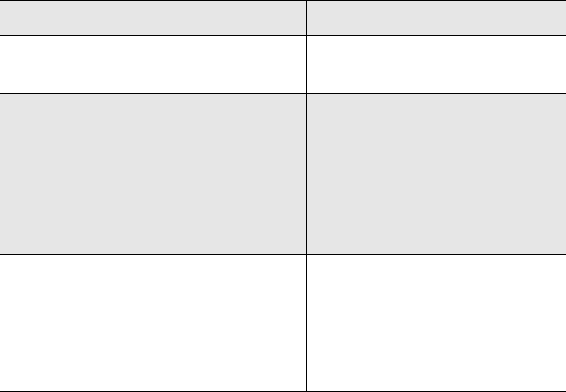
OpenText RightFax 10.0 Administrator’s Guide 228
8. Select the RightFax AutoReply Setup component and click
Next. No other Setup components should be chosen.
9. The Preview Requirements step lists third-party software
required by your chosen features and also lists the status of
setup operations. Software that must be installed will have a
status of Must Install. To continue, click Next.
10.To apply your settings and install required third-party software,
click Apply. This may take several minutes. When finished, click
Next.
11.Choose your installation folder and click Next.
12.To begin installing RightFax software, click Apply. This may take
several minutes. When finished, click Next.
13.To apply your settings and complete Setup, click Apply
followed by Close.
To configure the AutoReply service
1. Click the Windows Start button > All Programs > Captaris >
RightFax AutoReply Wizard. The AutoReply Setup Wizard
opens. To continue, click Next.
2. In the RightFax Server field, type the server that AutoReply will
monitor. Enter the log on user ID and password. Click Connect
to connect to the server, and then click Next.
3. In the Choose RightFax Server window, specify the server that
AutoReply will monitor. Enter the Log on user ID, Password,
and Network Protocol. Click Connect to connect to the server,
and then click Next.
4. Click the option to Set up and configure a new RightFax
server and click Next.
5. Using the pick-list, choose a RightFax user ID from which reply
faxes will be sent. For each server, you can specify just one
user ID from which all reply faxes will be sent. Click Next.
6. In the Select Monitored Users window, create a list of users to
monitor for the AutoReply service. In the Available users list,
click one or more users, and then click Add. The users appear in
the Monitored users list. When you have created the list, click
Next.
7. In the Select Monitored Users window, create a list of users to
monitor for the AutoReply service. In the Available users list,
click one or more users, and then click Add. The users appear in
the Monitored users list. When you have created the list, click
Next.
8. In the Edit Monitored Users window, choose the AutoReply
response for the monitored users. To create one method of
response for all users, in the Select the monitored user ID
box, click Default. Or, choose a user and the responses for that
user.
You have the following options for AutoReply responses.
When finished, click Next.
Table 24a AutoReply Responses
Response Enter this
Route the received fax to another
user after an AutoReply is sent.
The user ID where the fax
should be routed.
Route the received fax to another
user if an AutoReply cannot be
sent.
(If no valid CSID number is
included with the received fax, an
AutoReply cannot be sent.)
The user ID where the fax
should be routed.
Print the received fax if an
AutoReply cannot be sent.
(If no valid CSID number is
included with the received fax, an
AutoReply cannot be sent.)
The printer ID for the printer
where the fax should print.
(Enter a printer ID defined in
Enterprise Fax Manager.)
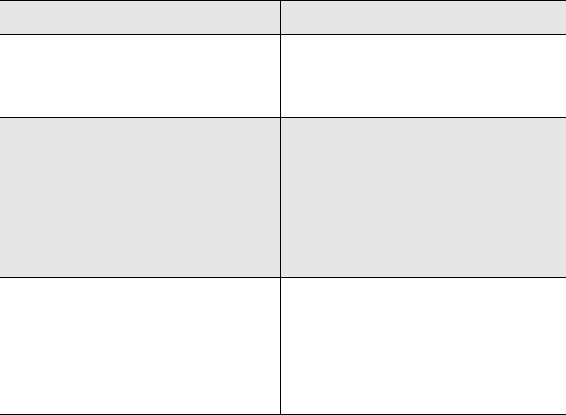
229
9. In the Enter File Names window, enter the location of the file to
use for formatting the AutoReply fax. A sample file called
Format.ini is available in the RightFax\AutoReply
\Samples folder. It is recommended that you modify this sample
file to fit your organization’s needs. (To format the AutoReply fax,
see “Customizing the Reply Fax” on page 230.) Click Next.
10.Click Finish.
Managing AutoReply from a Remote Computer
You can manage AutoReply from a computer that is remote from
the server. To do so, first install the AutoReply configuration
program on the remote computer. Next, run the configuration
program on the remote computer.
Installing AutoReply on a remote computer
On the remote computer, run AutoReply Setup (see “Installing and
Configuring AutoReply”). When Setup completes, proceed to the
next section to configure AutoReply on the local computer.
To run the AutoReply configuration program
1. On the remote computer click the Windows Start button > All
Programs > Captaris > RightFax AutoReply Configuration. The
AutoReply Configuration window opens.
2. In the Connection tab, specify the server to connect to. Enter
your log on user ID and password, and then click Connect to
connect to the server.
3. In the AutoReply User ID tab, enter the RightFax user ID from
which reply faxes will be sent. For each server, you can specify
just one user ID from which all reply faxes will be sent.
4. In the Monitored Users tab, create a list of users to monitor for
the AutoReply service. In the Available users list, click one or
more users, and then click Add. The users appear in the
Monitored users list.
In the Monitored User Configuration tab, choose the
AutoReply response for the monitored users. To create one
method of response for all users, in the Select the monitored
user ID box, click Default. Or, choose a user and the responses
for that user.
You have the following options for AutoReply responses
5. In the Format File tab, enter the location of the file to use for
formatting the AutoReply fax. (To format the AutoReply fax, see
“Customizing the Reply Fax” on page 230.)
6. Click OK.
Table 24b AutoReply Responses
Response Enter this
Route the received fax to
another user after an
AutoReply is sent.
The user ID where the fax
should be routed.
Route the received fax to
another user if an AutoReply
cannot be sent.
(If no valid CSID number is
included with the received fax,
an AutoReply cannot be sent.)
The user ID where the fax
should be routed.
Print the received fax if an
AutoReply cannot be sent.
(If no valid CSID number is
included with the received fax,
an AutoReply cannot be sent.)
The printer ID for the printer
where the fax should print.
(Enter a printer ID defined in
Enterprise Fax Manager.)
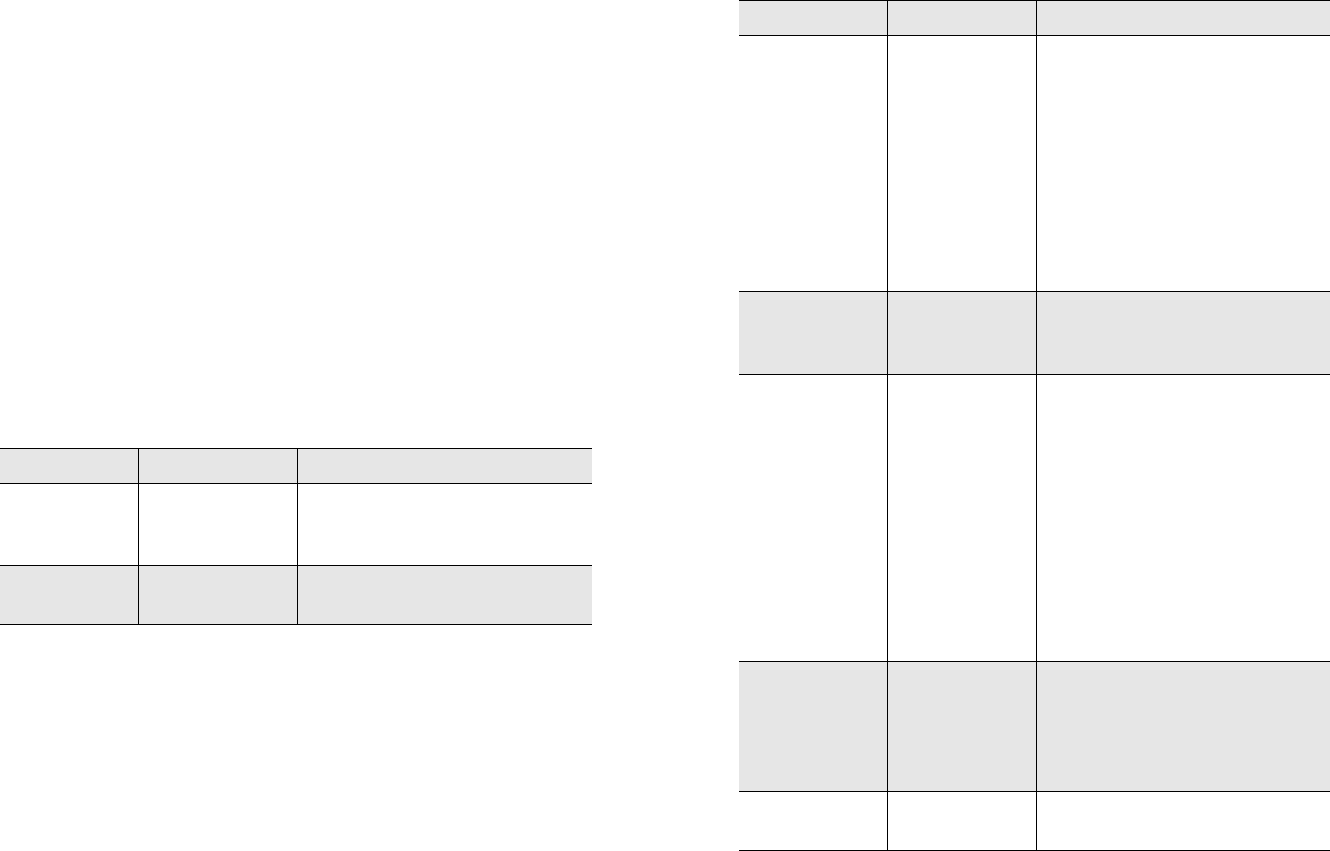
OpenText RightFax 10.0 Administrator’s Guide 230
Customizing the Reply Fax
You can specify the appearance of your reply fax. The appearance
is defined in a text file.
The text file can have any file name and can be located in any folder
accessible by the fax server. Specify the path and file name in the
AutoReply configuration.
A sample file called Format.ini is available in the
RightFax\AutoReply\Samples folder. It is recommended that you
modify the sample file to fit your organization’s needs. This file
includes layout settings for a reply fax page.
The Format.ini file is divided into sections. The General section
defines values that apply to the entire fax page. The Frame sections
each define the location of a frame on the fax page and the
contents of the frame. You can place an unlimited number of frames
on a page..
Table 24c Options in the General Section
Option Value Definition
Font Name, Size The default font that will be used
for text if a font is not specified
for a frame.
OutputSize Letter, A4, Legal The size of the page for the reply
fax.
Table 24d Options in the Frame Section
Option Value Definition
Area Left, Top, Right,
Bottom
The boundaries of the frame. The
left and right values are
measured from the left edge of
the page. The top and bottom
values are measured from the
top edge of the page.
For example, a frame that fills the
lower-right quarter of a letter-size
page might have this value:
4.25,5.5,8,10.5.
Border Width The width (in pixels) of the
border to draw. Omit or set to
zero for no border.
File File name The name of the file to include in
the frame. This can be either a
text file (if the Type option is set
to Text) or graphic file (if the Type
option is set to Graphic).
For graphic files, monochrome
bitmap files are recommended
for best image rendering.
To add variables to the text in a
text file, see “Using variables in
text” on page 231.
Font Name, Size,
Style
The font that will be used for all
text in this frame. Specify the
name of the font, the point size,
and (optionally) the style (Bold,
Italic, or both).
Horizontal-
Alignment
Left, Center, or
Right
The horizontal alignment of the
text or graphic within the frame.
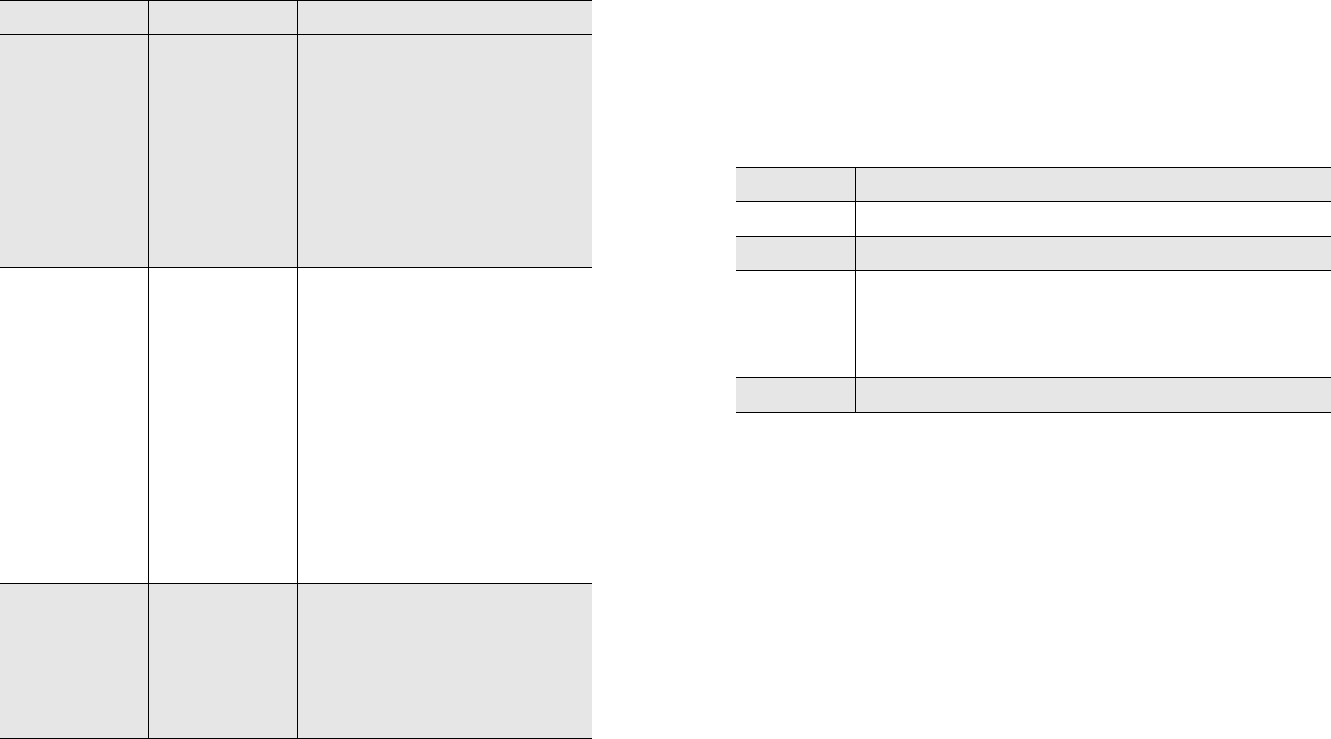
231
Using variables in text
Text in the format file and text included from an external file can
contain one or more of the following variables.
For example, the text TO: Fax Sender at ~1 would appear in the
reply fax as TO: Fax Sender at 520-555-0100.
Troubleshooting the AutoReply Service
To troubleshoot the service, you can run AutoReply in a command
window to view debug information.
1. In Enterprise Fax Manager, stop the AutoReply service.
2. Open a command prompt and change to the
RightFax\AutoReply folder.
3. Type AutoReply -d -1 and press ENTER.
Text Text If you have set the Type option to
Text, this option supplies the text
that will appear. Note that this
option supports a single line of
text only. To include a longer text
message, use the File option.
To add variables to the text,
“Using variables in text” on
page 231.
Type Text, Graphic,
or FaxPage
Each frame must be one of these
types:
Text frames display literal text
from the Text option or text from
a text file specified in the File
option.
Graphic frames display the
graphic file specified in the File
option, scaled to fill the frame.
FaxPage frames display the first
page of the fax that is being
replied to, scaled to fit the frame.
Vertical-
Alignment
Top, Center,
Bottom, or
Wrap
The vertical alignment of the text
or graphic within the frame. The
Wrap value should be used for
unformatted text to wrap the text
to fit within the boundaries of the
frame.
Table 24d Options in the Frame Section (Continued)
Option Value Definition
Table 24e Text Variables
Variable Definition
~1 Destination fax phone number.
~2 Number of pages in the received fax.
~3 Date and time the fax was received (the start of
receipt). The date and time will appear as Date Time
[Timezone], where the Date and Time are formatted
according to the Regional settings in Control Panel.
~5 Unique ID of the fax (assigned by the RightFax server).
OpenText RightFax 10.0 Administrator’s Guide 232

233
Chapter 25
Creating, Sending, and Managing Faxes
There are several ways you can begin to create a fax. You can
create a fax from within RightFax Faxutil, or from external programs
such as Microsoft Word. You can also create faxes from existing
files. Whichever method you use, you can include a variety of
elements in each outgoing fax:
A cover sheet
One or more files such as Word documents, PDF files, or Excel
spreadsheets
One or library documents that are stored on the RightFax server
You must also specify addressing information that may or may not
go on the cover sheet.
Note: If you have installed one or more RightFax email gateway
modules, you can create a fax as an email message and fax it directly
from your email mailbox. For information on faxing from your email client
application, see Chapter 28, “Using RightFax Email Gateways”, or refer to
the RightFax Gateway for Microsoft Exchange Guide or RightFax
Gateway for Lotus Notes Guide.
Creating and Sending a Fax
To send a fax from the RightFax server, follow these general steps:
1. Choose the fax method. This will vary depending on the type of
information you want to send. See “Choosing the fax method”
on page 234. For all fax methods, RightFax opens the Fax
Information dialog box. This dialog box prompts you for fax
addressing information and also lets you attach files, library
documents, and your own notes. The Fax Information dialog
box also provides several options that let you control when and
how the document is sent.
2. To send a new fax, you must enter fax addressing information
(such as the destination fax number) on the Fax Information
dialog box Main tab. See “Specifying Addressing Information”
on page 235.
Note: Boxes that appear in bold are required. If you send a fax
before completing all the required boxes, the fax will remain in your
FaxUtil mailbox with the status “Info Not Complete” until the required
boxes are completed. In most cases, To Name and Fax Number
are the only required boxes. The RightFax administrator can determine
the required entries for users in Enterprise Fax Manager (see
“Requiring cover sheet fields on outgoing faxes” on page 212).
3. Add notes that you want to include on the cover sheet to the
Cover Sheet Notes tab. See “Adding Cover Sheet Notes” on
page 237.
OpenText RightFax 10.0 Administrator’s Guide 234
4. You can add files to the fax, or remove files from the fax, by
entering information on the Attachments tab (see “Attaching
Files” on page 238). If you chose either the Send To or
print-to-fax method, there will already be files attached to the
fax.
5. To use RightFax overlay forms, set fax priority, modify cover
sheets, or enter more recipient information, see “Entering
Additional Processing Options”on page 239.
6. When you have completed all the required and optional entries,
click Send to send the fax.
Choosing the fax method
RightFax provides users several convenient ways to create a new
fax. Depending on which components you want included in your
fax, choose one of the following fax methods.
Use the RightFax FaxUtil program.
To fax from an external application such as a word processor.
spreadsheet, or other business application, print to fax by
selecting the RightFax Fax Printer. See “Faxing from an external
application” on page 234.
To send a document that’s already stored on your system without
opening the application that created it, use the Send To feature.
See “Faxing Stored Files Using SendTo” on page 234.
To create a new fax without launching any other programs, use
Quick Fax. See “Faxing from the System Tray” on page 235.
All four methods bring up the same fax information dialog box and
display the same faxing options.
Fax from the RightFax FaxUtil program Open RightFax
FaxUtil from your program menu or FaxUtil icon. To begin creating a
fax, click the New Document icon in the upper left corner.
Faxing from an external application From within an
application like a word processor or spreadsheet, you can fax a
document by printing it to the RightFax Fax Printer.
To enable this feature:
The RightFax Print Driver component must have been selected
during the RightFax client installation (described in the RightFax
Installation Guide).
The application used must be able to print to a network printer.
The service account running the Print Spooler (spoolsv.exe)
needs Full Control on the 'spool' folder in %windir%\system32
and Full Control of the %allusersprofile% folder. The local system
account which runs the Print Spooler service by default has the
necessary permissions by default.
The user account running the RightFax system tray icon
(FaxCtrl.exe) needs List folder / read data, Delete, and Delete
Subfolders and Files permissions for the 'RightFax' folder in
%allusersprofile% folder. The RightFax folder may be in a
subdirectory (either Application Data or Roaming). The user
account also needs Full Control permissions on the %tmp%
folder.
Faxing Stored Files Using SendTo You can fax a stored file
without opening the application that created it. The stored file must
be in a format that RightFax can convert to fax format (see
Appendix B, “File Formats that Convert to Fax Format”). From the
folder that contains the file you want to fax, right-click the file name
to open a shortcut menu, click Send To, and then click File
Destination via RightFax.
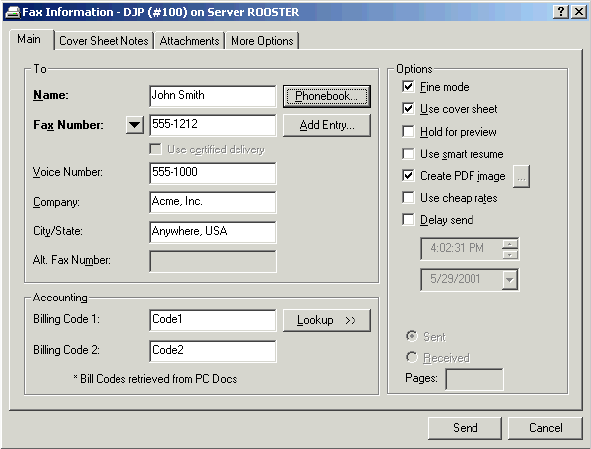
235
To enable this feature:
The RightFax Print Driver component must have been selected
during the RightFax client installation (described in the RightFax
Installation Guide).
The user account running the RightFax system tray icon
(FaxCtrl.exe) needs List folder / read data, Delete, and Delete
Subfolders and Files permissions for the 'RightFax' folder in
%allusersprofile% folder. The RightFax folder maybe in a
subdirectory (either Application Data or Roaming). The user
account also needs Full Control permissions on the %tmp%
folder.
Faxing from the System Tray The Quick Fax feature creates a
fax by combining files, library documents, addressing information,
and your own notes from one convenient dialog box. Click the
RightFax tray icon to open the tray icon shortcut menu, and then
select Quick Fax/Broadcast.
To enable this feature:
The RightFax Print Driver component must have been selected
during the RightFax client installation (described in the RightFax
Installation Guide).
The user account running the RightFax system tray icon
(FaxCtrl.exe) needs List folder / read data, Delete, and Delete
Subfolders and Files permissions for the 'RightFax' folder in
%allusersprofile% folder. The RightFax folder maybe in a
subdirectory (either Application Data or Roaming). The user
account also needs Full Control permissions on the %tmp%
folder.
Specifying Addressing Information
Figure 25.1 The Fax Information Dialog Box Main Tab
Under To, enter the name, phone number, and other addressing
information for the intended fax recipient as you want it to appear
on the fax cover sheet. Boxes in bold (such as Fax Number) must
be completed before the fax can be sent.
Fax Name Enter the name of the recipient. To select a fax
destination from your RightFax phonebook, click Phonebook. The
Phonebook dialog box opens, listing the individual and group
entries in your RightFax phonebooks. Double-click a phonebook
entry to add it to the Current Recipients list. You can add as many
fax recipients to this list as you want. To add the fax addressing
information entered under To as a new entry in your RightFax
phonebook, click Add Entry. For more information on creating and
using RightFax phonebooks and phonebook entries, see “Using the
RightFax Phonebook” on page 245.

OpenText RightFax 10.0 Administrator’s Guide 236
Fax Number You can specify the recipient addressing
information in three different ways. Click the arrow button directly
below the Name field and choose one of the following options:
Select Fax Number to enter a fax number. Hyphens,
parentheses, and spaces can be typed in a destination fax
number. You can also type the number without any spaces or
separator characters.
Select E-Mail Address to enter an email address. Up to 62
characters can be entered for an email address. Sending to an
email address allows several additional options including sending
via certified delivery, sending images in portable document
format (PDF), and sending file attachments of any type, including
file types that cannot be rendered as images (such as WAV files).
The
Select SMS to store the fax and send a text message to the
recipient.
Note: To use email or SMS addressing, the fax administrator must
configure the RightFax server appropriately (see “Adding and
Configuring Email Gateways” on page 259 or “Configuring SMS via
the Push-Proxy Gateway” on page 70).
Accounting You can also specify up to two codes under
Accounting. These codes can be used by the RightFax
administrator to track who the fax was sent to or who sent the fax,
depending on the needs of your organization. The names of the
codes are customizable. For example, they may be called
BillingCode 1 and BillingCode 2 or they may be called Account
and Department. Click Lookup to view and select from a list of
available codes. For more information on using billing codes, see
Chapter 14, “Creating Billing Codes”.
Fine mode Select this check box to create the fax using
200×200 dots per inch (DPI) resolution. Using this resolution
takes longer to generate and send the fax but produces a clearer
fax image.
Use cover sheet Adds a cover sheet to the beginning of the fax.
RightFax uses the cover sheet file specified by the RightFax
administrator as your user or group default. If you have permission
to change cover sheets in your RightFax user profile (“The
Permissions tab” on page 106), you can select the cover sheet to
use (see “Entering Additional Processing Options” on page 239).
Hold for preview You can examine the final version of the
outgoing fax before you send it. The fax will be held in your FaxUtil
mailbox with the status “Held for Preview” and can be viewed
there. To send the fax after you have previewed it, click the fax in
FaxUtil and select Release in the Fax menu.
Use smart resume Allows the fax server to intelligently re-send
only the portion of a fax that failed to send. For example, if the
connection is broken after 40 pages of a 50-page fax, normally all
50 pages have to be re-sent. By enabling Smart-Resume, the
server will only re-send the last 10 pages.
Create PDF image When sending your document to an email
address, check this option to send a PDF file instead of a TIFF file
(the image format used for faxes). This PDF file will be converted to
black and white and cannot be edited unless the RightFax
SecureDocs module is installed on your RightFax server.
To send a PDF that is rendered in color and can be edited, the fax
administrator must install the RightFax SecureDocs module (sold
separately). With the SecureDocs module, PDF files are formatted
in full color and the text of the PDF can be selected and edited
(rich PDF). Also, when the RightFax SecureDocs module is
installed, you can click the […] button to open a list of additional
PDF options. For information on creating rich PDFs and setting
PDF options, refer to the RightFax SecureDocs Module Guide.
Use cheap rates Tells RightFax to delay sending the fax until a
specified time (typically in the late evening when long distance
rates are lower). The Cheap Rates time can be specified by
selecting Options in the FaxUtil Tools menu, and then clicking the
Other Options tab.

237
Delay send Tells RightFax to postpone the transmission of your
fax to a later day or time. This lets you take advantage of off-peak
phone rates or ensure that the fax recipient is available at the other
end. If you select this check box, you must also specify a date and
time to queue the fax for transmission. If you specify a time and
date that has already passed, the fax will be sent as soon as
possible.
Note The fax is queued at the time you specify, but will not actually be
sent until it reaches the top of the queue. This can cause a delay between
the time you specify and the time that the fax is actually sent.
Recording Manual Fax Information When you send or
receive a fax from a fax machine that is not connected to the
network or to the RightFax server (such as a thermal fax machine),
no record of the fax is stored on the RightFax server. In FaxUtil, you
can record such a fax transmission on the RightFax server for
tracking purposes. The Sent, Received, and Pages options in this
dialog box let you specify information about the fax. These options
are available when you select Fax > Record Manual Fax in FaxUtil.
Adding Cover Sheet Notes
A cover sheet contains fields that are populated with recipient and
sender data when the fax is generated. It may also contain a field
for notes. Click the Cover Sheet Notes tab to add cover sheet
notes or comments.
Figure 25.2 The Fax Information Dialog Box Cover Sheet Notes Tab
Notes to be Placed on the Cover Sheet Type the notes that
you want to appear on your fax cover sheet. You can enter up to 21
lines of text, up to 69 characters each.
Text Limit This displays the current number of lines in your note
and the number of lines remaining. Although it is possible to enter
more than 21 lines of text, only 21 can be displayed on the cover
sheet. If you exceed 21 lines, the computer will beep and an error
message will appear in this box.
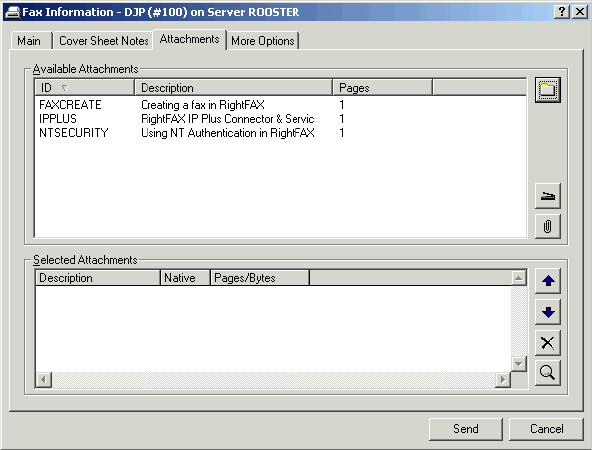
OpenText RightFax 10.0 Administrator’s Guide 238
Comments for your Records This is a comment for your own
use only. This text is not sent to the fax recipient. Text you enter in
this box will appear in your FaxUtil mailbox in the Comments
column.
Attaching Files
You can fax two types of documents as attachments: library
documents and documents in their native file format. Library
documents are frequently faxed documents that your fax
administrator has stored on the fax server. Native documents are
electronic document files that you have saved on your local
computer or on a server (such as Microsoft Word DOC files). You
can attach any of the file types supported by the RightFax
document conversion engine (described in Appendix B, “File
Formats that Convert to Fax Format”), and you can attach as many
files to a fax as you want.
To work with attachments, click the Attachments tab on the Fax
Information dialog box. If you began the fax process with a stored
document or by printing a document within an external application,
that document is automatically attached to the fax and appears in
the Selected Attachments box.
Figure 25.3 The Fax Information Dialog Box Attachments Tab
Available Attachments This box lists all of the library
documents stored on your fax server. Double-click a file to move it
to the Selected Attachments list.
To attach a document file, click the file folder button to search for
and select a document file. When you double-click the file name, it
will appear in the Selected Attachments list.
Selected Attachments This box lists the library documents and
native document files you have attached to the fax. Each of your
attachments will be added to the fax in the order it is listed here. To
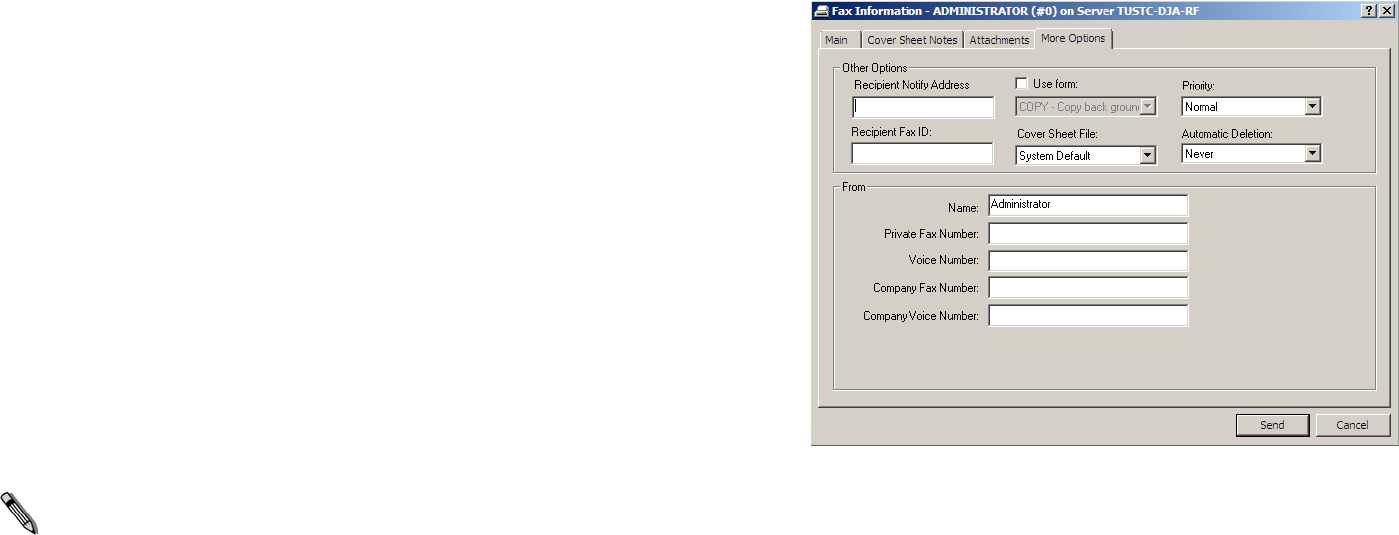
239
move an attachment up or down, select the attachment and click
the arrows. To remove an attachment, select it and click the Delete
button [X]. To preview an attachment, double-click it.
If you are sending to an email address and you have attached a
native document file, a check box will appear next to the document
in the Native column. Check this option to send the file in its native
document format as a file attachment to the email message, rather
than rendering the document into a fax image. Using this option,
you can attach files of any type, including file types that cannot be
rendered as images (such as WAV files). In addition, form overlays
cannot be applied to attachments when the Native option is
selected.
When sending a fax document to an email recipient, this box also
specifies one or more native document files to be the body text of
your email message. Right-click any of the column headers in this
list and select Advanced Columns from the pop-up menu. This
adds an Alternate Body column. Check the box in this column for
each native document attachment you want to use as your email
body. If you select multiple files, each file will be sent to your
recipient, but the recipient will only see the first file that is
supported by his email client application.
Note Because most email client applications support plain ASCII text
files, these files can almost always be used as email body text. Many
email client applications also support HTML and rich text format (RTF). If
the file type you specify is not supported by your recipient’s email client
application, it will be ignored.
Entering Additional Processing Options
Figure 25.4 The Fax Information Dialog Box More Options Tab
Recipient Notify Address Enter an SMS address to receive
an SMS/pager notification of a new fax.
Recipient Fax ID Specify the exact remote fax ID of the
intended recipient’s fax machine or server. When this feature is
enabled, the fax will not be sent unless the remote ID matches the
ID specified. You can use the asterisk (*) and question mark (?)
wildcards if you are not sure of the exact ID. Asterisks represent
zero or more characters or digits. Question marks represent exactly
one digit or character each. This feature is supported for Brooktrout
fax boards only.
Use Form Select this check box to add an overlay form to the fax.
To specify the form file to use, click the arrow to open a list all
available forms. For more information on forms, see Chapter 12,
“Creating Overlay Forms”.

OpenText RightFax 10.0 Administrator’s Guide 240
Cover Sheet File If your user profile includes permission to
change fax cover sheets, you can select a cover sheet in this list.
Priority Specify the priority that is assigned to the fax. Select low,
normal, or high priority from the list. If you do not have the Can Use
High Priority permission checked in your RightFax user profile (see
“The Permissions tab” on page 106), the “High Priority” option will
not appear here.
Automatic Deletion Specify when sent faxes should be
automatically deleted from your FaxUtil mailbox.
From Enter your name, fax number, phone number, and other
contact information. This information will appear on the fax cover
sheet.
Using Embedded Codes
Note The embedded codes described in this section are not supported
on fax cover sheets. Cover sheets support a separate list of cover sheet
codes. For information about fax cover sheets and cover sheet codes, see
Chapter 21, “Creating Fax Cover Sheets” on page 205.
Embedded codes are special faxing instructions that you insert into
documents created in other applications. You can use embedded
codes to include fax cover sheet information, attach library
documents, add billing information, and more.
To add an embedded code to a document, type the code you want,
along with any required parameters, between angle brackets. For
example, an embedded code that provides the destination fax
number is written like this:
<TOFAXNUM:555-1212>
The RightFax server removes all embedded codes from a
document when it converts the document to fax form, so they don’t
appear in your final fax. If you type an embedded code incorrectly, it
will be ignored by the RightFax server and will be included in your
fax. Embedded codes can be written in either upper or lower case.
Embedded codes always work the same way regardless of the
application used to create the document.
Note: In very large documents that use embedded codes, the
prescanning process can cause the FaxServer to appear unresponsive.
You can specify the maximum length of time for embedded code
processing by editing the Windows registry “PrescanTimeoutSeconds”
value as described on page 330.
Although you can use any fonts you want in the text of your
documents, embedded codes must always use a native printer
font. This is because when the document is converted to PCL5
format, all other font types are encoded as graphic images. Only
native printer fonts are stored in the PCL file that the document is
generated from in their original text format. And it is this text in the
PCL file that is replaced. If you do not use native printer fonts for
your embedded codes, the codes themselves will appear in the
instead of being replaced by the information or instruction they
represent. All embedded codes are surrounded by angle brackets
(< >) which must also use the same native printer font.
Embedded codes can be placed anywhere in the document that
you will be faxing and can be used in any document that accepts
text characters. Embedded codes cannot line wrap and any
embedded code statement that is so long that it wraps to a second
line will be ignored.
For a complete list of embedded code keywords, descriptions, and
their correct syntax, see Appendix A, “RightFax Embedded Codes”.
241
Managing Faxes
Monitoring Transmission Success and Failure
Use FaxUtil to monitor the transmission of your faxes. A
transmission is successful if the RightFax server made a
connection, transmitted the information across the line, and
received information from the target fax machine indicating that the
fax information was received.
If a transmission attempt is not successful, it will be retried. While a
fax is being retried, it will appear with a yellow status icon in the
sender’s FaxUtil mailbox. If the fax has not been successfully sent
after the specified number of attempts, it will be abandoned and
saved in the sender’s FaxUtil mailbox with a red status icon.
For information about specifying retry counts and intervals, see
Chapter 3, “Retry settings”.
For a complete list and description of RightFax error messages,
see Appendix C, “Error and Status Messages”.
Fax Approval
RightFax can be configured to hold outbound faxes for approval by
an administrator before sending. Only RightFax administrators,
group administrators, and group alternate administrators can view
and approve these faxes.
To require fax approval for a user
1. Edit the user profile in Enterprise Fax Manager (see “Editing
user properties” on page 105).
2. On the Permissions tab, select the Must Have Faxes
Approved check box.
To view a list of all faxes waiting for approval
1. Run FaxUtil.
2. On the List menu, click Administrative Mode to view the
contents of all fax mailboxes for which you are an administrator.
3. On the List menu, click Needing Approval to display faxes
waiting for approval.
4. To approve or disapprove a fax, right-click the fax and select
Status > Approve Fax or Disapprove Fax. You can add a note
(up to 450 characters) that will be stored with the date and your
user ID in the fax history. You can also delete the fax rather than
approve or disapprove it. If the fax is approved, it is immediately
scheduled to send. If the fax is not approved, it is assigned a
status of “ED: Approval Denied” in the original sender’s FaxUtil
mailbox.
Approving Faxes Blocked by Dialing Rules
Faxes that are blocked by dialing rules can be approved for
transmission by RightFax administrators. Group administrators and
alternate group administrators cannot approve faxes.
To approve a fax blocked by a dialing rule
1. Logon to FaxUtil as an administrator.
2. On the List menu, click Administrative Mode. to view the
contents of all fax mailboxes for which you are an administrator.
3. On the List menu, click Needing Approval to display faxes
waiting for approval.
OpenText RightFax 10.0 Administrator’s Guide 242
4. To approve or disapprove a fax, right-click the fax and select
Status > Approve Fax or Disapprove Fax. You can add a note
(up to 450 characters) that will be stored with the date and your
user ID in the fax history. You can also delete the fax rather than
approve or disapprove it. If the fax is approved, it is immediately
scheduled to send. If the fax is not approved, it is assigned a
status of “ED: Approval Denied” in the original sender’s FaxUtil
mailbox.
Controlling Deleted Faxes
By default, RightFax will retain the image files of faxes that have
been deleted from FaxUtil until all corresponding database records
have been removed. To configure RightFax to immediately delete
fax images:
1. Open the Windows Registry on the RightFax server.
2. Browse to the subkey of HKLM\Software\RightFax\FaxServer.
3. Create a new REG_DWORD entry of DeleteImagesOnPurge.
4. Edit this entry to contain a value of 0.
5. Restart the RightFax services.

243
Chapter 26
Activating and Using the PDF Module
The RightFax PDF module enables conversion of level 1 and level 2
PostScript and PDF (portable document format) documents to
TIFF format on the RightFax server for fax transmission. No
configuration on the RightFax server is required because the server
automatically determines whether the document to convert is
PostScript, PDF, or the standard PCL-5 format.
When this module is activated, you have the option to use a
PostScript print driver to create the RightFax printer on each
RightFax client computer. RightFax users can print native
PostScript and PDF documents directly to the RightFax printer, and
also send rich PDF files (files that include full color and editable
data) to e-mail addresses.
Important The RightFax PDF conversion engine does not support
conversion of PDF files that contain embedded TrueType (CID) fonts that
use “Identity-H” encoding.
Activating the PDF Module on the RightFax
Server
The files required by the RightFax PDF Module are installed on all
RightFax servers during the server installation, however, the PDF
Module must be licensed and activated before its functionality is
enabled.
To activate the PDF Module, you must have licensed a RightFax
server type that includes this module, or purchased and licensed
this module separately. For information on activating new
components on the RightFax server, refer to the RightFax
Installation Guide.
After the RightFax PDF Module has been activated on the RightFax
server, you must enable PostScript processing on at least one
RightFax WorkServer module (described in the next section) and
copy the PostScript fonts you want to support onto the RightFax
server.
Enabling PostScript Processing on a WorkServer
After the PDF module is activated, run the WorkServer
configuration program from Windows Control Panel on the
RightFax server to display the WorkServer Configuration dialog
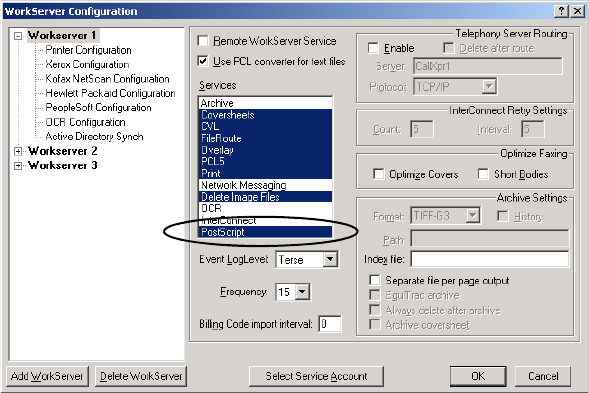
Activating and Using the PDF Module 244
box. In the component tree in the left pane, select the WorkServer
that you want to perform PostScript processing. You can enable
PostScript processing on as many WorkServers as you want.
Figure 26.1 The WorkServer Configuration dialog box
To enable PostScript processing, click PostScript in the Services
list.
Additional PDF Processing Options
Adding PostScript Fonts
To correctly convert Type 1 PostScript fonts in PostScript and PDF
files, the fonts must be copied into the RightFax\Shared
Files\PDF\PSFonts\Font folder. When it is activated, the RightFax
PDF module supports 35 basic PostScript fonts including Times,
Helvetica, Courier, and Symbol.
To add additional font conversion support, copy the PostScript
fonts you want to support into the RightFax\Fonts folder on the
RightFax server. Be sure to include both the .pfm and .pfb
components of the PostScript fonts.
Adding a Margin Before Conversion
When PDF files have images that go to the edge of the page, part
of the image may be cut off and replaced with a margin during
conversion. To reduce the size of the page slightly before
conversion so that the margin does not cut off any content, set the
Windows registry ShrinkToView value on each machine running the
conversion WorkServer. See “ShrinkToView” on page 335 for more
information.
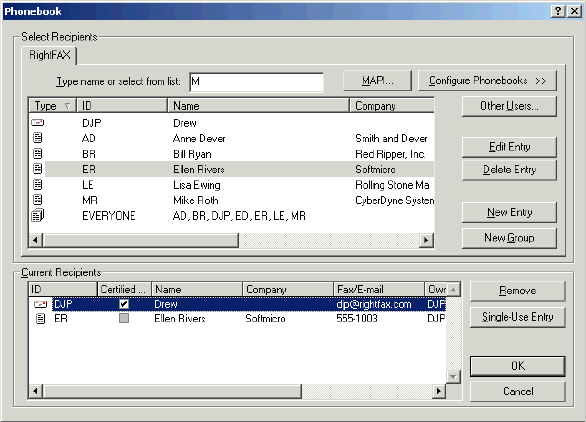
245
Chapter 27
Creating Phonebooks and Broadcasting Faxes
RightFax phonebooks store fax addressing information (such as
name, fax number, and phone number) in a single location so you
can easily apply all fax destination information when addressing an
outgoing fax. You can also create group phonebook entries that
contain fax addressing information for multiple fax recipients.
RightFax users can choose to use the phonebook built in to the
RightFax FaxUtil client or can link to existing ODBC, LDAP, or
MAPI contact lists.
You can use phonebooks or other databases containing contact
information to send fax broadcasts. Fax broadcasting sends a
single fax to multiple recipients without addressing each fax
individually.
Using the RightFax Phonebook
The RightFax phonebook is a fax recipient database customized for
each RightFax user. Because each user’s phonebook is unique, all
phonebook functions are managed from within the FaxUtil client
application.
For information on using phonebook entries to address outgoing
faxes, see “Specifying Addressing Information” on page 235.
To open your RightFax phonebook, run FaxUtil. Select Tools >
Phonebook, or click the Phonebook button in the toolbar. You can
create individual entries (for one person at a time) or group entries
(to fax to multiple people at the same time).
Figure 27.1 The RightFax Phonebook
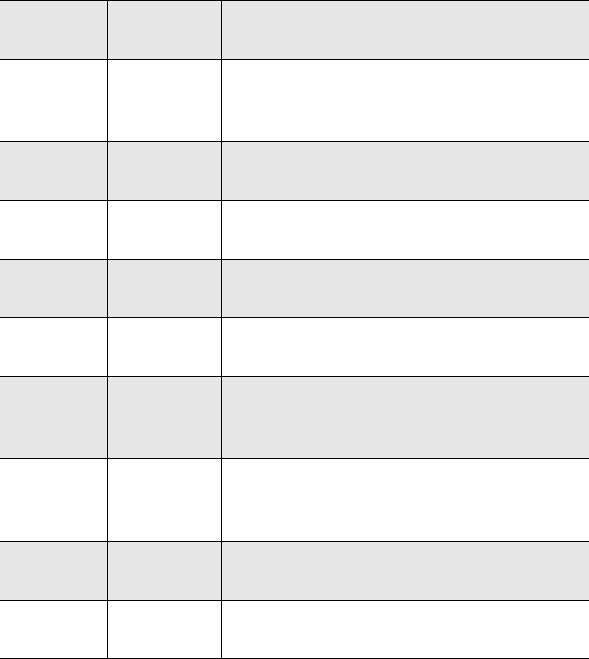
OpenText RightFax 10.0 Administrator’s Guide 246
Creating an individual phonebook entry:
1. Click the Phonebook button in the FaxUtil toolbar.
2. Click the New Entry button.
3. Enter a name for the phonebook entry in the ID field, then
complete the addressing fields. You must include at least a
name and fax number to be able to send a fax to this recipient.
4. Check any options you want and click OK. The new entry will
immediately appear in your phonebook preceded by an
"individual" icon.
Creating a group phonebook entry:
You can combine several individual entries into a group entry.
When choosing a fax recipient, you can choose the group just as
you would an individual. The fax will be sent to all members of the
group. Before you create a group, create the individual phonebook
entries for each member of the group.
1. Click the Phonebook button in the FaxUtil toolbar.
2. Select the phonebook entries you want to add to the new
group. You can add both individual entries and group entries to
a group. Press SHIFT and click to select a range of entries.
Press CTRL and click to select multiple separate entries.
3. When all the entries you want in the group have been selected,
click the New Group button.
4. Enter a name for the phonebook entry in the ID field.
5. Check any options you want and click OK. The new entry will
immediately appear in your phonebook preceded by a group
icon.
Importing Entries Into the RightFax Phonebook
You can import entries into your personal phonebook from a
specially formatted text file.
Creating a file to import
The file used to import phonebook entries is typically generated by
an existing database of contact information. This must be an ASCII
text file with each phonebook entry separated by a line break. Each
entry is made up of one or more phonebook fields. The following
table lists each of the valid phonebook entry fields in the order the
fields appear in the file.
Table 27a Phonebook Fields
Field
name
Maximum
length Description
ID 17 A unique ID used only to reference the
phonebook entry. It never appears on the
fax
Name 59 The recipient’s name as it will appear on
the fax cover sheet
Company 59 The recipient’s company name as it will
appear on the fax cover sheet
Address 59 The recipient’s address as it will appear
on the fax cover sheet
CityState 59 The recipient’s city and state as they will
appear on the fax cover sheet
Fax1 31 The recipient’s primary fax number. This is
used when dialing the fax destination and
may appear on the fax cover sheet
Fax2 31 The recipient’s alternate fax number. This
is used when dialing the fax destination
and may appear on the fax cover sheet
Voice1 31 The recipient’s primary voice number as it
will appear on the fax cover sheet
Voice2 31 The recipient’s alternate voice number as
it will appear on the fax cover sheet
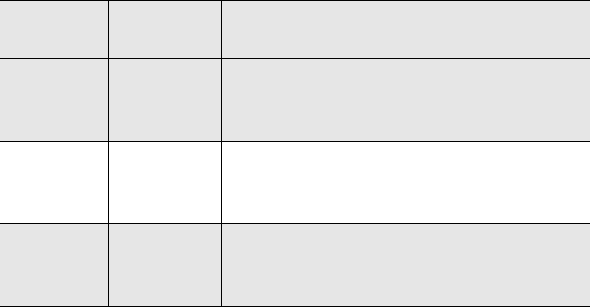
247
This must be a comma-delimited text file with each data field
bounded by double-quotes and a carriage-return between entries.
The first line in the file is used to specify what data fields are
included for each entry. This line uses the same format as the
individual phonebook entries, but specifies the data fields being
imported using the field names from the table above. The
phonebook entries that follow must include all the same data fields
in the same order that they are listed in the first line.
If a data field in any of the entries is left empty or contains no data,
the import will fail. Any unpopulated fields that you want to include
in this file must be indicated using a single space bounded by
double-quotes.
Sample phonebook import file
The following is a short example of a file that can be can be
imported into your RightFax phonebook. Some unpopulated data
fields are illustrated in the last entry.
“ I D ”,” N a m e ”,” F a x 1 ”,” C o m p a n y ”,” C i t y S t a t e ”
“Bob”,”Bob Jones”,”444-3333”,”Acme”,”Tucson AZ”
“Jane”,”Jane Doe”,”555-1212”,” ”,” ”
For information on outputting a properly formatted text file from your
contact database, refer to the documentation for your contact
database management application.
Using FaxUtil to import the phonebook entries
After you have created the text file to import from, run FaxUtil, and
select Phonebook Import from the Tools menu. The Phonebook
Import dialog box opens. Complete each box according to the
format of the file you are importing. When all boxes are complete,
click Import to import the entries.
Import File Enter the path and file name of the text file to import.
Click Browse to search for and select the file.
Quotes Around Fields Fields in the text file you import can be
surrounded by, but do not require, quotes. If quotes are used, they
must be used on every field in the file. You cannot mix fields with
quotes and fields without quotes. Select this check box only if your
data fields are surrounded by quotes.
Publish Imported Entries Select this check box to make each
new imported entry published. Published entries can be accessed
by other RightFax users; unpublished entries can be accessed only
by you and the RightFax administrator.
Text Format Select the text mode of the file to import. If your text
application doesn’t specify whether it’s using OEM or ANSI text,
select OEM. If accented or other special characters do not import
properly, re-import the file and select ANSI.
Field Delimiter Specify which type of character, a comma, tab,
or space, is used to separate the individual fields in each
phonebook entry in the file.
BillCode1 17 A code associated with the recipient
used for billing or tracking purposes. It
never appears on the fax
BillCode2 17 An additional code associated with the
recipient used for billing or tracking
purposes. It never appears on the fax
Notes 128 Any additional information about the
recipient. This will not appear on the fax
and is for your information only
Table 27a Phonebook Fields (Continued)
Field
name
Maximum
length Description
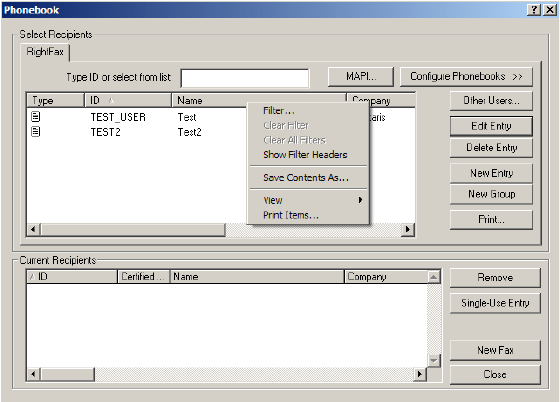
OpenText RightFax 10.0 Administrator’s Guide 248
Duplicate ID Handling You have the following options for
handling imported entries that contain IDs that already exist in your
phonebook:
Replace Existing Entry replaces any existing entry in the
phonebook with the imported entry containing the duplicate ID.
Replace After Confirmation replaces existing entries only if you
agree to a confirmation prompt.
Generate Unique IDs adds a number to the end of duplicated
IDs in order to make the new ID unique.
Skip ignores any entry in the import file with a duplicate ID.
Saving phonebook entries
Phonebook entries can be saved to a comma seperated values file
(.CSV) using the Phonebook dialog box.
1. Run FaxUtil, and select Phonebook from the Tools menu. The
Phonebook dialog box opens.
2. Select a user or group of users. The Ctrl and Shift keys can be
used for this purpose.
3. After selecting users to save, right-click the filter bar and
choose Save Contents As. The Select Export File window
opens.
Figure 27.2 Saving the Phonebook entries
4. Choose a location to save your file, enter a file name and click
Save.
5. Click the Close button when finished.
Using MAPI Phonebooks
RightFax also integrates with MAPI-compliant contact lists such as
Microsoft Exchange address lists and Outlook contact lists. In
order to access MAPI contact lists, each client workstation must
have MAPI installed.
MAPI address books and contact list profiles are created by
Exchange, Outlook, and other MAPI-compliant applications.
Because these profiles conform to a universal standard, you do not
need to configure the MAPI-to-RightFax connection.
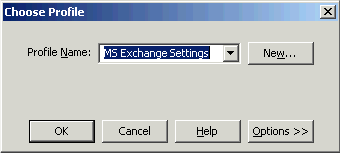
249
To select a recipient from a MAPI source
1. In the Phonebook dialog box, click MAPI. The Choose Profile
dialog box opens.
Figure 27.3 The Choose Profile Dialog Box
2. Select the MAPI profile name in the Profile Name box, and then
click OK. The Enter Password dialog box opens.
3. Enter your network user name, domain, and password, and then
click OK. This will open the MAPI contact list.
4. Double-click each contact entry to add it to the Fax
Destinations list. When you have all the contacts you want,
click OK. The MAPI contacts will appear in the Phonebook
dialog box in the Current Recipients list.
Using ODBC Phonebooks
RightFax can connect to an existing ODBC database in order to
use your organization’s existing contact database information for
addressing faxes. This is especially useful for sending fax
broadcasts to large numbers of recipients.
There are two parts to configuring ODBC connectivity: general
ODBC configuration and RightFax-specific ODBC configuration.
Each workstation must be configured individually for both types of
ODBC information.
Configuring ODBC drivers on the client workstation
Because every database is different, this document cannot provide
specific instructions for configuring the ODBC drivers on your
workstations. Note the following guidelines:
Verify that you have the 32-bit version of ODBC installed on your
system by opening Windows Control Panel and running the
ODBC program to display the ODBC Data Source
Administrator.
Note the user ID and password that is used to log on to the
database or database server. You will use this ID and password
in the RightFax ODBC configuration.
After you have configured the drivers on your workstation, create
a data source under a User DSN or System DSN in the ODBC
Data Source Administrator.
Configuring RightFax for ODBC connectivity
After the workstation has had ODBC drivers correctly installed,
you must map the ODBC fax contact information to the
corresponding fields in RightFax.
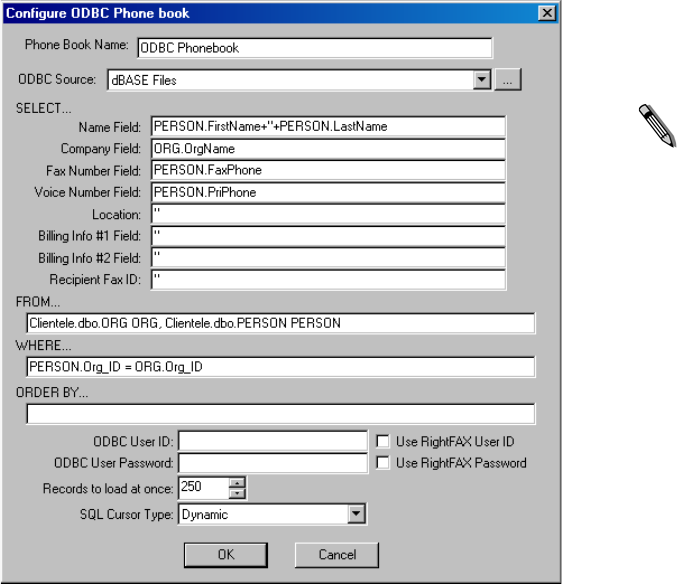
OpenText RightFax 10.0 Administrator’s Guide 250
To configure ODBC in RightFax
1. Click the RightFax tray icon in the taskbar and select ODBC
Configuration.
2. Click Add next to ODBC Phonebooks to create a new ODBC
source. The Configure ODBC Phonebook dialog box opens.
Figure 27.4 The Configure ODBC Phonebook Dialog Box
3. In the Phonebook Name box, enter a descriptive name for this
contact database.
4. In the ODBC Source box, enter the name under which this
database appears in the User DSN tab of the ODBC program
in Control Panel.
5. Under Select, use simple SQL queries to relate ODBC
database fields to each of the listed RightFax phonebook fields.
Enter two single-quotes (‘’) in any field you want to leave blank.
If you are familiar with SQL code, you can create this
information quickly and enter it in the Select boxes. If you are
not familiar with SQL code, you should use a tool such as
Microsoft Query to generate the SQL code for you, and then
cut and paste the codes into the Select boxes.
Note SQL queries also let you combine multiple ODBC source
fields in a single RightFax field. This is useful, for example, if your
database contains separate fields for first, middle and last names.
Because RightFax has only one “Name” field, each of these source
fields should be combined into the single RightFax field.
6. In the From and Where boxes, enter the SQL information
specified by the query results.
7. To presort the data, enter the necessary SQL data in the Order
box, however this should not be necessary because RightFax
can sort phonebook entries by column after it retrieves the data.
8. Specify the ODBC User ID and ODBC User Password
required to access the database information. If the ID and
password match those used to log in to FaxUtil, you can select
those check boxes instead.
9. If you have a large database, limit the number of records loaded
at one time in the Records to Load at Once box.
Using ODBC phonebooks to send faxes
After you have configured your ODBC information, you can access
these contact records as phonebook entries when addressing
faxes via the Fax Information dialog box (see “Specifying
Addressing Information” on page 235).
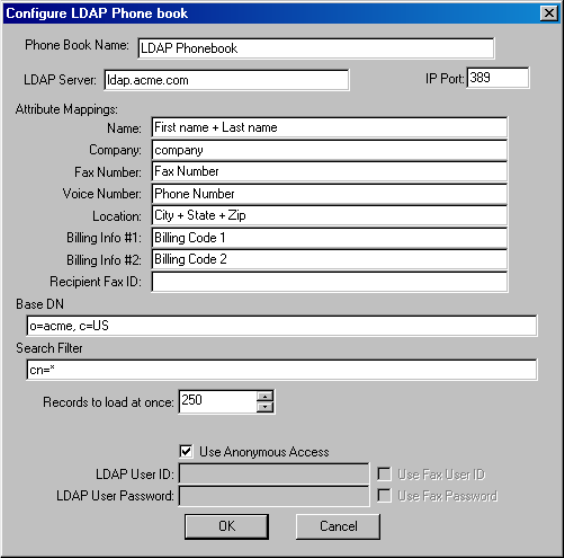
251
Click Phonebook and select the ODBC Phonebook tab, and a list
of contacts opens. If you limited the number of records displayed at
one time, you will see only that number of records. To view the
previous or next increment of records click the arrows on the far
right side of the table. Click one or more records and click OK to
address the fax. The new fax will be sent to each of the specified
recipients.
LDAP Phonebooks
RightFax allows users to connect to an existing LDAP database in
order to use your organization’s existing contact database
information for addressing faxes. This is especially useful for
sending fax broadcasts to large numbers of recipients. LDAP
phonebooks are only accessible from Windows XP, Windows
Vista, and Windows 7 workstations.
Configuring RightFax for LDAP connectivity
In order for RightFax to work with your LDAP database, you must
map the LDAP fax contact information to the corresponding fields
in RightFax.
To configure LDAP in RightFax
1. Click the RightFax tray icon in the taskbar and select LDAP
Configuration.
2. Click Add to create a new LDAP source. The Configure LDAP
Phonebook dialog box opens.
Figure 27.5 The Configure LDAP Phonebook Dialog Box
3. In the Phonebook Name box, enter a descriptive name for this
contact database.
4. In the LDAP Server box, enter the name of the LDAP server.
Specify the server’s IP port in the IP Port box.

OpenText RightFax 10.0 Administrator’s Guide 252
5. Under Attribute Mappings, map the LDAP fields that
correspond to the listed RightFax fields. In addition, you can
filter the number and type of entries returned to RightFax.
6. If you have a large database, limit the number of records loaded
at one time in the Records to Load at Once box.
Note The LDAP User ID field is limted to 47 characters.
Using LDAP phonebooks to send faxes
After you have configured your LDAP information, you can access
these contact records as phonebook entries when addressing
faxes via the Fax Information dialog box (see “Specifying
Addressing Information” on page 235).
Click Phonebook and select the LDAP database, and a list of
contacts opens. If you limited the number of records displayed at
one time, you will see only that number of records. To view the
previous or next increment of records click the arrows on the far
right side of the table. Click one or more records and click OK to
address the fax. The new fax will be sent to each of the specified
recipients.
Fax Broadcasting
You can send one fax to hundreds or thousands of recipients at
once. This is called sending a “fax broadcast” or “fax broadcasting.”
The RightFax server provides three methods for sending a fax
broadcast.
Fax broadcasting from phonebooks.
Fax broadcasting from a mail merge.
Fax broadcasting from a database.
The method you choose for your fax broadcast should be
determined by the nature of the fax broadcast as well as the source
of the fax contact information.
Note When broadcasting the same document to a large number of
people, it is generally better to store the fax as a library document. As a
library document, the fax is already stored in TIFF G3 format and will not
need to be converted again for faxing. If a fax is not saved as a library
document and is broadcast to 500 recipients, the WorkServers will have
to perform 500 separate PCL-to-TIFF G3 conversions.
Fax broadcasting from phonebooks
The easiest way to send a fax broadcast is to select Quick
Fax/Broadcast from the RightFax tray icon, and then, in the Fax
Information dialog box, click Phonebook to open your RightFax,
ODBC, LDAP, or MAPI phonebook (as described earlier in this
chapter). From each of these phonebooks you can specify multiple
recipients for your fax. The biggest advantage of using phonebooks
for fax broadcasts is convenience. After a phonebook is created,
faxing to one or more contacts in the phonebook is as easy as
clicking the desired contacts in the list.
Fax broadcasting from your RightFax or MAPI phonebook is most
useful for small fax broadcasts to your personal contacts. This is
because these phonebooks are typically used only for private
contact management and exist separately from your organization’s
primary contact data source. Fax broadcasting from your ODBC or
LDAP phonebook is better geared towards large fax broadcasts
because these phonebooks can be dynamically linked to your
organization’s primary contact data source.
Using your phonebooks for fax broadcasts has some
disadvantages. First, all recipients receive the same fax body
pages. Although each cover page has the correct contact
information, the body of the fax cannot be not customized to each
recipient. Also, the fax broadcast must be specifically initiated by
someone and the contacts to fax to specified manually.
253
Fax broadcasting from a mail merge
You can also send a fax broadcast using a mail merge from
applications such as Microsoft Word or Microsoft Access. The
benefit of a mail merge is that each individual fax can be
personalized or customized to fit the recipient. The main drawback,
however, is that each individual fax page must be converted from its
native format to the TIFF-G3 format, which can slow down the rate
at which faxes are sent and delay other fax server processes,
especially during very large fax broadcasts.
To send a fax broadcast using mail merge, you must create a
document in a native application that supports mail merges. This
document must contain all necessary fax addressing information in
the form of embedded codes (described in Appendix A, “RightFax
Embedded Codes”). Each fax addressing embedded code then
uses the mail merge variables instead of specific fax addressing
information.
After the document is created, each mail merged version of the
document must be printed as a separate print job to the RightFax
print queue. Depending on the application you use to generate the
mail merge document, you must create some type of macro that
instructs the application to send each mail merge document as a
separate print job.
In addition, you must print mail merge fax broadcasts to a RightFax
printer that does not automatically prompt you for fax addressing
information. To create a RightFax printer that does not automatically
open the Fax Information dialog box, click the RightFax tray icon
and select Configuration. Click Create Fax Driver and select
Create PCL-5 Fax Driver. Enter a name for the printer and specify
the fax server to which jobs should be sent. This new printer will be
listed under Fax Printers in the Configure Fax Printers dialog box.
Finally, move the new printer to the Available Printers list. This
printer will still output to the fax server but will not prompt you for
fax addressing information.
The following is an example of a mail merge document created in
Microsoft Word (merge fields are shown as they would appear if
the Field Codes option in the View menu in Word is enabled).
<FORMTYPE:letterhead><TONAME:{mergefield
Name}>
<TOFAXNUM:{mergefield FaxNumber}>
<TOCOMPANY:{mergefield Company}>
{mergefield Name}
{mergefield Company}
{mergefield Address}
Dear {mergefield Name}
Thank you for remitting payment.
Sincerely,
If this letter is merged with a list of ten names, Word will create a
single document with ten copies of the letter, each separated by a
section divider. Normally you could just print the new document
and all ten sections would be output as a single print job to a
network print queue. However, if you were to print the document
this way to the RightFax fax printer, you would get one fax with ten

OpenText RightFax 10.0 Administrator’s Guide 254
pages and it would be addressed to the person referenced by the
last set of embedded fax codes. For Word to output ten separate
print jobs, you can use this Word XP macro.
Attribute VB_Name = "NewMacros"
Sub SendFax()
'Attribute SendFax.VB_Description = "Macro created
1/21/2003 by Peter A. Schott"
'Attribute SendFax.VB_ProcData.VB_Invoke_Func =
"Normal.NewMacros.SendFax"
'
' SendFax Macro
' Macro created 1/21/2003 by Peter A. Schott
'
'Remove comments from appropriate lines for your
configuration
'Adjust FaxPrinter variable for your RightFAX Printer
(without prompts)
Dim TotalSec, i, CurrentSection
Dim OldPrinter 'Used to store old printer name
Dim FaxPrinter 'Can be customized for RightFAX Printer
(no messages) name
FaxPrinter = "\\RIGHTFAX\HPFAX"
TotalSec =
Selection.Information(wdNumberOfPagesInDocument)
'OldPrinter = ActivePrinter
'Application.ActivePrinter = FaxPrinter
For i = 1 To TotalSec
CurrentSection = "s" + Trim(Str(i))
ActiveDocument.PrintOut Copies:=1,
Range:=wdPrintFromTo, From:=CurrentSection,
To:=CurrentSection
Next i
'Application.ActivePrinter = OldPrinter
End Sub
Note If you use a different word processor or a different version of
Word, you will have to modify this macro to meet your application’s
specific requirements.
This macro first counts the number of letters to print by jumping to
the bottom and obtaining the current section number (subtracting
one because there is always an extra section break inserted during
the Merge To New Document operation). Next, the macro starts a
loop, executing a print range from 1 through the total number of
sections. Because the print range is prefixed with “S,” the print
command prints all of the specified section, no matter how many
pages are in each section.
In the previous example, the Word document itself is broadcast. In
some cases, however, you can want to send a RightFax library
document to a group of people using a mail merge. This Word
document could be used to fax broadcast only the library
document “Promo1.”
<LIBDOC:Promo1><TONAME:{mergefield Name}>
<TOFAXNUM:{mergefield FaxNumber}>
<TOCOMPANY:{mergefield Company}>
<NOTE: This is the first cover sheet notes line>
<NOTE: This is the second.>
Then, using the Word print macro, only the library document
“Promo1” will be broadcast.
Fax broadcasting from a database
Fax broadcasting from a database uses the scripting power of your
contact database with the faxing capabilities of RightFax. There are
a virtually unlimited number of possible variations on this method.
The main benefit of fax broadcasting from a database is that the fax
broadcast can be partially or completely automated depending on
the database you use. You also have the added flexibility of sending
the same document to all recipients, such as a library document, or
customizing each document for each recipient. The drawback to
255
this fax broadcasting method is that it can be highly complex and
may require substantial programming in your database’s scripting
language.
The following figure shows how fax broadcasting can work with
databases. This example is intended only to provide database
administrators with the fundamental concept of database fax
broadcasting. You must apply these concepts when developing a
customized database fax broadcast in your own environment.
In the following example, FoxPro is used to send the library
document “Promo1” to all contacts in Arizona and California. The
database is named “MyList” and includes four fields: “name,”
“ f a x n u m ,” “ s t a t e ,” a n d “ c o m p a n y .” T he RightFax fax printer is already
linked or captured to LPT1.
set talk off
Select * from MYLIST;
where STATE==”AZ” or STATE==”CA”
to table TEMP1
set printer to LPT1
set printer on
? “DUMMY TEXT TO FLUSH ANY DATA IN LPT
BUFFER”
set printer off
set printer to
if (!used(“TEMP1”))
select 0
use TEMP1
endif
select TEMP1
SCAN ALL
set printer to LPT1
set printer on
?? “<libdoc:PROMO1>”
?? “<toname:”+temp1.name+”>”
?? “<tofaxnum:”+temp1.faxnum+”>”
?? “<tocompany:”+temp1.company+”>”
?? “<autodelete>”
set printer off
set printer to
ENDSCAN
OpenText RightFax 10.0 Administrator’s Guide 256

257
Chapter 28
Using RightFax Email Gateways
The RightFax server includes an email gateway for SMTP/POP3.
Advanced gateways for Microsoft Exchange and Lotus Notes are
available as separate, optional modules.
Tip For information about the Exchange and Notes gateways refer to the
Microsoft Exchange Module Guide and the Lotus Notes Module Guide
located on the RightFax server in the \RightFax\Docs folder.
Each RightFax email gateway acts as a communication link
between the RightFax server and your email server(s). This lets you
use your email client software as a fax client system as well.
Important UTF-8 encoding (unicode) is required for the Euro symbol
and some other special characters to appear properly in RightFax
documents created in email clients. To support documents with these
characters, your email client must be configured for UTF-8 encoding.
Refer to the documentation for your email client for information on
enabling UTF-8 encoding.
Email messages addressed to the RightFax email gateway are
picked up by the RightFax server, which converts them into faxes
and transmits them. Incoming faxes can be routed to an email
mailbox by specifying each RightFax user’s mailbox information in
Enterprise Fax Manager. The gateway can also provide notification
of fax events via email.
Important Required information for outbound faxes (described in
“Requiring cover sheet fields on outgoing faxes” on page 212) does not
apply to faxes sent via the email gateways. For example, if you have
configured RightFax to require that the To Name field be completed
before a fax can be sent, faxes may still be transmitted via the email
gateways without a recipient name specified.
Installing the Email Gateway Software
The SMTP/POP3 email gateway is installed when you run the
RightFax server installation. However, the mail server requires some
configuration to work with the gateway software. After the mail
server has been properly configured, you must add and configure
the email gateway on the RightFax server (described on page 259).
Important If you will be storing or accessing mail files on a Novell
NetWare volume, make sure that the account the RightFax email gateway
service exists as a user in Novell. By default, the account used by the
RightFax email gateway service is the same account used by the
RightFax WorkServer modules (defined in the RightFax WorkServer
configuration in Enterprise Fax Manager).

OpenText RightFax 10.0 Administrator’s Guide 258
Configuring SMTP/POP3 gateway installations
For SMTP/POP3 installations, SMTP/POP3 server(s) must be
accessible by the computer running the RightFax email gateway(s).
You must create a new POP3 mailbox specifically for use by the
gateway. The gateway will periodically check this mailbox for
fax-bound email messages to forward to the fax server. Several
common configurations for routing fax-bound email messages to
this mailbox are outlined in the following sections. Although the
configurations vary, the goal is always the same—to route outgoing
fax-bound email messages to the mailbox on the SMTP server
specified in the POP3 Mailbox Name box in the Email
Configuration dialog box (see “Adding and Configuring Email
Gateways” on page 259).
Note The RightFax email gateway for SMTP/POP3 can be set to
recognize one of three addressing schemes for specifying outgoing fax
information like the fax number and recipient name (see “Using the
RightFax addressing scheme” on page 264). In the examples that follow,
the RightFax addressing scheme is used.
Dedicated domain for fax-bound email messages
This is typically the easiest configuration for email users to
understand and for SMTP/POP3 mail client software to access.
Email users send all fax-bound mail messages to a specific domain
(e.g., faxgate.company.com) and specify the pertinent fax
information as the mailbox portion of the mail address (left of the @
symbol). For example:
/fax=555-1212/name=Jane Doe@faxgate.company.com
Create a domain on your SMTP/POP3 mail server that will be
dedicated to receiving fax-bound mail messages. All mail
messages received at this domain must be placed in the POP3
mailbox specified in the POP3 Mailbox Name box in the Email
Configuration dialog box. The RightFax email gateway will
periodically check this mailbox for outgoing messages. If the
messages contain valid fax addresses, they will be routed to the
RightFax server for transmission.
A new MX (mail exchanger) entry in the DNS server may be
required to tell other computers what mail server handles
messages for the new domain.
Important The SMTP gateway requires an SMTP server with open
relay enabled.
Mailbox pattern-matching routing
This addressing scheme has the advantage of not requiring a new
mail domain; however, email users may not find it as intuitive as the
dedicated domain method (page 258).
Many mail servers allow messages with addresses that match a
specific pattern to route to a particular mailbox. For example, the
pattern “fax=*” (meaning any mailbox that starts with text “fax=”)
can be defined to route matching addresses to the email gateway’s
POP3 mailbox on the SMTP server. An address matching this
pattern might look like this:
/fax=555-1212/name=Jane Doe@company.com
Simple mailbox with description-area fax information
Note This configuration is not compatible with the IETF addressing
scheme. If your SMTP server requires that you use this addressing
method, you must use the RightFax addressing scheme (page 264).
Some SMTP mail servers allow very few configuration and routing
options. In these cases, fax-bound email messages can be
addressed directly to the email gateway’s POP3 mailbox. Fax
destination information is specified in the description-area of the
address string, using the same method used to provide descriptive
names for standard email addresses. For example:
“/name=Jane/fax=5551212/” <faxgate@company.com>
The information in quotes is not interpreted as part of the address.
It is treated as descriptive information only. The email message is
routed directly to the “faxgate” mailbox on the SMTP mail server. In
this example, the name of the mailbox specified in the POP3
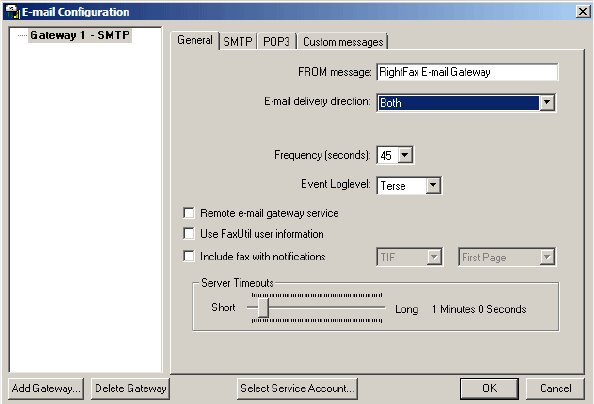
259
Mailbox Name box in the Email Configuration dialog box (where
the gateway checks for outgoing faxes) is “faxgate.” When
destination fax information is not found as part of the address, the
RightFax email gateway scans the descriptive information.
Although this method requires little configuration at the mail server,
many email client programs make it difficult to add descriptive
information to an email address, often misinterpreting it as part of
the mail destination address.
Adding and Configuring Email Gateways
To add or configure an email gateway, run the Email Gateway
configuration program.
If you did not add an email gateway during the RightFax server
installation, you can open the Email Gateway configuration
program from Windows Control Panel.
If you already have one or more email gateways configured, you
can open the Email Gateway configuration program by
double-clicking the RightFax Email Gateway service in Enterprise
Fax Manager.
The Email Configuration dialog box opens.
Figure 28.1 The Email Configuration Dialog Box General Tab
To add a new gateway, click Add Gateway and select the type of
gateway to add. Because RightFax allows you to install multiple
email gateways, each installed gateway is listed in the tree on the
left. Click each gateway in the list to view its configuration options.
General Settings
Click the General tab to begin configuration for all gateways.
From Message Specify a text string that will be will appear in
the FROM: field of messages placed into your system by the e-mail
gateway.

OpenText RightFax 10.0 Administrator’s Guide 260
Delivery Direction Specify the type of messages the gateway
will process. Valide options are:
Both (for both inbound and outbound messages)
Inbound Only
Outbound with Notifications
Outbound without Notifications
Frequency Specify (in seconds) how often the gateway will
check the mail system and the fax server for incoming or outgoing
faxes to process. To avoid overloading system resources, the
Frequency should not be set below 30 seconds.
Event LogLevel Specify the level of information logged in the
Application Event Log under the service name “RightFax E-Mail
Gateway Module.” You can select the following options:
None. No information is saved.
Terse. Records critical errors only.
Normal. Records errors and major events only.
Verbose. Records all significant events and is most useful for
tracking and resolving problems.
Caution If you leave this value set to “Verbose” for long periods of
time, the Event Log can become full which may prevent new events
from being logged.
Remote e-mail gateway service Check this option if you are
running the E-mail Gateway service on a computer other than the
fax server. See “Running the Email Gateway Remotely” on
page 268.
Use FaxUtil user information Checking this option will use
the User ID field in place of the SMTP friendly name. This
information will appear in the From User Name field on
coversheets using the <from name> embedded code.
Include fax with notifications Check this this option to
include a copy of the fax with notifications. Once enabled, select
TIF or PDF format. Choose First Page if you want only the first
page of the fax to be included with the notification. Choose All
Pages if you want the full fax to be included.
Server Timeouts Specify how long the client should wait for a
response from the e-mail server by moving the slider to the right to
increase the time or to the left to decrease it.
SMTP Settings
Click the SMTP tab to enter information about the SMTP server.
Figure 28.2 The Email Configuration Dialog Box SMTP Tab
SMTP Server: Name or IP address of the SMTP server
Port: Defaults to 25, the standard for nonencrypted SMTP
messaging. The standard port for encrypted messaging is 465.
Enter the port number for your configuration.
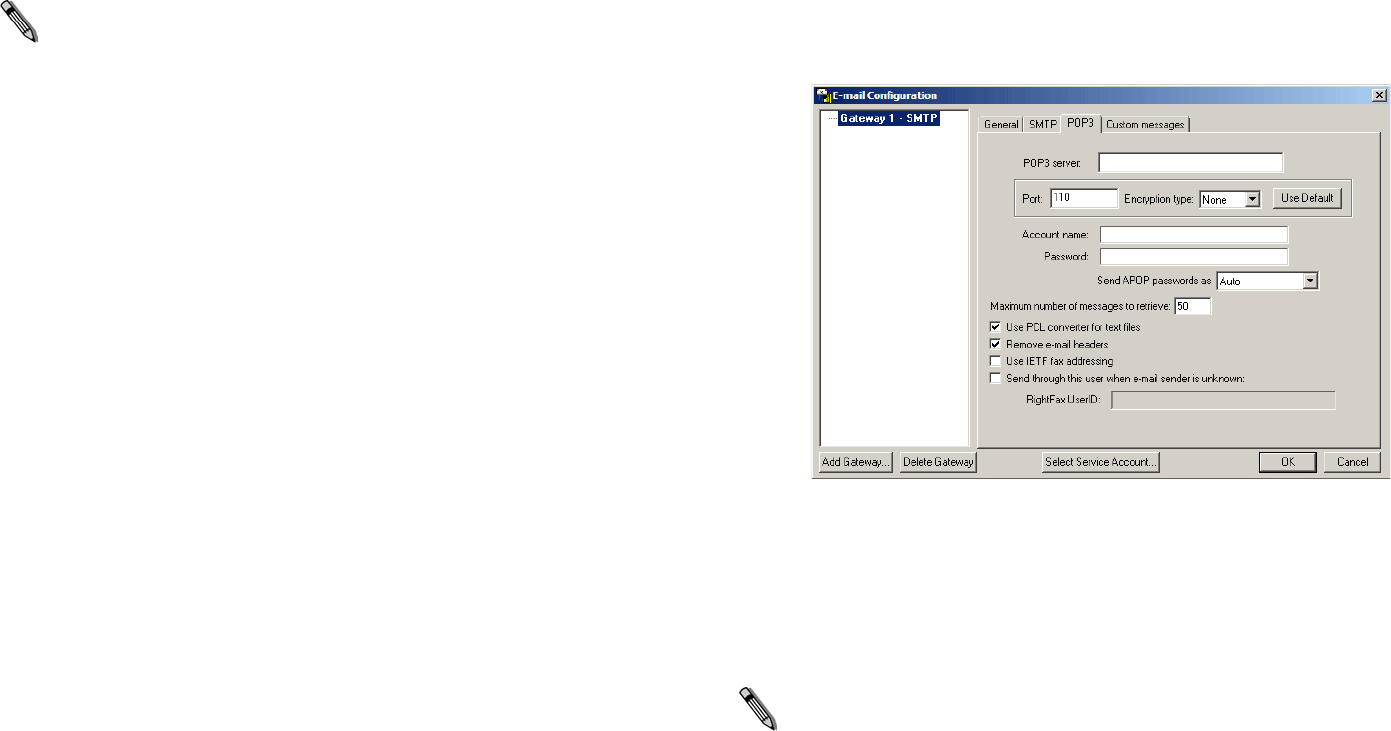
261
Encryption type: Specifies whether the server is using
encryption (TLS/SSL) or not. Defaults to None.
Note: In order to enable encryption, you must have first configured
your email server for secure communication.
Use Default: Click this button to return to the default settings of
the Port 25 and Encryption Type of None. When the
confirmation box appears, click OK.
The server requires authentication: Click this to activate the
following authentication fields:
Log on using the same settings as the incoming server:
Click this to use the account name and password from the
POP3 tab.
Log on using: Click this to enter SMTP Account name and
Password.
POP3 Settings
POP3 servers can be specified separately for each email gateway.
The content of this tab is unavailable if the email direction is set to
Inbound only.
Figure 28.3 The Email Configuration Dialog Box POP3 Tab
POP3 Server: Name or IP address of the POP3 server.
Port: Defaults to 110, the standard for nonencrypted POP3
messaging. The standard port for encrypted messaging is 995.
Enter the port number for your configuration.
Encryption type: Specifies whether the server is using
encryption (TLS/SSL) or not. Defaults to None.
Note: In order to enable encryption, you must have first configured
your email server for secure communication.
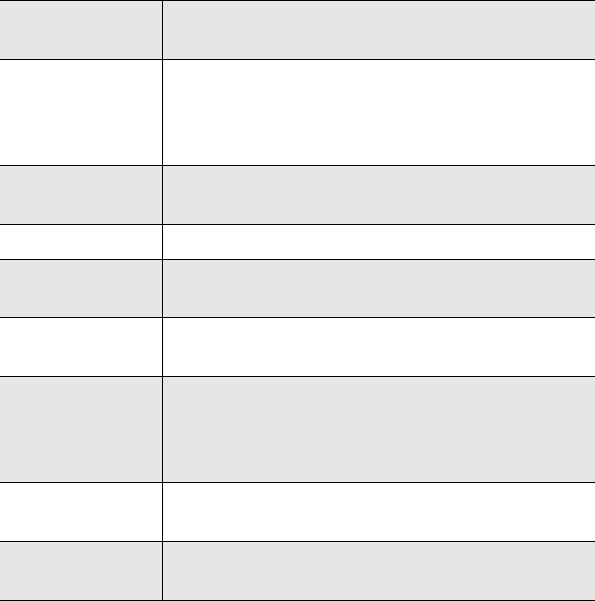
OpenText RightFax 10.0 Administrator’s Guide 262
Use Default: Click this button to return to the default settings of
the Port 110 and Encryption Type of None. When the
confirmation box appears, click OK.
Account name: POP3 login name
Password: password for the account above.
Send APOP passwords as: Choices are Auto, Encrypted only,
Clear text only. This option is not available if you have selected
encryption (TLS/SSL).
Maximum number of messages to retrieve: Specify the
maximum number of messages that can be processed at one
time by the e-mail gateway.
Use PCL converter for text files: Check this option to use the
fax server's PCL conversion engine when converting e-mail
messages to fax format. This option is required to properly
convert embedded codes in mail messages. This conversion also
usually produces more accurate fax images of ASCII text than the
fax server's native document conversion engine.
Remove e-mail headers: Click this option to remove e-mail
headers before converting to fax format.
Use IETF fax addressing: Check this option to allow the fax
server to recognize the Internet Engineering Task Force (IETF) fax
addressing standard for encoding fax destination information as
part of the SMTP e-mail address. You must use the IETF format
whan using the RightFax SMTP Gateway with Outlook 2010.
Send through this user when e-mail sender is unknown: If
the sender does not have a RightFax account, this option
specifies a valid RightFax UserID that will be used to send the
fax.
Custom messages
When a fax is received as an email attachment or when an email fax
status notification is received, a header is included in the mail
message that provides details about the fax.
To customize the text of these header messages, click the Custom
Messages tab.
The options on this tab are the same for all email gateways. Each
message combines text with one or more variables and each has
its own available variable options, described in the following table.
Table 28a Email Gateway Custom Message Settings
Notification
message Variable options
Elapsed time ~1 = The total time that the fax spent being
processed by the fax board displayed (MM:SS)
~2 = The fax channel used to send or receive the
fax
Inbound user ~1 = The RightFax user ID of the fax recipient
~2 = The fax recipient's routing code
None sent N/A
Page record ~1 = The range of page numbers successfully
sent or received
Received remote
ID
~1 = Remote ID
Result ~1 = The result code and any accompanying text
as reported by the fax board (These codes and
messages may differ depending on your fax
board type.)
Sent remote ID ~1 = The destination fax number
~2 = The destination remote ID
Sent/Received
time
~1 = Date (in Windows locale format) and time
(HH:MM)

263
To customize the subject line of the inbound message you must
edit the Windows registry.
1. Log on to the RightFax server using a Windows account that is
a memeber of the local administrators group.
2. Open the Windows registry editor and browse to
HKLM\software\RightFax\Gateway\Gateway. If you have more
than one gateway, each will be represented by its own subkey
(e.g., Gateway1, Gateway2, etc.).
3. Create a new REG_SZ entry called FaxSubject.
4. Edit FaxSubject to contain the information you wish to appear in
the subject line of inbound messages.
5. Close the Windows registry.
Select service account
Note If you will be storing or accessing files on a NetWare volume, you
must make sure the Service Account also exists as an account within
Novell.
All RightFax email gateways log on to the network as a services
using a Windows NT based user account that you specify. To
change the email gateway service account, click Select Service
Account. The Select Service Account dialog box opens.
This dialog box lists all the user accounts in a specified domain and
select the user account that the email gateway will use to log in to
the server. Click Load Users. This lists each user account in all
domains on the network. Click a user account in the list to
automatically fill in the Domain or Workgroup and User Account
boxes. Enter the password for the selected user account in both
the Password and Confirm Password boxes. Click OK to apply
the new service account.
Starting and stopping the gateway service
After installing the gateway, a new service called the RightFax
Email Gateway Module is created. If the email gateway is running
on the same computer as the fax server, the service is set to
“Manual” and is automatically started and stopped by the RightFax
Server service. You should not stop the RightFax Email Gateway
Module service manually. However, if the email gateway is running
on a remote computer (see “Running the Email Gateway Remotely”
on page 268), you must start and stop the gateway service
manually.
SMTP/POP3 gateway registry settings
Some additional functions can be set by editing the Windows
registry settings for the gateway. To see the full list, see “Gateway
Registry Entries” on page 332.
Sending a Fax via SMTP/POP3
Sending a SMTP/POP3 message to a fax number is similar to
sending email, except the message must be specially addressed.
Text entered in the Subject box will appear in the “Notes” section
of the fax cover sheet. Text entered in the body of the email will
appear as the body of the fax. Attached files will be converted to fax
images and appended to the fax. (For a list of supported file types,
see Appendix B, “File Formats that Convert to Fax Format”.)
Unsupported file attachments cannot be converted and will be
ignored.
Note: Attachments sent from Microsoft Outlook use a proprietary format
that is not supported by the SMTP gateway. If you need to send
attachments from Outlook, use the Microsoft Exchange Module (available
separately).
The RightFax email gateway looks for fax-bound email messages in
a dedicated POP3 mailbox on the SMTP mail server. Fax
destination information must be included somewhere in the
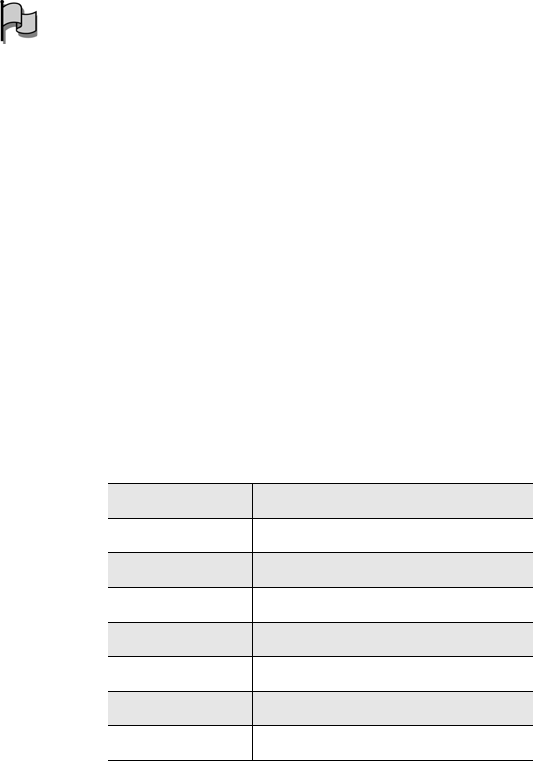
OpenText RightFax 10.0 Administrator’s Guide 264
address of each message. The SMTP/POP3 gateway supports
three addressing formats: Simple SMTP Fax Addressing,
RightFax-specific format, and IETF. Which addressing scheme the
gateway will recognize is specified in the SMTP/POP3 Email
Configuration dialog box (see “Adding and Configuring Email
Gateways” on page 259).
Important For the SMTP gateway to correctly display characters such
as the Euro symbol in the subject line and body text of the received email
message, the client application must send data to the RightFax server
using UTF-8 encoding. UTF-8 encoding must be configured as a system
setting on each client computer that uses the SMTP gateway.
Using the Simple SMTP Fax Addressing scheme
The Simple SMTP Fax Addressing scheme allows fax-bound email
messages to be addressed using a format that is similar to
standard SMTP addressing - <fax number>@domain.com
For example, to send a fax-bound SMTP message to the fax
number 555-1212 with a domain of RightFax.com, the address
format would read:
5551212@RightFax.com
The following table lists the characters supported by Simple SMTP
Fax Addressing. Space and Tabs are removed.
Using the RightFax addressing scheme
The RightFax addressing scheme allows a great deal of flexibility in
how fax-bound email messages are addressed. In all cases, faxes
must be addressed in such a way that they are forwarded to a
mailbox that has been dedicated to RightFax. How fax-bound
messages are routed to this mailbox depends on how you
configured the SMTP server (see “Configuring SMTP/POP3
gateway installations” on page 258). In addition, the name and fax
number for the recipient must be included as part of the address.
Use these rules to address fax messages using the RightFax
addressing scheme:
The first forward-slash encountered in the address indicates the
beginning of the fax destination information.
Each element of fax information (such as name and fax number) is
separated by a forward-slash.
Addressing elements can appear in any order (i.e., the fax
number can come either before or after the name).
Addressing elements cannot be separated by the RightFax
mailbox address itself.
A fax recipient name and destination fax number are required. If
either element is not found, the message will be discarded.
The last element of fax information must be terminated by either a
forward-slash (/), an ‘@’ symbol, or the end of the line. This allows
any character to be part of a fax information element, including
spaces.
If a special character is required as part of a fax information
element, it can be specified by using a percent symbol (%)
followed by the ASCII value of the character expressed in
hexadecimal. For example, the space character has the ASCII
value of 32, which is written as 20 in hexadecimal, so a space can
be represented as ‘%20’. This encoding is only required if the
special characters needed cause problems for your mail system.
Table 28b Supported Simple SMTP Fax Addressing Characters
Character Example
0-9 0123456789@<domain.com>
*123*456@<domain.com>
##123456@<domain.com>
++15551212@<domain.com>
-555-1212@<domain.com>
A-Z ABCDEFG@<domain.com>
.Name.Org@<domain.com>
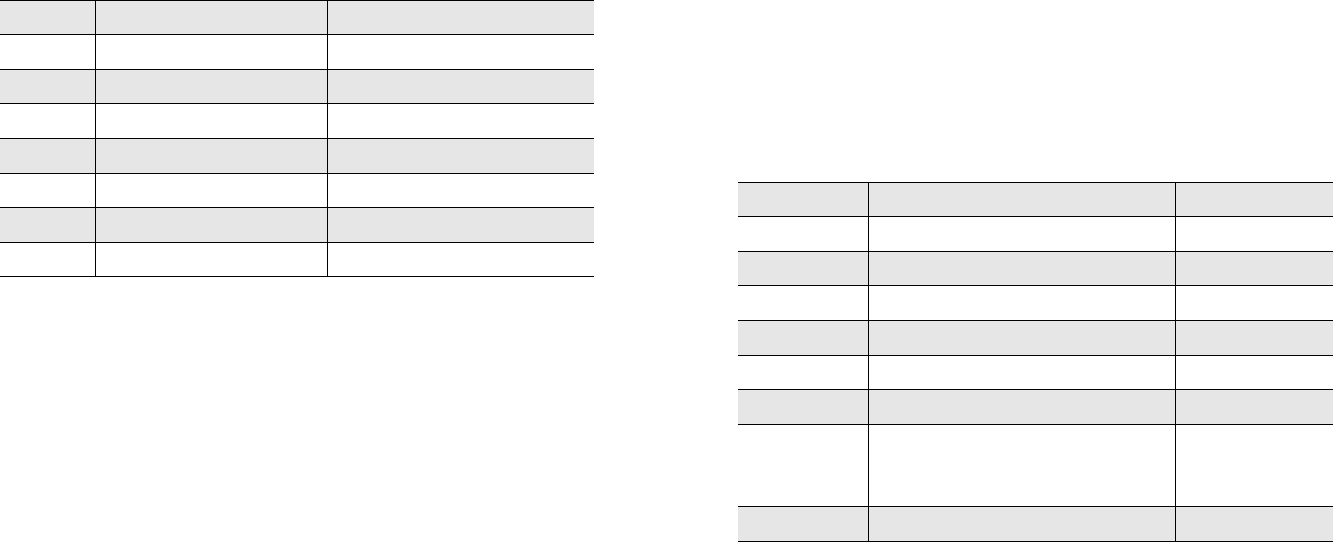
265
The following table lists all fax destination elements supported by
the RightFax addressing scheme. Only the fax number and name
elements are required. Except for the fax number, all of these
addressing elements are used only for display on the fax cover
sheet.
Examples/name=Jane/fax=555-1212@faxgate.company.com
/fax=5551212/name=Jane/com=Acme@faxgate.acme.
com
faxgate@company.com/name=Jane/fax=555-1212
/name=Jane%20Doe/fax=5551212/faxgate@company.
com
Using the IETF addressing scheme
The IETF addressing scheme requires faxes be addressed in such
a way that they are forwarded to a mailbox that has been dedicated
to RightFax. How fax-bound messages are routed to this mailbox
depends on how you configured the SMTP server see “Configuring
SMTP/POP3 gateway installations” on page 258. In addition, the
name and fax number for the recipient must be included as part of
the address. Use these rules to address fax messages using the
IETF addressing scheme:
Only the portion of the address to the left of the domain name
(everything to the left of the ‘@’ sign) is significant to the fax
destination.
The address must begin with the fax destination number.
The fax number can be followed by one or more optional
keywords that provide additional fax information.
The following table lists supported keywords for the IETF
addressing scheme.
Any invalid keywords included in the address will be ignored.
Example fax=555-1212@faxgate.company.com
/fax=555-1212/pn=Jane.Doe@faxgate.company.com
fax=5551212/g=Jane/s=Doe/o=Acme@
faxgate.acme.com
Table 28c RightFax Scheme Addressing Elements
Element Definition Example
/bi1= Billing code 1 /bi1=1111
/bi2= Billing code 2 /bi2=2222
/city= Recipient city, state /city=Tucson, AZ
/com= Recipient company name /com=Acme, Inc.
/fax= Destination fax number /fax=555-1212
/name= Recipient name /name=Jane Doe
/voice= Recipient voice number /voice=555-4567
Table 28d IETF Scheme Addressing Elements
Element Definition Example
/dd.bi1= Billing code 1 /dd.bi1=1111
/dd.bi2= Billing code 2 /dd.bi2=2222
/fax= Recipient fax number /fax=555-1212
/g= Recipient first (given) name /g=Jane
/i= Recipient middle initial /g=M
/o= Recipient company name /o=Acme, Inc.
/pn= Recipient name (separate first,
middle, and last name with a
period)
/pn=Jane
/pn=Jane.Doe
/pn=Jane.M.Doe
/s= Recipient last name (surname) /s=Doe
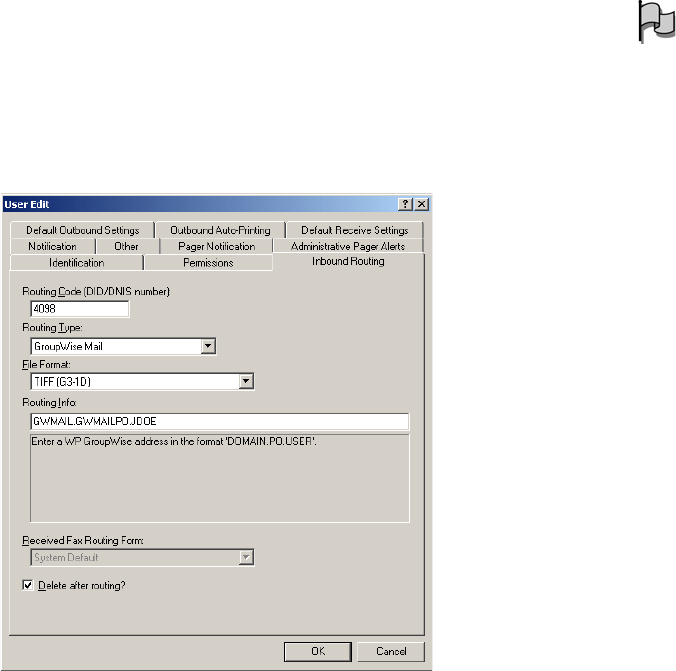
OpenText RightFax 10.0 Administrator’s Guide 266
Receiving Faxes via Email
With the RightFax email gateways, RightFax users can receive
faxes as email message attachments instead of (or in addition to)
receiving them in their FaxUtil mailboxes.
To configure a user to receive faxes in email
1. In Enterprise Fax Manager, double-click the user to open the
User Edit dialog box, and then click the Inbound Routing tab.
Figure 28.4 The User Edit Dialog Box Inbound Routing Tab
2. In the Routing Type box, click your email gateway type.
3. In the File Format box, click the file format RightFax will use for
the fax attachment. For information on each fax image format,
see “File Format” on page 109.
Important If you will be routing faxes to Microsoft Outlook
mailboxes and your users have the Advanced Outlook form installed,
you must select TIFF as the file type for routing. The Outlook
Advanced forms do not support other file types.
4. In the Routing Info box enter the user’s SMTP email address
(e.g., user@company.com). For example: jdoe@acme.com.
5. Select the Delete After Routing check box only if you want to
delete the fax from the user’s FaxUtil mailbox after it is routed to
email. If RightFax cannot route a fax to the destination email
mailbox, it will leave the fax in the user’s FaxUtil mailbox
regardless of how this option is set.
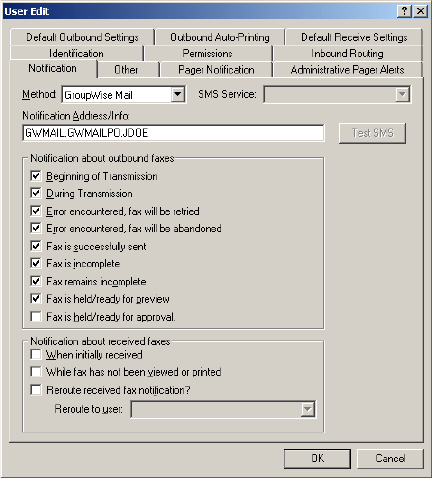
267
Email Notification of Faxes
The RightFax email gateways can be used to notify users of fax
status whether or not the installed gateway is configured to send
and receive faxes.
To configure a user to receive fax notification in email
1. In Enterprise Fax Manager, double-click the user to open the
User Edit dialog box, and then click the Notification tab.
Figure 28.5 The User Edit Dialog Box Notification Tab
2. In the Notification Method box, click your email gateway type.
3. In the Notification Address/Info setting enter the user’s SMTP
email address (e.g., user@company.com). For example:
jdoe@acme.com.
4. From the Notifcations about outbound faxes and
Notifications about received faxes lists, choose the events
that will trigger notifications.
5. Click OK when you are done.
The SMTP gateway requires that you set up a default user. When
sending faxes from the SMTP gateway, notifications may be sent to
either the default User ID or the actual sending User ID as follows:
If the fax is held for preview or approval, the notification will go
only to the default User ID.
If the fax is sent successfully, the notification will go only to the
sender’s User ID.
If the fax fails for any reason, the notification will go to both the
the sender’s User ID and the SMTP gateway default User ID.
The notification method can be configured for a user group by
editing the group ID properties in Enterprise Fax Manager and
setting the group Notification Type to the option that corresponds
to your email gateway type.
Embedded Codes in Mail Messages
Embedded codes are special faxing instructions that you insert
directly into fax-bound documents such as email messages. You
can use embedded codes to include fax cover sheet information,
attach library documents, add billing information, and more.
To add an embedded code to an email message, type the code you
want, along with any required parameters, between angle brackets.
For example, an embedded code that tells RightFax to send a
library document called “PriceSheet” is written as:
<LIBDOC:PRICESHEET>

OpenText RightFax 10.0 Administrator’s Guide 268
RightFax removes all embedded codes from the mail message
when it converts it to fax form so they don’t appear in your final fax.
If you type an embedded code incorrectly, it will be ignored by
RightFax and will be included in your fax. Embedded codes can be
written in either upper or lower case.
Tip Select Use PCL converter for text files if you plan to use embedded
codes in your faxes.
Embedded codes can be placed anywhere in the body of the mail
message (they will not work in the Address or Subject boxes).
Embedded codes cannot line wrap and any embedded code
statement that is so long that it wraps to a second line will be
ignored.
The RightFax email gateways support the following embedded
codes. For descriptions and examples of each embedded code,
see Appendix A, “RightFax Embedded Codes”.
ATDATE
ATTIME
CHANNEL
COVER
DELETE
DELETEALL
FCSFILE
FINE
FROMFAXNUM
FROMGENFAXNUM
FROMNAME
FROMPHONE
IGNORE
LIBDOC (Same as LIBDOC2 in email gateways)
LIBDOC2
NOCOVER
NORMAL
PREVIEW
PRIORITY
SAVE
Running the Email Gateway Remotely
By default, each email gateway installs and runs directly on the
RightFax server, however, there are some situations where it is
beneficial to run the email gateway on a different computer on your
network. You might not, for example, want to increase the workload
269
on your fax server. Or, you may anticipate a very high volume of
gateway traffic and don’t want the added workload to interfere with
the routine operation of your fax server.
To run the gateway remotely
1. Select the RightFax Email Gateway configuration in Enterprise
Fax Manager. The Email Configuration dialog box opens.
2. Select the Remote Email Gateway Service check box to
enable remote operation.
3. Map a drive to the \RightFax folder on the fax server.
4. Switch to the \RightFax\Gateway folder and enter the following
command:
smtpgateway -lpath -fdatabase -sgatewayn
Where path is the directory path to the RightFax files, database
is the name of the server containing the fax database, and n is
the number of the email gateway. This number is zero-based, so
the first email gateway is “gateway,” the second email gateway
is “gateway1,” the third email gateway is “gateway2,” and so on.
To confirm the gateway number, open the Windows registry and
check the Gateway keys under
HKEY_LOCAL_MACHINE\Software\RightFax\Gateway
(64-bit: HKEY_LOCAL_MACHINE\Software\Wow6432Node\
RightFax\Gateway).
For example, to start the Remote Gateway service process from
drive R: (which is mapped to the RightFax folder on the fax
server) using the RightFax Database Module on the server
“rfaxserv, ” enter:
smtpgateway -lr: -frfaxserv -sgateway
Troubleshooting the Email Gateways
If you experience problems with your RightFax Email Gateway
Module service, you should first check for errors in the Application
log of the Windows Event Viewer. Select Start > Programs >
Administrative Tools > Event Viewer. In the Event Viewer, select
Application from the Log menu to open the Application log. Email
gateway-related problems will appear on the log in the Source
column as “RightFax Email Gateway Module.” Double-click the
entry for a description of the error.
The amount and type of information saved to the Event log is
determined by the LogLevel setting in the RightFax Email Gateway
configuration in Enterprise Fax Manager. With the log level set to
terse, only critical errors will be recorded. Log levels normal and
verbose record more information which may help track down
problems.
Running the gateway in a command prompt window will also give a
very detailed report of gateway events. To run the gateway in a
command window, first make sure that the RightFax Email Gateway
Module service is stopped (for information on stopping the
RightFax services, see “Starting and stopping services” on
page 99.) Open a command prompt window and change to the
RightFax\Gateway folder. To run the gateway, enter the following
command
smtpgateway -d -1 -sgatewayn
Where n is the number of the email gateway. This number is
zero-based, so your first email gateway is referred to as “gateway,”
your second email gateway is referred to as “gateway1,”your third
email gateway is referred to as “gateway2,” and so on. To confirm
the gateway number, open the Windows registry and check the
Gateway keys under HKEY_LOCAL_MACHINE\Software\
RightFax\Gateway (64-bit: HKEY_LOCAL_MACHINE\Software\
Wow6432Node\RightFax\Gateway).
Example If you are running the SMTP gateway and it is your only
email gateway, enter: smtpgateway -d -1 -sgateway
OpenText RightFax 10.0 Administrator’s Guide 270
When running the email gateway in a command window, you must
set the window properties to allow you to scroll back many lines. To
set the command window to sufficient size, click the MS-DOS icon
in the top left of the command window. Click Properties to open
the Command Prompt Properties dialog box. Click the Layout
tab, and then set Screen Buffer Size height to “2000.”
Error 2140 Starting Service
Error 2140 is a generic Windows NT based error stating that the
service did not start. Check the Event Viewer Application log,
under the Source column “RightFax Email Gateway Module” for
more details.
Error 53
This is a Windows NT based networking error which indicates that
the UNC name that was specified for the Location of Mail Files in
the gateway configuration is an invalid network path. If the
specified path is correct and valid, it may be that the account being
used to start the Email Gateway Module service does not have
access rights to that folder.
Error 85 The local device is already in use
This is a Windows NT based networking error stating that the drive
to which RightFax is trying to connect the UNC name that was
specified for the Location of Mail Files, or API Files is already
assigned.
271
Chapter 29
Inbound Faxing with Microsoft Exchange 2010 Unified Messaging
Overview
OpenText RightFax 10.0 is a partner fax solution for Microsoft
Exchange 2010 Unified Messaging. Inbound fax calls are detected
by Exchange 2010 UM and referred to the Open Text Fax Server
for processing. The Open Text Fax Server handles the fax call,
receives the fax image, and sends it to the recipient's mailbox as an
email message with TIFF image attachment.
Requirements
Microsoft Exchange Server 2010 with the Unified Messaging role
installed and configured.
An IP Gateway installed and configured to communicate with the
Exchange Server.
OpenText RightFax 10.0.
Brooktrout SR140 Transport installed and licensed on the Fax
Server.
Configuring Exchange 2010 UM for Faxing
This chapter assumes that the Microsoft Exchange 2010 Unified
Messaging role is already installed and configured in your
organization. These steps include creating the following items in
UM:
UM Dial Plans
UM Mailbox Policies
UM IP Gateway
UM IP Hunt Groups
UM-enabled Mailboxes
For detailed instructions on how to complete these steps, consult
the Microsoft Exchange 2010 documentation which can be found
at http://technet.microsoft.com/en-us/library/
dd335104(EXCHG.140).aspx.
This section describes the additional requirements to enable
inbound faxing with Unified Messaging.

OpenText RightFax 10.0 Administrator’s Guide 272
Fax Tone Detection
Fax tone detection is deactivated by default in Exchange 2010 UM.
Ensure that fax tone detection has been activated on each UM
Server that will receive fax calls. Change the
EnableInbandFaxDetection setting in the MSExchangeUM.config
file located in the
X:\Program Files\Microsoft\ExchangeServer\V14\Bin directory
from False to True.
Note: Restart the Exchange 2010 server for the changes to take effect.
Dial Plans
Ensure that each UM dial plan is enabled to receive faxes. By
default, the ability to receive faxes is activated. If you prevent the
dial plan from receiving faxes, no users in the dial plan will be able
to receive faxes. The Dial Plan setting takes precedence over
individual UM-enabled user settings.
UM Mailbox Policy
Configure each UM mailbox policy to allow users with that policy to
receive faxes. The Mailbox Policy configuration includes the Fax
Server URI in the following format (include the quotation marks):
sip:<FQDN or IP of Fax Server>:<port>;<transport>"
Port = The port on which the fax server listens (Default is 5060)
Transport = The transport protocol (Default is UDP)
Example: "sip:172.17.18.19:5060;Transport=UDP"
User Mailboxes
The ability to receive faxes can be enabled on an individual Unified
Messaging mailbox basis. Ensure that each Exchange 2010
mailbox is UM-enabled and is enabled to receive faxes.
Dedicated Receive Connector
Fax messages sent to Exchange 2010 UM from the Fax Server
must be authenticated. To facilitate authentication, create a new
partner receive connector on the Hub Transport server to which the
Fax Server will submit SMTP fax messages. Configure the receive
connector with the following values:
Intended use: Partner
AuthMechanism: ExternalAuthoritative
PermissionGroups: ExchangeServers, Partners
RemoteIPRanges: {Fax Server IP address}
requireTLS: False
EnableAuthGSSAPI: False
Note: For more information about creating receive connectors, see the
Microsoft documentation at
http://technet.microsoft.com/en-us/library/bb125159(EXCHG.140).aspx
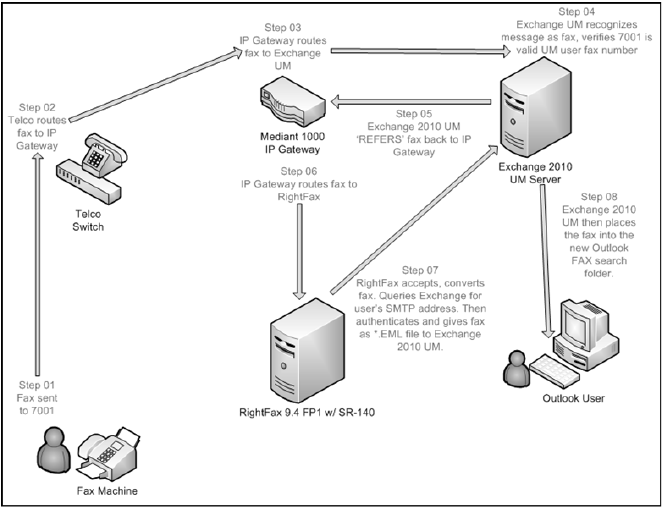
273
Configuring OpenText RightFax for Exchange
2010 UM
When fax calls are detected by Exchange 2010 Unified Messaging,
they are referred back to the IP Gateway for delivery to the Open
Text Fax Server for processing. After processing, each fax is
handed off to the Exchange 2010 UM server for delivery to the
user. The email with attached fax TIFF image is placed into the
Inbox as well as a new Search Folder called "Fax" in the recipient's
Outlook mailbox.
Figure 29.1 Inbound Faxing with Exchange 2010 Unified Messaging
OpenText RightFax 10.0 Administrator’s Guide 274
275
Chapter 30
Using TeleConnect to Access Faxes by Phone
With the RightFax TeleConnect feature, users can access their fax
mailboxes via a touch-tone telephone. Users dial in to the RightFax
server to use RightFax’s automatic forwarding, printing, and
notification features to manage faxes. The TeleConnect menu of
options includes:
Retrieve new faxes
Retrieve a catalog of faxes
Retrieve specific faxes from the catalog
Hear fax statistics
Change fax mailbox options
To run TeleConnect, you must have a RightFax server installed and
operational. Because it uses digital voice prompts, you must also
have a Brooktrout fax board with voice capability installed.
TeleConnect does not require a separate or additional installation
to your fax server.
Configuring TeleConnect
Configure TeleConnect through the RightFax DocTransport
module.
1. On the RightFax server, select Start > Programs > Enterprise
Fax Manager.
2. In the Enterprise Fax Manager application, click the name of the
RightFax server to configure in the tree in the left pane. A list of
services appears at the lower-right pane of the window.
3. In the Service Name list, double-click RightFax DocTransport
Module. The DocTransport Configuration dialog box opens.
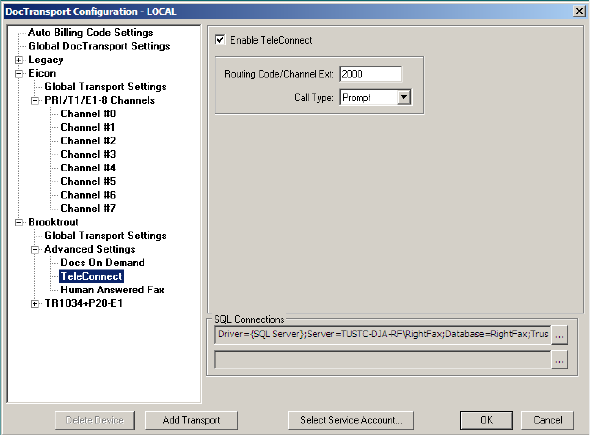
OpenText RightFax 10.0 Administrator’s Guide 276
4. Under BrookTrout in the left pane, select Advanced Settings
and then TeleConnect.
Figure 30.1 The TeleConnect Configuration Dialog Box
Enable TeleConnectEnables the TeleConnect Module.
Routing Code/Channel ExtSpecifies the routing code (such
as DTMF extension or DID number) that will be assigned to
TeleConnect. When calls arrive on this extension they will enter the
TeleConnect system automatically, rather than being received as an
incoming fax.
If you have a bank of numbers dedicated to your fax server, you
must assign one of the numbers to TeleConnect by entering the
extension here. If you have only analog channels you must dedicate
one of your fax channels to TeleConnect. To do this, enter a unique
four-digit number in this box, and then click the channel you want to
dedicate under Global Board Settings in the left pane and enter
the same four-digit value in the Channel Extension box. Users
must be able to dial into this channel directly. The channel should
not be part of a hunt group unless all the channels in that hunt
group are dedicated to TeleConnect. Otherwise, dialing the
number may cause users to hear a fax tone instead of accessing
the TeleConnect system.
You can also turn on DTMF routing for a particular analog channel.
When users dial this number they will hear a tone or voice prompt
to enter an extension. Enter a unique four-digit extension in this box.
If you tell your users to enter this number when they hear the
prompt, they will connect to the TeleConnect system. If this number
is not entered after a few seconds (depending on the DTMF
timeout value), the channel will provide a fax tone and attempt to
receive a fax.
Call Type Specifies how TeleConnect will connect to the caller
when faxes are requested.
“One Call” requires the user to call from a fax machine.
TeleConnect uses the same connection to send faxes back to the
caller without having to initiate a second call. In this way,
TeleConnect incurs no phone charges. “
Two Call” causes TeleConnect to request the recipient’s fax
number and then initiates a separate call to send faxes.
“Prompt” asks each user to specify a one- or two-call session.
RightFax user setup
To use TeleConnect to access RightFax via touch-tone phone, each
caller must have a RightFax user account with unique numeric
Voice Mail Subscriber ID setting and a Password. (The
Password setting cannot be blank.) TeleConnect uses these
settings to identify the user when calling in to the system.
Multilingual Support
The TeleConnect Module supports messaging in up to nine
languages in addition to the English language default. When
multilingual support is enabled, you can record your own language

277
message files and save them to their own folders. When callers first
dial into the system, TeleConnect will play a message asking them
to select the language they want.
To enable multilingual support, add the TeleConnect registry
keyword Multilingual(1).
Then create a TeleConnect registry keyword for each additional
language you want to support using the format
VoicePath#(voicepath1;voicepath2), where # is a number 2
through 9 that the user will press to access alternate language files
(English is automatically set to “1”), voicepath1 is the path to the
local folder where the language files are stored, and voicepath2 is
an optional secondary folder path. If TeleConnect cannot find the
file it wants in the first folder, it will look in the second folder.
For information on creating TeleConnect registry entries see
“TeleConnect Registry Configuration” on page 281.
Multilingual selection prompts
After multilingual support is enabled, TeleConnect will automatically
cycle through every defined VoicePath entry, starting with
VoicePath1 and ending with VoicePath0. It will play message
010.VOX from each VoicePath folder, if the file exists.
The default message file 010 says “For an English language menu,
press 1.” In VoicePath2, this file might say (in Spanish) “For a
Spanish language menu, press 2.” In VoicePath3, it might say (in
German) “For a German language menu, press 3.”
Recording multilingual messages
You can record custom multilingual messages for TeleConnect
using a third-party sound editor that supports the Dialogic OKI32
file format, or using the message recorder built into the
Fax-on-Demand component of the Docs-on-Demand Module (if it is
licensed and installed.) For information on using Docs-on-Demand
to record prompts, refer to the RightFax Docs-on-Demand Guide.
Toll-Number Support
Your TeleConnect system can be set up on 1-900 and 1-976
toll-lines. FCC requirements for toll-numbers state that callers may
not be charged until a full minute has gone by. During the first 30
seconds of the call, callers must be told how much they are going
to be charged and they must agree to the charges. If the caller
does not immediately agree to the charges, the line must be
disconnected.
To enable toll-number support, add the TeleConnect registry
keywords 900Enable(1) and 900Agree(#), where # is a number 0
through 9 that the caller must press to respond affirmatively and
continue with the call. If this parameter is left blank, any key will be
accepted. The system will automatically hang up on anyone who
has not pressed the agree button within the first 28 seconds of the
call.
For information on creating TeleConnect registry entries see
“TeleConnect Registry Configuration” on page 281.
Toll-number prompt
Note If you have both toll-number and multilingual support enabled,
Fax-on-Demand will play the VoicePath prompts before the toll-number
prompt. Because selecting a language option is interpreted as an
agreement by the caller to accept the charges, toll-call information should
be included in your foreign language prompts.
After toll-number support is enabled, message 020.VOX will play
one time. This message should explain how much the caller will be
charged, that he must be 18 years or older, and request him to
press a key to agree to the charges. This prompt must be less than
the 28 second limit to press the required agreement key.
If the caller doesn’t press a key or presses a key other than one
specified by the 900Agree registry keyword, the line will be
disconnected. If the caller presses the key specified by the
900Agree keyword (or any key if the 900Agree value is blank), the
system will proceed to the Main menu.
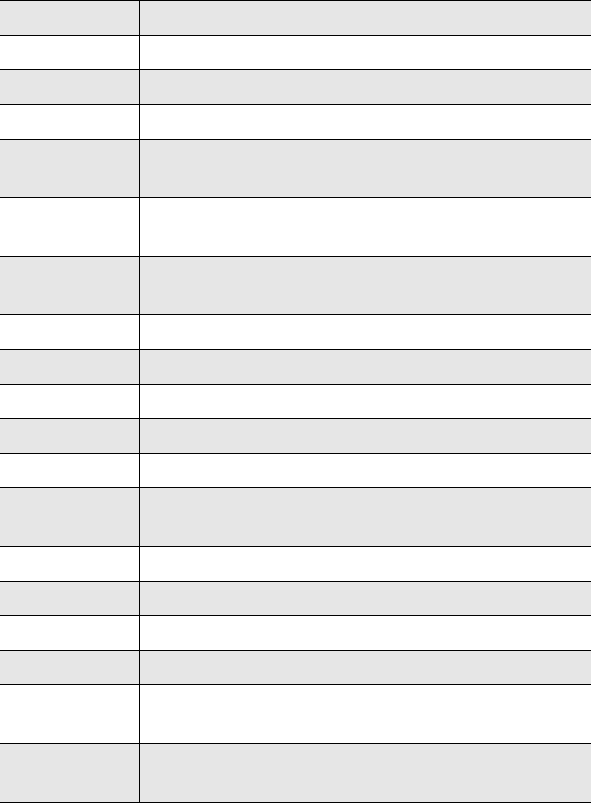
OpenText RightFax 10.0 Administrator’s Guide 278
Requesting Fax Routing Information
If a fax is sent to a number that delivers faxes to several people
(such as a public or hotel fax machine), there may be a problem
determining the fax recipient. TeleConnect can be configured to
ask the caller to enter a name or phone number to assist in routing.
Requests for fax routing information are skipped if the caller
requests the fax(es) be sent back to the fax machine he is calling
from using the same connection (the One-call option).
To ask the caller to enter a phone number to assist with routing,
add the TeleConnect registry keyword AskVoiceNumber(1).
To ask the caller to enter an alphanumeric sequence (such as a
name), add the TeleConnect registry keyword
AskAlphaNumeric(1).
If either of these options is enabled, TeleConnect will play message
file 306. If you enabled AskVoiceNumber only, message file 306
will be followed by message file 307. If you enabled
AskAlphaNumeric only, message file 306 will be followed by
message file 312. If you enabled both AskVoiceNumber and
AskAlphaNumeric, message file 306 will be followed by message
file 311. For a complete list of TeleConnect’s message files refer to
the next section.
Voice Prompt Files
The TeleConnect module uses voice prompt files located in the
RFBoard\Mainapp\Voices folder on the RightFax server. Voice
prompt files are saved as Dialogic® OKI32 files (.vox files). These
files can be customized in Fax-on-Demand (described in the
RightFax Docs-on-Demand Guide) or using a third-party sound
editor that supports the Dialogic OKI32 file format.
All files in the RFBoard\Mainapp\Voices folder are listed in the
following table along with their voice text.
Table 01 Voice Prompt Files Used by TeleConnect
File name Voice prompt
a.vox “...a...”
allque.vox “All of your queued faxes will be sent.”
b.vox “...b...”
badfaxnum.vox “Invalid entry. We will not send documents to that
fax number.”
badlogin.vox “The mailbox and password combination you
entered is not valid. Please try again.”
beginrec.vox “You may begin recording after the beep. Press
pound when finished.”
c.vox “...c...”
catalog.vox ”...catalog...”
catalogs.vox “...catalogs...”
count.vox “...faxes with a total of...”
d.vox “...d...”
deliverif.vox ”Are you sure you want to delete this message?
Press 1. If not, press 2.”
doc.vox ”...document...”
docs.vox ”...documents...”
fax.vox “...fax...”
faxes.vox “...faxes...”
faxnum.vox “Enter your fax number and then press the pound
key.”
faxtype.vox “If you are calling from your fax machine, press 1. If
you wish the fax delivered to a fax number, press 2.”
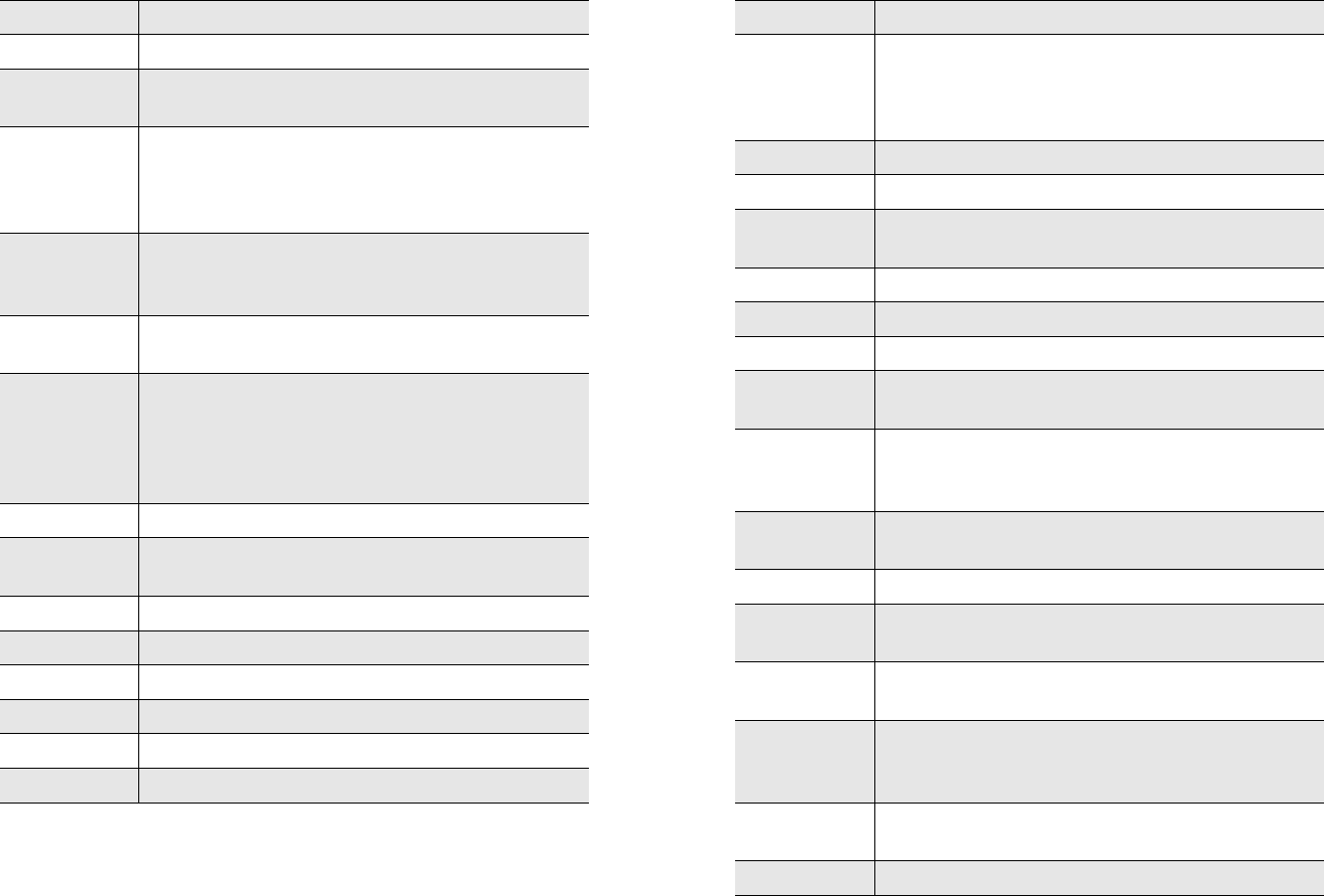
279
fwdfax.vox “Your faxes are currently being forwarded to...”
fwdfaxnm.vox “Please enter the fax number to forward your faxes
to.”
fwdmenu.vox “To automatically forward your faxes to a fax
machine, press 1. To forward your faxes to a
network user, press 2. To disable fax forwarding,
press 3. To cancel changes, press the Star key.”
fwdnous.vox “You may not enable fax forwarding to a network
user because a destination user has not been
specified.”
fwduser.vox “Your faxes are currently being forwarded to a
network user.”
fwdwarn.vox “Your fax forwarding option is currently set to a
network user. If you change this, there will be no
way to restore this setting over the telephone
interface. If you still want to change this option,
press 1. If not, press 2.”
goodbye.vox “Goodbye.”
greeting.vox “Welcome to RightFax, the leading enterprise fax
server.”
hundred.vox “...hundred...”
ifcorrec.vox “If this is correct, press 1. To reenter, press 2."
invalid.vox “Invalid entry. Please try again.”
isnotavail.vox “...is not available.”
login1.vox “Please enter your mailbox number.”
login2.vox “Please enter your security code.”
Table 01 Voice Prompt Files Used by TeleConnect (Continued)
File name Voice prompt
mainmenu.vox “To retrieve faxes, press 1. To retrieve a list of all
faxes, press 2. To hear fax mailbox statistics, press
3. To change mailbox options, press 4. To quit,
press the Star key.”
million.vox “...million...”
n00.vox ”...zero...”
n01.vox -
n99.vox
“...one...” - “...ninety-nine...”
new.vox “...new...”
nofwd.vox “Your faxes are not currently being forwarded.”
nonewfxs.vox “You have no new faxes.”
nonque.vox “We are unable to queue your faxes for
transmission.”
noprinter.vox “Your faxes may not be automatically printed
because a destination printer has not been
selected.”
notavail.vox “The fax server is not available. We are unable to
process your call.”
notones.vox ”No entries detected. Please try again.”
ntfdisab.vox “Alternate notification to another network user is
disabled.”
ntfenab.vox “Alternate notification to another network user is
enabled.”
ntfmenu.vox “To enable alternate notification press 1. To disable
alternate notification, press 2. To cancel changes,
press the Star key.”
ntfwarn.vox “You may not enable alternate notification because
a network user to notify has not been selected.”
onecall.vox “Shared call beginning.”
Table 01 Voice Prompt Files Used by TeleConnect (Continued)
File name Voice prompt
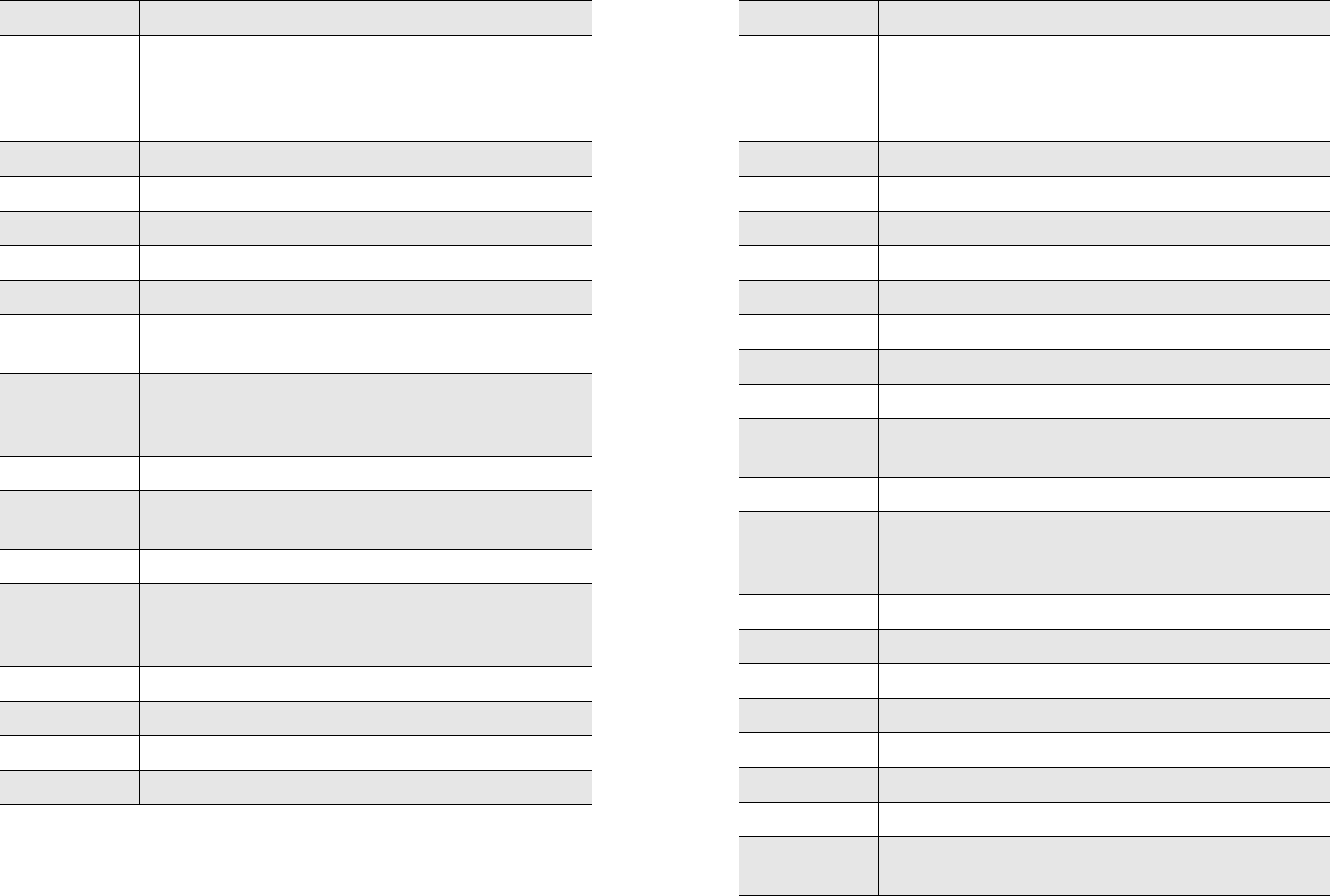
OpenText RightFax 10.0 Administrator’s Guide 280
optmenu.vox “For automatic forwarding options, press 1. For
automatic printing options, press 2. For alternate
notification options, press 3. To return to the Main
menu, press the Star key.”
outbound.vox “...outbound...”
page.vox ”...page...”
pages.vox ”...pages...”
pound.vox “...pound...”
prndisab.vox “Your faxes are not being automatically printed.”
prnenabl.vox “Your faxes are currently being automatically
printed.”
prnmenu.vox “To automatically print your faxes, press 1. To
disable automatic printing, press 2. To cancel
changes, press Star.”
rcvstat1.vox “...received faxes totalling...”
rcvstat2.vox “...of your received faxes have not been viewed or
printed.”
received.vox “...received...”
recmenu.vox ”To play back, press 1. To record, press 2. To save
this message, press 3. To cancel changes, press 4.
To delete this message, press 5.”
rtverr1.vox “You entered an invalid fax ID number.”
rtvid1.vox “You may retrieve up to...”
rtvid2.vox “Enter the fax ID number and press Pound.”
rtvmax.vox “You have entered the maximum allowable fax IDs.”
Table 01 Voice Prompt Files Used by TeleConnect (Continued)
File name Voice prompt
rtvmen.vox “To retrieve all new faxes, press 1. To retrieve a list
of all faxes, press 2. To retrieve faxes by their ID
number, press 3. To return to the Main menu, press
the Star key.”
sil_100.vox 0.1 second silence
sil_1000.vox 1 second silence
sil_250.vox 0.25 second silence
sil_500.vox 0.5 second silence
sntstat1.vox “...outbound faxes totalling...”
sntstat2.vox “...are in process...”
sntstat3.vox “...have been sent successfully, and...”
sntstat4.vox “...are abandoned.”
someque.vox “Not all of your queued faxes will be sent due to an
error.”
star.vox “...star...”
statmenu.vox “For statistics on outbound faxes, press 1. For
statistics on inbound faxes, press 2. To return to the
main menu, press the Star key.”
that.vox “That...”
thissess.vox “...this session.”
thousand.vox “...thousand...”
toprocee.vox “To proceed...”
totaling.vox “...totalling...”
upto.vox “...up to...”
waitcnt.vox “Please wait while the system retrieves your faxes.”
waitgen.vox “Please standby while we are processing your
request.”
Table 01 Voice Prompt Files Used by TeleConnect (Continued)
File name Voice prompt
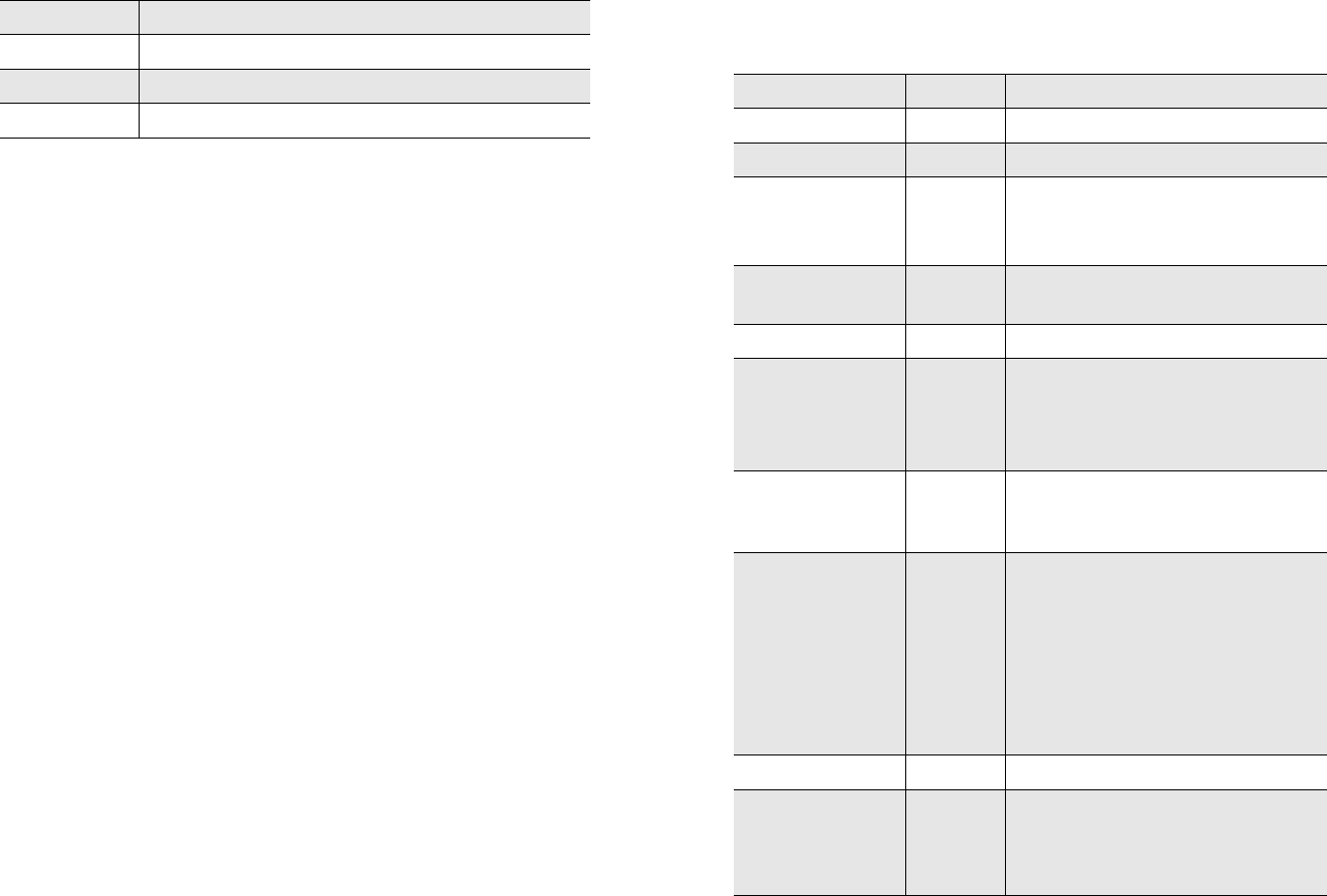
281
TeleConnect Registry Configuration
TeleConnect is configured primarily via multi-string (Reg_Multi_SZ)
registry entries. Each channel dedicated to TeleConnect has its
own configuration registry entry. The TeleConnect configuration
registry entry is located at HKEY_LOCAL_MACHINE\Software
\RightFax\DocTransport\Transports\Brooktrout\TUI\Extensions
(64-bit: HKEY_LOCAL_MACHINE\Software\Wow6432Node\
RightFax\DocTransport\Transports\Brooktrout\TUI\Extensions).
The multi-string registry entries for TeleConnect use this format:
extension`keyword(value)`keyword(value)`...
Where extension is the phone number extension or DID channel
assigned to TeleConnect, ` is the “grave” character located on the
same key as the tilde (~), keyword is one of the configuration
setting keywords from the following table, and value is an optional
value setting for the keyword. The phone number extension or DID
channel assigned to TeleConnect is always the first entry. The
extension and all keywords must be separated by a grave (`)
character.
For example, if you want to set up TeleConnect for DID extension
2000 so that it asks the caller to enter a return-fax number, limits
the caller to 32 faxes per call, and disconnects after 3 errors, the
entry would be:
2000`CallType(0)`MaxErrors(3)`MaxFaxes(32)`
If you want extension 2001 to have a limit of 25 faxes, always send
the faxes back to the originating number, and disconnect after only
2 errors, the entry would be:
2001`CallType(1)`MaxErrors(2)`MaxFaxes(25)`
The following table lists all available TeleConnect keywords, and
includes the default settings (if any) and descriptions.
youhave.vox “You have...”
youmay.vox “You may request...”
youselec.vox “You selected...”
Table 01 Voice Prompt Files Used by TeleConnect (Continued)
File name Voice prompt
Table 02 TeleConnect Registry Values
Keyword Default Description
900Agree N/A 900 caller agreement sequence.
900Enable False 900 telephone processing.
AppType 0Application type:
0 = TeleConnect
2 = One-Doc Poll
AskAlphaNumeric False Ask caller for alpha-numeric
sequence.
AskVoiceNumber True Ask caller for voice number.
CallType 0Default call type:
0 = Prompt
1 = One-call
2 = Two-call
CSID N/A CSID to use during a one-call
transaction. If blank, it uses the
channel default.
DefaultBI1 N/A Default billing code #1 for a two-call
fax TeleConnect. If a fax is being
forwarded from a user’s mailbox, the
system will attempt to use the billing
codes from the source fax. If no
billing codes are present in the
source fax, the value specified here,
and that of DefaultBI2, will be used.
DefaultBI2 N/A Default billing code #2 for two-call.
MaxErrors 3Maximum number of errors allowed
(timeouts, invalid doc numbers, etc.)
If this number is exceeded, the caller
will be disconnected.
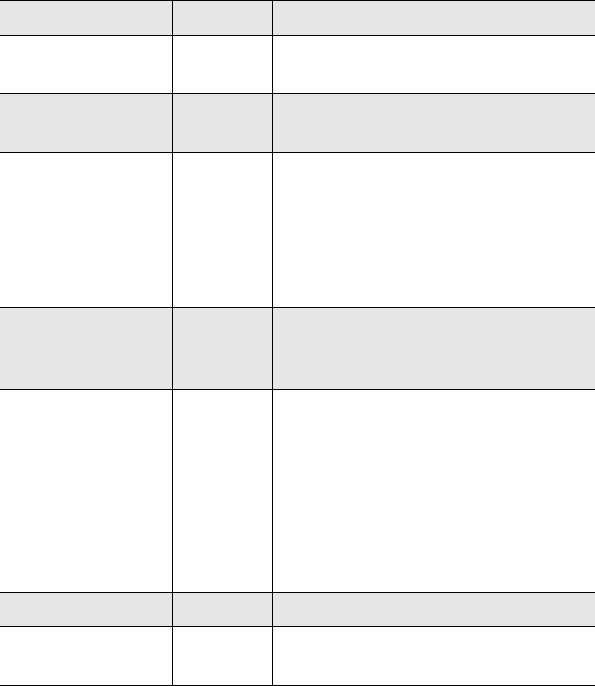
OpenText RightFax 10.0 Administrator’s Guide 282
Retrieving Faxes Via TeleConnect
When retrieving your faxes via TeleConnect you can choose to have
all new faxes that have not yet been viewed or printed sent to a
specified fax machine, or you can retrieve a specific fax by
specifying its TeleConnect ID number. A TeleConnect ID is
assigned to every outgoing and incoming fax processed by
RightFax. After a fax is assigned a TeleConnect ID, it keeps that ID
until it is deleted from the system.
Each fax’s TeleConnect ID is displayed when you receive
notification of the fax’s arrival. If you don’t know the TeleConnect ID
of the specific fax you want, the TeleConnect Main menu gives you
the option of retrieving a list of all faxes in your RightFax mailbox
along with their TeleConnect IDs.
To access your RightFax mailbox with TeleConnect
1. Dial the phone number that you specified in the Routing
Code/Channel Ext. box of the TeleConnect configuration (see
“Routing Code/Channel Ext” on page 276).
2. When the system prompts you, enter your RightFax voice mail
subscriber ID and press the pound key (#).
3. When the system prompts you, enter your RightFax password
and press the pound key (#).
If your RightFax password does not consist of numeric digits
only, you can enter alphanumeric characters by pressing the
keys on the telephone keypad that the characters are on. To
enter the word ‘PASSWORD’ the caller should enter
‘72779673’. Any digit will work for the letters Q and Z.
4. After TeleConnect validates your voice mail subscriber ID and
password, you will be placed in the main menu (described in the
next section).
MaxFaxes 32 The maximum number of faxes sent
out in one call by TeleConnect.
Multilingual False Multilingual support
enabled/disabled.
TransferSequence N/A PBX transfer sequence. If not blank,
TeleConnect transmits this
sequence just before hanging up. It
is a standard Brooktrout® sequence
(TP!F,;WU%1234567890ABCD).
39 characters max.
TUIReportPath TUILOG The path for TeleConnect reports. If
a relative path-spec, it will be
relative to the RFBoard folder.
VoicePath MainApp\
voices;
voices
The path(s) for voice prompt files.
One or more folders the system will
search to play a voice file. Folders
are separated with a semicolon. A
relative folder specification is
relative to the RFBoard folder. Any
recorded message will be recorded
to the first folder listed.
VoicePath0 N/A Language #0 voice folder(s).
VoicePath2 –
VoicePath9
N/A Language #2 voice folder(s) –
Language #9 voice folder(s).
Table 02 TeleConnect Registry Values (Continued)
Keyword Default Description
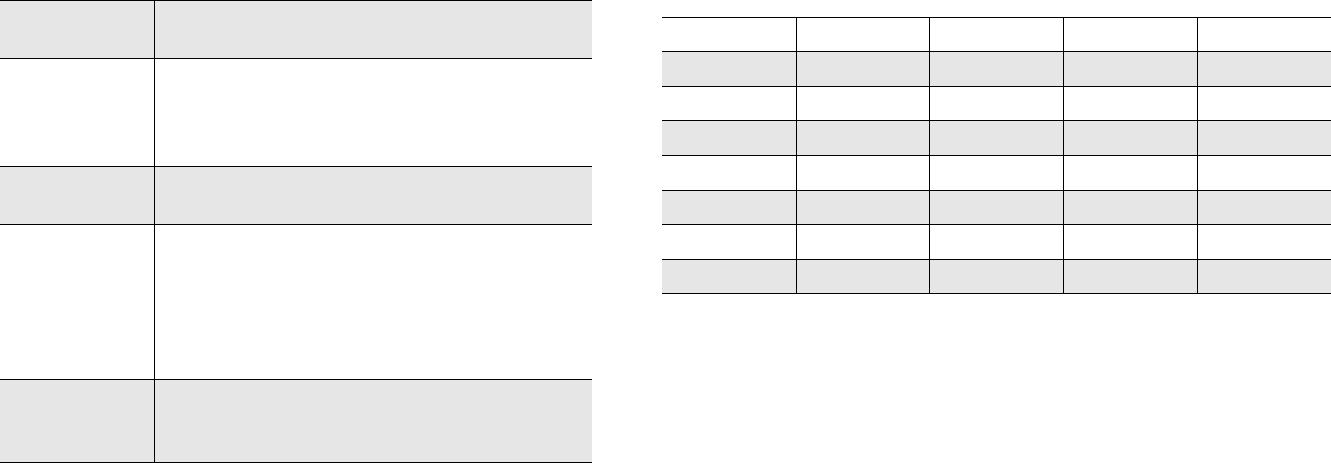
283
The TeleConnect main menu
The following table lists the options available from the TeleConnect
main menu. There may be additional prompts and messages
depending on your system’s configuration.
Although you can enable automatic forwarding, automatic printing,
and alternate notification via TeleConnect, you must first configure
the forwarding, printing, and notification destinations in your FaxUtil
mailbox.
Entering alphanumeric data via touch-tone phone
To enter an alphanumeric string (such as a recipient name for a
cover sheet), enter each character by pressing the button for the
character, then the position of the character on the button. For
example, the telephone button “6” has the letters M, N, and O. To
enter the letter “N”, you would press the “62” to indicate the
second character on the number 6 button. To enter a number
instead of a letter, use position zero. To enter a space, press “02”.
The exceptions to this method are the letters Q (“01”) and Z (“03).
The following table lists all characters available via this encoding
method.
The decoded sequence will be used in the To: field on the fax
cover sheet. You have 40 seconds to enter up to 60 digits, which
will decode to a maximum of 30 characters.
Table 30a TeleConnect Menu Options
Main menu
option Option/description
[1] Retrieve
Faxes
[1] Retrieve all new faxes
[2] Retrieve a list of all inbound and outbound
faxes
[3] Retrieve faxes by their TeleConnect ID
[2] Retrieve a
List of All Faxes
Retrieve a list of all inbound and outbound faxes
[3] Fax Mailbox
Statistics
[1] Outbound fax statistics, including total
outbound fax count, total fax pages sent, total
faxes sent successfully, total failed faxes, and total
faxes in process
[2] Inbound fax statistics, including total inbound
fax count, and total received fax pages
[4] Change Fax
Options
[1] Enable automatic fax forwarding
[2] Enable automatic printing
[3] Enable alternate notification
Table 30b Alphanumeric Touch-Tone Key Sequences
A = 21 I = 43 Q = 01 Y = 93 2 = 20
B = 22 J = 51 R = 72 Z = 03 3 = 30
C = 23 K = 52 S = 73 Space = 02 4 = 40
D = 31 L = 53 T = 81 + = 11 5 = 50
E = 32 M = 61 U = 82 - = 12 6 = 60
F = 33 N = 62 V = 83 . = 13 7 = 70
G = 41 O = 63 W = 91 0 = 00 8 = 80
H = 42 P = 71 X = 92 1 = 10 9 = 90
OpenText RightFax 10.0 Administrator’s Guide 284
285
Chapter 31
Backing Up and Maintaining
the RightFax Software and Database
RightFax stores all of its data, including information on faxes, users,
and dialing rules in a SQL database (although fax images are
stored separately as graphic files in the RightFax\Image folder).
This database may be installed directly on the RightFax server, or
can be installed on an existing SQL server. You select where the
SQL database is to be installed when you install the RightFax
server software.
The SQL Express server that is provided with RightFax includes all
of the SQL functionality required by the RightFax software.
However, this version of SQL does not include all of the tools and
administrative capabilities as the full version.
It is strongly recommended that you do not make any changes
directly to the RightFax SQL database. A complete schema of the
RightFax database can be viewed using SQL Administrator. An
image of the schema is also available in the Docs folder on
RightFax installation CD in the file RightFax Database Schema.pdf.
Changing the Connection to the SQL Server
RightFax creates and links to a SQL database during installation.
However, the SQL database connection can be modified if at any
time you need to make changes to your existing SQL installation.
To edit the SQL connection, you must change the connection
string in one of three places:
RightFax Server configuration
DocTransport configuration
RightFax Remoting service
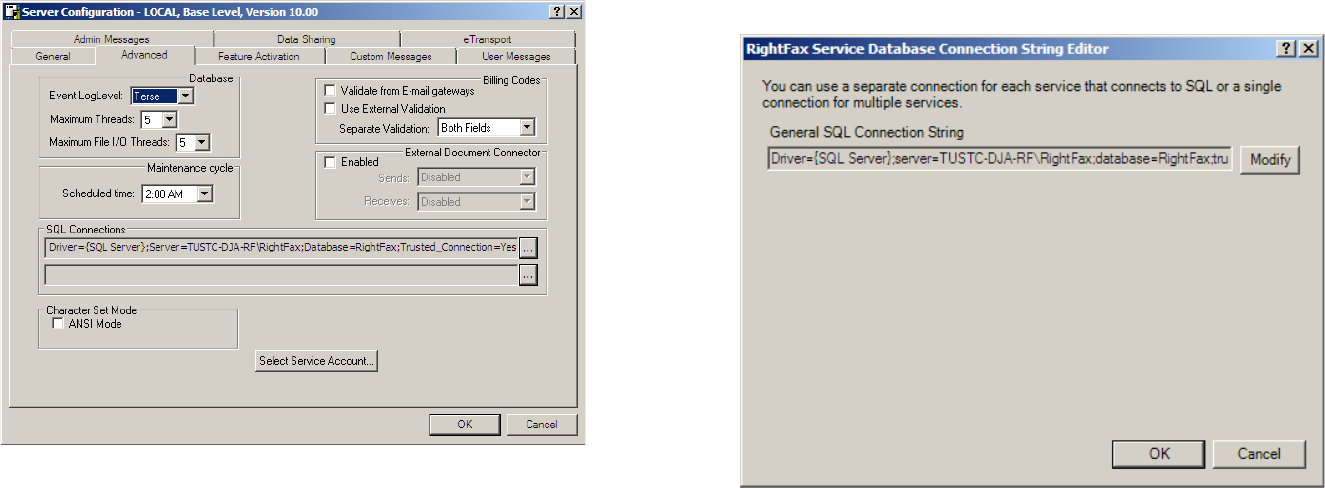
OpenText RightFax 10.0 Administrator’s Guide 286
To view your current SQL connection information, run the RightFax
Server program from Windows Control Panel and click the
Advanced tab. The SQL connection string is displayed in the SQL
Connection box.
Figure 31.1 The Server Configuration Advanced tab
Changing the SQL connection
The steps for changing the SQL connection are the same in all
three applications . Make sure that you set the same SQL
connection properties in all of these applications before making the
registry change described in the next section.
1. Open each application and locate the SQL connection string in
the SQL Connection box.
2. Click the [...] button to the right of this box. This opens the
RightFax Server Database Connection String Editor dialog
box.
Figure 31.2 RightFax Server Database Connection String Editor
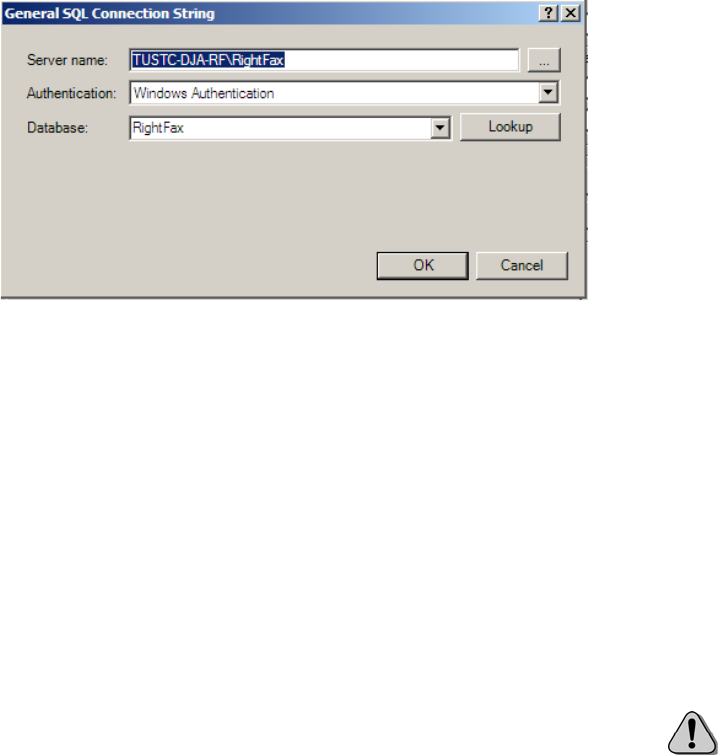
287
3. Click Modify to display the General SQL Connection String Editor.
Figure 31.3 RightFax General SQL Connection String Editor
4. Enter the Server name, choose the Authentication method, and
specify a databse type. Depending on the type of authentication
you choose, you may also need to enter a User Name and
Password.
5. Click OK to close the editor window and display the new string
in the SQL box.
6. Optional: Repeat steps 1 through 5 to enter connection string
information for a redundant SQL connection.
Backing Up and Restoring
the RightFax Server and Database
This section provides instructions for backing up and restoring the
RightFax server software and SQL database using Microsoft's
OSQL command-line utility. The OSQL utility is automatically
installed on your SQL server when you install either the full version
of SQL or the SQL Express database provided with the RightFax
server software. Backing up the server requires a separate backup
storage device or software utility. Open Text does not provide
support for third-party backup tools, so you should be familiar with
your organization's software backup tools and protocols before
scheduling regular backups.
Backing up and restoring the RightFax server
All of the RightFax server files can be backed up using any
standard disk or tape backup system. A complete backup of the
server can be performed at any time without shutting down the
server or stopping the RightFax services. However, to ensure that
your backup software does not cause any disruption or slowdown
of the RightFax server, you should schedule backups only at night
or during off-peak hours.
To back up the RightFax server software, back up the \RightFax
folder and all of its subfolders. Because several RightFax
configuration settings are stored in the Windows Registry, you
should also back up the following registry keys:
HKEY_CLASSES_ROOT\RightFax
HKEY_LOCAL_MACHINE\Software\RightFax
(64-bit: HKEY_LOCAL_MACHINE\Software\Wow6432Node\
RightFax)
HKEY_LOCAL_MACHINE\Software\RightFax Client
(64-bit: HKEY_LOCAL_MACHINE\Software\Wow6432Node\
RightFax Client)
Refer to the documentation for your backup software and/or
Microsoft Windows for information on scheduling and executing
periodic backups of your software and the registry, and for
information on restoring from the backup.
Caution Because licensed RightFax features are tied to the name of the
computer on which the software is installed, you must call OpenText
Customer Support for assistance if you restore the RightFax server to a
machine other than the one on which it was originally installed.

OpenText RightFax 10.0 Administrator’s Guide 288
Backing up the RightFax database
RightFax stores most of its data in a SQL database which is stored
and maintained separately from the core server software.
Depending on how the RightFax server software was installed, this
database may be on a separate SQL server on your network, or a
SQL Express database installed directly on the RightFax server
computer. To perform a backup of the RightFax database, you must
know where this database is installed, and you must have a user ID
and password with administrative access to the database.
Important If you have upgraded from MSDE to SQL Server 2005
Express, the MSDB database has not been upgraded. Consequently, you
may see error messages when attempting to run OSQL backup and
restore procedures. These errors are cosmetic and do not cause any loss
in functionality. For more information, see Microsoft Knowledge base
article 907284.
To back up the RightFax database using OSQL
1. Open a command prompt on the SQL server or on the RightFax
server if you are using SQL Express.
2. Navigate to C:\Program Files\Microsoft SQL Server\
MSSQL\Binn
3. Enter the command:
osql -UUserID -PPassword -HServerName
Where UserID is a SQL user ID with administrative access,
Password is the password for the specified user, and
ServerName is the machine name of the server where the
database is located. (When SQL is installed, the default user ID
is “sa” and the default password is blank.) Note that the
commands and parameters are case-sensitive.
4. On the command line that follows, enter the following command
set:
BACKUP DATABASE rightfax TO DISK =
‘C:\Backup\rightfax.bak’ [Enter}
go [Enter]
exit [Enter]
Where C:\Backup is the name of the folder where you want the
backup file to be stored. This can be a local folder or a folder on
any mapped drive on the network. The backup process may
take several minutes, depending on the size of the database.
Note that the commands and parameters are case-sensitive.
To create a batch file for automating the database backup
To automate the database backup at a scheduled time you can
create a batch file which will execute the OSQL backup command,
and then add the batch file to your Scheduled Tasks list in
Windows Control Panel.
Caution This batch file will overwrite any existing backup file in the
target folder without prompting for confirmation.
The batch file should contain only the following command:
osql -UUserID -PPassword -HServerName -Q“BACKUP
DATABASE rightfax TO DISK = 'C:\Backup\rightfax.bak’”
Where UserID is a SQL user ID with administrative access,
Password is the password for the specified user, ServerName is
the machine name of the server where the database is located, and
C:\Backup is the name of the folder where you want the backup
file to be stored. (When SQL is installed, the default user ID is “sa”
and the default password is blank.) Note that the commands and
parameters are case-sensitive.
Restoring the RightFax Database
Follow these steps to restore the RightFax database from a
backup:
289
1. Open a command prompt on the SQL server or on the RightFax
server if you are using SQL Express.
2. Navigate to C:\Program Files\Microsoft SQL Server\
MSSQL\Binn
3. Enter the command:
osql -UUserID -PPassword -HServerName
Where UserID is a SQL user ID with administrative access,
Password is the password for the specified user, and
ServerName is the machine name of the server where the
database is located. (When SQL is installed, the default user ID
is “sa” and the default password is blank.)
4. On the command lines that follow, enter this command set:
RESTORE DATABASE rightfax FROM DISK =
‘C:\Backup\rightfax.bak’ [Enter}
go [Enter]
exit [Enter]
Where C:\Backup is the name of the folder where the backup
file was stored. The restore process may take several minutes,
depending on the size of the database.
Purging Deleted Fax Records from the Database
RightFax stores records of all faxes, even if users have deleted the
faxes from their fax mailboxes. When a user deletes a fax the fax
record is saved and marked as belonging to a deleted fax. This is
how the fax server is able to run reports on fax activity even when
the fax images have been deleted.
Removing deleted fax records from the database is called
“purging.” To keep the fax database to a manageable size, RightFax
purges deleted fax records after a set length of time. The length of
time fax records of deleted faxes are saved before being purged
can be customized for each RightFax group.
To change the length of time RightFax keeps deleted fax
records
1. Run Enterprise Fax Manager and click Groups.
2. Select the group ID to modify.
3. Click the Basic Information tab.
4. In the Days to Keep Deleted Fax Records box, enter the
number of days to keep deleted fax records.
Purging Fax Records using DBPurge
DBPurge is database utility designed to purge fax records from the
RightFax database. These records are listed and explained below.
Faxes Deletes records of all faxes in the system
Deleted Faxes Deletes records of deleted faxes from the
database
Billing Codes Deletes Billing Code entries from the database
Work Requests Deletes queued Work Requests (notifications,
Conversion jobs, print jobs, retries) from the database
SQL Table Orphans Deletes orphaned records from the SQL
table.
Using DBPurge
1. Log in to the fax server as an administrator.
2. Open the \RightFax\Database folder and double-click
DbPurge.exe.
3. On the Open Server dialog, enter the RightFax server name
followed by your account name and password. This account
must have administrative access. You may also choose the box
to ‘Use NT Authentication’ is your RightFax account is linked to
the account you are logged into your network with. Click OK.
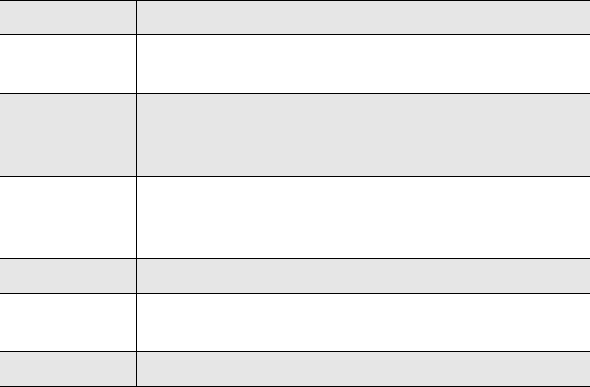
OpenText RightFax 10.0 Administrator’s Guide 290
4. On the left side of the DBPurge dialog, enter the records you
wish to purge.
5. Select the Preview button to view the total number of records
to be purged.
6. Click the Purge button to begin purging fax records.
7. Upon completion you can view a transaction log by clicking the
Log tab.
Purging Faxes from Users’ Fax Mailboxes
RightFax includes a feature called automatic fax aging that you can
use to delete fax images from users’ fax mailboxes after a certain
length of time. This can prevent older fax images from occupying
too much hard drive space on your server. Automatic fax aging is
only available if you have a RightFax Enterprise or Satellite server.
This feature is configured separately for each group (see “The
Automatic Fax Aging tab” on page 121). Individual users can be
excluded from automatic fax aging by checking the Excluded from
Group Fax Aging permission in their RightFax user profiles
(page 108).
Removing Orphaned Faxes
Orphan.exe searches the RightFax server for fax image files that do
not have any references in the RightFax database. The image files
are called “orphans” because RightFax has no record of their
existence and cannot access them. Using Orphan.exe, orphan
image files can be deleted from the server, or their records can be
restored in the RightFax database.
Orphan.exe is located in the RightFax\Database folder on the
RightFax server. The Database and RPC services must be running
when executing this utility.
Syntax orphan -fcomputer -i“path” -uuserID [-a] [-n] [-z]
Example
orphan -fjanescomputer -ic:\progra~1\rightfax\image
-ujanedoe -a
Supported Database Collation
The RightFax database supports only the SQL Language collation.
Case sensitivity, Accent sensitivity and Kana sensitivity
collations are not supported and may prevent RightFax services
from starting.
Table 31a Orphan.exe Command Line Options
Option Function
-a Restore all orphan image files to a specified
RightFax user. Requires the -f and -u options.
-fcomputer Specify the name of the RightFax computer that
contains the user ID that will be assigned the
recovered fax images.
-ipath Specify the full path to the RightFax\Image folder.
You must include the double-quotes around the
path.
-n Skip all prompts.
-uuserID Specify the RightFax user ID that will be assigned
the recovered fax images.
-z Erase orphan file images from the disk.

291
Appendix A
RightFax Embedded Codes
Embedded codes are special faxing instructions that you insert
directly into fax-bound documents. You can use embedded codes
to address faxes, include fax cover sheet information, attach library
documents, add billing information, insert your signature, and more.
To add an embedded code to a document, type the code you want,
along with any required parameters, between angle brackets. For
example, an embedded code that tells RightFax the destination fax
number is written as:
<TOFAXNUM:555-1212>
The fax server removes all embedded codes from a document
when it converts the document to fax form, so they don’t appear in
your final fax. Embedded codes can be written in either upper or
lower case. If you type an embedded code incorrectly, it will not
behave as expected and the embedded code text itself will appear
in your fax.
Embedded codes can be placed anywhere in the document that
you will be faxing, and can be used in any document that accepts
text characters. Embedded codes cannot line wrap and any
embedded code statement that is so long that it wraps to a second
line will be ignored.
Embedded codes that are followed by this envelope icon () are
compatible with RightFax email gateways.
Note If you send faxes via an SMTP gateway and plan to use
embedded codes, then you must select the Use PCL converter for text
files option in your email configuration.
ADDDOC
Format <ADDDOC:file>
Adds a file to the end of the fax. The specified file is not deleted
after conversion. This additional file can be in one of over 45 of the
most popular IBM and Macintosh native application file formats. If
you have licensed the RightFax PDF module, you can also attach
PostScript and PDF files. For a complete list of supported formats,
see Appendix B, “File Formats that Convert to Fax Format”.
Specify the complete file path, including file name, extension, drive,
and directory, and ensure that RightFax has access privileges. You
should use the UNC to specify the file location (instead of a drive
letter), because the mapping or drive links may be different on the
fax server and the computer where the fax originated.
Note: If the attachment is located on a client machine, ensure that the
client directory allows sharing so that the server can access the remote
file and copy it to the fax.

OpenText RightFax 10.0 Administrator’s Guide 292
More than one ADDDOC code can appear in a document. Each
file will be appended in the sequence that the embedded code
appears in the document.
Maximum field length: N/A.
Examples<adddoc:x:\bin\xyz.tif>
<adddoc:\\server8\sys\bin\xyz.tif>
ADDDOC2
Format <ADDDOC2:file>
Replaces the document containing this code with the specified file.
The original specified file is then deleted after it is faxed. This file
can be in one of over 45 of the most popular IBM and Macintosh
native application file formats. If you have licensed the RightFax
PDF module, you can also attach PostScript and PDF files. For a
complete list of supported formats, see Appendix B, “File Formats
that Convert to Fax Format”.
Specify the complete file path, including file name, extension, drive,
and directory. You should use the UNC to specify the file location
(instead of a drive letter), because the mapping or drive links may
be different on the fax server and the computer where the fax
originated.
Note: If the attachment is located on a client machine, ensure that the
client directory allows sharing so that the server can access the remote
file and copy it to the fax.
Maximum field length: N/A.
Examples<adddoc2:x:\bin\123.tif>
<adddoc2:\\server8\sys\bin\123.tif>
ADDDOC3
Format <ADDDOC3:file>
Adds another file to the end of the fax. The original specified file will
be deleted after conversion. This additional file can be in one of
over 45 of the most popular IBM and Macintosh native application
file formats. If you have licensed the RightFax PDF module, you can
also attach PostScript and PDF files. For a complete list of
supported formats, see Appendix B, “File Formats that Convert to
Fax Format”.
Specify the complete file path, including file name, extension, drive,
and directory. You should use the UNC to specify the file location
(instead of a drive letter), because the mapping or drive links may
be different on the fax server and the computer where the fax
originated.
Maximum field length: N/A.
Note: If the attachment is located on a client machine, ensure that the
client directory allows sharing so that the server can access the remote
file and copy it to the fax.
Examples<adddoc3:x:\bin\xyz.tif>
<adddoc3:\\server8\sys\bin\xyz.tif>
ADDDOC4
Format <ADDDOC4:file>
Replaces the document containing this code with the specified file.
This file can be in one of over 45 of the most popular IBM and
Macintosh native application file formats. If you have licensed the
RightFax PDF module, you can also attach PostScript and PDF
files. For a complete list of supported formats, see Appendix B,
“File Formats that Convert to Fax Format”.
Specify the complete file path, including file name, extension, drive,
and directory. You should use the UNC to specify the file location
(instead of a drive letter), because the mapping or drive links may
be different on the fax server and the computer where the fax
originated.

Appendix A RightFax Embedded Codes 293
Maximum field length: N/A.
Note: If the attachment is located on a client machine, ensure that the
client directory allows sharing so that the server can access the remote
file and copy it to the fax.
Examples<adddoc4:x:\bin\xyz.tif>
<adddoc4:\\server8\sys\bin\xyz.tif>
ATDATE
Format <ATDATE:date>
Schedules the fax to send on a specific date. Dates can be
expressed as relative or absolute. Relative dates give the number of
days from today’s date. For example, “+7” represents one week
from today. Absolute dates specify the exact date to send the fax.
Absolute dates must be written in one of these formats:
MM/DD/YY, MM-DD-YY, or MM-DD-YYYY.
If no send time is specified with the <ATTIME> code (page 293),
the send time defaults to “now” (the current time of processing).
For example, if a fax is sent to the queue at 3:30 p.m. and it
contains only an <ATDATE:+1> code, it will be scheduled to send
at 3:30 p.m. tomorrow.
Maximum field length: 10 characters
Examples<ATDATE:9-15-99>
<ATDATE:+2>
ATTI M E
Format <ATTIME:time>
Schedules the fax to send at a specific time. The time can be
relative or absolute.
Relative time is the number of hours or minutes from the current
time. For example, “+2” is two hours from now. You can enter
fractions of an hour in six-minute increments. Valid fractions of an
hour are 0.1 through 0.9. You must enter at least one digit before
and after the decimal point. For example, 1.5 and 0.3 are valid, and
1.50 and .3 are not valid.
Absolute time can be entered in 12-hour or 24-hour format. A colon
separating hours and minutes is optional, and an “a” or “p” can be
used to indicate A.M. or P.M. The fax server does not send the fax
at exactly the minute specified. Rather, the fax becomes eligible for
scheduling within 15 minutes of the specified time.
Specifying a time between the current time and midnight will
schedule the fax to send today. Specifying a time earlier than the
current time will schedule the fax tomorrow.
Maximum field length: 9 characters
Examples<ATTIME:10:00p>
<ATTIME:+2>
BILLINFO1
Format <BILLINFO1:code>
Assigns a billing code to the fax. If the RightFax administrator has
set up the system to require billing codes, you must enter a valid
billing code or the fax will not be sent.
Note: In order for a fax to be sent, embedded billing codes must comply
with the billing code verification rules as set on the RightFax server (see
“Requiring billing codes on received faxes” on page page 143). For
example, if “Verify Billing Codes” is enabled and requires both billing
codes, a document that embeds only BILLINFO1 would not be sent. You
would need to include both BILLINFO1 and BILLINFO2 to send the fax.
Maximum field length: 15 characters
Example <BILLINFO1:4444>
OpenText RightFax 10.0 Administrator’s Guide 294
BILLINFO2
Format <BILLINFO2:code>
Assigns a second billing code to the fax. If the RightFax
administrator has set up the system to require billing codes, you
must enter a valid billing code or the fax will not be sent.
Note: In order for a fax to be sent, embedded billing codes must comply
with the billing code verification rules as set on the RightFax server (see
“Requiring billing codes on received faxes” on page page 143). For
example, if “Verify Billing Codes” is enabled and requires both billing
codes, a document sent that embeds only BILLINFO2 would not be
sent. You would need to include both BILLINFO1 and BILLINFO2 to
send the fax.
Maximum field length: 15 characters
Example <BILLINFO2:5555>
BROADCAST
Format <BROADCAST>
Fine-tunes the server for sending fax broadcasts to multiple
recipients. Include this embedded code in the fax to eliminate
unnecessary server processes and increase the speed at which a
broadcast is sent. Using the <BROADCAST> code increases the
interval at which the server polls for and returns status information.
In addition, the server will not process requests for notification or
automatic printing of sent faxes. However, the server will still
automatically print failed faxes, if that option is selected.
Maximum field length: N/A.
CHANNEL
Format <CHANNEL:channel#>
Sends the fax only on the specified channel of the fax board. This
code is useful if your organization uses one channel for priority
faxing, and you want the fax to go out right away. You can also use
this code to limit fax broadcasts to one channel only, leaving the
other channels free for priority faxing.
Although your server’s first fax channel is listed as number 0 (zero)
in the RightFax BoardServer module, a value of 0 in this embedded
code indicates that the server should use any available channel. For
this reason, any channel you specify in this embedded code must
be numbered one higher than the channel as it is listed in the
BoardServer (i.e., specify <CHANNEL:5> to use channel 4 as
displayed in the RightFax BoardServer. The BoardServer’s channel
4 is actually the fifth channel since channels begin numbering at
zero.)
Maximum field length: N/A
Example <CHANNEL:3>
COMPLETEEVENT
Format <COMPLETEEVENT>
Enables complete events that can be serviced via the RightFax API.
The new events are useful when writing code to send the status of
the fax to a user, to a database, or to a host application.
Maximum field length: N/A.

Appendix A RightFax Embedded Codes 295
COVER
Format <COVER>
Generates a RightFax cover sheet for the fax containing the code. If
the user sending the fax containing this code is configured to
automatically generate a cover sheet, only one cover sheet will be
generated.
Unless a cover sheet file name is specified using the <FCSFILE>
embedded code (page 295), this code will use the default cover
sheet file.
Maximum field length: N/A
DELETE
Format <DELETE>
Deletes the fax from the user’s FaxUtil mailbox after it has been
successfully sent. This code overrides the default RightFax
auto-delete setting.
Note: If you’re using this code with mulitple fax recipients, the
<DELETE> code must precede the <NEWDEST> code for each
recipient. See “NEWDEST” on page 297.
Maximum field length: N/A
DELETEALL
Format <DELETEALL>
Deletes the fax from the user's FaxUtil mailbox after it has been
sent, whether or not the send was successful. This code overrides
the default RightFax auto-delete setting.
Maximum field length: N/A
DELETEFIRSTPAGE
Format <DELETEFIRSTPAGE>
Removes the first page of the fax. Use this code when you want to
put all production embedded codes on the first page of a
document, but not send that page to the recipient. This code is
typically used when it is easier to add a page to the front of a
document than to insert production embedded codes into the print
stream coming from the host.
Maximum field length: N/A.
DELETELASTPAGE
Format <DELETELASTPAGE>
Removes the last page of the fax. Use this code when you want to
put all production embedded codes on the last page of a
document, but not send that page to the recipient. This code is
typically used when it is easier to add a page to the end of a
document than to insert production embedded codes into the print
stream coming from the host.
Maximum field length: N/A.
FCSFILE
Format <FCSFILE:filename>
Uses the specified file as the RightFax-generated cover sheet. The
cover sheet file must exist in the RightFax\FCS folder on the
RightFax server and must end with the extension .pcl. Do not
specify a directory path.
Maximum field length: 12 characters
Example <FCSFILE:MYCOVER1.PCL>

OpenText RightFax 10.0 Administrator’s Guide 296
FINE
Format <FINE>
Converts the body of the fax using “fine” resolution (200 × 200
DPI). This is recommended only for faxes with detailed graphics or
faxes that will be OCRed. This code overrides the default fax
resolution set in the user’s FaxUtil mailbox.
Maximum field length: N/A
FORMTYPE
Format <FORMTYPE:formID>
Overlays the fax onto the specified RightFax form.
Maximum field length: 15 characters
Example <FORMTYPE:LETTERHEAD>
FROMFAXNUM
Format <FROMFAXNUM:faxnumber>
Specifies the sender’s fax number on the RightFax-generated fax
cover sheet. If no cover sheet is generated by RightFax, this code
will be ignored.
Maximum field length: 31 characters
Example <FROMFAXNUM:(520)555-1234>
FROMGENFAXNUM
Format <FROMGENFAXNUM:faxnumber>
Specifies the company’s general fax number to be placed on the
RightFax-generated fax cover sheet. If no cover sheet is generated
by RightFax, this code will be ignored.
Note: The PCL Coversheet code for this embedded code is
<GENERALFAXNUM>.
Maximum field length: 31 characters
Example <FROMGENFAXNUM:(520)555-2345>
FROMGENPHONE
Format <FROMGENPHONE:phonenumber>
Specifies the company’s general phone number to be placed on
the RightFax-generated fax cover sheet. If no cover sheet is
generated by RightFax, this code will be ignored.
Note: The PCL Coversheet code for this embedded code is
<OPERATORNUM>.
Maximum field length: 31 characters
Example <FROMGENPHONE:(520)555-3456>
FROMNAME
Format <FROMNAME:name>
Specifies the sender’s name to be placed on the
RightFax-generated fax cover sheet. If no cover sheet is generated
by RightFax, this code will be ignored.
Maximum field length: 59 characters
Example <FROMNAME:Jane Doe>
FROMPHONE
Format <FROMPHONE:phonenumber>
Specifies the sender’s phone number to be placed on the
RightFax-generated fax cover sheet. If no cover sheet is generated
by RightFax, this code will be ignored.
Maximum field length: 31 characters
Example <FROMPHONE:(520)555-4567>

Appendix A RightFax Embedded Codes 297
IGNORE
Format <IGNORE>
Causes all subsequent embedded codes to be ignored.
Maximum field length: N/A
LIBDOC
Format <LIBDOC:documentID>
Sends the specified RightFax library document instead of sending
the document containing the code. Multiple library documents can
be specified, each as a separate LIBDOC code.
Important When used with email gateways, this embedded code will
function exactly the same as LIBDOC2.
Maximum field length: 21 characters
Example <LIBDOC:INFOPACK1>
LIBDOC2
Format <LIBDOC2:documentID>
Sends the specified RightFax library document in addition to
sending the document containing the code. Multiple library
documents can be specified, each as a separate LIBDOC2 code.
Maximum field length: 21 characters
Example <LIBDOC2:INFOPACK1>
NEWDEST
Format <NEWDEST>
Tells RightFax that you want to send this fax document to multiple
recipients. The <NEWDEST> code must appear after each and
every destination, including the last one. The <NEWDEST> code
allows the following codes to be repeated in a document:
TONAME
TOFAXNUM
TOCONTACTNUM
TOCOMPANY
TOCITYSTATE
BILLINFO1
BILLINFO2
If <NEWDEST> is not used, only the last occurrence of any of
these embedded codes will take affect.
This code is not used to break one document into multiple faxes,
but rather faxes one entire document to multiple recipients.
Note: If you’re using this code with either the <SAVE> or <DELETE>
embedded codes, that code must precede the <NEWDEST> code for
each recipient. See “DELETE +” on page 295 or “SAVE +” on page 300.
Maximum field length: N/A
Example
<TONAME:JOHN><TOFAXNUM:555-1234><NEWDEST>
<TONAME:MARY><TOFAXNUM:230-5000><NEWDEST>
<TOFAXNUM:555-3006><SAVE><NEWDEST>
The above example will send the same fax to three different fax
numbers. The ones sent to John and Mary will use their default save
or delete preferences. The one sent to 555-3006 will override the
preferences and save the documents after being sent.
OpenText RightFax 10.0 Administrator’s Guide 298
NEWLIB
Format <NEWLIB:libdocID,description>
Automatically creates or updates a library document from the
document containing the code. Specify a new or existing library
document ID and description. If the specified document ID already
exists, that library document will be replaced. If no matching
document ID exists, a new library document will be created. The
newly created library document will automatically be assigned LAN
accessibility only.
Maximum field length: N/A.
Example <NEWLIB:novpricesheet,november_prices>
NEWLIB2
Format <NEWLIBW:libdocID,description,LFWC>
Automatically creates or updates a library document from the
document containing the code. Specify a new or existing library
document ID and description. If the specified document ID already
exists, that library document will be replaced. If no matching
document ID exists, a new library document will be created. In
addition, you can assign accessibility attributes for each document.
The library document will automatically be assigned accessibility
rights based on the following flags:
L = LAN
F = Fax on Demand
W = Web
C = Catalog
Maximum field length: N/A.
Example <NEWLIBW:novpricesheet,november_prices,LFWC>
NOBODY
Format <NOBODY>
Tells RightFax to send only the cover sheet, and not include a fax
body document. Any embedded codes in the document that are
not used for the production of the cover sheet will be ignored.
Maximum field length: N/A
NOCOMPLETEEVENT
Format <NOCOMPLETEEVENT>
Disables complete events. For more information, see
“COMPLETEEVENT” on page 294.
Maximum field length: N/A.
NOCOVER
Format <NOCOVER>
Turns off automatic RightFax cover sheet generation for the
document containing this code.
Maximum field length: N/A
NORMAL
Format <NORMAL>
Converts the body of the fax using “normal” resolution (200×100
DPI). Normal resolution faxes can be transmitted much faster than
fine resolution faxes, saving time and phone charges. This code
overrides the default fax resolution set in the user’s FaxUtil mailbox.
Maximum field length: N/A
NOSMARTRESUME
Format <NOSMARTRESUME>
Disables the Smart-resume feature.
Maximum field length: N/A
Appendix A RightFax Embedded Codes 299
NOTE
Format <NOTE:text>
Adds comments to your cover sheet. You can use as many as 21
<NOTE> codes in a single document if you want to enter multi-line
comments. The comments will not be reformatted or line wrapped
by RightFax.
Maximum field length: Up to 21 <NOTE> codes per document,
each code having up to 69 characters.
Example <NOTE:THE QUICK BROWN FOX JUMPS OVER
THE>
<NOTE:LAZY DOG.>
NOTIFY_ERROR
Format <NOTIFY_ERROR>
Notifies the sender when the fax is abandoned due to transmission
errors using the Notification Info setting in the user’s RightFax user
account.
Maximum field length: N/A
NOTIFY_OK
Format <NOTIFY_OK>
Notifies the sender upon successful transmission of the fax using
the Notification Info setting in the user’s RightFax user account.
Maximum field length: N/A
NOTIFY_RETRY
Format <NOTIFY_RETRY>
Notifies the sender when a transmission error is encountered and
the fax is being resent. This uses the Notification Info setting in the
user’s RightFax user account.
Maximum field length: N/A
PREVIEW
Format <PREVIEW>
Holds the fax for preview in your FaxUtil mailbox. You must view the
fax in FaxUtil and select Release from the File menu before it will
send.
Maximum field length: N/A
PRIORITY
Format <PRIORITY:priority>
Sets the priority of the outgoing fax. Allowed settings are: Low (L),
Normal (N), and High (H). If a user specifies high priority and does
not have the “Can use high priority” permission, the fax will be sent
with “normal” priority.
Maximum field length: N/A
Examples<PRIORITY:HIGH>
<PRIORITY:N>
<PRIORITY:LOW>
RETRYCOUNT
Format <RETRYCOUNT:#>
Specifies the number of times the fax will be retried after
encountering transmission errors (such as a busy signal or human
answered line). A value of 0 (zero) tells the fax server to use the
system defaults.
Maximum field length: 2 numeric digits
Example <RETRYCOUNT:3>

OpenText RightFax 10.0 Administrator’s Guide 300
RETRYINTERVAL
Format <RETRYINTERVAL:#>
Specifies the length of time in minutes between retry attempts
when transmission errors (such as a busy signal or human
answered line) are encountered.
Maximum field length: 2 numeric digits
Example <RETRYINTERVAL:2>
SAVE
Format <SAVE>
Instructs RightFax to not delete the fax image from the user’s
FaxUtil mailbox after being sent. This overrides any default
auto-delete setting.
Note: If you’re using this code with mulitple fax recipients, the <SAVE>
code must precede the <NEWDEST> code for each recipient. See
“NEWDEST” on page 297.
Maximum field length: N/A
SIGNATURE
Note Signature files are currently not supported in outbound PDF
documents.
Format <SIGNATURE:signatureID>
Specifies a signature image to place in the document. The
signature will be inserted into the document at the exact location of
the <SIGNATURE> embedded code. You can include an unlimited
number of <SIGNATURE> codes in each document. If you are not
listed as an authorized user of the signature file, the fax will be
failed by the fax server. For information on creating and using
signature files, see Chapter 11, “Creating Signatures”.
Maximum field length: 21 characters
Example <SIGNATURE:BOB>
SMARTRESUME
Format <SMARTRESUME>
Enables the Smart-resume feature.
Maximum field length: N/A
TOALTFAXNUM
Format <TOALTFAXNUM:faxnumber>
Specifies an alternate fax number that will be tried if the server is
unable to send the document to the primary fax number. This
number will not appear on the fax anywhere, it is only used if the
primary fax number fails. See “TOFAXNUM” on page 301.
Maximum field length: 31 characters
Example <TOALTFAXNUM:520-555-1212>
TOCITYSTATE
Format <TOCITYSTATE:city, state>
Specifies the fax recipient’s city and state information for display on
the cover sheet. This code can include not only the city and state of
the recipient, but the full street address as well.
Maximum field length: 59 characters
Example <TOCITYSTATE:TUCSON, AZ>
TOCOMPANY
Format <TOCOMPANY:company>
Specifies the fax recipient’s company name for display on the cover
sheet.
Maximum field length: 59 characters
Example <TOCOMPANY:ACME, INC.>
Appendix A RightFax Embedded Codes 301
TOCONTACTNUM
Format <TOCONTACTNUM:phonenumber>
Specifies the fax recipient’s voice number for display on the cover
sheet.
Maximum field length: 31 characters
Example <TOCONTACTNUM:520-555-1212>
TOFAXNUM
Format <TOFAXNUM:faxnumber>
Specifies the fax recipient’s fax number for dialing and also for
display on the cover sheet.
Maximum field length: 31 characters
Example <TOFAXNUM:520-555-1212>
TONAME
Format <TONAME:name>
Specifies the fax recipient’s name for display on the cover sheet. If
the name matches one of your individual or group RightFax
phonebook entries, RightFax uses the corresponding fax
addressing information to send the fax. To use an entry from
another user’s RightFax phonebook, use the syntax:
UserID!Entry
Only published entries of other RightFax users can be referenced
this way.
Maximum field length: 59 characters
Example <TONAME:JANE DOE>
UNIQUEID
Format <UNIQUEID:faxID>
Specifies a unique ID for the fax instead of having one automatically
generated by RightFax. Custom unique IDs can be used for
external document tracking systems.
Maximum field length: 15 characters
Example <UNIQUEID:XYZ120396>
OpenText RightFax 10.0 Administrator’s Guide 302
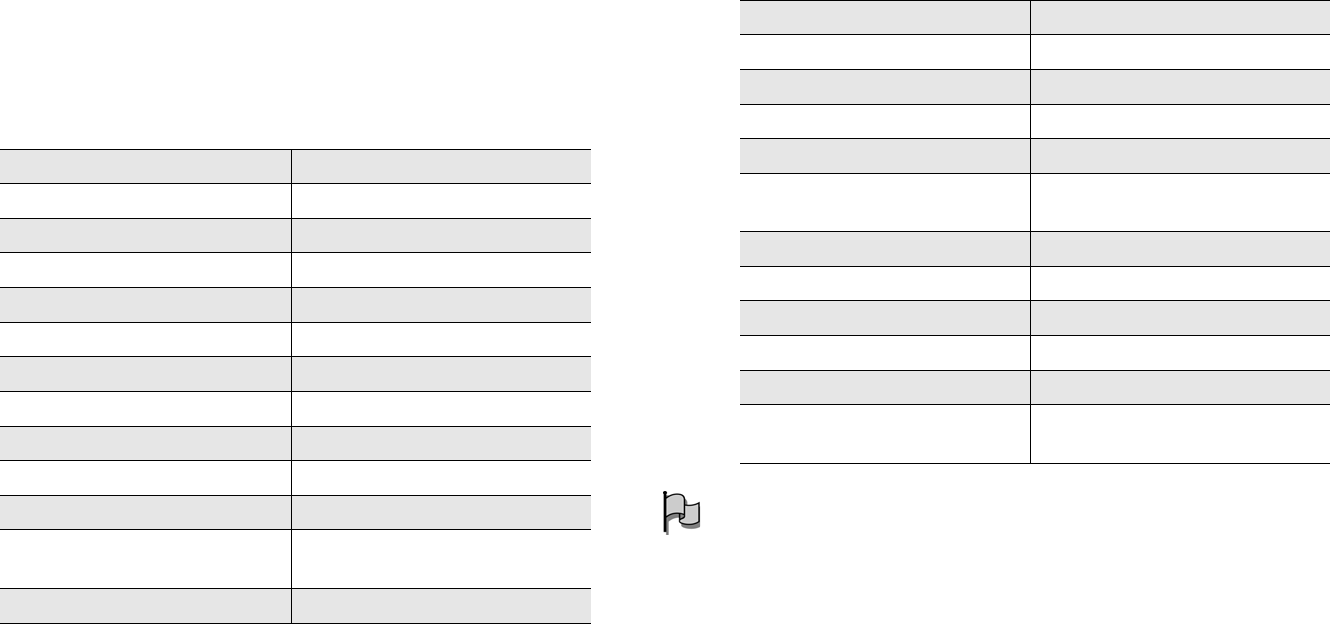
303
Appendix B
File Formats that Convert to Fax Format
The following table lists the software applications and document
file formats that can be converted to faxes by the built-in conversion
engine on the RightFax server. Only these file types can be
converted from their native format by sending as file attachments to
a fax message or by using the Send To function in Windows.
Important Conversion of PDF attachments and Postscript requires the
RightFax PDF Module.
Table B1 Supported Document File Formats
Application or file format Supported versions
ANSI text (7 & 8 bit) All versions
ASCII text (7 & 8 bit) All versions
BMP Windows versions
DCX (multi-page PCX) Microsoft Fax
EPS If TIFF image is embedded
GIF All versions
HTML Versions through 4.0
JPEG (includes EXIF) All versions
Microsoft Excel Versions 2000 through 2007
Microsoft PowerPoint Versions 2000 through 2007
Microsoft Rich Text Format
(RTF)
All versions
Microsoft Visio (.VSD files) 2000 through 2007
Microsoft Word 2000 through 2007
Microsoft WordPad All versions
Microsoft Works Versions through 8.0
PCX bitmap All versions
Portable Document Format (see
note below)
All versions
Post Script All versions
TIFF CCITT Group 3 & 4 All versions
Unicode Text All versions
UUEncode No specific version
UTF-8 No specific version
WordPerfect Graphics (WPG
and WPG2)
Versions through 2.0
Table B1 Supported Document File Formats (Continued)
Application or file format Supported versions
OpenText RightFax 10.0 Administrator’s Guide 304
305
Appendix C
Error and Status Messages
A new fax has arrived for (user ID) from remote ID:
(remote ID)
Another user has designated you to be their alternate for
notification and they have received a new fax.
A new fax has arrived for (user ID) which hasn’t been
viewed or printed
A member of the group for which you are the RightFax
administrator or alternate administrator has received a fax and has
not viewed or printed it within one hour of receipt.
A new fax has arrived from remote ID: (remote ID)
You have received a new fax. You will continue to be notified for one
hour (or other period specified by your administrator). If you do not
view or print the fax, your group’s administrator will be notified. If he
does not print the fax, your group’s alternate administrator will be
notified.
An outgoing fax is ready for previewing
The fax you requested be held for preview has been processed by
RightFax and is waiting in your FaxUtil mailbox. You must select
Release from the File menu to start the sending process.
Answer tone detected
RightFax could not connect with the remote (receiving) fax machine
due to communication errors between it and RightFax.
Bad FCS information
Incorrect information was entered on the cover sheet (via the Fax
Information screen or embedded codes).
Bad formtype
You have specified a form that does not exist or is corrupt in the Fax
Information screen or through embedded codes.
Bad phone number
You entered an incorrect or nonexistent fax phone number.
Bad signature code
The signature code is not recognized as a valid signature identifier
because it is corrupt or does not exist.
Call answered before one full ring
RightFax did not receive a normal length ring-back signal from the
phone company’s central office.
OpenText RightFax 10.0 Administrator’s Guide 306
Can’t access scans
RightFax can’t access the documents you scanned with the
scanner.
Carrier not detected
RightFax did not detect a dial tone when it tried to dial out.
Command time exceeded
This is a timing related error, possibly when the fax card waits for or
sends a command (T30 protocol handshaking commands) and
doesn’t get a response within a required period of time.
Command time too short
This is a timing related error, possibly when the fax card waits for or
sends a command (T30 protocol handshaking commands) and
doesn’t get a response within a given period of time.
Command timeout
This is a timing related error, possibly when the fax card waits for or
sends a command (T30 protocol handshaking commands) and
doesn’t get a response within a given period of time.
Communications line failure
The fax card was unable to make a valid connection with the
remote machine.
Conversion failed
RightFax was unable to convert your document to Group III format.
Dial failure or no dial tone
RightFax cannot detect a dial tone because there is a problem with
the phone line or the fax card is configured incorrectly.
Duplicate
The fax is a duplicate. It has been forwarded to you by another user.
Equipment busy tone detected
The remote (receiving) fax machine’s phone line is busy.
Fax blocked from dialing phone number
One or more dialing rules disallow sending faxes to the specified
phone number.
Fax discarded
RightFax deleted your fax job. Contact your administrator.
Fax number busy
RightFax has tried to send your fax the required number of times
(default=5 times) and each time the phone number was busy.
Fax to (name) abandoned, too many retries
RightFax will try to successfully send your fax a specified number of
times (determined by the administrator) then stop trying. The
default value is five tries.
Fax to (name), (error)
Your outgoing fax encountered the error listed. (See the error listed
for more information.)
FCS create failed
The cover sheet of your fax could not be created due to a corrupt or
incompatible cover sheet format.
Function not implemented
An operation was attempted that is not currently supported by your
fax card software.
Appendix C Error and Status Messages 307
G2 fax machine
You have attempted to send a fax to a Group II machine, rather than
a Group III machine.
Held for preview
You have specified in the Fax Information screen or through
embedded codes that you want to preview this fax before sending
it. You must select Release from the File menu in FaxUtil to start the
sending process.
Human answered
RightFax detected an unknown sound after it dialed the fax number.
The unknown sound could be a human voice, recording, or line
noise.
Illegal line number
You have attempted to send a fax on a fax channel that does not
exist.
Illegal option in call
This error could occur if an invalid parameter is given for one of
several different commands, including: LOG, DEBUG, XFER,
SEND.
Illegal parameter value
This error could occur if an invalid parameter is given for one of
several different commands, including: LOG, DEBUG, XFER,
SEND.
Illegal sig. use
You have included a signature in your fax that you are not
authorized to use.
Imaging error encountered, fax abandoned
RightFax was unable to convert your document to Group III format
for transmission.
In conversion
RightFax is converting your document to fax format for
transmission.
In validation
The signature and/or billing codes in your fax are being validated
against the RightFax database.
Info not complete
You have not completed all the required fields (in the Fax Information
screen or through embedded codes) for RightFax to send the fax.
Initial processing
RightFax is checking your document for embedded codes and
counting the number of pages in your fax.
Invalid billing code
You have entered a billing code that is incorrect or does not exist.
Invalid embedded code
You have included a misspelled or nonexistent embedded code in
your fax.
Line in use
RightFax was not able to send your fax because there were no
outgoing phone lines available.
OpenText RightFax 10.0 Administrator’s Guide 308
Loop current detected
When RightFax attempts to go off-hook to send a fax, it finds that
the phone is already off-hook. This can occur when two devices are
sharing a phone line and attempt to use it at the same time. It might
also be a fax card configuration error.
Loop current failed
The fax card did detect current on the line, but did not detect a
valid value for Loop Current.
Loop current not detected
The fax card was looking for Loop Current before it attempted to
dial the fax number, but didn’t find any.
Network congestion detected
The network may be running inefficiently and causing traffic, or an
invalid fax number may have been dialed.
Network high and dry (no ring)
The fax card does not detect any type of telephone interface
available. This is a very serious error. Contact your RightFax
administrator immediately.
No answer at fax #
The fax machine at the receiving end didn’t answer or a wrong
number was dialed.
No answer tone detected
The phone is ringing at the destination, but the fax machine is not
answering within the specified time. This is especially prevalent in
international calling when it can take up to a minute to connect to
the remote station.
Non-G3 modem detected
RightFax has detected a non-Group III fax modem on the remote
(receiving) fax machine, and cannot communicate with it.
OCR error
An error occurred while a document was being sent to or was at
the Optical Character Recognition module of RightFax.
OCR in process
Your fax has been queued and is being processed by the OCR
module.
OK
RightFax has successfully sent your fax over the phone lines. This
does not guarantee successful receipt of the fax at its destination.
One of your outgoing faxes needs attention
You have not completed all the required fields in the Fax Information
screen or through embedded codes for the fax to be sent.
P2 was not detected at the end of training
This is a training error indicating a performance problem with the
fax server and the number of fax cards that it contains.
Phone line problems
There is a problem with the phone lines at the fax server.
Poor quality
There was too much line noise for the fax to be transmitted
correctly. The fax may have been sent, but it may be difficult to read.
Printing
Your fax is printing.
Appendix C Error and Status Messages 309
Printing error
An error occurred while printing.
Protocol reject message
This is a generic protocol error code that could have several
meanings. In general, your fax card is having difficulty talking to the
remote fax machine because it is getting the signals it expected.
Protocol timeout
This is a generic protocol error code that could have several
meanings. In general, your fax card is having difficulty talking to the
remote fax machine because it is not getting the signals it expected
in the appropriate time frame.
Queued for OCR
The fax has been queued and is waiting for the OCR module to
convert it.
Queued for printing
The fax has been queued and is waiting to be printed.
Ringback signal detected
A ring-back signal was detected when it should not have been. This
may be due to interrupting a call in process on a shared line, or
could be caused by a lot of noise on a T1 phone line.
Ringback, but no answer tone
The phone rang at the destination, but it was never answered. This
might be because the receiving fax machine is off-line or unable to
receive faxes.
Ringback, then busy condition
The fax number dialed went off-hook and then went on-hook very
quickly, generating a fast busy signal.
Scheduled for send
Your fax was successfully converted to the RightFax Group III
format and is now being sent to the fax card to await sending. If you
specified a date and time to send the fax, RightFax will wait to send
it until then.
Scheduling failed
Your fax was converted correctly, but it couldn’t be correctly
queued to be sent.
Sending
RightFax is transmitting your fax.
Sending fax to (name) at (faxnumber)
Your fax is being sent to the name and fax number specified.
Sig needs authorization
You must be authorized to use the signature you have included in
your fax.
Thermal record
You have recorded a fax that was sent or received on a
conventional fax machine for database purposes only.
Training algorithm detected FSK
This training error indicates a performance problem with the fax
server and the number of fax cards it contains.
OpenText RightFax 10.0 Administrator’s Guide 310
Training algorithm found on PN
This training error indicates a performance problem with the fax
server and the number of fax cards it contains.
Tx/Rx error
This transmission/reception error indicates that the receiving fax
machine was experiencing difficulties or excessive line noise.
Unknown error
An error condition reported to RightFax from another device is not
supported or not recognized.
Unknown error code
An error condition reported to RightFax from another device is not
supported or not recognized.
Unknown status code
An unknown status code has been returned to RightFax from your
fax card.
Voice response to call
RightFax detected a sound that it didn’t expect after it dialed the fax
number. The sound could be a human voice, recording, or line
noise.
Waiting for conversion
RightFax is busy with another process and has queued your fax to
be converted.
Waiting to be sent
The fax has not yet been scheduled for faxing.
Your fax has been successfully sent to (name) at
(faxnumber)
Your fax was successfully sent over the phone lines. This does not
guarantee successful receipt of the fax at its destination.
Your outgoing fax contains an invalid billing code
You have either not entered a required billing code, or entered one
that does not exist.
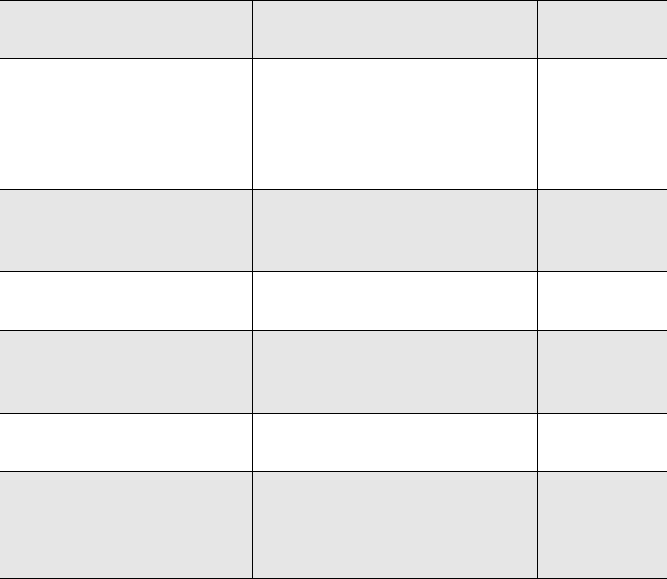
311
Appendix D
Alerting and Monitoring Statistics
The RightFax Alerting and Monitoring service (described in Chapter
18, “Using the Alerting and Monitoring Service”) lets you monitor
and receive alerts about several statistics relating to your RightFax
server. These statistics are divided into categories (described in
“Editing Alert Properties” on page 171). This appendix lists each
category (specified in the Category box on the Alert Properties
dialog box), and the statistics you can select for each category
(specified in the Statistics to monitor box on the Alert Properties
dialog box).
Each category is listed below with its corresponding statistics,
including the definition of each statistic and whether an alert can be
generated for that statistic. The statistic categories listed in this
appendix are:
“Fax Server Statistics” (page 311)
“Database Statistics” (page 312)
“Workserver Statistics” (page 314)
“Gateway Statistics” (page 315)
“Local BoardServer Statistics” (page 316)
“All BoardServers Statistics” (page 319)
“RPC Server Statistics” (page 320)
“Paging Server Statistics” (page 321)
“Local Document Transport Server Statistics” (page 322)
Fax Server Statistics
Table D1 Statistics available for the Fax Server category
Statistic Description
Can trigger
alert
Newest activity index The total number of activities
since the RightFax Server
module was last started.
Activities can be viewed using
FaxStat.exe.
No
Information version A version number indicating the
level of information being
displayed for the fax server.
No
Time running The length of time since the Fax
Server service was last started.
No
Maximum events in queue The current maximum size of
the event queue (described on
page 35).
No
Events in queue The number of events waiting to
be processed by the fax server.
No
Events processed The total number of events
processed by the fax server
since the Fax Server module
was started.
No
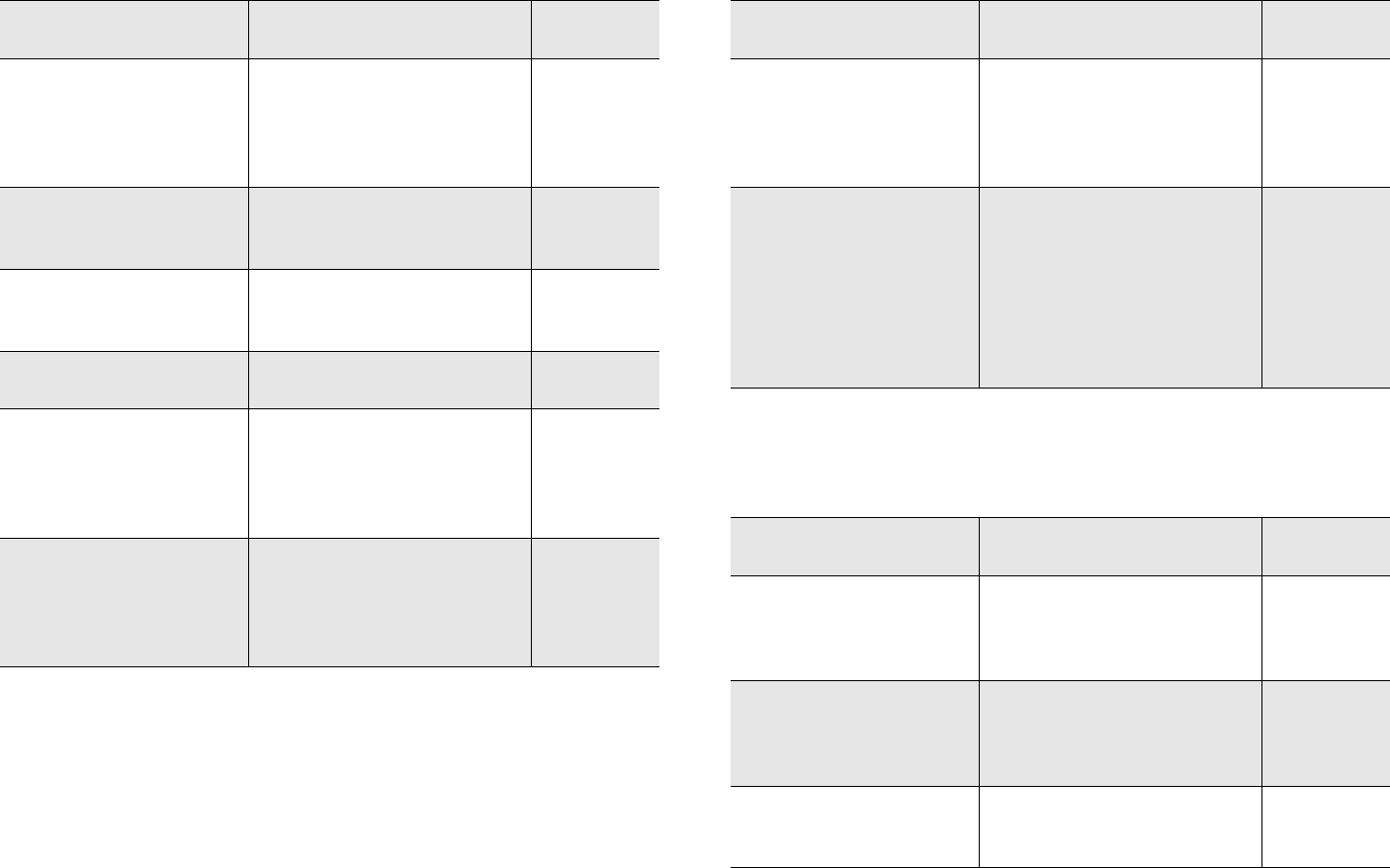
OpenText RightFax 10.0 Administrator’s Guide 312
Database Statistics
Number of activity records The total number of activity
records currently stored by the
RightFax Server module.
Activities can be viewed using
FaxStat.exe.
No
Percentage of disk space
available on image drive
The percentage of free drive
space on the drive used for
storing fax images,
Yes
Percentage of disk space
available on database drive
The percentage of free drive
space on the drive used for
storing the RightFax database,
Yes
Activity The time and description of the
specified activity number.
No
Total timed events by type Total number of timed events in
the Fax Server event queue
(described on page 35).
Specify the type of timed event
in the Event Timer box.
No
Ticks remaining by type Time remaining before the Fax
Server module fires a specified
timed event. Specify the type of
timed event in the Event Timer
box.
No
Table D1 Statistics available for the Fax Server category (Continued)
Statistic Description
Can trigger
alert
Frequency of timed events
by type
The frequency with which a
timed event will be fired,
measured in ticks. Specify the
type of timed event in the Event
Timer box.
No
Current frequency relative
to original as percentage
For events whose timing is
dynamically scalable depending
on fax server activity, this is the
current frequency measured as
a percentage of the normal
frequency. Specify the type of
timed event in the Event Timer
box.
No
Table D2 Statistics available for the Database category
Statistic Description
Can trigger
alert
Information version A version number indicating the
level of information being
displayed for the RightFax
database.
No
Number of database
threads
Total number of threads that the
Database module has
managing database queries
and changes.
No
Number of file I/O threads Total number of threads that the
Database module has
managing files.
No
Table D1 Statistics available for the Fax Server category (Continued)
Statistic Description
Can trigger
alert
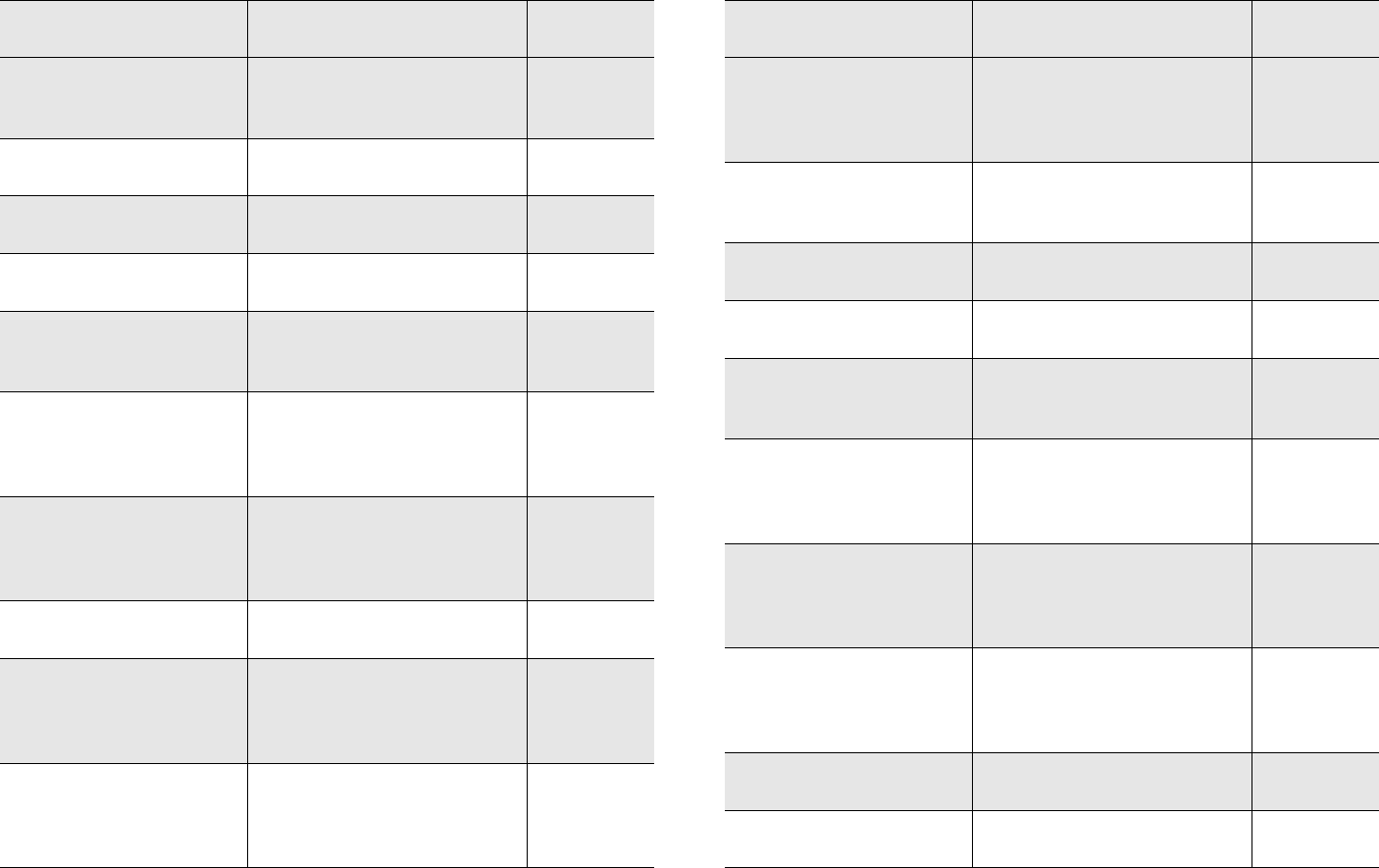
Appendix D Alerting and Monitoring Statistics 313
Time running The length of time since the
Database service was last
started.
No
Database server thread info This statistic is reserved for
future use.
No
File I/O thread info This statistic is reserved for
future use.
No
Current Database
operation
The current database activity by
thread.
No
Last Database command Last RightFax API command
performed on the database by
thread.
No
Number of Database read
failures
The total number of errors that
have occurred during the read
process since the Database
module was last started.
Yes
Number of Database write
failures
The total number of errors that
have occurred during the write
process since the Database
module was last started.
Yes
Client Database I/O type This statistic is reserved for
future use.
No
Total Database bytes read The total number of bytes read
from the database since the
Database module was last
started.
No
Total Database bytes
written
The total number of bytes
written to the database since
the Database module was last
started.
No
Table D2 Statistics available for the Database category (Continued)
Statistic Description
Can trigger
alert
Total Database commands
processed
Total number of API commands
performed by the database
since the Database module
was last started.
No
Time last Database
command took
The length of time for the last
database command to be
processed.
Yes
User ID of last Database
command
The NT user account used for
the last database command.
No
Current File I/O operation The current file activity by
thread.
No
Last File I/O command The last file I/O API command
performed on the database by
thread.
No
Number of File I/O open
failures
The total number of failed file
open commands by thread
since the database module was
started
Yes
Number of File I/O read
failures
The total number of failed file
read commands by thread
since the database module was
started
Yes
Number of File I/O write
failures
The total number of failed file
write commands by thread
since the database module was
started
Yes
Client File I/O type This statistic is reserved for
future use.
No
Total File I /O bytes read The total number of bytes read
from files by thread
No
Table D2 Statistics available for the Database category (Continued)
Statistic Description
Can trigger
alert
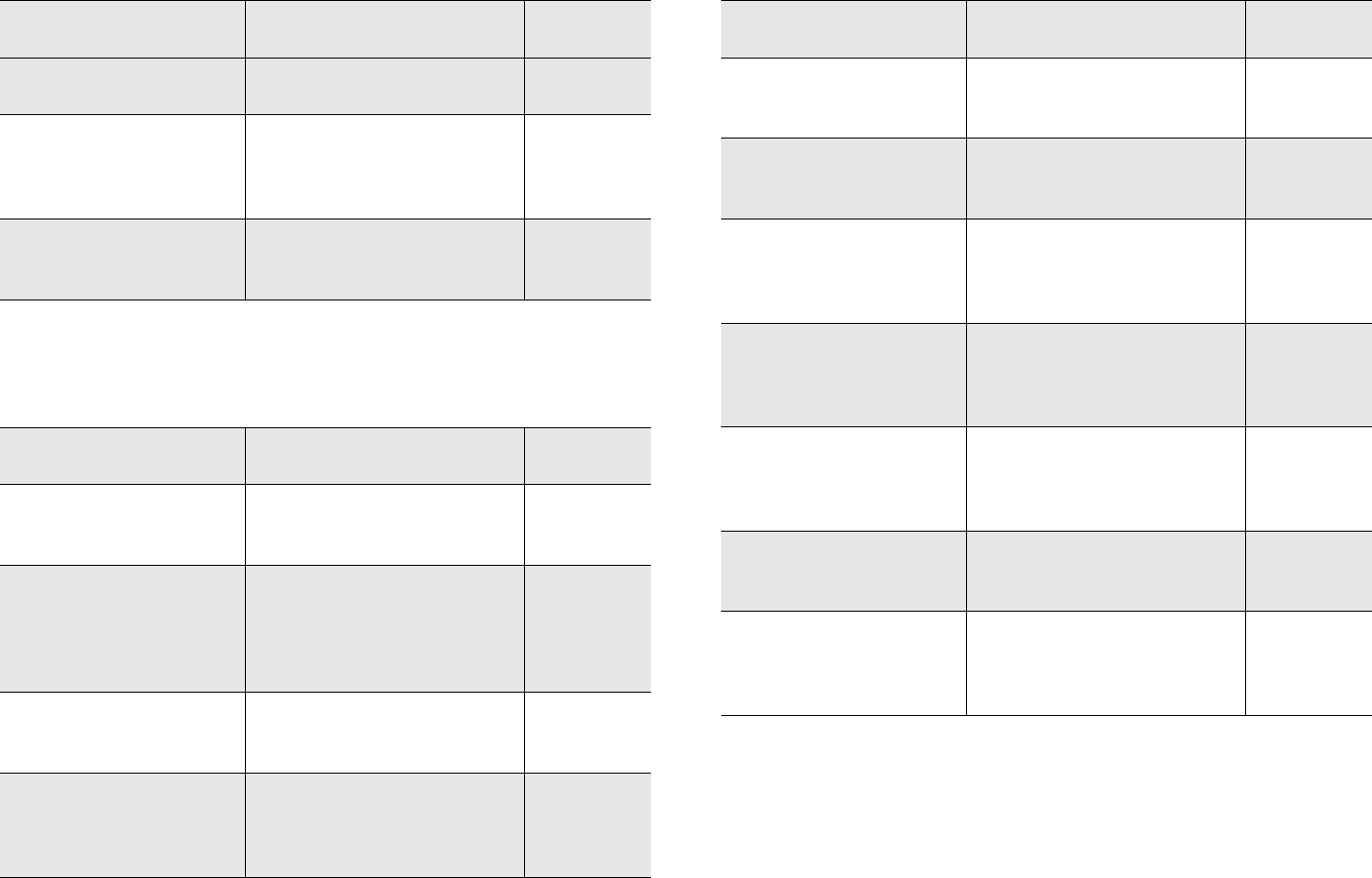
OpenText RightFax 10.0 Administrator’s Guide 314
Workserver Statistics
Total File I/O bytes written The total number of bytes
written to files by thread
No
Total File I/O commands
processed
The total number of API
commands performed for file
I/O since the Database module
was last started.
No
Time last File I/O command
took
The length of time for the last
file I/O command to be
processed.
Yes
Table D3 Statistics available for the WorkServer category
Statistic Description
Can trigger
alert
Information version A version number indicating the
level of information being
displayed for the WorkServer.
No
Newest activity index The total number of activities
since the RightFax WorkServer
module was last started.
Activities can be viewed using
FaxStat.exe.
No
Archival requests
processed
The total number of fax archive
functions since the WorkServer
module was started.
No
Conversion requests
processed
The total number of fax
conversions since the
WorkServer module was
started.
No
Table D2 Statistics available for the Database category (Continued)
Statistic Description
Can trigger
alert
CVL conversion requests
processed
The total number of CVL things
since the WorkServer module
was started.
No
Delete requests processed The total number of deleted
faxes since the WorkServer
module was started.
No
File route requests
processed
The total number of faxes
routed to network directories
since the WorkServer module
was started.
No
OCR requests processed The total number of faxes that
have been converted to text
since the WorkServer module
was started.
No
Overlay requests
processed
The total number of overlay
forms generated since the
WorkServer module was
started.
No
Print requests processed The total number of printed
faxes since the WorkServer
module was started.
No
Postscript conversion
requests processed
The total number of fax
conversion using Postscript
since the WorkServer module
was started.
No
Table D3 Statistics available for the WorkServer category (Continued)
Statistic Description
Can trigger
alert
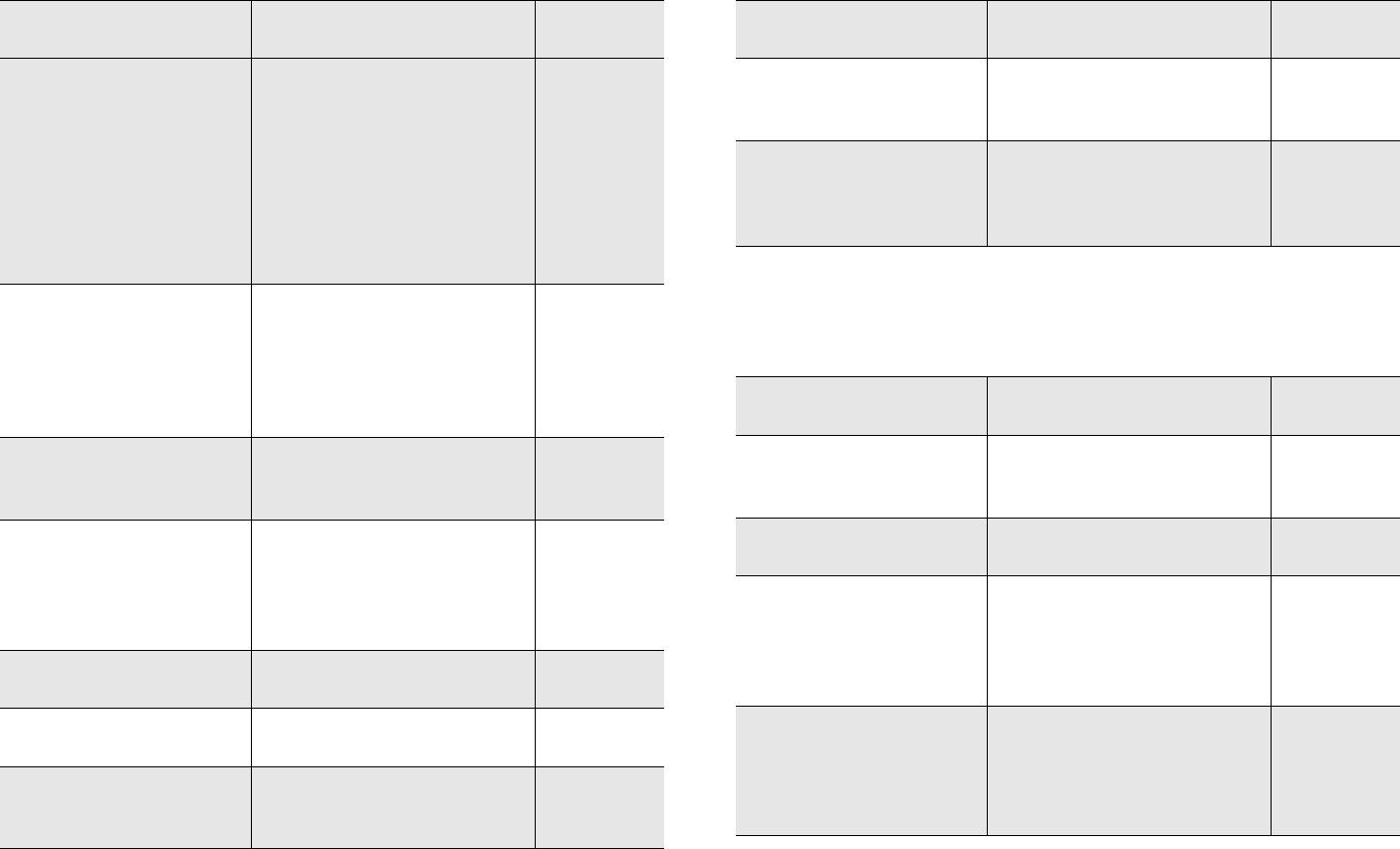
Appendix D Alerting and Monitoring Statistics 315
Gateway Statistics
Network broadcast
requests processed
The total number of network
messaging events using
Postscript since the
WorkServer module was
started. Note that Network
Broadcasts is no longer
functional with any of the
currently supported Windows
operating systems.
No
InterConnect requests
processed
The total number of faxes
routed to other RightFax
servers on the network via
InterConnect since the
WorkServer module was
started.
No
Time running The length of time since the
WorkServer service was last
started.
No
Activity records The total number of activity
records currently stored by the
RightFax WorkServer module.
Activities can be viewed using
FaxStat.exe.
No
Last request The last work request
processed by the WorkServer
No
Time for last command The length of time required to
complete the last command
Yes
Queues being serviced The services that are being
managed by the selected
WorkServer.
No
Table D3 Statistics available for the WorkServer category (Continued)
Statistic Description
Can trigger
alert
Activity The time and description of the
specified WorkServer activity
number.
No
Time spent on current
command
The length of time that the
WorkServer has spent
processing the current
command
Yes
Table D4 Statistics available for the Gateway category
Statistic Description
Can trigger
alert
Information version A version number indicating the
level of information being
displayed for the gateway.
No
Gateway type The type of email system that
the gateway supports.
No
Newest activity index The total number of activities
since the RightFax Gateway
module was last started.
Activities can be viewed using
FaxStat.exe.
No
Activity records The total number of activity
records currently stored by the
RightFax Gateway module.
Activities can be viewed using
FaxStat.exe.
No
Table D3 Statistics available for the WorkServer category (Continued)
Statistic Description
Can trigger
alert
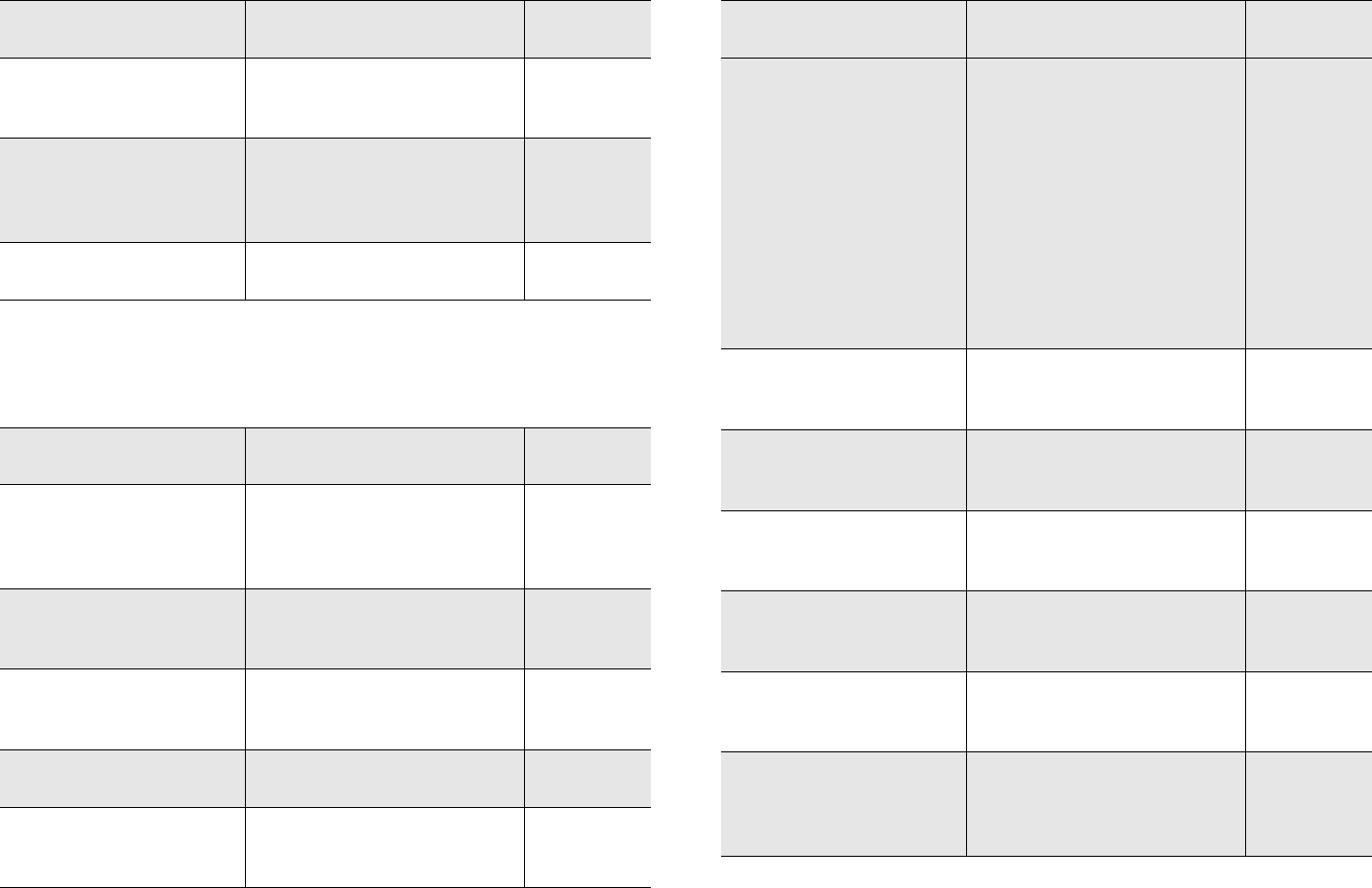
OpenText RightFax 10.0 Administrator’s Guide 316
Local BoardServer Statistics
Time running The length of time since the
Email Gateway service was last
started.
No
Events processed The total number of events
processed by the fax server
since the Gateway module was
started.
No
Activity The time and description of the
specified activity number.
No
Table D5 Statistics available for the Local BoardServer category
Statistic Description
Can trigger
alert
Information version A version number indicating the
level of information being
displayed for the local
BoardServer.
No
Time running The length of time since the
local BoardServer service was
last started.
No
Num channels Total number of fax channels
supported by the local
BoardServer.
No
Send queue depth Total number of faxes currently
waiting to be transmitted.
Yes
Send pages depth Total number of fax pages
currently waiting to be
transmitted.
Yes
Table D4 Statistics available for the Gateway category (Continued)
Statistic Description
Can trigger
alert
Availability index The relative availability of the
server’s fax boards. The higher
the number, the more available
the server for sending faxes.
RightFax uses this value when
an outgoing fax number has two
equally weighted dialing rules
that send it to two different
servers. In such a case,
RightFax sends the fax via the
server with the highest
availability index.
Yes
Channel type Displays whether the specified
channel uses a loop-start or
DID line.
No
Capabilities Displays whether the specified
channel is set to send faxes,
receive faxes, or both.
No
Routing code The routing code of the fax
currently being received on the
specified channel.
No
State The current sending or
receiving state of the specified
channel.
No
Current page The page number of the fax
currently being sent or received
on the specified channel.
No
Total pages sent The total number of fax pages
sent on the specified channel
since the BoardServer was last
started.
No
Table D5 Statistics available for the Local BoardServer category (Continued)
Statistic Description
Can trigger
alert
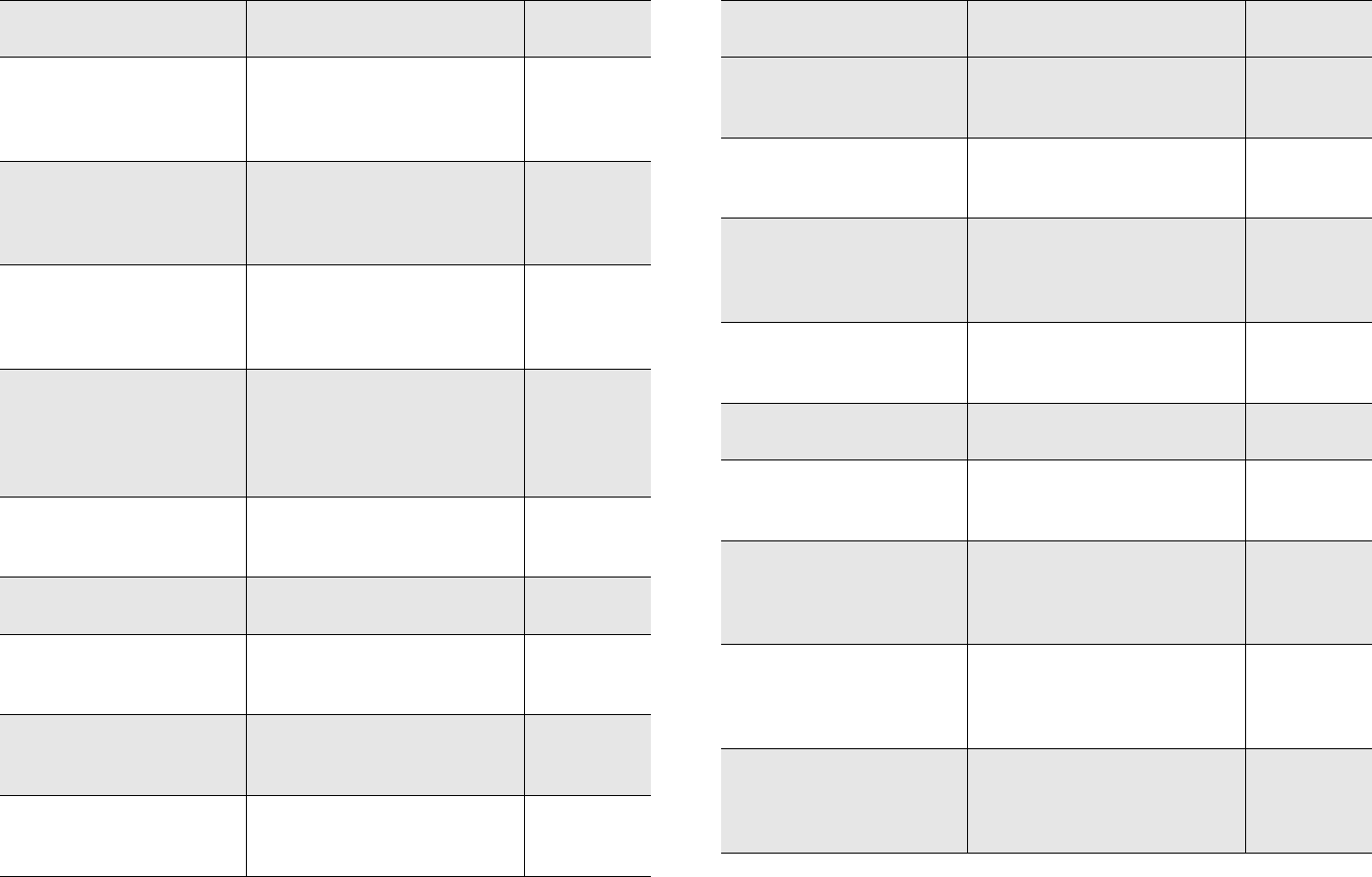
Appendix D Alerting and Monitoring Statistics 317
Total pages received The total number of fax pages
received by the specified
channel since the BoardServer
was last started.
No
Total calls answered The total number of incoming
calls picked up by the specified
channel since the BoardServer
was last started.
No
Total calls placed The total number of outgoing
calls placed by the specified
channel since the BoardServer
was last started.
No
Total hang ups The total number of incoming
calls on the specified channel
that received a transmission
error due to hang up since the
BoardServer was last started.
No
ROM ID The ROM ID of the fax board
used by the specified fax
channel.
No
Current remote ID The remote ID of the currently
sending or receiving phone line.
No
Is currently sending Indicates whether the specified
fax channel is currently sending
a fax.
No
Is currently doing
TeleConnect
Indicates whether the specified
fax channel is currently doing
TeleConnect.
No
Is currently receiving Indicates whether the specified
fax channel is currently
receiving a fax.
No
Table D5 Statistics available for the Local BoardServer category (Continued)
Statistic Description
Can trigger
alert
Is currently doing Docs on
Demand
Indicates whether the specified
fax channel is currently doing
Docs-on-Demand.
No
Group threshold left The number of fax pages
remaining before a fax grouping
will be sent.
No
Group faxes The current number of faxes
that are grouped for sending
but have not yet reached the
required number of pages.
No
Pages in call Specifies the total number of
fax pages queued to be sent
during the current call.
No
Current rate Specifies the transmission
baud rate of the current call.
No
Current compression Specifies the data compression
type being used for the
currently sent or received fax.
No
Estimated minutes left The estimated number of
minutes remaining for the
specified channel to send the
current fax.
No
Send info phone number The sending phone number
associated with the outbound
fax currently being sent by the
specified channel.
No
Send info user ID The RightFax user ID
associated with the outbound
fax currently being sent by the
specified channel.
No
Table D5 Statistics available for the Local BoardServer category (Continued)
Statistic Description
Can trigger
alert
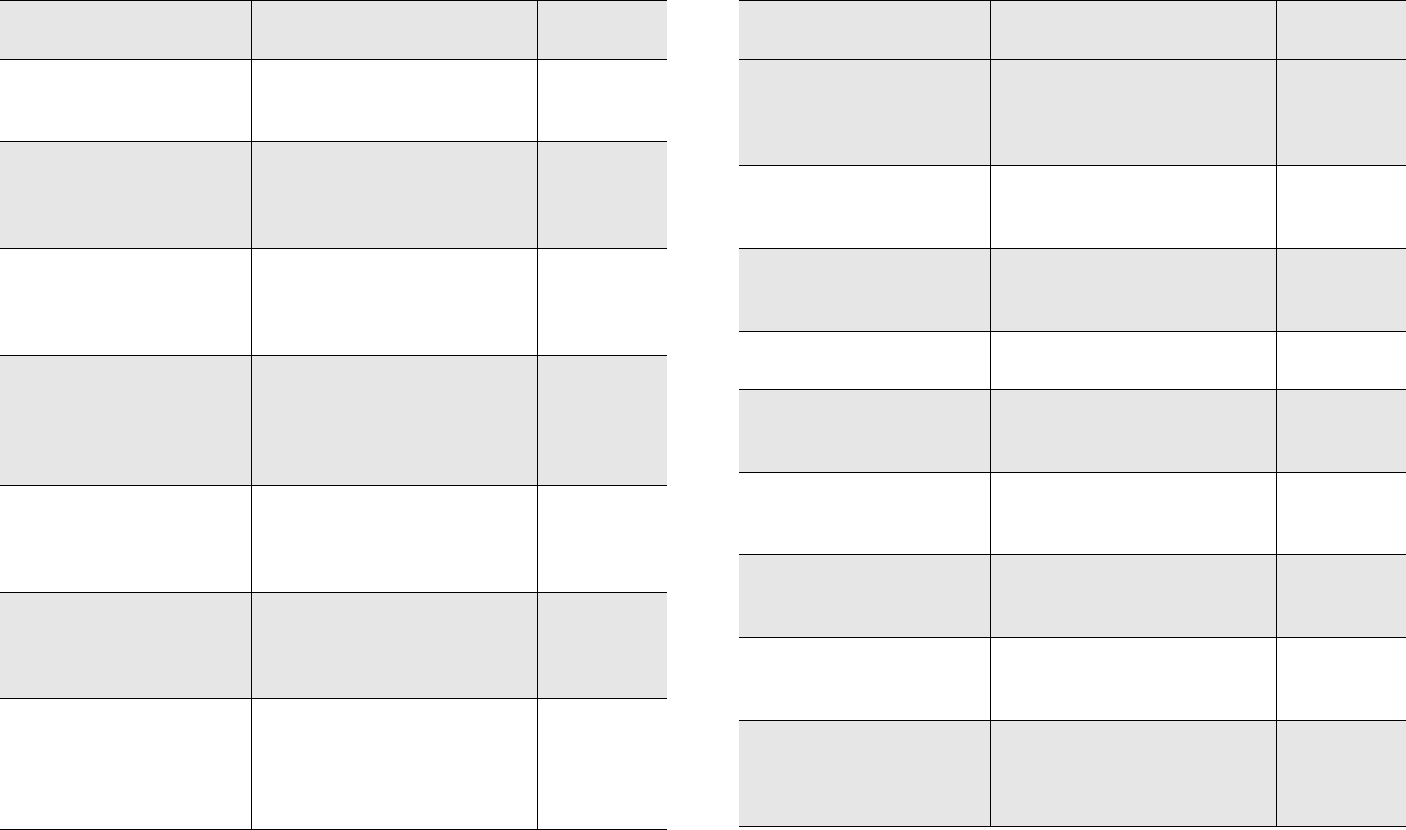
OpenText RightFax 10.0 Administrator’s Guide 318
Send info pages in fax The number of pages in the
outbound fax currently being
sent by the specified channel.
No
Send info pages done The number of pages that have
already been transmitted for the
fax currently being sent by the
specified channel.
No
Send info to name The intended recipient’s name
associated with the outbound
fax currently being sent by the
specified channel.
No
Send info to company The intended recipient’s
company name associated with
the outbound fax currently
being sent by the specified
channel.
No
Send info bill code 1 The first billing code value
associated with the outbound
fax currently being sent by the
specified channel.
No
Send info bill code 2 The second billing code value
associated with the outbound
fax currently being sent by the
specified channel.
No
Send info secure CSID The required CSID of the
receiving phone line associated
with the outbound fax currently
being sent by the specified
channel.
No
Table D5 Statistics available for the Local BoardServer category (Continued)
Statistic Description
Can trigger
alert
Send info unique ID The unique RightFax ID
associated with the outbound
fax currently being sent by the
specified channel.
No
Current operation The operation currently being
performed by the specified
channel.
No
Number of queued
transmission checks
The number of Doc Plus faxes
that need to have their status
queried.
No
Activity counters start date The start date that was set for
the “all-time” statistics.
No
All time pages sent The total number of fax pages
that have been sent since the
activity counter start date.
No
All time send attempts The total number of fax
transmission attempts since the
activity counter start date.
No
All time pages received The total number of fax pages
that have been received since
the activity counter start date.
No
All time faxes received The total number of faxes that
have been received since the
activity counter start date.
No
All time pages sent
remotely
The total number of fax pages
that have been sent via remote
fax servers since the activity
counter start date.
No
Table D5 Statistics available for the Local BoardServer category (Continued)
Statistic Description
Can trigger
alert
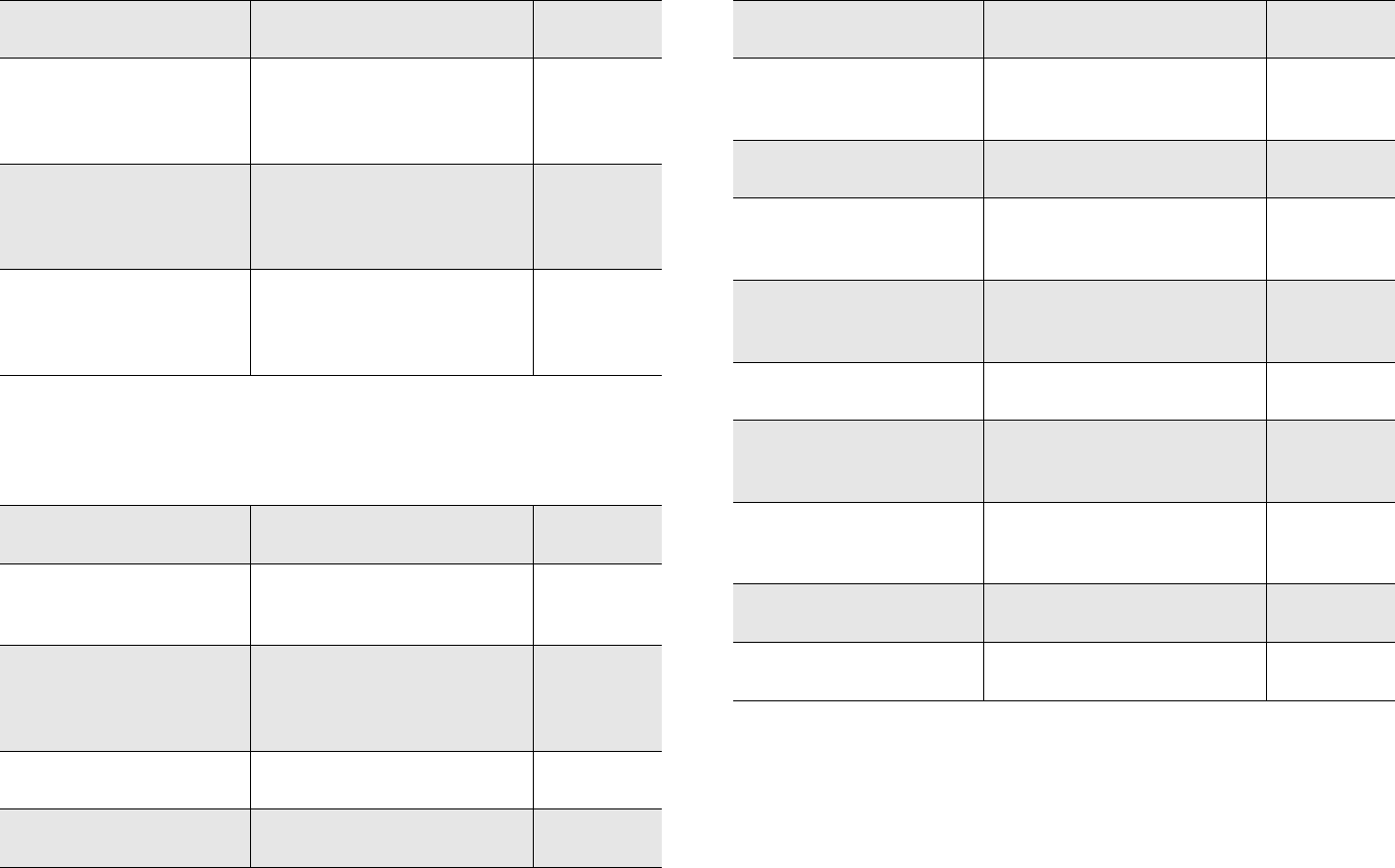
Appendix D Alerting and Monitoring Statistics 319
All BoardServers Statistics
All time send attempts
remotely
The total number of fax
transmission attempts via
remote fax servers since the
activity counter start date.
No
All time pages received
remotely
The total number of fax pages
that have been received from
remote fax servers since the
activity counter start date.
No
All time faxes received
remotely
The total number of faxes that
have been received from
remote fax servers since the
activity counter start date.
No
Table D6 Statistics available for the All BoardServers category
Statistic Description
Can trigger
alert
Information version A version number indicating the
level of information being
displayed for the BoardServers.
No
Number of board servers The total number of
BoardServer modules (local
and remote) being accessed by
the server.
No
Board server name The computer name of the
specified BoardServer.
No
Pipe name The pipe used to communicate
with the specified Boardserver.
No
Table D5 Statistics available for the Local BoardServer category (Continued)
Statistic Description
Can trigger
alert
Image directory The directory used for storing
fax images by the specified
BoardServer.
No
Send queue depth Total number of faxes currently
waiting to be transmitted.
Yes
Send pages depth Total number of fax pages
currently waiting to be
transmitted.
Yes
Number of channels The total number of hardware
channels on the specified
BoardServer.
No
Is server down Indicates whether the specified
BoardServer service stopped.
Yes
Down time The time at which the specified
BoardServer service was
stopped.
Yes
Down error The error code that was
generated when the specified
BoardServer went down.
No
Is server local Specifies whether the specified
BoardServer is local or remote.
No
Unique ID The unique RightFax ID for the
specified BoardServer.
No
Table D6 Statistics available for the All BoardServers category (Continued)
Statistic Description
Can trigger
alert
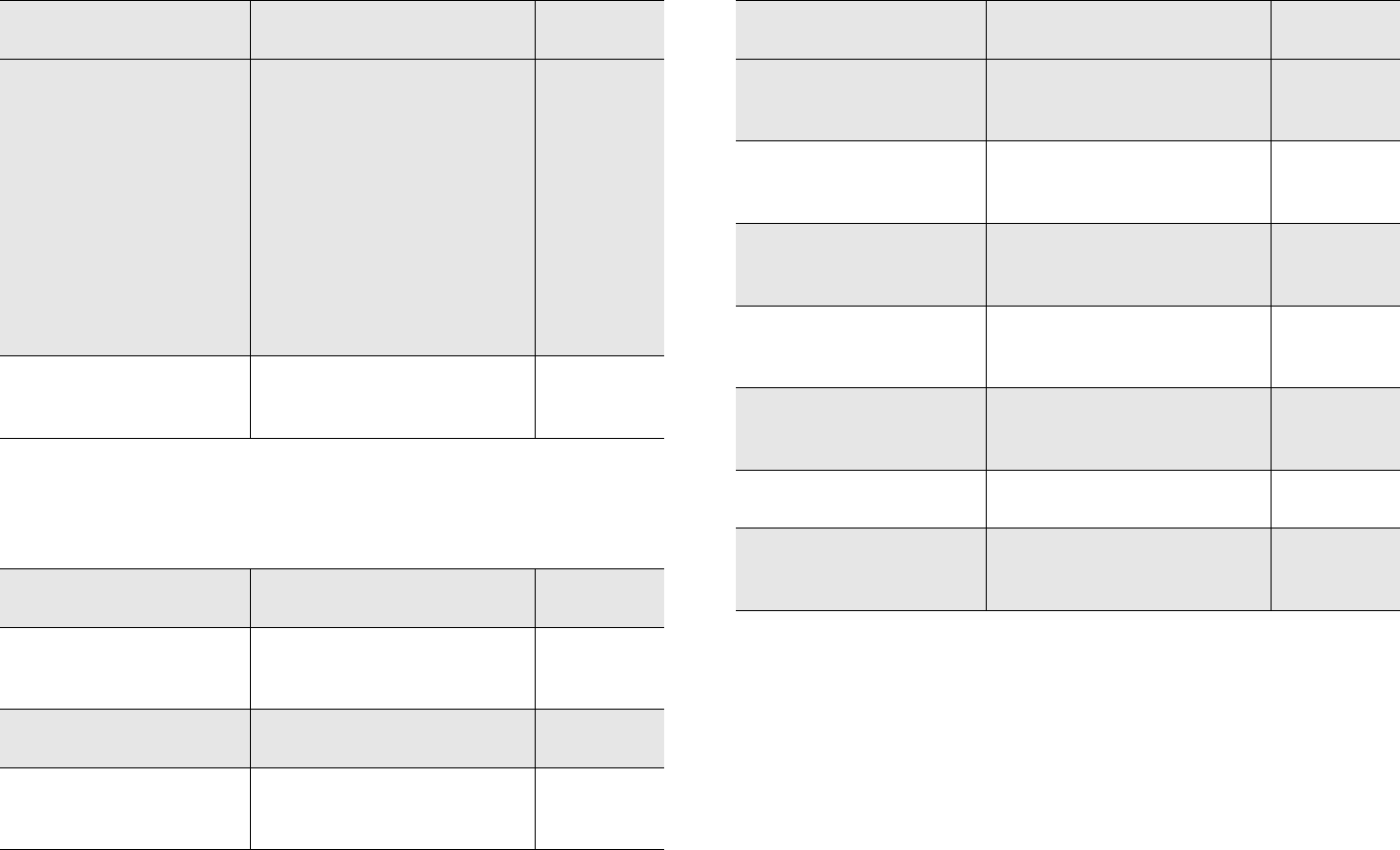
OpenText RightFax 10.0 Administrator’s Guide 320
RPC Server Statistics
Availability index The relative availability of the
specified BoardServer’s fax
boards. The higher the number,
the more available the server for
sending faxes. RightFax uses
this value when an outgoing fax
number has two equally
weighted dialing rules that send
it to two different servers. In
such a case, RightFax sends
the fax via the server with the
highest availability index.
Yes
Availability index time stamp The time at which the
Availability index was last
reported.
No
Table D7 Statistics available for the RPC Server category
Statistic Description
Can trigger
alert
Information version A version number indicating the
level of information being
displayed for the RPC server.
No
Last command The last file I/O API command
performed on the RPC server.
No
Open failures The total number of file open
failures since the RPC server
was started.
Yes
Table D6 Statistics available for the All BoardServers category (Continued)
Statistic Description
Can trigger
alert
Read failures The total number of file read
failures since the RPC server
was started.
Yes
Write failures The total number of file write
failures since the RPC server
was started.
Yes
Bytes read The total number of bytes read
since the RPC server was
started.
No
Bytes written The total number of bytes
written since the RPC server
was started.
No
Commands processed The total number of API
commands performed since the
RPC server was started.
No
Time for last command The length of time required to
complete the last command.
Yes
Time running The length of time since the
RPC Server service was last
started.
No
Table D7 Statistics available for the RPC Server category (Continued)
Statistic Description
Can trigger
alert
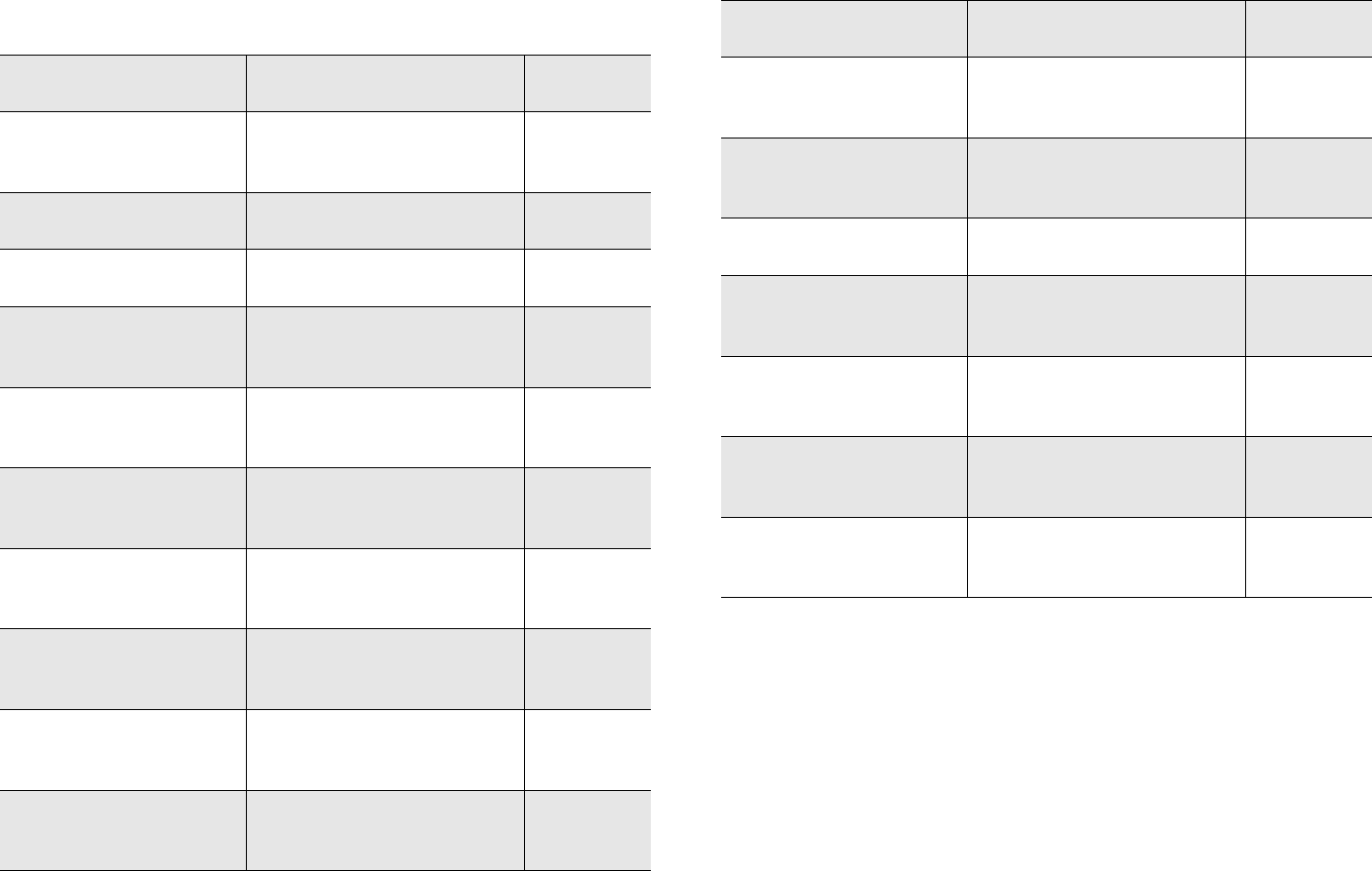
Appendix D Alerting and Monitoring Statistics 321
Paging Server Statistics
Table D8 Statistics available for the Paging Server category
Statistic Description
Can trigger
alert
Information version A version number indicating the
level of information being
displayed for the Paging server.
No
Time running The length of time since the
Paging service was last started.
No
Send queue depth Total number of pages waiting
to be transmitted.
Yes
Pages sent via modem Total pages sent via modem
since the Paging service was
started.
No
Pages sent via SMTP Total pages sent via SMTP
since the Paging service was
started.
No
SMTP failures Total number of failed SMTP
connections since the Paging
service was started.
Yes
Last SMTP fail code The error code that was
generated for the last failed
SMTP connection.
Yes
Modem page failures Total number of failed modem
transmissions since the Paging
service was started.
Yes
Last modem fail code The error code that was
generated for the last failed
modem transmission.
Yes
Current SMTP server The computer name or IP
address of the current SMTP
server.
No
Last modem error
description
The error message that was
generated for the last failed
modem transmission.
No
Last SMTP error
description
The error message that was
generated for the last failed
SMTP connection.
No
Pages sent via SMS Total pages sent via SMS since
the Paging service was started.
No
SMS failures Total number of failed SMS
connections since the Paging
service was started.
Yes
Last SMS fail code The error code that was
generated for the last failed
SMS connection.
Yes
Current SMS server The computer name or IP
address of the current SMS
(Push Proxy Gateway) server.
No
Last SMS error description The error message that was
generated for the last failed
SMS connection.
No
Table D8 Statistics available for the Paging Server category (Continued)
Statistic Description
Can trigger
alert
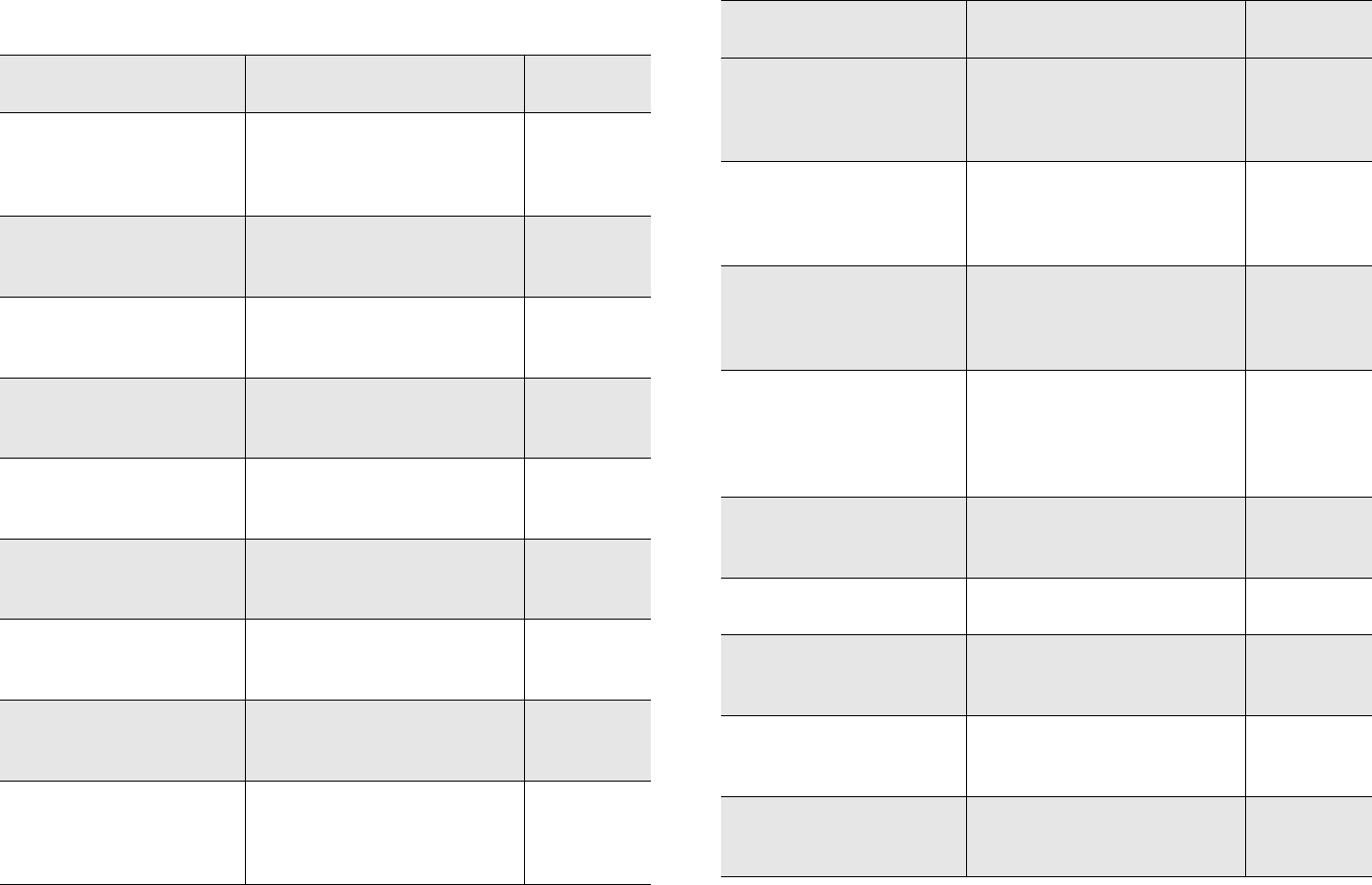
OpenText RightFax 10.0 Administrator’s Guide 322
Local Document Transport Server Statistics
Table D9 Statistics available for the Local Document Transport Server category
Statistic Description
Can trigger
alert
Information version A version number indicating the
level of information being
displayed for the local
BoardServer.
No
Time running The length of time since the
local BoardServer service was
last started.
No
Num channels Total number of fax channels
supported by the local
BoardServer.
No
Channel type Displays whether the specified
channel uses a loop-start or
DID line.
No
Capabilities Displays whether the specified
channel is set to send faxes,
receive faxes, or both.
No
Routing code The routing code of the fax
currently being received on the
specified channel.
No
State The current sending or
receiving state of the specified
channel.
No
Current page The page number of the fax
currently being sent or received
on the specified channel.
No
Total pages sent The total number of fax pages
sent on the specified channel
since the BoardServer was last
started.
No
Total pages received The total number of fax pages
received by the specified
channel since the BoardServer
was last started.
No
Total calls answered The total number of incoming
calls picked up by the specified
channel since the BoardServer
was last started.
No
Total calls placed The total number of outgoing
calls placed by the specified
channel since the BoardServer
was last started.
No
Total hang ups The total number of incoming
calls on the specified channel
that received a transmission
error due to hang up since the
BoardServer was last started.
No
ROM ID The ROM ID of the fax board
used by the specified fax
channel.
No
Current remote ID The remote ID of the currently
sending or receiving phone line.
No
Is currently sending Indicates whether the specified
fax channel is currently sending
a fax.
No
Is currently doing
TeleConnect
Indicates whether the specified
fax channel is currently doing
TeleConnect.
No
Is currently receiving Indicates whether the specified
fax channel is currently
receiving a fax.
No
Table D9 Statistics available for the Local Document Transport Server category
Statistic Description
Can trigger
alert
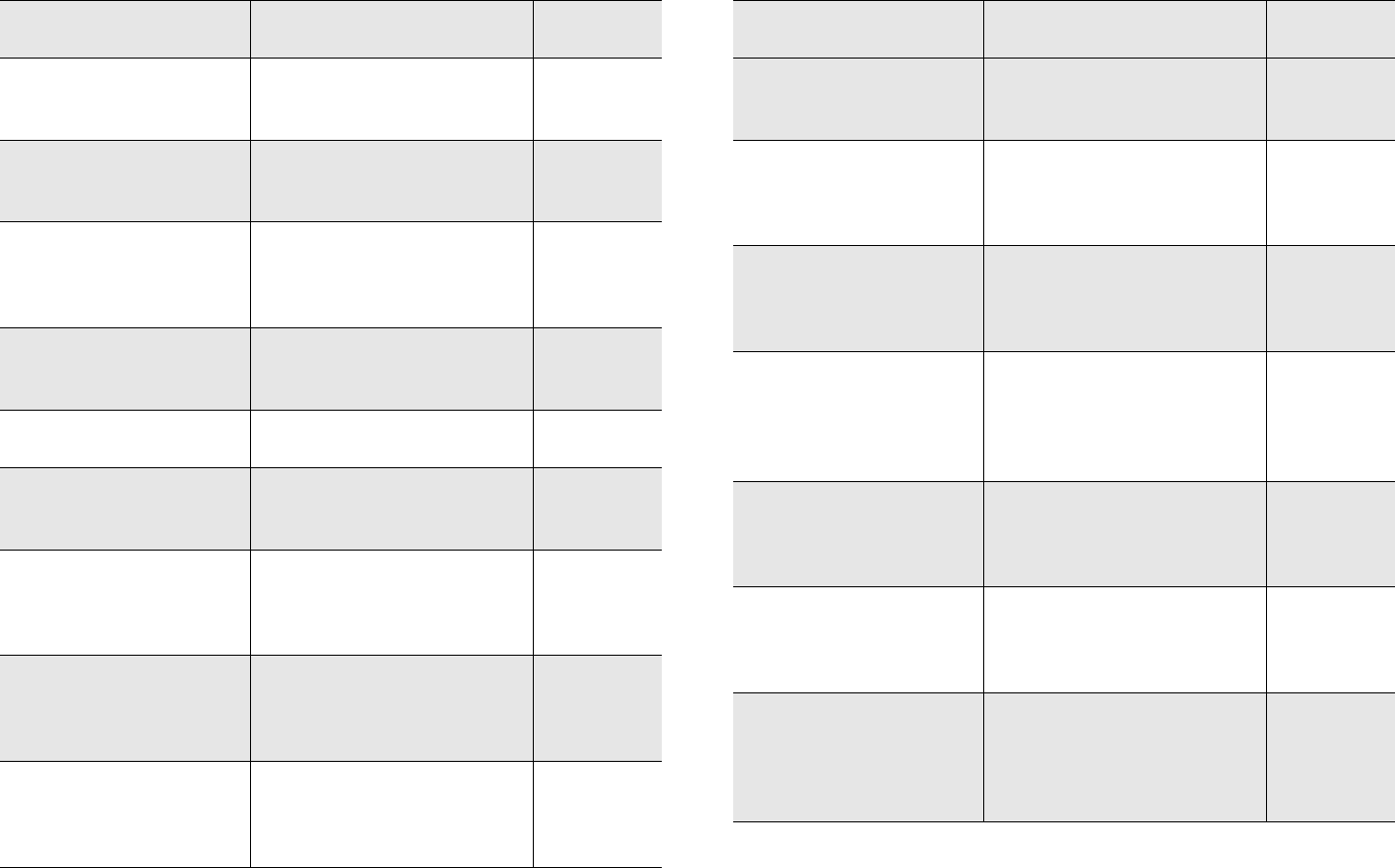
Appendix D Alerting and Monitoring Statistics 323
Is currently doing Docs on
Demand
Indicates whether the specified
fax channel is currently doing
Docs-on-Demand.
No
Group threshold left The number of fax pages
remaining before a fax grouping
will be sent.
No
Group faxes The current number of faxes
that are grouped for sending
but have not yet reached the
required number of pages.
No
Pages in call Specifies the total number of
fax pages queued to be sent
during the current call.
No
Current rate Specifies the transmission
baud rate of the current call.
No
Current compression Specifies the data compression
type being used for the
currently sent or received fax.
No
Estimated minutes left The estimated number of
minutes remaining for the
specified channel to send the
current fax.
No
Send info phone number The sending phone number
associated with the outbound
fax currently being sent by the
specified channel.
No
Send info user ID The RightFax user ID
associated with the outbound
fax currently being sent by the
specified channel.
No
Table D9 Statistics available for the Local Document Transport Server category
Statistic Description
Can trigger
alert
Send info pages in fax The number of pages in the
outbound fax currently being
sent by the specified channel.
No
Send info pages done The number of pages that have
already been transmitted for the
fax currently being sent by the
specified channel.
No
Send info to name The intended recipient’s name
associated with the outbound
fax currently being sent by the
specified channel.
No
Send info to company The intended recipient’s
company name associated with
the outbound fax currently
being sent by the specified
channel.
No
Send info bill code 1 The first billing code value
associated with the outbound
fax currently being sent by the
specified channel.
No
Send info bill code 2 The second billing code value
associated with the outbound
fax currently being sent by the
specified channel.
No
Send info secure CSID The required CSID of the
receiving phone line associated
with the outbound fax currently
being sent by the specified
channel.
No
Table D9 Statistics available for the Local Document Transport Server category
Statistic Description
Can trigger
alert
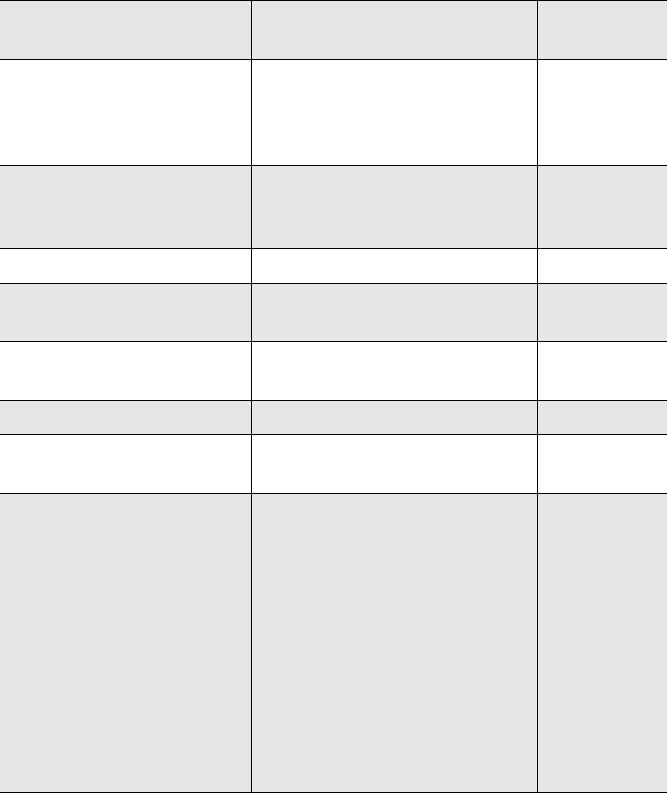
OpenText RightFax 10.0 Administrator’s Guide 324
Send info unique ID The unique RightFax ID
associated with the outbound
fax currently being sent by the
specified channel.
No
Current operation The operation currently being
performed by the specified
channel.
No
Transport name Name of the current transport. No
Docs sent via transport Number of faxes sent by the
currently-selected transport
No
Docs received via transport Number of faxes received by
the currently-selected transport
No
Queue name Name of the queue. No
Queue depth Total number of faxes currently
waiting to be transmitted.
Yes
Queue availability index The relative availability of the
server’s fax boards. The higher
the number, the more available
the server for sending faxes.
RightFax uses this value when
an outgoing fax number has two
equally weighted dialing rules
that send it to two different
servers. In such a case,
RightFax sends the fax via the
server with the highest
availability index.
Yes
Table D9 Statistics available for the Local Document Transport Server category
Statistic Description
Can trigger
alert
Appendix E 325
Appendix E
Registry Keywords
Some RightFax functionality is defined using the Windows
Registry. To make changes to the registry, you’ll need to use a tool
such as regedit.exe to manually find the registry key and then add
or modify the values in it.
The section “DocTransport Registry Entries” starting on page 326
describes the following values:
“ANIStripCount”
“BlockedNumbers”
“BlockingFlags”
“Change (in SFC Key)”
“CheckDNISforNortelRouteCode”
“DisableDialingRuleOnTimeout”
“DoDigitalChanRoute”
“Entries (in ANI Key)”
“Extensions (in SFC Key)”
“HAF_CancelIfNoResponse”
“UseISDNCallingParty”
“ValidPatternChars”
The section “FaxServer Registry Entries” starting on page 329
describes the following values:
“Allow MultipleGatewayNotifications”
“DBRecovery_Post_CheckLookEvent”
“DeleteImagesOnPurge”
“Notify_Freq”
“PrescanTimeoutSeconds”
“QueueSize”
“ReceiveStamp FontSize”
“ReceiveStamp Format”
“ReceiveStamp Location”
“StampReceivedPages”
“UseCompanyforCSID”
“UseReceiveStampUnique”
The section “Gateway Registry Entries” starting on page 332
describes the following values:
“DoNotStripPlusSign”
“ExcludeHeaders”
“ExtraHeaders”
“IncludeHeaders”
“SkipEmptyAttachments”
OpenText RightFax 10.0 Administrator’s Guide 326
The section “RightFax Registry Entries” starting on page 332
describes the following values:
“Image”
“TeleConnect Registry Configuration”
The section “WorkServer Registry Entries” starting on page 334
describes the following values:
“GSPostScriptCode”
“InterconnectSetTZ”
“KillServiceTimeout”
“NativeDocControl”
“PCL6_TwoPass”
“PrintTimeReverse”
“ShrinkToView”
“UseReceiveStampUnique”
“WordWrapTextLength”
DocTransport Registry Entries
HKEY_LOCAL_MACHINE\Software\RightFax\
DocTransport\Transports\Brooktrout
or, for 64-bit:
HKEY_LOCAL_MACHINE\Software\
Wow6432Node\RightFax\DocTransport\Transports\Brooktrout
ANIStripCount
By default, 31 characters of ANI data are stored in the database. In
some cases, the information at the end of long ANI data strings
may be truncated. Use this value to specify a number of digits you
want to remove from the beginning of the string (allowing the end
of the string to be stored).
Type: R EG_DWOR D
Default: 0 (does not strip leading characters)
BlockedNumbers
By default, DocTransports blocks outgoing faxes to any number
that begins with 911 (the standard emergency number throughout
the United States). To block additional numbers, edit the
BlockedNumbers value to enter the prefix, full number, or partial
number of each phone you want to block. Separate multiple entries
with carriage returns.
This function can also be performed through the RightFax interface
with Dialing Rules as described in “Editing Dialing Rules” on
page 188.
Type:REG_MULTI_SZ
Default: blank (no numbers are blocked)
See also “BlockingFlags” to turn the blocking feature on or off.
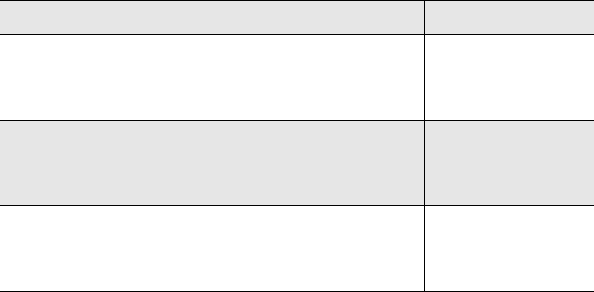
Appendix E 327
BlockingFlags
If you’ve created a manual list using the “BlockedNumbers” registry
entry, you can enable or disable the bloOpenText RightFaxcking
function by setting BlockingFlags as follows:
Type: R EG_M U LTI_SZ
Default: 0 (blocks 911 and numbers on the “BlockedNumbers” list)
Change (in SFC Key)
There are several ways to connect a stand-alone fax machine to
your RightFax server. In each case, a RightFax user ID is created to
host the Standalone Fax Connector and is assigned a unique
Routing Code value (called the “Extension”). The user then dials
into this extension from the fax machine (exactly how this is
accomplished depends on your phone system) in order to access
the RightFax server.
The Change value is part of the Registry subkey SFC located at
HKEY_LOCAL_MACHINE\Software\RightFax\DocTransport\
Transports\Brooktrout\SFC, or, for 64-bit,
HKEY_LOCAL_MACHINE\Software\ Wow6432Node\RightFax\
DocTransport\Transports\Brooktrout\SFC). If this subkey does not
yet exist, you may need to create it.
To force the BoardServer and DocTransport to read the Extensions
value, set the Change value to “1” hex . Once read, the
BoardServer returns the Change value to “0” hex. When you want
RightFax to read the values again (if you’ve added, removed, or
changed any of the stand-alone fax extensions), reset the Change
value to “1” hex.
Type: R EG_DWOR D
Default: 0 (does not read extensions, stand-alone fax is not
changed)
See the value for “Extensions (in SFC Key)” to specify the
extensions that match the Routing Codes for each stand-alone fax
connector, or “Connecting a stand-alone fax machine to the
RightFax server” on page 139 for more information.
CheckDNISforNortelRouteCode
To parse DNIS digits from Nortel CS1000 SIP invites, set this
entry to 1.
Type: R EG_DWOR D
Default: 0 (Nortel route codes are not parsed)
DisableDialingRuleOnTimeout
This value enables Fax Over IP Failover in a multi-router
environment. To configure FoIP, you must also set the dialing rules
as described in “Configuring Fax over IP Failover” on page 69. To
enable FoIP, set the DisableDialingRuleOnTimeout value to 1.
Type: R EG_DWOR D
Default: 0 (the Failover is not enabled)
DoDigitalChanRoute
By default, channel routing (where incoming faxes are routed by the
channel on which they arrive into the RightFax system) does not
work with digital fax boards. To enable a digital fax board for use
with channel routing, set this value to 1.
Table E1 ISDN Data String Options
Data Value
Prevent transmission to anything starting with
911, and prevents transmission to all numbers
listed in the “BlockedNumbers” list
0
Allow transmission to the “BlockedNumbers”
list and allow transmission to numbers starting
with 911
1
Allow transmission to the “BlockedNumbers”
list and allow transmission to numbers starting
with 911
2
OpenText RightFax 10.0 Administrator’s Guide 328
Type: R EG_DWOR D
Default: 0 (does not route faxes based on channel)
Entries (in ANI Key)
To specify the numbers you want to route to the user account set
up for spam handling, enter the ANI or DNIS information and the
RightFax user ID (where blocked faxes will be routed to) in the
Entries value of the ANI subkey. There is no limit to the numbers
you can add here. For example,
5551212, SpamAccount
routes all calls with the ANI 5551212 to the RightFax user
“SpamAccount”.
The Entries value is part of the Registry subkey ANI located at
HKEY_LOCAL_MACHINE\Software\RightFax\DocTransport\ANI
or, for 64-bit, HKEY_LOCAL_MACHINE\Software\
Wow6432Node\RightFax\DocTransport\ANI). If this subkey does
not yet exist, you may need to create it.
Type: R EG_M U LTI_SZ
Default: blank (faxes are not routed anywhere)
For more information, see “Spam Handling” on page 201.
Extensions (in SFC Key)
There are several ways to connect a stand-alone fax machine to
your RightFax server. In each case, a RightFax user ID is created to
host the Standalone Fax Connector and is assigned a unique
Routing Code value (called the “Extension”). The user then dials
into this extension from the fax machine (exactly how this is
accomplished depends on your phone system) in order to access
the RightFax server.
The Extensions value is part of the Registry subkey SFC located at
HKEY_LOCAL_MACHINE\Software\RightFax\DocTransport\
Transports\Brooktrout\SFC, or, for 64-bit,
HKEY_LOCAL_MACHINE\Software\ Wow6432Node\RightFax\
DocTransport\Transports\Brooktrout\SFC). If this subkey does not
yet exist, you may need to create it.
Within the SFC key, enter one value for each Extension, separating
multiple entries with a carriage return. The values must match the
Routing Code value set in each dedicated RightFax user ID.
Data Type: REG_MULTI_SZ
Default: blank, stand-alone fax is not enabled.
See the value for “Change (in SFC Key)” to specify when RightFax
should read in new extensions, or “Connecting a stand-alone fax
machine to the RightFax server” on page 139 for more information.
HAF_CancelIfNoResponse
To cancel a fax transmission if a human voice is detected, set the
HAF_CancelIfNoResponse value to 1. For more information, see
“Configuring the Human Answered Fax feature”on page 61.
Type: DWO R D
Default: 0 (does not cancel the fax)
UseISDNCallingParty
You can add data to the calling party number field of the ISDN
string for each fax sent from the RightFax server. This data can be
captured by some PBX systems for billing purposes. Before
implementing this feature, verify that the PBX system can accept
the data. If it does not, the PBX will reject the call.
Use the UseISDNCallingParty value to specify which information
you want to capture. The data options for the string are described
in the following table.
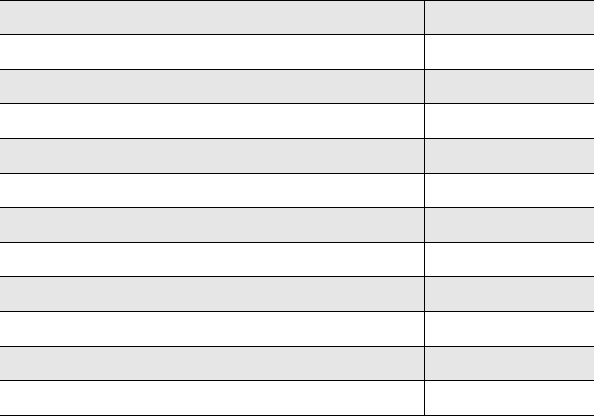
Appendix E 329
Type: R EG_DWOR D
Default: No data is captured.
ValidPatternChars
Dialing rules are entered as a string of characters and wild cards.
RightFax ignores any hyphens, parentheses, or spaces in the
pattern string. By default, the pattern can include the digits 0–9, as
well as the pound [#] and asterisk [*] keys, and the wildcard
characters plus [+], tilde [~] and slash [\] keys. See “Editing
Dialing Rules” on page 188 for more information on Dialing Rules.
To add additional symbols such as a comma or period to the list of
supported characters, add the characters to the end of the
ValidPatternChars value.
Type: R EG_DWOR D
Default: 0123456789*#+~\
FaxServer Registry Entries
FaxServer keywords are
HKEY_LOCAL_MACHINE\Software\RightFax\FaxServer
or for 64-bit:
HKEY_LOCAL_MACHINE\Software\Wow6432Node\RightFax
\FaxServer)
After adding the registry values, stop and start the RightFax server
for the settings to take effect.
Allow MultipleGatewayNotifications
Each user can specify whether or not they want to received
notifications about failed faxes. By default, only the sending user
gets this type of notification. To send a second notification to the
email address configured on the notficiations tab of the default
user, set this entry to 1.
Type: R EG_DWOR D
Default: 0 (does not send duplicate failed notifications)
DBRecovery_Post_CheckLookEvent
Set this value to “1” to prevent large databases with many
documents from taking a long time to complete the DBRecovery
cycle. A value of “0”
Type: R EG_DWOR D
Default: 1 (notifications will be sent).
DeleteImagesOnPurge
By default, RightFax will retain the image files of faxes that have
been deleted from FaxUtil until all corresponding database records
have been removed. To configure RightFax to immediately delete
fax images, set this value to 0.
Type: R EG_DWOR D
Table E2 ISDN Data String Options
Data Value
Fax number dialed. 1
RightFax user ID of the sender. 2
The recipient’s voice number. 3
The recipient’s name. 4
The recipient’s company name. 5
Billing code 1. 6
Billing code 2. 7
Assigned unique ID for fax job. 8
CSID match code for secure send operation. 9
Name of the sender. 10
Source server IP address or name. 11
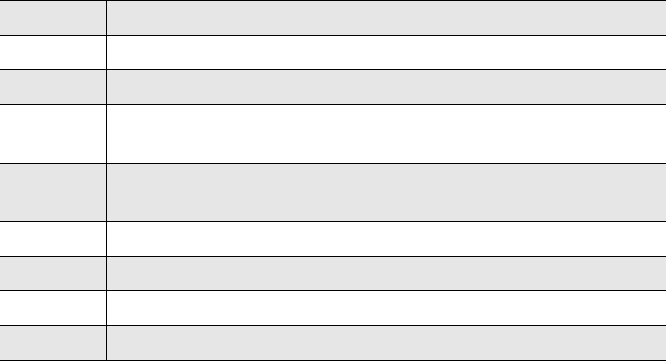
OpenText RightFax 10.0 Administrator’s Guide 330
Default: 0 (if the DWORD is in the key, the default is to delete
images. If the DWORD is not in the key, the default system
behavior is to retain the images.)
Notify_Freq
By default, the RightFax server sends periodic notifications to users
every five minutes. The Notify_Freq value specifies the number of
minutes between notifications. See “Notification settings” on
page 22.
Type: R EG_DWOR D
Default: 5 (notifications sent every 5 minutes)
PrescanTimeoutSeconds
Prescanning very large Print-to-Fax files for embedded codes can
cause the Fax Server to appear unresponsive. Use this entry to set
the number of seconds after which the Fax Server will stop
processing embedded codes.
Type: R EG_DWOR D
Default: 0 (no time out, processing continues as long as necessary)
QueueSize
By default, the RightFax internal event queue has a limit of 2000
events. If too many events require attention of the RightFax Server
module, the server will generate an alert and stop running.
To increase the event queue size, change the QueueSize value to
3000. A modest increase to the event queue size will not have any
adverse effects on the RightFax server itself.
Type: R EG_DWOR D
Default: 2000 (limit of 2000 events may be in the queue)
ReceiveStamp FontSize
This value specifies the font size (in points) for the text that displays
on the optional RTI line. Set ReceiveStampFontSize to any decimal
number. Use the StampReceivedPages value to turn the RTI on or
off; use the ReceiveStampFormat value to specify which data
displays.
Type: R EG_DWOR D
Default: 14 (RTI displays as 14-point type)
See Also:
“StampReceivedPages” to turn the RTI on or off
“ReceiveStamp Format” to specify which data displays
“ReceiveStamp Location” to specify where the RTI displays
ReceiveStamp Format
This value specifies which information to display in the optional RTI
line. The following table lists the variables that can be included in
your RTI line text.
Table E3 ReceiveStampFormat Variables
Variable Definition
~1 The current page number.
~2 The total number of fax pages received.
~3 The date and time that the fax was received (as reported by the
fax server).
~4 The name of the fax server that received the fax (up to 30
characters).
~5 The number of the fax channel that received the fax.
~6 The fax recipient’s DID number.
~7 The fax sender’s caller subscriber ID (CSID).
~8 Duration of the fax transmission in minutes and seconds.
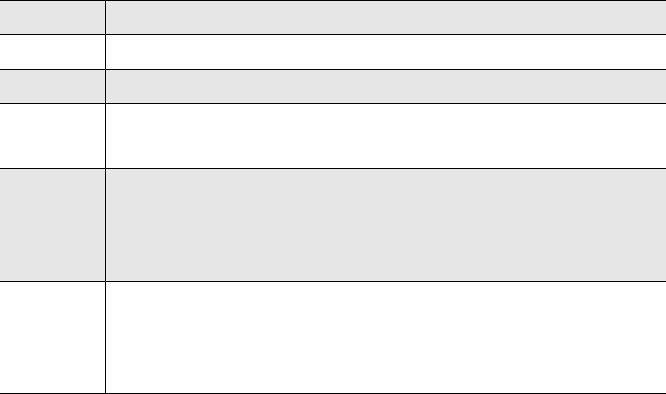
Appendix E 331
Example The following ReceiveStampFormat entry:
Page ~1 of ~2 received on ~3 on server ~4.
might print as:
Page 2 of 4 received on 02-01-01 12:11:59 [US
Mountain Standard Time] on server RIGHTFAX.
ReceiveStamp Location
Specify where on the fax page to print the optional RTI line. Valid
options are TOP, BOTTOM, LEFT, or RIGHT.
TYPE: REG_SZ
Default: BOTTOM (prints the RTI across the bottom of each page)
See Also:
“StampReceivedPages”to turn the RTI on or off
“ReceiveStamp Format” to specify which data displays
“ReceiveStamp FontSize” to specify how large the RTI will be
StampReceivedPages
The RTI (Receipt Terminal Information) line is a line of text that can
be printed on each received fax page. The RTI line includes
information about the fax that supplements the TTI line such as the
total number of pages received, the name of the fax server that
received the fax, and the sender’s caller ID. To enable the RTI line,
set StampRecievedPages to 1.
Type: R EG_DWOR D
Default: 1 (the RTI line is enabled)
See Also:
“ReceiveStamp Location”to specify where to display the RTI
“ReceiveStamp Format” to specify which data displays
“ReceiveStamp FontSize” to specify how large the RTI will be
UseCompanyforCSID
The TTI (Transmission Terminal Information) is a line of text that is
printed across the top of each sent fax page, usually containing the
date, time, page number, total pages, and fax ID (or CSID). You can
replace the CSID with the sender’s company name by setting the
UseCompanyforCSID value to 1.
Type: R EG_DWOR D
Default: 0 (does not change the TTI)
To add the Company Name for each user,
1. Open FaxUtil.
2. On the Tools menu, click Options and the User Options dialog
box opens.
3. On the User Information tab, in the Company field, enter the
company name.
~9 The fax recipient’s RightFax user ID (if applicable).
~0 The fax recipient’s RightFax user name (if applicable).
~A The unique ID assigned to the fax by the fax server.
This variable is case-sensitive.
~B The current date formatted as a two-digit year followed by three
digits for the absolute day of the year. For example, “00001”
means January 1, 2000.
This variable is case-sensitive.
~C The total page count on the fax server. The number is reset each
day at midnight and then increments by one for each received
fax page.
This variable is case-sensitive.
Table E3 ReceiveStampFormat Variables (Continued)
Variable Definition
OpenText RightFax 10.0 Administrator’s Guide 332
UseReceiveStampUnique
To instruct RightFax to use the unique ID as the file name for the
fax, set this value to 1. You must set the value in the registry for
each WorkServer and for the FaxServer.
Type: R EG_DWOR D
Default: 0 (unique ID is not used as the fax file name)
See “Assigning Unique ID Numbers to Fax File Names
and Routing to a Network Folder”on page 218 for additional setup
requirements when using this registry value.
Gateway Registry Entries
The following registry keys can be added to further configure your
SMTP/POP3 gateway. RightFax creates one overall key for the
Gateways:
HKEY_LOCAL_MACHINE\Software\RightFax\Gateway
or for 64-bit:
HKEY_LOCAL_MACHINE\Software\Wow6432Node\RightFax\
Gateway)
There is also a subkey for each additional gateway, indicated by the
gateway number (such as Gateway1 or Gateway2) as follows:
HKEY_LOCAL_MACHINE\Software\RightFax\Gateway
\Gateway#
or for 64-bit:
HKEY_LOCAL_MACHINE\Software
\Wow6432Node\RightFax\Gateway\Gateway#
DoNotStripPlusSign
Prevents the “+” character from being stripped from the dialing
string. 0=disabled, 1=enabled.
Type: R EG_DWOR D
ExcludeHeaders
Any headers listed here will be removed from the fax cover sheet
Notes area. Values in this field are not case-sensitive.
Type: R EG_M U LTI_SZ
ExtraHeaders
Text entered here will be added to the headers of all mail-bound faxes
going to the SMTP server.
Type: R EG_M U LTI_SZ
IncludeHeaders
Only the headers listed here will be added to the fax cover sheet
Notes area. Leaving this blank will allow all headers to be included.
Values in this entry are not case-sensitive.
Type: R EG_M U LTI_SZ
SkipEmptyAttachments
The gateway will scan the bodies of fax-bound mail attachments and
discard empty ones. This registry key prevents blank fax pages from
being sent. 0=disabled, 1=enabled.
Type: R EG_DWOR D
Default: 0 (disabled)
RightFax Registry Entries
RightFax keywords are
HKEY_LOCAL_MACHINE\Software\RightFax
or for 64-bit:
HKEY_LOCAL_MACHINE\Software\Wow6432Node\RightFax
After adding the registry values, stop and start the RightFax server
for the settings to take effect.
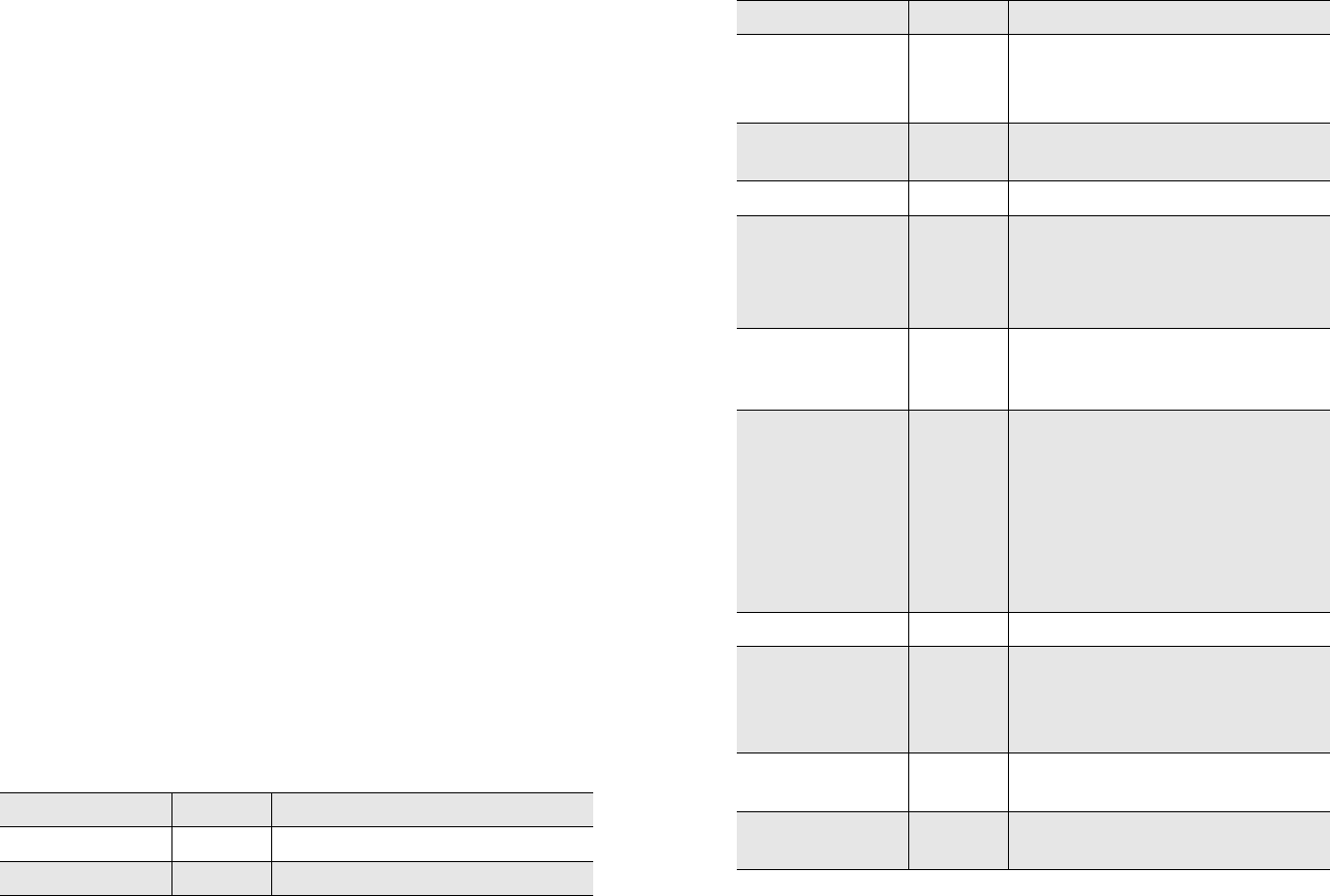
Appendix E 333
Image
By default, RightFax stores fax images in the RightFax\Image folder
on the server. You can change the location of image storage by
entering a valid path name for the Images value. See “Critically low
disk space” on page 184 for more information.
Type: R EG_S Z
Default: C:\Program Files\RightFax\Image
TeleConnect Registry Configuration
TeleConnect is configured primarily via multi-string (Reg_Multi_SZ)
registry entries. Each channel dedicated to TeleConnect has its
own configuration registry entry. The TeleConnect configuration
registry entry is located at HKEY_LOCAL_MACHINE\Software
\RightFax\Doctransport\Transports\Brooktrout\TUI\Extensions
(64-bit: HKEY_LOCAL_MACHINE\Software\Wow6432Node\
RightFax\Doctransport\Transports\Brooktrout\TUI\Extensions).
The multi-string registry entries for TeleConnect use this format:
extension`keyword(value)`keyword(value)`...
Where extension is the phone number extension or DID channel
assigned to TeleConnect, ` is the “grave” character located on the
same key as the tilde (~), keyword is one of the configuration
setting keywords from the following table, and value is an optional
value setting for the keyword. The phone number extension or DID
channel assigned to TeleConnect is always the first entry. The
extension and all keywords must be separated by an accent grave
(`) character.
The following table lists all available TeleConnect keywords, and
includes the default settings (if any) and descriptions.
Table E4 TeleConnect Registry Values
Keyword Default Description
900Agree N/A 900 caller agreement sequence.
900Enable False 900 telephone processing.
AppType 0Application type:
0 = TeleConnect
2 = One-Doc Poll
AskAlphaNumeric False Ask caller for alpha-numeric
sequence.
AskVoiceNumber True Ask caller for voice number.
CallType 0Default call type:
0 = Prompt
1 = One-call
2 = Two-call
CSID N/A CSID to use during a one-call
transaction. If blank, it uses the
channel default.
DefaultBI1 N/A Default billing code #1 for a two-call
fax TeleConnect. If a fax is being
forwarded from a user’s mailbox, the
system will attempt to use the billing
codes from the source fax. If no
billing codes are present in the
source fax, the value specified here,
and that of DefaultBI2, will be used.
DefaultBI2 N/A Default billing code #2 for two-call.
MaxErrors 3Maximum number of errors allowed
(timeouts, invalid doc numbers, etc.)
If this number is exceeded, the caller
will be disconnected.
MaxFaxes 32 The maximum number of faxes sent
out in one call by TeleConnect.
Multilingual False Multilingual support
enabled/disabled.
Table E4 TeleConnect Registry Values (Continued)
Keyword Default Description
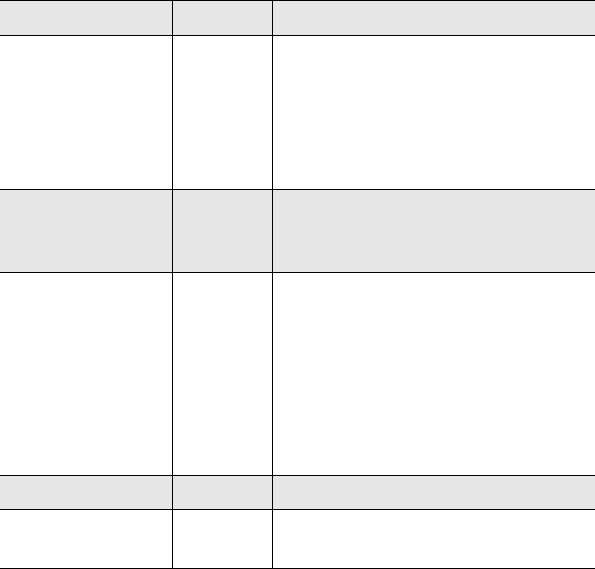
OpenText RightFax 10.0 Administrator’s Guide 334
WorkServer Registry Entries
RightFax creates one overall key for the workservers:
HKEY_LOCAL_MACHINE\Software\RightFax\Workserver
or for 64-bit:
HKEY_LOCAL_MACHINE\Software\Wow6432Node\RightFax\
Workserver)
There can also be a subkey for each additional workserver,
indicated by the workserver number (such as Worksrv1 or
Worksrv3) as follows:
HKEY_LOCAL_MACHINE\Software\RightFax\Workserver
\Worksrv#
or for 64-bit:
HKEY_LOCAL_MACHINE\Software
\Wow6432Node\RightFax\Workserver\Worksrv#
GSPostScriptCode
Certain PDF files may not convert legibly. To correct this, you can
include the following PostScript string in the GSPostScriptCode
registry value on each Workserver that does conversion.
<</Install {{0.90 gt {1}{0} ifelse} settransfer}>>setpagedevice
Type: R EG_S Z
Default: blank (does not improve PDF conversion quality)
InterconnectSetTZ
By default, faxes routed from one RightFax server to another
RightFax server in a different time zone will have the time and date
stamp from the originating server. To change this so that faxes have
the time and date of the receiving server, set the
InterconnectSetTZ value to ‘1’.
Type: R EG_DWOR D
Default: 0 (faxes keep the time and date stamp of the originating
server)
See “Configuring RightFax for CSID routing” on page 216 for
more information about this type of routing.
KillServiceTimeout
In case server-side application conversion fails, you can configure
RightFax to automatically time out, stop the conversion, and set the
fax status to “conversion failed.” Set the data value of
TransferSequence N/A PBX transfer sequence. If not blank,
TeleConnect transmits this
sequence just before hanging up. It
is a standard Brooktrout® sequence
(TP!F,;WU%1234567890ABCD).
39 characters max.
TUIReportPath TUILOG The path for TeleConnect reports. If
a relative path-spec, it will be
relative to the RFBoard folder.
VoicePath MainApp\
voices;
voices
The path(s) for voice prompt files.
One or more folders the system will
search to play a voice file. Folders
are separated with a semicolon. A
relative folder specification is
relative to the RFBoard folder. Any
recorded message will be recorded
to the first folder listed.
VoicePath0 N/A Language #0 voice folder(s).
VoicePath2 –
VoicePath9
N/A Language #2 voice folder(s) –
Language #9 voice folder(s).
Table E4 TeleConnect Registry Values (Continued)
Keyword Default Description
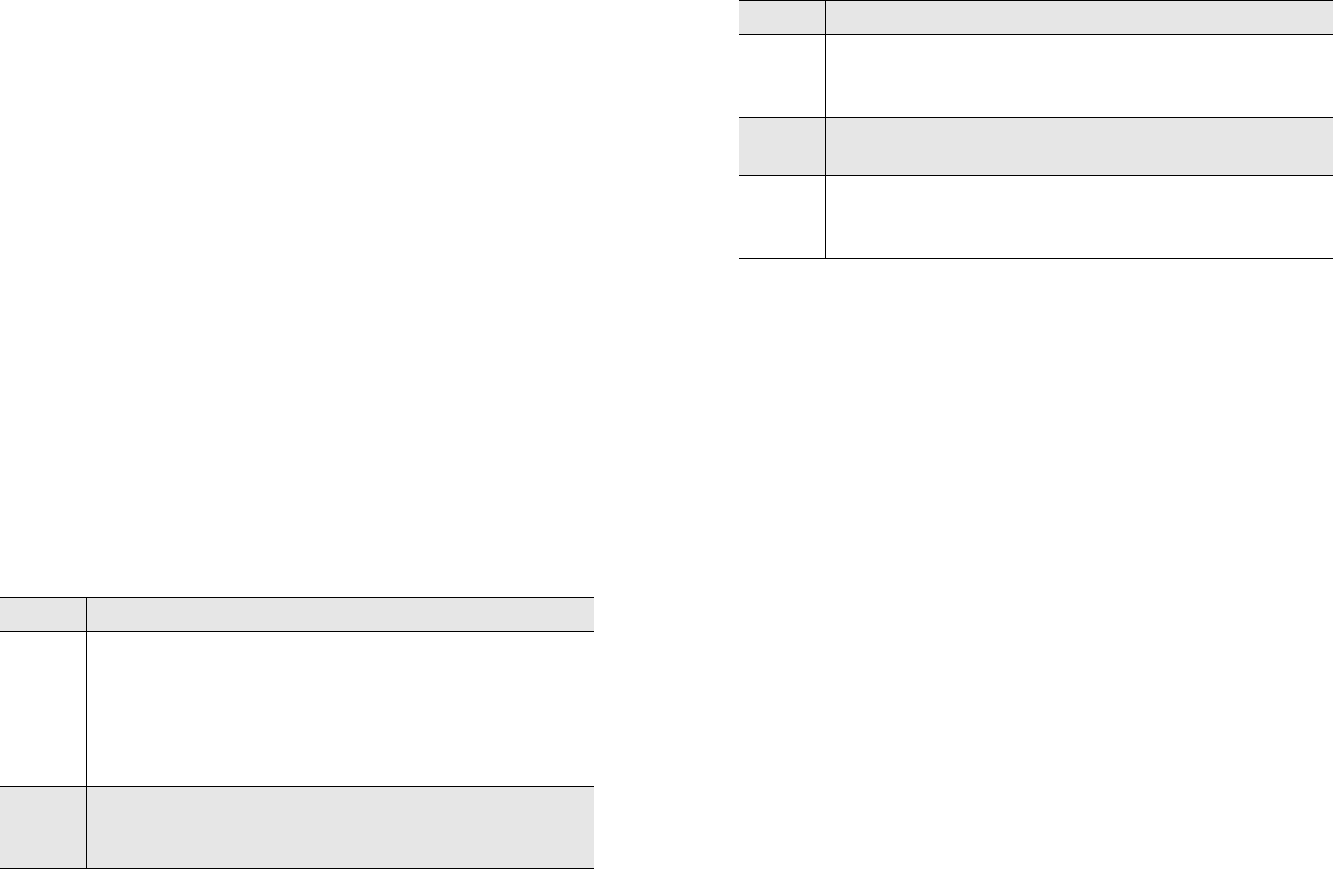
Appendix E 335
KillServiceTimeout to the length of time in milliseconds that you
want to attempt conversion before timing out. For example, set the
data value to 600000 for 10 minutes.
This must be set for each workserver.
Type: R EG_DWOR D
Default: no time out. RightFax will continue to attempting to convert
the fax indefinitely.
NativeDocControl
This entry controls how and when server-side application
conversion is used for specific document types. The setting for this
value is one or more lines each controlling a specific document
type in the format:
DocType,Action
Where DocType is the type of document to control, and Action
specifies how the document type should be handled. DocType can
be Word, Excel, PowerPoint, VSD, RTF, HTML, or PDF. The
following table lists the actions you can specify.
Type: R EG_M U LTI_SZ
Default: blank (does not use any server-side conversion)
PCL6_TwoPass
This value passes a fax through conversion twice in normal mode.
Though this improves the quality of the output image, it also takes
longer than a single-pass conversion. Set this value to 1 to pass
faxes through conversion twice.
Type: R EG_DWOR D
Default: 0 (faxes go through conversion just once)
PrintTimeReverse
By default, a time strip is printed on the first page of each fax as
black text. Set the PrintTimeReverse value to ‘1’ to cause the time
strip to print in white text on a black background.
Type: R EG_DWOR D
Default: 0 (the time strip prints in black text)
ShrinkToView
By default, PDF conversion adds a small margin around the edge
of each page. If the incoming fax images go to the edge of the
page, part of the image may be cut off by this margin. Set this value
to 1 on each Workserver to reduce the size of the page slightly
before conversion so that the margin does not cut off any content.
Table 31b NativeDocControl Actions
Value Action
1Attempt to convert the document using the native
application on the server. If this fails because the
application is not installed, because the application
cannot be started, or because the application returns an
error, then attempt to convert the document using the
built-in RightFax conversion engine.
2Only attempt to convert the document using the native
application on the server. If this fails for any reason, abort
the fax.
3Attempt to convert the document using the built-in
RightFax conversion engine. If this fails for any reason,
abort the fax.
4Do not attempt to convert this type document. Conversion
will fail.
5Attempt to convert the document using the built-in
RightFax conversion engine. If this fails, attempt
conversion with the native application.
Table 31b NativeDocControl Actions (Continued)
Value Action
OpenText RightFax 10.0 Administrator’s Guide 336
Type: R EG_DWOR D
Default: 0 (does not shrink PDF pages)
UseReceiveStampUnique
To instruct RightFax to use the unique ID as the file name for the
fax, set this value to 1. You must set the value in the registry for
each WorkServer and for the FaxServer.
Type: R EG_DWOR D
Default: 0 (unique ID is not used as the fax file name)
See “Assigning Unique ID Numbers to Fax File Names
and Routing to a Network Folder”on page 218 for additional setup
requirements when using this registry value.
WordWrapTextLength
Text attachments that contain long lines of text can potentially be
truncated. Set the data value of the WordWrapTextLength to the
maximum line length before wrapping. For example, 150 will
word-wrap anything over 150 characters.
The length must be set on each workserver.
Type: R EG_DWOR D
Default: Rightfax does not wrap lines of text.
Note: to use this value, you must configure all RightFax WorkServers
to use the option ‘Use PCL Converter for Text Files’.
337
Symbols
.trx files 40
.vox files 61
Numerics
911 calls 201
A
A4 paper 136
access TeleConnect 282
adding
alerts and monitors 170
billing codes 141
cover sheet to a fax 211
dialing rules 187
groups of users 120
library documents 149
overlay forms 132
pager services 162
printers 135
Short Message Services 162
signatures 128
signatures to a fax 128
users 104
users automatically 22
WorkServer modules 44
administrative mode 201, 241
administrative permission, in user profile 107
administrator
administrative mode 201, 241
approving outbound faxes 241
user group 120
administrator notification messages
pager 29-30
SMS 29-30
aging faxes 121
alert messages
all BoardServers down 184
critically low disk space 184
Exchange server is not responding 185
fax server event queue full 185
low disk space 185
one BoardServer down 186
probable line failure 186
send queue too deep 186
server improperly shut down 186
Alerting and Monitoring service 167
alerts
clearing 177
enabling and disabling 177
frequencies 113
in event log 165
pager 112
receiving 176
severity 177
troubleshooting 183
all BoardServers down 184
alphanumeric data, entering via
telephone 283
alphanumeric passwords 282
alternate administrator, user group 120
alternate body 239
alternate routing tables 225
ANI (Automatic Number Identification)
data pattern match 52
routing inbound faxes with 215-216
Application Event Log level
Alerting module 168
BoardServer module 51
Database module 24
e-mail gateway 269
Server module 22
WorkServer modules 38
approve faxes 241
Approving Blocked Faxes 201
Approving Faxes Blocked by Dialing
Rules 241
archiving sent faxes 39-42, 107
assign channel to TeleConnect 276
auto-delete faxes 110
Automatic Number Identification See ANI
automatic OCR 114
Index
Open Text Fax Server, RightFax Edition Version 9.4 Feature Pack 1 Administrator’s Guide 338
automatic printing
configuring 137
inbound faxes 114
outbound faxes 114
AutoReply service
fax format 230
installing 227
managing from a remote computer 229
overview 227
troubleshooting 231
availability index, fax board 97
B
backup 287-289
Baddigit.ipk 61
Basic Rate Interface See BRI
billing codes
adding to sent faxes 71
copying 141
custom field names 141
default for received faxes 107
default for sent faxes 111
deleting 141
editing 142
import interval 39
importing 39, 142-143
ODBC 143
requiring 143
validation 107
validation by external program 25, 143
validation by RightFax server 25, 143
validation from e-mail gateways 24
blocking calls 201
BoardServer module
availability index 98
configuring 49-331
described 19
fax audit log 53-56
remote 72-??
troubleshooting 65
BoardServers down 184, 186
body pages, short 39
broadcast faxing 252-255
Brooktrout fax boards
configuring channels 59-61
Business Server 17
C
call blocking 201
call TeleConnect 282
call type 65
caller subscriber identification 22
Captaris Conversion- Understanding
Server-side Application Conversion 75
CED tone 52
central mailbox 223
channel, assigning to Fax-on-Demand 64
channel, assigning to TeleConnect 276
Channel. See connector.
character set mode 97
character sets 97
clearing alerts 177
client applications
Enterprise Fax Manager 93
Enterprise Fax Manager, Web
edition 101
Codechg.csv 142
Community Name 175
compute disk usage 106
configure
network monitor application 176
SNMP service 175
configure Fax-on-Demand 63
configuring
ANI routing 215
Brooktrout fax channels 59-61
CSID routing 216
DID/DNIS routing ??-214
DTMF routing ??-214
e-mail gateway 259-263
fax channel routing 214-215
global fax board settings 52-331
Kofax NetScan 45-46
pager alerts 162-165
PeopleSoft integration 46
remote BoardServer module 72-??
remote WorkServer modules 47-48
Short Message Services (SMS)
alerts 162-165
SMTP/POP3 gateway 258-259, 263
SQL connection 285
WorkServer modules 37-42
Configuring Internet Explorer 78
Configuring the Captaris Conversion
Engine 79
Contact Information dialog box 14
Contact.txt 14
Controlling 80
copying
alerts and monitors 170
billing codes 141
destination tables 198
dialing rules 188
dialing rules, defaults for 95
groups of users 120
library documents 147
overlay forms 131
pager services 162
printers 135
Short Message Services 162
signatures 127
users 105
users, defaults for 94
cover sheet codes
HTML 206
Index 339
Microsoft Word 208
PCL 209
cover sheet fields, requiring 212
cover sheet, name 64
cover sheets
adding to a fax 211
default for users 212
for groups of users 121
HTML 205-207
PCL 209-211
permission to change 107
requiring fields 212
resolution 110
short 39
Word 207-209
critically low disk space 184
CSID
described 22
routing inbound faxes with 216
customer support 14
D
database backup and restore 287-289
Database module
Application Event Log level 24
database threads settings 24
query frequency 38
database threads settings 24
default
billing codes 111
fax send priority 110
RightFax user 104
user profile 104
delaying outbound faxes 22
deleting
alerts and monitors 170
billing codes 141
destination tables 197
dialing rules 187
faxes by age 121
groups of users 120
library documents 147
overlay forms 131
pager services 162
printers 135
Short Message Services (SMS) 162
signatures 127
users 105
WorkServer modules 44
desktop scanners 137
destination
deleting 197
destination tables
copying 198
defined 196
Dialed Number Identification Service See
DNIS
dialing rules
adding 187
copying 188
copying, defaults for 95
deleting 187
disabled 201
editing 188
example 196
saving 188
testing 199-201
Dialogic OKI32 files 278
direct inward dial (DID) fax routing 68, 213
disable alerts 177
disk space
fax image files 98
user faxes 106
disk space low 184, 185
distinguished name, Microsoft Exchange 106
DNIS (Dialed Number Identification Service)
defined 23
recording 23
routing inbound faxes with 213
Do not Dial 198-??
DOCplus
adding as a transport method 50
DocTransport module
described 19
document connector, external 25
DTMF (Dual Tone Multi-Frequency) routing for
inbound faxes 60, 214
Dual Tone Multi-Frequency See DTMF
E
editing
billing codes 142
dialing rules 188
library document properties 148
pager services properties 162
Short Message Services (SMS)
properties 162
signatures 128
users 105
Eicon fax boards
adding as a transport method 50
e-mail
alternate file format for message 239
e-mail address, in user profile 106
e-mail gateways
configuring 259-263
custom notification messages 262
embedded codes 267, 268
fax notifications 267
installing 257-??
receiving faxes via 266
routing faxes to 217
running remotely 268
service account 263
Open Text Fax Server, RightFax Edition Version 9.4 Feature Pack 1 Administrator’s Guide 340
starting and stopping service 263
troubleshooting 269-??
validating billing codes from 24
embedded codes
ADDDOC 291
ADDDOC2 292
ADDDOC3 292
ADDDOC4 292
ATDATE 293
ATTIME 293
BILLINFO1 293
BILLINFO2 294
BROADCAST 294
CHANNEL 294
COMPLETEEVENT 294
COVER 295
DELETE 295
DELETEALL 295
DELETEFIRSTPAGE 295
DELETELASTPAGE 295
FCSFILE 295
FINE 296
FORMTYPE 296
FROMFAXNUM 296
FROMGENFAXNUM 296
FROMGENPHONE 296
FROMNAME 296
FROMPHONE 296
IGNORE 297
in e-mail messages 267
LIBDOC 149, 297
LIBDOC2 149, 297
NEWDEST 297
NEWLIB 149, 298
NEWLIB2 149
NEWLIBW 298
NOBODY 298
NOCOMPLETEEVENT 298
NOCOVER 298
NORMAL 298
NOSMARTRESUME 298
NOTE 299
NOTIFY_ERROR 299
NOTIFY_OK 299
NOTIFY_RETRY 299
PREVIEW 299
PRIORITY 299
RETRYCOUNT 299
RETRYINTERVAL 300
SAVE 300
SIGNATURE 128, 300
SMARTRESUME 300
supported in e-mail gateways 268
TOCITYSTATE 300
TOCOMPANY 300
TOCONTACTNUM 301
TOFAXNUM 300, 301
TONAME 301
UNIQUEID 301
using 240, 291
enable alerts 177
enable Docs-on-Demand 64
enable TeleConnect 276
enabling
quick headers 22
Enterprise Fax Manager
described 93
monitoring fax channels 99
monitoring services 98
opening servers 94
overview 19
quitting 93
refreshing data 94
running 93
setting default preferences 96
starting services 99
stopping services 99
users, defaults for copying 94
window 93
Enterprise Fax Manager Web Edition
overview 19
Enterprise Fax Manager, Web edition 101
described 101
selecting a language 102
starting 101
Enterprise Integration Module 17
Enterprise Server 17
EquiTrac
archive log 42
billing codes 142
error messages 305
2140, with Brooktrout fax boards 66
eTransport
SMTP host name 32
SMTP service extensions 33
Web server 33
event log level 177
Alerting module 168
BoardServer module 51
Database module 24
Server module 22
WorkServer modules 38
Event log. See Log
event queue
described 35
usage statistics 97, 98
event queue full 185
events processed by server 98
Exchange server is not responding 185
external document connector 25
external systems, synchronizing with 101
external validation, billing codes 25
F
fax approval 241
fax audit log
Index 341
configuring 53-56
field descriptions 54-56
fax board availability index 97, 98
fax boards
Brooktrout ??-61
fax broadcasting
from databases 254
from mail merge 253
from phonebooks 252
overview 252
fax channels
capability for Brooktrout fax boards 58
monitoring in Enterprise Fax Manager 99
routing inbound faxes with 214
timed ability 60
Fax Connector, Standalone 138
fax cover sheets See cover sheets
fax database
described 18
orphan cleanup 290
purging 289
Fax Distribution, Smart 123
fax ID
for Brooktrout fax boards 58
fax image files
disk space available 98
overview 18
re-naming 18
size 18
Fax Information dialog box
customizing for users 123
using to send a fax 235-240
fax machine, connecting to
stand-alone 138-??
fax mailbox
purging faxes from 290
routing faxes to 217
fax over IP
adding as a transport method 50
configuring in DocTransport 68
dialing rule destination 194
fax routing See inbound fax routing
fax routing information, requesting 278
fax server event queue full 185
fax server services
BoardServer module 19
DocTransport module 19
overview 18
Queue Handler module 19
RPC module 19
Server module 18
WorkServer modules 19
faxes
activating notification of sent or
received 22
automatic forwarding 283
automatic notification 283
automatic printing 283
deleting by age 121
file formats for conversion 303
notification via e-mail gateway 267
printing time strip on 44-45
purging from database 289
purging from fax mailboxes 290
receiving via e-mail gateway 266
responding with AutoReply 227
sent as AutoReply 230
TeleConnect ID 282
Fax-on-Demand
assigning a channel to 64
call type 65
configuring 63
maximum documents to send 65
password 64
user account 64
FaxUtil
contact information 14
overview 19
purging faxes from 290
FCC requirements 277
file threads settings 24
files, voice prompt 278
FoIP See fax over IP
forced scheduling of faxes 121
forward faxes, automatic 283
G
Gotdigit.ipk 61
groups See user groups
H
HAF_Cancelled.vox 63
HAF_MainMenu.vox 63
HAF_PressStart.vox 63
HAF_Source.vox 63
HAF_ThisisaFax.vox 63
header, quick 22
heartbeat, server 113
HP OpenView 176
HTML cover sheets 205-207
Human Answered Fax 61-63
I
importing
billing codes 39, 142-143
contacts into phonebook 246-248
printers 137
users 117
inbound fax routing
ANI 215
configuring 108-109, 213-219
CSID 216
DID/DNIS 213
direct inward dial (DID) 68
DTMF 60, 214
Open Text Fax Server, RightFax Edition Version 9.4 Feature Pack 1 Administrator’s Guide 342
e-mail 217
fax channel 214
fax mailbox 217
InterConnect 218
network directory 217
OCR 218
routing code 108
telephony mailbox 218
to a network directory and assigning a
unique ID 218
inbound faxes
automatically forwarding 114
automatically printing 114
default billing codes 107
distributing to a group of users 123
optical character recognition 114
printing automatically 114
recording DNIS information 23
responding with AutoReply 227
Smart Fax Distribution 123, 218
inbound routing 215, 223
install
SNMP service 175
installing
AutoReply service 227
Microsoft Office applications for
server-side application conversion 76
remote BoardServer module 72-??
RightFax server 20
integrating third-party scan-and-fax
devices 37
Integration Module
Enterprise 17
requirement for PeopleSoft 46
Small Business 17
InterConnect routing 39, 218
K
Kofax NetScan 45-46
L
language
selecting in Enterprise Fax Manager Web
edition 102
language support 276
LDAP phonebooks 251
Least-Cost Routing
call blocking 201
defined 187
Destination tables 196
dialing rules 187
examples 202-204
load balancing 196
testing 199-201
library documents
adding to a fax 149
copying 147
creating 149
deleting 147
editing properties 148
permission to add 107
usage statistics 147
line failure 186
load balancing 196
log
all fax activity 53-56
EquiTrac archive 42
fax audit 53-56
fax server alerts 165
Log files
configuring 159
log level fax audit log 53
log level, Application Event Log
Alerting module 168
BoardServer module 51
Database module 24
Server module 22
WorkServer modules 38
low disk space 185
M
mail merge 253
Main menu 283
MAPI phonebooks 248
maximum database I/O threads 24
maximum documents to send with
Fax-on-Demand 65
maximum file I/O threads 24
maximum threads 24
Messages
plain text 152
SMS 152, 153
messages
error 305
notification 26-30
notification to groups of users 121
status 305
messages, recording multilingual 277
MIB 176
MIB tree 177, 178
MIB variables 178-183
Microsoft Exchange distinguished name 106
Microsoft Office applications, configuring for
server-side application conversion 76
module
Alerting 167
BoardServer 19
DocTransport 19
Queue Handler 19
RPC 19
Server 18
Index 343
WorkServer 19
multilingual support 276
N
name, in user profile 106
network directory
routing a fax and storing with a unique
ID 218
routing faxes to 217
network monitor, configuring 176
Network Node Manager 176
notification messages
activating 22
customizing 26-30
method for groups of users 121
method for users 116
via e-mail gateway 267
via pager to administrators 29-30
via pager to users 28-29
via SMS to administrators 29-30
via SMS to users 28-29
notification of faxes, automatic 283
O
ODBC (Open Database Connectivity)
billing codes 143
phonebooks 249
OKI32 files 278
one BoardServer down 186
one-call faxing 65, 276
Open Database Connectivity See ODBC
Opening the PPG 154
optical character recognition 114
Optical Character Recognition See OCR
Orphan.exe 290
outbound faxes
adding a cover sheet 211, 236
adding a signature 128
adding an overlay form 134, 239
adding billing codes 71, 236
adding cover sheet 236
adding TTI line 22, 56
addressing 235
approval and disapproval 241
archiving 39-42, 107
attaching files 238
attaching library documents 149
automatically deleting 240
automatically printing 114
broadcasting 252-255
creating 233
default resolution 110
delaying 22, 236
fine resolution 236
force scheduling 121
force sending 23
Least-Cost Routing 187
monitoring transmission 241
number of pages queued for sending 98
number queued for sending 98
priority 240
retry settings 23
scheduling 237
sending as PDF 236
sending from SMTP/POP3 gateway 263
short body pages 39
short cover sheets 39
smart resume 236
stand-alone fax machine 237
validating billing codes 24
overlay forms
adding to a fax 134
copying 131
creating 132
deleting 131
editing properties 132
permission to add 107
restricting use of 132
using two in one fax 133-134
overview 275
P
pager ID 111, 112
pager notification
administrative alerts 112
described 111
pager services
adding 162
alert frequency 113
copying 162
deleting 162
editing properties 162
password
user 106
PCL (Printer Control Language)
conversion for text files 38
cover sheets 209-211
PeopleSoft system integration 46
periodic server heartbeat 113
phonebooks
disabling import phonebook option 125
fax broadcasting from 252
importing contacts 246-248
LDAP 251
MAPI 248
ODBC 249
using 245
ping server test 200
preferences
setting for views in Enterprise Fax
Manager 96
Prerequisites. See Requirements
print faxes, automatic 283
Printer Control Language See PCL
Open Text Fax Server, RightFax Edition Version 9.4 Feature Pack 1 Administrator’s Guide 344
printers
adding 135
copying 135
deleting 135
editing 136
importing 137
priority, default for outbound faxes 110
privacy permissions 107
probable line failure 186
prompt, toll-number 277
Prompt.ipk 60
purge faxes from fax mailboxes 290
Q
query RightFax status variables 177
Queue Handler module 19
queue, event 35, 98
quick header 22
Quick Header Format 56
R
Receipt Terminal Information See RTI
received faxes See inbound faxes
record multilingual messages 277
recording
voice prompts for DTMF fax routing 60
voice prompts for Human Answered
Fax 63
refreshing data in Enterprise Fax Manager 94
registry entries 281, 333
registry keywords 281, 333
remote
BoardServer module 72-??
e-mail gateway 268
WorkServer modules 47-48
request fax routing information 278
resolution
cover sheets, default 110
fax, default 110
responding to inbound faxes with
AutoReply 227
restore 287-289
retrieve faxes in TeleConnect 282
retry fax sending 23
rfBoards.rfBoardInfoTable.rfBoardInfoEntry 1
80
rfBoards.rfChannelInfoTable.rfChannelInfoEntr
y 180
rfBoardServerModule 179
rfDatabaseModule 180
rfEMailGateway.rfGatewayModuleTable.rfGate
wayModuleEntry 182
rfFaxServer_OV_v1Traps_ 178
RFHPOV.BAT 176
rfPagingServer 181
rfQueueHandler 181
rfRPCServerModule 180
rfServer 178
rfServerModule 179
rfServerTraps 183
rfSvrEnableCriticalTraps 177
rfSvrEnableErrorTraps 177
rfSvrEnableInformationalTraps 177
rfSvrEnableWarningTraps 177
RFTRAPD.CONF 176
rfWorkServers.RfWorkSvrFunctionTable.rfWor
kSvrFunctionEntry 182
rfWorkServers.RfWorkSvrModuleTable.rfWork
SvrModuleEntry 181
RightFax
backup and restore 287-289
customer support 14
RightFax alerts, receiving 176
RightFax database
backup and restore 287-289
orphan cleanup 290
purging 289
RightFax document conversion 303
RightFax mailbox, accessing with
TeleConnect 282
RightFax MIB tree 178
RightFax server
installing 20
starting 33-35
stopping 33-35
RightFax services, controlling 183
RightFax services, starting and stopping 183
RightFax software serial number 97
RightFax system overview 13, 18
route trace test 200
Routing Code 215, 223
routing inbound faxes See inbound fax routing
routing table 223, 224
RPC module 19
RTI (Receipt Terminal Information) line 65,
331
rule execution test 200
running
Enterprise Fax Manager 93
Enterprise Fax Manager, Web
edition 101
S
saving
dialing rules 188
scanners
desktop 137
Kofax NetScan 45-46
scheduling faxes, forced 121
secure RPC 51
send queue too deep 186
sending a fax
stand-alone fax machine ??-139
sent faxes See outbound faxes, sending a fax
Index 345
serial number, RightFax software 97
server
Business 17
Enterprise 17
heartbeat 113
opening in Enterprise Fax Manager 94
telephony integration 39
time running 97
server improperly shut down 186
Server module
Application Event Log level 22
defined 18
event queue 35
statistics 98
server-side application conversion
overview 75-76
Service
PPG 155
service account
e-mail gateway 263
WorkServer modules 42
services
Alerting and Monitoring 167
BoardServer module 19
DocTransport module 19
e-mail gateway 263
monitoring 99
overview 18
Queue Handler module 19
RPC module 19
Server module 18
starting 33-35, 99
stopping 33-35, 99
WorkServer modules 19
Setting up
PPG 155
severity 177
short body pages 39
short cover sheets 39
Short Message Service See SMS
signatures
adding to a fax 128
authorized users 128
copying 127
creating 128
deleting 127
editing 128
Simple Mail Transfer Protocol See SMTP
Small Business Integration Module 17
Smart Fax Distribution 123, 218
Smart-Resume 110
SMS (Short Message Service)
See also Systems Management Server
adding as a transport method 50
adding services 162
alert frequency 113
copying 162
deleting services 162
dialing rule destination 194
editing properties 162
SMS, Two-way 153
SMTP (Simple Mail Transfer Protocol)
eTransport configuration 32
SMTP/POP3 gateway
configuring 258-259, 263
IETF addressing scheme 265
RightFax addressing scheme 264
sending a fax from 263
SNMP alerts 176
SNMP service
configuring 175
installing 175
SQL
configure connection 285
Standalone Fax Connector 138
start RightFax services 183
starting
Enterprise Fax Manager 93
Enterprise Fax Manager, Web
edition 101
RightFax server 33-35
services 33-35, 99
statistics
event queue usage 97
Server module 98
statSERVICE_RUNNING 183
statSERVICE_STOPPED 183
status messages 305
status, RightFax 177
stop RightFax services 183
stopping
RightFax server 33-35
services 33-35, 99
support, customer 14
synchronizing
server with external systems 101
users with external systems 104
system overview 13, 18
system password 64
system requirements 275
T
TeleConnect 283
TeleConnect ID assigned to fax 282
TeleConnect Module 106
TeleConnect user, setting up in RightFax 276
telephony mailbox, routing faxes to 218
telephony server integration 39
testing
dialing rules 199-201
text file, converting with PCL 38
threads
maximum database I/O 24
maximum file I/O 24
TIFF-G3 109
TIFF-G4 109
Open Text Fax Server, RightFax Edition Version 9.4 Feature Pack 1 Administrator’s Guide 346
time strip 44-45
toll-number
prompt 277
support 277
trace fax route test 200
Transaction log. See Log
Transmit Terminal Identification See TTI
trap definitions 176
Trap Destination 175
troubleshooting
AutoReply service 231
BoardServer module 65
e-mail gateways 269-??
troubleshooting alerts 183
Troubleshooting the Conversion Engine 81
TTI (Transmit Terminal Identification) line
adding second line 22
changing the company name 56
configuring 56
TWAIN32 137
two-call faxing 65, 276
Two-way SMS 153
U
unique ID, assigning to a fax and routing to
network directory 218
user account, for Fax-on-Demand 64
user group administrator 120
user group profile
administrator 120
alternate administrator 120
cover sheets 121
customizing the Fax Information dialog
box 123
days to keep deleted fax records 121
deleting faxes by age 121
mandatory cover sheets 121
mandatory fax preview 121
notification messages 121
Smart Fax Distribution 123
user groups
adding 120, 170
assigning user to 106
copying 120, 170
deleting 120, 170
routing a fax to all in group 123
user ID 103
user notification messages
pager 28-29
SMS 29
via e-mail gateway 267
user permission
administrative 107
annotate faxes 107
approve faxes 108, 241
archive sent faxes 107
automatic fax deletion 108
change cover sheets 107
delete faxes 107
edit billing codes 107
edit overlay forms 107
library documents 107
look up billing codes 107
mandatory password 108
OCR faxes 107
privacy 107
run reports 107
send high priority faxes 107
user profile
allow to view first page only 108
allow users to view mailbox 108
automatically deleting faxes 110
billing code validation 107
default 104
default billing codes 107
default fax resolution 110
editing 105
e-mail address 106
Microsoft Exchange distinguished
name 106
name 106
password 106
voice mail subscriber ID 106
user, setting up in RightFax 276
users
See also user permission, user profile
adding 104
assigning to groups 106
automatically adding 22
copying 105
copying, setting defaults for 94
default 104
deleting 105
disk space usage 106
editing 105
importing 117
managing 103
requiring billing codes 143
synchronizing with external systems 104
using TeleConnect 282
V
validating billing codes
configuring for external application 143
configuring for RightFax server 143
from e-mail gateways 24
from external programs 25
variables, MIB 178-183
variables, query 177
voice mail subscriber ID 276
voice mail subscriber ID, in user profile 106
Index 347
voice prompt files list 278-281
voice prompts
recording for DTMF fax routing 60
recording for Human Answered Fax 63
VOX files 278
W
warnings
re-naming fax image files 18
Web EFM. See Enterprise Fax Manager, Web
edition
Web server, certified delivery 33
WebUtil
overview 19
Windows Event Log 177
Windows NT security 105, 116
Windows registry entries 281, 333
Word
cover sheets 207-209
WorkServer modules
adding 44
Application Event Log level 38
configuring 37-42
configuring Kofax NetScan
services 45-46
configuring PeopleSoft services 46
database query frequency 38
deleting 44
described 19
remote 47-48
service account 42
Open Text Fax Server, RightFax Edition Version 9.4 Feature Pack 1 Administrator’s Guide 348